- Skip to main content
- Skip to primary sidebar


Follow Me On

South Korea Itinerary: 2 Weeks Or Less (From A Local)
Updated: Apr 5, 2024 by Max · This post may contain affiliate links · 50 Comments
This two weeks in South Korea itinerary is based on my three years living in Korea, discovering the country's beautiful places and the people who live there. Since I left, I've also been back to visit several times, most recently last year.
So while I could write a South Korea 10 day itinerary or 14 day itinerary centered only on Seoul and Busan , maybe even Jeju , I'm not going to do that. This country deserves so much more attention to detail, and so do you. So this guide actually covers five different cities in Korea to check out on your visit.
Even though there's no such thing as the perfect itinerary for Korea, the country is small enough that two weeks is enough time to adjust to the culture change and still have time to enjoy most everything. But if you only have 10 days in Korea (or even fewer), then I highly suggest you start in Seoul for 4 days, at least.
Starting with 4 days in Seoul, you can see the basics for tourists & build out your itinerary from there, as I mention in the South Korea sample itinerary section. So let's get to planning!
Buy a PDF Version of This Post!
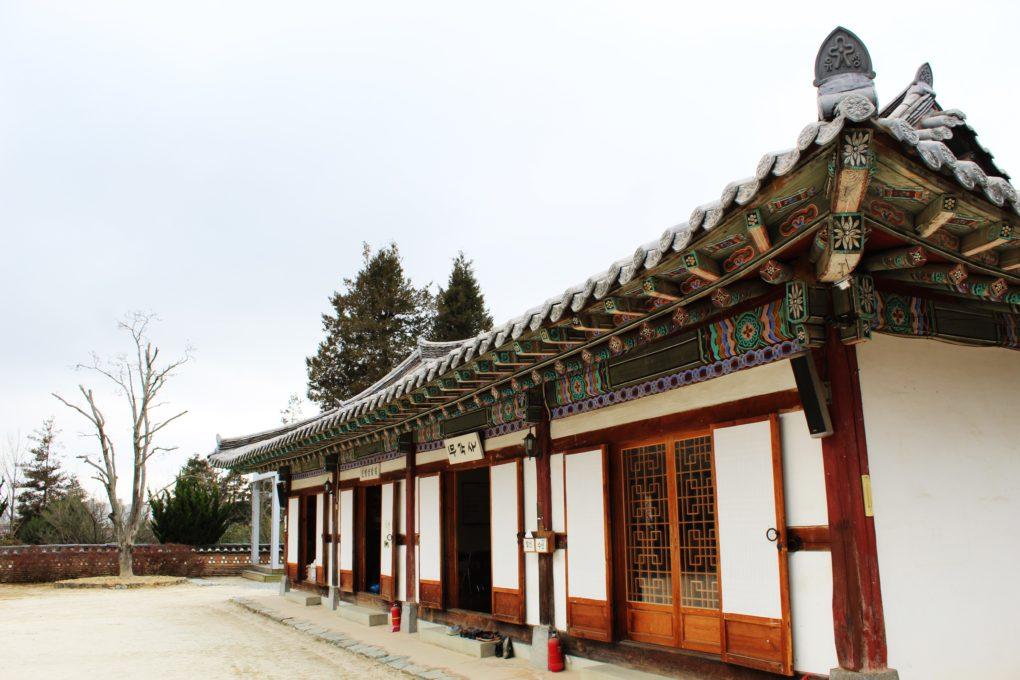
- 🇰🇷 Planning Vacations in South Korea
- 🛫 Basics of Korea Travel
- 🙋 South Korea Travel FAQ
- 🗺️ South Korea Trip Itinerary Examples
- 🚕 Where To Visit In South Korea
- 🧳 Budget For A Trip To South Korea
- 🚈 South Korea Travel Tips
- ☺️ Basic Phrases For Your Trip to Korea
🇰🇷 Planning Vacations in South Korea
Those of you looking to visit South Korea are probably as confused by all the changes as I was before I visited again post-covid. But as of March 20th, 2024, masks are still required in medical settings like hospitals but are NO LONGER REQUIRED in all other indoor public places, including public transport.
Here are what document you need to visit Korea as a tourist:
- K-ETA ( Korean Electronic Travel Authorization , applied for at least 72 hours before departure) OR Visa to visit Korea (countries which previously had a visa exemption now need to apply for a K-ETA). From April 1, 2023 to December 31, 2024, passport holders from 22 countries will also temporarily NOT need a K-ETA or visa to visit Korea (includes: Australia, Austria, Belgium, Canada, Denmark, Finland, France, Germany, Hong Kong, Italy, Japan, Macao, Netherlands, New Zealand, Norway, Poland, Singapore, Spain, Sweden, Taiwan, UK, US (including Guam)). If you're a valid ABTC card holder (APEC card), you are not required to apply for a K-ETA [excluding Americans & Canadians].
- Q-Code (can also be filled out upon arrival) : visitors need to fill out information for the Korean quarantine system, known as Q-Code . Note that all travelers are now allowed in regardless of vaccination status, but you do need to have filled out your Q-Code before going through immigration.
If for some reason you need to take a covid test in a South Korea airport, the cost of a covid test in Incheon Airport is currently ₩80,000 ($60USD), with some options within Seoul as inexpensive as ₩65,000 ($50USD). There's no testing requirement to leave South Korea.

🛫 Basics of Korea Travel
In Korea we use the Korean won (KRW), written as ₩ or 원 in Korean. ₩1000 is roughly equal to $0.75USD or ₱43. The won used in South Korea is different from the won used in North Korea.
This depends on your style of travel, but a mid-range budget for a solo traveler spending 10 days in South Korea would be about $65USD per day. If you're willing to stay in cheap hostels, stick to more free activities in Seoul, and eat local foods, then you could get it down to maybe $40USD per day. So I'd say that traveling Korea is really quite affordable, though you can always upgrade your trip, and the longer you stay the cheaper it will be per dium.
As you might expect, Korean people speak the Korean language , but many people in more urban areas also speak decent English, especially younger people. But the written language of Korea is called hangeul , and it's similar in number to the roman alphabet, but the appearance and pronunciation is different. You will not be able to read Korean unless you study some beforehand (if you're interested, I recommend Talk To Me In Korean ).
The internet is generally great in Korea. You can find free public wifi in basically every major point of transit, tourism, and general town hub (even in my little countryside area). But if you want to be connected constantly, you can rent a wifi egg as soon as you land at the airport, or buy a pre-paid sim card for trips longer than a week (I recommend KT/Olleh sims; it's what I've used all three years here).
South and North Korea are technically still at war. That said, there is no sense that this is a country at war, as the last few decades have been relatively quiet on that front. In fact, Korea and Japan are two of the safest places I've ever been; the biggest peril I've ever felt is from potential alcohol poisoning (the drinking culture here is insane; the local liquor of soju is the most popular beverage in the world ). I'd feel comfortable telling anyone they could walk around here at night, though unfortunately women should be extra vigilant with their drinking.
I agree with the general consensus that May, September, and October are the nicest months of the year, weather wise. They have nice sunshine, beautiful foliage, and outside of major holidays, they're light on domestic tourism. But if you want to find the shoulder season, come in April or June. They're either a bit colder or warmer than you might like, but the kids are still in school and the pollution will be less heavy than it would be in May or October. However, winter is food festival season in Korea, with coffee festivals and chocolate festivals happening across the country.
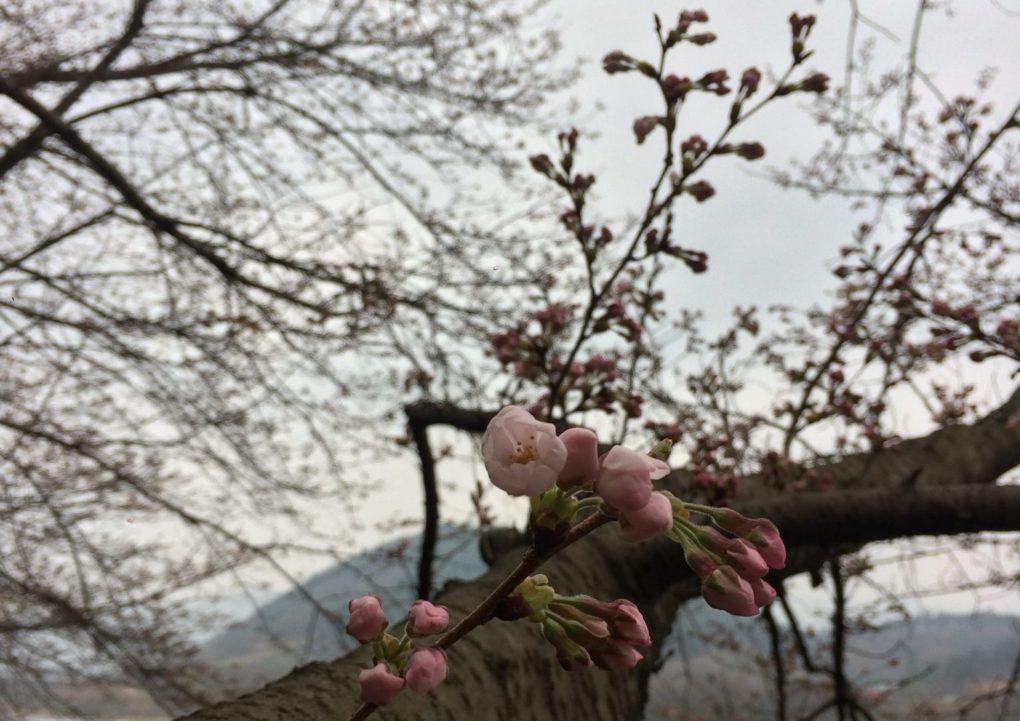
🙋 South Korea Travel FAQ
I've included a FAQ section including the most common questions I've been asked in the last 3 years, by friends, family, and complete strangers. Hopefully this answers the majority of your questions!
What should I wear in Korea during winter, spring, summer, and fall?
From mid-November to mid-March, it could definitely snow and you'll want a heavy winter jacket and some heat-retaining leggings for under your pants. From mid-March through early May & early October through mid-November, there's still the possibility of chilly nights. So bring pants and a jacket for the nights, and t-shirts for the days.
Pack more conservative tops to take to Korea, as showing your collarbones can be cause for staring, especially in smaller towns. Respect is very important in Korea. Early May through early October is a toss-up between extremely hot and warm with a breeze, but it will definitely be humid.
What do I need to bring to Korea?
Other than the basics you'd always pack for yourself, remember to bring higher-cut shirts, as Koreans are more conservative in their dress than most westerners. Women should be sure to bring tampons and pads, as there was recently an issue with domestic pads & tampons are extremely hard to come by.
Many readers have told me that purchasing a sim card and attraction pass (like the Discover Seoul Pass ) helped them make the most of shorter visits, and those are simple things to arrange in advance and take to Korea.
Do I need a visa to visit Korea?
While there are still 112 countries whose citizens don't need to apply for visas before visiting Korea for 30 to 90 days, as of September 2021, ALL visitors from those approved countries still need to have an approved K-ETA before arriving in Korea, even if you just have a long layover in Incheon .
K-ETA stands for Korea-Electronic Travel Authorization. You can check if yours is one of those visa-exempt, countries and how long your visa lasts for, here . Common countries: USA (up to 90 days), Canada (up to 6 months), South Africa (up to 30 days), Malaysia (up to 90 days), Singapore (up to 90 days).
But remember, even if you don't need to apply for a visa, from now on you do still need to apply for a K-ETA , which is good for two years form the date of approval. If you already need to apply for a visa, you do not need to apply for a K-ETA .
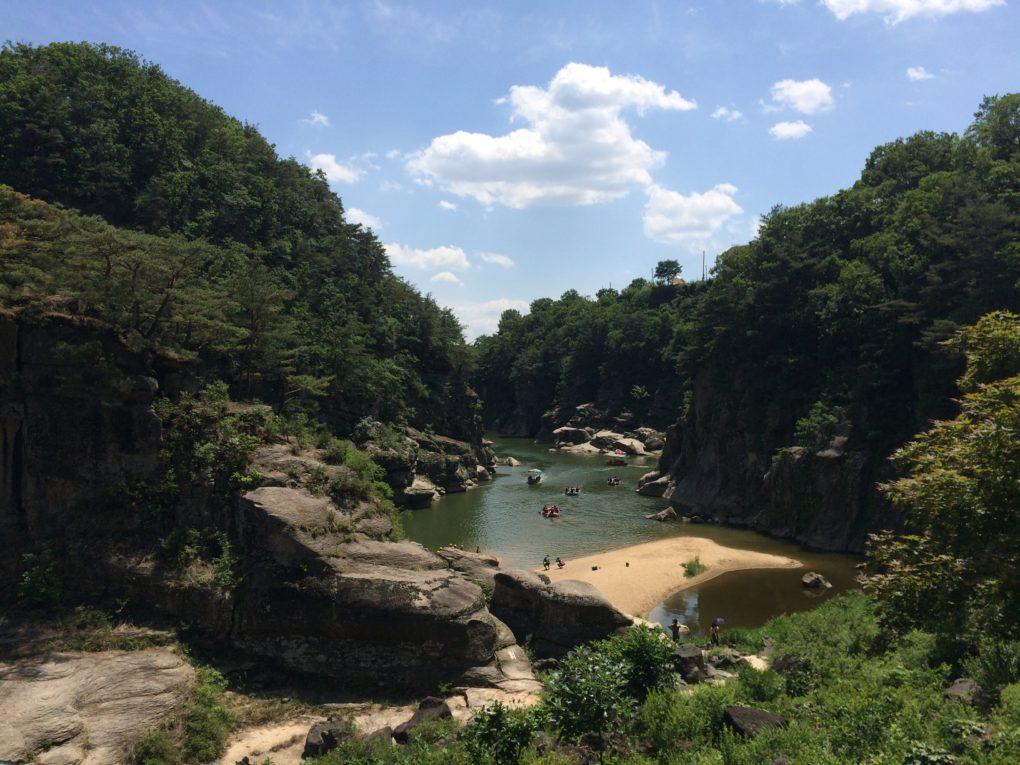
How can I get to & around Korea?
Since South Korea is on a peninsula off the southern coast of China, you have to fly in. Note that if you have a layover at Gimpo Airport for some reason, the airport closes each night from 12am-4:30am. Theoretically you could also arrive by boat from China or Japan, but that truly sounds awful to me.
As for actually getting around Korea, that's a much easier question. Getting between the cities is best done by bus, or train if it's a very popular route. Some people prefer to fly between Seoul, Busan, and Jeju, though you can also go via bus & boat.
Within the major cities, buses and metro and taxi are all reliable and safe forms of transport (just make sure your taxi uses their meter). In smaller areas, buses and the occasional taxi are the way to go; taxis are very affordable in South Korea.
How many days in South Korea is enough?
I think two weeks in Korea is ideal for getting a taste of the coast, the nature, and the overall urban lifestyle. But if you have less time on you vacation in South Korea, you can get a condensed version of all of that with just 5 days in Seoul (yes, even the beaches!).
If you have fewer than 5 days, I really do think it will be tough to get a good sense of the culture and people and cuisine.
Which apps should I download before visiting Korea?
My most used apps have been: Kakao Talk (like Korean WhatsApp), Naver Maps (Google Maps is trash here, so you'll want to download this local equivalent), Google Translate (the speaking function is a lifesaver; just remember town download Korean offline), and a Seoul Subway App (mine is in Korean, but there are plenty out there in English).
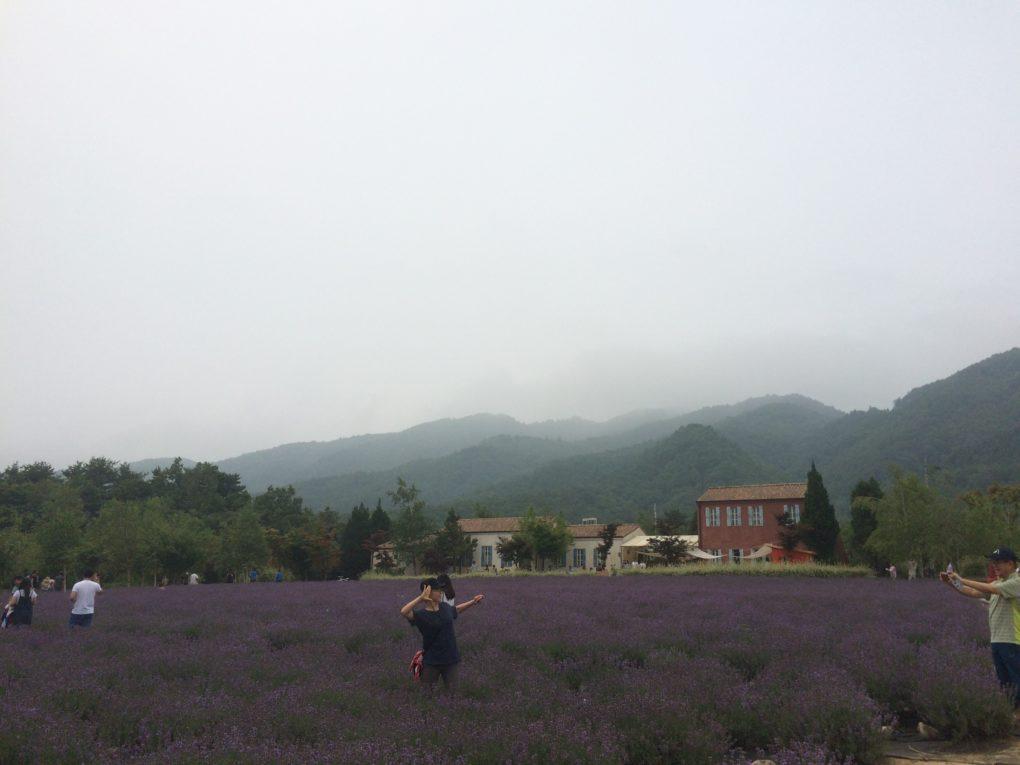
🗺️ South Korea Trip Itinerary Examples
The whole idea of this guide it to give you an idea of where to visit in Korea and how long you want to spend there. Tourism is on the rise in Korea, and having a unique experience is becoming more important than ever for visitors.
So in true DIY spirit, here are some route examples for a 2 weeks in Korea itinerary or less, for each of the following lengths.
South Korea Itinerary 14 Days
- Seoul (Days 1-4)
- Jeju (Days 5-7)
- Busan (Days 8-9)
- Suncheon area (Days 10-12)
- Jeonju (Days 13-14)
See below for more information on each city.
South Korea Itinerary 10 Days
- Suncheon area (Days 8-10)
Click to check current hotel prices in Korea.

South Korea Itinerary 7 Days
- Suncheon area (Days 5-7)
South Korea Itinerary 5 Days
- Seoul (Days 1-3)
- Jeonju (Days 4-5)
South Korea Itinerary 3 Days
Seoul. Just spend 2 days exploring all you can in Seoul, and then spend your middle day doing a day trip from the city, maybe to nearby Chuncheon .

🚕 Where To Visit In South Korea
Seoul : the capitol city, the darling of K-Pop fans, and one of the most populous cities in the world. Seoul is not for the faint of heart, but for those who can handle serious crowds, Seoul can be most anything you want it to be.
Almost everyone planning South Korea vacations will end up either starting or ending here, and they're lucky to do so. It's a great base from which to travel the rest of the country, or even spend a week or so experiencing all of the different neighborhoods & their vibes.
Seoul is great for culture, food, nightlife, and just about anything else you want in a trip to Korea, except for peace and quiet.
Busan : possibly best known outside of Korea for the movie Train To Busan , this port city is thought of domestically as the seafood and cinema capitol of the country.
Even though it's incredibly urban in its own right, people also think of it as more laid back, with beach vibes and ocean views for days. Busan is perfect for seafood lovers looking to spend time at the beach and indulge in some cinematic activity.
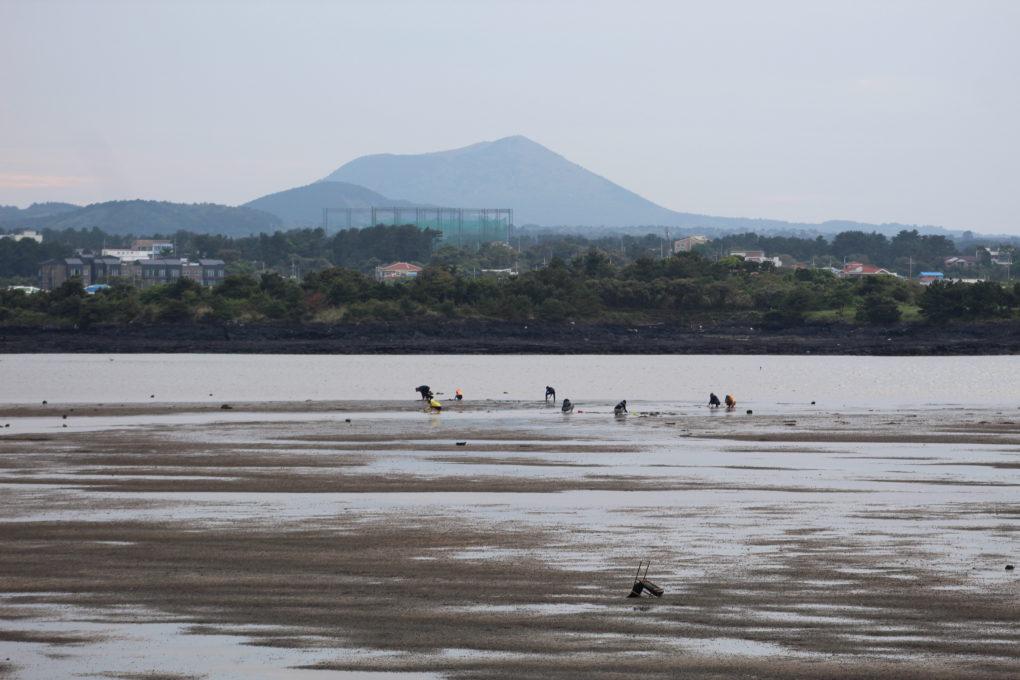
Jeju : the Hawaii of Korea, as it's often called, Jeju is known for its beaches and seafood and nature. The entire island comes from a single volcanic explosion thousands of years ago, and you can actually see the peak of that volcano from any point on the island.
Jeju is ideal for those looking to get a taste of Korean culture and cuisine, but with much more tranquility and beach vibes than you'd find anywhere on the mainland.
Jeonju : this lesser-known Korean destination is where Koreans go when they want to experience the "olden times" of Korea. Jeonju is one of the oldest cities in Korea , famous for its spicy bibimbap, traditional hanok houses, and many unique festivals.
Come to Jeonju if you want to soak in a whole city happily dedicated to maintaining traditional Korean culture, one bowl of spicy bibimbap at a time.
Suncheon : truly off-the-beaten path, Suncheon is a gorgeous region full of flowers, agriculture, and stunning natural landscapes. Domestic tourists most often visit in the springtime to see the green tea fields & cherry blossoms, but Suncheon is also a great base from which to explore a few nearby cities.
Visit Suncheon if you want to see a less-touristed side of Korea's natural beauty, with an emphasis on local agriculture.

✈ Seoul
What seoul is known for.
Seoul has everything you could want in a destination. It's one of the biggest cities in the world, and despite being the center of international cultures in Korea, it's still very much culturally Korean. It's for this reason that I think Seoul is the perfect place to put at the beginning of your Korea itinerary.
You'll probably arrive here, anyway, since Incheon Airport is one of Asia's biggest transport hubs. Many people even plan a Seoul itinerary for 10 days for a taste of the Korean dishes which have become so popular around the world.
Others come for the world-class shopping and cosmetics selection, or even for medical tourism . But I think that the most worthy reasons to write Seoul into your Korean itinerary are the natural beauty , historic temples , and little cultural quirks which all add up to an ambiance that's purely Korean.
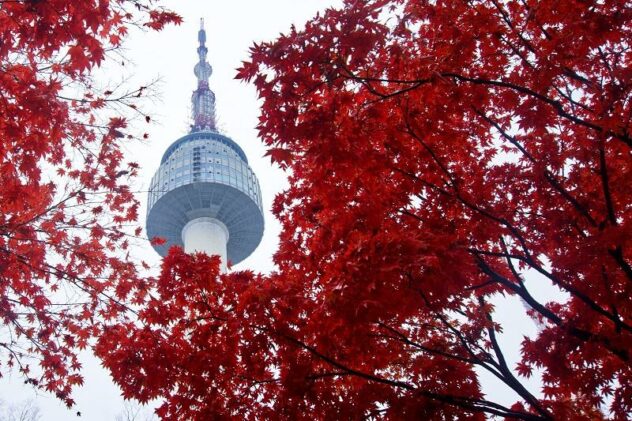
What To See In Seoul
I won't list out everything you can do or see in Seoul, since that could fill a whole book (and probably has). But here are 7 things you can't miss seeing in Seoul , since 7 is a lucky number here. Click here for more ideas of what to do in Seoul, with entrance fees, Korean translations, and hours .
Go to the spa. The spa, or sauna, is an important pastime for Koreans of all ages, and it's most common to go on the weekends as a family. A Korean sauna, however, is divided by gender and has you completely naked.
While you could visit a sauna in most any city in Korea, Seoul is going to have the most options for different types of baths and treatments, and it's going to be the most foreigner-friendly. I highly recommend Itaewon Land Spa.
Walk to Namsan Tower. This landmark is rather characteristic of Itaewon and the whole HBC area, located in central Seoul and considered the international hub of the city. Namsan Tower is set in a very green park, and right around the tower itself is a temple and a gate with “love locks” attached to it, but the Tower is best known for having an amazing view of the city.
It’s a bit of a walk from Itaewon’s downtown area, but there’s a bus if you get tired, and a cable car to take you to the top. I think the view is just as good from the cafe right before the top floor, so I wouldn't recommend paying for the cable car.
Visit Gyungbokgung , one of the 5 royal palaces in Seoul. Of the 5, Gyeongbokgung is the most accessible by public transportation, located just outside of a subway stop. I also think it’s the most beautiful, but I’ve had the chance to visit in both fall and spring.
Those are the seasons when the colors of the palace grounds come to life; in summer and winter it's a bit less colorful. The grounds of Gyeongbongung are large, but you could spend anywhere from twenty minutes to two hours exploring each corner of the grounds.
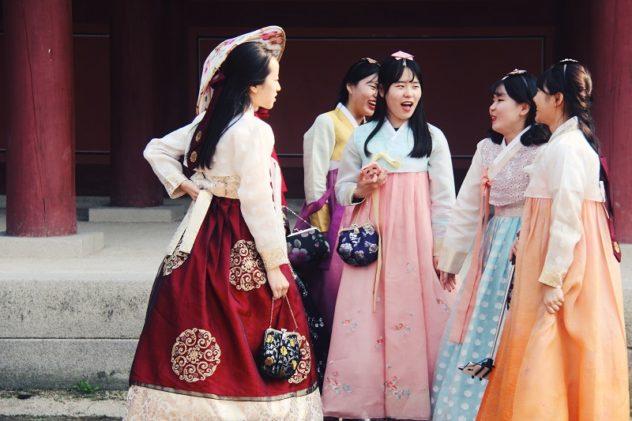
Sing in a Noraebang . Literally translated as "song room," noraebang are the quintessential nighttime activity of the Korean public. In English we usually know then by the Japanese name karaoke .
From middle school onward, on any given night you can find a noraebang full of Korean students hanging out with friends, or adults drinking with co-workers or family. In Seoul it's easy to find either coin noraebang, in which you pay per song, or regular noraebang, in which you rent a room by the hour & buy snacks .
Hike Bukhansan. Just a half hour north of Seoul is one of Korea’s many national parks. Hiking is a national pastime, so every day of the week you’ll see groups of older people geared up for a trip up Bukhansan. On the weekends there are visitors of all ages, usually ending their hikes with a picnic and drinks at whichever peak they decide to stop on.
Explore Gana Art Center . Gana is known across Seoul for its beautiful think pieces. Amidst all the traditional Korean food and aesthetics of northern Seoul, walking around Gana Art Center gives you a different perspective on the current events in Korea.
Luckily, you don’t have to speak any Korean to get the gist of real art, though it may be helpful to know some about Korean culture in order to get the full impact. The permanent exhibits are free, but you may have to pay to enter the special exhibits.
Wander Bukchon Hanok Village . A hanok is a traditional Korean house, a small building with a thatched roofs and beautiful painted walls & roof. In the spring and fall the foliage creates a stunning backdrop for photos, so that’s the perfect time to enjoy the village in traditional garb.
Note that Bukchon Hanok Village doesn’t actually close, but between the hours of 11pm and 5am there’s nothing going on.
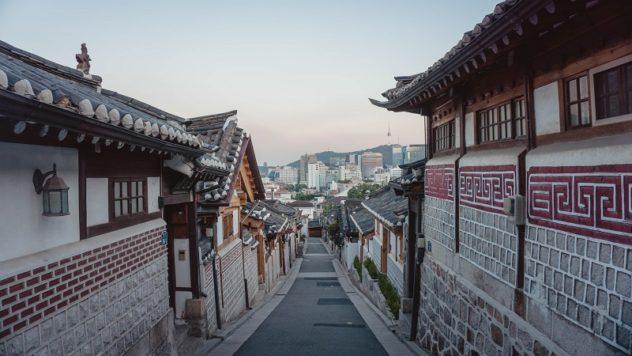
What To Eat In Seoul
In case you only have a few days in Seoul, this is where you'll get to sample a range of uniquely Korean foods. And hopefully also visit some of Seoul's dozens of delicious chocolate shops . So while you're in Seoul, be sure to look out for these top 5 Korean foods, particular to the country, but not to any specific region.
Japchae (잡채). A noodle dish containing thinly chopped vegetables, sweet potato starch noodles, and sometimes a little bit of meat. It’s great served warm as a main dish, but it’s often served as a side dish, tossed in sesame oil and soy sauce.
Hoddeok (호떡). This cinnamon sugar-filled fried rice cake is my absolute favorite treat. It's one of the few traditional sweets in Korea, but it's most easily found in the colder months, from October to April (I'd recommend you get it in the neighborhood of Insadong).
Samgyupsal (삼겹살). This is Korean pork belly, the most popular meat of choice in the country. It's just one of many types of meat you can have for Korean barbecue , which is basically a particularly communal style of cooking meat in the center of a table. If this is your only trip to Korea, you need to try this before you go!
Mul Nangmyeon (물냉면) . Translated as "water cold noodles," this chilled dish is made with buckwheat flour, and served with sliced cucumber & half a boiled egg on top. The dish is made with a meat broth and most commonly eaten right after barbecue, preferably with meat hot off the grill.
Samgyetang (삼계탕) . Quite possibly my favorite Korean meal, samgyetang is basically Korean chicken soup. The main part of the dish, thought be very healthy, is a whole chicken stuffed with rice and a bit of ginseng, jujubes, & ginko beans. You eat these with the side dishes and the meat & soup, after you dip it in the salt they serve on the side.

Where To Stay In Seoul
There are hundreds of lovely guesthouses and hotels throughout Seoul, and there are equally as many crappy ones. Most egregiously, some of them are both expensive and crappy. So here's my selection for the three best places to stay in Seoul . Each spot is centrally located, high quality, and foreigner-friendly. These are listed in order from least expensive to most expensive.
Budget: G Guesthouse
There's a reason this is always the recommended guesthouse in Itaewon. Not only does it always come in under budget, but the facilities are clean, the staff is helpful but unobtrusive, and the beds are comfortable. They even provide towels, a luxury not as common as you'd like.
Although you can't control what other guests do or what time they come back, my friends & I have always found that G provides a quieter environment for late-night entries than the other hostels in the area. Pro tip: the kebab place just down the street has the best kebabs in Seoul hands-down.
Mid-Range: Solaria Nishitetsu Seoul
Voted a traveler’s favorite in 2017, Solaria Nishitetsu is part of a Japanese hotel chain which combines comfort & convenience at a reasonable price. Guests love the huge rooms and large, firm beds, a real find in the heart of Myeongdong.
Because of its popular with business travelers, there are lots of harder-to-find amenities for digital nomads and other business people on-the-go, like work spaces and less-expensive single rooms.
Luxury: Signiel Seoul
Located in the top floors of Lotte Tower, Signiel is truly in a league of its own. Its sauna, gym, and pool facilities are world-class, with a staff and suites to match. Each room has a spa-style bathroom and a cozy place to rest your head, in addition to their unparalleled views of the city.
There are even free drinks and appetizers for guests in the hotel lounge, at all times of day. The Signiel is truly the place to get pampered, perfect for those looking for a honeymoon hotel .
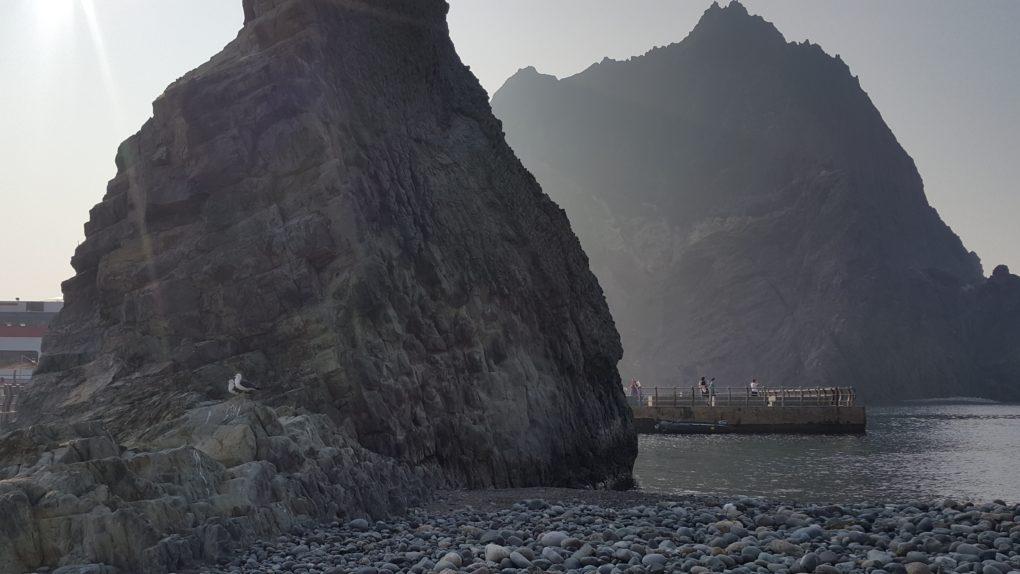
✈ Busan
What busan is known for.
Even though it's the second-largest city in Korea, and a metropolis in its own right, Busan doesn't get a lot of love from tourists. Most people think of it as a smaller version of Seoul, with a lot of the same cultural attractions but just harder to get to.
They have a point; Busan and Seoul are both massive port cities with cosmopolitan & hipster neighborhoods, alike. However, I'd argue that the feel of a place and its unique natural landscape plays a big role in your experience there.
In that regard, Seoul and Busan are more comparable to LA and San Diego. Seoul has glitz & glamour and a little of everything, while Busan has a more relaxed ocean-side vibe with lots of fresh seafood & quick flights to neighboring Japan .
As one of Korea's most popular weekend destinations, 3 days in Busan is plenty to see the city's highlights and get a feel for the ancient seaside temples , the beaches , and the local importance of cinema .
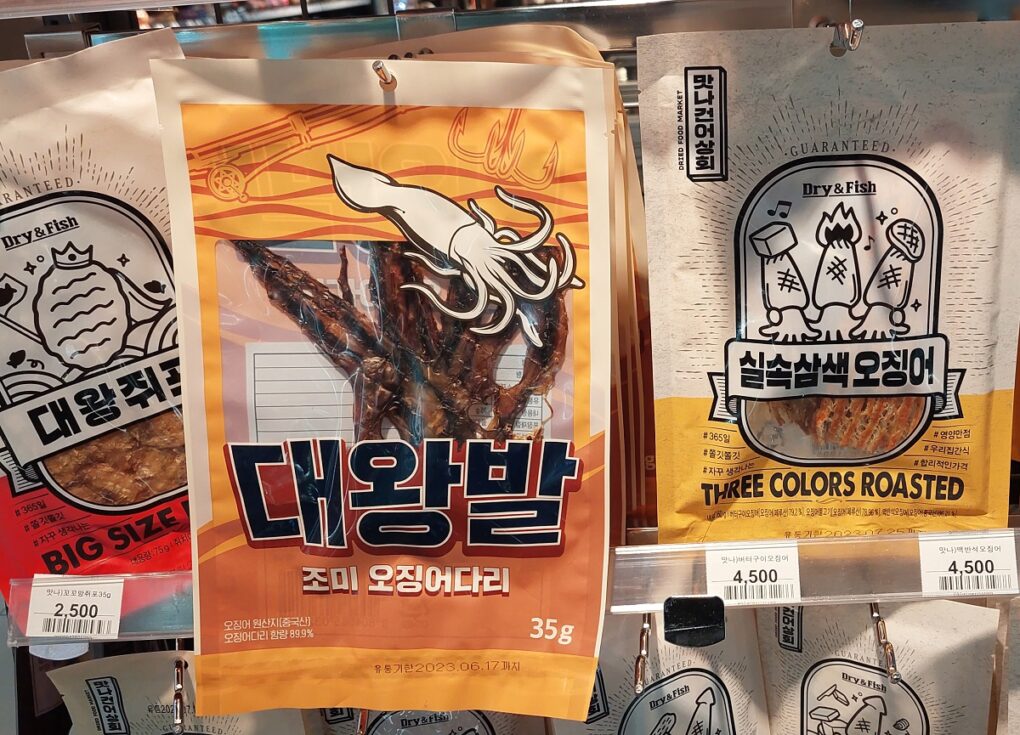
What To See In Busan
I won't write up everything you can do or see in Busan, since that'd take hours for you to pour through. So here are 7 things you can't miss seeing or doing in Busan (since 7 is a lucky number). Click here for more ideas of what to do in Busan, with entrance fees, Korean translations, and hours .
Lounge on Haeundae Beach. Undoubtedly the most popular beach in Korea, Haeundae is always packed in the summer, especially with families. But public schools don’t actually let out until mid-July, so if you time your visit well, you may just have a patch of sand to yourself. Note that beaches are only open for swimming from June to August.
Skip down Cheongsapo Daritdol Skywalk. This unique attraction has become quite popular over the last few years. It's basically a see-through bridge out over the ocean, perfect for showing off the ocean without you having to get in it. There’s also an observatory in the area, one of just 3 in the city. The skywalk is located a short walk from Haeundae Beach.
Explore Busan Cinema Center. As home to the Busan International Film Festival, which is held each fall, this is a great introduction to the film culture for which Busan is famous within Korea. The center has 3 buildings containing theatres of varying sizes, each offering daily tours & lectures. There are restaurants and cafes on-site.
Have a photoshoot in Gamcheon Culture Village. Probably the most popular photo backdrop in all of Busan, "GMC" has become known as a sort of Korean Cinque Terre . The calming blue houses look right out over the ocean, and are actually still people’s homes.
You'll see many an older person drying their laundry on their balconies and chatting on rooftops on sunny afternoons, so remember to stay respectful of the residents.
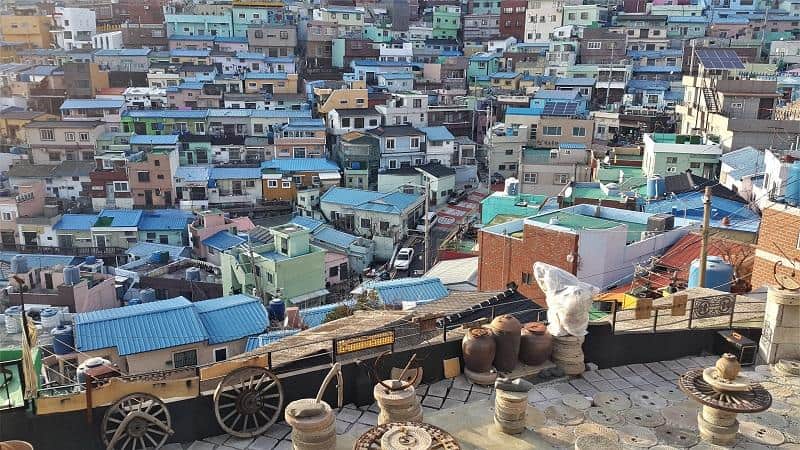
Have a meal at Jagalchi Market. This is the largest open-air seafood market in Korea, often compared to Noryangjin Market in Seoul. It’s actually become so famous that each October the city holds the Jagalchi Cultural Tourism Festival.
But even if you can’t make it on time for the festival, seafood lovers will have a blast walking through the market and exploring the diverse sea life found in Busan’s waters. The entire first floor is a wet market, while restaurants and the like are found on floors 2-7.
Wander the grounds of Taejongdae. Of all the things to do in Busan, this is by far one of my favorites. Equal parts resort & park, Taejongdae has become famous for its beautiful views and colorful tourist train.
The area's temples are accessible within an hour's walk, but even right around the entrance you can hike down and reach the shore in less than 10 minutes. Basically no matter where you go on the grounds, you’ll find a great view. Note that while it’s free to enter the grounds, this is likely to take up half of your day since it's so far south of downtown.
Watch sunrise at Haedong Yonggungsa Temple. In case you don't have the time to spare for a visit to Taejongdae, this is your alternative glimpse at Korea's ancient seaside temples. Most of Korea's temples are in the mountains, offering tranquility and spectacular views of life below.
But Haedong offers a broader view of the life going on below, focusing on the deep blue sea rather than countryside valleys. Some people come here to watch the sunrise, which is a spectacular choice considering it's on the east coast & opens at 5am!
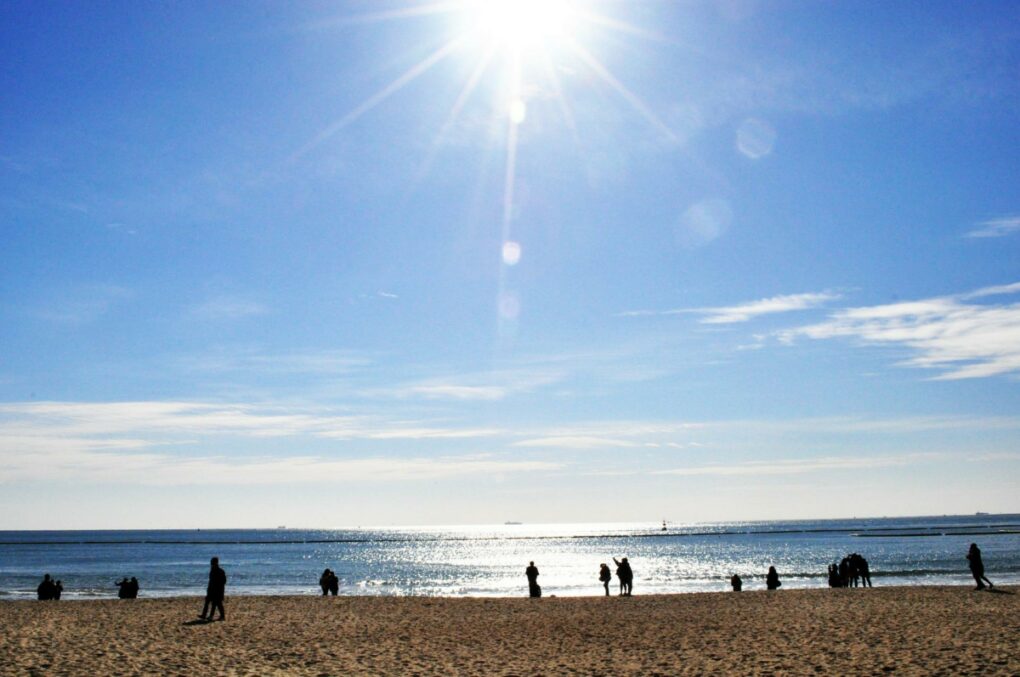
What To Eat In Busan
Busan is not a city for vegetarians or non-adventurous eaters, unless you're looking for chocolate in Busan , that is. The region's most famous foods are definitely of the sea variety, and thus, so are most of these 5 foods you should try in Busan. I have included a couple of land-based options for those who aren't into eau de ocean , however.
Sannakji : likely one of the most famous Korean foods, sannakji is often translated as “live baby octopus.” Cut & served immediately after being pulled from the water, sannakji are squirted with sesame oil & acidic fruit juices, making the tentacles continue to move around for minutes after death.
Haemul Pajeon : this is a seafood pancake, basically, but a Korean version (made with rice flour). They usually include tiny octopus, and are especially popular as a drinking snack, though many people come to Busan’s fish markets to enjoy them with family and friends.
Busan Jokbal : I don’t think I’ve ever met a Korean who didn’t like this dish. The jokbal , or pig’s feet, are cooked in a sweet cinnamon & honey mixture which reminds me of spiral-cut ham on Christmas. They're then served cut-up and ready for eating; the meat is fatty and rich, so don’t knock it ’til you try it.
Dwaeji Gukbap : this is a very hearty pork-based stew, prepared by slowly boiling pork bone into a broth & adding tender little pork bits. It’s served with rice and side dishes; you plop the rice into the stew and then eat it with side dishes of your choosing. It’s popular year-round, but is a must-try in winter.
Mulhoe : hoe literally means raw seafood, while mul means water. Mulhoe is therefore a raw fish soup, served cold & spicy with a variety of noodles and veggies. I'd only recommend it if you're eating somewhere right off the coast, like in Busan's Jagalchi market.
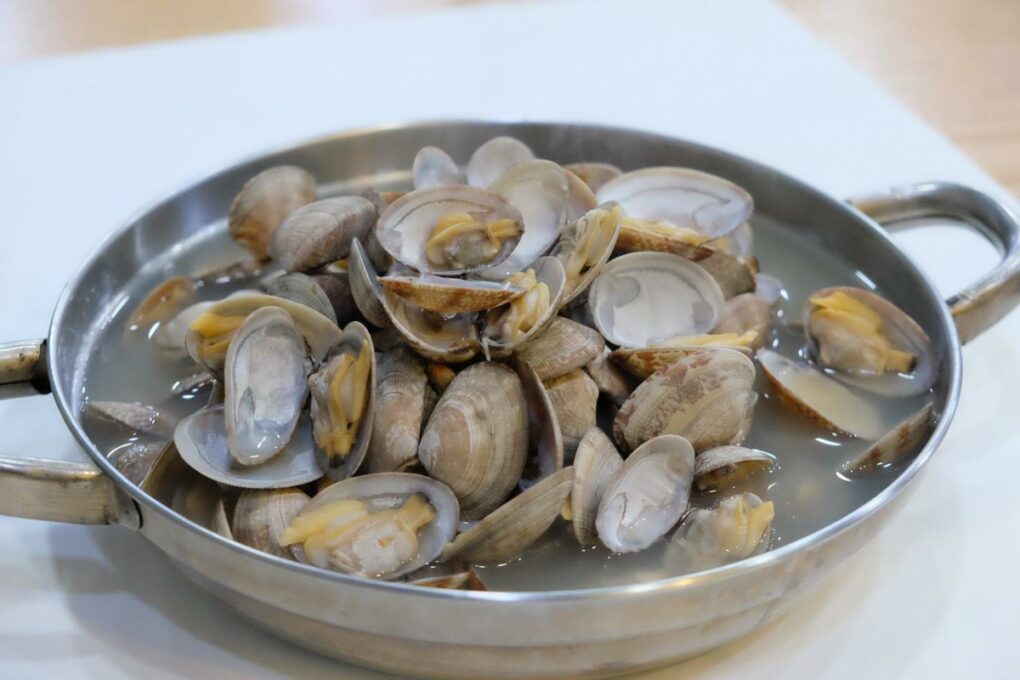
Where To Stay In Busan
Domestically, Busan is just as much of a tourist destination as Seoul is, since most of the people who travel around regularly are actually coming from Seoul. So Busan has hundreds of quality guesthouses, and probably an equal number of not-so-great ones.
So here's my selection for the 3 best places to stay in Busan , because there's no reason to suffer through a crappy, expensive hotel. Each of these spots is centrally located, high quality, and foreigner-friendly. These are listed in order from least expensive to most expensive.
Budget: The Bay Guesthouse
The Bay has become my go-to guesthouse in the warmer months, just 3 minutes from the beach & 2 minutes from the metro. It’s centrally located, the beds are large & comfortable, and the style is as a cross between a capsule hotel and a more typical hostel.
Every morning the manager even cooks breakfast for the guests, and there’s coffee brewed in the dining room.
Mid-Range: Stanford Inn Busan
Stanford Inn is a relatively new addition to Busan's "affordable luxury" lineup. But in the few years since it's opened its doors, guests have been very impressed with the high quality of the rooms & breakfast buffet.
Port-side suites garner the most praise, with guests impressed by the view and the proximity to the metro, just a few blocks in either direction.
Luxury: Lotte Hotel
Though best known internationally for department stores & perishables, domestically Lotte is known for offering a variety of luxury experiences; this includes their chain of hotels. Each suite in Lotte Hotel offers big fluffy beds and a spacious bathroom, as well as a bevy of modern furnishings.
Lotte Hotel is especially popular with families, thanks their reputable spa & restaurant facilities.
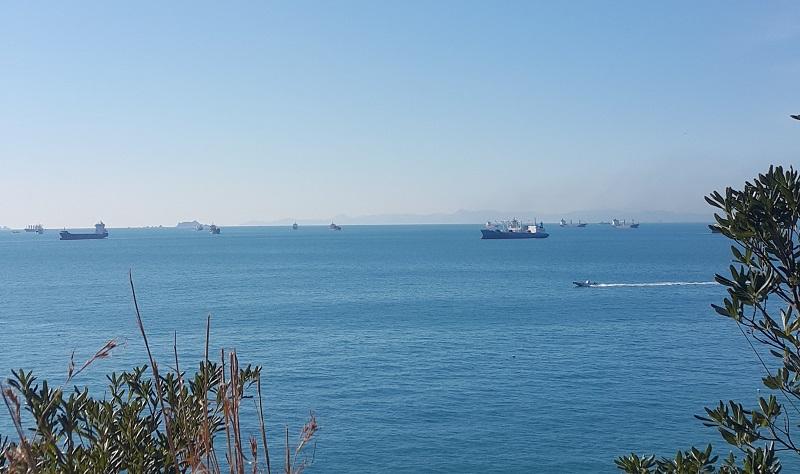
✈ Jeju
What jeju is known for.
A few days after one of my trips to Jeju, a Korean friend told me he was jealous that I went without him, because Jeju is his "stereotype of a beautiful place." Well to be honest, it's mine, too. Jeju is breathtaking in the spring & fall, and somehow a haven from the mainland's overwhelming weather in winter & summer.
The route from Seoul's Gimpo Airport to Jeju is actually the most traveled route in the world . That's how much Koreans love visiting this idyllic little island off their southern coast. But tourists? Not so much. Every time I visit Jeju, mine is one of the very few foreign faces I see.
But Jeju Island has so much to offer, from gorgeous hikes to unique local foods , that there's no reason it shouldn't be on every South Korea travel itinerary. Jeju is the place for you if you love exploring natural beauty , learning about sea life , and relaxing seaside .
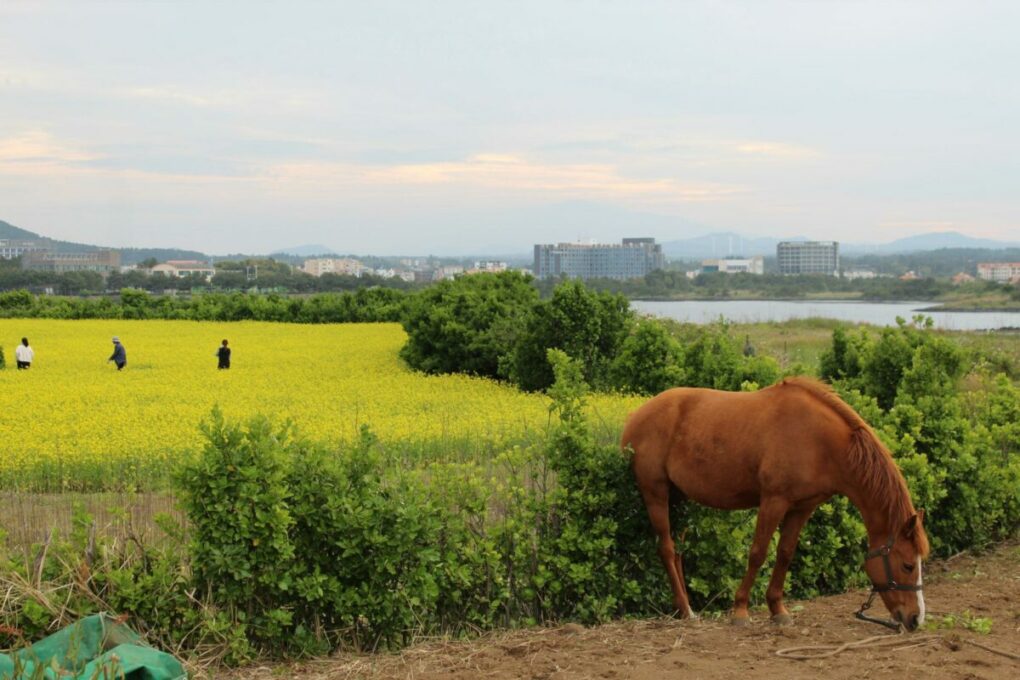
What To See On Jeju
There is such an incredible number of things to do on Jeju, in every season, that you could spend hours researching. But to give you an idea of some of the many things you can do across the island, here are 7 things you should do or see on Jeju Island. Click here for more ideas of what to do on Jeju, with entrance fees, Korean translations, and hours .
Pose in Love Land (erotic museum). This is often one of the most unexpected sites to find in Korea: a park full of penises & other various erotic sculptures. The park was opened in 2004 by a group of art students from Seoul’s prestigious Hongik University, and since then the park has been a surprising success, where selfies abound. Note that you must be at least 18 to enter the park .
Watch sunrise at the top of Seongsan Ilchulbong. Is this in Korea or the Highlands of Ireland? The immensity of the green and the brightly colored flowers that greet you in the spring could very well distract you from ever climbing to the top of Seongsan.
From the hike to the viewpoint, horseback riding, and boating, you could easily spend half a day here. If you’re lucky, this is also where you’ll catch site of some of Jeju’s famous women divers, though you may see some on the walk over.
Hike around Seopjikoji. Just across from Seongsan Ilchulbong is Seopjikoji, an area famous for being the filming location for several dramas, and just a stunning place in general. The stairs built into & walking trails leading along the cliffs can get a bit crowded on weekends in the summer.
But if you get too hot, there's also a sea side restaurant at the top of the climb. Seopjikoji's most gorgeous scenes are in the spring, when the hills are vibrant green and dotted with bright yellow canola flowers.

Stare in awe at Jeongbang Waterfall. Jeongbang’s claim to fame is that it's the only waterfall in Asia to fall directly into the ocean. It's honestly a cool sight to see, basically from the parking lot, making it my pick for the best waterfall in Jeju.
There’s even a tiny beach in front of it, just before the vast ocean extending way beyond. The shops just along the parking lot will also be selling souvenirs, oranges, and Jeju chocolates.
Walk the Jusangjeolli Lava Cliffs. Often compared to Giant’s Causeway in Northern Island, Jusangjeolli is another act of nature bestowed upon Jeju by the volcano from which it was forged. Less than 5 minutes from the parking lot, the cliffs are deep grey rectangular formations jutting out into the ocean.
It almost looks as if they were formed by a child slowly stacking blocks. They’re quite the popular photo spot, and certainly worth a stop, though lines for selfies can get long on weekends.
Bathe in Sanbangsan Carbonate Springs. This will be one of the strangest experiences of your life, if you’ve never been to a Korean sauna. Everybody here is separated by gender, and then strips themselves buck naked. It takes some getting used to, but when you do, it’s glorious. These hot springs are divided by each temperature and healing properties, making for a very soothing way to spend an evening.
Sip on a cup of tea at O’Sulloc Tea Fields & Museum. The museum is tiny, but if you came to the fields for the tea products, then this is your spot. The aforementioned museum is attached to a massive cafe serving up a variety of teas from their farm, plus coffee and desserts .
The entire complex is located next to a cosmetics shop & a second cafe. But the best part for most people will be the tea plantation itself, situated across the street from the museum, and laid out with pictures in mind.
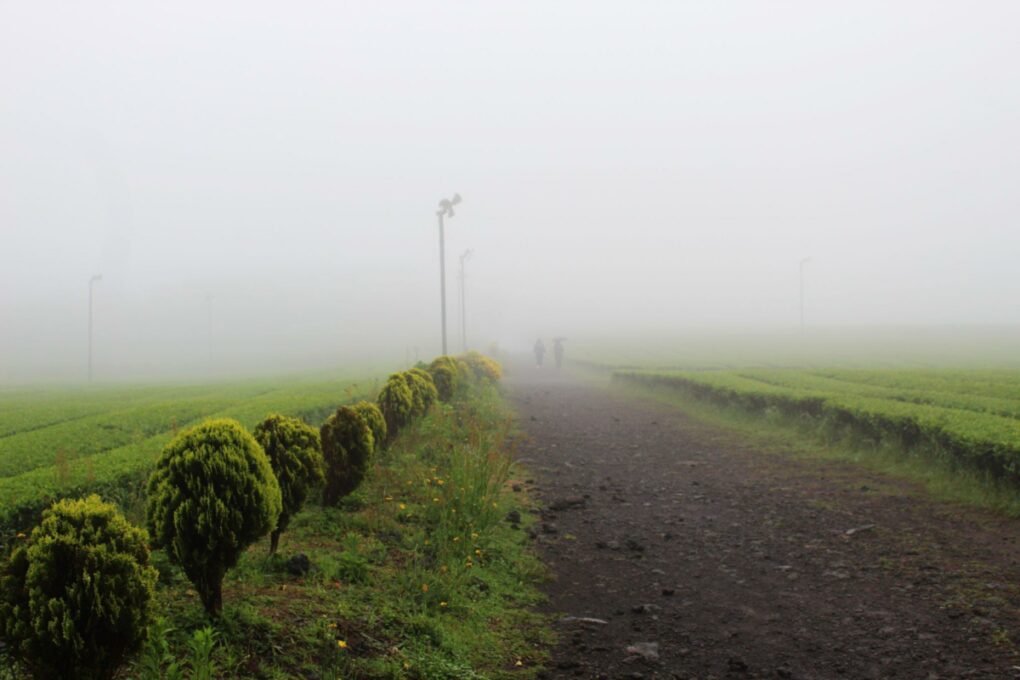
What To Eat In Jeju
Like all other provinces and cities in Korea, Jeju has a few foods it's famous for, but unlike most of those other regions, Jeju is famous for them because they're actually grown there. A few of these products have turned into a whole range of foods, all focused on that one crop. Take a look.
Abalone (Sea Snails). I know the translation doesn't sound very appetizing, but abalone are actually shellfish, more like oysters than snails (but don’t go looking for any pearls). They’re one of the many sea foods caught by the women divers of Jeju, and are caught & served fresh daily. Local favorites are abalone rice porridge and grilled abalone.
Black Pork. This is meat from a specific type of pig raised mainly on Jeju Island , and I find it to be a softer & more flavorful version of the meat found on the mainland. If you’re looking for easy pickings of a variety of black pork restaurants, check out Black Pork Street in Jeju City.
Hallabong (those big oranges grown throughout the island). The season for hallabong is actually winter time, but some of the groves manage to grow oranges year round. So you’ll see these thick-skinned beauties for sale in boxes along the side of the road, and at gift shops in most of the major tourists sites. Keep an eye out specifically for hallabong tea.
Green Tea Anything . Home to the well-known O’Sulloc tea fields, you’ll see green tea-flavored things for sale throughout Jeju. But nowhere is there a higher concentration of tea-flavored items than at the O’Sulloc tea museum, itself, which is profiled above.
Peanut Ice Cream. Depending on where you get it from, the cream flavor can be more or less intense, and the ice crystals can be very strong. But peanuts are actually grown on Udo, an island off the coast of Jeju, making it a truly local food. Though honestly, most people just buy it for the cute pictures.
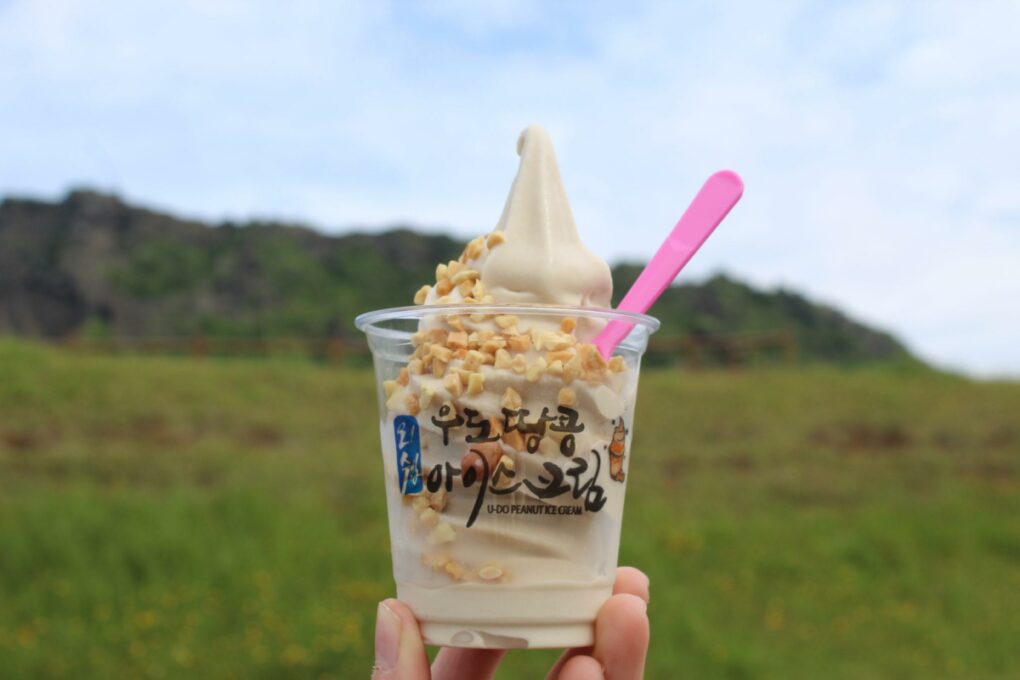
Where To Stay On Jeju
Since so much of the Island's economy depends upon tourism, you'll have your pickings of Jeju accommodation, especially in Jeju City and the southern city of Seogwipo. But there are some hidden gems, so allow me to shine light on 3 of the best places to stay on Jeju . Each spot is centrally located, high quality, and foreigner-friendly. These are listed in order from least expensive to most expensive.
Budget: Yeha Guesthouse
Seoul is famous for their inexpensive accommodation, but Jeju City really puts up a fight. Yeha is the best choice for backpacking or budget-minded visitors, with a solid 9/10 rating for their dorm beds, and a good connection to island's public transporation.
To top it all off, they’ll happily store your luggage for you if you want to explore a bit before your flight back.
Mid-Range: Color In Jeju
If you’re looking to stay on the eastern coast and want to splurge a bit, Color In is the move. They’ve got immaculate rooms, a small outdoor pool, and the rugged surroundings typical outside of the big cities. Front desk hours are limited, but that’s easily overlooked once you get to the pool.
With just 6 guest rooms in the entire place, odds are good that yours will be poolside.
Luxury: Kensington Hotel Jeju
One of the highest-rated hotels in Jeju, the Kensington contains all the opulence one expects from a 5-star hotel, infinity pool included. If the layers of indoor & outdoor pools isn’t enough, however, consider the superb staff and various on-site restaurants; their breakfast buffet is included in your stay.
Within walking distance of the hotel are a botanical garden and the teddy bear museum.
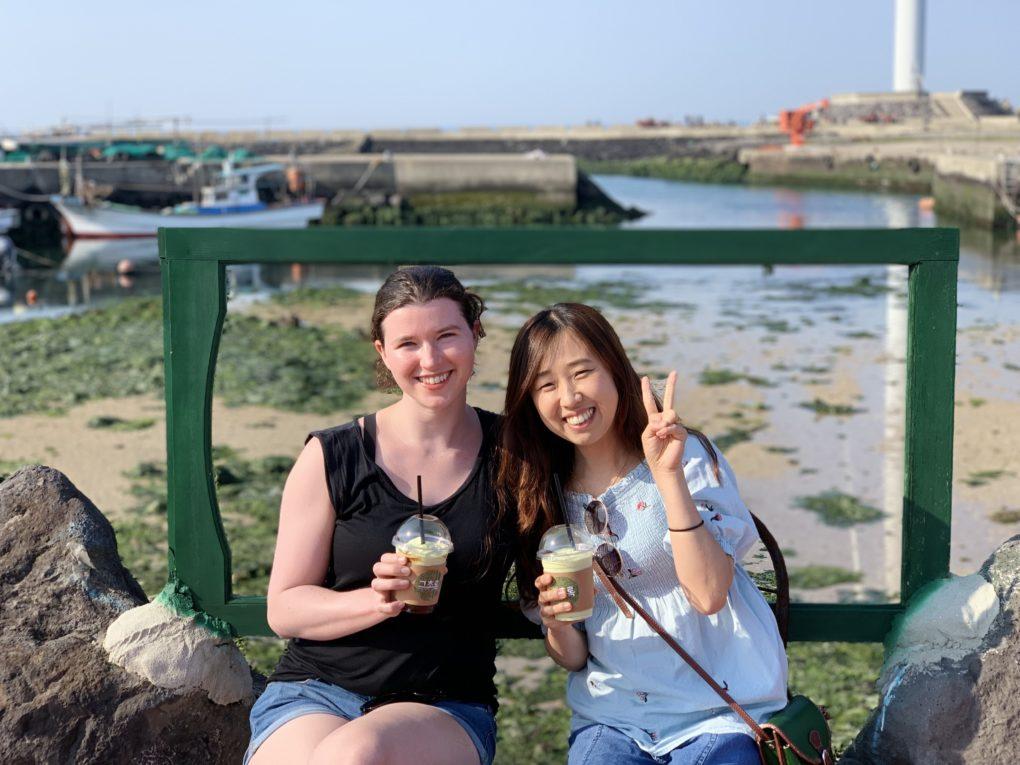
✈ Suncheon
What suncheon is known for.
Of all the cities in this Korea itinerary, Suncheon is probably the least famous internationally. The city has just a few hundred thousand residents, quite small by Korean standards, but each spring the county is flooded with domestic tourists chasing beautiful flowers and stunning natural landscapes .
But despite its size, I'd recommend Suncheon because of its great potential as a base from which to explore the rest of southern Korea. Just south of Suncheon are Boseong, where most of the country's green tea is grown, and Yeosu, a beautiful island with lots of attractions in its own right.
Northeast of Suncheon is Gurye, whose spring flower festival & fall cherry festival are famously striking. Simply put, people visit Suncheon in order to revel in the beauty of nature , get away from the big cities , and enjoy the festival culture of small Korean communities.
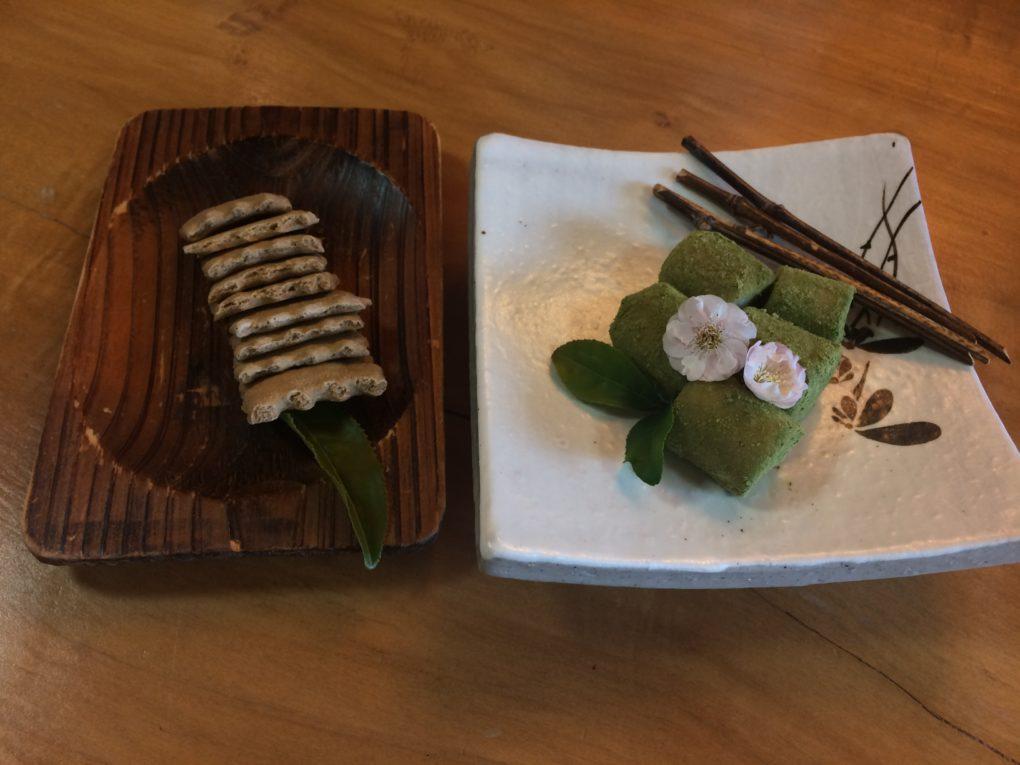
What To See Around Suncheon
As just one of four great cities to explore in southern Korea, it's difficult to distill Suncheon attractions into one post. But in order to lend an idea of some of the things you can do around Suncheon, here are 7 things you should do or see near Suncheon City.
Learn hands-on at Naganeupseong Folk Village. With remaining residents numbering in the hundreds, calling this a village is a bit of a stretch. But Naganeupseong is more like a demonstrative village, offering visitors performances and traditional experiences you couldn't find even in Seoul.
Each region of Korea has their own unique traditions that they've chosen to keep alive and highlight here. This means that for as vast & varied as Seoul is, you won't find as many ways to experience southern Korean culture up there.
This is honestly in large part because most Seoulites see Korea's southernmost areas as countryside and backwards and unworthy of a visit. However, I think that each is gorgeous (including my own countryside town), and this one in particular is worth a trip.
Hike the Suncheon Bay Wetlands. Small crabs reach up at you from the mud, wheat whispers in the wind, and old people are probably yelling from just behind you. So go the wetlands. Starting from the parking lot and continuing on through the carefully-curated gardens, you'll reach the wetlands themselves.
From there you can cross the gardens via a long bridge. On the other side is a small mountain, which you can take about half an hour to hike up, or you could stop and turn around where you are, admiring the other side of the wetlands' natural beauty.
Picnic at Suncheon Bay National Gardens. When I think of gardens, I think of somewhere well-kept and brightly-colored, maintained within a specific small area. Suncheon's National Gardens are a vast and impressive version of that, including not just flowers but also sculptures, a bridge covered in hangeul , and a variety of cafes & eateries on site .
In peak bloom season, from around mid-March to mid-May, you could easily spend a whole day walking across the ponds and admiring the colorful fauna, wondering why you didn't come here sooner.
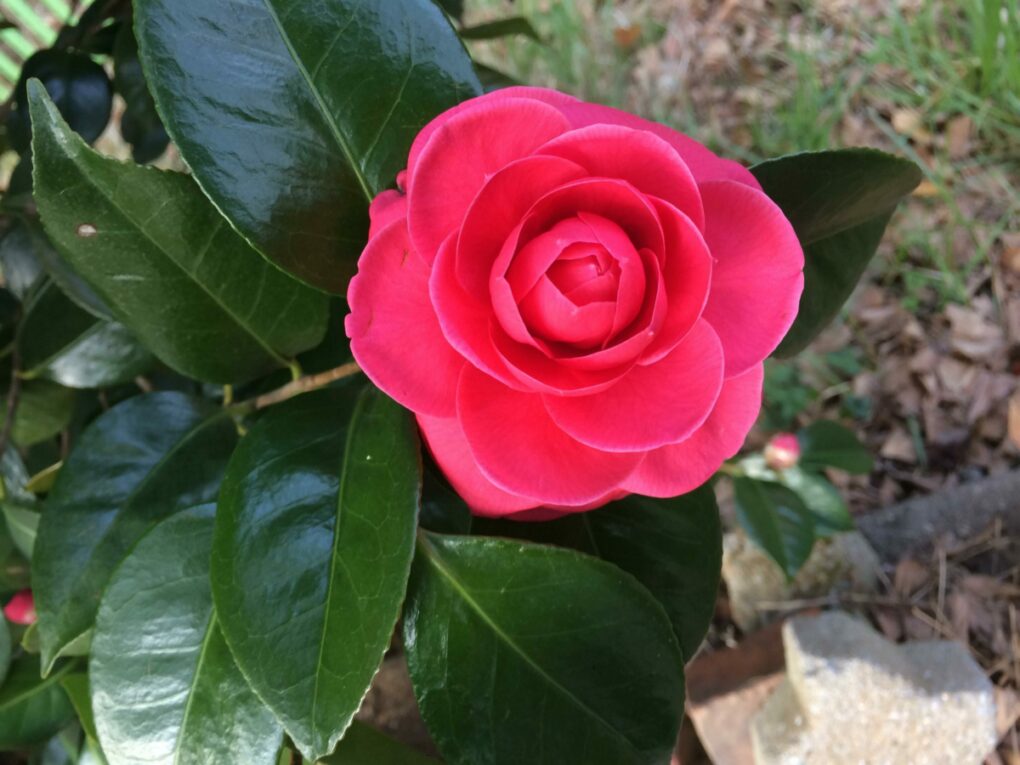
Relax at Jirisan Spa Land. If you've never been to a Korean sauna, you are missing out. Spas are a national past time here, and they're also quite affordable, and fun in a group, couple, or solo. Jirisan is particularly well-known because it features hot springs-supplied baths. Keep in mind that like all Korean spas, the indoor regions of the spa are separated by gender and have a no-clothes policy.
Do a photo shoot amongst Gurye Cherry Trees. These bright yellow blossoms have taken up root throughout the village of Gurye, bringing hoards of people (& tourism dollars) to town every spring. In the fall, the trees' cherries cover them in color once again, this time a deep red . If you manage to visit in March (outside of festival time), you may even find this to be the perfect spot for a photo shoot.
Ride the Yeosu Cable Car. Especially beautiful around sunset, Yeosu's cable car takes you across the bridge which connects Yeosu to the mainland. From an incredible height it gives you a look at the still-active port area and many smaller surrounding islands. Not to mention it saves you a taxi ride!
Drink up at Boseong Green Tea Fields. The green tea fields of Boseong hit their peak around mid-May, but they start turning a deep green color as early as March, continuing to lighten until late September. Koreans come to visit the main green tea plantation in order to hike up to the top of the hill on which the tea trees are planted.
Most people end up taking selfies and enjoying the view of everyone walking around far below them. At the plantation, other than the tea itself, you can enjoy green tea-flavored churros, lattes, and even a few savoury dishes (though don't expect much tea to be put in those).

What To Eat In Suncheon
Suncheon is often hailed as the foodie capital of the southern part of Korea. Located near the coast, in Jeollanam-do, local restaurants in Suncheon will serve all the classics, but with a southern twist. Popular themes include seafood, fresh local vegetables, and abundant side dishes.
Mudskipper Soup. Arguably the most popular way to consume this local fish, the soup is prepared using boiled fish, radish leaves, and soybean paste. It's a very strong flavor, but all the side dishes it's served with temper it beautifully.
Kongnamul Gukbap . Literally "soybean soup rice," you can find gukbap all over Korea; I actually recommend trying a hearty pork or beef version in Busan. But each region has their own special recipes for the soups and when they add the rice and where they source the ingredients. In the case of Suncheon's gukbap , the soybean sprouts add beautiful crunch to a very traditional Korean dish.
Sannakji Bibimbap. Another dish I sort of recommended in Busan, sannakji is basically the freshest form of raw octopus you could eat, served with lemon juice and seasoned with sesame oil. This iteration is less of a snack and more of a full meal, incorporating fresh vegetables and rice. Look for 산낙지비빔밥 on a menu.
Green Tea Churros. I couldn't recommend visiting the green tea fields of Boseong without also recommending the snacks! Only available on the weekends, these churros are nice when paired with a cup of green tea soft serve ice cream.
Grilled Duck. Suncheon famously raises about half the duck in Korea, meaning that finding a local duck dish is more likely than not. If you can find it, my favorite is Yangnyum Ori (양념오리).
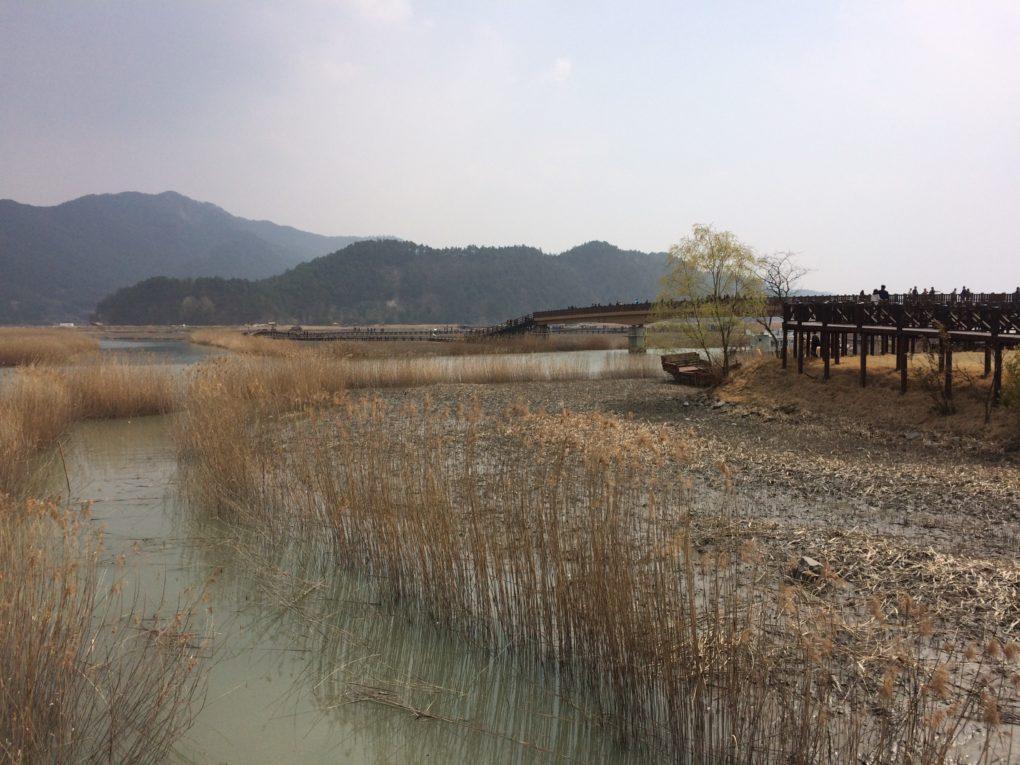
Where To Stay In Suncheon
Suncheon is quite the hot spot for domestic tourism, so most of the places to stay in Suncheon are Korean-style. This means that you sleep on the floor, and usually call to book directly. But there are some nice western-style guesthouses to choose from, three of which I've listed below. If you're visiting Suncheon between April and June, I'd recommend booking a guesthouse in advance!
Budget: Suncheon Namu Guesthouse
You can't get much closer to Suncheon bus terminal than Namu Guesthouse. No matter what time of day or night you arrive (or depart), if you stay at Namu you're just a few minutes from the city's bus terminal.
The beds are pretty standard for Korea, on the hard side, but the shared space is very homey and comfortable. At just $16USD a night for a dorm bed, it's the perfect spot for those planning to stay awhile and do a lot of day trips.
Budget: Baguni Hostel
It's rare to find a hostel with affordable dorm beds and a decent sense of privacy, but Baguni manages to strike this balance with grace. The dorm beds are each in their own little cubbies, with privacy curtains and fluffy bedding.
But the building itself makes use of lots of white and neutral tones, choosing to focus mainly upon providing a clean, comfortable, and affordable environment for guests.
The hostel is located right in the city center, a short walk from the bus terminal, making it a great choice for visitors who can't or choose not to rent a car. Single hostel beds start at $18USD a night.
Mid-Range: Hotel Iam
Every room at Iam includes an en-suite bathroom and complementary breakfast in the dining room. For those looking to upgrade their stay in Suncheon, this is an affordable hotel with comfortable beds, a nice staff, and a central location.
It's family-friendly, but more popular with couples looking to get away from hostels without breaking the bank. Double rooms start at $40USD.
Click here to check out prices for other hotels in Suncheon
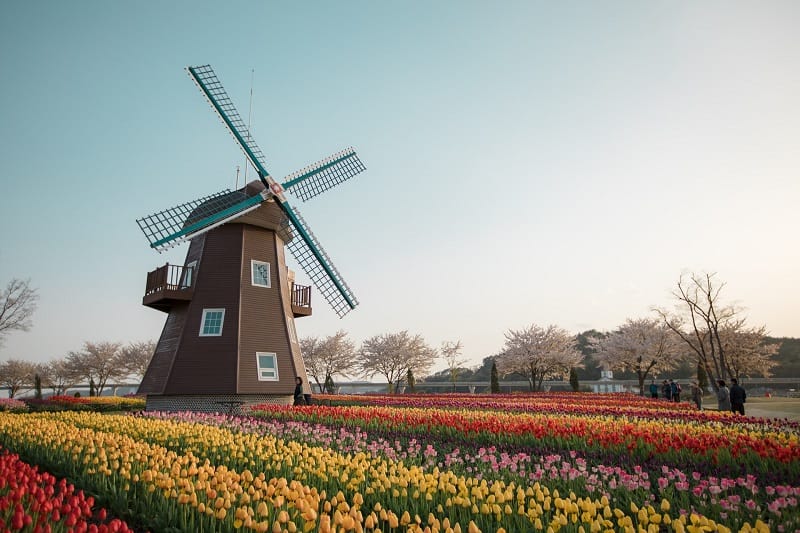
✈ Jeonju
What jeonju is known for.
Despite being just 1.5 hours from Seoul, Jeonju rarely features on a Korea itinerary, and that is a mistake. While you can easily visit Jeonju on a day trip from Seoul, I humbly recommend you spend at least two days in the city.
Preferably while staying in one of the historic houses & enjoying traditional Korean dishes in Korea's "Foodie Capital." Unlike Suncheon, most of the things to see in Jeonju are within the city itself, making it walkable and perfect for any wintertime Korea itinerary.
Seoulites tend to visit the city on the weekends, so take a couple of weekdays to discover the city whose name literally translates as "perfect region." While you're there, make the most of your time with visits to local galleries and walks around the city's many parks and green spaces.
Jeonju is seen as a very spiritual city, a place of historical importance for its maintenance of traditional foods, architecture, and those intangible parts of Korean culture we all strive to experience in a new place.
What To See Around Jeonju
Jeonju is a great place to just walk around, similar to some of the neighborhoods in central Seoul, but it's always nice to have a destination in mind. So in order to give you an idea of some of the things you can do in Jeonju, here are 7 things you should do or see in the city.
Photoshoot in Jaman Mural Village. Somewhat similar to Gamcheon Cultural Village in Busan or Rainbow Village in Taiwan , Jaman has become a symbol of revitalization for older parts of the city.
While the nearby hanok village has become well-known, just beyond the overpass is Jaman, a neighborhood painted up & beautified by local artists. The uphill scene is worth the trip, and makes for some very cute photos, especially for families and couples.
Tour a Hanok . A hanok is a type of small house, traditionally one story tall, which were the main type of dwelling in Korea for centuries. Due to Jeonju's ancient status, it was designated a UNESCO City of Gastronomy, and as a result, the rest of the city has also been well-preserved.
One thing that sticks out in Jeonju compared to Seoul or Busan is the height of the buildings. It can be hard to put your finger on at first, but you'll quickly notice how short most places are, and how it opens up the entire city.
This is due in large part to the city's hanoks . Places feel greener, even when you visit Jeonju in the winter. While you can tour a hanok ( hopefully stay in one, too! ) just by walking by, I'd also recommend checking out Gyeonggijeon Shrine for a more holistic look at how hanok culture shaped contemporary Korea.
Eat Street Food at Nambu Night Market. You can't recommend a visit to Jeonju without also recommending a trip to a night market. Korean night markets are notoriously boisterous affairs, with locals loudly hawking their wares from the safety of their booths, wafting any number of smells your way. The market is open every day, but Fridays and Saturdays are the busiest of all.
Some delicacies to enjoy once you've feasted your eyes are the grilled meat skewers, daepae saewoo (pork-wrapped shrimp), and hoddeok (honey cinnamon-filled rice cakes), though there are many international dishes, as well.

Try Dolsot Bibimbap With Makgeolli . Those little gold bowls full of translucent white liquid have become a staple in my life. Anytime staff at my job went out to dinner together, we always had makgeolli (rice wine), usually served from a big pot in the center of the table.
This is the most traditional way to consume the traditional rice liquor, and it's a great accompaniment to Jeonju's famous version of bibimbap (mixed rice). Try it almost anywhere in the ancient village, and I guarantee a smile.
Wear a Hanbok Amongst Hanok. Similar to the beautiful hanbok (traditional Korean outfits) you'll see in Seoul and Busan, it's almost a rite of passage to wear a hanbok around Jeonju. If you want a more unique experience in the city, this is the move. Rentals start from ₩8,000 (~$7USD), and range from 1-4 hours.
Have Tea in an Ancient Cafe. Or at least in a cafe that looks ancient, as many of the cafes in Jeonju's downtown area have been styled to look.
Some of the cafes are even in a hanok , which makes the tea-sipping feel all the more event-like. Some great cafes in Jeonju are Café Haengwon and Swan Park Cafe, but just remember to have a translation app on hand for the menus.
Admire the Flowers in Deokjin Park. One of the most popular gathering places in Jeonju, Deokjin Park has now become a draw for visitors, as well. In the spring there are flowers everywhere, while the summer sees the lotus blooming on the lake & fall brings changing colors to the leaves.
If you visit from July to August you'll notice crowds of locals taking pictures with the lotus flowers, as the high season coincides with kids' summer break.
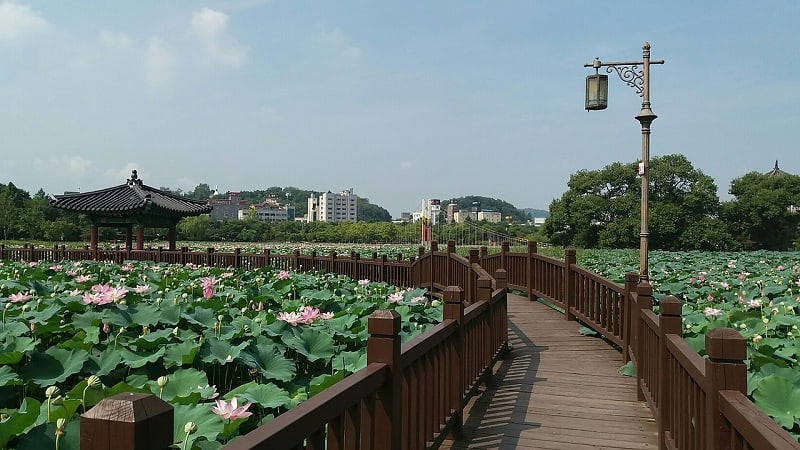
What To Eat In Jeonju
Despite the popularity of Suncheon as Korea's underground foodie capital, Jeonju is the official foodie capital of the country. In fact, in 2012 it was named a UNESCO City of Gastronomy. Domestically, Jeonju is known for its fresh vegetables and locally-grown rice, as well high levels of spice, so prepare your palate.
Legit Choco Pies. The infamous Korean treat of Choco Pies, which my students simply adore, were actually born at a bakery here in Jeonju. The bakery, PNB, has branches throughout the city, where you can find the layered chocolate and marshmallow pastry in multiple iterations.
Grilled Imsil Cheese. Korean cheese is notoriously gross. But many years ago, in a town just outside of Jeonju, one company faced this problem head-on: Imsil. In street food regions throughout the city you can find thick skewers of carefully grilled Imsil cheese, lightly sweet and crispy on the outside, halloumi-like in texture.
The brand also makes some delicious yogurt, and if you took the bus to & from Jeonju, you may even stop at an outpost where you can buy some of their cheese & yogurt. Go for the blueberry flavor; you can thank me later.
Jeonju Royal Court Cuisine. Gung hanjeongsik , as it's called in Korean, is the modern retelling of the special food eaten at the King's palace during the Joseon Dynasty. Even back then it was so intricate to prepare that it was only consumed once a month. One of my friends insisted that we try this type of meal when we went to her hometown, and it does not disappoint.
The setup is basically three tables covered in dozens of side dishes and a few main meals, all emphasizing local specialties from different parts of the country. This special meal is an investment, maybe $45USD per person. But it's seriously worth it.
Ddeok-galbi. Another local recommendation, these short rib patties will make your mouth water. They're prepared using marinated galbi , usually pork, and onion, garlic, ginger, and a umber of other spices. The meat is ground and then reformed into thin patties before being grilled on skewers or back on the bones; they're served with white rice and numerous side dishes.
Dolsot Bibimbap. While bibimbap (rice with steamed vegetables) is common throughout Korea, this version is unique because it's prepared in a piping hot stone bowl ( dol is Korean for "stone"). The rice is allowed to crisp up on the bottom, adding a delightfully different texture to the mix of ingredients.
This mix almost always includes fresh vegetables, kimchi, oak jelly, a small amount of beef, and a raw egg to stir into the steaming hot dish. Jeonju is so synonymous with bibimbap that there's now Bibimbap Festival every year. Just don't touch the bowl!

Where To Stay In Jeonju
One of the main reasons people choose to visit Jeonju over any other destination in Korea is for the hanoks (traditional Korean houses). All of them are now also equipped with ondol , the typical Korean floor heating system, making them quite comfortable even on the coldest of nights.
So most visitors do opt to spend the night in one of these beautiful guesthouses, most all of which are clustered in the famous Jeonju Hanok Village (in the southeastern part of the city).
But I'm not a huge fan of sleeping on thin blankets on a hard wooden floor, despite having done it a few dozen times. So here I've recommended just one hanok -style guesthouse, the two other being more western-style accommodations.
Budget: 24Guesthouse Jeonju
24 is a popular guesthouse chain, and I've stayed in several of their locations throughout Korea. They offer affordable double rooms with en-suite bathrooms, as well as 3- to 4-person hostel-style rooms for some of the cheapest prices around. A simple coffee & breakfast is included.
The guesthouse is a few blocks north of the Hanok Village, allowing you to be near but not right inside all of the action. At just $14USD a night per dorm bed, it's hard to beat the price if you're visiting Jeonju on a budget.
Hanok: Bu Kyung Dang Guesthouse
This is one of the most beautiful and most-loved hanoks in the whole village; no exaggeration. The entirety of the property consists of just 8 rooms, surrounded by greenery, which is found in full bloom if you visit in the spring.
On the outside is the traditional slatted doors with a paljak roof and paper lanterns around the perimeter. But heading inside you'll find a beautifully refurbished stone-tiled bathroom and wide open rooms. Grab a blanket from the stack and settle in for the night. Rooms start at just $32USD per night.
Mid-Range: N Bridge Hotel
Non- hanok accommodation in Jeonju is incredibly hard to come by; most people want to stay the night in the famous Hanok Village, and seem to have no problem sleeping on the floor. But for my fellow non-floor sleepers— at least those not on a budget— I'd recommend N Bridge.
It's got big fluffy beds, 24-hour service, and a fridge in every room. Unlike most of the hanok options, it also has multiple floors and a marble bathroom in every suite. Just be sure you don't book their futon room unless you actually do want to sleep on the floor, Korean-style. Double rooms start at $74USD.
Click here to check out prices for other hotels in Jeonju
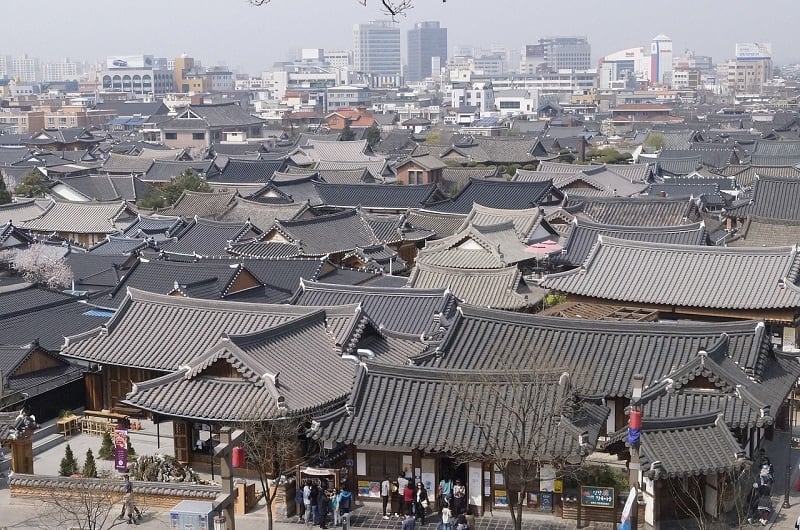
🧳 Budget For A Trip To South Korea
Of all the countries in East Asia, I'd argue that South Korea has become the most affordable to visit. There are many extremes to be found in the ROK (Republic Of Korea), a fact which extends to my daily life here over the last few years.
Visitors could stay in super cheap dorm beds booked way in advance for about ₩12000 ($10USD) a night, eat street food for another $10USD a day, and otherwise spend money only on transportation. I wouldn't recommend it, but it's doable.
On the other hand, Seoul is a massive city with plenty of hotels always ready to take your money. $500USD a night hotel rooms aren't the norm, but they're there. The key is to find a balance, and if you're looking to travel Korea on a budget, then make a list of priorities.
Do you most want a nice place to sleep? Fancy meals? Involved day trips? Budget travel in Korea is 100% possible, but it takes planning. So here's a rundown of the costs of traveling in Korea.
Note that this South Korea travel guide covers such a wide range of days that the budget below is a snapshot of how much you could spend in one day. My dad would call them "guesstimates." It also covers the cost of basic activities which most everyone would do. Remember to multiply this Korea travel budget by the number of days you'll be visiting us for!
ESTIMATED COSTS:
- Visa Fee : ₩30000 (to check if you need a visa, click here )
- Day Tours : ₩70000 (some day tours cost more, but these kids of trips include visiting the DMZ , Nami Island, and Jeju tours)
- * Each Trip To A New City : ~₩30000 (one way; this is an average)
- * Round Trip Airfare to Jeju : ₩80000 (if booked well in advance)
Decent Guesthouse : ₩25000
Meals & Snacks : ₩20000
Attractions & Activities : ₩10000
Transportation : ₩5000 (4 trips on the subway or bus)
Souvenirs & Cafes : ₩5000 (coffee or tea)
Average Cost Per Day : ₩ 65000
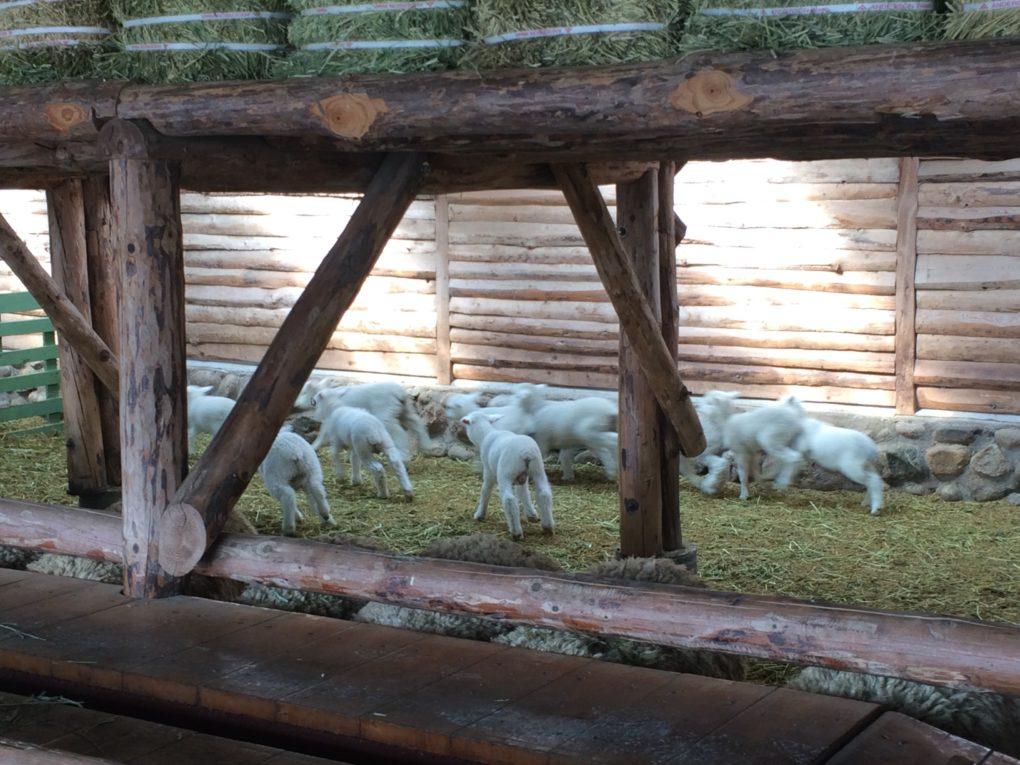
🚈 South Korea Travel Tips
- Metros aren't very accessible but the buses and taxis are. So if you're in a hurry or disabled, then you should take a taxi. They're very cheap and fast, though during rush hour they'll take as long as the metro. Most shops (like Korean chocolate shops ) are clustered right around metro stations anyway, so even if your driver doesn't speak much English you can tell them the name of the metro station closest to where you're going.
- Korean winters are not for the faint of heart . My friends from Vietnam visited me last winter and spent their first day alone— they were shivering for hours after we came inside. Even my sister was not very happy with all the snow over New Year's when she visited a few years ago. It can get brutal, thanks to winds coming down from Siberia.
- Also not for the faint of heart, entitled old people . They will push you, publicly and without shame if they think you're in their way. I understand that they act this way because they don't think young people respect their elders like they should, and they don't, in my opinion. But no matter how you think, it is something to be aware of.
- Korea is basically a cashless society , except for in the markets. This means that you can use your credit card most everywhere, but international cards aren't always accepted, so still keep some cash on hand.
- Along similar lines, in Korea you should expect late nights and late mornings . Cafes, restaurants, and shops are open very late, usually between 10pm and midnight, but rarely open before 11am. If you want morning coffee if Korea you'll have to either be at the airport or grab canned coffee from a convenience store.
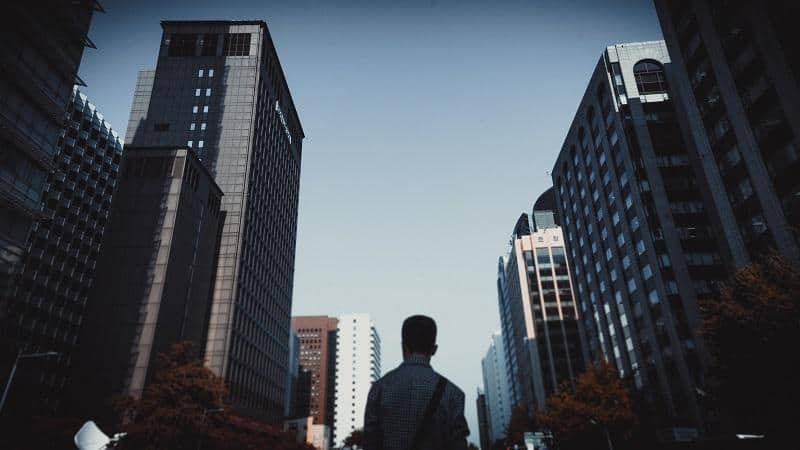
- Even though it's a more developed country, Korea has their share of travel scams. One of the most common is the fortune teller scam , in which a woman stops you on the street and offers to take you to have traditional experiences, only to scam you out of money. Either way, if someone stops you on the street, 95% of the time they want your money or to convert you. NYC rules apply.
- Pollution is horrible. Sometimes the skies aren't as bad, but spring 2018 and winter 2019 were particularly harsh, with many days seeing pollution levels as high in Seoul as in Beijing, China. Bring a mask, or buy one, especially if spending 2 weeks in South Korea, or longer.
- Naver Maps will tell you which door of the subway you should go to for the faster arrival at your next destination.
- If you're a bigger person , look for handicap-accessible or family bathrooms, as Korean public bathroom stalls are made for small people, especially the women's bathrooms.
- Look up . If you're looking for an office or guesthouse or restaurant, and you'd swear you're at the right address, just look up. It's probably just on a much higher floor, like the 11th or 32nd.
- However, when you do look up, don't make eye contact unless you want to start a conversation or get stared at as you walk away (though that might happen anyway, in the countryside).
- Hospitals are for everything , even if you're a visitor taking various South Korea tours and end up with a cold. The hospital is like the doctor's office, and in small towns like mine, they're open 9 to 5 like everything else.
- Always count to 5 before crossing the street , because without fail, at least once a week I watch someone go after the light turns red, be it a car or a motorbike. Better safe than sorry.
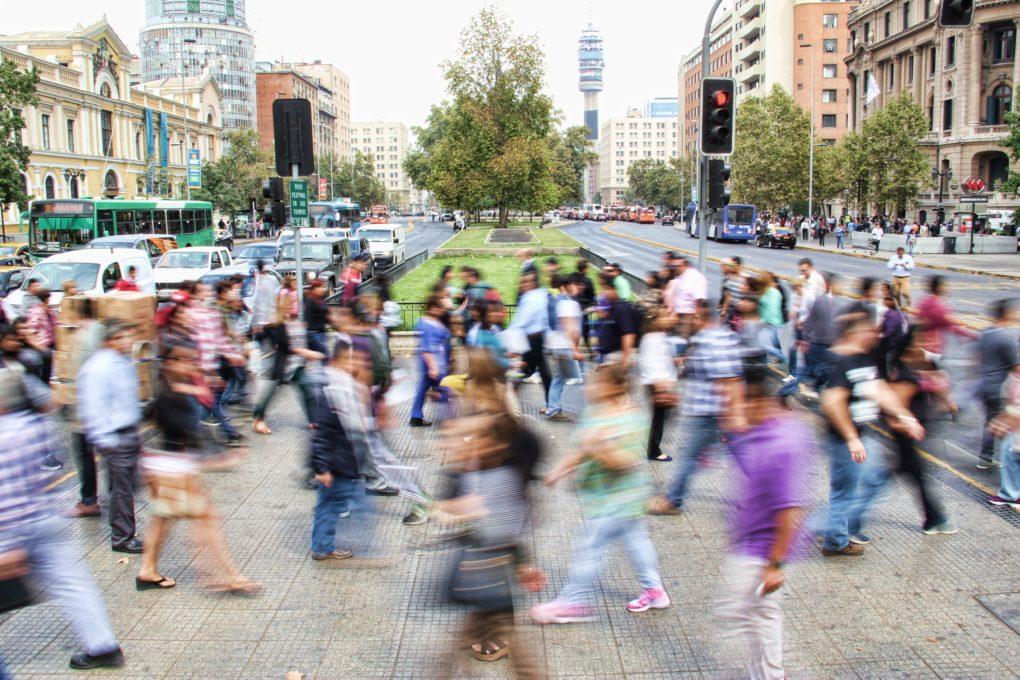
☺️ Basic Phrases For Your Trip to Korea
Hello // An-nyeong-ha-se-yo . (안녕하세요.)
Thank you // Gam-saahm-ni-da . (감사합니다.)
How much is it? // Eegaw eol-ma-yeh-yo? (이거 얼마예요?)
Do you speak English? // Yeong-aw jal-hae-yo? (영어 잘해요?)
I don’t speak any Korean. // Han-guk-aw jal-moat-hae-yo. (한국어 잘못해요.)
One of these, please. // Ee-gaw ha-na ju-say-yo. (이거 하나 주세요.)
It’s to-go/takeout. // Po-jahng ee-eh-yo or Tae-ee-kow-shi-yay-oh. (포장 이예요.)
Lesson complete! Now let’s get packing.
Did this post help you plan your trip to Korea? Save it on Pinterest so that it can help others, too!
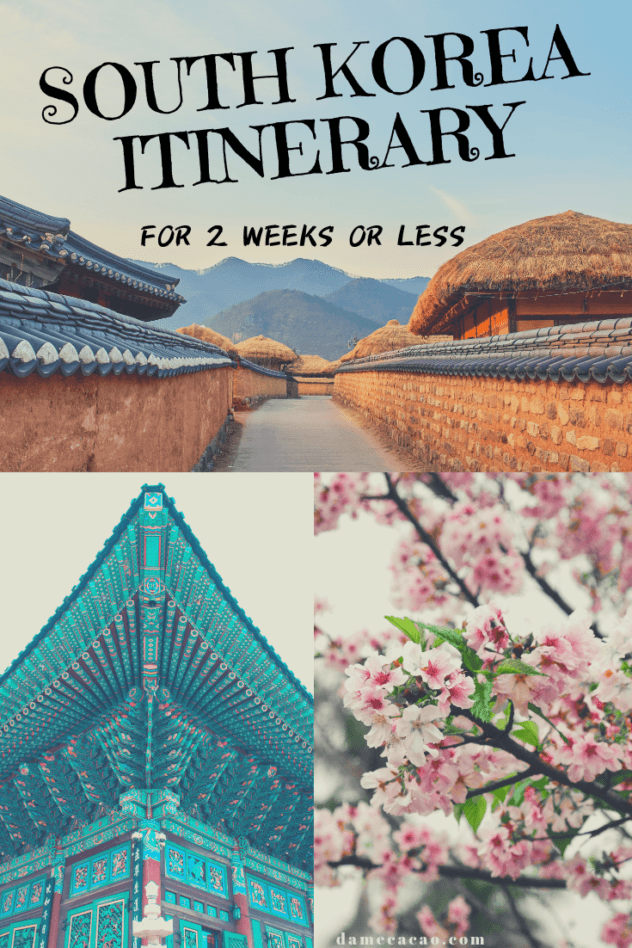
More South Korea Travel and Life

Reader Interactions
Happy Travelers
January 13, 2024 at 4:42 pm
Thanks for creating a 14 day with Jeonju! We will be in Korea feb 7-21 and obviously plan on seoul, busan, and jeju. We really wanted to hit Jeonju but was reading about doing a drive from seoul east and then south to hit Chuncheon, Sokcho, Gangneung, Samcheok, Andong, Gyeongju, Seokguram and skipping Jeonju.
I was wondering since we will be there in the Winter, which would you recommend the Jeonju plan or the east plan?
January 14, 2024 at 2:46 pm
Thank you for the kind words! At that time of year, you'd be better off giving Jeonju a visit since the warm weather that would make the east coast drive so pleasant & beautiful would be nonexistent right then. You'll also be overlapping with Seollal, or the Lunar New Year (weekend of Feb 10), with those dates, so renting a car may be a bit harder and traffic will be CRAZY heading out of the city all weekend (everyone is taking their fmailies back to the countryside to see parents/extended family). However it will be just one weekend out of two, so I recommend you just plan around that, and definitely give Jeonju a few days!
August 18, 2023 at 4:02 am
Thank you for your post. I wonder how to use 'Kakao talk' app during travel in Korea. Is there any way to use it?
August 20, 2023 at 5:55 pm
My pleasure, Kim! You can download Kakao Talk before your trip, but since it's connected to your phone number, if you need to get a local sim card in Korea, you'll just need to make a temporary new account for use in Korea. So unless you'll use your phone's regular sim card while in Korea, I recommend waiting until you're IN Korea to make your account for use during travel in Korea. Then you can use it to communicate with taxi drivers, food delivery, Air BnB hosts, local friends, etc.
August 07, 2023 at 6:14 am
Thanks for your great posts! I used this one (and a few others including the Seoul and Jeju one) to help me when I went to South Korea for two weeks. I read a few blogs on the internet, but your style and interests most closely matched me. Hope you are doing well one your new adventures 🙂
August 10, 2023 at 9:26 am
Thank you for the kind words, Kim! I'm glad you've found it all helpful. 😀
August 04, 2023 at 5:48 am
Hi, we are going to prepare a tour with golfers to Korea and beside of golf your information are very helpful. Do you live in Korea and work as DMC?
August 04, 2023 at 1:36 pm
That sounds like a very fun tour indeed, but unfortunately I don't like in Korea anymore, nor have I ever worked as a DMC. But good luck with your search, and enjoy your trip!
June 13, 2023 at 11:05 pm
What a great post! Thanks for sharing. We are planning to come from June 29th to 9th July. What do you think about the weather? Can we come now or delay due to rain and heat? Also, in Seoul what is a good location for a family stay - Four Seasons and something in Gangham?
June 14, 2023 at 12:40 am
My pleasure, VK! And since it's monsoon season, it's honestly pretty unpredictable as to which days might be nice, but with such a long stretch of time, you're bound to get some good weather days and maybe a bit of rain. I have a post covering 100+ things to do in Seoul , so I recommend looking through that and over the map on the bottom to note some things that look interesting & rain-proof, as well as some options for stuff close to where you choose to stay.
Speaking of, the Four Seasons is lovely, but I was also incredible impressed with VOCO Hotel in Gangnam . It's an affordable IHG property a block or two from the metro, and I felt like royalty for much cheaper than the Four Seasons (like 1/3 of the price)! But it's always worth comparing the two side-by-side, as the Four Seasons would offer slightly different amenities and is in an arguably more central tourist location. Either way, summertime will be warm in Seoul, but everythng is open and tends to have longer hours due to the increase in domestic tourism.
Enjoy your trip!
June 14, 2023 at 8:34 am
@Max, Thank you so much for your kind response and the details provided. I am planning to do 4 nights in Seoul, 2 nights in Busan, and 4 nights in Jeju. Is that plan correct? Given a choice you would me to skip summer and rain and come later or it is still okay to come from 27th June - 7th July? As we don't to come and spoil the trip - I hope you understand :).
The Hotel option you gave is great. I will definitely have a look. Is it better to stay in Gangnam or the area where the Four Seasons are? I know I am asking too much but if you have any recommendations for Busan and Jeju as well - would love to take your feedback.
Thanks so much again.
Regards, VK
June 14, 2023 at 5:24 pm
That's how I'd plan it out! And honestly, you can't predict the weather well enough to say whether it will rain half the days or just one or none. It can be rainy from June to September, and it gets quite cold after that, so sometimes you just have to roll the dice. If given the option, summer would be my pick over winter, but even if I knew the other times you'd be able to go, we'd still be in the same predicament about not being able to know for sure how the weather will be.
If the price difference doesn't matter as much, the Four Seasons would be my pick for a first-time visit, because it's truly in the middle of the touristy area with a large chunk of the museums, hanok (traditional) houses, souvenir shopping, royal palaces, and a ton of restaurants with great Korean food and mostly translated menus. Voco (and Gangnam as a whole) is about a half hour metro ride from that area, and while it's great for fancy shopping, visiting Lotte Tower, and some fabulous meals (if you eat beef then definitely try hanu , or Korean domestic beef, while you're there), it has a few tourist-friendly museums and not so much else. But what you save in staying there would more than pay for taxis all throughout the city! So each has their pros, and you should pick the one that's right for your preferences.
As for the other two, I spent many hours compiling accommodation guides for both Busan and Jeju Island , and you can read about the various neighborhoods/parts of the island in each, and make the best pick for each based on what you plan to do there. Again, since I'm not sure what attractions you're most interested in, I do think it would make more sense for you to look through those for the best picks for you personally, rather than booking only based on my recommendation. And if you do still have more questions after reading through those two posts, just leave another comment and I'd be happy to answer them there.
I never mind answering questions, as frustratingly few bloggers seem to still do so. But if you've found any of the info helpful, I always appreciate it if you book through my affiliate links. I specifically work with Agoda for hotels because I've always found that they have the best prices on accommodation throughout Asia, and always throughout Korea. But if you don't, no big deal; just wanted to mention it as a free way to say 'thanks'! 🙂
June 14, 2023 at 10:02 pm
@Max, Thank you so much for your kind help and answering questions. This really helps a lot. I will definitely use the affiliate links:)
Susan Hughes
February 25, 2024 at 11:01 am
My husband, oldest daughter, possibly a friend of hers and I will be in South Korea, leaving DFW the 9th (not getting there till the 10th at 3:15)-and returning the 20th at 5:25. Trying to come up with a tentative itinerary so we can experience the most of our time there. Seoul, Busan and Jeju Island are my top places to visit. I’m a Korean adoptee and would like to visit an orphanage. If you have information about Holt orphanage that would be wonderful. I was adopted in 1973 which the orphanage was called Livingstone but changed to Holt. Trying to determine if we should stay around Seoul when we get there or when a few days before we head back home. I’m realizing I should have booked 2 weeks which a friend who is living there for a year suggested but i compromised with 10 days. Would love to hear what advice you have to give. I’m just starting to do research so any info other than what you have said in your post would be much appreciated. Wish you were there when we are to be our travel guide😂Looking forward to hearing back from you!
February 28, 2024 at 1:14 am
Hi, Susan! That sounds like a wonderful experience you have planned. I'm sorry I don't know anything about Holt, but I also did my best to include every little detail about visiting in this post - it's over ten thousand words! However, when planning timing, I'd say to know your limits. If you're flying direct from Dallas and know you'd be up for another short domestic flight that would get you to Jeju by 7pm or 8pm, then I'd say to go directly to Jeju, because getting into Seoul formt he airport in Incheon take about 2 hours. It's a trek, and your time is better spent getting your sea legs, so to speak. From a few days in Jeju first, I'd fly from Jeju to Busan, then take the train from Busan to Seoul and leave form there. Lots of options depending on your particular interests!
Leave a Reply Cancel reply
Your email address will not be published. Required fields are marked *
This site uses Akismet to reduce spam. Learn how your comment data is processed .
South Korea Solo Travelling Guide: 20 Things To Know, Including Restaurants For Single Diners & Female-Only Hostels
Guide to solo travelling in South Korea
Travelling alone to a foreign country requires a lot of courage and there are many things you’ll have to know before embarking on your trip. Here’s a guide to solo travelling in South Korea , so you can fully enjoy your stay in the country with less to worry about.
1. Book accommodations in bustling areas
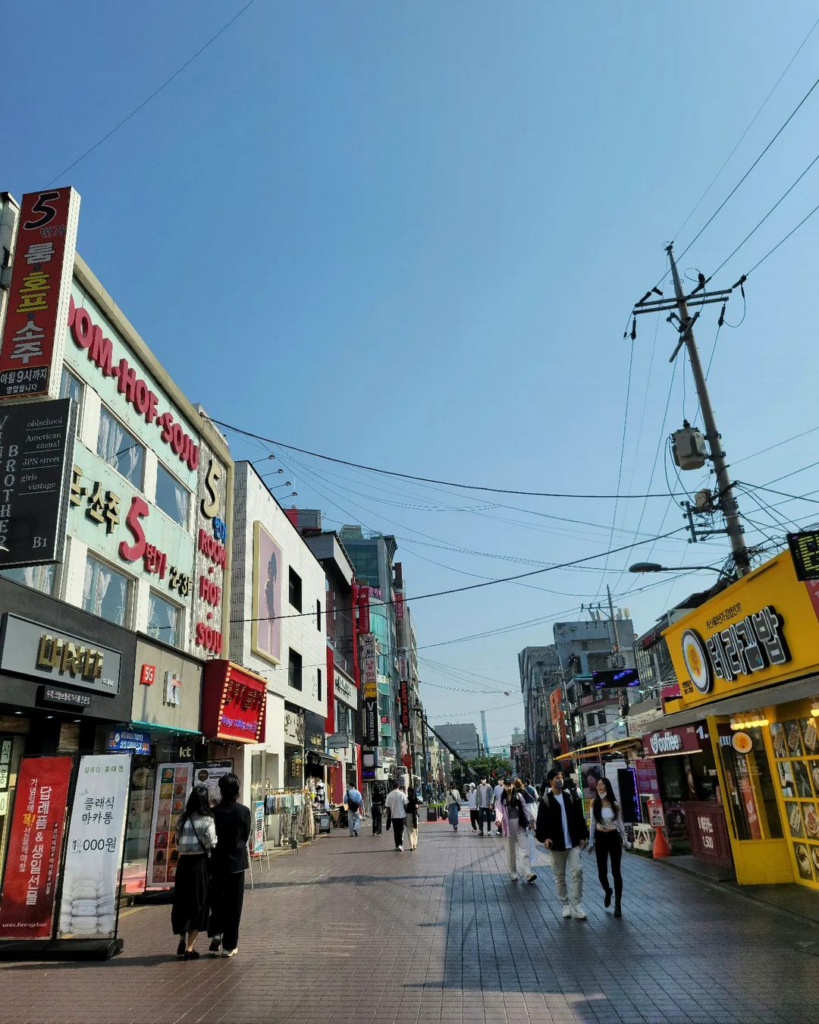
Although South Korea is a relatively safe country with low crime rates, safety should never be taken for granted. It’s better to be safe than sorry w hen looking for accommodation.
We recommend checking out places in the bustling areas such as Myeongdong and Hongdae. Accommodation in these areas tend to be on the slightly pricier end, but there are plenty of shopping districts and restaurants in close vicinity.
Avoid staying at places that are hidden in alleys or are too far from the train stations and bus stops as they are not the safest for tourists.
2. Stay at female-only hostels
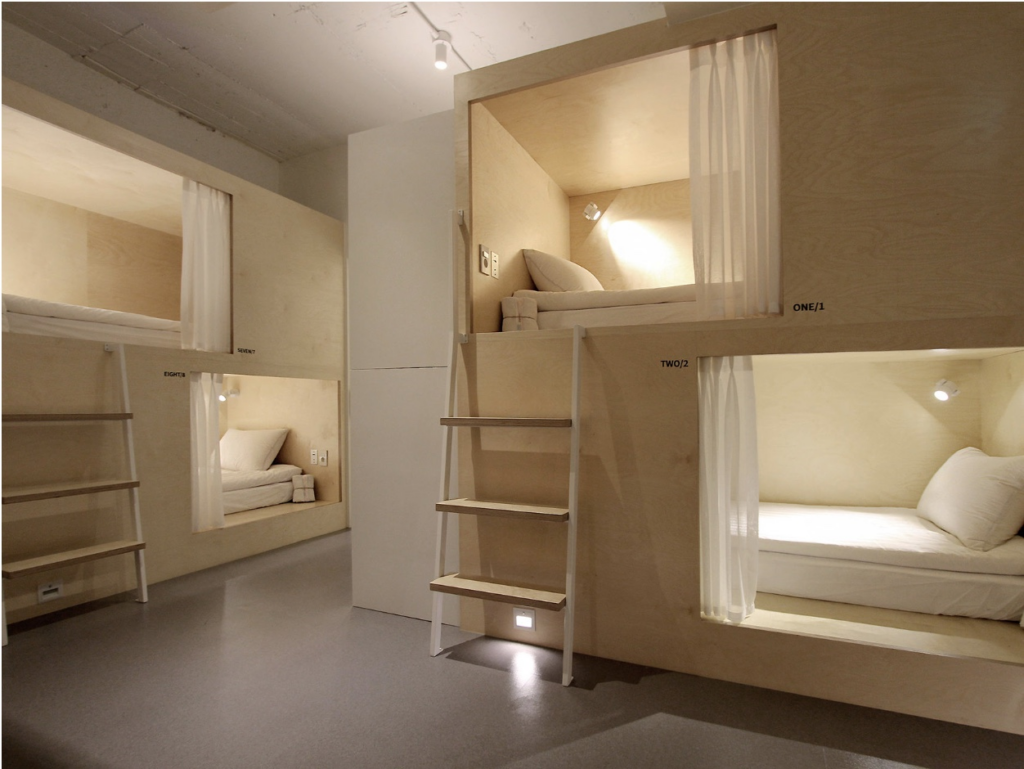
Females travelling solo may want to consider opting for female-only hostels. Living in a female-only hostel allows you to meet people from all walks of life, and who knows, you may even make a new female friend.
However, if you are uncomfortable sharing a room with other travellers, we strongly encourage you to opt for the next option instead.
3. When to opt for goshiwon
A goshiwon may be a wise choice if you are tight on budget and would prefer more affordable accommodation options.
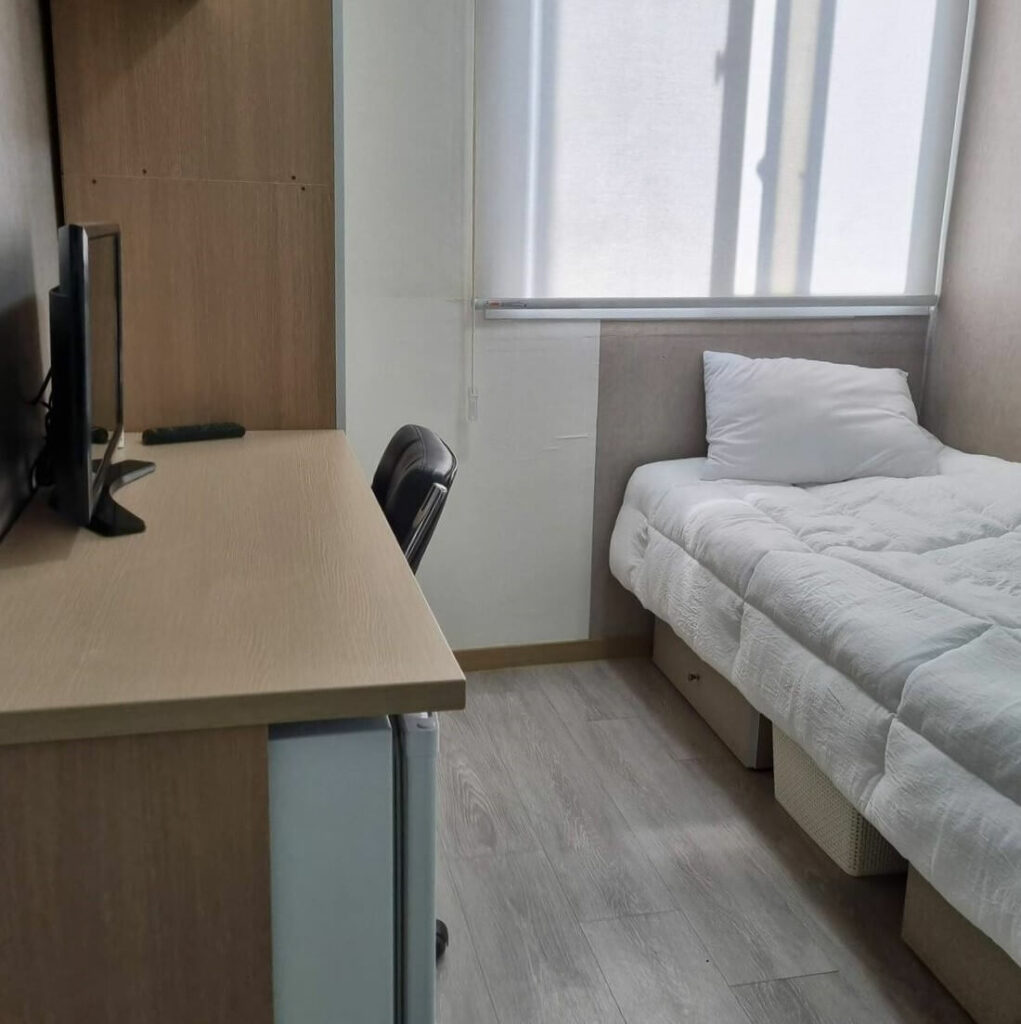
A goshiwon is an off-campus dormitory and the cheapest form of accommodation available in Korea. You don’t have to be a student to rent a goshiwon room.
Note that the rooms are usually small, and oftentimes, you’ll have to share a common bathroom with other occupants.
3. When to stay at hanok guest houses
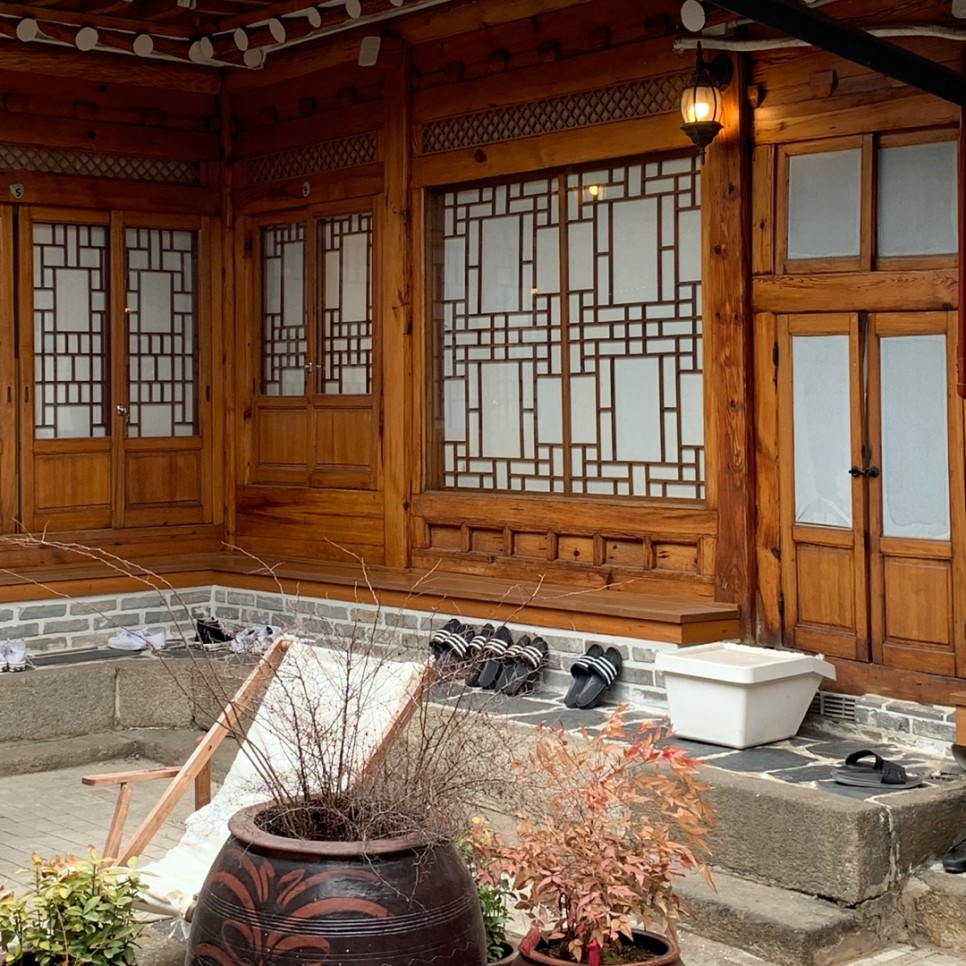
If you’re in Korea and want to experience traditional Korean culture, definitely try staying at a hanok (traditional Korean house) guest house.
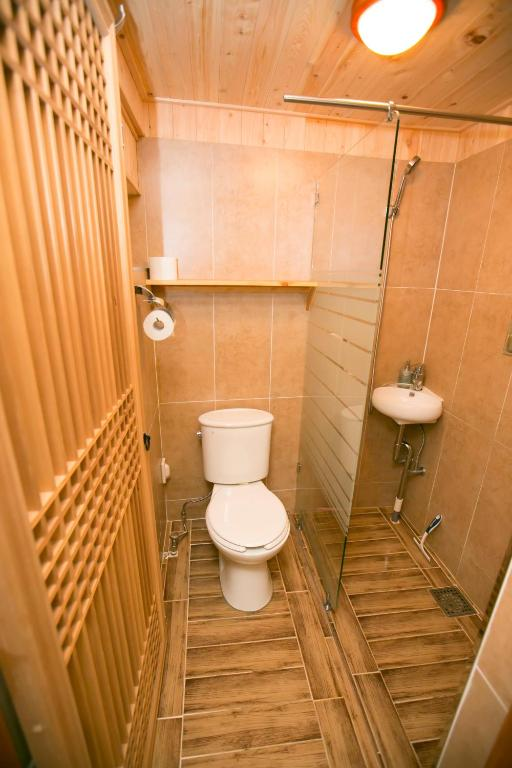
These hanok guest houses are revamped and outfitted with air-conditioning and modern toilets to let you have a comfortable stay.
Staying at a hanok guest house is also great for solo travellers who want to meet new people and learn more about different cultures too.
4. Get a duffel bag for extra storage & convenience
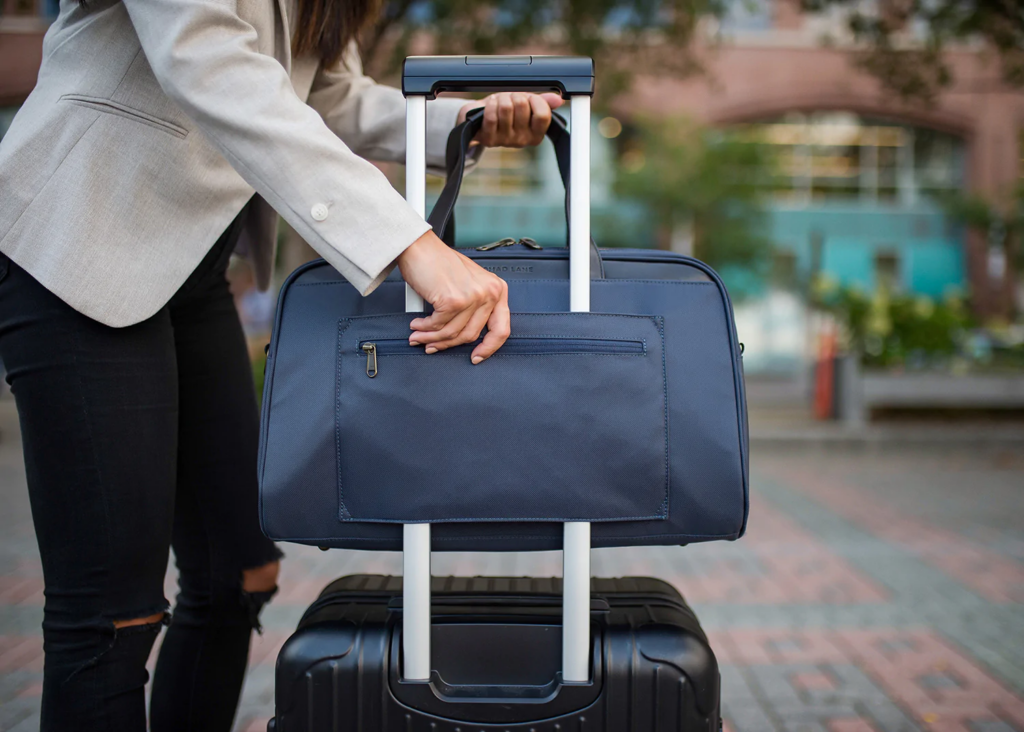
Travelling alone means that no one will be there to carry your luggage.
A duffel bag will come in handy if you are going on short trips to other cities as it serves as a great alternative to carriers.
Keep your hands free by getting a duffel bag that can be slotted into the handle of your luggage. This makes it more convenient for you to navigate around the bustling city without having to worry about accidentally leaving something behind because your hands are full.
5. Invest in a selfie stick with a tripod stand
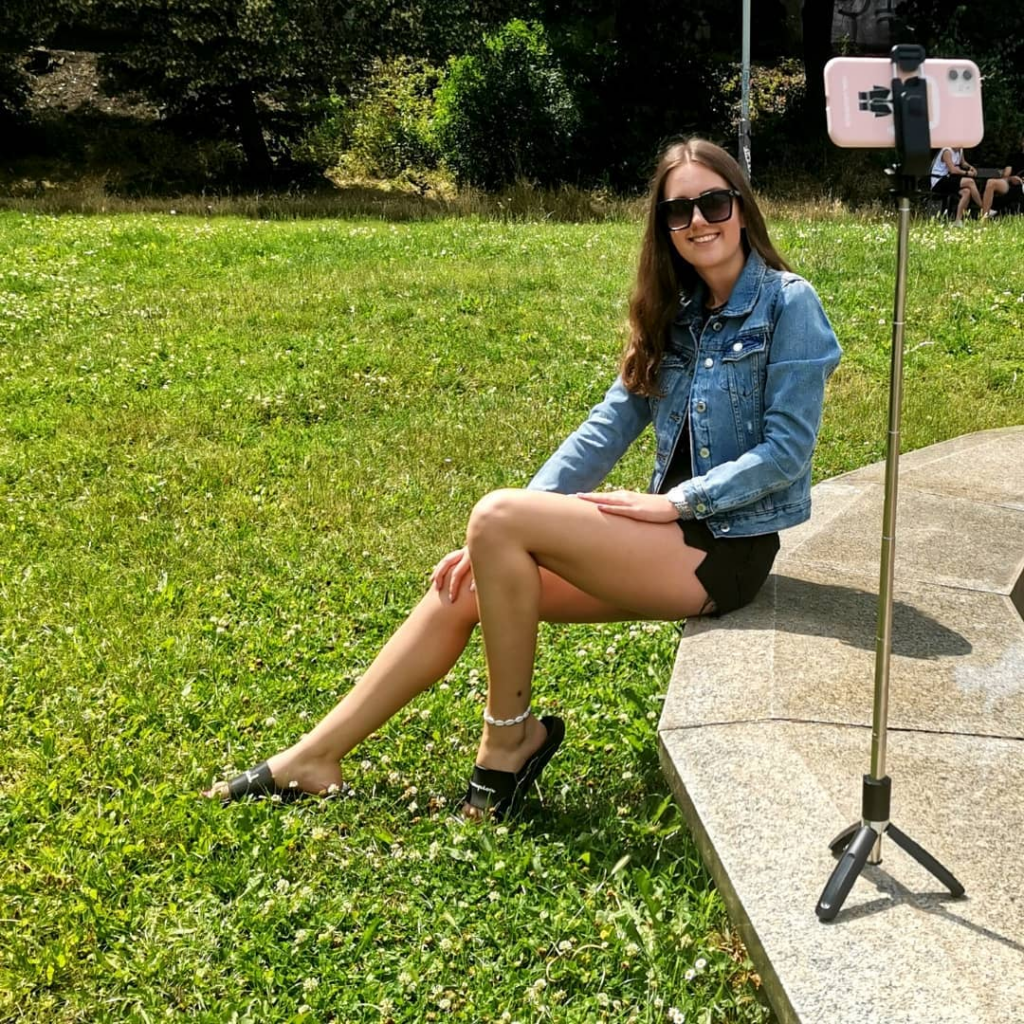
Due to the language barrier, it can be intimidating to approach the locals to ask them to help you take photos. But fret not, when there’s a will, there’s a way.
Investing in a selfie stick that comes with a tripod stand will be a game changer when it comes to taking photos beyond selfies. Most of these selfie sticks come with a Bluetooth shutter, which means you can snap away until you get the perfect shot without the help of strangers.
6. Utilise lockers for your shopping bags
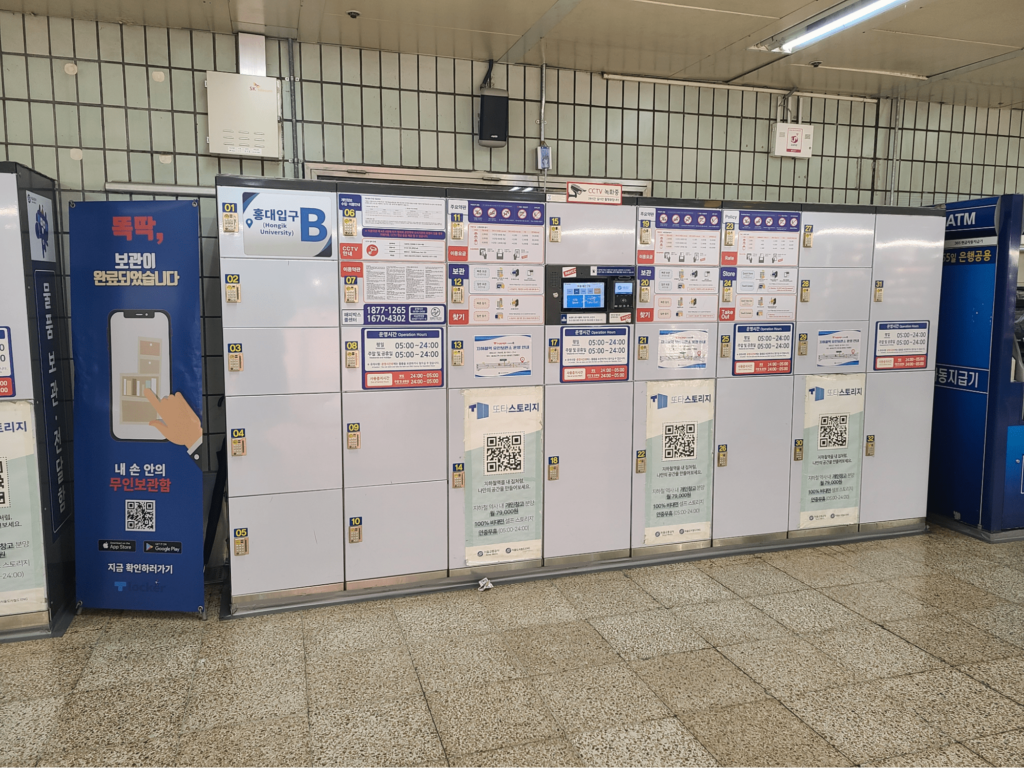
It can be a hassle to carry all your shopping bags while you’re busy shopping till you drop.
Locker rental services are common in Korea and you can find them at train stations near popular shopping areas, such as Hongdae and the Express Bus Terminal Underground Shopping Mall.
The rental prices of these lockers are affordable, and it can go as low as KRW2,000 (~USD1.43) for a 4-hour rental.
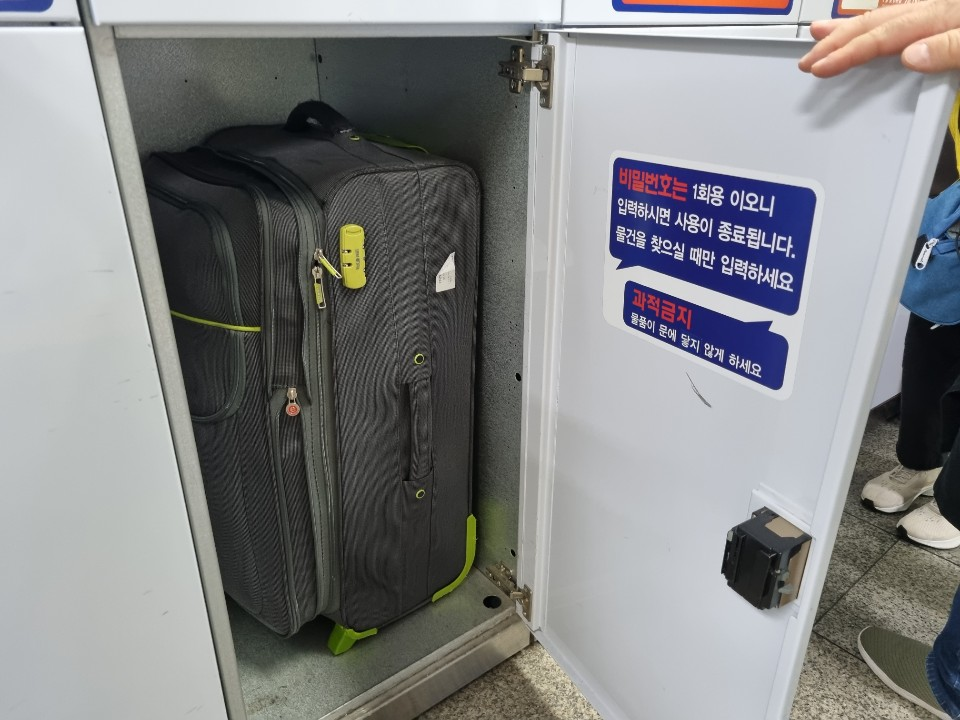
There are 3 locker sizes to choose from. Typically, the small compartment is more than sufficient to hold your shopping bags. But if you need more space to store your luggage, you can opt for the medium or large compartments.
Note that the lockers found at different train stations may have different sizes, so we encourage you to check the size chart carefully before making your payment.
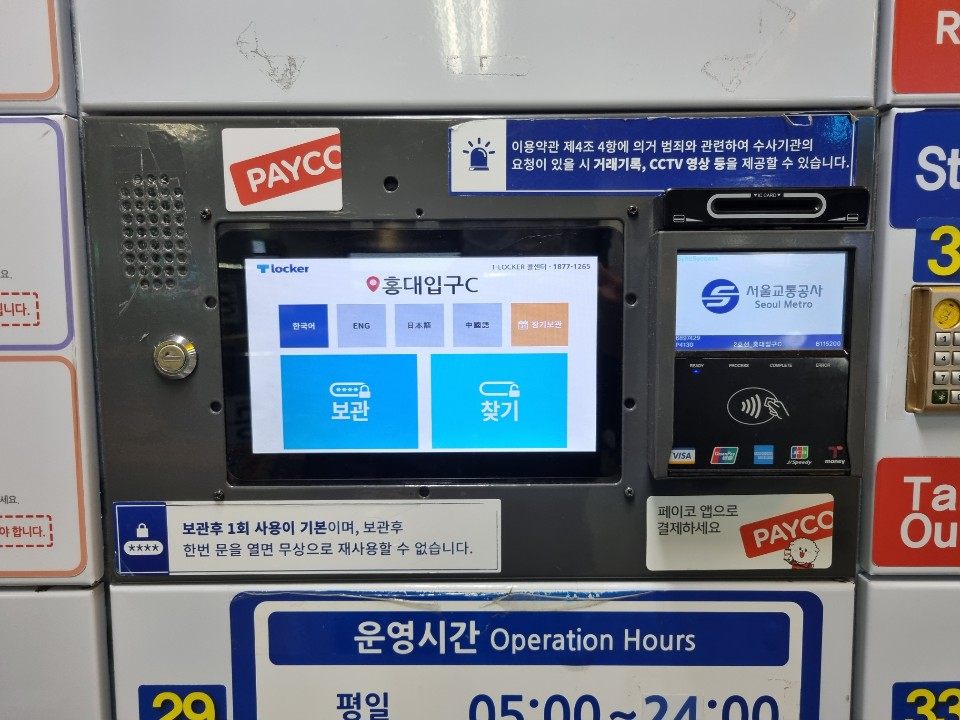
You can make payment using your credit card or T-money card (transportation card in Korea). It’s useful to note that not all places accept cash as a form of payment.
7 . Download Papago to communicate with the locals
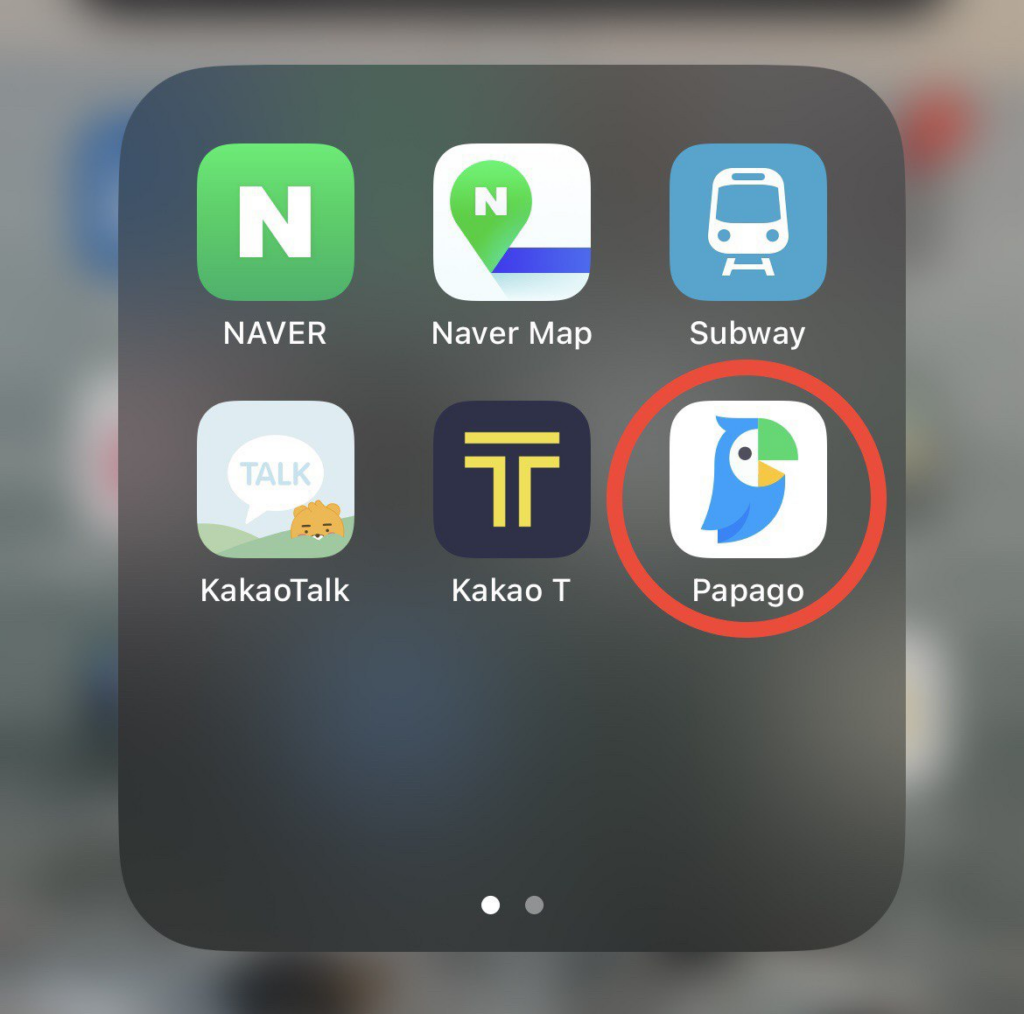
Travelling alone in South Korea without knowing how to speak Korean can be daunting. But it will be less so when you download Naver Papago, an AI Translator app on Apple App Store or Google Play Store .
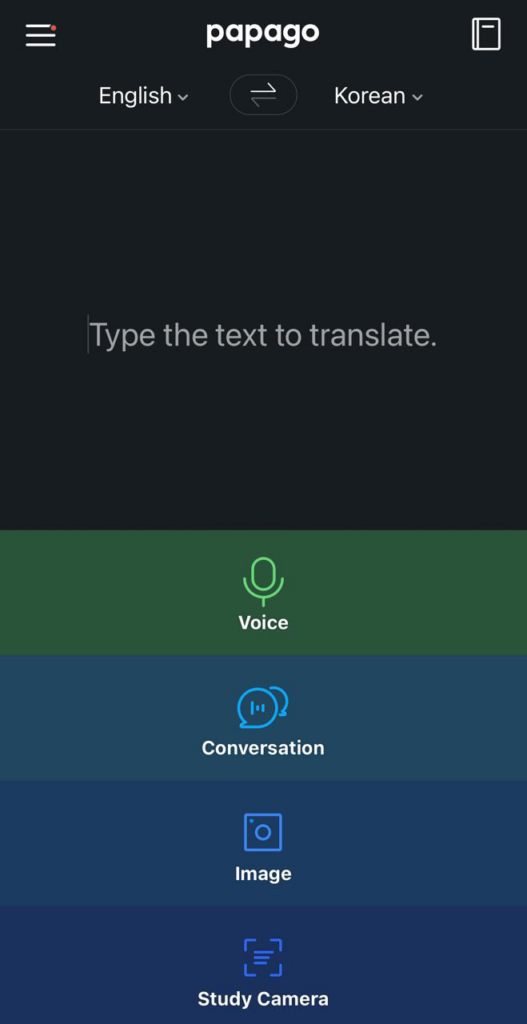
Besides language translation, the Korean words and phrases come accompanied with romanisation to help you pronounce them correctly.
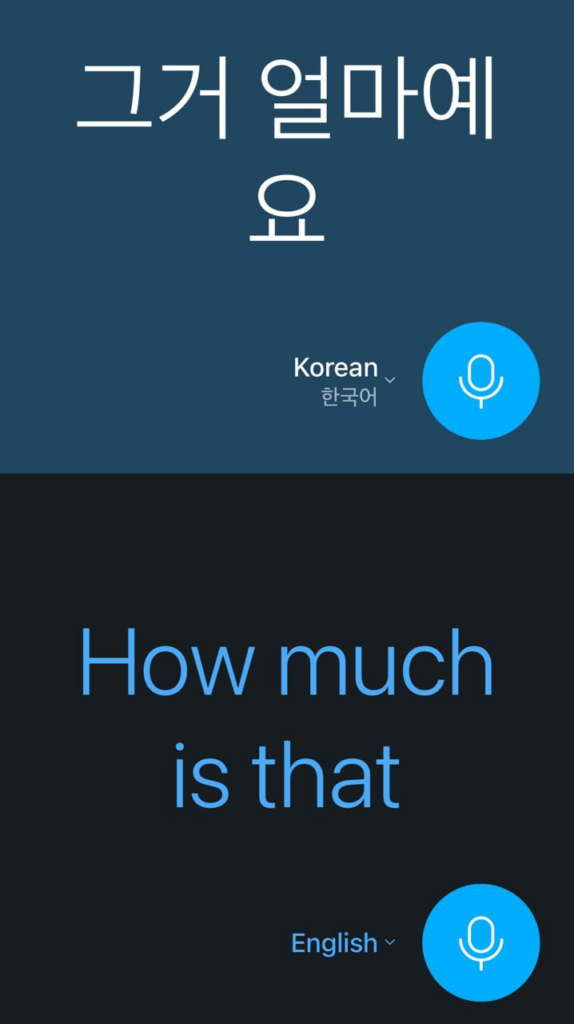
Use the conversation function to effectively communicate with the locals. The app will automatically translate whatever you’ve said into Korean, and vice versa, it helps to translate what the locals said to a language of your preference.
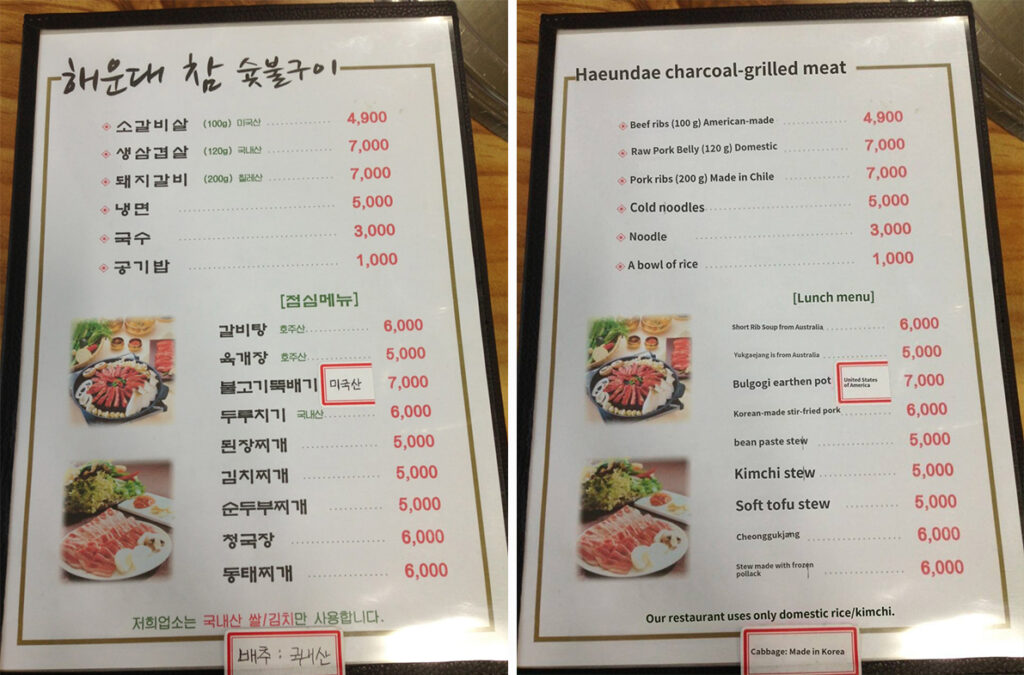
Another useful function of the app would be the image translation feature, where you can translate the words on an image. This will be extremely useful when you have to order a meal from a Korean menu.
8. Take buses & trains as cheaper alternatives
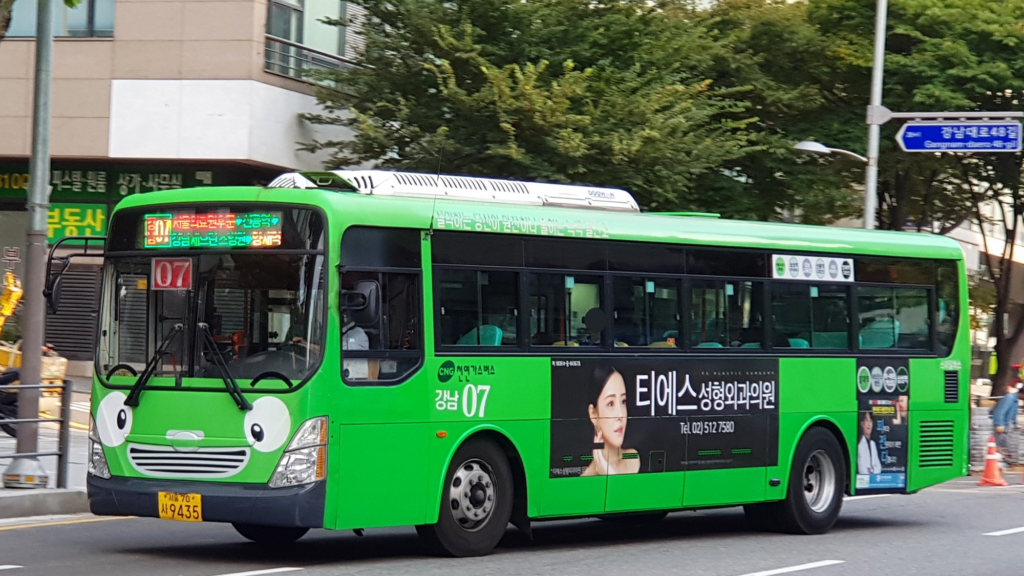
It’s a no-brainer that taxis are the more expensive option when it comes to public transportation in Korea . Bus and train fares are not only cheaper, but you can also get discounted fees when you transfer between bus or train rides.
Taxis are also difficult to flag down during peak hours. If you are in a rush, taking the bus or train save you more time because of their regular schedules .
9. What to do when you lose your belongings
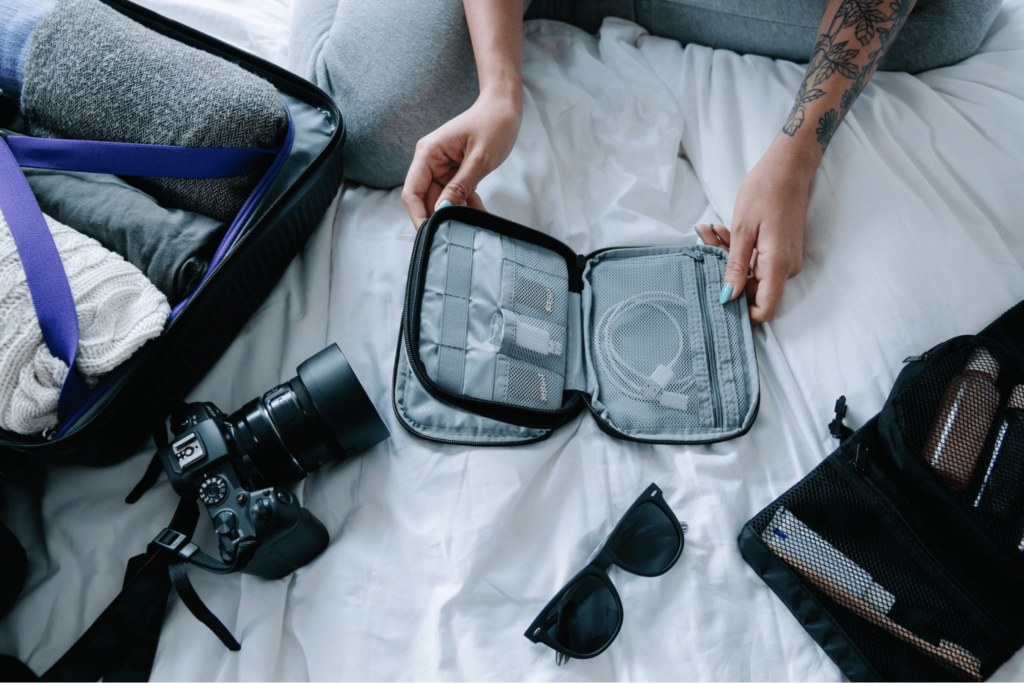
Losing your belongings in a foreign country is a nightmare, especially when you are travelling alone.
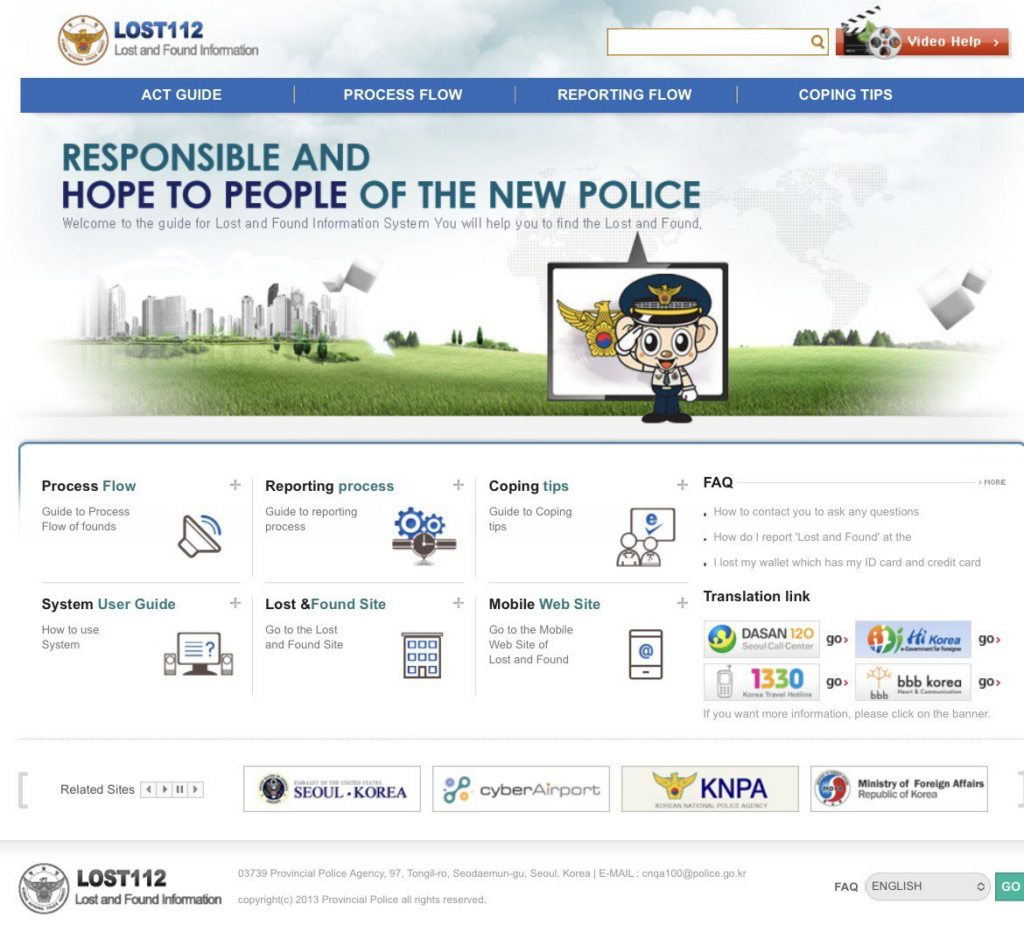
Stay calm and use this lost and found website to look for your lost belongings. If you happen to find someone else’s stuff, you can report them here as well.
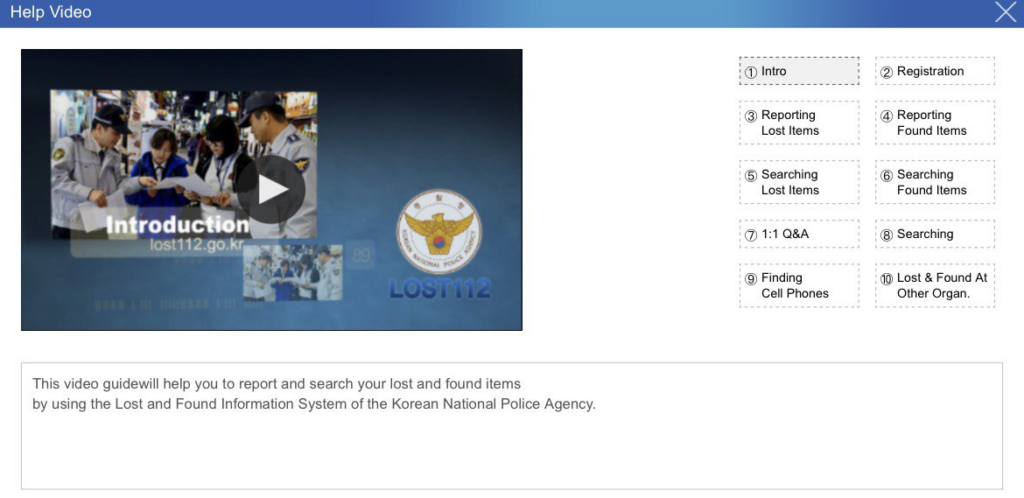
Watch the video for clearer instructions and guidelines on what you should do when you lose or find something during your stay in Korea.
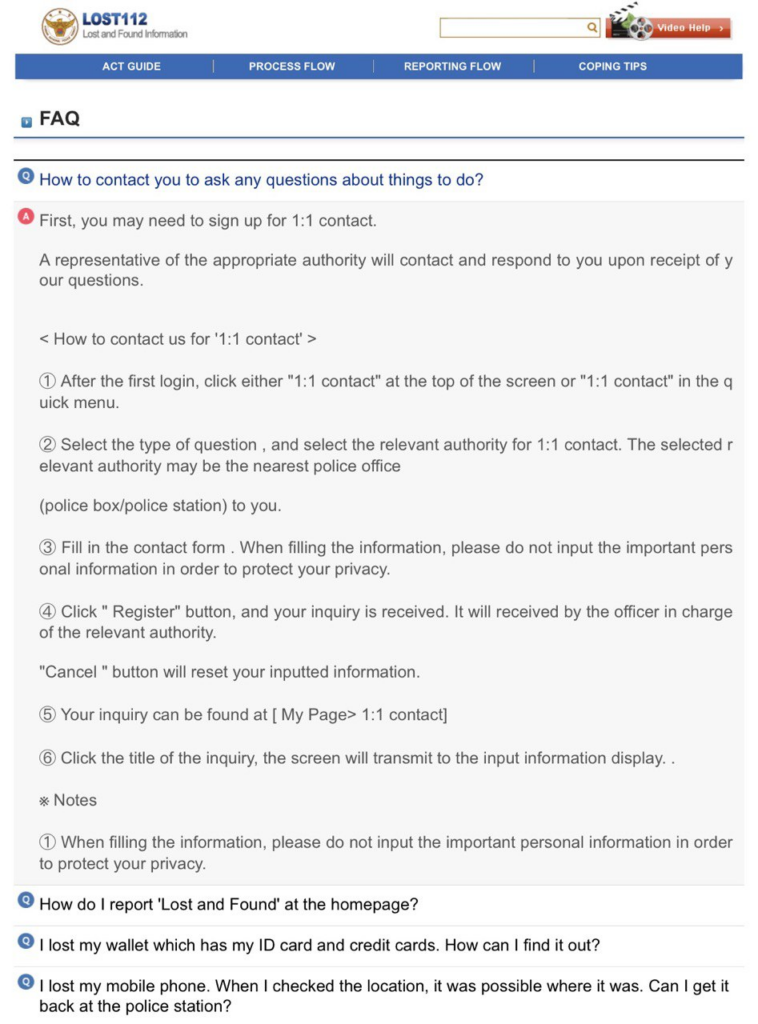
The Frequently Asked Questions section of the site is conveniently available in English.
10. Travelling to other cities alone
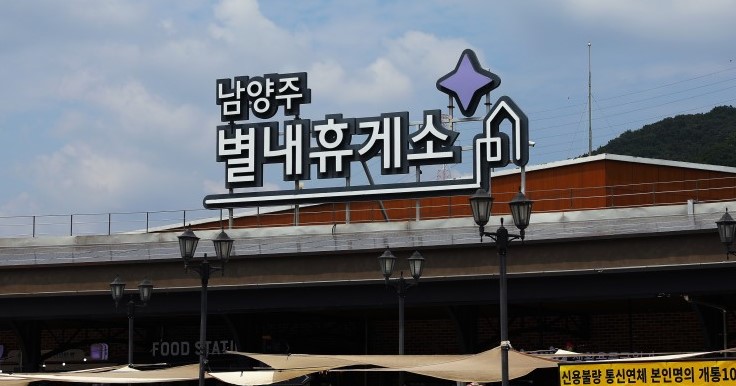
Intercity buses often stop at rest stops for approximately 15 minutes during parts of the journey for you to take a quick toilet break.
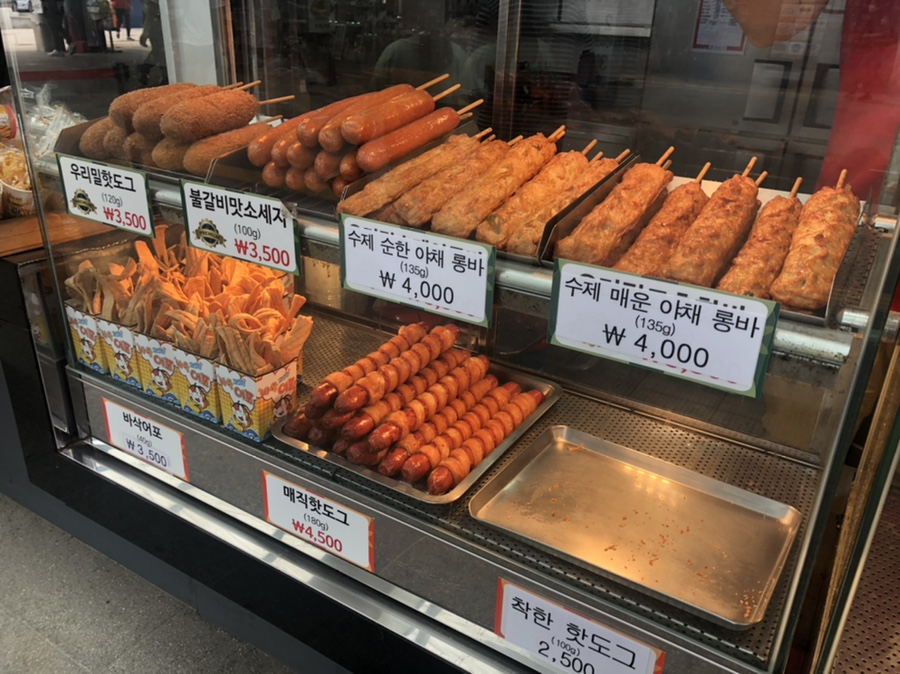
Use this time to go to the bathroom, or if you’re feeling peckish, get yourself some popular snacks such as corndogs and walnut-flavoured cakes.
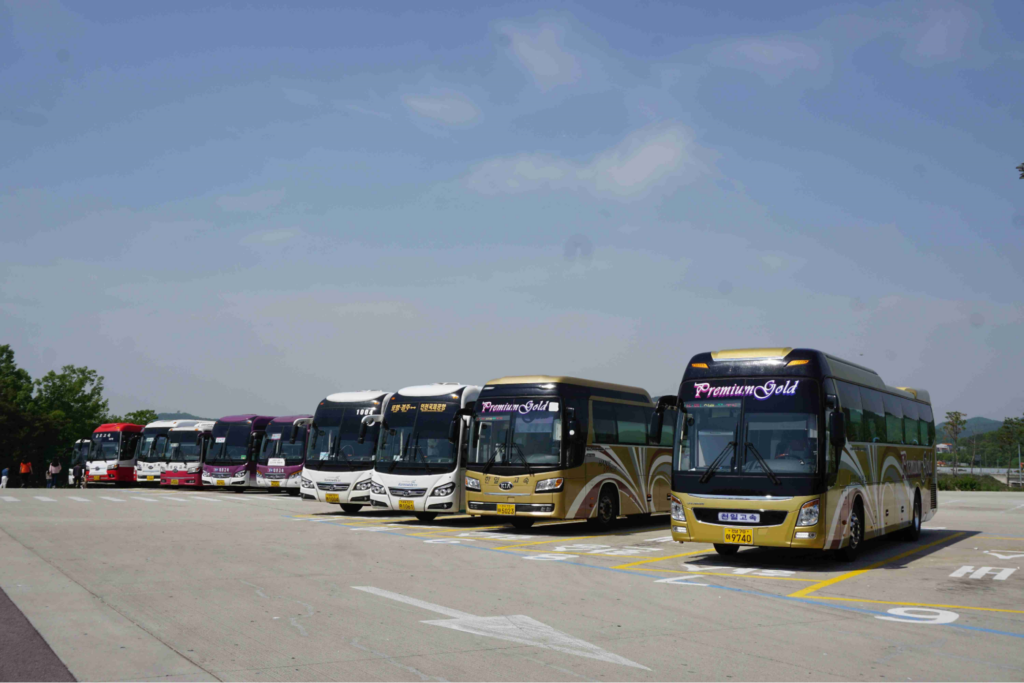
Pro-tip: Take a picture of the bus plate number of your bus so that you won’t board the wrong coach; you’ll find that there are many similar-looking buses at the rest stops, which can get confusing for travellers who are not as observant.
Also make sure that you time yourself well, with ample buffer time as the bused will not wait for you if you don’t make it back on time.
11. SIM card versus Wi-Fi egg
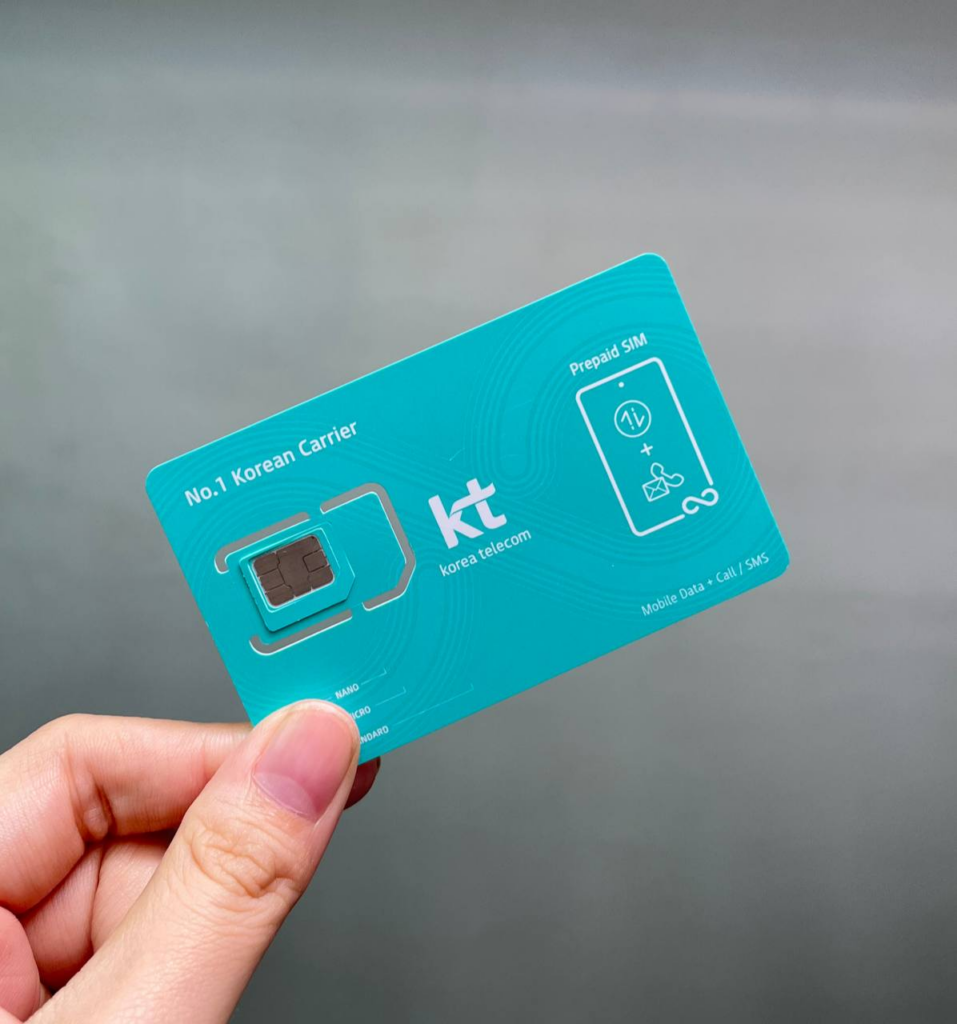
If you are deciding between getting a SIM card or a Wi-Fi egg, we recommend you get the former. It is more convenient as there’s no need to charge yet another device overnight. Plus, you don’t have to worry about losing it, then having to replace it.
Getting a SIM card with a local number is not compulsory, but we recommend that you opt for one as it will be useful when you’re making reservations or ordering food delivery.
12. Have fun alone at a Korean coin karaoke
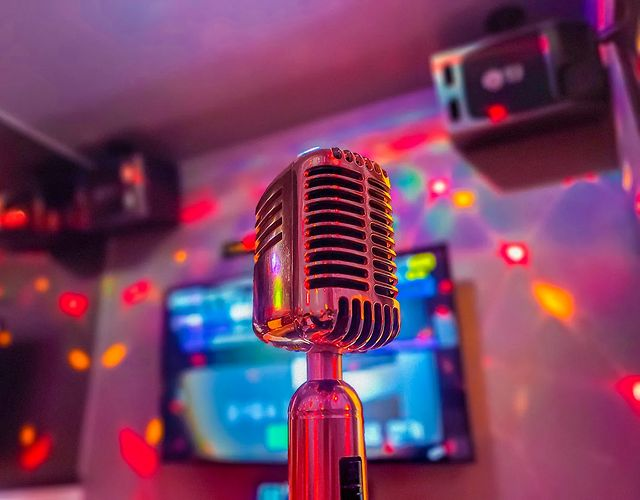
Going to karaoke is not only for big groups of friends. In Korea, it’s an activity enjoyed alone as a way to destress or put your bathroom singing skills to test.
Singing at a coin noraebang (coin karaoke) is the perfect activity for solo travellers when you have time to kill or simply want to have fun.
13. 1-person meal options on delivery apps
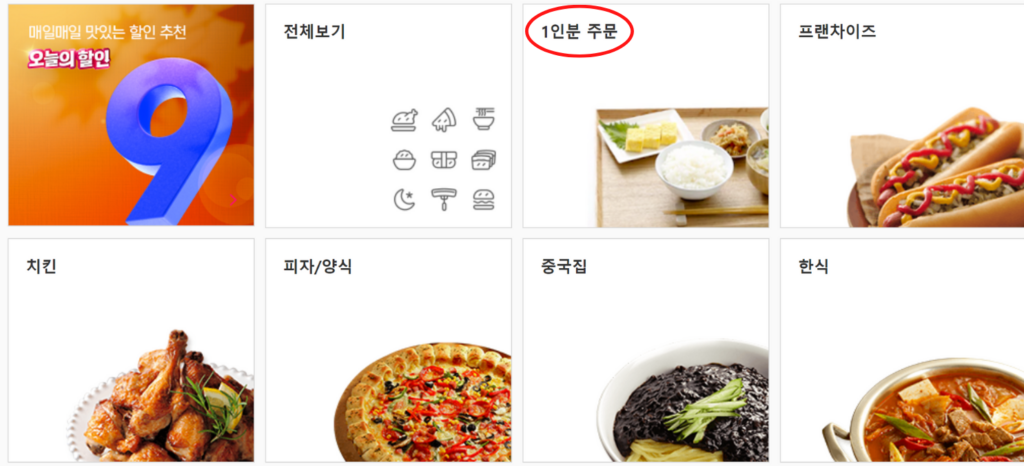
If you are craving for a late-night snack or dessert, you can get them delivered to you by ordering via delivery apps .
Most delivery apps impose a minimum order of approximately KRW15,000 (~USD10.76) per order, but it can be difficult to hit that amount if you’re ordering just a single serving.
So you’ll want to download a delivery app such as Yogiyo, which lets you order a 1-person serving meal without having to hit the minimum order amount. Simply look out for the category that says “1인분 주문”, which literally translates to 1-person serving order.
14. Minimum 2 pax for BBQ
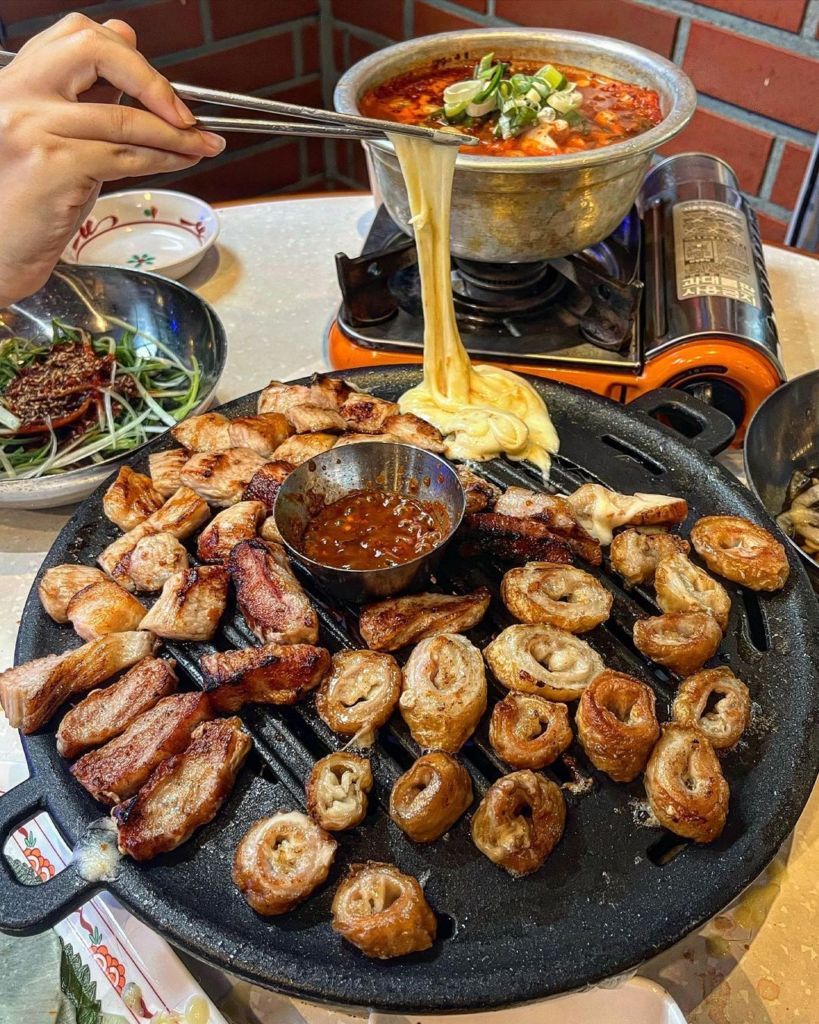
Korean barbecue is a must-eat when you visit Korea. However, most of the restaurants do not accept solo diners as they tend to prioritise bigger groups of customers.
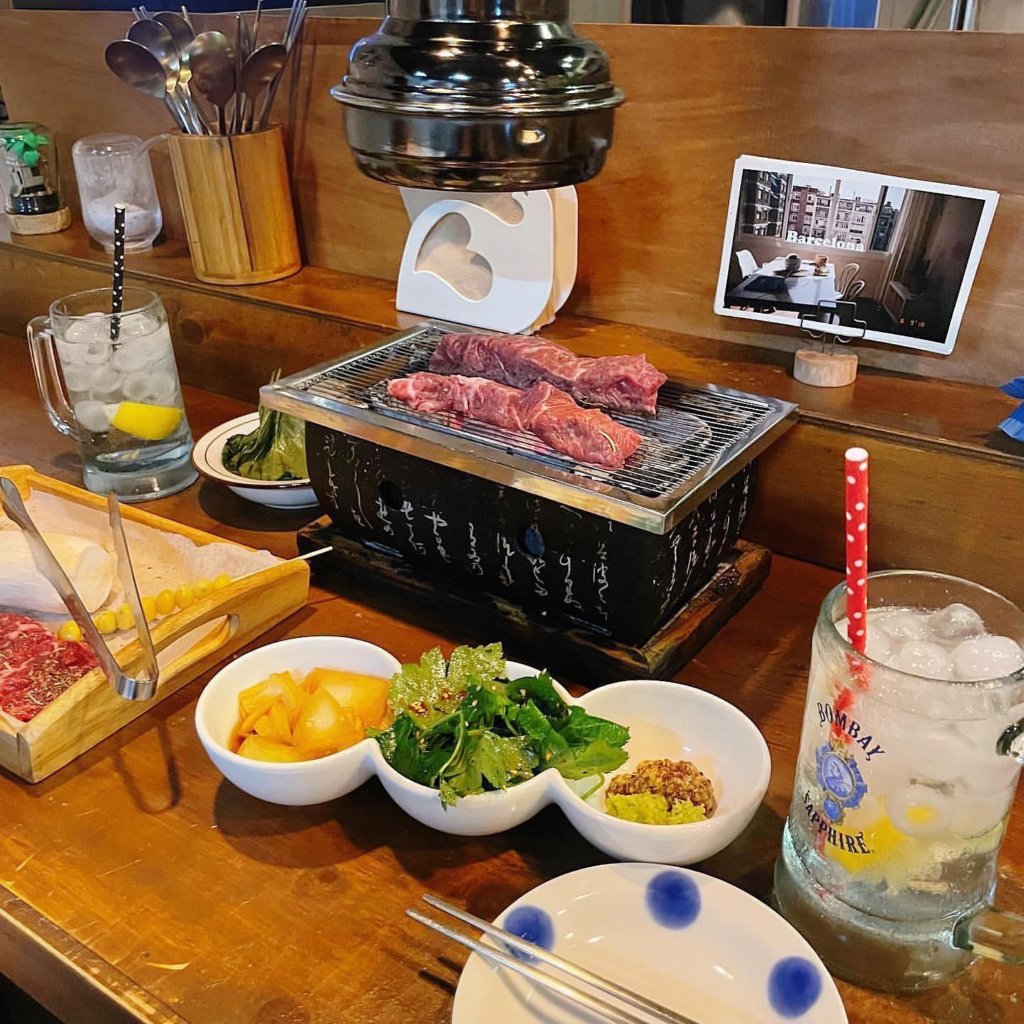
On the bright side, there are BBQ restaurants that specifically cater to solo diners; you may even get a personal table and grill when you eat at these restaurants.
– Places to eat at, as a solo traveller –
15. fast food restaurants.
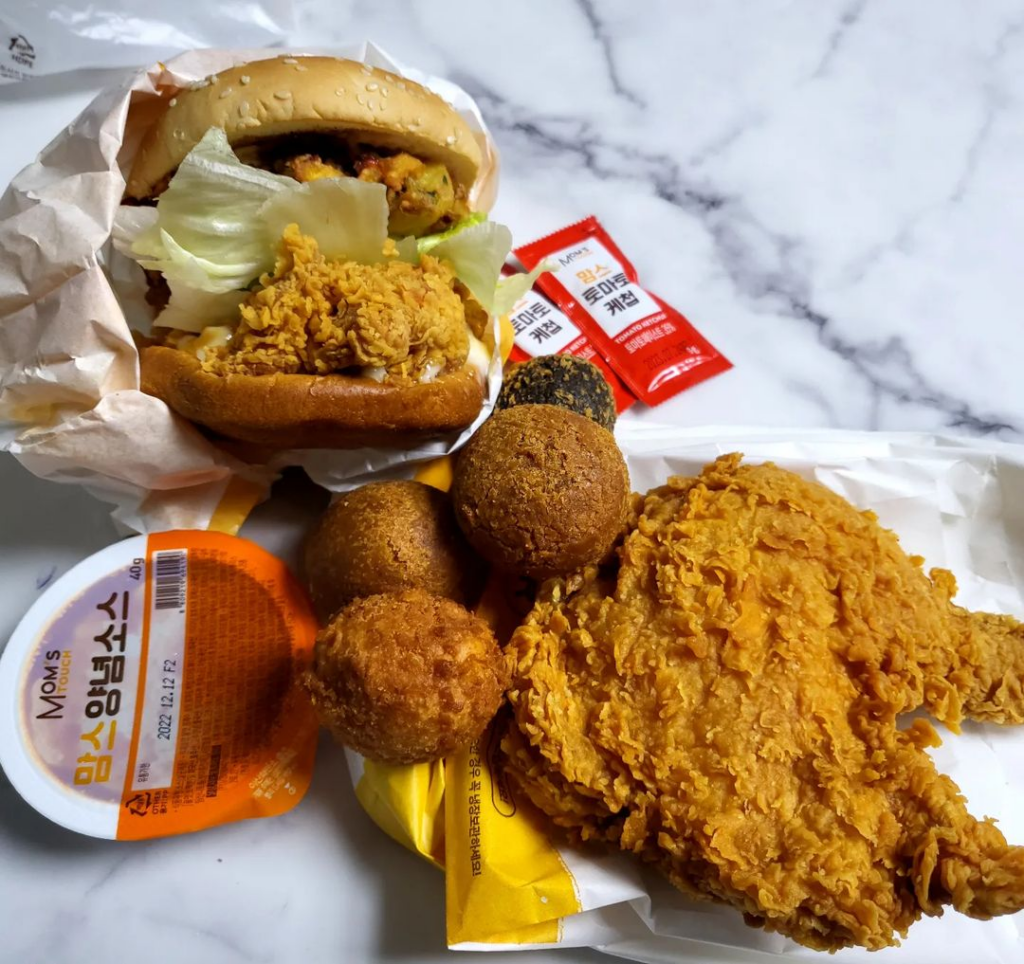
Eating alone in a foreign country can be a little overwhelming. Although most restaurants in Korea don’t mind solo diners, some places may prefer to serve bigger groups of people instead.
The most convenient places to eat at, as a solo traveller, are none other than fast food restaurants.
In Korea, there are many fast food restaurants to choose from. Ranging from local ones such as Mom’s Touch and No Brand Burger to famous ones such as McDonald’s and Shake Shack, the list is never-ending.
Better still, self-ordering kiosks that have English menus are usually available at these fast food restaurants, so you won’t have to worry about the language barrier too.
16. Korean eateries
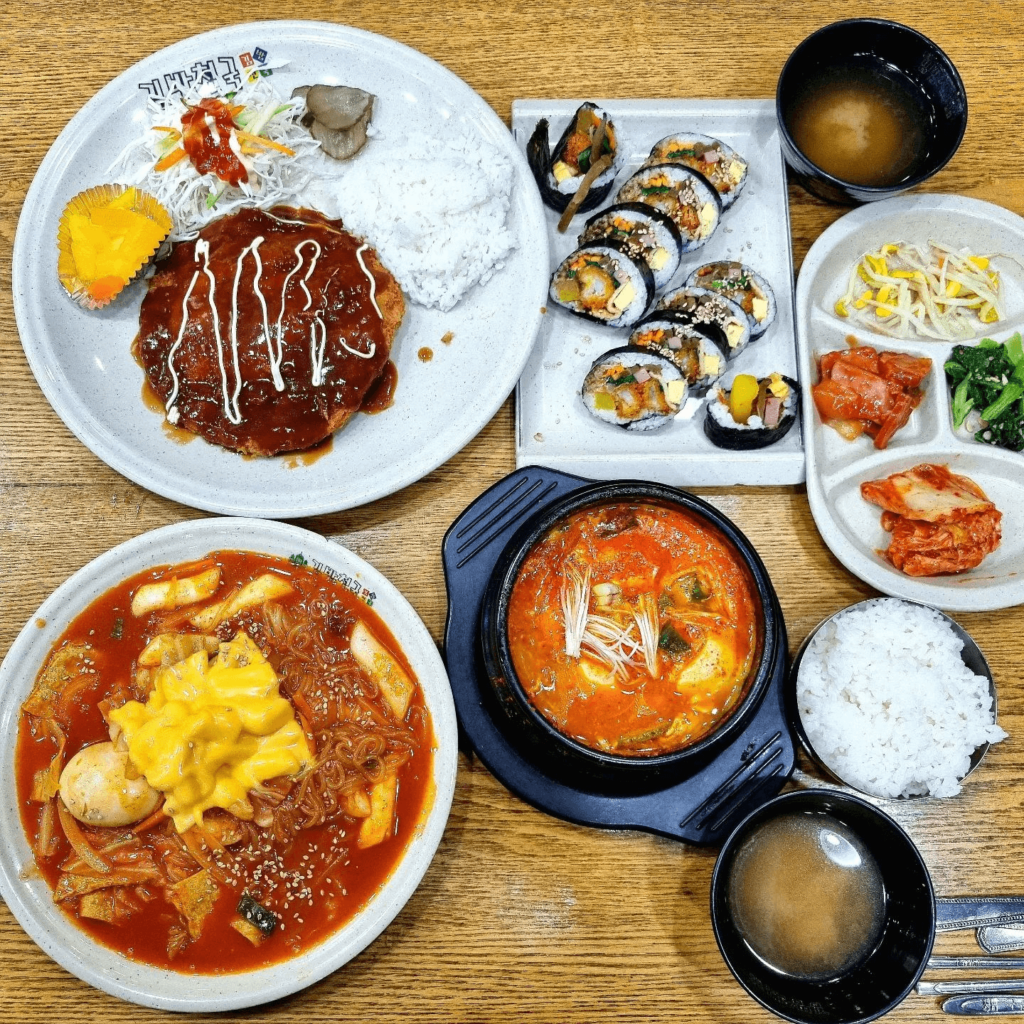
Korean eateries are also known as “분식 식당” ( bunsik sikdang ). They sell inexpensive food such as kimbap , donkatsu (pork cutlet), tteokbokki (spicy rice cake), and fried rice.
You can get a roll of kimbap for as low as KRW2,000 (~USD1.43) , and a bowl of ramyeon at only KRW3,000 (~USD2.15) .
The most famous bunsik sikdang in Korea would be the Kimbap Heaven eatery, which has numerous franchise outlets all over the country.
17. Solo-diner restaurants
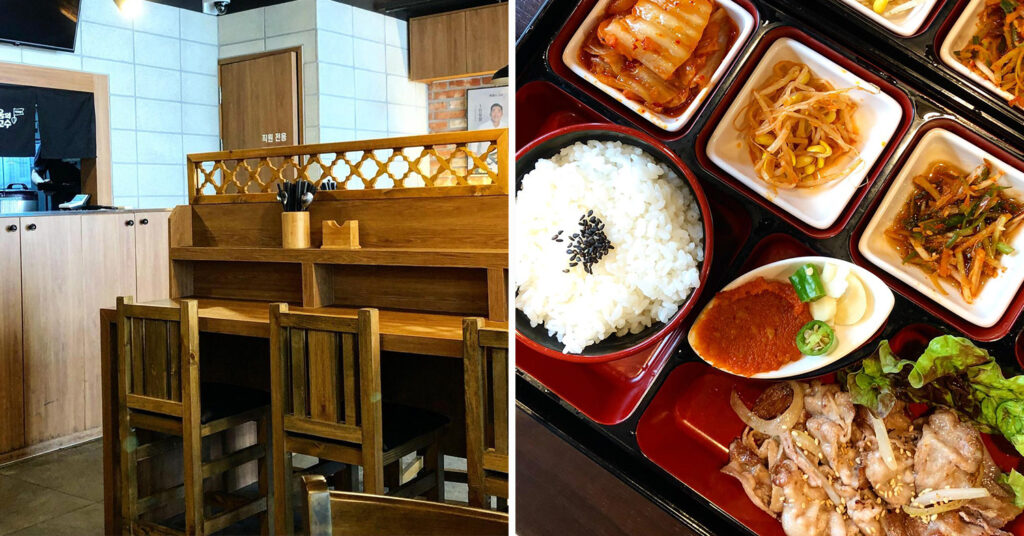
Solo-diner restaurants that serve 1-person set meals or bento sets will be the go-to for solo travellers to South Korea.
The set meals usually include food items such as boiled pork and braised pig trotters that commonly come in larger serving sizes.
Since these restaurants target solo diners, you can often find solo-dining capsules or bar seats that cater to people eating alone.
18. Street food
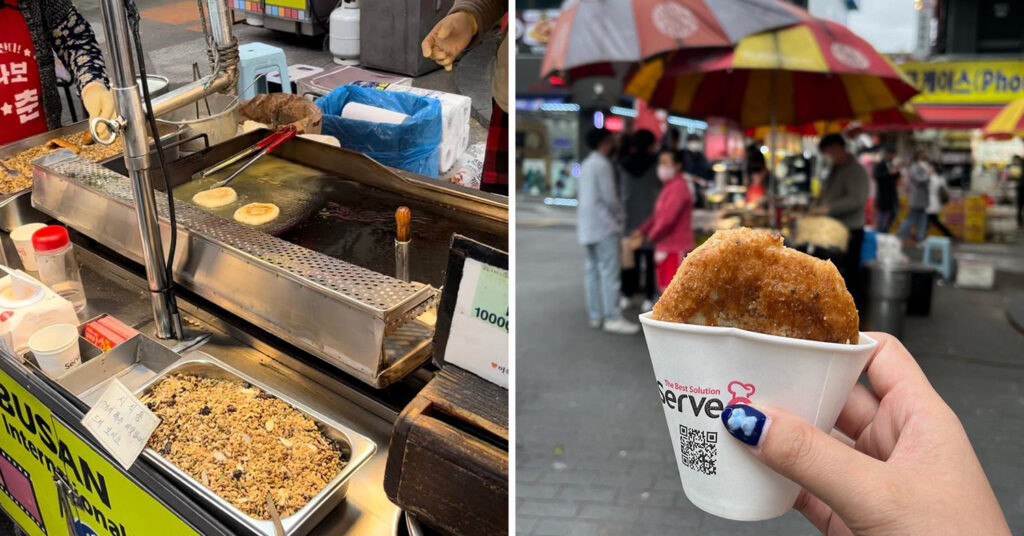
The street food scene in Korea is amazing. From snacks such as hotteok (sweet Korean pancakes) to meals such as kalguksu (knife-cut noodles), you can probably find everything you need to fulfil your cravings when you hit up a food street.
Note that not all street food tents or carts have tables and chairs for you to sit and dine at, but you are free to stand and eat while walking around the market.
19. Traditional markets
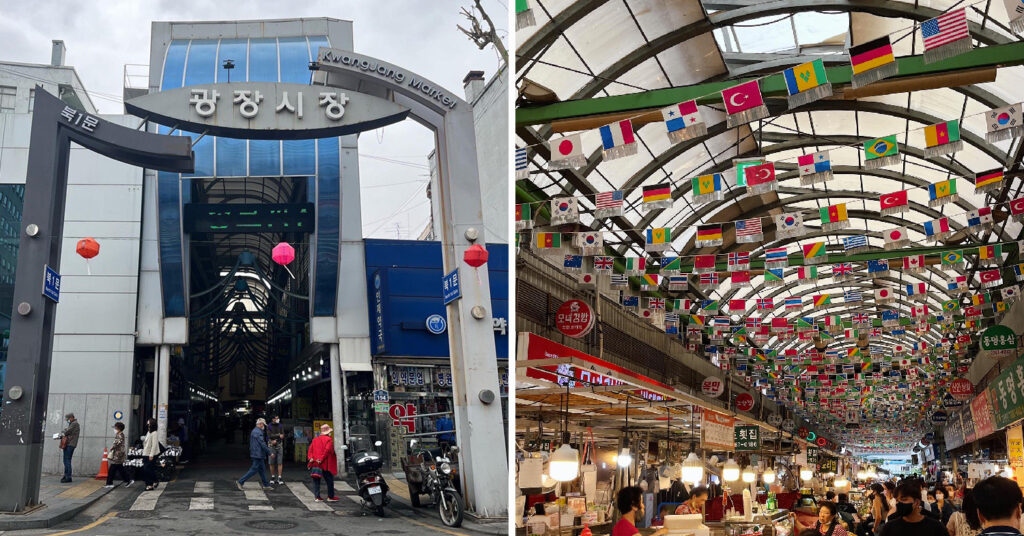
Going to traditional markets allows you to eat the most authentic Korean food and dine alone without feeling embarrassed.
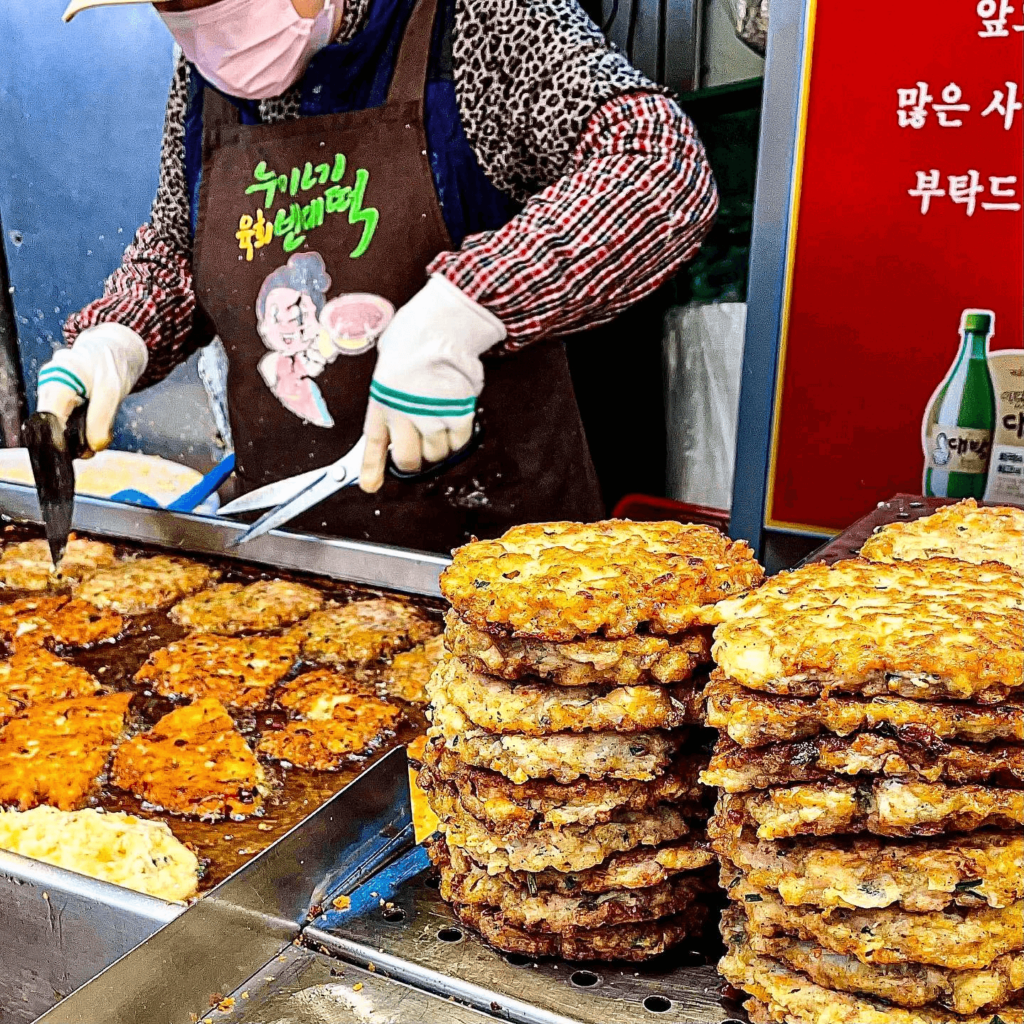
Most of the food sold at the markets come in 1-person portions, so you can try a variety of dishes at the market too.
Find local cuisines such as bibimbap (Korean mixed rice with vegetables), and unconventional foods such as sannakji (live octopus sashimi) and yukhoe (seasoned raw beef).
Visit the Gwangjang Market for their famous kkwabaegi (twisted donuts) and bindaetteok (mung bean pancakes). Not to be dramatic, but they are life-changing.
20. Convenience stores
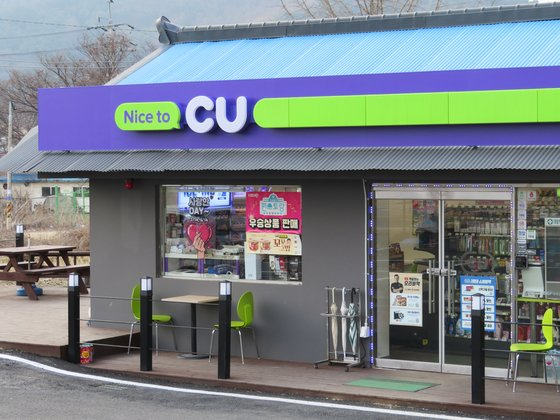
Most convenience stores in Korea have tables and seats inside or outside the premises, so you can have a quick meal there whenever you have food cravings or are feeling a little peckish.
Recreate the iconic Mark’s Meal while you’re there, or get cup noodles and light snacks such as the triangle kimbap and fish bars. You can also find interesting prepacked Korean food such as grilled intestines at the convenience stores too.
Solo travelling guide for those who believe the world is your oyster
If you are planning to travel alone to South Korea, bookmark this guide for easy access to the tips that will make your trip a memorable one.
For more travelling tips, also check out our South Korea public transportation guide , Han River Park guide , Mangwon guide , jimjilbang guide , and this list of 11 things to do in Jeju .
Cover image adapted from: Clara Quek, 순구 via Airbnb , 채구리 via Naver, 은비까비 via Naver

Get more stories like this.
Drop us your email so you won't miss the latest news.
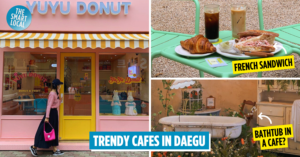

Travel to South Korea: 8 days itinerary

South Korea is one of those countries that do not top the list of most travellers when travelling in Asia, and it didn’t top my list initially either but my Travel to South Korea was simply fantastic!
NOTE: This blog contains affiliate links to pages selling products and/or services, I may get a small commission if you make a purchase through these links at no extra cost for you . There’s no sponsored content on this blog.
I went backpacking in South Korea after visiting many other countries in Asia and only ended up being there as it was the cheapest destination to fly after I spent a month backpacking in the Philippines .
What a nice surprise of a country I had!

During all my travels in South Korea I met incredibly friendly people, tried some of the tastiest food in Asia and visited beautiful places! what else do you need!
This is one of the most developed countries in Asia and the world. It’s super safe and combines vibrant cities and spectacular nature.
Korea is a relatively small country, easy to travel around quickly and cheaply, hence perfect for a short holiday break.
If you’re tight on time and want to do some hiking mixed with learning about the local traditions and history keep reading for this backpacking in Korea 8 days itinerary avoiding the super crowded tourist attractions.
Travelling for only 8 days is almost never enough to explore a country but in South Korea you can actually get a good glimpse of the country.
Any extra days you can add can only be a plus!

My suggested 8 day backpacking in South Korea itinerary goes as follow:
Seoul – 1 day Danyang – 2 days Gyeoungju – 1 day Busan – 1 day Jeju – 2 days Seoul – 1 day (or any other departing city)
The South Korean trip in detail:
Day 1 seoul. ultra modern korea.
Flying into South Korea is likely you may arrive to Seoul.
Due to the price of food and accommodation, backpacking in Seoul is not the most budget-friendly destination. But it has many things to show and you should experience it at least for a couple of days.
The capital city is an exciting, bustling and vibrant metropolis. The largest city in South Korea combines tradition, nature and all the modern stuff that comes with a huge city.

As on my backpacking adventures I tend to go more towards places of natural beauty I didn’t stay too long backpacking in Seoul, but I had enough time in one night to meet a group of friendly locals. The nightlife in Seoul is for sure really cool!
One of the first things to do when landing in Korea is to get a T-money card that can be used all over the country to pay for public transport at reduced rates.
Check out my blog post about things to know when backpacking in Korea for more tips!
I stayed at Birdsnest Hostel , near the Hongdae area which is a great place for evening drinks and food. It’s very easy to meet locals there if you travel alone in Korea.
During the day I went towards Bukchon Hanok Traditional Village . This place is a bit touristy but you get nice views of the city surrounded by traditional architecture.

Walking distance from Bukchon Hanok you can also find the Gyeongbok and Changdeok Palaces and the Jongmyo Royal Shrine.
For little bit more walking go towards the Cheonggyecheon Canal and end up at the night market for a street food feast!
Days 2-3 Danyang. Beautiful nature!
Being in a country with 22 National Parks you definitely need to put at least one of them on your South Korean holidays!
From Seoul, take a bus towards the countryside town of Danyang. This little sleepy town is next to the stunning Sobaeksan National Park but it also has a great food scene and many other natural attractions.

I stayed at the beautiful Factory G. Ssang Guesthouse . I completely felt at home during my stay there!
I enjoyed mostly my day hiking in Sobeaksan but as I spent a few days there I compiled this list of cool things to do in Danyang !
MY HIKING ESSENTIALS

Danyang is off the beaten path for most tourists but well known for the locals so make sure to go over there and check it out.
This was one of my favourite places on my travels in South Korea.

Day 4 Gyeongju. The open air museum!
I didn’t even know of the existence of this city until I got it recommended by my host in Danyang and what a great recommendation!
The city of Gyeongju is almost on its entirety an Unesco World Heritage Site . Need to say more than that?
The ancient capital of the Silla Kingdom is a perfect place to visit for 1 or 2 days as it’s relatively small and almost everything is walking distance.
A common sight in town is the precense of many “small funny mountains”, these are called Tumulis and are actually burial mounds of the ancient Silla rulers. So cool!

I stayed at the Santa Guesthouse which was not bad and was the cheapest hostel in town.
On my post about things to do in Gyeongju I recommend a number of sites that you can visit in just one day.
Make sure not to miss the night view at Donggung Palace and Wolji Pond.
When you’re backpacking in Korea you should not miss the opportunity to visit this wonderful place as there are so many things to do in Gyeongju!

Day 5 Busan. Colourful and seafood paradise!
If you travel in South Korea is very likely you will make it to Busan which is the second largest city in the country.
I arrived to Busan by bus from Gyeongju as it’s less than an hour away. After checking in Kimchee Downtown Hostel I took the subway and made my way to the most famous place in town.
The colourful Gamcheon Culture Village is a success case for the Korean government on regeneration of a historically deprived area.
This steep mountainous area was first populated by Korean war refugees that settled in the 1950’s, it was a shanty town until the Village Art Project was launched in 2009 when students and artists started painting the old houses, creating murals and street art installations.

Its steep streets and twisting alleys are a fun labyrinth to wander.
Although touristy and at times crowded, this is definitely the top of the list of things to do when backpacking in Busan.
From Gamcheon Culture Village you can walk downhill towards the Jagalchi Fish Market, which is the biggest of its kind in Korea.
Stroll around the market and then go to the first floor to eat freshly caught fish. You can also buy your own fish at any stall downstairs and take it up to a restaurant for it to be cooked.
This is not a backpacking-on-a-budget-friendly destination though…
The next destination for the backpacking in Korea trip is the beautiful Jeju Island. From Busan you can take a ferry or fly. I couldn’t find any ferry tickets in advance and the fly tickets are surprisingly cheap!
Days 6-7 Jeju Island. Home of the highest mountain in Korea!
Backpacking in Jeju Island is the best way to finish your holidays in Korea. This volcanic piece of land has some of the most beautiful beaches I’ve seen in Asia.

On the island of Jeju there are 368 volcanoes and hiking Mt. Hallasan should be your priority!
At 1950m of altitude this is the highest mountain/volcano in South Korea!
Although it hasn’t erupted for about 5000 years it’s still considered active. This incredible site was named Unesco World Heritage in 2007. The views are simply too beautiful!
Read more on detail about this adventure on my Hiking Mount Hallasan post.

While backpacking in Jeju Island you can also go surfing (if you’re lucky with the waves) and explore its many beaches.
If you cannot rent a car, there are buses that go all over the island. Make sure to use your T-money card for reduced fares.
I stayed at Jeju Backpackers hostel which is a proper homestay with a fantastic host!
From Jeju Island you can take the world’s busiest air route towards Seoul. Having flights almost every 15 minutes means that you can have incredibly cheap tickets.
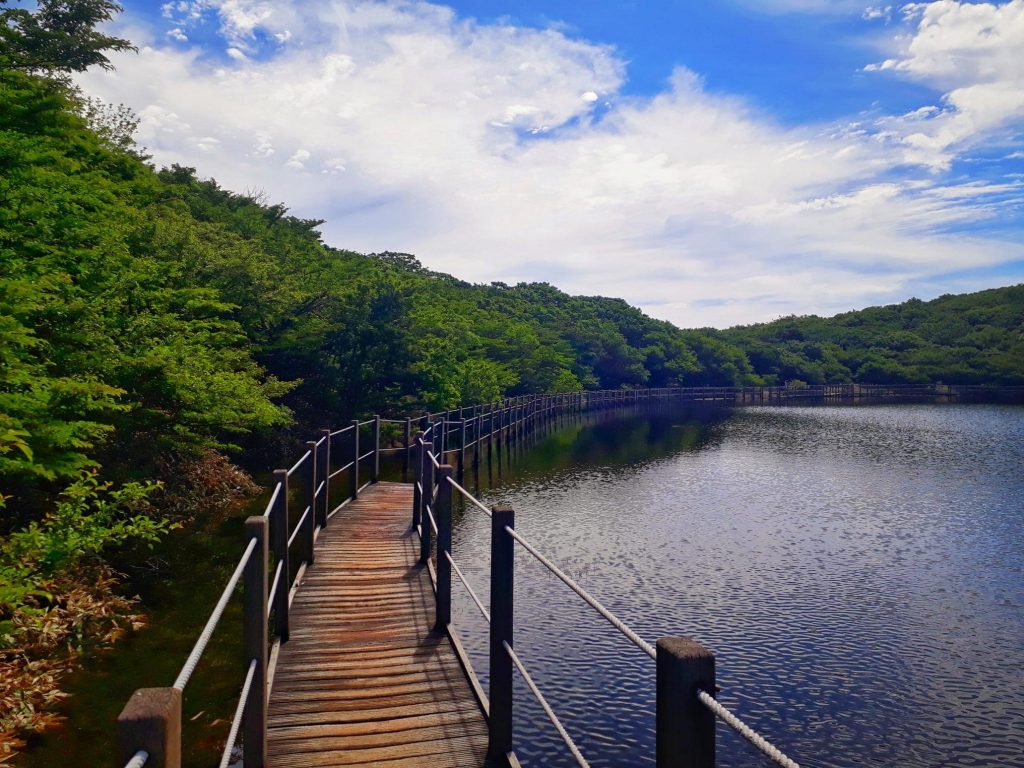
Alternatively go somewhere else for your final day backpacking in Korea. On my days in the country I found many cheap tickets also from Jeju Island to Daegu city.
Day 8 Seoul. Time to plan the next holiday!
Back to where everything started. Depending on how many hours you have to explore a little more of Seoul you could even squeeze a quick hike to the nearby Bugaksan mountain.
Otherwise, a stroll around the city for the last taste of Korean street food is always worth a visit!

I hope you enjoy your trip when you travel to South Korea and feel free to ask any questions or drop any suggestions if you have been to this great country! 🙂
Check out my other posts about backpacking in Korea for more inspiration!
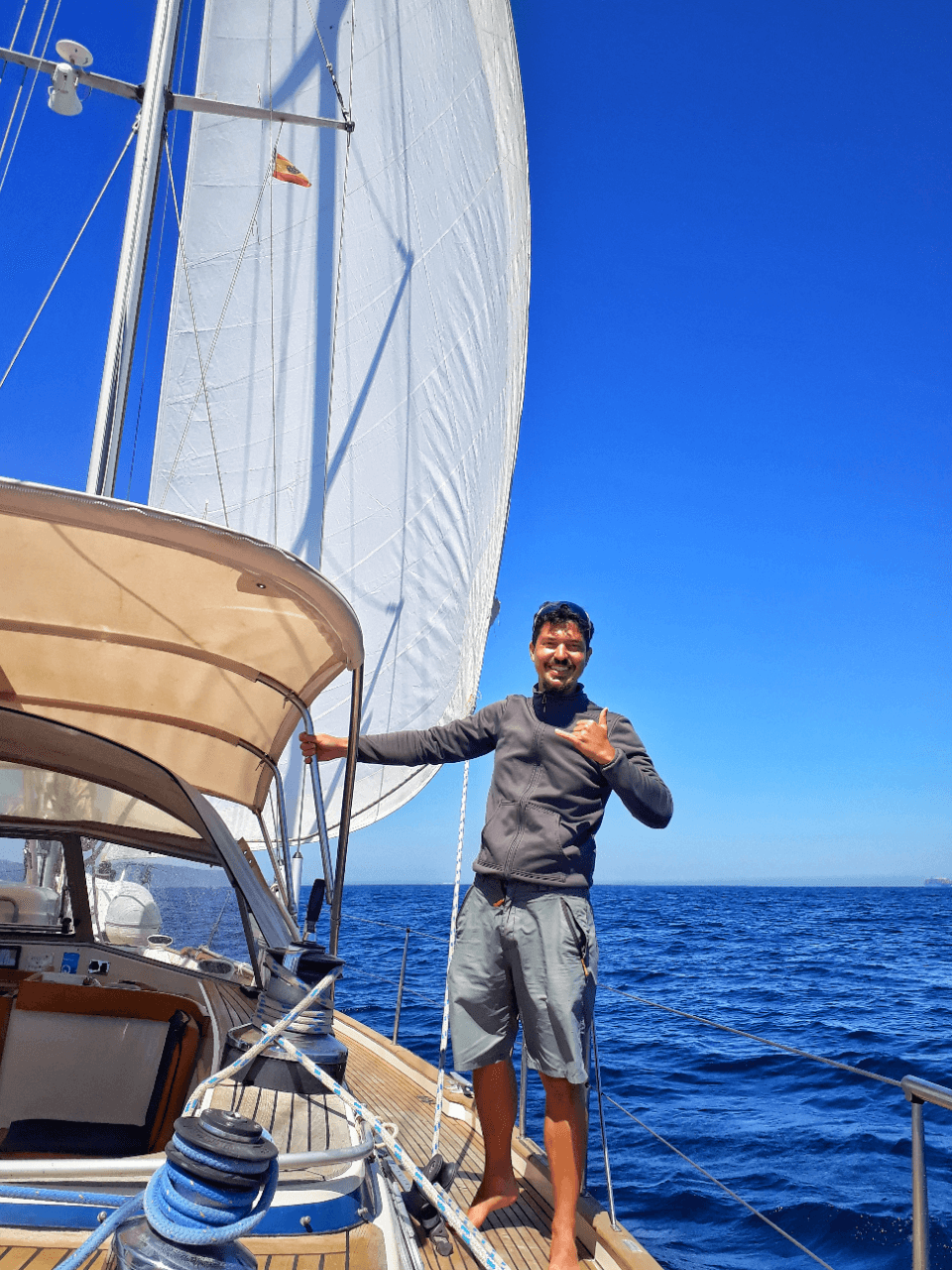
Hungry for more Adventures?
S ign up to receive my latests adventures as soon as I post them!
I promise I won’t spam you! Read the privacy policy for more info.
Check your inbox or spam folder to confirm your subscription.
Leave a Reply Cancel reply
Your email address will not be published. Required fields are marked *
Yes, sign me up and send me new articles as soon as you post them!

Recent Posts
Copyright © 2024 Planet Of Adventures
Privacy Overview

The Best South Korea Itinerary for 2 weeks [Insider’s Guide]
Are you planning your itinerary for Korea? Firstly, I’m super jealous! I lived in Korea for over a year, and I would go back in a heartbeat.
I experienced the best that the country has to offer, and I’m so excited to share this South Korea 2 week itinerary with you.
We’ll start in Seoul, then head to Jeju Island, the so-called “Hawaii of Korea” before jetting off to Busan.
From there, we’ll make our way back to the K-pop capital, with stops at Gyeongju and Sokcho along the way.
But that’s not all, I’ve crafted this South Korea itinerary to fit any season, so whether you’re traveling in summer or winter, I’ve got you covered!
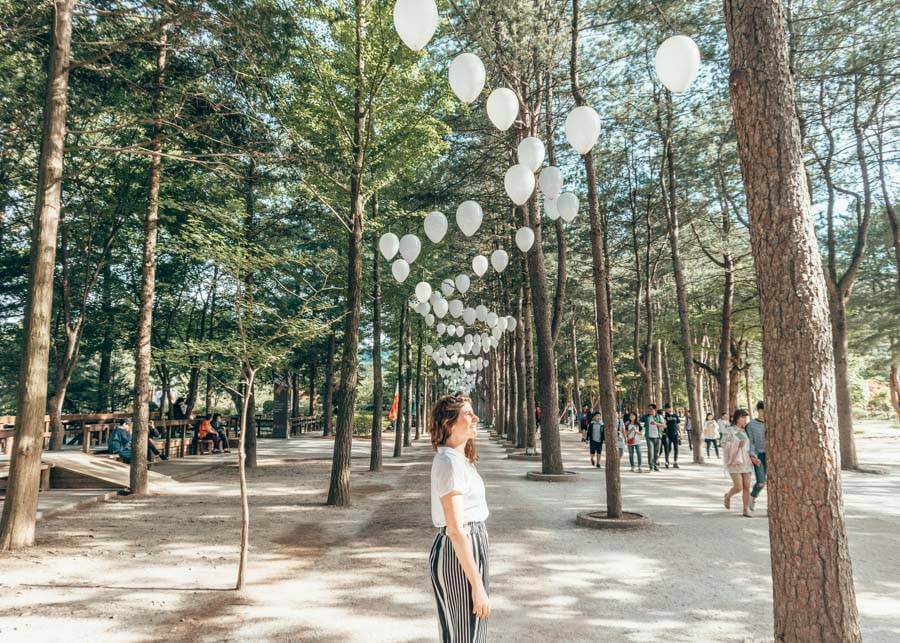
Torn Tackies contains affiliate links. If you make a purchase using one of these links, I may receive compensation at no extra cost to you. See my disclosure for more information.
Quick Navigation
South Korea itinerary
The truth is there is so much to do and see, and with only 2 weeks in Korea, you won’t get to everything!
On the bright side, 2 weeks is more than enough time to explore the capital city, Seoul, and learn about the rich culture.
You’ll indulge in the delicious food and visit spectacular palaces and temples whilst also experiencing the breathtaking landscapes and natural attractions.
This itinerary for Korea is balanced
My Korea travel guide is for those adventurous souls who want to catch a glimpse of Korea’s history.
It’s for solo travelers eager to meet like-minded people. For backpackers looking for that once-in-a-lifetime experience on a budget. It’s for families planning their perfect trip.
That’s why I believe this is the best South Korea itinerary out there because it covers a bit of everything for every type of traveler.
In fact, I’ve left off quite a few attractions that I visited myself.
Do you really want to have temple burnout – as I did after visiting 6 temples in one week?
And markets. There are only so many you can see before they become monotonous (well, besides the food).
And no, you don’t want a soju hangover every day!
Your time in Korea is precious – trust me! But if you follow my tips and advice, you’ll see the best of South Korea in 2 weeks.
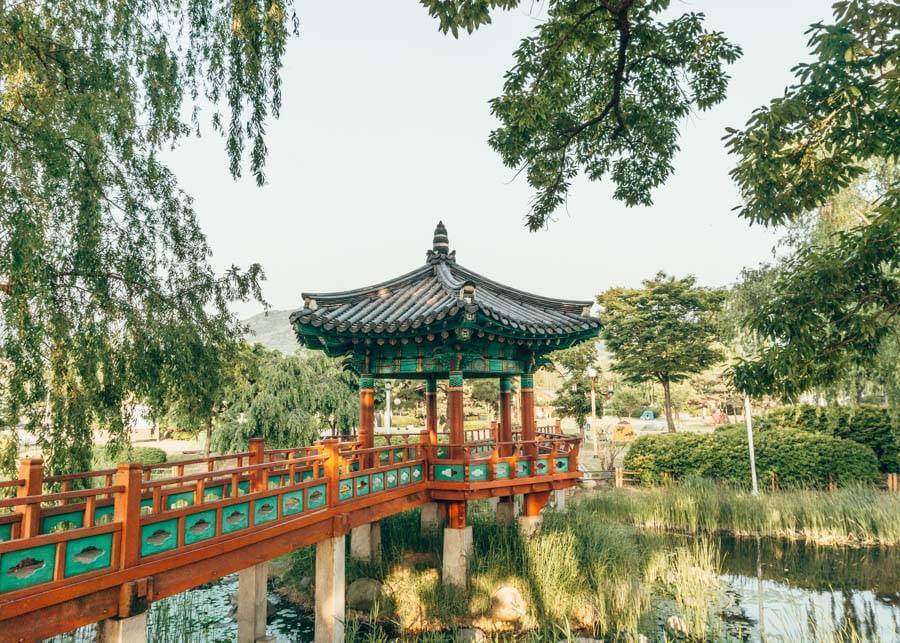
Tips for planning your South Korea vacation
The local currency is the Korean Won. You can easily draw cash from the ATM’s and bank cards are accepted in most places (except for street markets).
Korea is visa-free for most visitors . But as of 2023, there have been changes to the Korea entry requirements. If you’re a citizen from one of the countries that are eligible for visa-free entry, you may still be required to get a K-ETA to enter Korea. You can find out more here.
Pack with caution. When packing for Korea, consider not only the weather but the local customs as well. For example, exposing your shoulders (and chest) is not ok.
Spring and Fall are the best times to plan your trip. Korea has 4 distinct seasons. The summers are excruciatingly hot, whilst winter is freezing cold.
Air pollution is a real thing. At times the air quality is extremely poor, and everyone wears face masks. It’s handy to have one on you when you travel through Korea.
A T-money card is used to access public transport in Korea. You can either purchase this card at a convenience store or train station. But if you’re pressed for time, you may want to preorder one here and collect it at the airport.
Google Translate will be your new best friend. You might be surprised to hear that most Koreans cannot speak English. Seoul is the exception, but when traveling through other destinations within this South Korea itinerary, you’ll need to have Google Translate on hand so that you can communicate with the locals.
Korea is an extremely safe country. Crime is unheard of! If you’re backpacking Korea or you’re a solo traveler, you can rest easy knowing you have the freedom to move around safely.
Get a sim card. Whilst the wifi in Korea is really good, it’s best to stay connected by purchasing a local sim card. This will come in handy when traveling between cities and when you’re out and about trying to find your way around. You can purchase your Korean sim card here , and it will be waiting for you at the airport when you arrive.
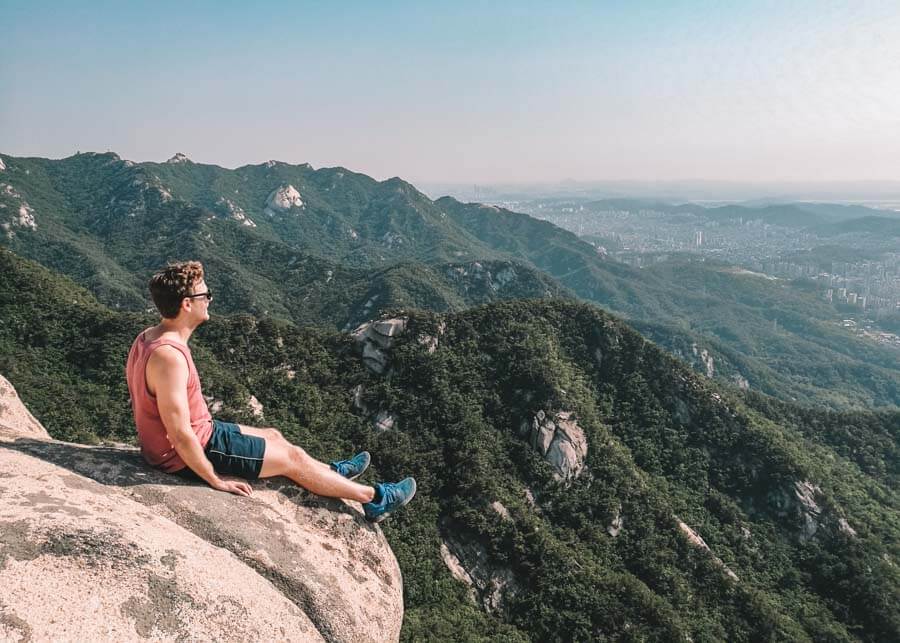
Where to visit in South Korea
Every Korea trip itinerary should include the 3 destinations I’ve highlighted below.
But there are a few other worthy places to visit, and depending on your time and preferences, you may want to add them to your itinerary.
Best Places to visit in South Korea
Seoul is the capital city of Korea and the most exciting place to visit. Many people arrive here and don’t want to leave! It’s a hive of activity with so many things to do and see.
Jeju is a volcanic island south of the country. It’s a popular holiday destination for locals and is famous for its unique landscapes and outdoor attractions.
Busan is the second largest city in Korea. Located on the southeast coast, it’s known for its beaches and seafood.
Other places to visit in Korea
Sokcho is a small fishing village on the northeast coast of South Korea. It’s a bit more off the beaten track and home to the stunning Seoraksan National Park.
Gyeongju is a small city with a rich history. There are historical sights, temples, tombs, and relics around every corner, and it’s often referred to as the museum with no walls!
Jeonju is one of the oldest cities in South Korea. You’ll include this on your South Korea itinerary if you’re looking for a blend of gastronomy and tradition, as it’s home to the famous Korean dish, Bibimbap , and a well-preserved Hanok village.
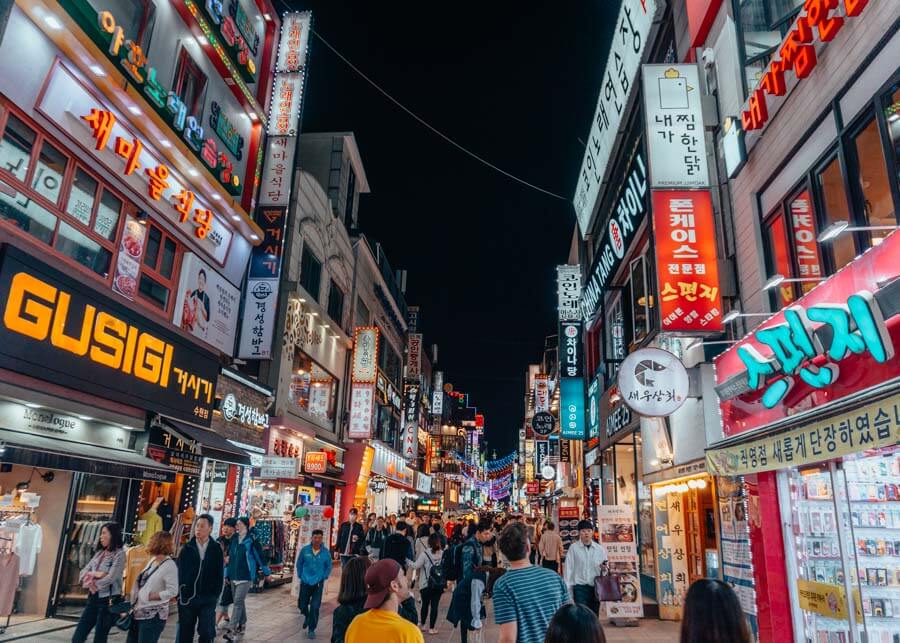
Where to start your itinerary for Korea
Most South Korea trip itineraries start in the city that never sleeps: Seoul.
If there’s one word of advice I can give when planning your vacation, it’s to end in Seoul.
Because Seoul will be the highlight of your 2 weeks in Korea. If you start in the capital, you won’t want to leave!
And whilst Seoul is the most exciting place to visit, the rest of Korea has so much to offer!
If you’re looking for a more authentic Korean experience, then you need to venture to the rural areas, where you’ll discover a whole different side of the country.
On that note, let’s jump right in!
This travel route is flexible and can be cut to a shorter Korea itinerary or extended if you have more than 2 weeks in South Korea.
Travel route for your South Korea itinerary
- Day 1-4: Arrival and Jeju Island (3 nights)
- Day 4-6: Busan (2 nights)
- Day 6-7: Gyeongju (1 night)
Day 7-12: Seoul (5 nights)
- Day 12-13: Sokcho (1 night)
- Day 14: Seoul and departure
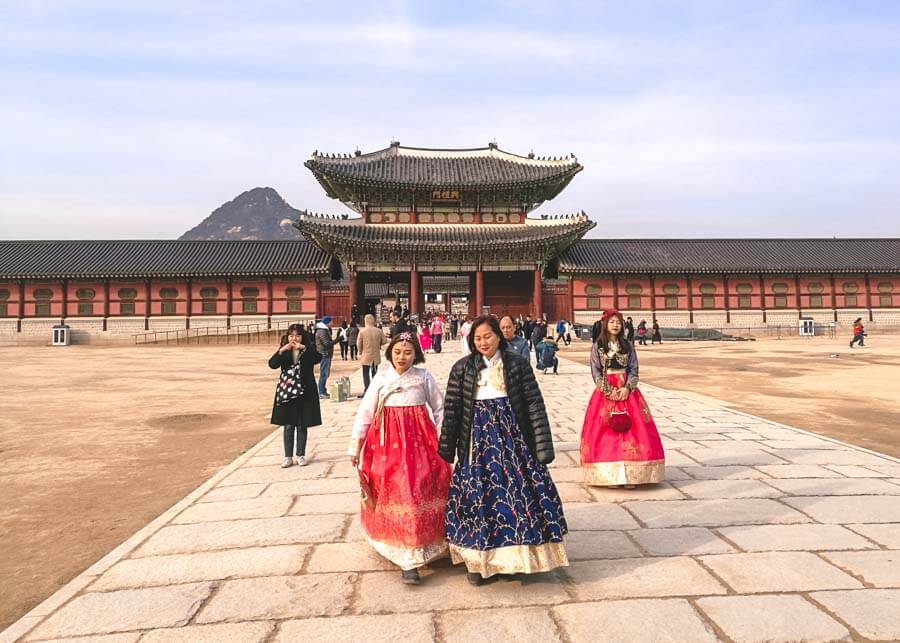
Day 1-4: Jeju Island (3 nights)
Jeju Island, the “ Hawaii of Korea” , is a must on any itinerary for Korea.
Formed through volcanic activity over 2 million years ago, this large island south of the Korean peninsula was recently listed as one of the New 7 Wonders of the World.
Koreans love Jeju – so much so that the flight route from Seoul to Jeju is the busiest and most popular route in the whole world.
Families pop over for a quick weekend getaway, and it’s a favorite for vacationers. It’s also a romantic island and a hotspot for honeymooners.
I had big expectations before arriving in Jeju. It’s the place where I had my first real Korean BBQ, the first time I overindulged in Soju, and the first time I got to experience the Korean way of life, which includes an obsession with selfies!
It was an island of firsts, and whilst it may not have been the tropical paradise I was anticipating, it was spectacular in its own right and is worthy of a spot in your South Korea 2 week itinerary.
How to get to Jeju Island
Jeju Island is the starting point of your vacation to Korea. International flights from across Asia have designated routes to Jeju, so be on the lookout for those.
However, most international flights will land at Seoul’s Incheon International Airport. From there, you will need to catch a flight to Jeju.
Seoul has two airports, Incheon and Gimpo, which are a 40-minute train ride from each other.
Gimpo mostly caters to domestic flights, so you’ll book your flight to Jeju International Airport from here. This is a quick 1-hour flight that costs $40 one way.
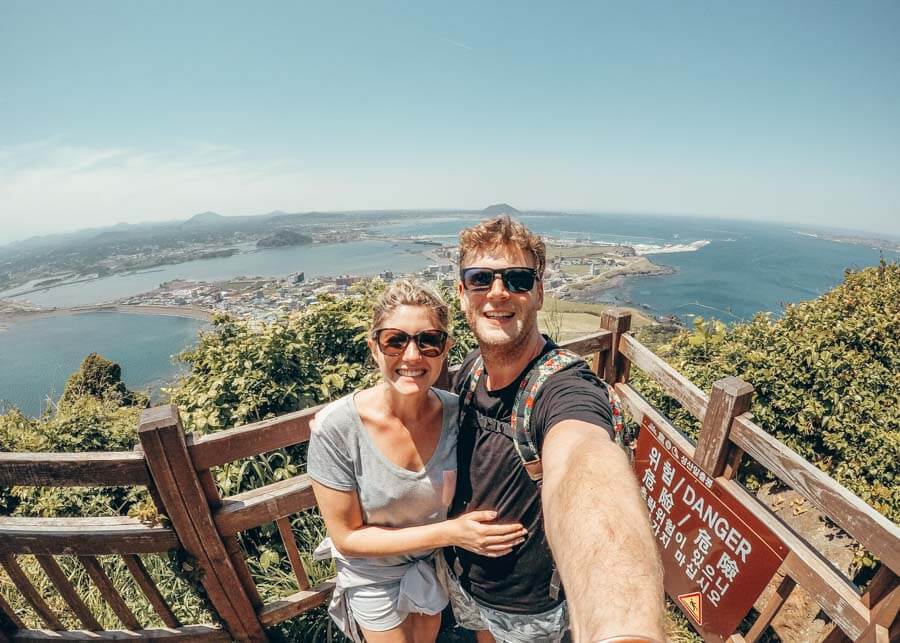
Where to stay in Jeju
Choosing where to stay in Jeju is often the most challenging part of any trip, as the island is massive.
The airport is in the north, in Jeju City, which has a big city feel.
In contrast, the south and east coast are less chaotic and more peaceful areas.
If you’re following this South Korea two week itinerary, I suggest you stay in Seogwipo, which is south of Jeju Island.
It’s within close walking distance to many attractions, and the vibe is awesome.
Budget travelers will love Gudeok Guesthouse , which is where I stayed. It’s the perfect option for solo travelers, backpackers, and even couples. Gudeok Guesthouse is located in the middle of all the action and close to the harbor, with parks and playgrounds close by.
If luxury is what you’re looking for , GoldOne Hotel is the best place to stay in Seogwipo. The rooms are tastefully decorated and are much bigger than most in Korea. The outdoor pool offers spectacular ocean views, and it doesn’t get much better than this.
Things to do in Jeju Island
There is so much to see and do in Jeju . With only two weeks in Korea, you’re going to need to choose your activities wisely.
Day 1 in Jeju
Day 1 is the perfect introduction to Korea.
You’ll probably arrive in Jeju around noon, giving you just enough time to explore one or two attractions. It will be an early night as you’ll be exhausted from your international travels.
Waterfalls: After checking in to your hotel, take a walk to the 2 best waterfalls in Jeju, namely Cheonjiyeon, and Jeongbang Waterfall. Both are conveniently located just a short walk from Seogwipo, so it’s a great opportunity to get some fresh air after a long day of travel.
Jeju Black Pork: After exploring Seogwipo, head out for dinner to try your first Korean meal: A Black Pork BBQ. Jeju Black Pork is world-famous! The meat itself isn’t black but rather the color of the pig. For a true Korean BBQ experience , head to Tam Gung Restaurant in Seogwipo.
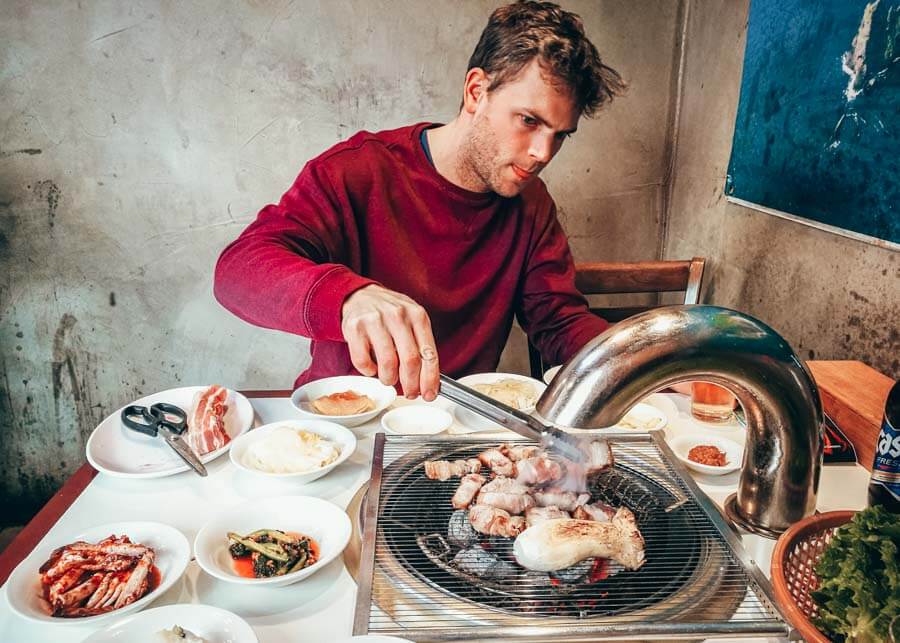
Day 2 in Jeju
Today I recommend you head east of the island to explore several UNESCO World Heritage sites in Jeju.
These spots are not to be missed and should be part of every South Korea itinerary.
You can either book a full-day tour or you can use public transport to get around today.
The public transport in Jeju is good, but not at the same high standard as the rest of Korea.
I only used buses on the island and managed just fine, but they were slow with long wait times.
However, I had more time to play with as I had 5 days in Jeju (and not 3). If you’re able to, I suggest you book a full-day tour instead.
Manjanggul Cave: This cave east of the island is one of the longest in the world! At 13 km in length, you’re guaranteed to set your sights on many spectacular natural attractions. Although only the first kilometer is open to the public, it’s absolutely fascinating.
Seongsan Ilchulbong: Also known as Sunrise Peak, Seongsan Ilchulbong is an extinct volcano and one of the top attractions in Jeju. The hike to the peak takes around 30 minutes and offers unspoiled views of Jeju island in the distance.
Women Divers: The Jeju Haenyeo (women divers) have made a name for themselves in Korea. These women free dive for up to 20 meters and fish for shellfish and clams, which they sell to the local stores. Their work is impressive, especially given that they’re over 70 years of age! You can easily watch them after your hike to Seongsan Ilchulbong as they dive into the ocean at the foot of the volcano.
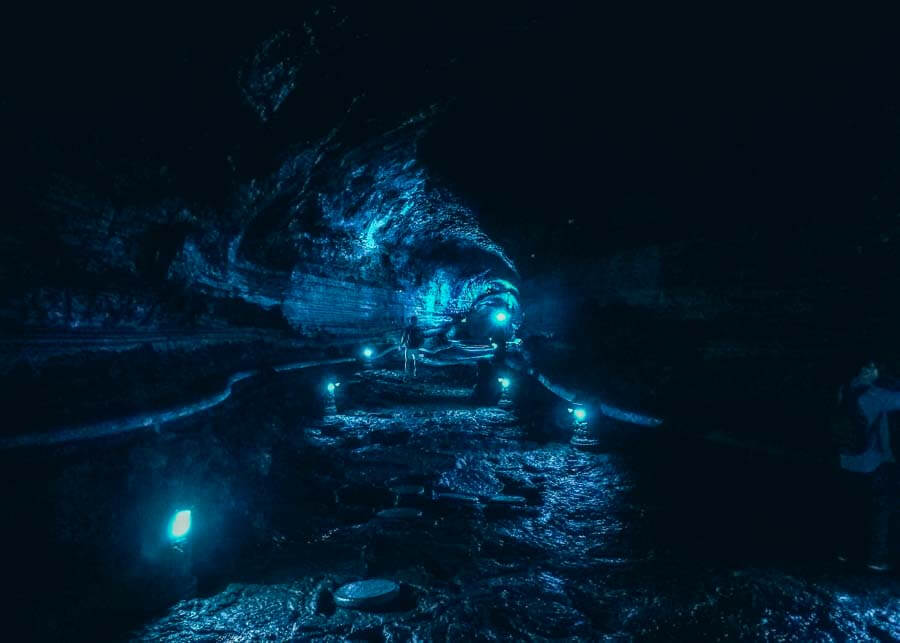
Day 3 in Jeju
Your third day in Jeju can be customized to your preferences.
Beaches: If you’re backpacking Korea during the summer, you have to visit the beaches in Jeju Island. They’re the best in the country! Jungmun Beach on the south coast is arguably the most popular, and Sagye Beach, which is nearby, is also worth a visit. Both are close to Cheonjeyeon Waterfall, which can easily be included in your itinerary for today. If you’re looking to go further west, you’ll find Hyeopjae Beach, which is also a crowd favorite.
If you’re going beach hopping, hire a private driver for the day . This way, you can customize your route and enjoy the beaches at your own pace.
Hike Mount Hallasan: Mount Hallasan is the highest mountain in the country. Many people include it as a bucket list activity on their itinerary for South Korea. Situated in the middle of Jeju, you’ll need a full day to hike to the peak, and it’s best done during the spring or fall when the weather’s pleasant and cool.
Western Island Tour: If you’re looking to see a bit of everything, this western island tour of Jeju is for you. Highlights include Cheonjeyeon Waterfall, tea fields, Hyeopjae Beach, and even a stop at Hanlim Park. You’ll be exhausted by the end of it, but it’s a great mix of the best of western Jeju.
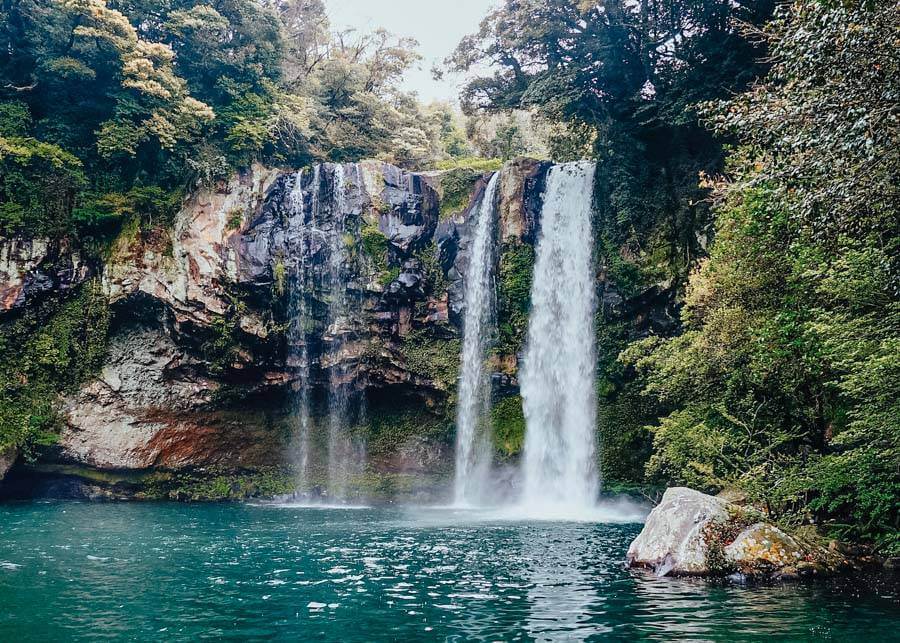
Day 4-6: Busan (2 Nights)
Next up on your 2 week South Korea itinerary is Busan.
It’s the second-largest city in Korea and lies southeast of the country. Famous for its beaches, Busan is strikingly different from Jeju and other cities in Korea.
Although Busan is a favorite for travelers backpacking South Korea, it wasn’t my favorite. But it’s still worth a visit, and that’s why I’ve only included 2 days here.
Where to Stay in Busan
Because you only have 2 nights in Busan, I strongly recommend that you stay near Haeundae Beach. It’s an awesome area with a lively atmosphere and a great vibe.
Haeundae gets extremely busy during the summer, so prices may be inflated. But staying just a stone’s throw away from the beach justifies the cost.
Here’s my guide to the best places to stay in Busan , which includes the pros and cons of each neighborhood.
If you’re backpacking Korea, Mama Guesthouse in Haeundae is the perfect place for you! It’s just a short walk to the beach, where you can spend your evenings watching the sunset.
Got more money to spend? You won’t get much better than Paradise Hotel ! The spacious rooms come with oceanfront views, and the rooftop bar has a luxurious infinity pool.
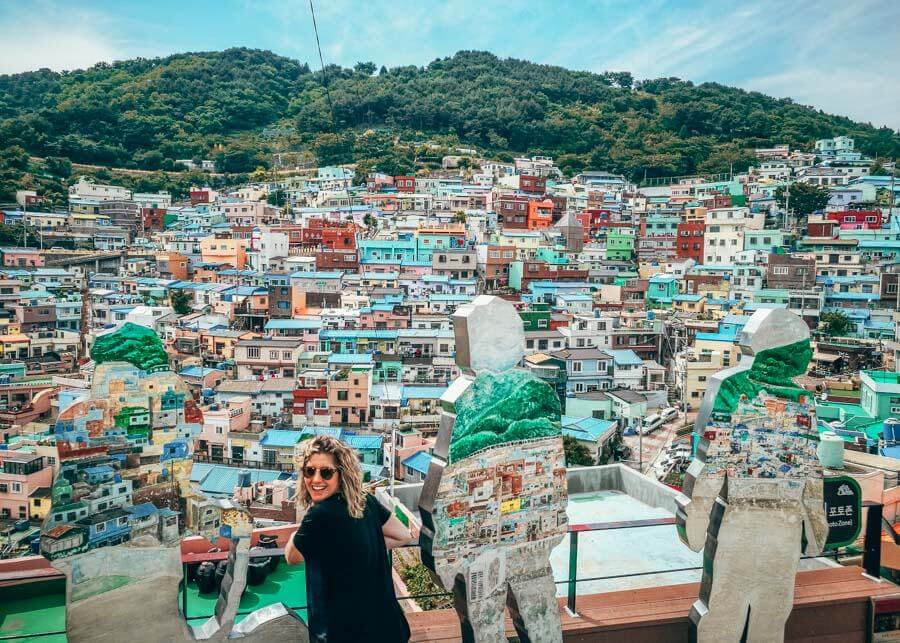
How to get to Busan
Busan is easily accessible throughout Korea via a short flight from Seoul. Or you can hop on the speedy KTX fast train, which is the quicker option!
If you’re following this South Korea 2 week itinerary, then it’s best to book a flight from Jeju to Busan. This won’t cost you more than $40 for the 45-minute flight.
If you’re backpacking Korea, and traveling on a tight budget, you can also opt to take the ferry from Jeju to the mainland. But the journey takes over 12 hours.
Things to do in Busan
You only have 2 days in Busan , and they’re going to be busy!
Put on your walking shoes because you’re off to visit the best places in the city.
Day 4 in Busan
You’ll be traveling from Jeju to Busan on day 4 of your South Korea itinerary.
There are many flights to choose from, but try to get one that leaves Jeju in the morning.
Yonggungsa Temple: This stunning Buddhist temple sits on the coast of Busan, with gorgeous views from its cliffside location. Yonggungsa Temple is 7 km east of Haeundae Beach, but if you’d prefer to take it easy, you can give it a skip. You’ll be visiting many temples over the next few days, and this one is particularly crowded!
Haeundae Beach: I love Haeundae Beach! And no matter the season, there’s always a hive of activity surrounding its sandy shores. Grab a coffee (or a Cass Beer) and some snacks, and head to the beach to watch the sunset.
Jagalchi Fish Market: The Jagalchi Fish Market in Nampo offers the biggest variety of seafood I have ever seen! And you don’t need to order anything if you’re put off by what you see, just take a stroll and watch as the locals do their thing.
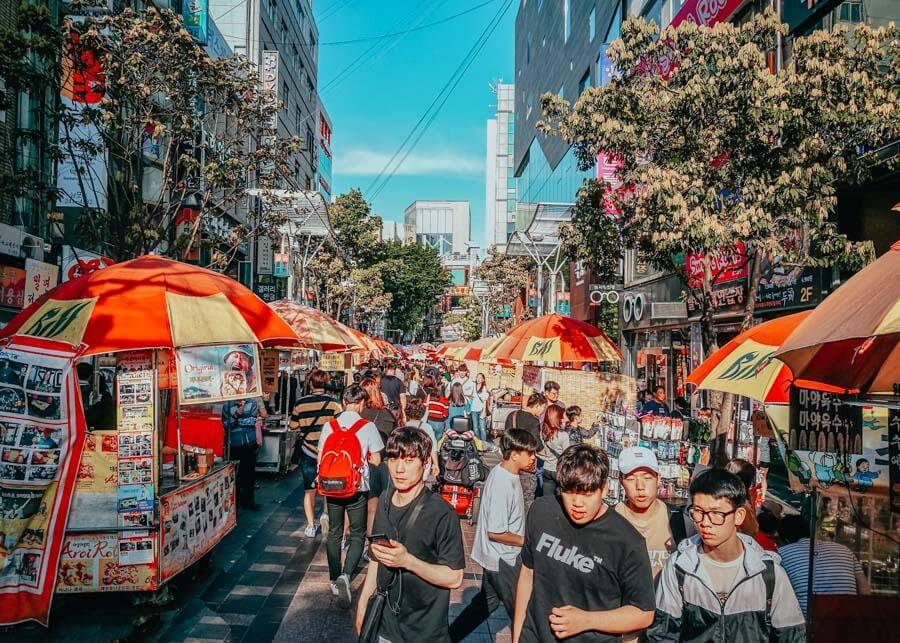
Day 5 in Busan
Your fifth day in South Korea is going to be a busy one!
We’ll be heading southwest of Busan to check out some epic places. All the attractions are found along the same route, so it makes sense to visit them all today.
Gamcheon Culture Village: Gamcheon Culture Village is an iconic neighborhood in Busan. This bright-colored and vibrant neighborhood was once a slum but has now been transformed into an Instagrammers dream location with quirky houses, murals, and statues dotted all over the show.
Biff Square Market: After visiting Gamcheon Culture Village, you will have worked up quite the appetite. It’s the perfect time to visit your first street market in Korea! And the food here will blow your mind and satisfy all your cravings. While you’re at it, you can purchase some socks, beauty products, cell phone accessories, and more because Biff Square has everything.
Gwangalli Beach: Gwangalli Beach is another one of the top beaches in Busan. After a busy day exploring, you can finally head to Gwangalli Beach where you can chill by the seaside. Here’s where you’ll spot live performances on the beach, selfies galore, and couples having photoshoots. Once the sun’s set, head to a nearby chicken and beer restaurant (yes, it’s a thing, and yes, you have to try it) before making your way back home.
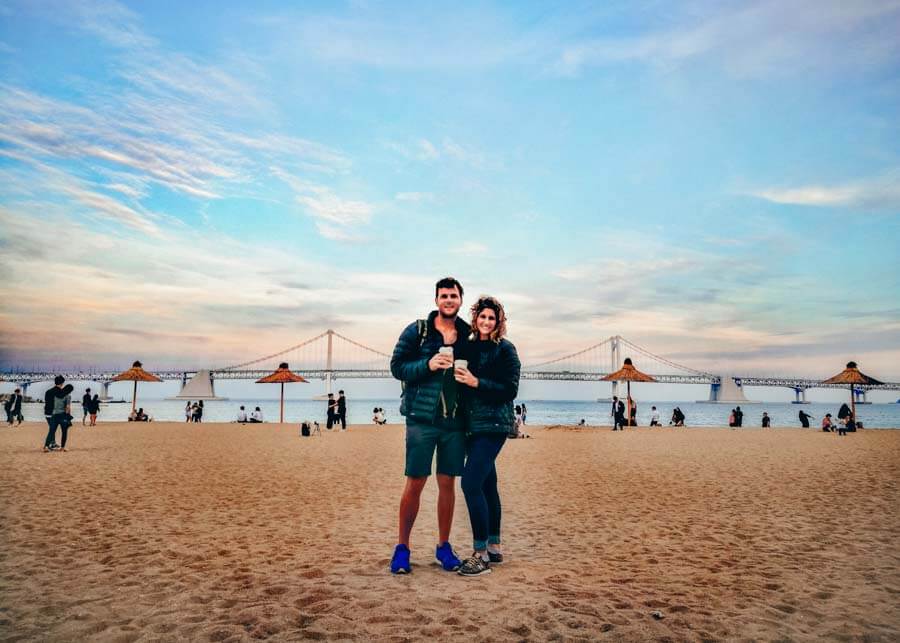
Day 6-7: Gyeongju (1 Night)
Before saying goodbye to Busan, have an early start to the morning and visit Life Day Spa, one of my favorite Jimjilbangs in Korea.
No Korea itinerary is complete without visiting these traditional bathhouses.
This particular spa is more Westernized and caters to tourists. It’s a great option if you’re not sure of what to expect.
Once you’re done, it’s time to head off to your next destination, as you’ll leave Busan today.
You have a few options for things to do and places to go: Either Gyeongju or Seoul.
In my initial itinerary for Korea, I had allocated more time to Busan. But after spending 2 days in the city, I was keen to check out something new.
It’s not that I didn’t love Busan, it was just a lot, and my first days were pretty busy.
I wanted to see a more traditional side to Korea, so I headed to Gyeongju.
Gyeongju was the capital city of the ancient kingdom of Silla and is one of the most historical sites in South Korea.
It was once the 4th biggest city in the world and holds a significant place in Korean history.
Should Gyeongju be on your itinerary for Korea
But Gyeongju isn’t for everyone. It’s a charming city with a rich history and cultural heritage of the Silla dynasty.
As you can imagine, Gyeongju has a completely different vibe to that of Seoul and Busan.
I never saw any foreigners during my time there. But I loved this feeling of being so foreign and completely out of my comfort zone.
If you’re looking for nightlife, a backpacking crowd, and other creature comforts, then don’t visit Gyeongju.
If that’s the case, skip this section of my South Korea itinerary and continue onto Seoul (and then Sokcho)!
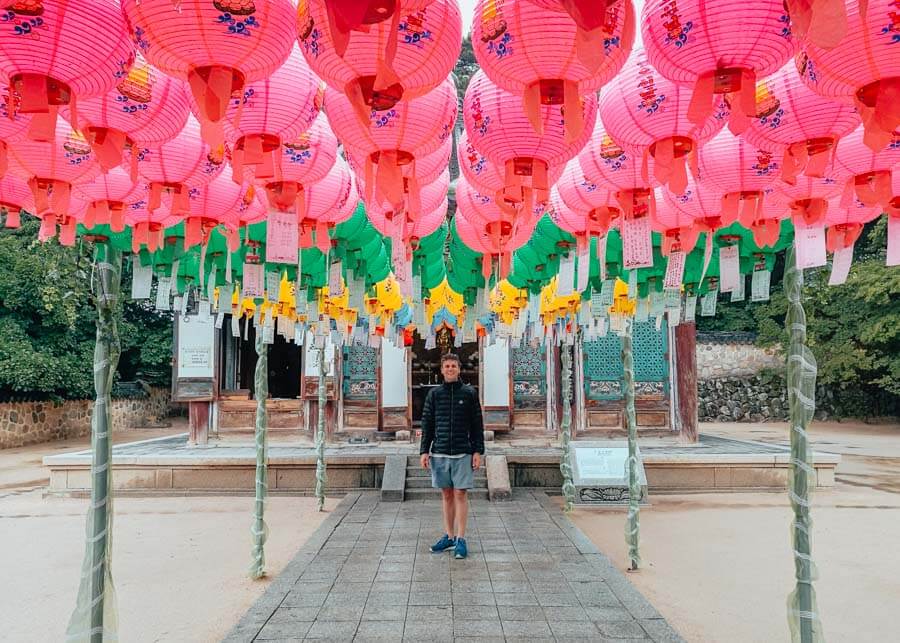
How to get to Gyeongju
Gyeongju is a short 1-hour drive north of Busan.
The easiest way to get here is to hop on the express bus at the Nopo Bus Terminal (in Busan) to Gyeongju.
You can find the bus schedules here.
Where to stay in Gyeongju
Gyeongju is a relatively small city, and it’s best to stay near the bus terminal as you’ll only be here for one night.
I stayed at Motel Apple House , conveniently located in the middle of town. The price is affordable, and the rooms are much bigger than most. I rented bikes from the owner, who happily offered us insider tips on where to go and what to do.
A more luxurious option is Gyeongju GG Tourist Hotel. This hotel is one of the best! Its prime location is the biggest selling point (and the delicious breakfast that’s included).
Things to Do in Gyeongju
Despite being a small city, there is plenty to keep you busy.
These are the highlights and what you should include in your 2 week South Korea itinerary.
Day 6: Arrive in Gyeongju by 11 am
Try to get to Gyeongju before noon so that you have time to explore the city on your first day.
Rent a bike: The best way to experience Gyeongju is by bike. The city is small, so you can easily cycle around, visiting the top attractions in a short space of time. You can rent a bike from your accommodation, but there are many bike rental shops throughout the city, and it won’t cost you more than 5 000 won ($4) per day.
Daereungwon Tomb Complex (Tumuli Park): When cycling through the city, make your way to Tumuli Park where you’ll find the royal tombs. They are easily identified as they resemble small mountains within a park. These tombs are the resting place of kings, queens, and court officials, but most are unidentified.
Donggung Palace and Wolji Pond: Formally known as Anapji, it’s hard to believe that this was the palace complex of the ancient Silla. Walking through the restored complex grounds was like going back in time. If possible, visit the palace at nighttime when the soft lights illuminate the pond and temples.
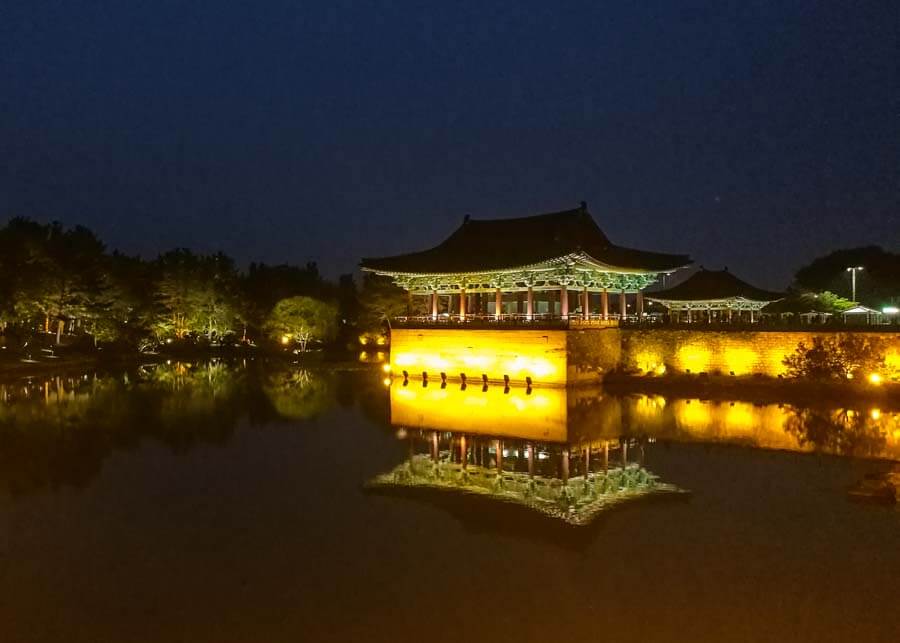
Day 7: Gyeongju (Depart for Seoul by 2 pm)
Today is going to be busy. But you’ll be on your way to Seoul by the end of it.
First, you have a bit of sightseeing to do in Gyeongju! Start early so that you leave Gyeongju before 2 p.m.
The Bulguksa Temple: The Bulguksa Temple is a national treasure and one of Korea’s most important temples. This working Buddhist temple is located on the outskirts of Gyeongju and is a UNESCO World Heritage Site. I was amazed by how beautiful the temple complex was, with its wooden buildings hidden high up against the mountain. Surrounded by lush trees, the Bulguksa Temple has a calm and serene atmosphere and is a must-visit if you include Gyeongju in your itinerary for Korea.
Seokguram Grotto: Within the Bulguksa Temple complex lies the Seokguram Grotto which houses a monumental statue of the Buddha. The hike from Bulguksa Temple to Seokguram Grotto takes over an hour, but the views are stunning. Alternatively, you can hop on a bus that leaves every hour.
After spending your morning visiting Bulguksa Temple, it’s time to get to Seoul!
How to get to Seoul
The quickest way to get from Gyeongju to Seoul is via the KTX fast train, which takes 2 hours. But it does have its downsides!
Firstly, this ticket is about double the price of the bus, so if you’re backpacking South Korea on a budget , you may opt for the cheaper 3.5-hour bus trip instead. Secondly, the train station is about 15 minutes drive outside of Gyeongju, which will be an additional cost for a taxi.
I took the bus from Gyeongju Bus Terminal to Seoul, and it was quick, easy, and cheap!
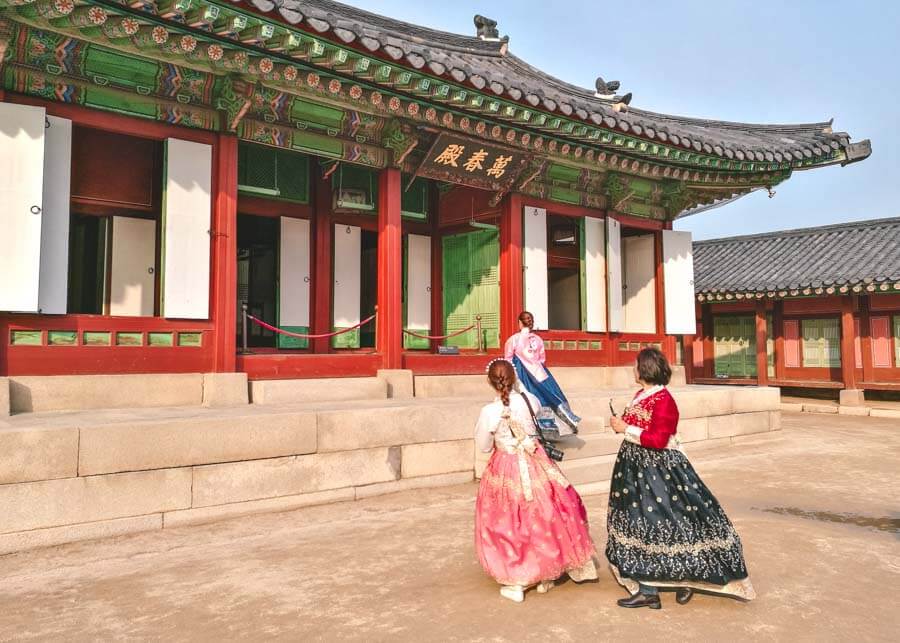
What better way to kick off your second week in South Korea than by hitting the big city, Seoul.
You can’t come on a vacation to South Korea and skip Seoul – it’s unheard of!
After spending the past 7 days traveling between Jeju, Busan, and Gyeongju, all destinations that offer contrasting experiences, you’ll find a good mix of everything in Seoul.
It effortlessly combines the old with the new. You’ll be blown away by the towering buildings, bright neon lights, and the latest (and greatest) tech.
But amongst the hustle and bustle, you can still find gorgeous temples and spectacular landscapes, making it the best place to visit in Korea!
How many days in Seoul
If you have 3 weeks in Korea, I recommend you spend 7 days in Seoul, which will include day trips to destinations nearby.
But, for a 2 week Korea itinerary, you may need to exclude certain attractions or plan your days so that you can squeeze in all the sights.
So, according to this itinerary for Korea, you have 7 days left in Korea.
Either you’ll spend the last 7 days in Seoul, or you’ll do 5 days in Seoul and head east to Sokcho for the other 2 days.
Top tip: If you decide to skip Gyeongju, you’ll still have 7 days in Seoul and 2 days in Sokcho!
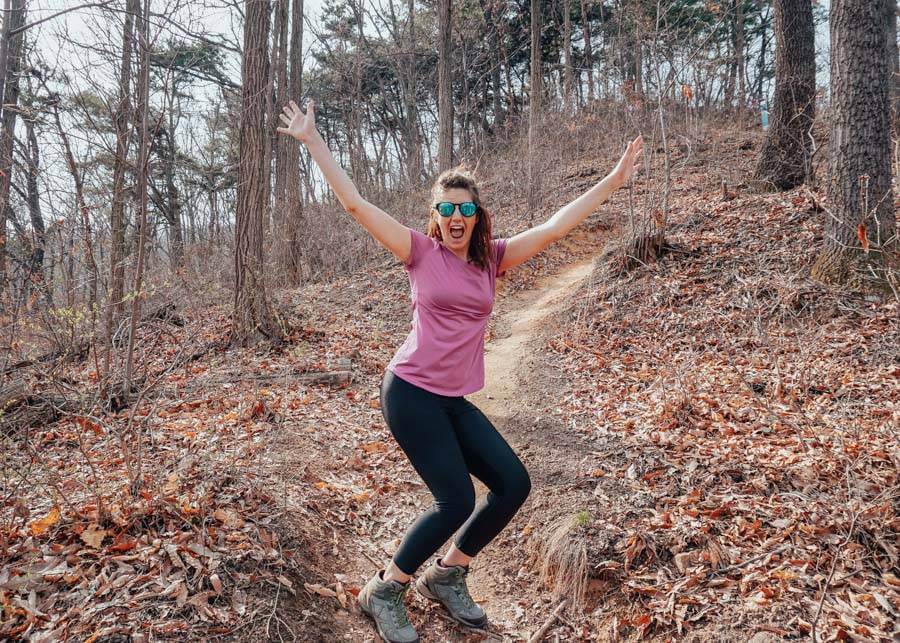
Where to stay in Seoul
Seoul has one of the best public transport systems in the world, making it easy to explore the city and navigate between the sights.
This also means that you can stay in one area and use it as your base instead of constantly moving around.
Myeongdong gets my vote as it is the most central area to stay in Seoul . It’s close to many attractions, and if you’re planning on doing any tours, most have pick-up points at the Myeongdong station.
Backpackers in South Korea will love Myeongdong Rooftop Hostel . It’s a brand new hostel situated slap-bang in the center of Myeongdong with an epic rooftop area offering great views of N Seoul Tower.
If you’re looking for a quieter and more elegant option, Hotel 28 Myeongdong ticks all the right boxes. This luxurious boutique hotel is the center of Myeongdong, close to all the action. It’s just the type of place you want to come home to after a long day of exploring, with a stunning interior, comfortable beds, and gorgeous views from the rooftop bar.
Things to do in Seoul
Here are the top things to do in Seoul, which should be on every itinerary for Korea.
Day 7 in Seoul: Arrival in the evening
If you’re following this South Korea itinerary and coming from Gyeongju, you’ll likely arrive in Seoul late afternoon or early evening.
Explore Myeongdong: Myeongdong is the shopping district of Seoul and home to the best street food in the city. It’s bright and vibrant and the first place you’ll visit in Seoul. Myeongdong is best to visit in the early evening. Walk the streets, do some shopping, eat tteokbokki and gimbap , and take in all that is Seoul!
Cooking Nanta Show: The Cooking Nanta Show is a live performance combining arts, dance music, and entertainment. This 90-minute food extravaganza takes place in Myeongdong, so it’s the perfect way to end your first day in Seoul. Buy your Nanta Show tickets here.
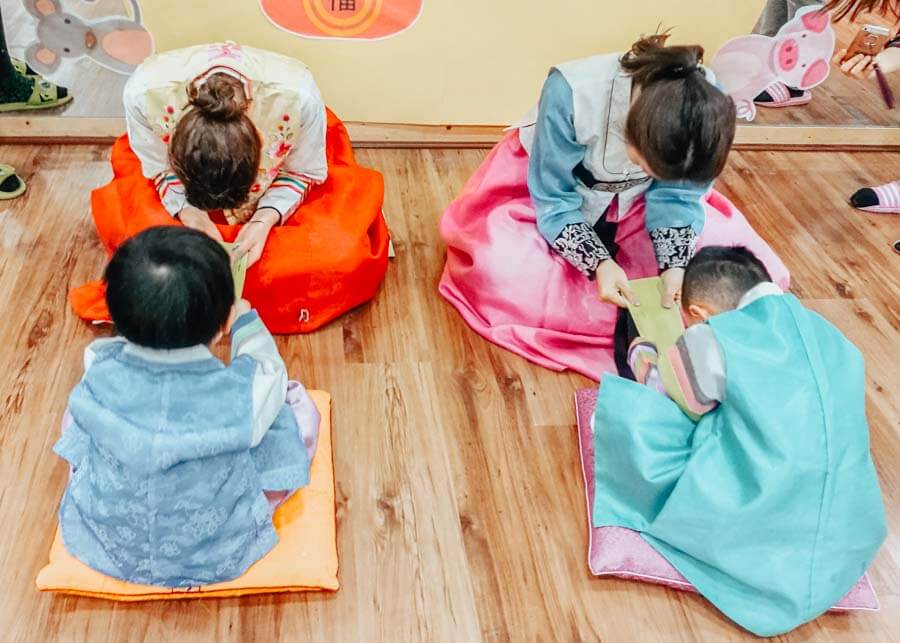
Day 8 in Seoul
Bukhansan National Park: Start early with a hike to Bukhansan National Park, one of the most beautiful natural attractions in Seoul. The hike to the highest point, Baegundae Peak, is a tough one, but the views are spectacular. You’ll need 3-5 hours for your morning’s adventure.
Top tip: If you’ve decided on the Sokcho addition to your South Korea itinerary, then you may want to skip this hike to Bukhansan. Why? Because you’ll be hiking Seoraksan National Park (in Sokcho) a few days later.
Itaewon: Itaewon is the party district of Seoul, and I love the vibe here! It’s also multicultural, with scores of local and western restaurants. Grand Ole Opry is one of my favorite bars in the area! As with Myeongdong, it’s best to plan your trip to Itaewon in the evening when the streets come alive.
If you’re not one for hiking (or drinking in Itaewon), you can easily add Gangnam to today’s itinerary. It’s the district where the rich and famous hang out. It’s also home to the Instaragammable Starfield Library and Coex Shopping Center, as well as Bongeunsa Temple.
I enjoyed Gangnam, but I preferred hiking and partying in Itaewon. Hence I’ve included it as an optional extra. You can also include Gangnam on your last day (which I’ve mentioned further along) .
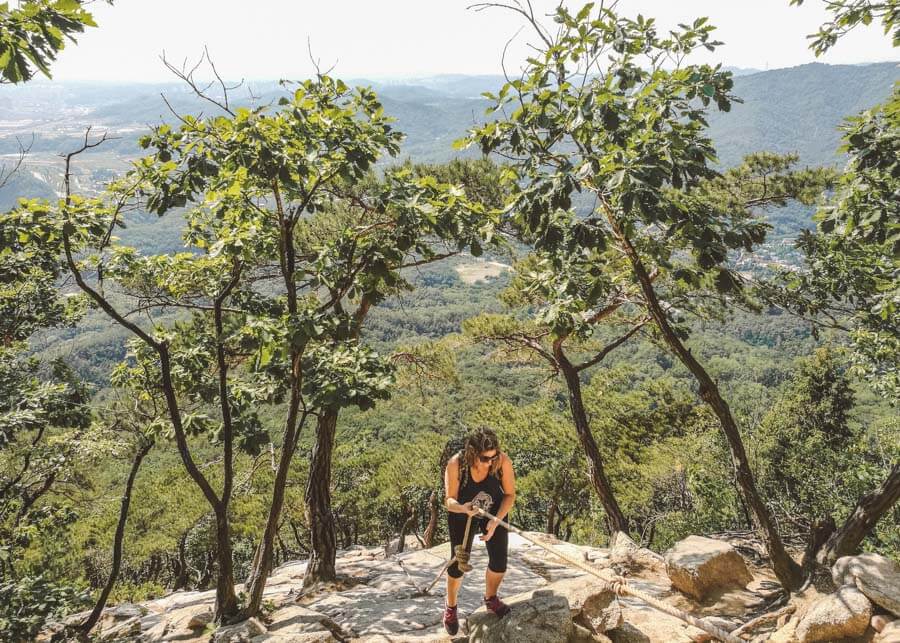
Day 9 in Seoul
Bukchon Hanok Village: This is one of the most iconic traditional villages in Korea. With its narrow streets and charming houses, called hanoks, Bukchon Hanok Village is a great place to explore on the 9th day of your South Korea itinerary.
Gyeongbokgung Palace: This palace complex was once home to royalty! The gorgeous temple grounds are fascinating, and it’s common to wear a traditional Korean dress called the hanbok when exploring.
You then have three options of what to do after, depending on your time and energy levels.
Han River: The Han River is yet another famous landmark in South Korea. Alongside it, you’ll find gorgeous parks, walking trails, and playgrounds. It’s a hive of activity during the weekends, and it’s a great place to hang out after a busy morning exploring.
If you’re running late, you may need to skip the Han River in favor of N Seoul Tower and Hongdae (below).
N Seoul Tower: N Seoul Tower, otherwise known as Namsan Tower, is the second-largest point in Seoul and offers sweeping views of the sprawling metropolis in the distance. I recommend that you take the cable car to the peak and walk back down through Namsan Park. N Seoul Tower is easily accessible from Myeongdong, so you can head home and freshen up before hitting Hongdae.
Hongdae: Hongdae is a university neighborhood filled with live street performers, cool cafes, noraebangs (Karaoke rooms), and epic bars. The youthful and fun atmosphere attracts backpackers in Korea, and it’s a good spot to check out in the evening.
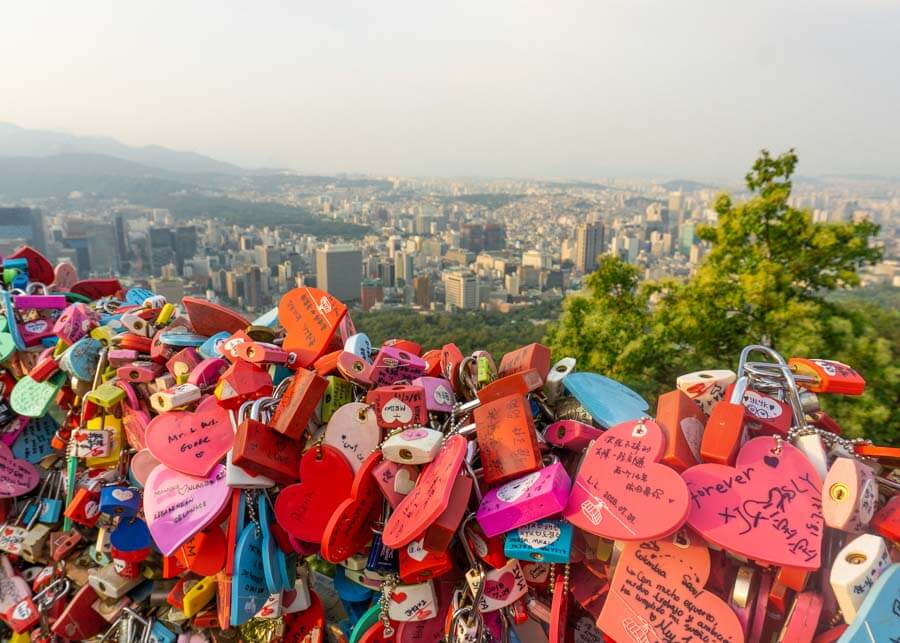
Day 10: Day Trip to Nami Island
Nami Island is only 50 km from Seoul and makes a great addition to your itinerary for Korea.
I spent a night here. But given your time limits with only two weeks in South Korea, I don’t suggest you do the same.
It’s best to book a day trip from Seoul as there is so much to do and see in the Gapyeong region.
Nami Island: Nami Island is a half-moon-shaped island located east of Seoul. Like Jeju Island, don’t expect those tropical island vibes! It’s popular for couples and families and has a quirky and cool vibe to it. With gorgeous tree-lined walkways and beautifully manicured paths, Nami Island is an awesome day adventure, allowing you to get a feel for what Korean love most.
READ MORE: THE PERFECT NAMI ISLAND ITINERARY
Gangchon Rail Park: Just a stone’s throw away from Nami Island lies two of the best rail bike parks in Korea: Gangchon and Gapyeong rail parks. These awesome parks allow you to peddle down unused tracks, through mountains, and alongside rivers. It’s a beautiful way to experience the Korean countryside, away from the hundreds (if not thousands) of people you’ll see at Nami Island. Here’s why I believe Gangchon Rail Park is better than Gapyeong Rail Park!
Eat Dakgalbi: Yep, this is getting its own shout-out! Dakgabli (the most delicious marinated chicken and cheese dish you will ever have) is famous in Gapyeong, and you’ll find many restaurants serving up the yummy dish. Make sure dakgalbi is part of your lunch plans!
More to do: I highly recommend you visit the above attractions in Gapyeong, but there’s more to do in the area. Petite France and the Garden of Morning Calm are destinations included in most Korean itineraries. If you’re traveling independently, then you may not be able to visit them due to time limitations. But if you book a group tour like this one , private transport is provided, which will allow you to see all the top sights around Nami Island.
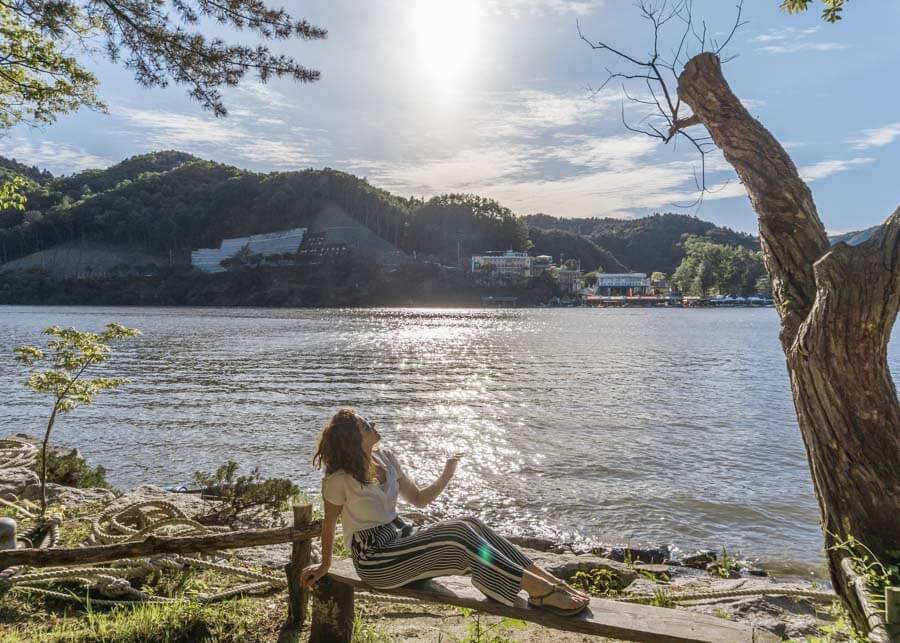
Day 11: Day Trip to DMZ
It’s no secret that there is tension between North Korea and South Korea!
The DMZ is proof of this, as it is one of the heaviest militarized borders in the world.
Visiting the DMZ is only possible with a group tour like this , and it’s easily accessible on a day trip from Seoul.
Depending on what else you want to see in Seoul, you may want to take the half-day DMZ tour so that you can return earlier to check out other destinations you’ve missed (Such as Gangnam, Hongdae, or the Han River).
You can find the best half-day tours here .
Unfortunately, these half-day tours don’t include stops at the Joint Security Area (JSA). So if this is on your Korea bucket list, you’ll need to opt for the full-day DMZ tour instead.
This is what I did, and I was absolutely knackered afterward, so be wary of planning too many activities for the evening!
2023 Update: The JSA is currently closed to visitors, but there are still tours going to other sections of the DMZ .
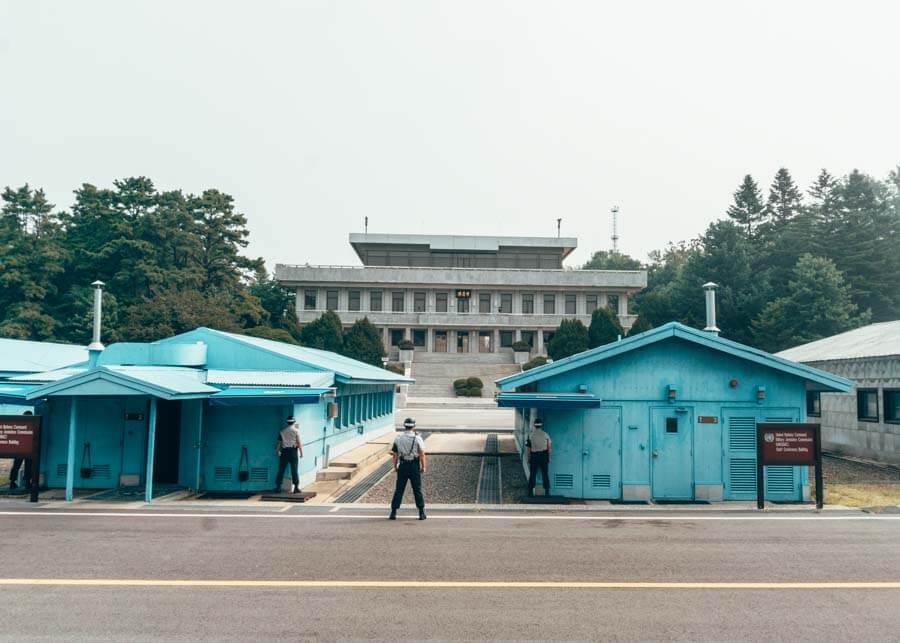
Day 12-14: Seoul or Sokcho
You’ve already spent 5 days in Seoul – and you’re guaranteed to love it!
Since you only have 3 days left on your South Korea itinerary, it’s time to make a big decision.
Do you want to spend more time in Seoul? Or do you want to check out Sokcho?
Day 12-14 in Seoul
If you decide to stay in Seoul, there are plenty of attractions to keep you busy.
Go skiing: If you’re planning this itinerary for Korea during winter, you must head to the mountains and go skiing. There are numerous awesome ski resorts near Seoul – many of which I visited myself.
Visit Everland: Everland is the Disney of Korea. If you’re planning your South Korea itinerary with your family, you need to visit Everland. Lotte World is also a crowd favorite. Both Everland and Lotte World get extremely busy on weekends and public holidays, so try to avoid visiting these days. To save time waiting in queues, purchase discounted tickets here.
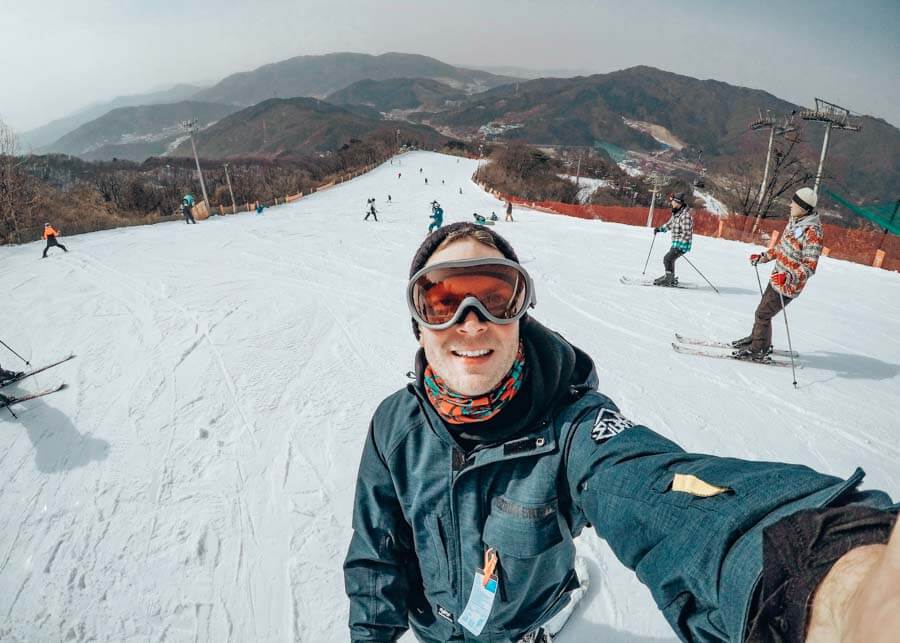
Day 12-13: Sokcho (1 Night)
Nature enthusiasts will love Sokcho as it’s home to Seoraksan National Park.
It’s on the east coast of Korea, a 3-hour drive from Seoul.
Many shorter Korea itineraries include Sokcho as a day trip recommendation,.
Yes, it’s possible on a tour like this .
But considering the time it takes to get there, it’s best to spend the night.
How to get to Sokcho
The easiest way to get to Sokcho is to take a bus from Seoul’s Express Bus Terminal to Sokcho.
This trip will take under 3 hours (traffic dependent) and will set you back on 14,000 won ($11) for a one-way ticket.
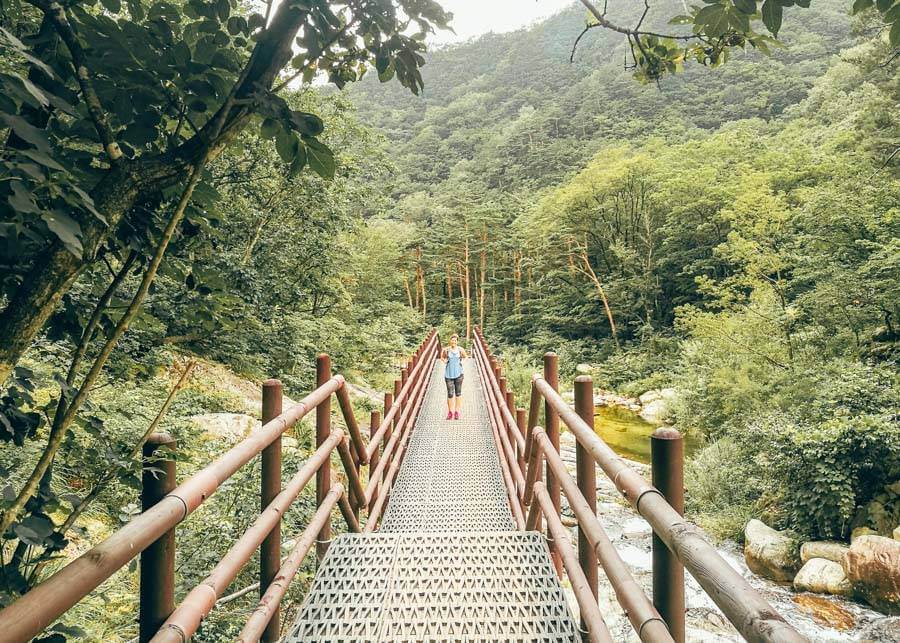
Where to stay in Sokcho
Sokcho is surprisingly small, but there’s a range of accommodation options to suit every budget and travel style.
Try to stay near the beach so that you’re within walking distance of everything.
Budget travelers will love Sokcho Hutte . What makes this place shine is the hospitality of the owner, who will go out of his way to ensure you have a great trip. Situated near the bus terminal, the location couldn’t be better.
If you’re traveling on a mid-range budget, you may prefer to stay in The Mark Sokcho Residence , which offers bigger rooms with their own kitchenette areas. The comfortable space also offers views of the beach and ocean.
Day 12: Arrive in Sokcho by 11 am
Hike Seoraksan National Park. This national park is breathtaking, and you can spend hours hiking through the forests and wandering the rugged paths. There are several trails you can choose from, each with varying levels of difficulty. I hiked to Ulsanbawi Rock which was quite tough but is known to have some of the best views in all of Korea. ( Although I didn’t get so lucky as it was overcast and cloudy on the day of my hike )
Day 13: Sokcho and Seoul
You’ll be leaving Sokcho today. But there’s still time to check out a few spots that you wouldn’t have had time for yesterday.
Explore Sokcho: Sokcho is a small fishing village with an awesome beach, so spend your morning exploring the town before hopping on a bus back to Seoul.
Naksansa Temple and Naksan Beach: Instead of the above, I recommend you hop on a bus and head to Naksan Beach, which is a nearby town. It doesn’t have much with the expectation of a laid-back atmosphere, beautiful temple, and gorgeous beach. I spent my summer vacation in Naksan Beach and loved it, but you’ll only have a few hours here. Explore the cliffside Naksansa Temple (which is well worth a visit over the temple in Busan), take a stroll along the beach, and then head back to Seoul by 3 p.m. to enjoy your last night in Korea!
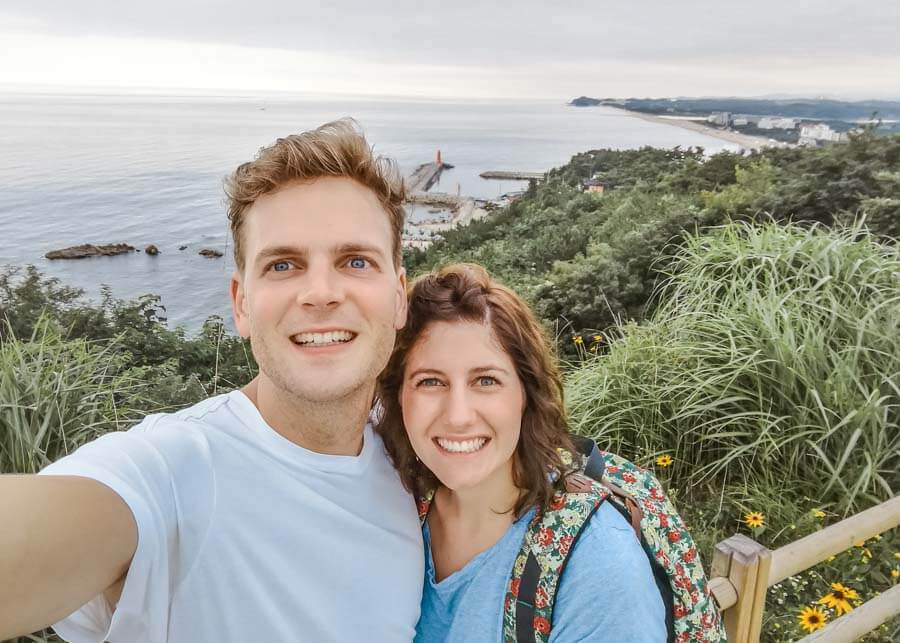
Day 14: The Last Day of Your South Korea Itinerary
Can you believe your two weeks in South Korea is over?
If you’ve followed this South Korea itinerary, you will have eaten your heart out, walked enough miles to justify another vacation, and experienced the best of Korea, from the people to the culture.
Depending on when your flight departs, you may have some time to squeeze in a few more activities in Seoul!
- Visit another themed cafe and get one last Insta-worthy pic
- Explore the Insadong neighborhood. It’s an artsy traditional neighborhood in Seoul where you can make a few last-minute purchases
- Take a stroll along the Cheonggyecheon Stream
Extra day in Korea: Jeonju
My South Korea itinerary highlights Seoul, Jeju, and Busan as must-visit places in Korea. I then recommend visiting either Gyeongju or Sokcho.
But there’s one more place you may want to consider: Jeonju.
Jeonju is a foodie’s delight and a charming city 3 hours south of Seoul.
Jeonju’s signature dish is Bibimbap, yet another one of my favorite Korean dishes!
Another major attraction in Jeonju is the well-preserved Jeonju Hanok Village which is arguably one of the most spectacular traditional villages in Korea.
Walk the streets, explore the traditional houses made from wood and slate, dress up in a traditional Hanbok, and observe the selfie-obsessed visitors.
You’ll need to spend a night in Jeonju, which is easily accessible on the KTZ train from Seoul. If you visit here, you’ll have to skip either Gyeongju or Sokcho.
How to get around for 2 weeks in Korea
The public transport in Korea is top-notch! It’s fast and efficient, and more importantly, it’s budget-friendly.
This South Korea travel itinerary covers all forms of transport, from trains to buses, flights, and even organized tour groups.
Thinking of joining organized tours? No need to!
If you’re on a budget or you’re a seasoned traveler, you may opt to avoid tour operators, and travel independently. This is possible if you have 3 weeks, giving you more time to travel slowly.
But with only 2 weeks in South Korea, your time is limited, you may want to consider a few day tours.
I personally used Trazy and Klook , depending on their tour availability. Both are reputable companies and offer awesome day trip itineraries to several leading attractions at affordable prices.
Their guides speak English (but there are also Chinese-speaking options if you prefer), and they take the hassle out of trying to navigate around areas that are more difficult to reach via public transport.
The bonus – most tours offer massively discounted rates to foreigners!
Read reviews and compare tours on Klook | Trazy.
Budget for 2 weeks in Korea
Korea is more expensive than other countries in Asia. But there’s plenty to do and see, even if you’re on a budget.
Here are my estimated daily costs for your South Korea itinerary.
- Accommodation: $40 per night (Budget, private room for 2 people). $100 per night (mid-range, private room in a hotel for 2 people) .
- Food (lunch & dinner): $20 per day. This will include a mix of street food and local restaurant food for 1 person. If you’re only eating at Western restaurants, you’ll need to fork out at least $60 per person per day for food.
- Organized day tours: $50 – $110 per person per tour (I’d recommend only going on 2 organized tours during your time).
- Public transport between cities: $10 – $30 per person. The trains and buses in the cities are cheap!
- Drinking: Soju and beer are the local favorite and they’re cheap compared to wine and spirits.
If you’re traveling on a budget, you can get by with $100 per day for 2 people ($50 per person per day). This excludes international flights.
If you follow my itinerary for Korea and travel mostly with public transport, $50 per person per day should be okay.
But if you want to hire a car, go on organized tours in every city, and eat at nicer restaurants (or go out drinking and parting), you could look at double that budget.
READ MORE: 20+ THINGS I LOVE ABOUT SOUTH KOREA
Bucket list for your itinerary for Korea
Before I arrived in South Korea, I hadn’t done much research!
Luckily, I had 14 months to figure my way around. If you’re following this itinerary, you will only have 14 days in Korea.
Here’s what not to miss if you’re planning a long-term or short vacation to South Korea!
- Get naked at a Korean Jimjilbang (bathhouse)
- Eat all the food: Kimchi, Korean BBQ, Dakgalbi, Bibimbap and Tteokbokkie
- Sing your heart out at a Noraebang (Karaoke rooms)
- Go hiking and watch in awe as you see how committed Koreans are to their outdoor activities
- Listen to K-pop music
- Visit a themed cafe: There’s everything from poop cafe’s to 3D cafes and even flower cafes
- Your itinerary for Korea must include visits to at least one temple and also a palace
- Drink Soju (and Somaek which is a mixture of Soju and beer)
FAQS for your trip to South Korea
How many days is enough for south korea.
You’ll need 2 weeks in South Korea. This is enough time to visit 3 cities which will give you a great taste of the country and its unique culture. If you have less time, you’ll miss out on so much.
Is Jeju or Busan better?
Both Jeju and Busan are unique in their own ways, but if I had to choose between the two, I would say that Jeju is better than Busan. The island is an outdoor paradise with volcanic formations, incredible caves, and stunning beaches.
Which month is best to visit South Korea?
The best time to visit South Korea is during the spring time, which is between March and May. However, March can be quite cold and extremely busy due to the Cherry Blossom season. If you’re looking for the best month to visit Korea, I recommend planning your itinerary for May.
Is South Korea expensive for tourists?
This depends on what type of traveler you are. If you’re happy to eat local food, catch public transport, and stay in mid-range accommodation, then you’ll find South Korea relatively affordable. But if you’re going out often, staying in luxury hotels, and taking tours, it can be very expensive.
READ MORE: GUIDE TO BORYEONG MUD FESTIVAL IN KOREA
Final thoughts on your Korea Itinerary
South Korea surprised me in every way. The year I spent teaching English in the country taught me so much.
It wasn’t just the travel aspect, but also what we learn through our travels – how we begin to understand different cultures and open our minds to a different way of life.
I’m already planning my next trip, which will include numerous visits to Korean Jimjilbangs, an overload of Kimchi and Toekbokkie, and lots of K-pop!
If you’ve followed my South Korea itinerary, you’re guaranteed to leave feeling the same way I do. With happiness in your heart, fond memories, and a full, satisfied stomach!
Have you traveled to Seoul, Jeju or Busan? What destinations would you recommend for the perfect itinerary for Korea? Let me know in the comments section below!
Looking for more Korea travel inspiration? Check out my other posts!
- Where to see Cherry Blossoms in Seoul
- 24 Strange Things About Life in Korea
- Getting Lasek or Lasik in South Korea
- 19 Things You Need to Know Before Moving to Korea
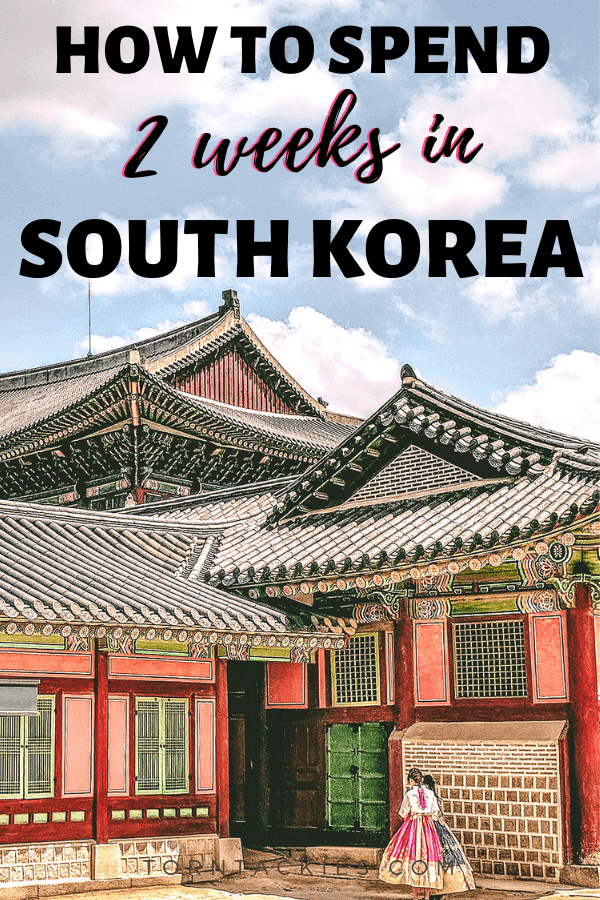
Hi, I'm Carryn. I’m an adventure travel blogger trying to figure out my way through life by traveling and exploring. Join me as I share my travel guides and tips for life abroad. Find out more about me here .
The Coogee to Bondi Walk: The Ultimate Guide to the Bondi Coastal Walk
Porters pass and colliers causeway: best hike in the blue mountains, 16 thoughts on “the best south korea itinerary for 2 weeks [insider’s guide]”.
Hello, I’ve been thinking about going to South Korea and came across your itinerary and was really fascinated by the places that you mentioned, such as Bukhansan Mountain and Jeju Island. Can you give me an approximate estimation, without the value of the plane ticket, of how much this itinerary would cost for two budget-friendly people? Thank you very much Carryn. Best regards.
Hi Ana, Korea sure is a fascinating place! It is more expensive than in other countries in Asia but there’s plenty to do and see, even if you’re on a budget. Here are my estimated daily costs for budget travelers visiting South Korea.
– Accommodation: $40 per night (Private room for 2 people) – Meals (lunch & dinner): $40 per day. A mix of street food and restaurant food for 2 people – Organized day tours: $50-$110 per person per tour (I’d recommend only going on 2 organized tours during your time) – Public transport between cities: $10-$30 per person
If you’re traveling on a budget, you get by with a total of $100 per day for 2 people which excludes international flights ($50 per person per day). There are many free things to do in Korea and if you follow my itinerary and travel mostly with public transport, $50 per person per day should be ok. But if you want to hire a car, go on organized tours in every city, and eat at nicer restaurants (or go out drinking and parting) you could look at double the budget. Hope that helps
Hi Carryn, Thanks for the great guide! Your pics are gorgeous.
I have a 2 week trip to South Korea planned in November and my flights arrive and depart from Incheon Airport. I was wondering in what order you’d recommend going around the cities? I was thinking of doing Seoul > Busan > Jeju > Seoul but I see that you’ve put Jeju first – is there a reason for that?
Thanks and really appreciate this amazing itinerary!
Hi Patricia, I planned my Korea itinerary in the reverse order that you mentioned above. (I started in Jeju and ended in Seoul). But it doesn’t really matter where you start or end – it’s individual preferences. From my experience, Seoul is an amazing city and was the highlight of my trip. If you start with Seoul, you might be slightly disappointed in the other areas because they don’t match Seoul’s vibrant and exciting atmosphere. So by ending in Seoul, you’ll be saving the best for last. But either way, you should allow for at least 5 days in the capital. Let me know which route you decide and how it goes. Carryn
I’ll be visiting South Korea in August. I loved all your tips – thanks for sharing your itinerary! I’ve been doing some research and I was thinking of going to Jeonju too. However, you haven’t included in your itinerary. Is there any reason for that? Have you been there? Is it worth visiting?
Thank you very much, Aura
Hi Aura, thanks for reaching out. Yes, I did spend time in Jeonju and while there are a few attractions (the Hanok village and the food scene), it isn’t a bucket list city and wasn’t a highlight for me. How much time do you have? If you have more than 3 weeks, then perhaps you could visit Jeonju, but with only 2 weeks in Korea, I would give it a skip. If you have a few extra days after visiting Jeju, Seoul, and Busan, rather explore Sokcho and Seoraksan National Park (if you enjoy the outdoors) but if it’s cultural attractions you’re looking for, Gyeongju is also a fascinating city. Hope that helps with your travel planning. All the best, Carryn
A mom in my mom group posted your link. I just finished reading your travel guide and tips and it’s just so incredible! I’m planning to visit Korea this summer. Your post has inspired me and took away alot of concerns and worries that I had in my thoughts. Thank you much for writing about your tours and listing all the places to go, stay, visit and experience. This is a truly special post and I feel the love you have for Korea! Cheers fellow traveler!!!💛
Hi Sonja, thanks so much for taking the time to share this feedback. Means the world to me! Have an awesome time in South Korea.
Hey, One of the best itineraries I’ve seen !Thanks 🙂 for any of the places on this list do you need vaccines such as Japanese encephalitis or typhoid if visiting in August?
Hi Gab, I didn’t have any of those vaccinations for Korea – and I lived there for over a year. I recommend consulting a travel doctor to confirm whether you need or not. Enjoy Korea!
Hi, I read your posts (several of them) with pleasure and interest, and i think it will be very helpfull during my stay in Korea. i’m planning to visit Korea very soon and I’m wandering if you know if in hotels can pay with cash or only card ( i’m planning only stays in hotels)? And one more think. You wrote about budget. Is 1000-1500 usd enough? I have my doubts about this. I’ll try to travel to Seul, Busan, Gyeongju, Suwon, Yongin, Gayasan and Jeju of course. And have only 10 days:/. Only in Seul, Busan and Jeju i intend to stay in hotel.
Hi Tom, cash payments are accepted in most places in Korea. However, due to hygiene reasons, some businesses may prefer card payments as it is contactless. Yes, a budget of of $1000-$1500 USD is more than enough for 10 days in South Korea (this is excluding your international return flights). That gives you about $150 USD per day which will cover the costs of a nice hotel ($50 per day), food ($40 per day) and activities/travel costs ($60 per day). This is assuming your total budget is for one person. If you are backpacking or wanting to travel on a budget, you can get by with $60 per day. And if you’re more of a luxury traveler and are planning on eating at fancy restaurants and doing lots of shopping, you will need more than $150 per day. Hope that helps. Enjoy your time in Korea. Carryn
Thank You Carryn. Now i know where i stand.
One more thing. Is it possible to pay for a ticket to Jeju online or only at airport? I worry that all tickets will sold out soon And cannot buy on jejuair.net.
Hi Tom, I purchased my flights online a few weeks before as this is where I found the best price and my preferable time. You can also try T’Way Air and Asiana. There are so many flights every single day so I have no doubt you’ll be able to purchase one at the airport. But remember there are two airports in Seoul from where you can fly to Jeju (but most flights are from Gimpo International Airport).
Leave a Comment Cancel reply
We Are Travel Girls
A Community Created To Inspire, Connect, Educate & Empower Female Travelers
ASIA , SEOUL , SOUTH KOREA · March 5, 2019 Last Updated on March 14, 2024
SOUTH KOREA ONE WEEK ITINERARY
This post may contain affiliate links. As an Amazon Associate I earn from qualifying purchases. We may receive a small commission when you make a purchase using our link.
I never thought that my full-time travel journey around the world will take me to South Korea but I am so glad it did. I discovered a fascinating country, a country that I was about to fall in love with forever.
In this one week itinerary I’m excited to share with you what makes South Korea such an amazing destination!
Exploring South Korea: 7 Day Itinerary
South Korea is an organized and intriguing country that has many incredible tourist attractions, and it will surprise you at every step.
From live K-pop performances to jaw-dropping temples and beautiful palaces, South Korea has it all.
It’s a country where the old and new are intertwined. It’s a country of contrasts but this is what makes it so captivating.
If you are planning to spend one week in South Korea, you are in the right place.
This country has a lot to offer in terms of tourist attractions and it might be hard to choose but I am here to help you.
After traveling across the country from north to south, I know which places are worth visiting and which are not.]
In this South Korea one week itinerary I’m including only the best places, the ones that will leave you in a state of awe.
Is One Week In South Korea Enough?
One week is always too little to explore an entire country, but you can definitely see the highlights.
Our first stop on our itinerary will be in Seoul . Although most of it was destroyed by the Korean War, a few historical buildings still remain.
Be prepared to see historical buildings surrounded by skyscrapers, cool tourist attractions and experience the incredible nightlife. This fashion and the technology-forward city has something for everyone.
After four days in Seoul, we will continue our itinerary and we’ll stop in Busan for another three days.
Busan is more laid-back, everything happens at a slower pace here.
After experiencing the hustle & bustle of Seoul, you’ll feel more relaxed in Busan. With a colorful village, an incredible fish market and beautiful temples, Busan will reveal to you the other side of South Korea.
Let’s begin our journey!
South Korea Itinerary: Seoul – 4 Days
Below are the most important tourist attractions in Seoul, the ones I recommend visiting. From breathtaking panoramic views, shopping opportunities, history and culture, this itinerary covers it all.
Take A Trip To The North Korean Border
One of the most famous borders in the world is the one between South Korea and North Korea, and the good news is that it can be visited! Apart from being a valuable history lesson, a trip to this border will get you pretty close to North Korea.
From the Dora Observatory , you can actually see a North Korean village. For those who have no plans of visiting North Korea (which is most of us), this is an incredible opportunity to see a glimpse of one of the most secretive countries in the world!
There are two kinds of trips to the demilitarized zone, commonly known as the DMZ. One trip takes half of the day and the other takes a full day.
Depending on how much time you want to spend at this famous border, you can choose either of them but if you want to visit the place where the North and South Korean soldiers stand face to face, you will have to choose the full-day trip.
- South Korea Demilitarized Zone Half & Full Day Tour
- From Seoul: Half-Day Demilitarized Zone (DMZ) Tour
- DMZ Half- or Full-Day Trip
Good to know: Make sure to book your tickets well in advance. They sell out quickly.
Namsan Seoul Tower Views
The Namsan Seoul Tower is the place that offers some of the best views over Seoul. It has several free viewing platforms, restaurants and a few museums, but the best view you can get is from the observatory on top of the tower.
The best time to visit is at sunset or during the night. Seeing how the night takes over the city is a truly unique experience.
Subscribe to get our FREE eBook with tips on saving money when you travel!
Hongdae Neighborhood
Hongdae is the heart and soul of Seoul. Hundreds of cafes, clubs, gaming centers and live performances are waiting for you. This hip place is full of youngsters in search of fun.
Make sure to try the 34-cm tall ice cream, go karaoke, admire the K-pop performers and eat some local Korean street food .
Hongdae is the perfect place to spend the evening. If you want to unleash your party animal, try one of the clubs. There are plenty to choose from!
Visit A Royal Palace
There are five royal palaces in Seoul but visiting all of them would take a lot of time. This is why in this itinerary I recommend visiting the Gyeongbokgung Palace , the biggest and most impressive out of all the palaces.
Get your camera ready and explore the courtyards and admire its beautiful architecture. While at the palace, you’ll notice that some of the locals and tourists alike are dressed in beautiful traditional Korean dresses which takes me to my next point.
For more information on the best palaces and things to do, be sure to read our Ultimate City Guide to Seoul !
Palace Tours
Gyeongbokgung Palace History Walk
Wear A Hanbok
There is no better way to immerse yourself in the local culture than renting a hanbok for a few hours. Apart from being stunningly beautiful, renting a hanbok is an unforgettable experience.
A lady will help you choose the design and get dressed and after that, she will accessorize your hair with traditional headbands and floral pieces. After you’re ready, head outside and take some photos. You’ll notice that both locals and foreigners love wearing hanboks.
Good to know: The entrance to the palaces is free if you are wearing a hanbok.
Our Top Places To Stay In Seoul, South Korea:
- Airbnbs in Seoul
- Lotte Hotel Seoul
- JW Marriott Hotel Seoul
Explore Bukchon Hanok Village
One of the most visited tourist attractions in Seoul and the preferred location for photo shoots is the Bukchon Hanok Village . This traditional village with traditional homes is a glimpse into Seoul’s past.
There is no entrance fee to this village so you can wander around and admire it as long as you want. Keep in mind that locals live here so don’t make too much noise!
Step Into The Future At Seoullo 7017
This former highway transformed into a pedestrian walkway feels like you’re stepping into the future. Made out of glass and hosting more than 24,000 plants and trees, Seoullo 7017 is perfect for a short walk.
You can admire the skyline or sit for a few minutes and watch the traffic below you. Either way, Seoullo 7017 is one of those places that you have to visit in Seoul.
Admire Jogyesa Temple
Be prepared for a splash of color at Jogyesa Temple in Seoul. Full of flowers and with incredible architecture, this temple is my favorite from entire South Korea.
While walking around the temple, stop for a few minutes to admire the intricate paintings and sculptures covering the temple. It is truly a unique sight!
Visiting a Korean temple is always a good idea if you want to learn more about the local culture and be closer to locals’ daily life.
Explore Gangnam Neighborhood
Does “Oppa Gangnam Style” sound familiar to you? Well, the song is about one of the neighborhoods of Seoul – Gangnam.
Gangnam is an area full of trendy shops, cool cafes and shopping opportunities. It’s the place where the youth meets and has fun. Here you’ll really feel Seoul’s vibe.
While you’re in the area, don’t forget to visit the Gangnam Style Horse Dance Stage right at the exit of Gangnam metro station. You can take a funny photo here while doing the famous dance.
Visit A Local Market – Namdaemun Market
Namdaemun Market is the biggest traditional market in South Korea and it was opened in 1964. Whatever you’re searching for, you’ll find it here.
There are over 10,000 shops selling souvenirs, clothes, electronics, fruits & vegetables and street food at affordable prices. Be prepared to leave a few bucks behind. I ended up buying souvenirs for the entire family and some delicious street food.
Go Shopping On Insadong Street
Another popular place for shopping on our itinerary is Insadong Street. The prices here are a little bit higher but you’ll find some unique items.
If you’re passionate about art, here you will find paintings, sculptures and local handicrafts. Also, there are many restaurants to choose from both local and international cuisine.
Get Artistic At Dongdaemun Design Plaza (DDP)
If you’re truly passionate about modern and contemporary architecture and art, you must visit the Dongdaemun Design Plaza (DDP) in Seoul.
This building is a wonder of architecture. With its round shapes and metal look, this place houses fashion shows, exhibitions, live performances and almost anything related to art.
Dongdaemun Design Plaza attracts quite a fashionable crowd, in search of the latest trends around the world.
South Korea Itinerary: Busan – 3 Days
After so much visiting and traffic in Seoul, it’s time to take a break and relax in a beautiful city by the sea.
Take the train for a few hours and make your way through dense forest, breathtaking mountains and thousands of greenhouses to Busan .
It is the perfect choice for a few days of unwinding. Eat some fish delicacies, explore the colorful Gamcheon or visit its beautiful temples.
Eat At Busan Fish Market
Nothing can prepare you for a visit to the Busan Fish Market . Walking through the stalls feels like a visit to the aquarium.
You will see almost every species of edible sea creatures displayed on thousands of stalls, waiting to find their customers. Some small, some wide, some colorful, the fish sit beautifully displayed alongside vegetables.
If you want, you can even go to one of the restaurants and try the seafood. There is so much to choose from and everything is delicious.
The Busan Fish Market is the biggest in South Korea and I can swear that the fish there could feed an entire city.
Explore The Colorful Gamcheon Culture Village
Thousands of colorful houses, built on terraces wait for you at Gamcheon Culture Village , Busan. This village is full of street art and art pieces, scattered along the streets and alleys.
It is a delight to discover it and uncover its secrets. If you want, you can buy a map from the Tourist Information Center, collect all the stamps while exploring Gamcheon and, as a reward, you’ll receive some beautiful postcards.
Also, if you’re in the area, don’t forget to try the raindrop cake. It looks like a drop of water and it’s delicious!
Visit Haedong Yonggungsa Temple
One of the only temples situated by the sea in South Korea is the Haedong Yonggungsa Temple . Its beauty cannot pass unnoticed.
This scenic spot is one of the main attractions of Busan and is visited by both locals and foreigners. With dozens of shrines, statues and stupas, this temple offers some incredible views towards the sea.
Shopping On Gwangbokro Cultural & Fashion Street
With well-known international brands and local brands alike, this shopping street is perfect for those in search of cool clothing and shoes.
You will find pretty much anything here but the prices aren’t the most affordable. Be prepared to splurge a bit but let me say something – You deserve it!
Go To The Beach
Busan is famous for its beautiful beaches and for good reason. The beaches are wide, super-clean, the water is perfect for swimming and the nearby skyscrapers make Busan look like a movie scene from Miami.
Take your beach towel, sunglasses and slippers and enjoy the sun for a few hours.
Admire The View From Yeongdodaegyo Bridge
Probably one of the best spots to admire the city is the Yeongdodaegyo Bridge. Stop for a few minutes and see how the fishing boats return to the Fish Market or how big ships pass underneath the bridge.
If you look towards the hills you’ll even notice the colorful houses of Gamcheon Culture Village. The view is truly spectacular!
South Korea In One Week Wrap Up
Both Seoul and Busan are beautiful, intriguing cities with a lot to offer in terms of tourist attractions.
Spending one week in South Korea is enough to uncover the secrets of both of these cities by following this itinerary. While visiting them, you’ll discover the fast-paced life of Seoul and the laid-back vibe of Busan. Enjoy!
We hope that this article has inspired you to take a trip to South Korea. If you have any questions about the destination or have your own travel tips to share please leave these in the comments below.
Want to share your own travel tips by guest writing for We Are Travel Girls? Go to our Contribute page for guidelines and to submit your article.
Pay Less, Travel More
Subscribe to get access to our FREE eBook with tips for saving money when you travel!
- Airbnbs in Seoul, South Korea
- Find the best price on hotels in Seoul, South Korea
- Sign up to AirBnB with this link and receive a US $35 off your first booking
Read More About South Korea
- The Ultimate Seoul City Guide
- Vegetarian Food To Try In South Korea
- 7 Incredible Places To Photograph Busan, South Korea
- 6 Free Things To Do In Seoul
- 8 Reasons To Visit Jeju-Do On A Budget
We Are Travel Girls Contributor Aurelia Teslaru of DailyTravelPill.com Connect with Aurelia Instagram | Pinterest | Facebook | YouTube
Pin For Later
This website is a free resource and to keep it free for our readers we may use affiliate links in our articles. If you make a purchase via the links on our site you will pay the same price, but we may receive a small percentage which helps us to keep bringing you new and informative travel content every day! Any products we endorse we personally use and love. Please see our Disclosures for more information.
You’ll Also Love
March 5, 2019 at 6:36 am
I’m headed to South Korea next month so this was a very informative and helpful read! Made me get even more excited and I definitely added some of these suggestions to my list. Thank you for sharing!
Brian Bailey says
March 11, 2019 at 4:35 pm
Heading to South Korea from China in a couple of weeks. Will start in Seoul but can not decide between Busan and Jeju Island – only have 6 days – might try to squeeze them all in. This page was very useful in planning my trip – thanks!
Travelling Tam says
March 22, 2019 at 4:07 pm
I have read this about 3 times. So useful. Heading there in June, cant wait!
Debbie says
December 8, 2019 at 10:46 am
How was your trip ? I’m planning to gon next year
Cecilia says
November 17, 2021 at 2:06 pm
Hello, can we go together in group.. I’m planning to go next year tooo… let me know what you think?
April 8, 2019 at 8:55 am
My daughter and I are going to South Korea next month and we are so excited. This article and itinerary are very informative and helpful. We are visiting Seoul, Busan and Jeju.
June 10, 2019 at 8:13 am
South Korea is such an amazing travel destination for me. I have been there for a couple of time.
I loved your honest and resourceful travel guide, photos are mind-blowing.
oshin lawrence says
October 19, 2023 at 5:34 pm
Leave a Reply Cancel reply
Your email address will not be published. Required fields are marked *
Notify me of follow-up comments by email.
Notify me of new posts by email.
- Travel Girls Getaways
- DESTINATIONS
- TYPE OF TRAVEL
- TRAVEL RESOURCES
- AMBASSADOR PROGRAM
- TRAVEL GIRLS GIVING
Get Access To The Travel Resources Library
Subscribe to receive free access!
- Work With Us
- TESTIMONIALS
- DISCLOSURES
- TERMS OF SERVICE
- PRIVACY POLICY
- ACCESSIBILITY
COPYRIGHT © 2023 WE ARE TRAVEL GIRLS
Exclusive Member of Mediavine Travel
- Work with me
- Privacy policy

- Years in review
- United Kingdom
- Bosnia & Herzegovina
- North Macedonia
- Philippines
- South Korea
- South Africa
- Africa Overlanding
- Central America
- New Zealand
- Solo Travel
- Budget travel
- Travel tips
- Travel itineraries
- Hidden gems
- Bucket list
- Travel resources
- Digital nomadism
- Blogging tips
- Start a travel blog
Perfect South Korea Itinerary For 2 Weeks: Best Stops + Tips!
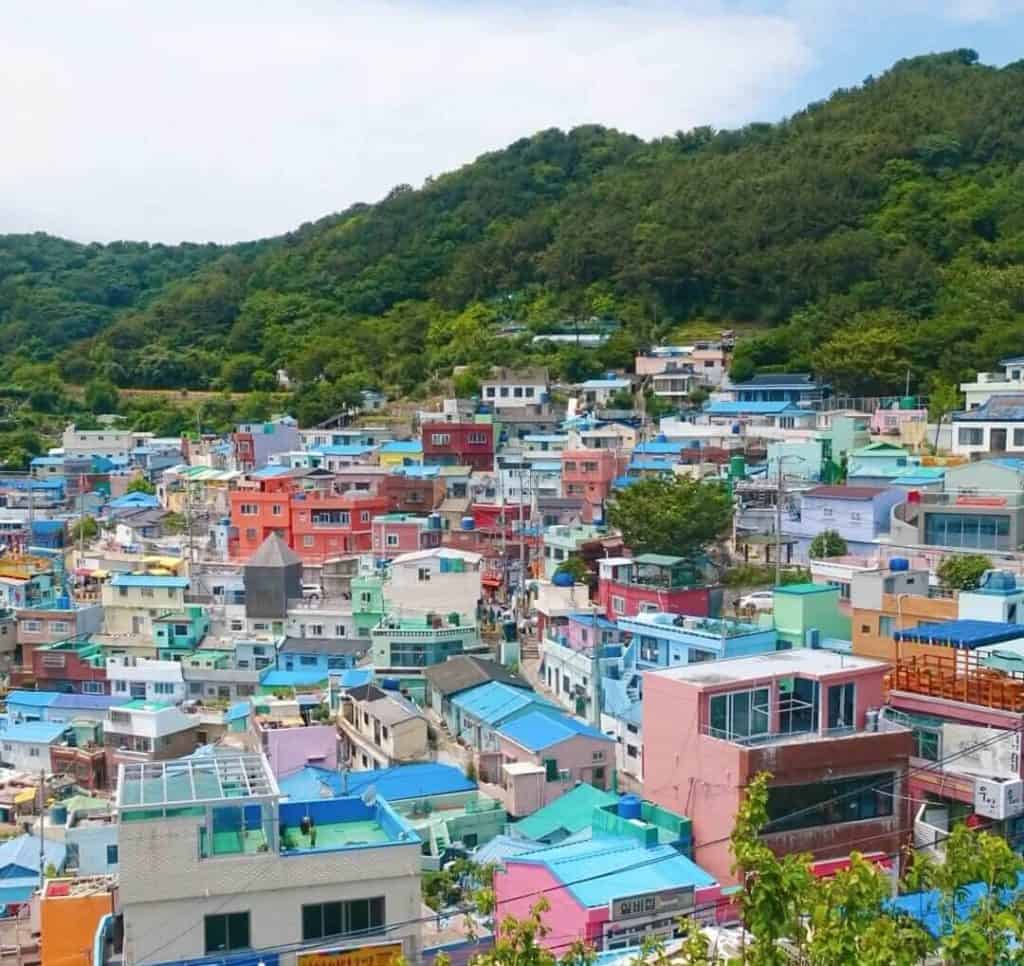
Table of Contents
This post may contain affiliate links to things like tours, hotels, Amazon associates and products. These help me earn a small commission at no additional charge to you.
Hey, stranger! Planning to spend 2 weeks in South Korea? I got you! This South Korea itinerary lets you soak up the culture, see the sights, do some hiking and relax on the beach.
Psst – don’t miss a thing during your trip thanks to my 40 South Korea bucket list items!
I recently followed the below South Korea travel itinerary so you can rest assured it’s tried and tested. I made all the travel mistakes so you don’t have to. What else are blogs for, right?
SOUTH KOREA ESSENTIALS Accommodation: Booking.com / Hostelworld Activities: GetYourGuide Getting there: air ( Skyscanner ) Getting around: Train ( Trip.com ) / bus Pre-book a Tmoney transport card Pre-book private airport to hotel transfer Stay connected: SIM card / portable WI-Fi Travel insurance: True Traveller (European travellers) / Hey Mundo (other nationalities) / Safety Wing (digital nomads)
What kind of South Korea itinerary is this?
The itineraries below are relatively fast-paced . You’ll see 4 places during 2 weeks in South Korea or 7 places during 3 weeks in South Korea. But you’ll still have a good few days in each place to soak up the culture (and devour copious bowls of bibimbap, naturally). If you want to see a new place each day and whiz around fast, this might not be the 2 week South Korea itinerary for you. I’m an advocate of slow travel but I appreciate you want to see a lot during 2 or 3 weeks in South Korea so I’ve aimed for a middle ground.
Check out my other 2 week Asia itineraries to Taiwan , Malaysia , Bali and Vietnam .
How long do you need in South Korea?
I believe 14 days in South Korea is enough to see it properly, providing you pick just a few places of interest. This will allow you to explore two major cities, Jeju Island and another destination of your choosing. Of course, the more time, the better!
Read next: 30 Korea travel tips
Internet & SIM cards in South Korea
There’s good Wi-Fi in South Korea, from hotels to cafes and even in the subway stations. However, when you’re out and about, you may want to stay connected by using a SIM card. I found out the hard way that tourists can only purchase SIM cards at the airport. Shops and market stands rarely sell them to travellers without a Korean residency card. I’d recommend being organised and ordering one in advance. Book your UNLIMITED 4g SIM to collect at Seoul airport or upgrade to include a Tmoney transport card . Alternatively, rent a pocket Wi-Fi device and return it at the airport when you leave. If you’re taking a big trip, it might be worth buying your own mobile Wi-Fi hotspot to bring with you.
Read next: 101 Asia backpacking tips
How to get around South Korea
The train and bus are both quick and efficient which saves valuable time during a South Korea itinerary. Trains can be booked on Trip.com , partner of Korail (the official railway network of Korea). Click the three stripes in the top right corner then the flag to change it to English. Buses are notoriously hard to book online for foreigners so it’s recommended to just turn up. I did this and always got a seat.
It’s also possible to fly between Korean cities although I chose not to for environmental reasons. However, you’ll need to fly when visiting Jeju Island. I use Skyscanner to find the best deals on flights.
Read next: all my South Korea travel tips
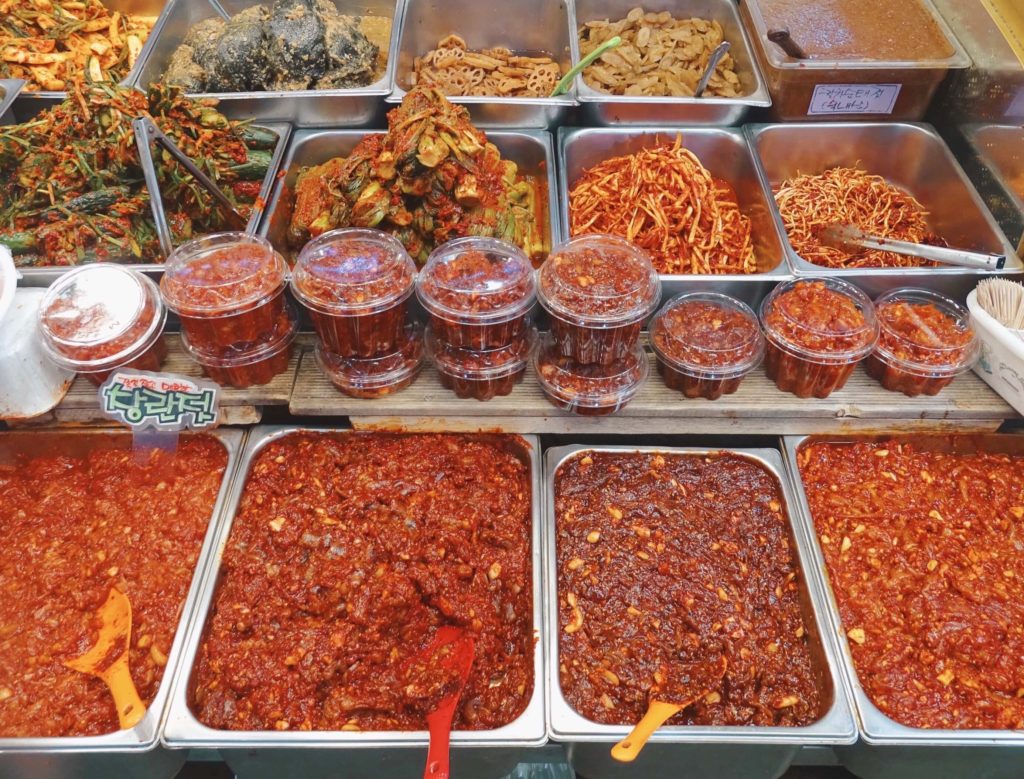
Getting from Seoul airports to the city
Getting from Incheon International Airport to Seoul: the international airport where you’ll probably be arriving is connected to Seoul Station by the AREX Express train (from T1 and T2 direct to Seoul Station), the All Stop Train (from T2, making 13 subway stops to Seoul Station). Finally, the Incheon Airport Bus costs 15,000 won and taxis start from 3,800 won. Getting from Gimpo Airport (domestic flights) to Seoul: a taxi on the metre should cost 15,000 won; the AREX All Stop train takes 20 minutes and costs 1,450 won, and the 6021 bus costs 7,000 won and takes 45 minutes.
From either airport, you can pre-book private airport to hotel transfer . The AREX Express train from Incheon Airport is included in the Discover Seoul Pass .
Budget for 2 weeks in South Korea
Korea is much more expensive than countries like Vietnam and Thailand but still cheaper than most Western countries. It’s a similar price to Japan. Here’s a quick summary of how much you can expect to spend during two weeks in South Korea:
Transport: A couple of my shorter journeys (i.e. Busan to Gyeongju and Daegu to Jeonju) cost just 5,000 KWR ($4 /£3.30) but the fast train between Jeonju and Seoul was more expensive at 30,000 KRW ($25 / £20). I could have saved money and caught a lengthy bus but for the most part, trains and buses are similar prices. Make sure to budget for flights to Jeju and back. They start at around 30,000 KRW each way. I use Skyscanner for flight booking. Accommodation: Beds in hostel dorms start at 22,000 KRW ($19 / £15) and private rooms cost around 32,000 KRW ($30 / £22). Hotels start at 45,000 KRW per night ($40 / £30). I suggest Hostelworld for finding hostels and Booking.com for hotels, homestays and apartments.
Read next: complete budget guide to South Korea
Street food: The good news is that you can eat during your South Korea trip for as little as 2,000 KRW ($1.50). It won’t be nutritious but it WILL be tasty. It’s worth noting most of the best street food markets are in Seoul and Busan; markets in smaller cities are more like wet markets selling fresh produce (which you can buy to make a healthy dinner if your accommodation has a kitchen). Restaurants: You’ll find meals from 5,000 KRW in modest restaurants. Bibimbap can be cheap as chips (and nicer). For more upmarket restaurants (and those in cool areas of Seoul), expect to pay up to 20,000 KRW a meal.
In total, 2 weeks in South Korea cost me 1,000,000 KRW ($830 / £620). This is a hostel & street food budget!
2 week South Korea itinerary overview
Days 1-5: Seoul . Explore Bukchon Hanok Village, Bukhansan National Park, Ihwa Mural Village, Gwangjang Market (amongst others), Insa-dong, Myeongdong, the DMZ, museums, Hongdae and Gangnam. Days 6-7: Sokcho for hiking in Seoraksan National Park (option for nature lovers and hikers) OR Jeonju (option for culture vultures and foodies). Days 8-10: Busan. Visit the Temple by the Sea (Haedong Yonggung), Haeundae Beach, Gamcheon Culture Village, Nampo district, Seomyeon district and hike Igidae Coastal Walk or Taejongdae Park. Days 11-14: Jeju Island. Discover the East, West and South coasts during different days. Got an extra week? Keep reading for my 3 week South Korea itinerary.
Days 1-5: Seoul
I’m assuming you’re starting your 2 weeks in South Korea in Seoul. If you’re beginning in Busan like I did, just reverse this route.
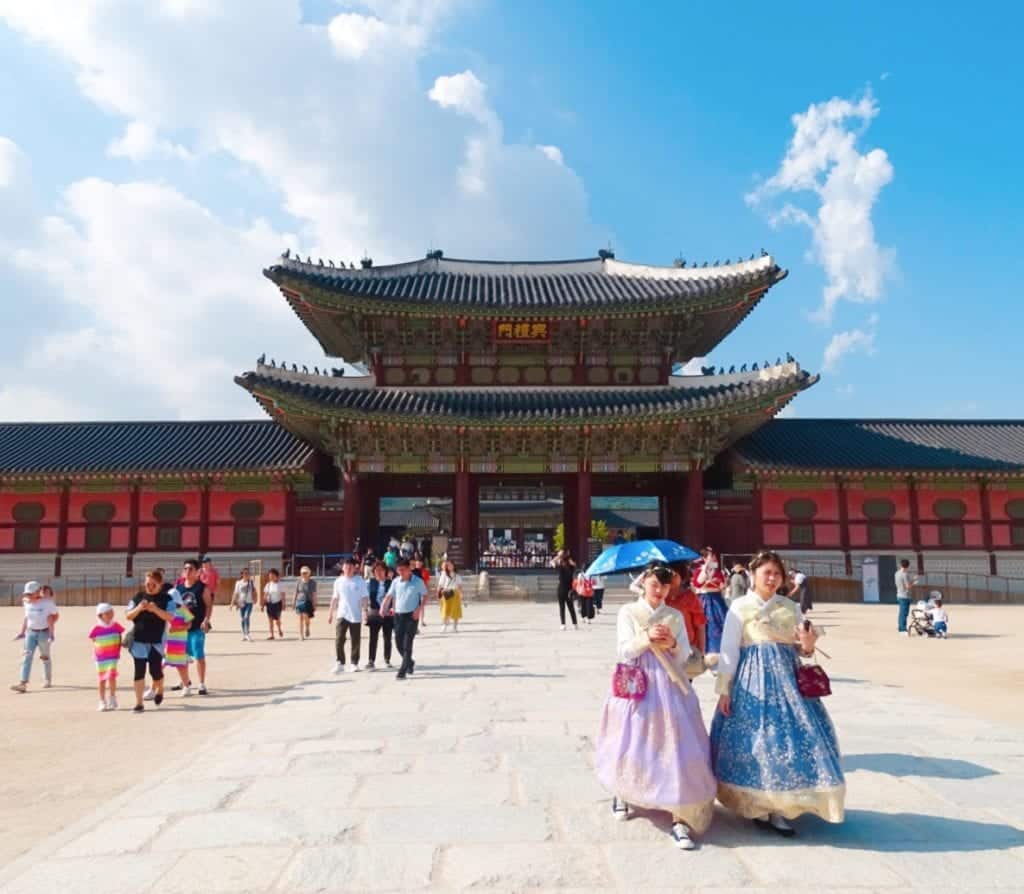
Seoul, South Korea travel tips:
- Collect your 4g SIM card or pocket Wi-Fi device at the airport
- Get a Tmoney transport card to save money and skip queues. Buy yours now or get it with a SIM card combo .
- Download an app like Navar since Google Maps doesn’t work properly
- Prebook your airport pick-up
Where to start with Seoul? After 2 years travelling around Asia , I felt at home in Seoul. Within days I’d decided it was my joint-favourite Asian city (tied with Hanoi ). It has everything: traditional palaces, informative museums, nature hikes, street art villages, quirky cafes, street food, fine dining, boutique shopping, crazy nightlife… The list goes on and on!
Read next: The ultimate 5 day Seoul itinerary
Is the Discover Seoul Pass worth it? From $37, you’ll get free entry to over 50 attractions and discounted entry to over 100 attractions AND a transport pass. I would say it’s worth it should you plan your time tactically and visit as many of the included attractions in the validity period. Research what’s included in the Discover Seoul Pass .
How to get around Seoul
For a huge city, Seoul is easy to navigate. The expansive Seoul subway has 20 lines with a map displayed in each station, but you can also download a Seoul subway mobile app (there are several to choose from). I also enjoyed travelling by bus because it’s nice to be above ground and see the city as you go. Although navigating a bus network in a city where you don’t speak the language may seem overwhelming, it’s not so bad: the journeys even show on Google Maps. You just need to pop your money in the box by the driver (so make sure you have the right change). The buses are priced according to colour so use this guide to bus travel in Seoul to work out what you need to pay.
Make sure to get a Tmoney transport card or a Discover Seoul Pass which acts like a travel card when valid!
Fun transport: the Yellow Bus Tour Seoul and the Seoul City Tour Bus are sightseeing buses for tourists, both included in the Discover Seoul Pass .
Day 1 – Bukchon Hanok Village OR Bukhansan National Park
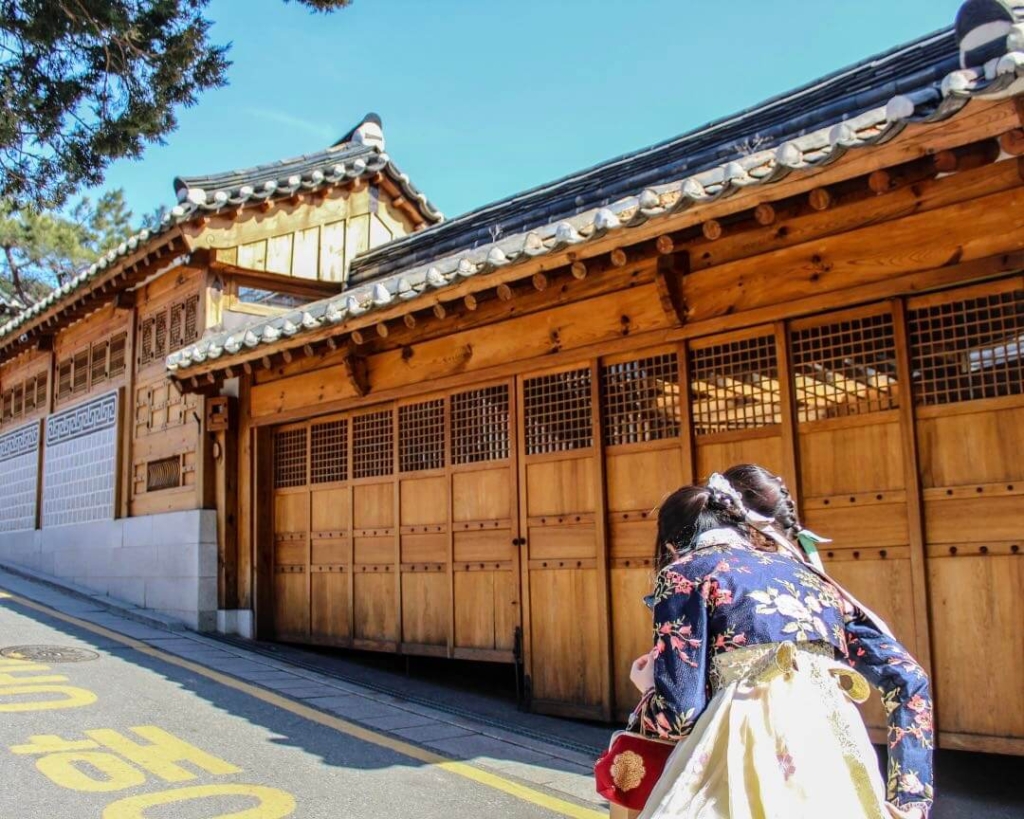
OPTION 1 – tour traditional architecture at Bukchon Hanok Village, preserved to reflect the architectural styles of the Joseon period (14th century-1897). Bukchon comprises a few hundred houses built, as all traditional hanoks were, facing north with water in front and a mountain behind. Bukchon retains all the charm of an ancient hanok village while offering visitors the chance to get immersed at cultural centres, cafes and tea houses. You can even stay overnight as many hanoks are now guesthouses. Take a 3-hour self-guided walk around Bukchon . Note that most attractions are closed Sundays . Getting to Bukchon Hanok Village: Take the subway to Anguk Station (Line 3), take Exit 3 and follow signs. Afternoon: After your morning culture dose, why not try walking Seoul City Walls? Hike along sections of this 18km wall constructed during the Joseon Dynasty overlooking spectacular city views. Better yet, it’s free! Naksan Mountain Trail is the easier trail (2km) and Baegak Mountain Trail is slightly longer (4.7km). The other great thing about Naksan Park is the wonderful sunset views from the top. DAY 1 , OPTION 2 – If you’re feeling energetic, a hike in Bukhansan National Park will certainly be a memorable addition to your trip. My favourite thing about Korea is how easy it is to jump on a city bus and arrive in nature.
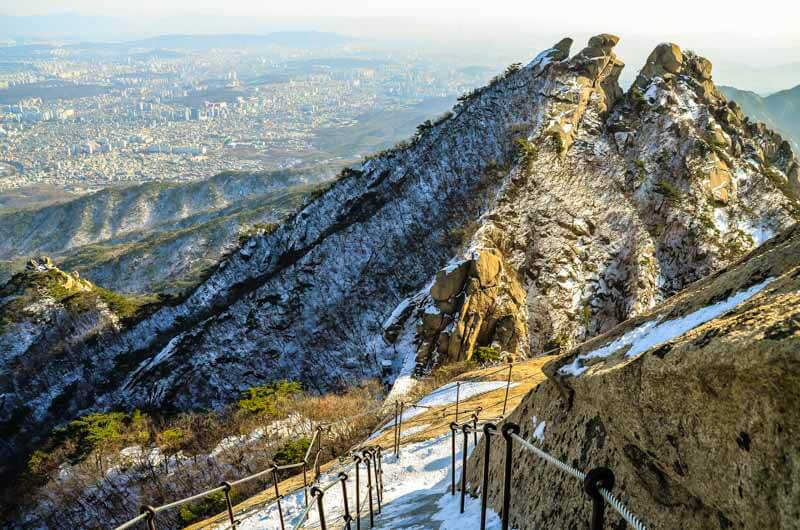
The Bukhansan Peak hike takes 4-5 hours (but you may wish to set aside 5-6 if you like to stop and take photos) but there are also other, more leisurely, trails in the park. If you’re a fan of the great outdoors, I have no doubt this will be a highlight of your South Korea trip itinerary. Getting to Bukhansan: Take subway Line 3 to Daehwa Station and board the 704 bus outside Exit 1. Get off at Bukhansanseong Fortress Entrance. Tips for Bukhansan : Hiking boots are preferable but comfy trainers will do. Make sure you have enough suncream, water and a hat in the summer, and rain gear in cooler months.
Related tour: since Bukhansan Peak can be a challenging climb, you may want to go with an expert guide who will provide you lunch, water and hotel pick-up. Book a day hiking tour .
DAY 1, OPTION 3: More about theme park adrenaline than the great outdoors? Spend the day at Lotte World instead. This theme park with water flumes, aquariums and the famous Lotte Tower observatory is a popular, modern attraction where you could easily spend a whole day, especially if travelling with kids.
Day 2 – Ihwa Mural Village, Gwangjang Market, Insa-dong & Myeongdong
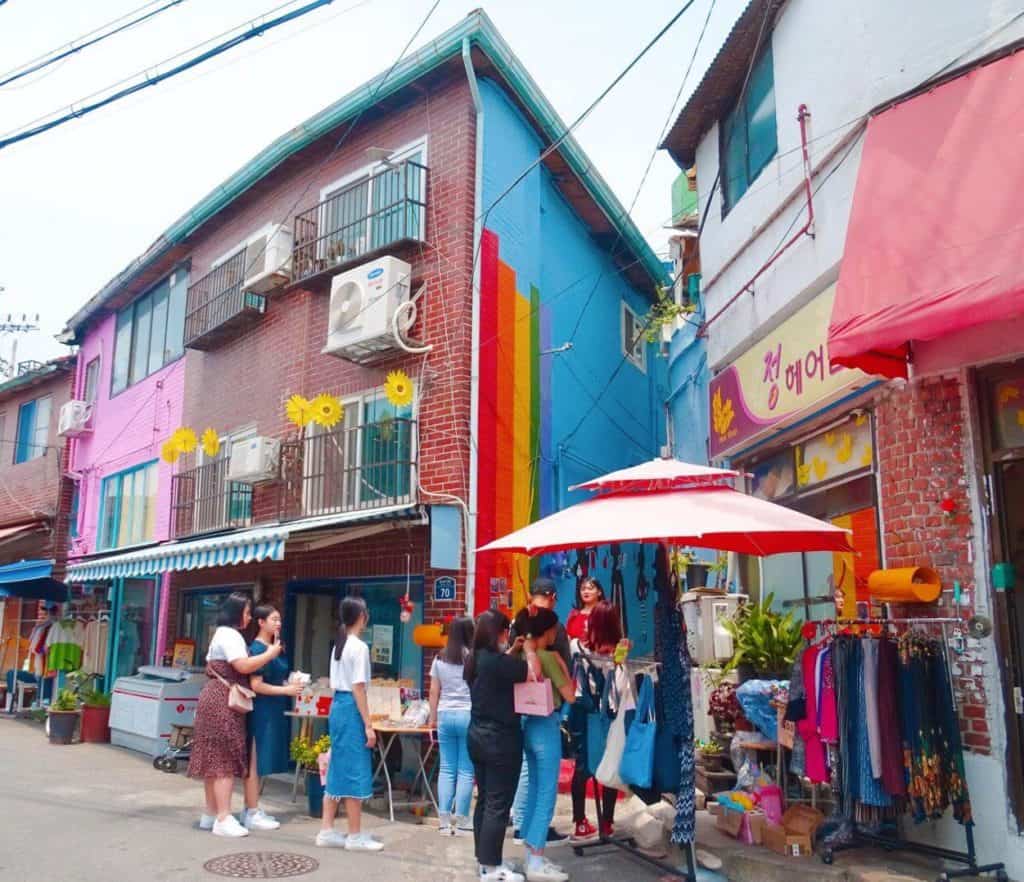
Morning: Fans of street art , or simply cool and colourful places, should pay a visit to Ihwa Mural Village . Like many mural villages in South Korea, this was once a rundown area that didn’t benefit from the flow of tourism to the city. The residents took fate into their own hands and gave their area a lick of paint… Or rather, thousands of licks of paint! Getting to Ihwa Mural Village: The nearest subway station is Hyehwa Station. Take Line 4 there and follow signs to exit 2. Tips for visiting Ihwa Mural Village: Wear comfy shoes and prepare for the steep steps leading to the village. Be respectful when taking photos: these are locals’ homes, not your selfie station!
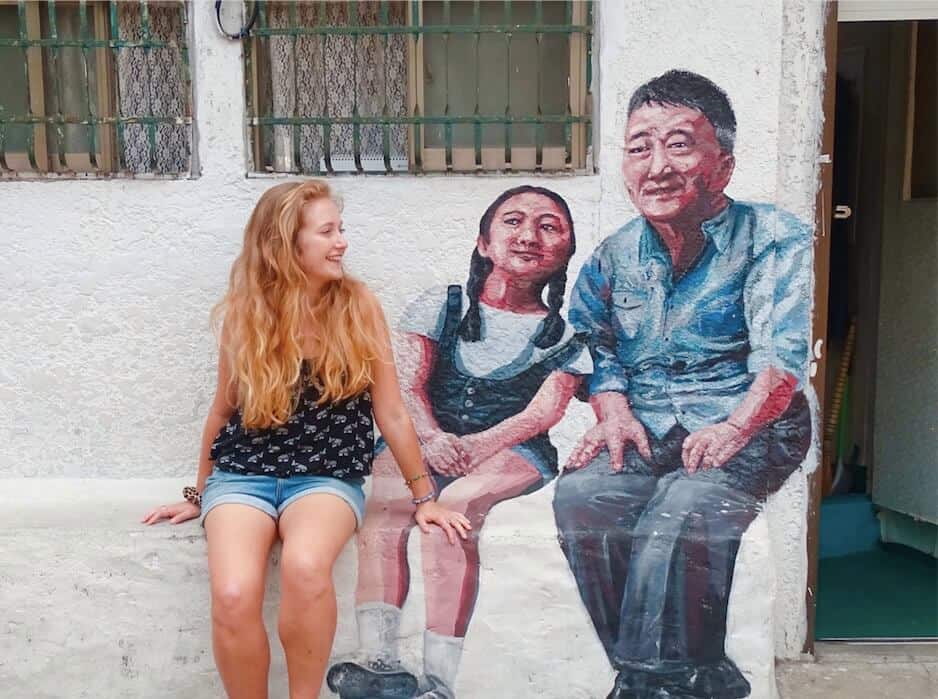
Gwangjang Market : For lunch, eat Seoul street food at this famous market not far from Ihwa Mural Village. Walk in 20 minutes or jump on a bus. Options include fried chicken, dumplings, bindae-tteok (mung bean pancakes) and more. If you’ve watched Netflix’s Street Food documentary, you may recognise chef, Cho Yonsoon, serving her famous knife-cut noodles. Eat them in soup with lashings of kimchi.
Afternoon: Journey to Seoul’s Insa-dong neighbourhood (just a 6-minute ride on subway Line 1 from Gwangjang Market), one of the oldest and most traditional neighbourhoods in Seoul (aside from Bukchon Hanok Village which you’ll have seen on day 1 of this Korea itinerary). Wander the traditional shops to get a feel for Insa-dong and sample flavoured tea and snacks at an authentic tea house. My favourite is Old Shin Tea House set inside a peaceful hanok. The plum tea is delicious.
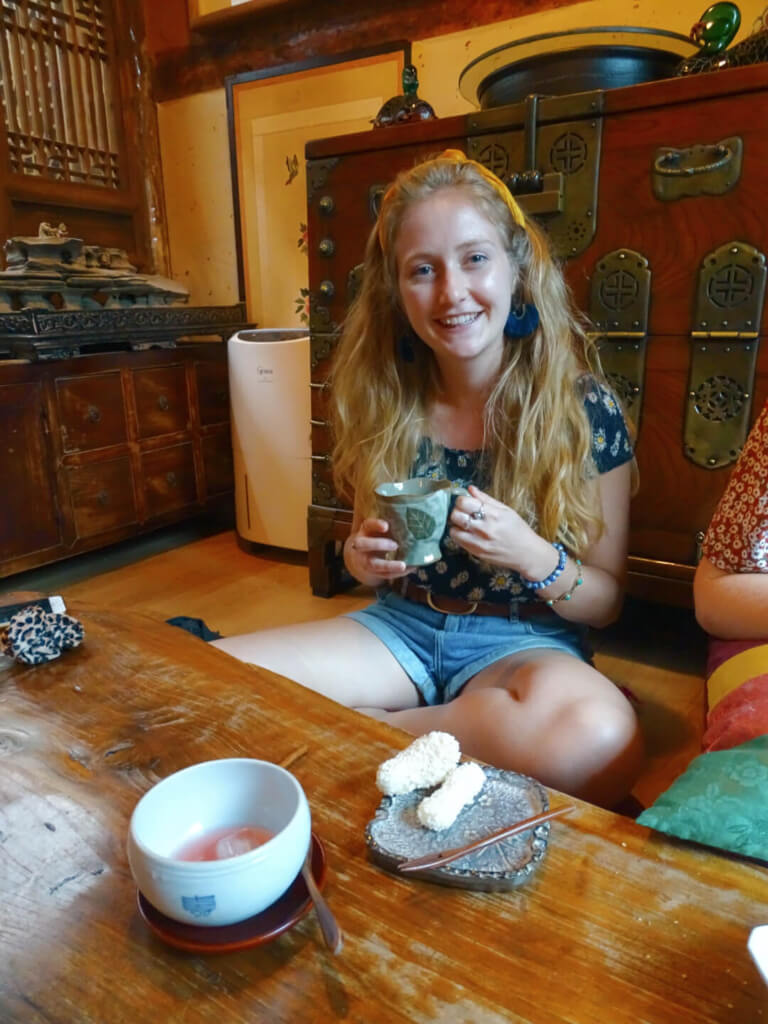
Getting to Insa-dong : Take Line 3 to Anguk Station (Exit 6) or Line 1 to Jonggak Station (Exit 3). Late afternoon: Jump on a 10-minute bus from Insa-dong to Myeongdong for a complete contrast. This bustling neighbourhood is flanked by skyscrapers and home to more beauty stores than you’ll have seen in your life. Head inside for free product samples. Despite being an upmarket area, there’s affordable street food at the open-air Myeongdong market . After gorging your heart out on tteokbokki, tornado potatoes and other Korean treats, you could finish your day by walking through Namsan Mountain Park to the Seoul Tower for sunset. Beware it gets crazy busy at weekends and there are long queues; book a skip-the-line ticket in advance or get free entry with the Discover Seoul Pass .
Day 3 – DMZ day trip

Take a day trip to the DMZ , a must for any South Korea 2 week itinerary. This buffer zone between South Korea and North Korea has a tragic history which you can learn about during a guided tour. Walk inside Third Tunnel, look through binoculars towards the Peace Village (a propaganda village built by NK to give the impression all is well in their country) from Dora Observatory, and visit Dorasan, the final train station before the border that will hopefully one day reunite families separated by the DMZ.
Recommended tour – since you can’t visit the DMZ independently, book a DMZ tour with Viator .
Note – as of 2023, tourists are now allowed to visit the Joint Security Area (JSA) after 2 years of closure. I haven’t noticed any popular tour companies add this back to their itineraries but I’ll keep checking. If you opt for a half-day trip, you’ll get back to the city early afternoon. Head to Hongdae for more weird & wonderful cafes, shopping and street performers. Have a street food dinner here or visit one of the many Korean BBQ restaurants. These go on well into the small hours, as do the many Hongdae bars and clubs.
Read next: Tips for visiting the DMZ from Seoul
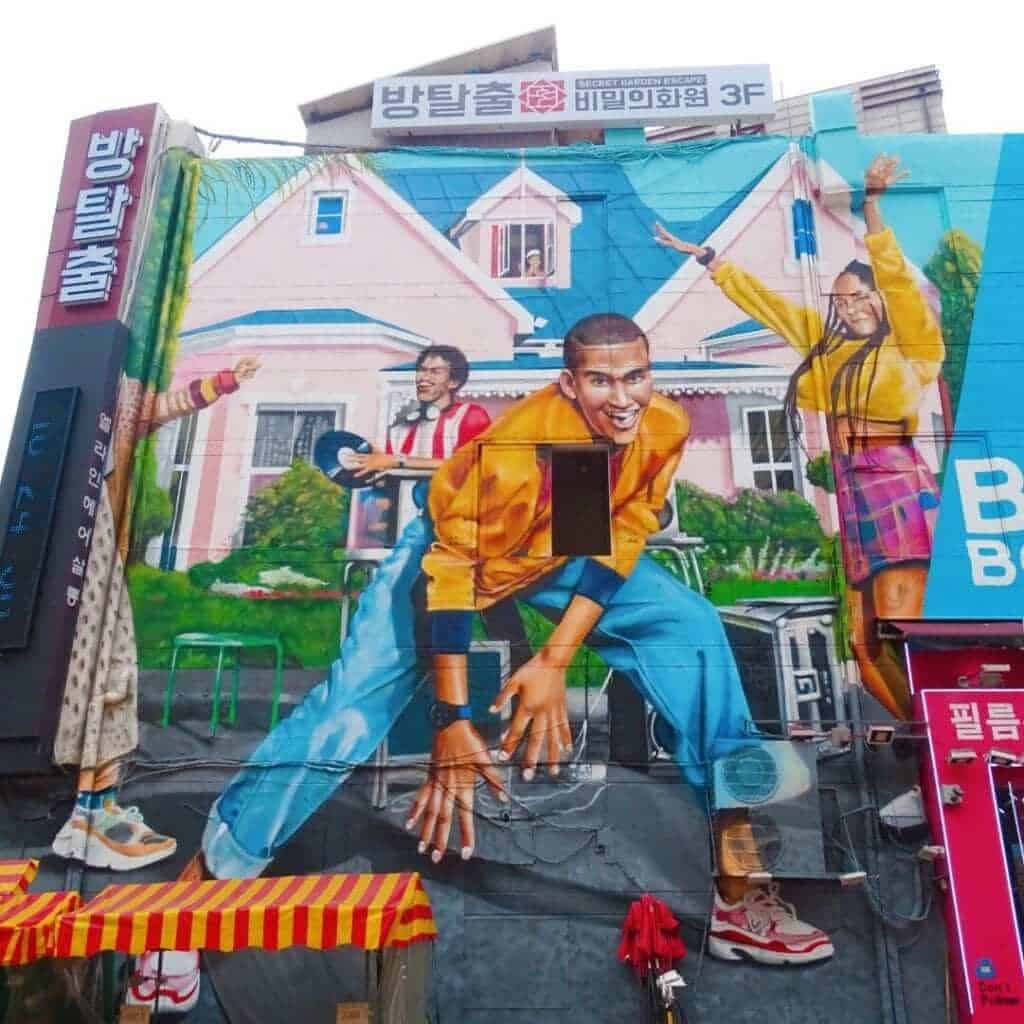
Day 4 – museum & culture day
No South Korea travel guide could miss the rich cultural heritage in Seoul. Visit the palaces, museums and galleries, breaking up the day by visiting Tongin Market for lunch. Here you can exchange tokens for a lunchbox of local food.
Gyeongbokgung Palace
Gyeongbokgung Palace is the oldest and most impressive of the five palaces in Seoul , built under the Joseon Dynasty. If you just have time for one, I’d recommend Gyeongbokgung because it’s the most beautiful, and easily accessible in central Seoul near Heungnyemun Gate. Built in 1395, this detailed and delicate palace could take half a day to explore. But if your time’s limited, make sure to visit at 10am or 2pm (apart from Tuesdays when the palace is closed) to witness the impressive changing of the guard ceremony.
More palaces in Seoul to add to your South Korea itinerary
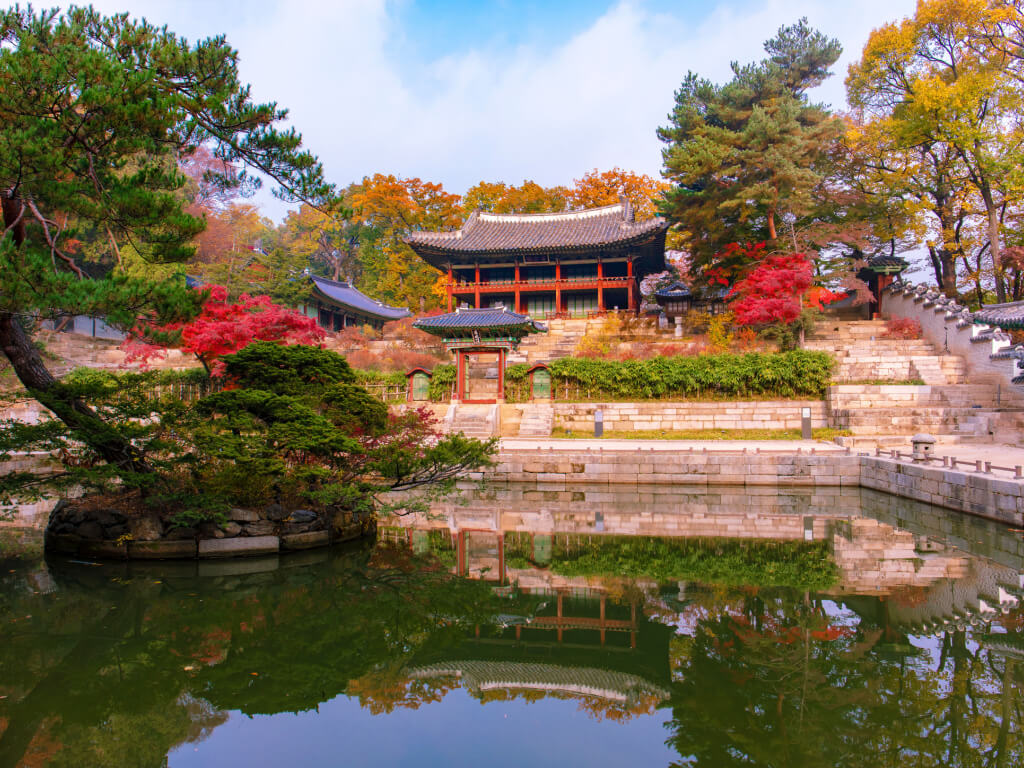
Changdeokgung Palace – surrounded by beautiful gardens measuring 78 acres, this is another serene palace to visit in South Korea’s capital with fewer crowds than Gyeongbokgung. With several pristine gates and temples, it’s little wonder it’s protected by UNESCO. Visit for a guided tour in English at 10.30am or 2.30pm. Closed Mondays. Deoksugung Palace – briefly Seoul’s main palace during an era when the others had burnt down. Find it near City Palace. Changgyeonggung Palace – like the others, this palace is bursting with history, having been destroyed several times during Japanese occupation. Luckily, it’s survived and is a lovely place to explore today. Gyeonghuigung Palace – the youngest and least-visited of the Seoul palaces is a hidden gem with more than 100 halls. It’s beside Heunghwamun Gate so makes for an easy add-on when visiting Gyeongbokgung.
Hanbok rental in Seoul
It’s a popular activity for tourists and locals alike to dress up in hanboks AKA traditional Korean clothing. As a White person, I initially felt uncomfortable at the idea of wearing clothing from another culture, in mind of cultural appropriation. However, Koreans will certainly encourage you to! If you feel comfortable, renting a hanbok will also get you into the Seoul palaces for free!
Seoul museums
- National Folk Museum of Korea – here you can learn about Korean life in the days gone by
- The National Museum of Modern and Contemporary Art – a vibrant contemporary art gallery
- National Museum of Korean Contemporary History – the place to understand recent history including Japanese rule and the split with North Korea.
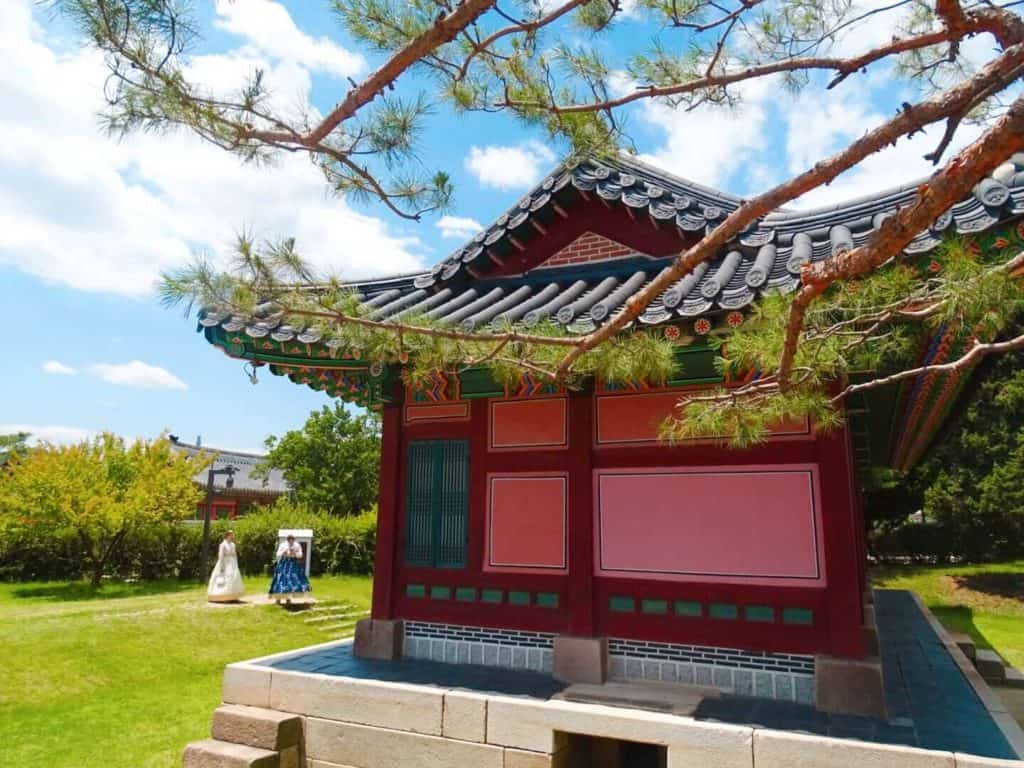
Day 5 – fun neighbourhoods
End this section of your South Korea itinerary by exploring Seoul’s modern side. Morning: Head to Gangnam to visit ‘ grammable Starfield Library and pose with the giant gold hand statue (inspired by a certain catchy pop song that brought Gangnam international fame). Although Gangnam is a modern neighbourhood these days, it has a long history. Visit historical Bongeunsa Temple founded in the year 794 by the highest-ranking monk of the Silla dynasty. Next, grab lunch in stylish Sinsa-dong neighbourhood. There are countless cool cafes packed with fashionable young Koreans. Afternoon: visit Itaewon district for hipster hangouts and the world’s best sandwich at Casablanca , or instead take a leisurely river stroll along Cheonggyecheon Stream. This is a peaceful place in Seoul where you’ll glimpse undisturbed wildlife.
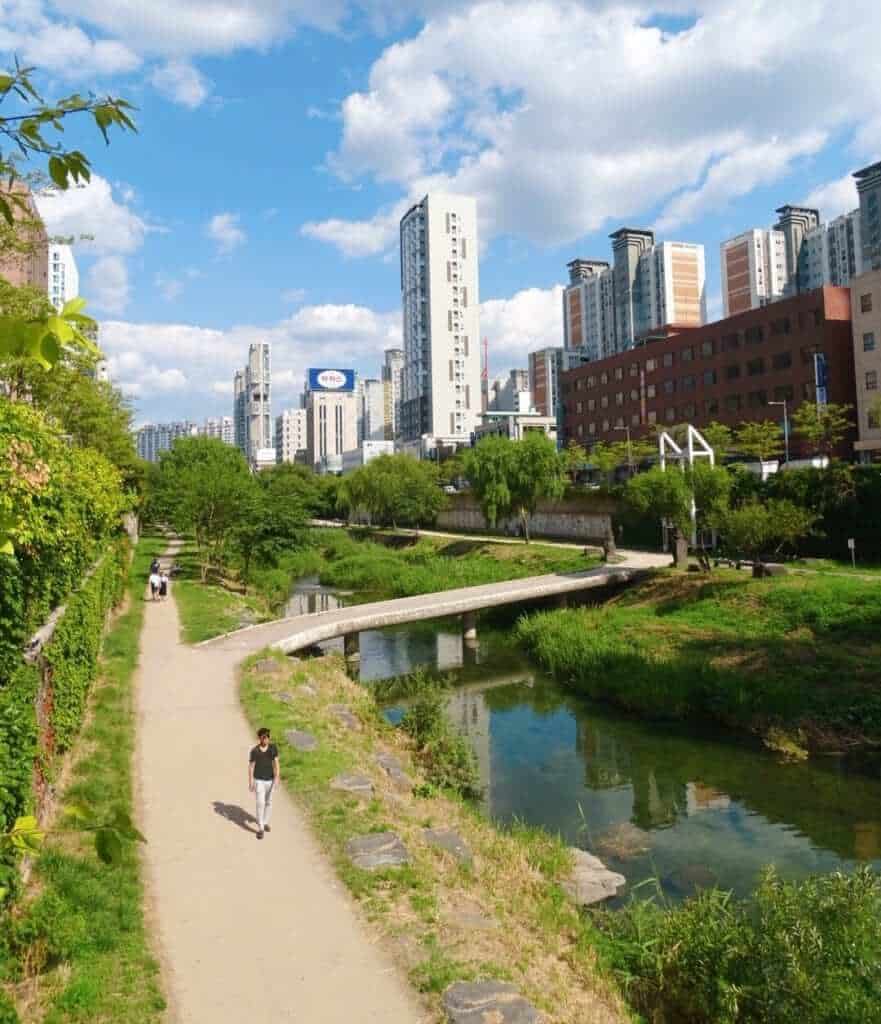
Where to stay in Seoul?
I would highly recommend Hongdae which is full of shops and cafes but isn’t as busy as the heart of the city. It’s easy to get everywhere from the metro station, plus there are many bus connections. Check out:
- Hostel – You can’t do better than Bunk Guesthouse Hongdae , one of the best hostels I’ve stayed at in 10 years of backpacking. The friendly owner remembers everyone’s name, there was complimentary breakfast, and my dorm room had a private lounge with sofas and TV. It was like a home from home. Check availability from US$22 per night .
- Budget hotel – Just 5 minutes from the subway and less than 900 metres to Jongmyo Shrine and Changdeokgung Palace, Hi Guesthouse Insadong is a clean and friendly base with breakfast and excellent shared facilities, including a sun terrace with BBQ, kitchen, laundry, and living area. Check availability from US$40 .
- Mid-range – With an unbeatable location, clean, modern rooms, and the friendliest staff around, it’s no wonder that Daeyoung Hotel Myeongdong is one of Seoul’s top-rated hotels. Check rates from US$60 .
- Splash-out – with gorgeous double rooms, a panoramic skyline view of the city and an indulgent breakfast buffet served in a stylish restaurant area, 9 Brick Hotel is where you can really splash out. Check rates from US$120 .
- Apartment – for the convenience of a private apartment not far from Hongdae, check out the comfortable studios at Dada Stay . Check rates from US$90 .
For more Seoul accommodation, check out Booking.com and Hostelworld .
Where to eat in Seoul
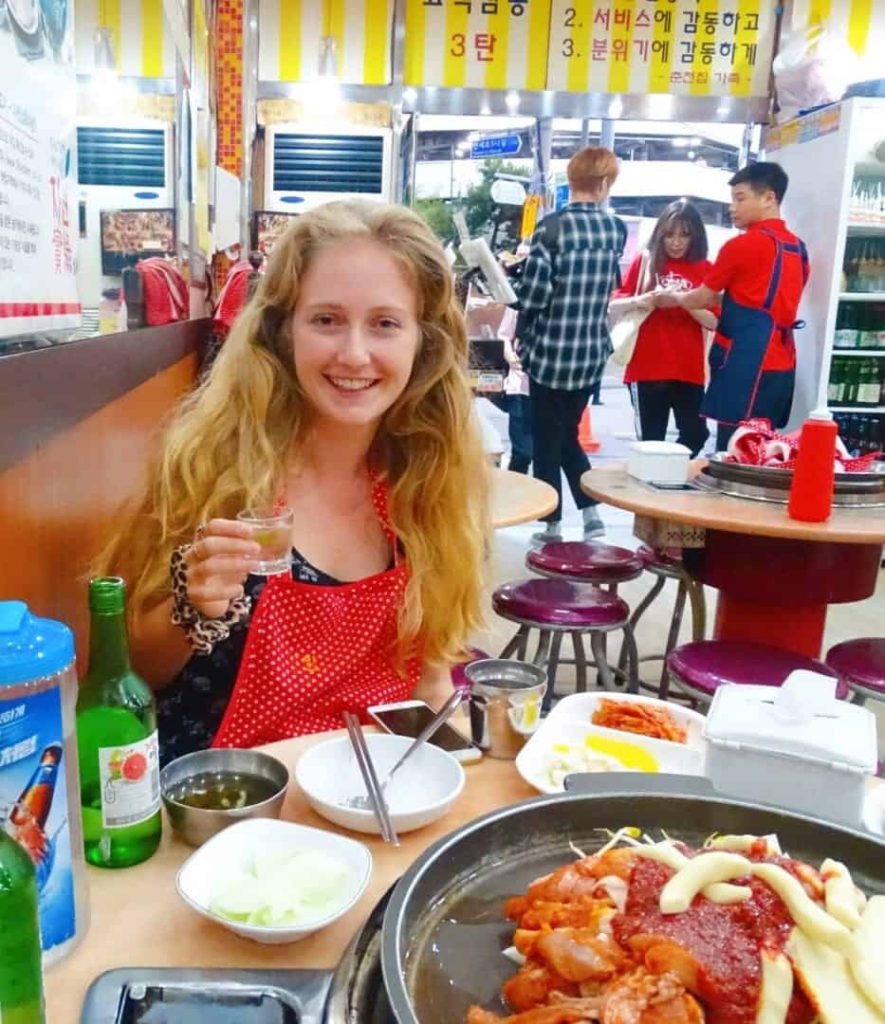
Well, where to even begin! There are so many places to eat in Seoul from fine dining to street food. Since I was travelling alone in South Korea , I’ll focus on the latter by telling you about some best food markets in Seoul… Myeongdong Market – in the heart of the thriving beauty district, this is a great place to nurture your body by shopping for skincare essentials… While also indulging your stomach with typical Seoul street foods sold at open-air stalls!
Namdaemun Market – this is one of the city’s most authentic night markets with a large indoor section with butchers stalls and fresh produce, and many stands outside. This market begins to wind down at 6pm so visit for lunch or an early dinner. Tongin Market – a vibrant daytime market near the main palaces and museums. Buy a ‘lunchbox’ and tokens to exchange for yummy local dishes.
Gwangjang Market – probably my favourite market, packed with every Korean delicacy under the sun! Better yet, it’s home to Cho Yonsoon’s knife-cut noodles that featured on the Netflix Street Food series. Also, a Korean BBQ meal and a dak galbi meal (rice cakes, chicken, cheese and gochujang sauce cooked on a hot plate) is a must for any South Korea itinerary! Annoyingly, they don’t usually serve them for one person but I managed to find a restaurant that would, for a slight surcharge. If you’re on a budget, make sure to eat bibimbap , one of the cheapeast and best Korean dishes !
What to do in Seoul at night?
Well, how long have you got? From crazy clubs to boujee bars and everything in between, this city truly never sleeps. But it’s not all about alcohol: you’ll see friends and couples drinking coffee at 2am and groups crowded around tables at buffet restaurants ’til sunrise.
Then, there are talented buskers who perform free K-pop concerts in the streets of Hongdae. There’s always something fun going on, not limited to the activities below:
- Take a pub crawl – join a guide and group of fellow partygoers visiting 4 bars in lively parts of town.
- Ghost stories walking tour – hear dark tales and learn about legends and true crime during this unique evening walking tour!
- Take an evening boat cruise or dinner cruise down the Han River
- Hike or take the cable car (then ride the elevator) to the top of the Seoul Tower for sunrise or night views
- Catch a NANTA show using traditional Korean music and performance to tell the hilarious tale of chefs throwing a chaotic wedding banquet
- Karaoke! Noraebang is the local name for karaoke, usually located in private booths you can rent out with your friends. As someone with a terrible singing voice, I much preferred this to having a bunch of strangers watch!
Days 6-7: Sokcho & Seoraksan National Park
Just 2 hours from Seoul is a stunning part of South Korea that many tourists miss. The main reason to visit Sokcho city is to hike in Seoraksan National Park , a beautiful area full of stunning cliffs and endless forest. If you love hiking and nature, don’t miss this stop from your 2 week South Korea itinerary .
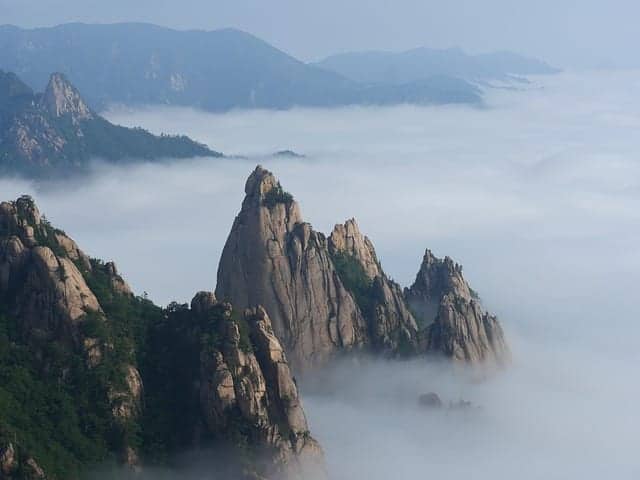
Getting to Sokcho: Buses run from Seoul Express Bus Terminal, taking 2.5 hours to reach Sokcho and costing 18,000 KRW. Day 6: Travel by bus to Sokcho. Check out Sokcho Beach. Day 7: Spend a day hiking in Seoraksan . From your accommodation, catch a bus to the Outer Seorak entrance of the park near the Seoraksan cable car. Just 10-minutes by foot from the entrance is Sinheungsa Temple with a 62-foot gold Buddha statue. Rumour has it this is the oldest Zen Temple in the world, built in the year 653. Better yet, a FREE bowl of noodles is handed out to every guest!
Where to stay in Sokcho
- Hostel – At just 1km from Lighthouse Beach and 400m from Sokcho Culture Centre, Sokcho Hutte is a conveniently located and budget-friendly hostel. Guests can enjoy the onsite bar, common area and delicious breakfast, alongside staying in clean, modern dorms with AC and private rooms with city or mountain views. Check availability from US$24 .
- Budget hotel – Sokcho & Guesthouse is a top-rated accommodation near the beach. Don’t miss the daily American breakfast, and stop by the shared kitchen and lounge. The super-friendly hosts can help book tours and bus tickets. Check availability from US$55 .
- Mid-range – Just 80 metres from Lighthouse Beach, you’ll have fantastic city or ocean views from your room at Heavenmark in Sokcho. Well-equipped modern rooms include air-conditioning, a TV, a balcony, a fridge, a kettle and a washer-dryer. Check availability from US$80 .
- Splash-out – Make the most of the Sokcho scenery from every immaculate sea view room at Lotte Resort Sokcho . Facilities include a water park, arcade, mini golf, infinity pool, gym, restaurants, and rooftop pub. Check availability from US$200 .
Browse more Sokcho accommodation on Booking.com .
Alternative days 6-7: Jeonju
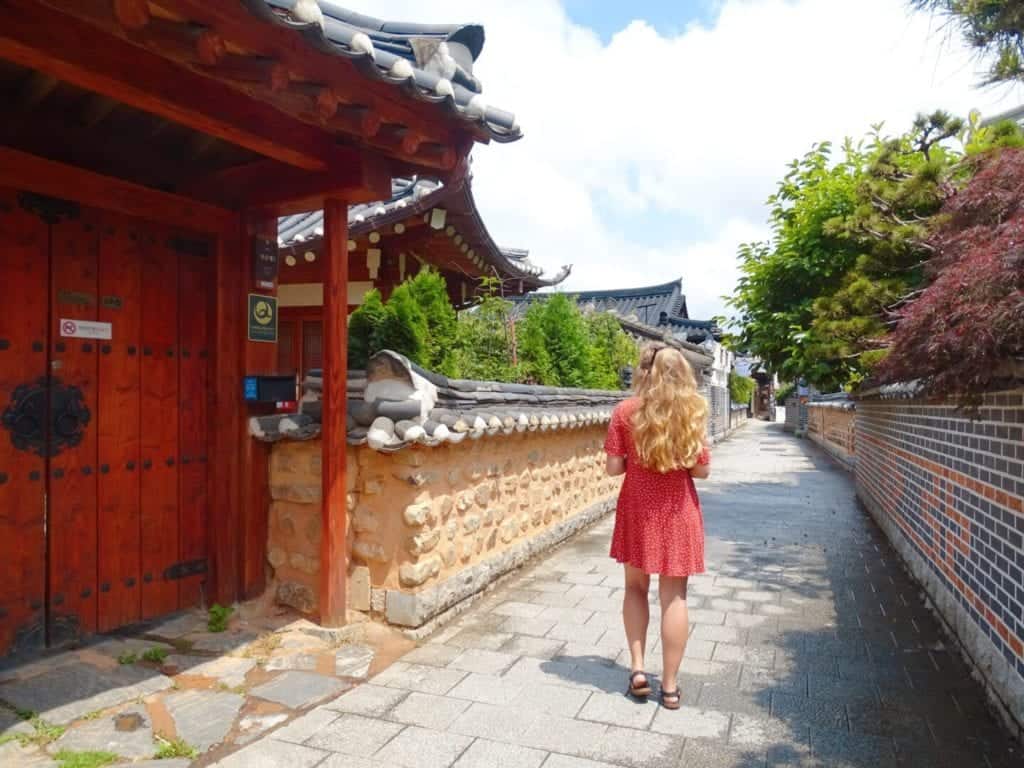
Prefer cities and culture to nature and hiking? Swap Sokcho for Jeonju to ensure this South Korea 2 week itinerary suits you. Getting to Jeonju: From Seoul, catch the train or bus in just under 3 hours. Book your train on Trip.com or simply turn up at the bus terminal if you’re catching a bus. The gorgeous little city of Jeonju is somewhere I’ve written about a lot since my visit. If you didn’t have time to visit Bukchon Hanok Village in Seoul, never fear because Jeonju is arguably even more charming. It’s a fantastic place to stay overnight in a perfectly preserved hanok house. If that doesn’t persuade you, Jeonju is a UNESCO City of Gastronomy and the birthplace of bibimbap. Foodies, drop what you’re doing and get over here!
Read next: Complete Jeonju travel guide
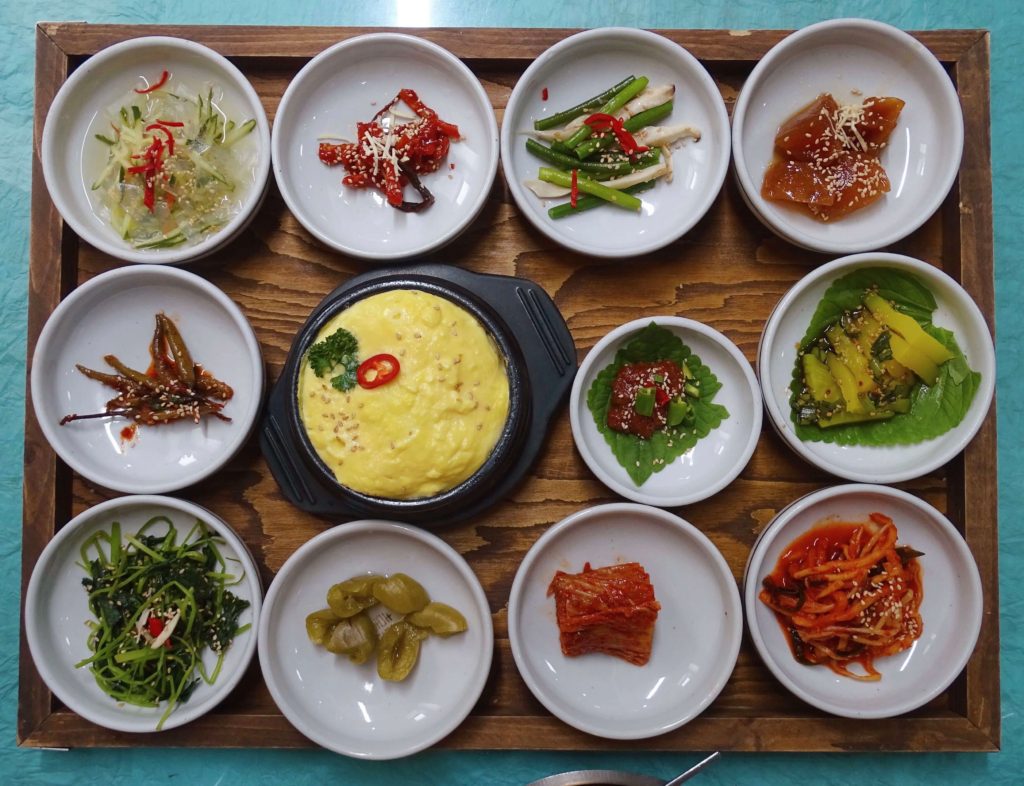
Day 6: Arrive in Jeonju and get your bearings. Head for dinner at Family House for a bibimbap feast (pictured above). Although I initially thought ordering a 20,000 KRW meal was pricey, I was stunned at the sheer amount of food that arrived. This is how Rose died and went to bibimbap heaven! Day 7: Explore Jeonju, visit the Hanok Village, eat at Nambu Market and spot street art Jaman Mural Village (a smaller version of Seoul’s Ihwa Mural Village). Honestly, you could see Jeonju in a day but I enjoyed staying 2 nights in order to relax during my busy 2 weeks in South Korea. If you try Jeonju’s famous makgeolli (Korean rice wine served in a teapot), you may need the extra day to nurse your sore head.
Where to stay in Jeonju
- Hostel – Happinessfull Hanok Guesthouse is a gem. This traditional hanok house is the real deal, with a modest floor bed and a TV showing K-pop and K-dramas. Although the owner could speak little English and I could speak even less Korean, she was so friendly and handed me maps and freshly-brewed tea. Check availability from US$35 .
- Budget hotel – Whoever put together the rooms at Kama Hotel thought of every modern amenity you might need, from a TV with Netflix to hair straighteners. It’s conveniently located near bus routes and includes a simple breakfast. Check availability from US$45 .
- Mid-range – With contemporary facilities, a great breakfast and city views, Hotel Arari is a clean and convenient base for exploring Jeonju. Check availability from US$57 .
- Splash-out – The well-located Best Western Plus Jeonju has an onsite restaurant, gym, outdoor pool, and cocktail lounge, so you’ll be well set to return and relax after a day of exploring the city. Check availability from US$85 .
Browse all Jeonju accommodation on Booking.com and Hostelworld .
Days 8-10: Busan
While some people describe Busan as just another big city, I liked it. No, it’s not as quirky or cool as Seoul but where is? Busan is still an excellent addition to any South Korea 2 week itinerary, as well as a launching point for reaching Jeju Island.
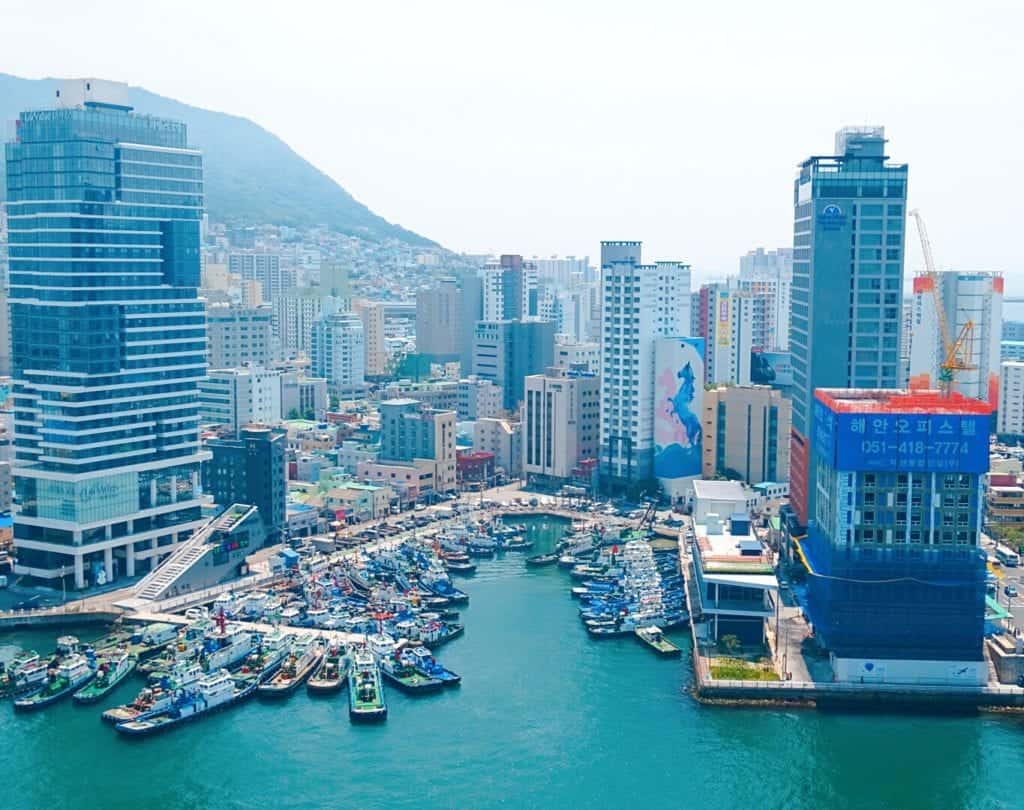
Getting to Busan: From Jeonju, you can catch a bus or train within 3 hours. If you were previously in Sokcho, you can take a 6-hour bus or alternatively a 2-hour bus to Seoul then a fast train to Busan in 2 hours 15 minutes.
Day 8 – arrive and sightsee
Depending on your arrival time, there are plenty of activities for your first day in Busan. One option is visiting the Temple by the Sea (Haedong Yonggung Temple). Alternatively, kick back and relax on famous Haeundae Beach. Chill out even further at Spa Land inside Shinsegae Centum City (shopping centre) in the evening. This is a traditional Korean jjimjilbang with a nude hot pool area. Visit after 8pm for a discounted ticket.
Read next: Busan 3 day itinerary
Day 9 – Gamcheon Culture Village & Nampo
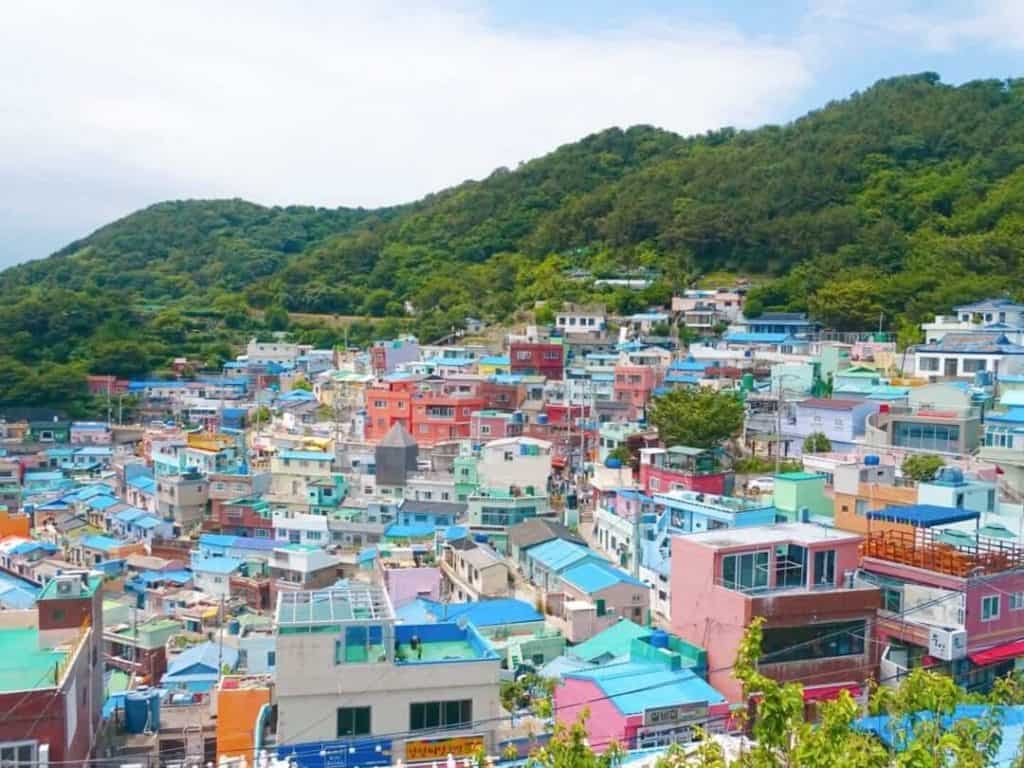
Morning: Visit colourful Gamcheon Culture Village . This once rundown neighbourhood is now a vibrant tourist attraction. As a street art fan, it was one of my favourite stops during 2 weeks in South Korea. As well as murals, there are cafes, cultural centres and arty statues. Afternoon: Head to Nampo district to climb Busan Tower, check out Jagalchi Fish Market, shop at Gukje Market and eat Korean street food in Biff Square.
Read next: The best day trips from Busan
Day 10 – hiking in Busan
Take a morning hike, add either Igidae Coastal Walk or in Taejongdae Park, across the bridge on a small island, to your South Korea itinerary. Relax in the afternoon at Gwangalli Beach then visit Seomyeon neighbourhood in the evening for street food, restaurants and nightlife.
More details about these hikes are listed in my guide to the best Busan day trips .
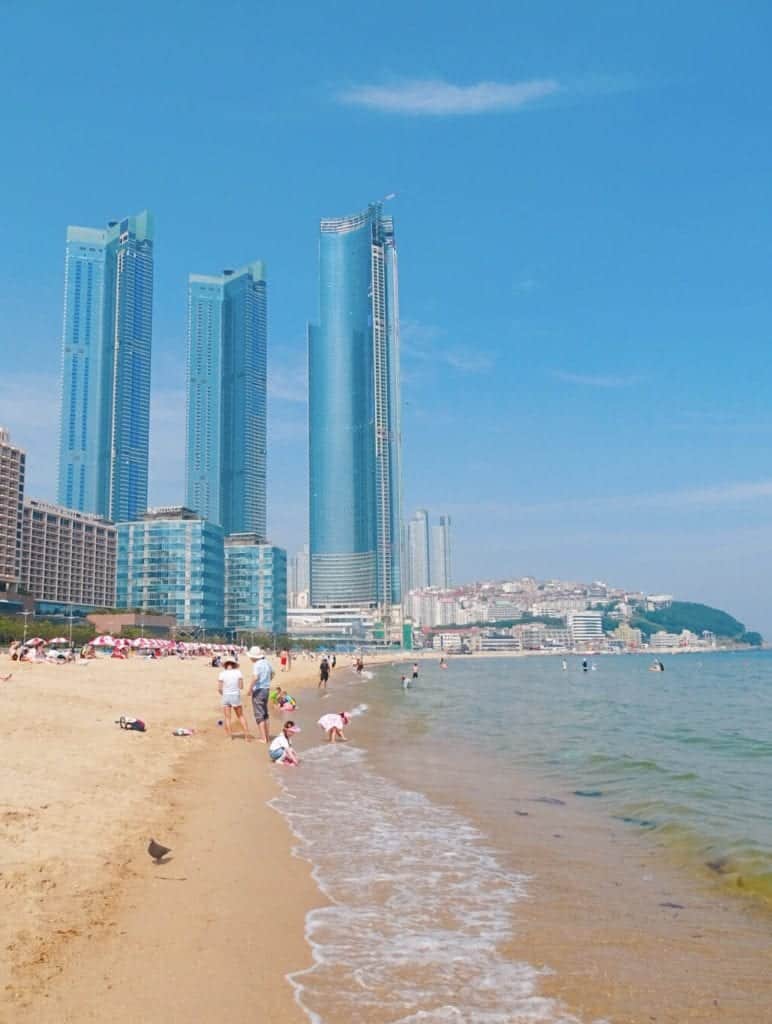
Where to stay in Busan
I would highly recommend Seomyeon neighbourhood because it’s full of cafes, restaurants and bars and it’s also the station where most of the subway lines connect, meaning it’s easy to get everywhere.
- Hostel: Book Blue Backpackers , run by a friendly family. This hostel down a sleepy side street makes it quiet at night, plus there’s complimentary breakfast and a comfy lounge area. Check availability from US$16 .
- Budget hotel: Stay at Seomyeon Brown-dot hotel gold for some of the area’s most affordable yet comfortable rooms, with TVs and en suite bathrooms. Breakfast included. Check availability from US$40 .
- Mid-range: Unwind at Nampo Ocean2heaven Hotel, which has an onsite fitness and spa centre with a sauna and baths. It’s conveniently located with city or sea views from each room. Check availability from US$75 .
- Splash out: For stylish rooms with mountain views and an excellent array of onsite facilities, including a gym, golf centre, spa, and sky bar, you can’t go wrong with a stay at Avani Central Busan . The breakfast spread is superb, too. Check availability from US$140 .
- Apartment: Close to Busan station and the port, Le Collective boasts stylish, spotless suites with city views and easy access to vibrant Chinatown. Check availability from US$100 .
Browse all Busan accommodation on Booking.com and Hostelworld .
Where to eat in Busan
Jagalchi Fish Market – for seafood in Busan, don’t go anywhere else! This is a thriving market where you’ll find fish, crab, oysters and so, SO much more. The way the market works is you pick a fish on the first floor, then head upstairs to eat it in a restaurant.
Gukje Market Street – Gukje is the largest market in Busan, serving every local dish under the sun. One of the famous is bibimdangmyeon AKA glass noodles.
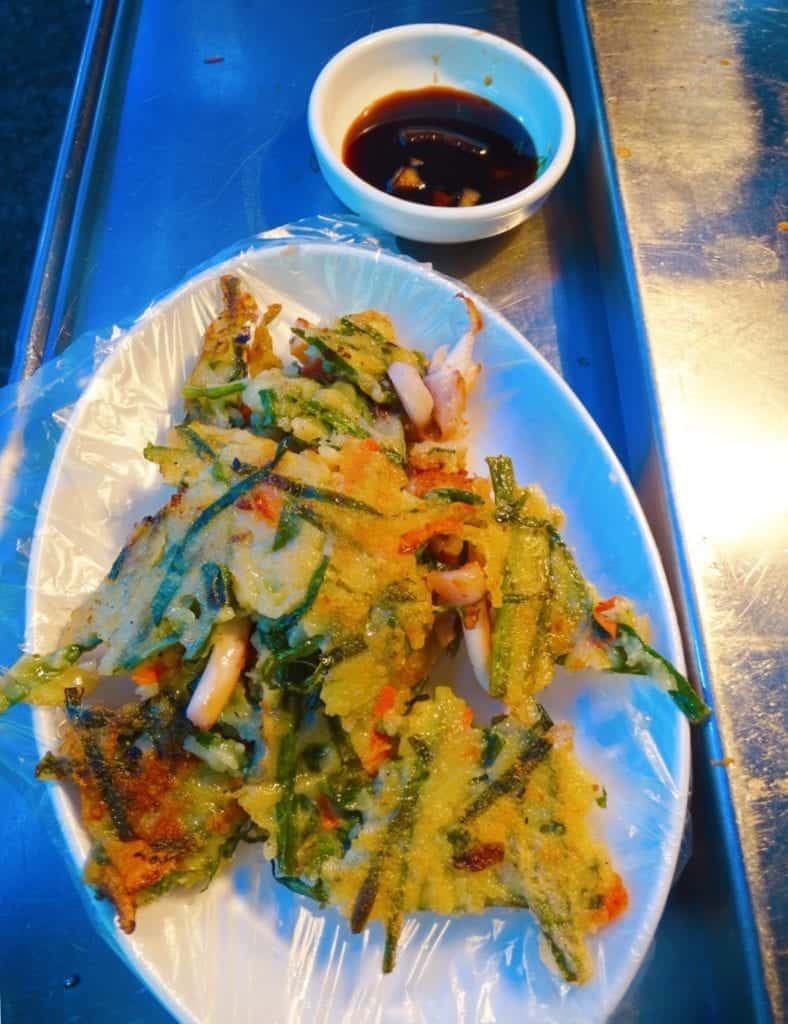
Top foods to try in Busan:
- Milmyeon – noodles in a meat-based broth topped with egg, veggies and gochujang sauce is the typical dish of Busan.
- Eomuk – fish cakes are a popular Busan dish, served in various shapes and flavours, including on sticks.
- Kimbap – yummy rice and veggies in sushi rolls. Unlike Japanese sushi, it usually doesn’t contain fish.
- Buchimgae – moreish seafood pancakes.
Days 11-14: Jeju Island
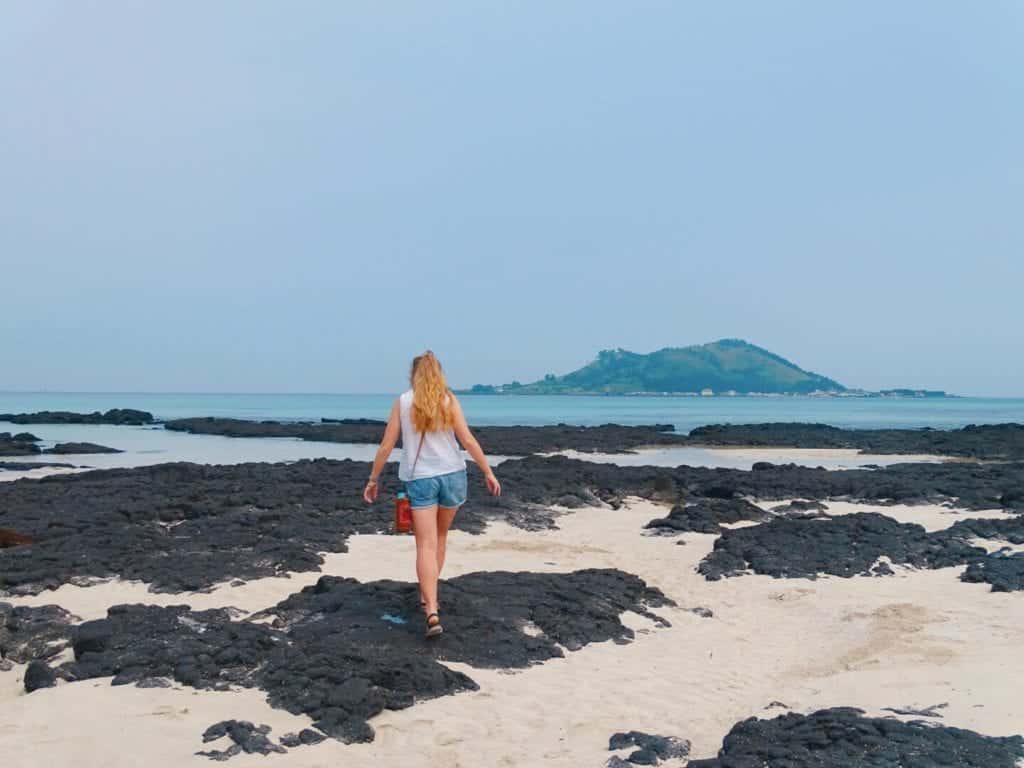
Jeju Island is a must for your 2 week South Korea itinerary. It’s been voted a New 7 Wonder of Nature alongside the Amazon and Cape Town’s Table Mountain. It’s so popular that Seoul to Jeju has officially been declared the world’s most popular flight route! The power of nature is what makes Jeju so special. Formed by ancient lava, you’ll feel it many places like the magnificent Manjanggul tunnels, Jusangjeolli Lava Cliffs and the beautiful ‘sunrise peak’ jutting off the coast, Seongsan Ilchulbong. Getting to Jeju: The best way to get to Jeju Island is by air. Many visitors fly Busan to Jeju but you could also consider flying from Seoul to Jeju and then into Busan. In this case, rejig this itinerary accordingly. You can also fly to Jeju Island from Daegu, Cheongju and Gwangju so check if any of those serve you better. How to get around Jeju Island: Hiring a car gives you the most freedom. Use Rentalcars.com to find a vehicle and pick it up in Jeju City. Otherwise, Viator offer a range of affordable day tours. While you can catch public buses on Jeju, these are infrequent so expect to see fewer attractions. Recommended tours:
- East Coast tour (Manjang Cave and haenyeo female divers)
- West Coast tour (Cheonjeyeon waterfalls, Hyupjae beach and tea plantations)
- South Coast tour (the Mysterious Road, Jusangjeolli Hexagon Lava Cliff and Mt Halla hiking)
Read next: A guide to visiting Jeju Island without a car
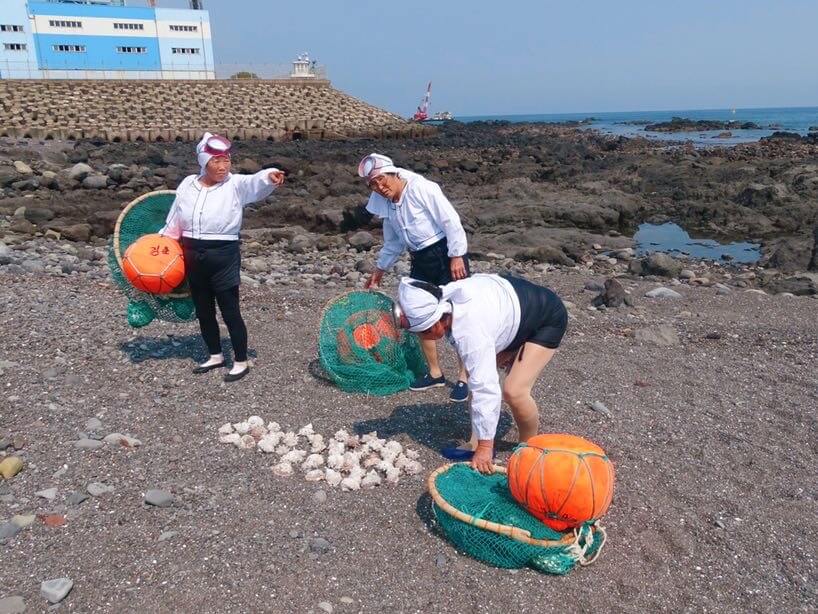
Day 11: Arrive in Jeju and settle into your surroundings. If you have time, visit a beach or the infamous Jeju Love Land (a risque theme park) in the afternoon. Day 12: Explore the West Coast of Jeju. Visit Hyupjae Beach, Hallim Park, O’sulloc Tea Museum and Cheonjeyeon Waterfall. If you don’t have a car, book a West Coast tour. Day 13: Travel the East Coast of Jeju Island stopping at Gwangchigi Black Sand Beach and Manjang Cave. Attend the fascinating UNESCO World Heritage women diver show to learn about these highly-skilled female divers (haenyeo) who dive down 10 metres without equipment to catch seafood. If you don’t have a car, book an East Coast tour . Day 14: Why not take a Mount Hallasan day hiking tour or have a beach day before flying back to the mainland in the evening? If your onwards destination is in Asia, you might even be able to finish your 2 weeks in South Korea by flying there directly from Jeju Island.
Where to stay in Jeju
- Hostel – Backpackers don’t have to sacrifice on sea views at the friendly Yesjun Guesthouse . It has a complimentary breakfast, a really friendly front desk, a kitchen, a restaurant, a games room, a simple breakfast, and a garden with bean bags next to the ocean. Check availability from US$17 .
- Budget hotel – Jeju Pureun Hotel has air-conditioned units with a fridge, microwave, kettle, TV, and complimentary toiletries. It’s also wheelchair accessible, and some rooms have visual aids. Check availability from US$30 .
- Mid-range – Located close to the beach and many attractions and restaurants, The Grang Seogwipo is an ideal base. Rooms are spacious with a city view, and an a la carte or American breakfast is included. Check availability from US$90 .
- Splash-out – After a day exploring, what’s better than unwinding by the outdoor pool with a cocktail, booking a massage, or tucking into a delicious meal at Toscana Hotel ’s onsite restaurant? Rooms include a balcony, bathtub, and floor-to-ceiling windows so you can order room service and enjoy the view. Check availability from US$190 .
Browse all Jeju accommodation on Booking.com and Hostelworld .
Where & what to eat in Jeju Island
- Black pork – this is the island’s signature dish, made from a specific breed of pig. Served with all the yummy Korean sides like gochujang, kimchi and veggies, it’s a treat! Sukseongdo is a popular place to try it.
- Haemultang – this a yummy seafood hotpot popular on the island. Try it at Samseonghyeol Haemultang .
- Matcha – as it’s grown on the island, make sure to find a cafe serving the local Jeju blend!
3 week South Korea itinerary
Since most people spend 2 weeks in South Korea, I decided this was the most useful itinerary to put together. But I personally spent 3 weeks in South Korea which, in my opinion, is better . You can get past the big cities and explore more local destinations. Plus, it’s an extra 7 days of eating kimchi! If you have 3 weeks in South Korea, there are a couple of stops I’d suggest adding, Daegu and Gyeongju . This 3 week South Korea itinerary also means you can include both Sokcho and Jeonju so there’s no need to choose. I’ll breeze through the stops we already mentioned and elaborate on the new destinations: Days 1-5: Seoul. As per 2 week South Korea itinerary above. Days 6-7: Sokcho. As above. Days 8-9: Jeonju. As above.
Days 10-12: Daegu
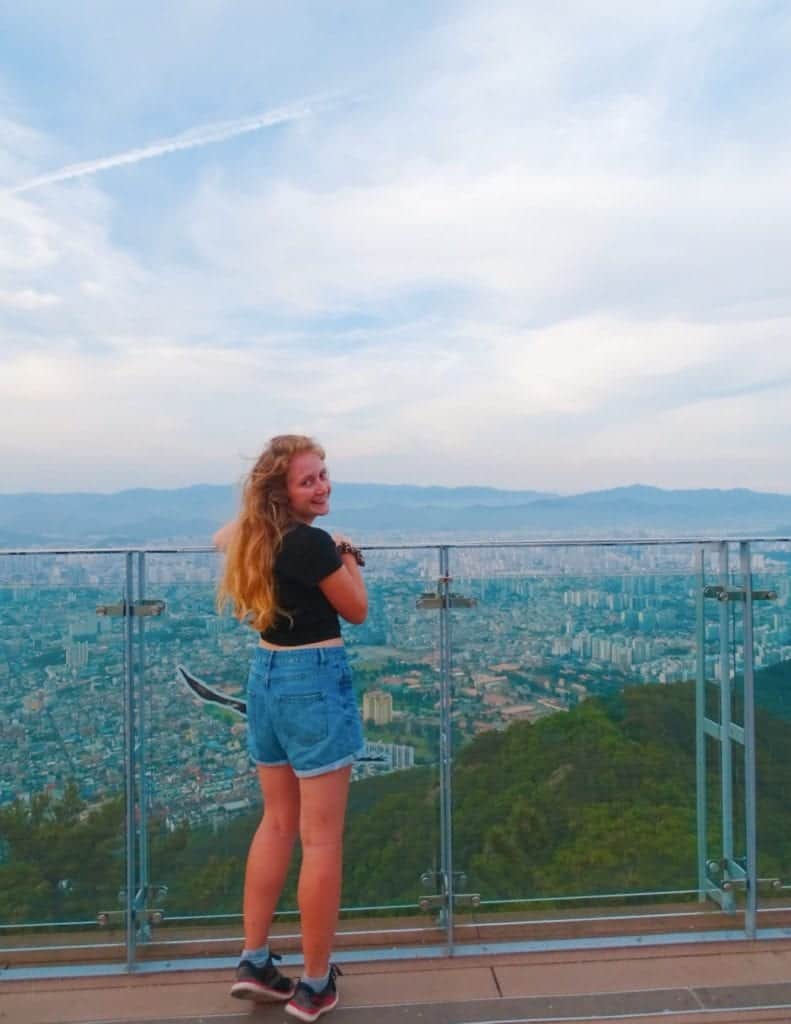
The fourth biggest city in South Korea is a sweet spot to spend a day or two especially if you like hiking. Day 10: Arrive in Daegu. Day 11: Catch a bus to Palgong Mountain for hiking and temples. Here you can find the Gatbawi Stone Buddha at Seonbonsa Temple and get immersed in the surrounding hiking trails. Day 12: Start your day with coffee and unlimited free pastries (yes seriously) at Schumann and Clara . Have a city day or hike up to Apsan Park where you’ll get spectacular sunset views over the city and countryside from the deck at the top.
Where to stay in Daegu
- Hostel – Located in downtown Daegu near the subway and bus routes, Empathy Guest House is a handy and comfy place to stay. Check availability from US$19 .
- Budget hotel – Blo by Blo is a quiet hotel with a hot tub and terrace. It’s conveniently located near the metro with minimal but clean rooms. Check availability from US$60 .
- Mid-range – For a cute and sustainable accommodation option, go for Aega Hanok Guesthouse. With aesthetic, Korean-style rooms and passionate hosts, it’s an excellent choice for anyone wanting to get a taste of traditional Hanok-style stays. Check availability from US$90 .
- Splash-out – If you want to truly relax in Daegu, then Susung Spa Resort is perfect. You have everything you need to unwind with two pools, a garden, a spa centre with hot tubs and a sauna, and a restaurant with a lake and mountain views. Check availability from US$150 .
Browse all Daegu accommodation on Booking.com and Hostelworld .
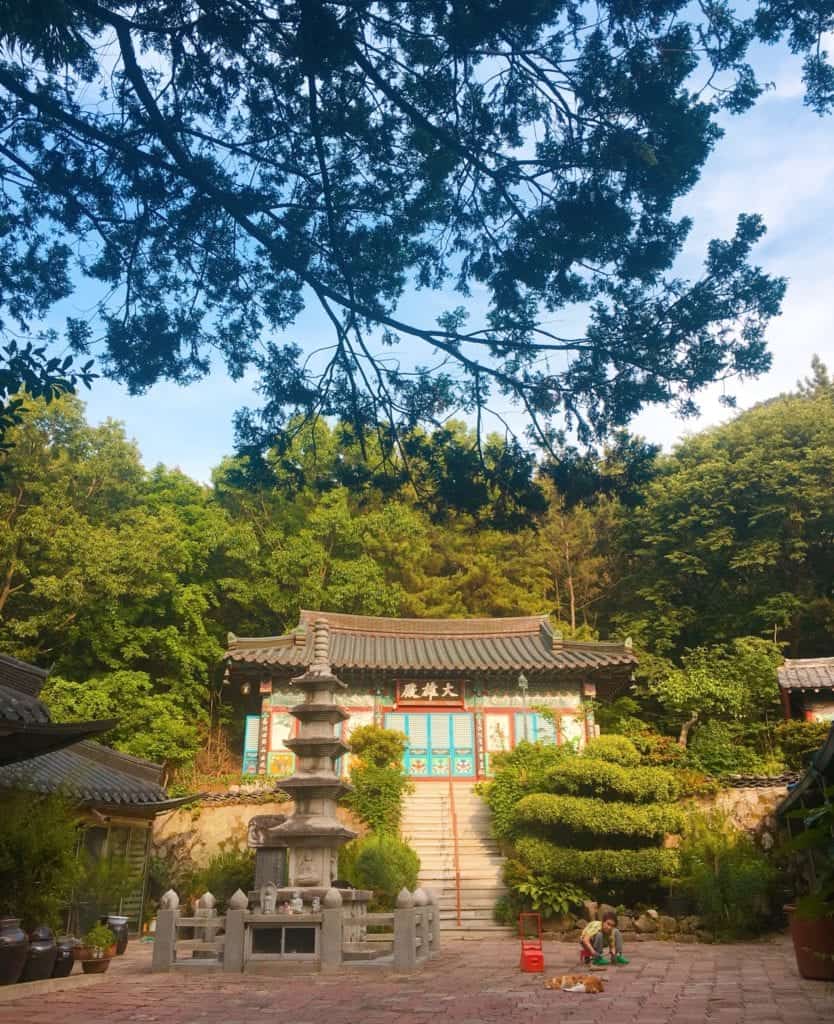
Tip – Check out Life of Brit’s Daegu hiking guide . Brit lived in Daegu while teaching English so she is your girl for tips (and always replies on Instagram).
Days 13-14: Gyeongju
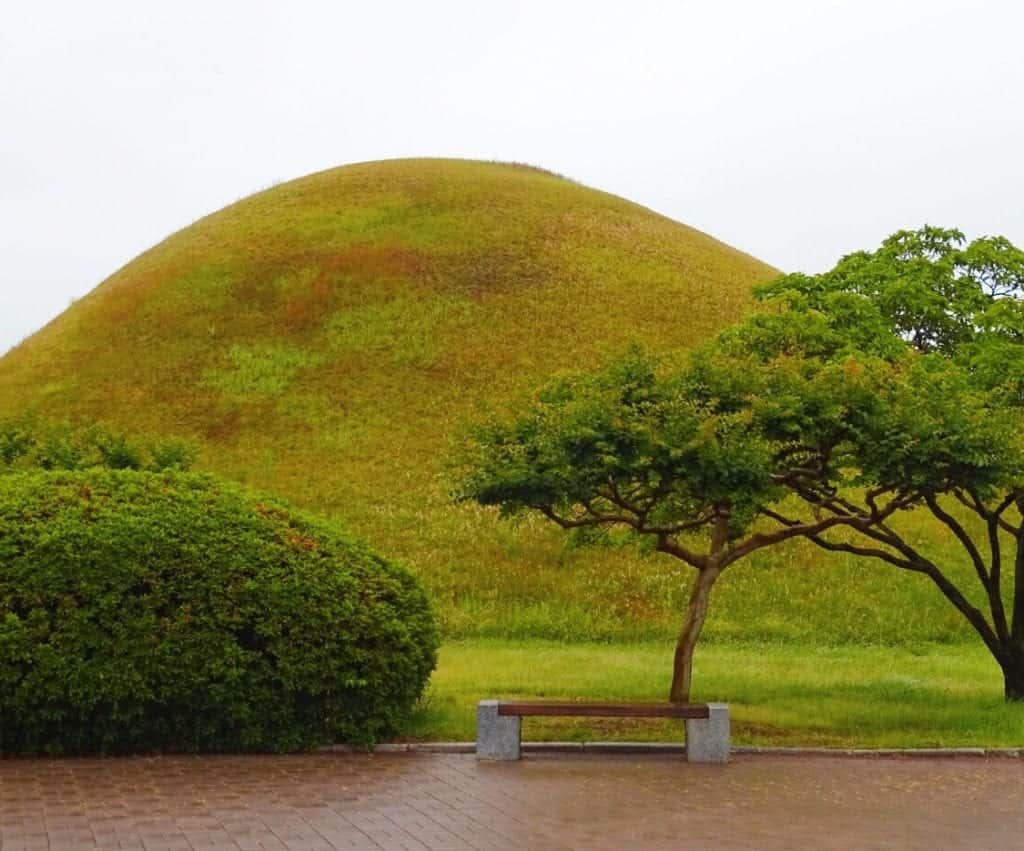
History lovers spending 3 weeks in South Korea shouldn’t miss Gyeongju, home to the Silla Dynasty from the 1st to 7th centuries. It’s also an excellent stop for foodies. I didn’t find anywhere else quite like Gyeongju which is why I liked it. Day 13: Explore Daereungwon Tumuli Park (ancient manmade hill tombs filled with gold and jewels), Wolji Pond and Cheomseongdae Tower. Tuck into a traditional ssambap meal: small bitesize portions of food wrapped in leaves. For dessert, sample Hwangnam (sweet bread filled with red bean paste).
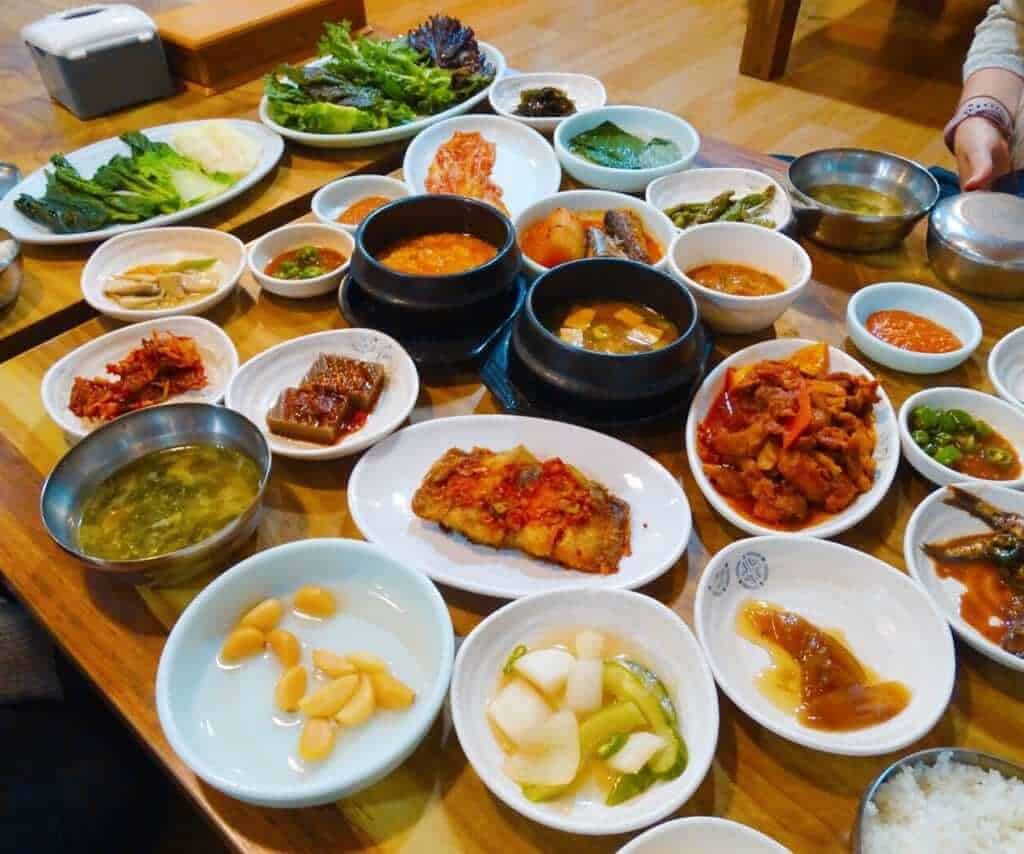
Foodie visiting Korea? Don’t miss my South Korea food guide !
Day 14: Catch a bus to Bulguksa Temple and hike up to Seokguram Grotto at the top (comfy footwear necessary). On the way home, stop at Gyeongju National Museum to learn about the ancient Silla Dynasty.
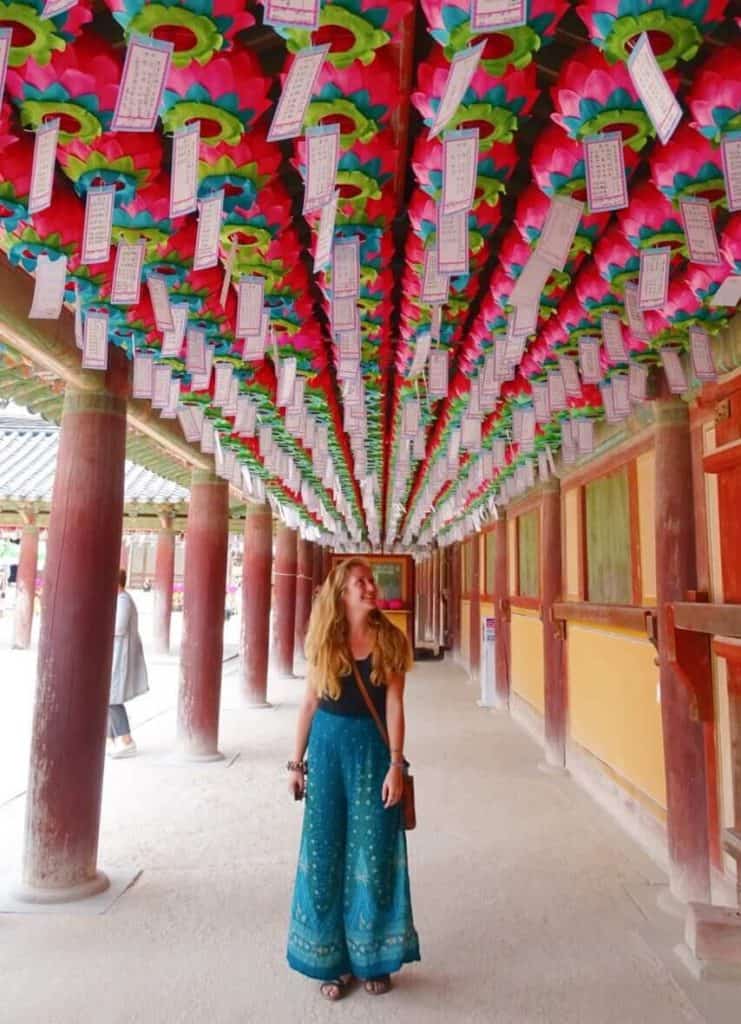
Another fun addition to your South Korea trip itinerary, should you have time, is a templestay experience at Golgulsa Temple near Gyeongju. Surrounded by stunning Hamwolsan Mountain scenery, Golgulsa is somewhere you can practice Sunmudo, a Korean-Buddhist blend between meditation and martial arts. Stay a night, several nights, or even up to a month!
On a tight schedule? It’s possible to visit Gyeongju as a day trip from Busan rather than stay overnight.
Where to stay in Gyeongju
- Hostel – I stayed at Blueboat Hostel , which is a cosy hostel run by a friendly local who will give you tips and local advice. It’s a great place to meet other backpackers. Check availability from US$18 .
- Budget hotel – For a comfy and clean room close to the centre, G HOUSE Mini Hotel & Guesthouse has you covered. Breakfast included. Check availability from US$45 .
- Mid-range – Rivertain Hotel has spacious rooms with spa baths and complimentary breakfast in the heart of town. Check availability from US$100 .
- Splash-out – Overlooking beautiful Lake Bomun, Lahan Select Gyeongju is a tasteful and welcoming resort with a gym, two swimming pools, indoor golf, and various dining options. Check availability from US$140 .
Browse all Gyeongju accommodation on Booking.com and Hostelworld . Days 15-17: Busan. As above. Days 18-21: Jeju Island. As above.
Useful info for 2 weeks in Korea
What is the best season to visit south korea.
March to May and September to November are optimum as the weather is pleasant. In the spring season, you may see cherry blossom and in the later season, you’ll see the country become beautifully autumnal. Saying that, I visited in June (summer) and although it was hot and sticky at times, it was bearable. This is also a good season for hiking as temperatures are cooler in the mountains. December to February are freezing cold so only visit if you’re really prepared. Note – make sure you know when Korean holidays fall as many businesses will be closed. Korean New Year is the first day of the Korean calendar. Chuseok falls on day 15th of the 8th lunar month.
Is Korea safe?
As a solo female traveller, I found South Korea to be very safe. I felt comfortable walking at night as well as during the day. Petty crime is not a big problem and violent crime is near non-existent. See my solo travel archives for safety tips for women. Here’s a guide for Black travellers in South Korea and LGBT+ travellers in South Korea .
What language is spoken in South Korea?
That would be Korean. Although the language is complex, the alphabet is actually quite simple. Some travellers told me they’d learnt it in a day! Doing so would definitely help you recognise dishes on menus. Failing that, have Google Translate close to hand and be prepared to do a little miming from time to time.
What plug do you need for South Korea?
South Korea uses plug type F with two round pins, like many other Asian countries. The standard voltage is 220 V with a frequency of 60 Hz.
Do you need a visa for South Korea?
More than 100 nationalities – including US, UK, Canada, EU, Australia and New Zealand – can enter South Korea visa-free. Check if your nationality is on this list and how many days you can stay for. If not, you’ll need to apply for a visa.
South Korea travel tips
- Unlike some countries, tipping isn’t necessary in South Korea
- For city travel, pick up a Tmoney card . They cost 500 KRW (you get back 3,500 of the 4,000 deposit) but save you money in the long run, plus you never have to queue at ticket machines. Buy yours now or get it with a SIM card combo
- Korea is a difficult place to travel for veggies. Download the HappyCow app.
Read my top 30 Korea travel tips here.
Best apps for a South Korea trip
- Seoul subway app – there are several apps to help you navigate the subway system.
- Kakao Talk – the Korean version of Whatsapp, should you make local friends (always a good idea).
- Google Translate – naturally!
- Naver Maps – since Google Maps gives you very limited information in South Korea, I recommend this local alternative for navigation.
South Korea essentials
- Copy of Lonely Planet Korea .
- A Korean phrasebook & dictionary .
- To stay connected, a 4g SIM to collect at Seoul airport or a rental pocket Wi-Fi device
- A handy bum bag with secure zip to keep your belongings secure.
- Reusable coffee cup (collapsable) for hot takeaway drinks.
- A reusable water bottle that you can fill up with filtered water (your accommodation will have this).
- Alternatively, a filtering water bottle that allows you to safely drink tap water.
- Metal straw and cloth bag set to reduce the use of plastic straws.
- Travel luggage – I use I recommend the Osprey Farpoint ( men’s ) ( women’s ).
- A camera – I use the Sony DSC-HX350 Digital Compact Bridge Camera which I think is one of the most affordable options based on the zoom and quality of photos.
- A GoPro if you’re into making videos – I use the HERO8 Black .
- Solo travel pick: a tripod or mini GorillaPod to get yourself in the shot – I use the Manfrotto tripod and Joby GorillaPod .
Thanks for reading my South Korea 2 week itinerary!
For more travel content, follow me on Instagram , Facebook , Twitter and YouTube .
See you next time for more adventures,
Ps. Liked this 2 week South Korea itinerary? Pin it for later!
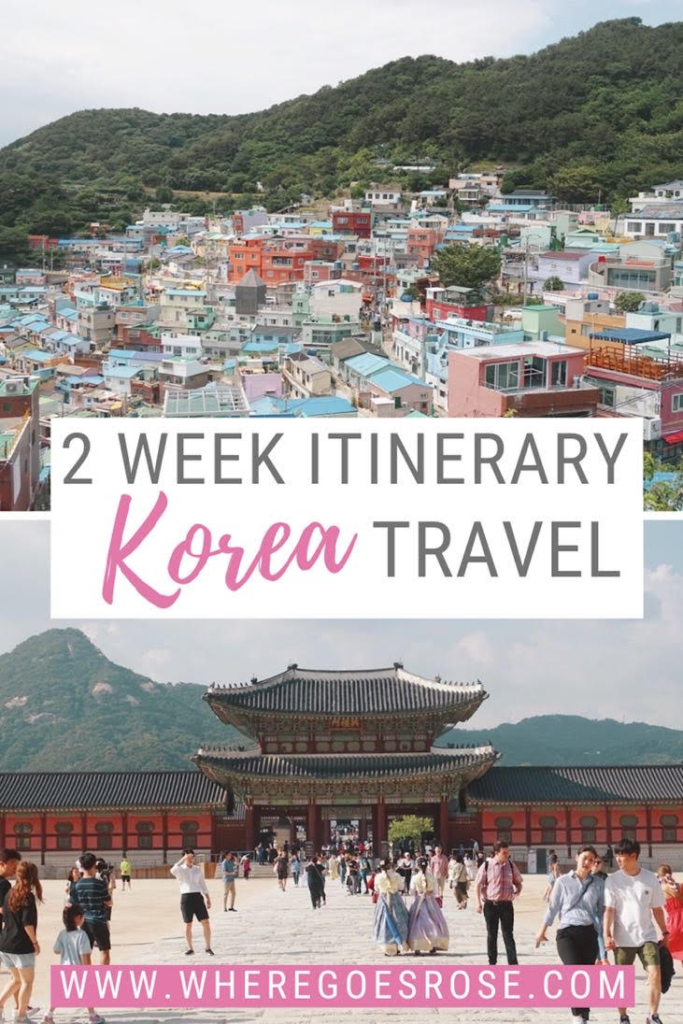
VISITING SOUTH KOREA? These are my trusted resources: Getting around by air – I use Skyscanner to find the best-value flights, using the ‘search by month’ tool to find the cheapest dates. You can also use the ‘to anywhere’ feature if you’re flexible on where you’re going. Buses – buses are comfy and efficient. It’s tricky for foreigners to book online so it’s best to turn up on the day. Trains – use Trip.com , partner of Korail (the official railway network of Korea) to book your tickets in advance. The website accepts international payment options, unlike Korean rail websites. Click the three stripes in the top right corner then the flag to change it to English. Driving in Korea – use Rentalcars.com to compare car rentals. Hiring a car will be especially useful on Jeju Island. For hotels in Korea, I use Booking.com – they also have self-catering apartments. You can filter by review score and price to find the best-rated budget places. For hostels, I use Hostelworld . To save money on accommodation, I use Trusted Housesitters , a website that connects homeowners going away and travellers who can sit their homes & pets. Browse South Korea tours and activities on GetYourGuide . I also check Viator and Klook in case they have a better price. For food tours with passionate local chefs and foodies, check out EatWith . Check out my resources page for more travel discounts and tips!
Rose is a solo traveller from the UK who has been on the road since 2015. She wants to show other women that solo travel isn't scary and doesn't have to be expensive! Rose has lived in Mexico, Canada and all over Asia, seeking out food, bubble tea and street art wherever she goes!
4 thoughts on “ Perfect South Korea Itinerary For 2 Weeks: Best Stops + Tips! ”
Hi! If you don’t mind me asking, how much did you spend for 3 weeks in Soith Korea? I plan to set aside a budget for my dream vacation there. ☺️ Thank you!
Hey Hannah! I spent about £900 in 3 weeks on a backpackers budget. Quite costly! I actually have a budget guide scheduled for next week if you check back on my homepage then!
Hi, I was just wondering if your last stay was on the jeju island, from which Airport did you fly back home? I want to make the similar route that you recommendet. But I’m unsure about from where i should fly back. Because going back to seoul from the jeju island would be elaborate. Even if my last stay would be in busan, would you recommend to fly back from there or take the train back to seoul – to fly back home from there.
I would be glad if you could help me out here 🙂
Hello! I flew return from Seoul then after a couple more days in Seoul, took my exit flight. If doing it again, I might do Jeju in between Seoul and Busan to save travel time. 🙂
Leave a Reply Cancel reply
Your email address will not be published. Required fields are marked *
You can see how this popup was set up in our step-by-step guide: https://wppopupmaker.com/guides/auto-opening-announcement-popups/

Solo Travel South Korea: Your Ultimate Guide
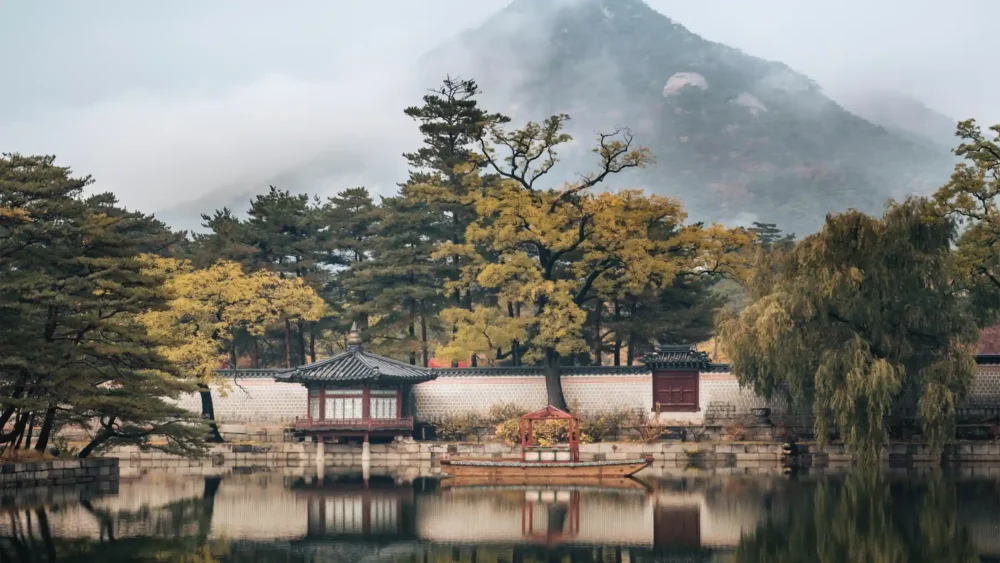
Are you planning a solo trip to South Korea but don’t know where to start? Look no further as we have got you covered with our ultimate guide. From essential preparations and safety considerations to socializing tips and budgeting breakdowns, this guide will provide a comprehensive outline of everything you need to know before embarking on your Korean adventure.
We’ll take you on a gastronomic journey as we introduce the must-try Korean dishes that will leave your taste buds wanting more. Also, we have crafted a perfect seven-day itinerary that covers all the top tourist destinations for solo travelers in South Korea.
So pack your bags, grab your passport, and get ready for an unforgettable experience in one of Asia’s most vibrant countries.
Essential Preparation for Solo Travel to South Korea
Before embarking on your solo travel to South Korea, it’s essential to prepare yourself for a smooth and enjoyable journey. Take the time to research the local culture and customs to ensure you have a respectful and immersive experience.
Familiarize yourself with the efficient public transportation system in South Korea, as it will be your primary mode of traveling across the country. Learning basic Korean phrases can help you navigate potential language barriers and communicate with locals.
Plan your itinerary in advance to make the most of your time and pack appropriate clothing for the weather conditions and planned activities.
What to Pack for Your Korean Adventure
When packing for your Korean adventure, make sure to include comfortable walking shoes to explore the vibrant streets and historical sites. Don’t forget adapters and chargers to keep your electronic devices powered up.
Opt for lightweight and breathable clothing suitable for the climate. Pack travel-size toiletries and a reusable water bottle to stay hydrated throughout your trip. And don’t leave without a sturdy backpack or daypack to carry all your essentials while you embark on your Korean adventure.
Recommended Vaccinations for Travel to South Korea
It is important to check with your healthcare provider regarding routine vaccinations before traveling to South Korea. As a precaution, consider getting vaccinated for hepatitis A and typhoid. If you’re interested, discuss with your doctor the option of receiving the influenza vaccine.
Ensure that your routine vaccinations like measles, mumps, and rubella are up to date. If you plan to visit rural areas or engage in outdoor activities, it is recommended to consider a rabies vaccination.
Safety Considerations for Solo Travelers in South Korea
When traveling solo in South Korea, it is important to prioritize your safety. Be vigilant of your surroundings and take necessary precautions to avoid petty crimes. Keep your important documents and valuables secure at all times.
Stay connected with friends and family, letting them know your whereabouts. Make sure to follow local laws and regulations to steer clear of any legal troubles. Trust your instincts and steer clear of any situations that make you uncomfortable. By staying alert and cautious, you can have a safe and enjoyable solo trip in South Korea.
Optimal Time for Solo Travel to South Korea: A Seasonal Guide
Spring in South Korea, from March to May, offers pleasant temperatures and the stunning beauty of cherry blossom festivals. Travelers can enjoy the mild weather while immersing themselves in the vibrant pink hues of blooming cherry trees. In summer, from June to August, coastal regions beckon with opportunities for beach activities and exploring the scenic shores.
Fall, spanning September to November, showcases nature’s artistic display of autumn foliage against a backdrop of pleasant weather. Winter, from December to February, presents a whole new experience with winter sports, relaxing hot springs, and festive celebrations.
Understanding the Four Seasons in Korea
Spring in Korea brings blooming cherry blossoms and pleasant temperatures. Summer is hot and humid, with occasional monsoon rains. Fall offers cool and crisp weather, perfect for outdoor activities and admiring fall colors.
Winter can be cold, especially in the northern regions, providing opportunities for skiing and snowboarding. Korea’s four seasons offer a diverse range of experiences throughout the year, making it an ideal destination for travelers seeking to immerse themselves in nature’s beauty and experience the unique charm of each season.
Socializing in South Korea: Meeting Fellow Solo Travelers
To meet fellow solo travelers in South Korea, utilize travel apps and websites. Connect with others who share your passion for traveling. Consider staying in hostels or guesthouses that promote social interaction among guests.
Join organized tours or activities to meet like-minded travelers. Explore popular expat hangouts and attend international events. Engage in local activities, such as cooking classes or language exchange programs, to meet both locals and fellow travelers. Expand your network and make new friends while experiencing the wonders of South Korea.
Using Apps and Hostels to Connect with Other Travelers
Enhance your solo travel experience in South Korea by utilizing popular travel apps like Couchsurfing or Meetup. These apps connect you with fellow travelers who are also exploring the country. Additionally, choose hostels that have communal areas and organize social events, such as pub crawls or city tours, to meet like-minded adventurers.
Attend local language exchange events to connect with both locals and other expats or engage in online forums and Facebook groups dedicated to solo travel in South Korea. These platforms provide opportunities to make new friends and create lasting memories.
A Gastronomic Journey: 5 Must-try Korean Dishes
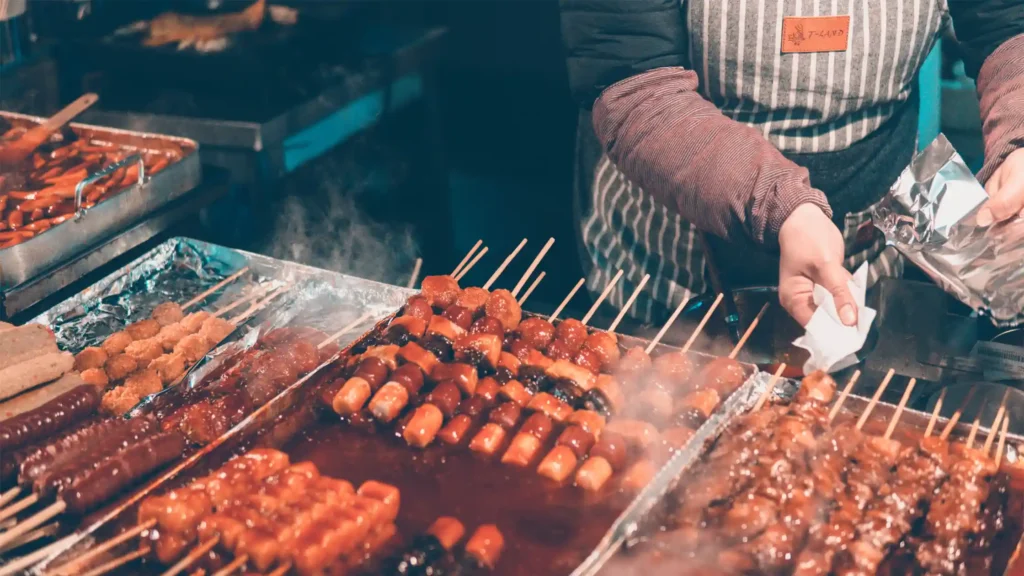
Indulge in the iconic Korean barbecue, where you grill your own meat at the table. Savor the flavors of bibimbap, a rice dish topped with various vegetables and a fried egg. Try the famous Korean street food, such as tteokbokki (spicy rice cakes) or gimbap (seaweed rice rolls).
Delight your taste buds with a bowl of hearty and spicy kimchi stew. Experience the unique taste of Korean fried chicken, known for its crispy and flavorful coating.
Introduction to the Korean Cuisine: Kimchi
One of the most iconic dishes in Korean cuisine is kimchi, a spicy and tangy side dish made from fermented vegetables. It’s a staple in Korean meals and is often served with every dish.
Kimchi is made from various vegetables like cabbage, radishes, or cucumbers, and is flavored with chili pepper, garlic, ginger, and other ingredients. Apart from adding a burst of flavor to any meal, kimchi also offers numerous health benefits due to its probiotic properties. Exploring Korean cuisine without trying kimchi would be incomplete.
The Taste of Seoul: Bibimbap
Experience the vibrant flavors of Korean cuisine in Seoul, where the perfect blend of spicy, sweet, and savory dishes awaits. Indulge in iconic meals like bibimbap and kimchi, and don’t miss out on trying street food delicacies such as tteokbokki and gimbap.
To immerse yourself even further in the local food scene, a visit to Gwangjang Market is a must. Discover the diverse culinary delights that Seoul has to offer and let your taste buds take a trip through the rich flavors of South Korea.
Busan’s Seafood Delight: Eomuk and hotteok
Indulge in the culinary delights of Busan, renowned for its fresh seafood. Get ready to tantalize your taste buds with mouthwatering grilled fish and sashimi. Don’t miss the chance to try local specialties like eomuk (fish cake) and hotteok (sweet pancakes).
Explore the vibrant Jagalchi Fish Market, where you can feast on a variety of seafood dishes. And of course, no visit to Busan is complete without savoring the famous dwaeji gukbap (pork soup). Embark on a gastronomic adventure in Busan, where seafood takes center stage.
Scrumptious Street Food in Itaewon: Korean-style tacos and fried chicken
Embark on an Itaewon street food adventure and indulge in international flavors with a Korean twist. Sample mouthwatering treats like Korean-style tacos and fried chicken.
Satisfy your cravings with delicious bingsu, a shaved ice dessert. Immerse yourself in the vibrant atmosphere of Itaewon while trying diverse street food options. From savory to sweet, Itaewon has something to offer every food lover. Don’t miss the chance to explore this culinary paradise during your South Korea trip.
A Special Treat from Jeonju: Bibimbap and makgeolli
Discover the culinary wonders of Jeonju, the food capital of South Korea. Delight in the traditional flavors of Jeonju bibimbap and makgeolli (rice wine). Experience the unique taste of Jeonju-style kongnamul gukbap (bean sprout soup).
Indulge in a variety of jeon (Korean-style pancakes) in Jeonju Hanok Village. Immerse yourself in the rich culinary heritage of Jeonju through its diverse dishes.
Budgeting Your Solo South Korea Trip: A 7-day Breakdown
Plan your South Korea trip on a budget with this 7-day breakdown. Save money by opting for affordable accommodations like guest houses and hostels. Take advantage of the efficient public transportation system to cut down on travel costs.
Indulge in delicious and pocket-friendly meals at local street food stalls and traditional markets. Discover free or low-cost attractions and activities to make the most of your trip. Enjoy the wonders of South Korea without breaking the bank.
The Cost of Accommodation in Key Korean Cities
For budget-friendly accommodation options in popular Korean cities like Seoul and Busan, consider staying in guest houses or hostels. Another option is to explore Airbnb for unique and cost-effective stays in local neighborhoods. To find the best deal, compare prices and amenities of hotels in different neighborhoods.
Additionally, look out for package deals or discounts for extended stays to save on accommodation costs. By exploring these options, you can find affordable places to stay during your solo travel journey through South Korea.
Transport Costs in South Korea: Getting Around Seoul, Busan, and More
Take advantage of South Korea’s efficient and affordable public transportation system. You can easily navigate Seoul, Busan, and other major cities using the subway and buses. To make your travel even more convenient, consider purchasing a T-money card which offers discounted fares.
If you prefer a more active mode of transportation, you can rent a bike or use shared bikes for short-distance travel. Don’t forget to check out special transportation passes or tourist cards that provide unlimited rides and discounts.
Daily Food Expenses in Korea: From Street Foods to Sit-Down Meals
When it comes to daily food expenses in Korea, you can experience the diverse food scene without breaking the bank. Sample affordable street foods like tteokbokki and kimbap for a quick snack.
Explore local markets for fresh ingredients and affordable meals. Visit traditional Korean restaurants for authentic dining experiences at reasonable prices. And don’t forget to budget for occasional splurges on specialty dishes or Michelin-starred restaurants.
From street foods to sit-down meals, South Korea offers a wide range of culinary delights that won’t burn a hole in your pocket.
Crafting the Perfect 7-day Itinerary for Solo Travelers in South Korea
Plan an unforgettable South Korea trip with a well-crafted 7-day itinerary. Explore Seoul’s cultural landmarks, from Gyeongbokgung Palace to Namsan Tower. Discover the natural beauty of Jeju Island, including Seongsan Ilchulbong and Cheonjiyeon Falls. Immerse yourself in history at UNESCO World Heritage Site Gyeongju.
Experience Busan’s vibrant markets, beaches, and street food scene. With this itinerary, you’ll have a taste of everything South Korea has to offer, from its rich cultural heritage to its stunning landscapes. Get ready for an adventure-filled journey through this captivating country.
A Suggested 7-day Itinerary for South Korea
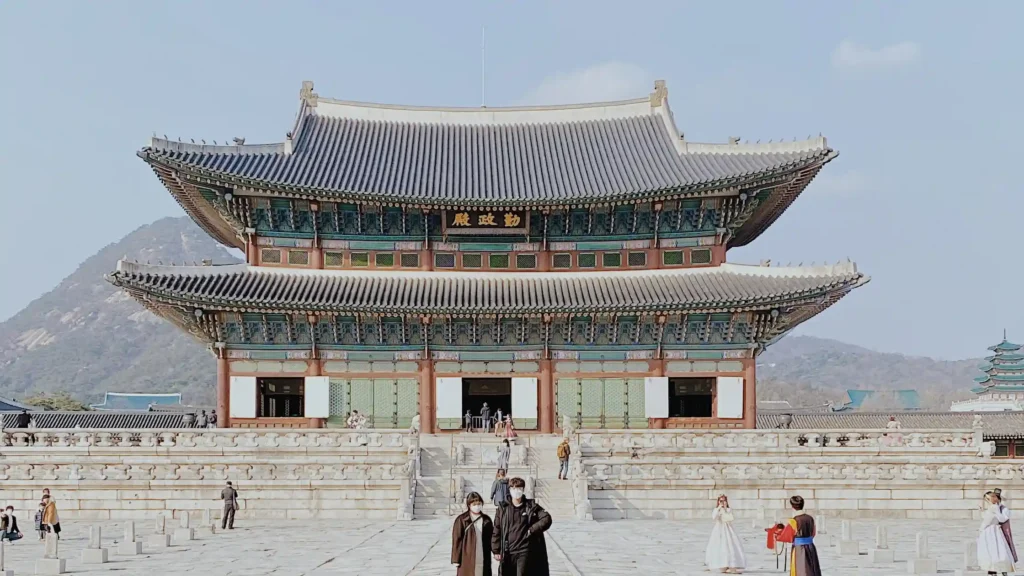
Day 1-3: Exploring the Urban Jungle of Seoul
Start your solo adventure in Seoul by visiting iconic landmarks like Gyeongbokgung Palace. Explore vibrant neighborhoods such as Gangnam and Hongdae, known for their shopping and nightlife. Indulge in authentic Korean cuisine at local restaurants and street food stalls.
Immerse yourself in the city’s rich history and culture with visits to Bukchon Hanok Village and Insadong. Experience the modern side of Seoul at shopping districts like Myeongdong and Dongdaemun. Seoul’s urban jungle offers a perfect blend of tradition and modernity for solo travelers.
Day 4: The Historic Charm of Gyeongju
Explore the ancient tombs and temples of Gyeongju, a UNESCO World Heritage Site. Visit the National Museum of Gyeongju to learn more about the history and culture of the city.
Try some traditional Korean cuisine at one of Gyeongju’s many restaurants. Take a relaxing stroll through Anapji Pond, a beautiful garden with stunning views. End the day with a visit to Bulguksa Temple, one of Korea’s most important Buddhist temples.
Day 5: The Beaches and Seafood of Busan
On Day 5 of your South Korea trip, head to Busan to explore its beautiful Haeundae Beach, known for its pristine sands and crystal-clear waters. After enjoying the beach, treat yourself to some delicious seafood dishes at one of the many seafood restaurants nearby.
Don’t miss the opportunity to visit Dongbaek Island, where you can take a scenic hike around the island and enjoy breathtaking views of the sea. For some retail therapy, check out the Shinsegae Centum City, the largest shopping complex in the world.
Wrap up your day by visiting the Busan Cinema Center, a stunning architectural marvel that hosts film festivals and events throughout the year.
Day 6: The Natural Beauty of Jeju Island
On day 6 of your solo travel adventure in South Korea, immerse yourself in the natural beauty of Jeju Island. Don’t miss out on the top attractions such as Hallasan National Park and Seongsan Ilchulbong. As a solo traveler, consider staying in guesthouses or hostels and rely on the convenient public transportation.
Indulge in the local cuisine by trying dishes like black pork and abalone. Engage in outdoor activities like hiking and beach hopping, while also experiencing the rich culture through visits to traditional villages and attending a traditional tea ceremony.
Day 7: Shopping and Karaoke in Gangnam, Seoul
On day 7 of your solo travel adventure in South Korea, head to Gangnam, Seoul, and immerse yourself in the vibrant atmosphere of this bustling district. Explore the famous shopping district, where you can find everything from trendy fashion boutiques to unique local products.
Don’t forget to indulge in some traditional Korean street food and snacks along the way. For a fun and memorable experience, visit a karaoke room and sing your heart out, just like the locals do.
Make sure to include a visit to the COEX Mall, one of Asia’s largest underground shopping centers. As the day turns into night, embrace the lively nightlife scene of Gangnam, with its trendy clubs and cozy bars.
Making the Most of your Solo Trip: Tips and Tricks
Researching and planning your itinerary is crucial for maximizing your solo trip in South Korea. By doing so, you can ensure that you make the most of your time and visit all the must-see attractions.
Learning some basic Korean phrases and customs can also go a long way in making your trip smoother and more enjoyable. Additionally, consider staying in safe and affordable accommodations like hostels or guesthouses to save money and meet fellow travelers.
Connecting with other solo travelers or locals through social media or meetup groups can enhance your experience and lead to new friendships. Finally, take advantage of South Korea’s efficient public transportation system to explore the country at your own pace and discover hidden gems.
Navigating the Korean Language Barrier: English in South Korea
When traveling solo in South Korea, English may not be widely spoken, but there are ways to overcome the language barrier. Many major tourist attractions have English signage and staff members who can speak some English.
In cities like Seoul, the transportation systems are English-friendly, making it easier to get around. To communicate with locals, consider downloading translation apps or carrying a phrasebook. Additionally, joining a guided tour or hiring a local guide can provide assistance with the language barrier.
Local Customs and Etiquettes for Foreign Travelers
When traveling to South Korea, it’s important to familiarize yourself with the local customs and etiquettes. Bowing is a significant gesture in showing respect in Korean culture. Additionally, it is customary to remove your shoes when entering someone’s home or certain public places.
Gift-giving is a common practice, but it’s essential to understand the proper etiquette and appropriate gifts. Table manners, such as using chopsticks correctly and waiting for the eldest person to start eating, are highly valued. Lastly, remember to dress conservatively when visiting religious or historical sites in South Korea.
What are the Top Tourist Destinations for Solo Travelers in South Korea?
Seoul, with its lively nightlife and historical landmarks, is a popular destination for solo travelers. Jeju Island offers stunning natural scenery and outdoor activities, earning it the nickname “Hawaii of Korea.”
Busan, known for its beautiful beaches and vibrant food scene, is another great option. Gyeongju, the ancient capital of the Silla Kingdom, boasts UNESCO World Heritage Sites like historic temples and museums.
The Historical Significance of Gyeongbokgung Palace
Gyeongbokgung Palace, the largest and most iconic of the five grand palaces built by the Joseon Dynasty, holds immense historical significance. Designed with feng shui principles in mind, the palace is surrounded by mountains and faces a river.
Originally constructed in 1395, it suffered destruction during the Japanese invasion and underwent reconstruction in 1867. Despite further damage during the Japanese occupation, visitors can still witness the palace’s original buildings, including the Throne Hall, the Royal Guard Changing Ceremony, and the National Palace Museum of Korea.
Nightlife and Shopping in Hongdae: A Must-Visit for Solo Travelers
Hongdae offers solo travelers an exciting nightlife experience with a range of trendy bars and underground clubs to choose from. The area is also a shopper’s paradise, with street markets and indie boutiques where you can find unique items and local designs.
Immerse yourself in the artistic atmosphere of Hongdae, with its street performances and galleries showcasing the work of up-and-coming artists. When exploring the area at night, it’s important to take safety precautions and be culturally aware.
Consider staying in budget-friendly accommodations in the Hongdae neighborhood for convenience and affordability.
The Scenic Beauty of Jeju Island: A Paradise for Solo Travellers.
Jeju Island is a must-visit destination for solo travelers, offering breathtaking natural beauty. Explore its stunning beaches, mesmerizing waterfalls, and unique volcanic landscapes. Getting around the island is easy, with various transportation options available, and finding accommodations as a solo traveler is convenient.
Immerse yourself in the local culture and savor delicious Jeju cuisine. As you explore this paradise, always prioritize safety and follow the recommended guidelines for solo travel. Jeju Island truly offers a scenic and unforgettable experience for solo travelers.
To make the most of your solo trip to South Korea, it is essential to plan and prepare accordingly. From packing the right essentials and getting recommended vaccinations to understanding the local customs and etiquette, taking these steps will ensure a smooth and enjoyable experience.
Additionally, connecting with fellow solo travelers through apps and hostels can enhance your socializing opportunities and create memorable experiences. Don’t forget to indulge in the gastronomic delights that South Korea has to offer, from traditional Korean dishes to street food favorites. Budgeting your trip and crafting a well-planned itinerary will help you make the most of your time and resources.
Finally, don’t be afraid to immerse yourself in the local culture and explore the top tourist destinations, such as Gyeongbokgung Palace, Hongdae, and Jeju Island. Solo travel in South Korea can be an enriching and fulfilling adventure that allows you to create unforgettable memories and discover new perspectives.
- South Korea
- A Solo Travelers Guide To...
A Solo Traveller’s Guide to Seoul

The capital city of South Korea is a pulsating metropolis that combines traditional Korean ideals with modern architecture and young neighbourhoods. While it’s often overshadowed by bigger neighbours Beijing and Tokyo, Seoul has recently become one of the hottest cities in East Asia. If you’re planning on travelling to Seoul alone, here are the top places to add to your itinerary.
Thinking of joining a small-group tour instead of going solo? Our 10-day South Korea trip will take you around the country with other like-minded travellers, led by our Local Insider.
The best neighbourhoods to visit in Seoul
Yes, this is the home of Gangnam Style, but it’s not as dorky as you might think. In fact, Gangnam is the most modern district in the city – it was farmland until the 1970s – with Starfield COEX Mall, one of the largest underground shopping malls in the world, expensive high rises and the best plastic surgeons in town. Gangnam is split into several main areas: Cheongdam-dong, home to celebrities and expensive cars; Samseong-dong, home to the Bongeunsa Temple; and Nonhyeon-dong, home to quiet, back-street bars.
Looking for a place to stay? Check out our pick of the best hotels in Gangnam .

If you have an artistic streak, you will fall in love with Insadong. This charming neighbourhood is home to local artists, teahouses, contemporary galleries and boutique shops. It’s the perfect spot for serious souvenir shopping, but you’ll also find historically significant buildings here, including the Unhyeongung Royal Residence and Jogyesa, an important Korean Buddhist temple. Read more in our guide to the best things to do in Insadong .

Shopaholics will faint when they see the seemingly endless arrangement of shops in this part of Seoul. Have you watched any Korean dramas? If so, Myeongdong will look familiar. It’s home to the largest department stores in South Korea, including Lotte and Hyundai, which means foreign shoppers can buy duty-free goods from high-end brands. In the evening, many visitors head to Myeongdong to grab a bite at one of the many local restaurants .
Want more? Browse our pick of the best places to stay in Myeongdong .

Most travellers instantly feel at home in Itaewon: this part of town is the multicultural district of Seoul, home to a vibrant expat community. If you need a break from Korean food, this is the place to find impeccable international restaurants. On top of that, Itaewon also offers lots of nightlife with countless bars and pubs open until the early hours. For an inside take, find out what it’s like to live in Itaewon .

This university neighbourhood is where the cool kids hang. Home to four big schools – Hongik, Yonsei, Sogang and Ewha – it’s no surprise Hongdae is the best place for quirky eats, cheap shopping and thrilling nightlife. If you’ve heard about the themed cafes in South Korea, this is where the idea was born.
If Hongdae sounds like an ideal base for you, take your pick from our roundup of great hotels in the neighbourhood .

Where to stay in Seoul
Insa hostel.

If you’re looking for a budget stay that doesn’t skimp on character, Insa Hostel in the artistic Insadong neighbourhood is the ideal place. Opened in 2013, Insa benefits from being within walking distance of the Gyeongbokgung and Changdeokgung palaces as well as the Myeongdong neighbourhood. The rooms here may be simple, but the rooftop terrace, free breakfast and heated bathroom floors more than make up for it.
Makers Hotel
Brick walls, leather sofas and antique furnishings kit out this boutique hotel in bustling Jongno, the centre of Seoul for 600 years. Upstairs you’ll find stylish rooms with wood-panelling and simple decor; downstairs is the Common Cafe, a mid-century-style space, which serves a continental breakfast. With the metro station next door, there’s easy access the rest of the city.
Fancy a stay? A three-night stay in the Makers Hotel is included in Culture Trip’s carefully curated tour of South Korea , where you’ll explore Seoul and beyond over the course of 10 days.
The Shilla is one of the most sophisticated hotels in Seoul. Regularly voted as one of the top hotels in the world, it emphasises the harmony between modernism and tradition through elegant design and high-end facilities, which includes a luxurious spa, five restaurants and even a Korean sculpture garden. It has a peaceful setting on the outskirts of the city centre, but a free shuttle service will keep you connected to the sites.
Where to eat in Seoul
Mapo sutbul galbi.
Koreans love BBQ. It’s more than just food: it’s a whole social ritual with friends and drinking. One of the best places to grab galbi (meat), is Mapo Sutbul Galbi. This family-owned place is best known for its marinated beef and pork and is one of the only places in town that uses plums in their marinade – giving the meat a sweet taste.

Even though Korean cuisine is relatively meat heavy, vegetarians won’t starve. One of the top addresses for first-class veggie food in Seoul is Sanchon . This restaurant was founded by a Buddhist monk and offers set meals with more than 20 dishes prepared to Buddhist standards. If you’re visiting in the evening, you’ll experience the daily Korean dance performance at 8pm.
Myeongdong Kyoja
Myeongdong Kyoja specialises in chicken kalguksu (noodle soup), served with sliced pumpkin, spicy onions and a unique kimchi that is the pride of the restaurant. This outlet has been serving customers in the Myeongdong neighbourhood for more than 50 years – its popularity is down to the outstanding hospitality: if you’re still hungry, just ask for a free refill.
What to do in Seoul
Visit the demilitarised zone (dmz).
Many visitors like to get in touch with South Korean history. If that’s you, take a day tour up to the DMZ between North and South Korea, where the Cold War is still very much in existence. The zone is about 250km (155mi) long – head to the Joint Security Area (JSA) near the western end to head down the Third Infiltration Tunnel, try North Korean liquor and get a glimpse of the isolated nation.
Climb Bukhansan
South Koreans love hiking. With the staggering number of mountains and national parks in the country, it’s no wonder why. But don’t worry, you don’t need to travel far outside the Seoul borders to climb one of the most beautiful mountains in Korea. When you reach the top of Bukhan Mountain, to the north of the capital, you will be rewarded with breath-taking views of the city skyline.

Explore Gyeongbokgung Palace
Central Gyeongbokgung was the main palace during the Joseon Dynasty. Built in 1395, it is the largest of the Five Grand Palaces of South Korea, with some 500 buildings and 7,700 rooms. Gyeongbokgung has been undergoing extensive restoration since the 1990s, and is today the most visited attraction in South Korea, hosting various events throughout the year.

Wander the narrow streets of Bukchon Hanok Village
Travel back in time in Bukchon Hanok Village. Featuring a collection of 600-year-old Korean houses, this traditional village is filled with teahouses, coffee shops, restaurants and boutique stores. Take a stroll through the narrow alleys; you can even wear traditional Korean hanbok dresses for unforgettable holiday photos.

Take photos in Gwanghwamun Plaza
Facing Gwanghwamun, the main gate of Gyeongbokgung palace, is its eponymous plaza. This area offers superb photography opportunities in the evening when the sun sets in the distance behind the main gate. The square also features a large statue of Sejong the Great, considered one of the most important kings in Korean history as he created the Korean alphabet Hangul.

Practical tips for visiting Seoul solo
Getting around.
Seoul has a convenient network of affordable subways and public buses that are easy to use. Taking certain subway lines during rush hour can be quite nerve-wracking though – this might be the perfect time to take an Uber. South Korea also has its own version of the convenient dial-a-ride service called Kakao T, which is also widely used.
Health and safety in Seoul
It is not recommended to drink tap water in Seoul unless it’s been boiled, but don’t shy away from trying street food as South Korea has a rich foodie culture. Locals love snacking on the go and you can best experience Korean flavours when out and about. South Koreans are extremely relaxed and it’s not uncommon to leave your camera on the table while ordering coffee or to give the waiter your phone to charge it for you – this level of trust makes South Korea a safe place to travel alone.
Solo travel doesn’t have to be an entirely lonesome affair. Join Culture Trip’s 10-day South Korea adventure for the chance to experience Seoul and beyond with a small group of travellers who are as culturally curious as you are.
Did you know – Culture Trip now does bookable, small-group trips? Pick from authentic, immersive Epic Trips , compact and action-packed Mini Trips and sparkling, expansive Sailing Trips .
Since you are here, we would like to share our vision for the future of travel - and the direction Culture Trip is moving in.
Culture Trip launched in 2011 with a simple yet passionate mission: to inspire people to go beyond their boundaries and experience what makes a place, its people and its culture special and meaningful — and this is still in our DNA today. We are proud that, for more than a decade, millions like you have trusted our award-winning recommendations by people who deeply understand what makes certain places and communities so special.
Increasingly we believe the world needs more meaningful, real-life connections between curious travellers keen to explore the world in a more responsible way. That is why we have intensively curated a collection of premium small-group trips as an invitation to meet and connect with new, like-minded people for once-in-a-lifetime experiences in three categories: Culture Trips, Rail Trips and Private Trips. Our Trips are suitable for both solo travelers, couples and friends who want to explore the world together.
Culture Trips are deeply immersive 5 to 16 days itineraries, that combine authentic local experiences, exciting activities and 4-5* accommodation to look forward to at the end of each day. Our Rail Trips are our most planet-friendly itineraries that invite you to take the scenic route, relax whilst getting under the skin of a destination. Our Private Trips are fully tailored itineraries, curated by our Travel Experts specifically for you, your friends or your family.
We know that many of you worry about the environmental impact of travel and are looking for ways of expanding horizons in ways that do minimal harm - and may even bring benefits. We are committed to go as far as possible in curating our trips with care for the planet. That is why all of our trips are flightless in destination, fully carbon offset - and we have ambitious plans to be net zero in the very near future.

Health & Wellness
7 dreamy detox destinations in south korea.

Guides & Tips
Understanding the bangs of south korea.

Food & Drink
Five dishes from around the world you should try with culture trip.

The Most Amazing Cooking Classes You Can Take With Culture Trip


See & Do
A guide to outdoor adventures across korea.

Top Culinary Trips to Take in 2023

The Best Places to Travel in August with Culture Trip

The Ultimate Guide to Travel in Korea

How Going on a Korean Templestay Will Help You Find Your True Self

Places to Stay
The best hotels to book in south korea for every traveller.

The Solo Traveller’s Guide to South Korea

Why Foodies Should Get to Know Korean Temple Cuisine
Culture trip spring sale, save up to $1,100 on our unique small-group trips limited spots..

- Post ID: 1036492
- Sponsored? No
- View Payload

The Ideal 2 Week South Korea Itinerary For Women over 50 (2023)
The perfect korea itinerary for solo female travelers over 50.
Imagine someone giving up their subway seat so two friends can sit together. Or leaving your room unlocked or your luggage out of sight on a train – without worrying it might disappear. Or a bus driver bowing before driving off – and he might even be wearing white gloves.
You’d be in South Korea, of course!
I took a two-week solo trip to Korea and discovered a land of near-unbelievable contrasts. What follows are the highlights of my Korea itinerary. This is a perfectly do-able trip to take on your own if you’ve traveled a bit abroad, but if not, there are plenty of day tours (and longer tours) you can take – I’ll deal with those later as well.
2 week South Korea itinerary
This itinerary covers my two weeks in South Korea travel itinerary. It was a solo trip, for which I made all my own arrangements.
I found two weeks was the perfect trip length for my type of travel − I like to take my time at each destination rather than see more places but less in depth. You can visit Seoul in a couple of days and manage a couple of other cities in a week, if you must. But I would suggest a minimum of 10 days in South Korea if you want to see a bit of the country.
Seoul: Days 1-6
Day 1: myeongdong and namsan tower.
- Morning: Arrive in Myeongdong for shopping and street food
- Evening: Take a cable car to Namsan Seoul Tower for panoramic city views
Day 2: The House of Sharing and DMZ Tour
- Morning: Visit The House of Sharing, a museum and home for “comfort women”
- Afternoon: Embark on a DMZ tour to explore the world’s most dangerous border
Day 3: Noryangjin Fish Market and Itaewon
- Morning: Visit Noryangjin Fish Market for fresh seafood
- Afternoon: Explore Itaewon, an international district with diverse cuisines
Day 4: Korea Food Tours and Bukchon Hanok Village
- Morning: Join a food tour for a culinary adventure
- Afternoon: Wander through Bukchon Hanok Village’s traditional Korean houses
Day 5: Euljiro Walking Tour
- All Day: Take a walking tour of Euljiro to learn about Korea’s rapid industrialization
Day 6: Gyeongbokgung Palace and Gwangjang Market
- Morning: Visit Gyeongbokgung Palace, the main palace of the Joseon dynasty
- Evening: Explore Gwangjang Market for Korean blood sausage and other local delicacies
Beyond Seoul: Days 7-14
Day 7-8: busan.
- Day 7: Travel to Busan via bullet train; visit Haeundae Beach, and go to Shinsegae Centum City (relax in Spa Land)
- Day 8: Explore Jagalchi Fish Market, and visit some of Busan’s temples
Day 9-11: Gyeongju
- Day 9: Arrive in Gyeongju; visit Bulguksa Temple
- Day 10: Explore the city’s tumuli and historical sites
- Day 11: Visit Anapji Pond at dusk for cherry blossom views
Day 12-14: Jeonju
- Day 12: Arrive in Jeonju; explore its traditional hanok village
- Day 13: Sample local cuisine, from dumplings to noodle soups
- Day 14: Return to Seoul
I chose to go to Busan because I was hunting for cherry blossoms. But if you’re pressed for time, you could travel to Jeju Island instead of Busan.
Getting to Seoul
My first brush with the modern miracle that is today’s Korea was at Incheon International Airport. Huge lines advance smoothly, everyone stepping up in an orderly fashion. When I visited, you could fit your soles onto the footprints thoughtfully painted on the floor for you (in case you might be tempted to jump the queue into the arms of the border police). I don’t know if the footprints are still there…
You can get your ticket for the Arex Incheon Express to Seoul Station here . You’ll receive a voucher, which you’ll have to redeem at the Express Train Ticket Vending Machine at the airport.
Best Places to visit in Seoul: A 6-day Seoul solo travel itinerary
And now, Seoul. Physically, the city sits in a bowl surrounded by eight mountains and bisected by the Han River. Most walking takes place on hills and my apartment in Seoul required me to walk up a steep hill, climb 50 or so steps, walk up a smaller hill and gasp my way through another three flights of stairs. Calf muscle issues? Visit Seoul. You’ll be Wonder Woman in no time.
Seoul solo female travel is, most of all, a seemingly inexhaustive source of fun and inspiration. I roamed, hopping on and off buses, exploring distant subway stations and discovering neighborhoods. I also took some half-day or day tours to maximize my time.
BEST SEOUL DAY TOURS
- Seoul: City Hightlights, Palace Tour, and Optional Hanbok
- Seoul City Night Tour
- Full-day cultural tour outside Seoul
If you need a more specific Seoul itinerary, and are looking for the best things to do alone in Seoul, here are just a few of the things to do in Seoul on your own (this list is anything but exhaustive):
- Myeongdong Market (located in the Myeongdong shopping district) is my idea of the perfect street market, clothes and shops in daytime and foodie fair as soon as the sun begins to set. Any solo travel Seoul itinerary worth its salt should include a visit to this lively place. The market is known for its cosmetics shops (Korean cosmetics have a worldwide reputation and draw local and foreign shoppers.)
- Namsan Seoul Tower , also known as the N Seoul Tower, is the highest point in the city and is best visited at night, after a quick cable car ride. The mountain it caps has been ringed with hiking trails and during the day, the hike is well worth it. Partway up is a wonderful traditional restaurant which serves magnificent scallion and squid pancakes.
- The House of Sharing is part-museum and part-retirement home for “comfort women”, kidnapped or forced by the Japanese into military brothels during World War II. Now elderly, the handful who remain keep the memory of their tragedy alive, waiting for a proper apology from Japan.
- A DMZ tour , or the Korean demilitarized zone , is the one adventure I hugely regret not having experienced. The DMZ splits Korea into North and South and has been called the world’s most dangerous border. I had reserved well ahead of time, but it was at the height of the war of words between Washington and Pyongyang, so the military administration cancelled all visits at the last minute that day. I was refunded, but hugely disappointed.
- Noryangjin Fish Market is one of Seoul’s signature sights, with fish so fresh it is still – alive. Go around lunchtime or you’ll be in the same boat I was: eyeing raw fish for breakfast. I normally love it but even I couldn’t face it pre-coffee… If you’re an early riser (3 a.m.!) you’ll catch the famous fish auctions. Just wear good walking shoes because the floors are wet and slippery.
- Itaewon is an expat enclave so international you feel you’re crossing a border each time you cross a street. There are many things to do in Itaewon . Its Muslim Quarter’s halal eateries and pilgrimage tour agencies “approved by the Kingdom of Saudi Arabia” give it a powerful oriental atmosphere but down the hill, other familiar smells fight for attention – pizza, burgers and fried chicken.
- Korea Food Tours is a small company with several tours – I ate an extraordinary BBQ (and a few other delicious things). Highly recommended if you don’t know where to eat on your solo trip to South Korea. Find even more food-related tours!
- And finally, here’s a one-week Seoul itinerary as an alternative.
BUKCHON: A HIDDEN VILLAGE FOR YOUR SEOUL ITINERARY
by Rebecca Binge
One of the unique things to do in Seoul, and one of the most enlightening things to do in Korea alone, is tucked away in the Samcheong-dong neighborhood: Bukchon Hanok Village (hanoks are Korean traditional-style houses). The village dates back more than 600 years when high-ranking officials of the Joseon Dynasty settled here.
Hanok architecture consists of smoky gray tiled roofs, slightly curving upward at the outer corners. Many of the homes are painted a bright white, decorated by wooden beams or layers of brick along with the bottom halves.
Bukchon is located uphill so the legs definitely get a workout, but one that’s much better than the gym. There are numerous alleyways to get lost in. (Besides, the added bonus of getting lost on your solo trip to Seoul is that one usually stumbles upon a good photo opportunity!)
Bukchon Hanok Village can easily be found by taking subway line 3 and getting off at Anguk Station. Look for exit 2 as you make your way out of the station. When you reach the top of the stairs walks straight for several minutes. There are also signs that will direct you towards the village.
In a metropolis filled with neon lights, lofty office buildings, and haggard workers, wandering through an area like Bukchon reminds me of simpler days in Korea’s past.
How to get around Seoul
Seoul travel is straightforward. The easiest way to get around on your Seoul travel itinerary is a Discover Seoul Pass which gives you access to some 35 museums and historical sites completely free (and a discount for more), relaxation and entertainment facilities, free passes for various transportation options, and even shopping discounts. You’ll definitely save money on individual sights. Given the distance between some of the sights, you’d need at least two days to see them.
A rechargeable T-money card , which you can purchase at any convenience store or station, whisks you into subways and buses. Stops are (usually) announced in English and, bless them, subway stations have toilets, cleaner than those of most Western department stores.
The transport networks are extensive and rarely will you be beyond public transit’s reach. Just be forewarned: you’ll be doing a lot of walking. Seoul is built on hills and while there are plenty of subway and bus stops, you may still be blocks away. Traveling to Seoul alone, I walked an average of 12km a day, without trying.
The city offers some free walking tours – and they were brilliant. Volunteer guides really know their stuff, and often, because of their language capabilities, they may present your only opportunity for in-depth conversation with Koreans.
Like most cities these days, a hop-on hop-off bus will take you to most places to visit in Seoul. I took the tour but wasn’t particularly impressed. Traffic doesn’t always make it easy to get around, the commentary isn’t particularly informative. If you’re only in Seoul for a day or two, it might be worthwhile for a quick overview. Otherwise, get a guidebook and a T-money card for the bus and subway.
Beyond Seoul: fabulous places to visit in South Korea
Planning a solo travel Korea itinerary can be a challenge for those of us not familiar with Asian languages. Korean names can sound remarkably similar and were it not for a common English spelling of place names, I would probably have ended up on the wrong train often.
In addition to six days in Seoul, my 2 week South Korea itinerary took me to three cities in eight days, as I prefer to see fewer places but see them in greater depth.
One thing I kept noticing from the train is the mountainous nature of the country and the resulting population density in the lowlands. Korea is crowded!
Solo travel Korea: Train to Busan
“Train to Busan” may be the title of a popular Korean horror movie, but there’s nothing horrific about using the railway in South Korea, on the contrary. If you want to avoid the train station ticket buying hassle, get your train pass before you go .
Heading south from Seoul on the bullet train to the coastal city of Busan, highrises appeared to leap out of the fog, there one minute, gone the next. The train ride, by the way, is far smoother than those of its European counterparts. It’s also better protected, with safety barriers along the route: worse view, but better security.
Busan is South Korea’s second-largest city, stunning in its beachside setting (don’t miss Haeundae Beach if you go there in the summer) and the subject of glorious photographs. I was there in the rain, which in no way altered my enjoyment. I just visited it differently: I walked in the rain (and searched in vain for cherry blossoms).
I visited the world’s largest department store , Shinsegae Centum City, and spent the afternoon lazing in Spa Land: 22 spring-fed pools of different temperatures and 13 types of sauna, ideal for Busan in the rain. I sampled them all – naked, as one does in Korea (but beware – the sign says no tattoos allowed!)
A short but sweet Gyeongju itinerary
Next stop, the historical city of Gyeongju , nominated a couple of years ago by Lonely Planet as one of the top 10 cities in the world to visit. It is also known as the “museum without walls” and famous for its unusual tumuli , or tombs shaped like grass mounds. These are disconcertingly spread throughout town, with streets winding around them.
I enjoy temples and spent time at the fabulous Bulguksa, climbing its many stairs.
One evening I walked to nearby Anapji Pond. I’d heard it was ‘pretty’ but nothing prepared me for the slow settling of dusk mirrored against the bright pink of the spring cherry blossoms – yes, bountiful blossoms at last (cherry blossom season in late March/early April is the best time to visit South Korea!) Clearly, this was a famous sight, as romantic couples and entire families jostled one another for selfies against the flickering lights. (Here’s a three-day Gyeongju itinerary if you’d like to spend more time.)
Food for the soul in Jeonju
My third and final stop was the city of Jeonju , a UNESCO gastronomic city so of course, I spent several days there, ‘researching’.
Its centerpiece is a traditional hanok village but unlike Bukchon, where people still live, Jeonju’s have become guest houses and restaurants. I enjoyed staying in one – the room was smaller than my closet at home and I slept on a mat on the heated floor. Falling asleep was wretchedly painful (I found beds generally uncomfortable everywhere) BUT I woke up more refreshed than ever after the mat episodes. I have no idea what magic occurs down on that floor, but it works.
Jeonju’s food kept its promises except for a single plate of overly doughy fried squid. As for the rest, I leapt from dumpling to dumpling, noodle soup to noodle soup, and skewer to skewer. Time flew.
ALSO TRY IN KOREA
- Korean BBQ – you’ll find it all over the country
- Gyeongju bread, only available in Gyeongju – a pastry with bean paste inside
- Sundae, Korean blood sausage. You’ll find the best in Gwangjang market in Seoul.

Street foods to eat during your South Korea trip (Must-try in Seoul)
There’s such variety in the street food that after two weeks of solo travel in Korea, I still hadn’t tested everything (though I did try!) Koreans do plenty of socializing around food, much as Europeans would meet for a cup of coffee, so it’s no surprising there are so many eateries of every kind.
Walking the streets of Myeongdong Market was an education in Korean street food.
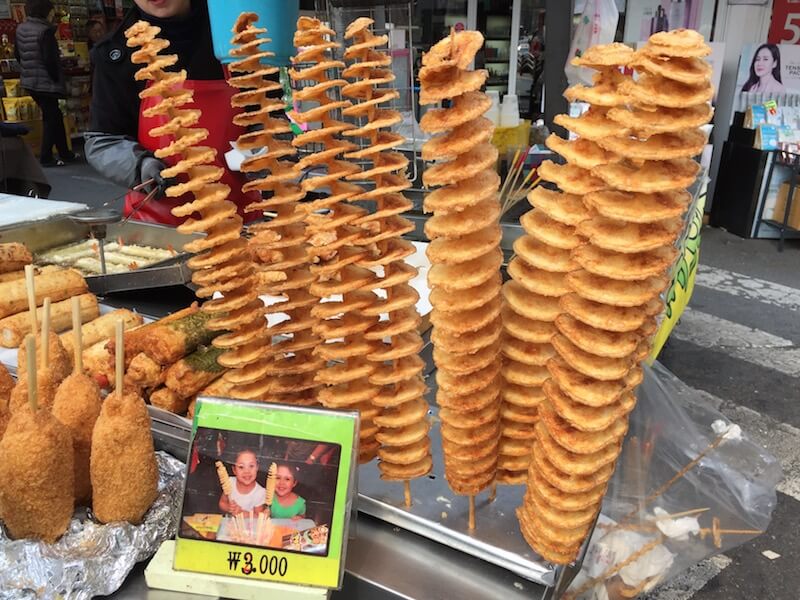
Koreans love sugar, which manages to find its way into everything, including unusual dishes like pasta or egg salad. Allegedly, the sugary kick enhances the savory and umami flavors of other ingredients, so a pinch of sugar is added to meat roasts, sandwiches, stir-fries, hot pots, and the alike.
Most noticeably, Koreans love spicy food. From supermarket cup noodles to kimchi, their traditional fermented veggie dish, hot food is everywhere you look. Koreans do pride themselves on having the spiciest food, but Indian food beats Korean when it comes to calling the fire engine!
Cheese, too, is hugely popular and goes on everything…
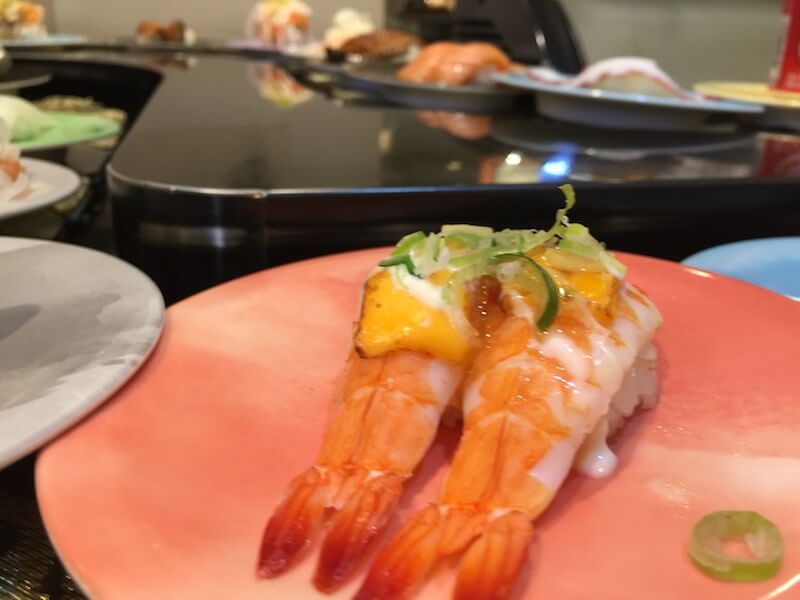
Much as I love street food, I also enjoyed sit-down meals. One of my favorites was bulgogi, a pork hot plate with hot spice and vegetables – and a bit of sweetness. Seafood is plentiful, as you’d expect in a country bordered on three sides by water. Gwangjang Market in Seoul is known for its silk goods and vintage clothes during the day, but in the evening it turns into a seafood city, with raucous communal tables filled with laughter and conviviality.
I was relieved to discover coffee is a local addiction with a coffee shops on every street corner. I was less relieved to get the bill: between $4-$11 for a cappuccino, depending on whether I was desperate for that extra espresso shot or not.

IF YOU’RE A FOODIE… TRY THESE CLASSES AND TOURS
- Cook 3 Authentic Korean Dishes with Local Market Tour
- Korean Cooking Class with Full-Course Meal & Local Market Tour in Seoul
- Seoul: Palace, Temple and Market Guided Foodie Tour at Night
- Korean Food Tours BBQ Night Out
South Korea – Risen from ashes
Built on the rubble that was once Seoul, the capital is now a world-class metropolis. Much of South Korea’s success today – Samsung, Hyundai, LG, Daewoo – dates to the aftermath of the Korean War, which killed millions and destroyed the country’s infrastructure, leaving it one of the world’s poorest countries.
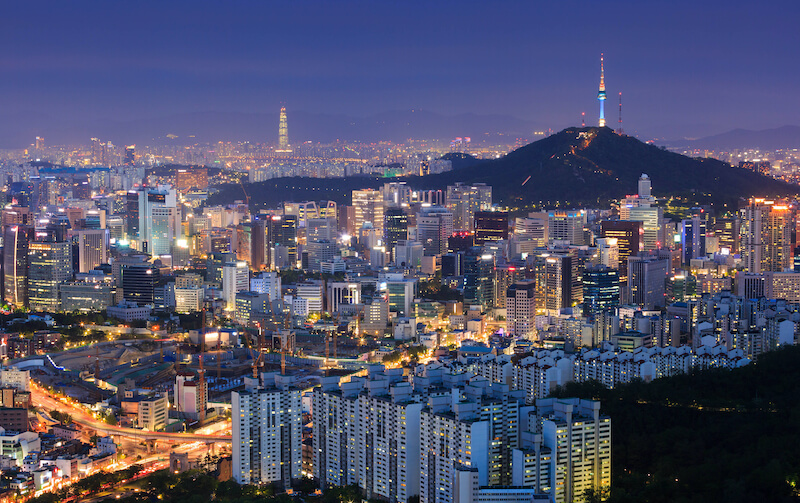
It’s hard to conceive of Seoul as a flattened city, from which 90% of the population fled and whose remaining 10% often scavenged for food.
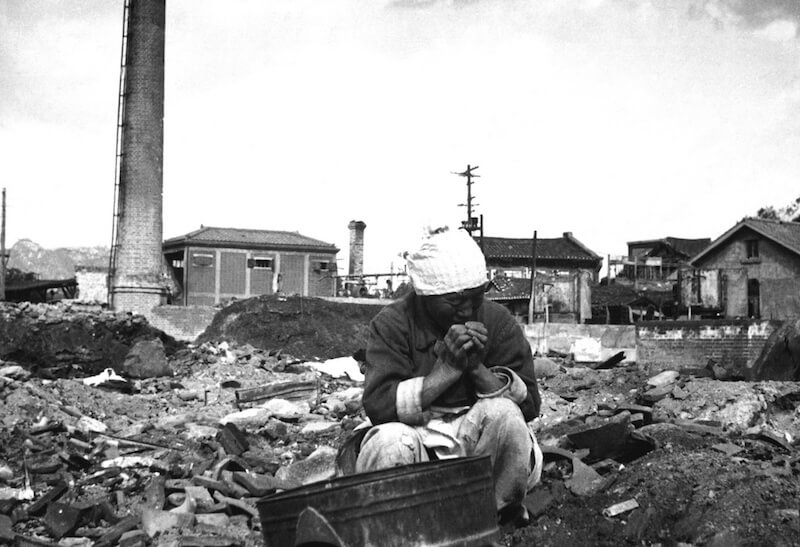
The country is changing rapidly but is intertwined with its traditions. Women, for example, have more rights than they could have imagined a generation ago yet respect for families, especially older male relatives, still governs many interactions. While traditions are strong, Korea is more modern every day – its connectivity and recycling policies could put most countries to shame.
Yet the one constant that permeates Korean life is history. Old people still talk with anger about the Japanese occupation a century ago, yet few pay much attention to the nasty words bandied about between North Korea and the US, even though Seoul is right in the line of fire.
They’ve heard it all before.
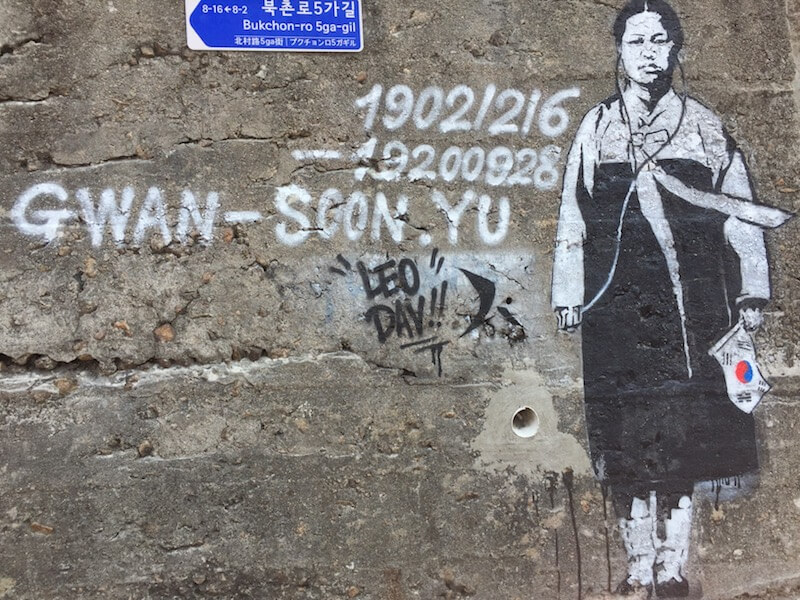
Facts about South Korea culture and traditions
Understanding any aspect of Korean culture was sadly a superficial exercise: I don’t speak the language, and I had no local Korean friends to put things into context for me. Still, there was plenty to observe and some obvious traits that required little translation or explanation:
- I found Koreans to be considerate, always thinking of others . All I had to do was stand around with a map looking a little lost and someone would inevitably stop to help. People gave me their seats on public transport, possibly because they sensed I was older, and they appeared to be constantly scanning the crowd to understand everyone’s place in it. It’s as though people want to take care of you and make sure nothing goes wrong. At a table, it’s not unusual for a neighbor to lean over and offer you a piece of food or a glass of rice wine.
- Koreans’ traditional Confucian respect for older people (see above) manifested itself in many ways. The most striking was during a demonstration, when an older man began yelling at an armed policeman who strode over firmly, making me cringe. I expected at least a truncheon but no: the younger officer gently took the man by the arm, smiled at him and began talking in a soothing voice. He slowly directed him away from the crowd, calmed him down, and eventually steered him towards a metro station entrance. I was amazed and elated at this absence of force.
- Koreans give a strong impression of being perfectionists and that may prevent them from admitting they speak English unless they speak it perfectly. Over and over I met people who claimed not to speak it or very little – yet they were nearly fluent. A bit shy about their language abilities, when approached in English their initial reaction appeared abrupt yet once we established contact, words flowed.
- If there’s one cultural quirk that really turned my head was the addiction to anything ‘cute’. Dogs were dressed in frills, large stuffed toys sat on the serious bank or legal desks, couples wore matching shoes or T-shirts, and pink was greatly in favor, all part of an extremely lucrative ‘Kidult’ culture. However, I’m told by Korean friends that styles have simplified in recent years, with a preference for more muted colors and less bling…
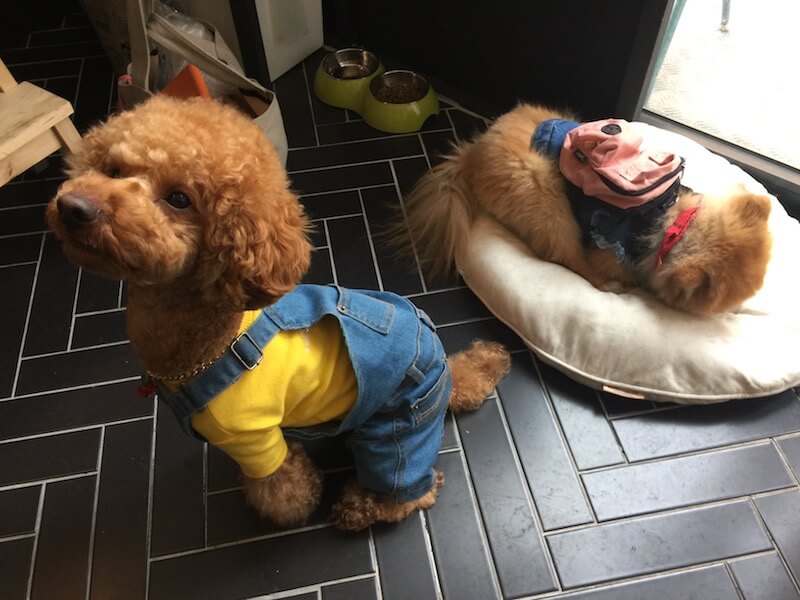
- A disconcerting trait is the emphasis on physical beauty – and not just women. There is plenty of mirror-checking and iPhone camera gazing (with the camera turned around to face you, of course). It’s no surprise Seoul is the world’s plastic surgery capital, and as many as half of women in their twenties having had something done to their faces. This phenomenon might explain why there are so many face masks around – for health and pollution, certainly, but convenient for hiding those telltale bruises. About 15% of surgery patients are men, who also make up a large proportion of those who buy beauty products.
- It’s also apparently acceptable – or at least tolerated – for men to visit high-end ‘hostesses’. A hotel parking lot near my room in Seoul was filled with expensive cars at lunchtime. More telling, their spa was closed to female guests, who visited another one next door…
- I noticed students rushing to class at all hours, from dawn until well past what should have been their bedtime. Emphasis on education is immense and parents will do almost anything to make sure their offspring get into the right schools, which lead to the right jobs and spouses. The poverty of the past is very much present in people’s minds and getting ahead is the answer to leaving all that behind. Some believe the country’s suicide rate – one of the world’s highest – may be due to this pressure to excel intellectually and socially, and to physically conform to norms of beauty.
- If you go on your Korea trip with your partner or spouse, keep away from excessive physical affection in public. Hugging and kissing in the streets or transport is generally considered rude. Paradoxically, you may notice more hand-holding and physical affection (what Koreans call “skinship”) among same-sex friends, especially men, than you would in the West.
6 THINGS TO KNOW WHILE TRAVELING IN SOUTH KOREA
1. Mirror, Mirror on the Wall The outer appearance is a high priority to Koreans. According to the International Society of Aesthetic Plastic Surgery, South Korea is the country with the world’s highest per capita rate of cosmetic plastic surgery. In fact, it’s become common for parents to offer plastic surgery to their daughters as a graduation gift. As a result, mirrors are abundant: near restaurant entrances, inside elevators, and on the phone in the subway.
2. Shoppers’ Paradise in Seoul For those in need of some retail therapy, Seoul is the shopping mecca in South Korea. Various neighborhoods offer a wide range of items to those in search of the perfect Korean memorabilia. For a truly unique shopping experience, Namdaemun Market is the perfect shopping adventure. Stalls and stores sell practically everything: clothing, jewelry, home furnishings, toys….the list is endless!
3. Apartment Eyesore In both cities and suburbs, you will notice clusters of high-rise apartment complexes dating from the Korean War. Most are unsightly, about 20 stories high, usually off-white, with tan or grey added for a splash of color. Still, they have become popular with families because of all the nearby conveniences, like shops or schools.
4. The Spirit of Soju The national alcoholic beverage that accompanies any Korean barbecue is soju, traditionally made from rice. It also can play a bonding role in forming a business and social relationships. Also, Korean drinking etiquette consists of pouring drinks for others (particularly seniors at the table) before refilling your own cup. Remembering this polite gesture makes for an enjoyable dining atmosphere for all.
5. Bathroom Basics Even though there are Western-style toilets, in many public restrooms you will stumble upon the squat toilet. Upon squatting, make sure the tips of your shoes line up with the front of the porcelain. Also, it helps to have a good balance when using one! In older buildings, you will find the toilet paper dispenser located just outside of the restroom entrance. Grab enough before entering a stall.
6. Perplexing Politeness Be prepared for a bewildering mix of both polite and pushy behavior among Koreans. When browsing in a department store, be prepared for the numerous sales assistants. However, if you’re boarding a subway or a bus watch out for the ajummas, or older Korean women, known for being pushy when trying to grab a seat on subways or buses.
South Korea travel tips
How safe is a trip to south korea in 2023.
If it weren’t for the unpredictability of North Korea-US relations, this would easily qualify as one of the safest destinations for women – anywhere. South Korea solo female travel is not to be feared but on the contrary, to be embraced.
Despite the country’s low crime rate and the absence of major incidents recently, it is difficult to forget that South Korea’s (until now) sworn enemy, North Korea, lies armed to the teeth just half an hour away and to the South, even more heavily armed, is South Korea and a strong US military presence.
Which month is best to visit South Korea?
I arrived solo in Seoul towards the end of March, possibly the best time to visit Korea, during cherry blossom season. I had planned a two-week South Korea solo travel itinerary and chose to split it between the capital city and the rest of the country. South Korea is the size of England, or of Kentucky, whichever means more to you, so it’s large enough to merit time, but not so huge it’s overwhelming.
I had one goal in mind: hunting down cherry blossoms because it’s a season I’d never experienced.
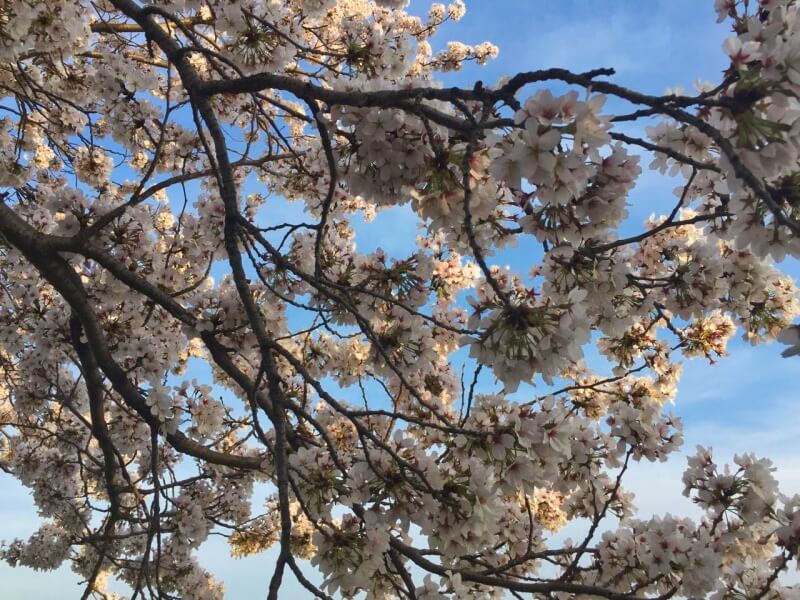
How to get around South Korea outside Seoul
The train system is excellent and I never got lost… If you plan on visiting the country, I recommend you get a Korea Rail Pass for 2 or more days.
Communication is as important as transportation and without speaking a word of Korean, you’ll need all the help you can get. My help came in the form of the Google Translate app (I heard great reviews about the Korean app Naver Papago too), without which I would have been sealed in a bubble throughout my solo trip to South Korea. I either spoke into my phone or typed my questions but the Korean output was perfect – at least I got what I needed and no one looked insulted by what appeared on the screen.
I bought a SIM card at the airport as soon as I landed. There are stalls all over the place. I paid for unlimited data for $75 for a month but there are far cheaper options. Data speed is high so the investment was well worth it. Next time, I’ll save myself time and money by ordering a pre-paid SIM card . If you’re phone is locked and you can’t change your SIM card, you can rent a pocket wifi device you can pick up from (and return to) the airport.
Here’s a tip: whenever you leave a place, get someone to write your next destination in Korean on a piece of paper you can hand to a cab driver (taxis are inexpensive, I took many of them) or a person on the street – simple things like “intercity bus station” or “where is the restaurant” … Better yet, you can spend a little bit of time ahead to learn to read and write the Korean hangul alphabet – it’s simpler than it looks!
And no, I didn’t see any cherry blossoms in Seoul – I was perhaps a week early, and the weather had suddenly turned cold. But I didn’t despair…
SOUTH KOREA QUICK FACTS
- Currency: KRW – Korean Won
- Language and script : Korean. The hangul script (한글) is considered one of the simplest writing systems: you can learn to read it in just one day. You may not understand the language, but it can help read the map, the names of stores and stations, and much more.
- Must-have Apps : Naver Map or TMAP (similar to Google Maps, but Korea-specific) and Kakao Talk (originally a chat app, Kakao is a huge company that now offers taxi services, food delivery, and so much more)
- Public transportation : T-Money Card – available at most convenience stores
- Chargers for your electronics: Plugs C and F at 220 V
How many days do you need to visit Korea?
For some reason, people recommended two or three days for a Seoul solo trip. It depends.
I spent a total of 2 weeks in South Korea and felt that was enough to see many of the major sights, but I’d definitely have plenty of great things to do and see if I had stayed longer. The one major tourist destination I missed out on, Jeju Island, is supposedly a dreamy location for beach lovers.
If you’re planning a short South Korea itinerary, 7 days perhaps, then a short visit to Seoul would be fine. But I was in Seoul for six days and felt I had barely scratched its surface. The crowds, traffic and skyscrapers are easily counterbalanced by the high energy, contrast and headiness of the city. Plus, there are plenty of things to do in Seoul alone.
What to wear in South Korea
Women in South Korea dress conservatively on top, with not a bit of cleavage to be seen. That said, you can wear the shortest micro mini-skirt and no one will bat an eyelash.
City dwellers sport an urban look , like that of any city but perhaps fluffier and frillier than in Europe or North America. More girly.
Designer clothes are common, as you might expect in a wealthy country that values appearance. Watching a group of mature Koreans head out for a Sunday of hiking is an exercise in logo-spotting.
To give you an idea of the country’s wealth, South Korea places #20 on the Human Development Index for 2023 – ahead of France, USA, and Austria. It’s come a long way from its deep poverty just six decades ago.
Intriguingly, in Korea women can wear the shortest of skirts but showing shoulders or cleavage is a big no-no.
A few Korea resources
- I used the Lonely Planet guides to Korea and Seoul to plan a trip to South Korea and they were both useful for most South Korea tourist attractions. I usually don’t follow guidebooks, though, so I used them mostly for quick background.
- I found prices in Korea to be moderate – not as cheap as Southeast Asia but vastly cheaper than Japan (you’ll find reasonable hotel prices on booking.com ). I stayed in an Airbnb in Seoul, a backpacker hostel in Busan, a guest house in Gyeongju, a hanok in Jeonju (the Hap p iness Full ) and a cheap hotel near the airport. The hanok was by far the smallest – and the best – of the accommodations.
- Several books which will help you understand Korea include To Kill a Tiger , Dear Leader and Korea: The Impossible Country .
- You probably know Korea is the country of cosmetics, and its brands are excellent (I use them in France). Go to Myeongdong shopping district for some of the finest make-up and creams.
- Another thing to stock up on are green tea goods. From refreshing beverages to cookie flavoring, green tea is adored in many forms.
- Here are some websites where you can find more information about South Korea: Visit Korea , Visit Seoul , and English Busan .
FAQ South Korea Itinerary
Is it safe to travel to south korea alone as a solo female traveler .
Absolutely! Solo female travel to Seoul and traveling to South Korea alone in general are very safe. The crime rates are low, the country is well organized, and people make it a point to show a high level of respect for each other (especially foreigners) in general. In fact, if it were not for the highly-strung relationship with North Korea, this would be my top choice for one of the safest destinations you can travel as a solo woman, no matter your age.
Should I bring cash to Korea?
In South Korea, cash is becoming less common, with transactions being in large part cashless.
Sadly, this can make things complicated as the majority of payment terminals in South Korea do not accept foreign bank cards. Look for ATMs with a “Global” sign on them. It’s important to note that most ATMs don’t work after 11:00 p.m.
Support for Apple Pay is limited, and Google Pay is not available.
While card payments are prevalent, some situations require cash too. Street food, small restaurants, and certain public transport options only accept cash, and some merchants may not accept cards for purchases under 10,000 won (approximately $10).
To be safe, always have some cash on you for backup, in case the merchant doesn’t accept your card.
Do you tip in South Korea?
In South Korea, tipping is not a common practice and can even be considered awkward in some situations.
In most restaurants, bars, and hotels, tipping is not expected and may even be refused. Good service is typically provided as a matter of course, and customers are not expected to leave additional money (which makes sense given that it’s a largely cashless society).
You’re often asked to pay beforehand, which can be disconcerting when you sit down for a meal and the bill comes before the food. It also means you don’t have to chase the miraculously disappearing staff for your bill after you’ve eaten.
However, it is a good idea to tip on a guided tour, especially if you were satisfied with the guide’s service.
What month is rainy season in Korea?
The rainy season in South Korea typically occurs during the summer, mostly in June and July. The monsoon season requires you to wear waterproof equipment, but despite the rain, the summer months in South Korea can be quite beautiful, with lush green landscapes and vibrant vegetation.
A South Korea Itinerary for any age
South Korea offers a fascinating blend of tradition and modernity, making it a popular destination for women travelers over 50, especially solo travelers. I felt perfectly safe, and was enchanted by what until then was an unknown culture to me.
Other Asian destinations that appeal to me for cultural reasons include Kuala Lumpur , Sabah , Chiang Mai , and the Indonesian island of Sumatra .
— With contributions from Marie of Be Marie Korea
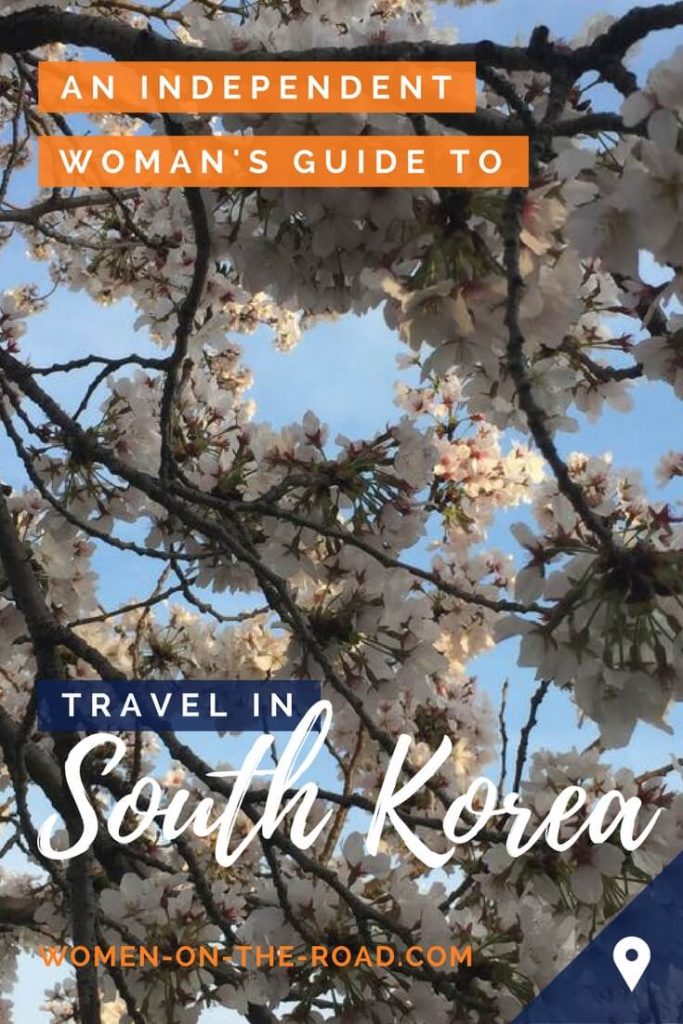
If you liked this post, please share it!

Solo Travel in Seoul, South Korea: The Ultimate Guide
Table of Contents
Ever wondered what it’s like to solo travel in Seoul? South Korea isn’t the typical destination that comes to mind for solo travelers. Before I went there, I read that it’s not the best place to venture out alone.
However, South Korea, with its vibrant capital, Seoul, offered a fascinating blend of tradition and modernity, deeply rooted in its rich cultural history.
This combination intrigued me. So, in September 2023 I set out to see if South Korea truly deserved its reputation as an unconventional choice for solo travel.
In this article, we’ll not only uncover the hidden beauty of solo travel in South Korea but also provide you with the insights you need to navigate Seoul on your own.
Ready to learn what to expect as a solo traveler in South Korea?
Let’s dive in.
Disclosure: Please note that some of the links below may contain affiliate links. At no additional cost to you, I earn a commission if you make a purchase.

Is Seoul safe for a solo female traveler?
Seoul is definitely safe for a solo female traveler. However, there are a few things to keep in mind.
It’s generally considered safe to walk alone in the evening as a woman in Seoul. I think this is great, yet I would still not try my own luck walking alone at night time. Make sure that you know the way if you are wandering alone at night.
And choose to walk on the main roads where more people are walking instead of small alleyways. Have offline maps downloaded from maps.me and have your phone charged.
There are another couple of things to keep in mind when traveling alone in Seoul. One of them is to not drink too much when you go clubbing here. Especially if you’re a girl.
It’s not uncommon to be grabbed by your wrists in certain clubs while going out here. Also be aware of your drink, because of drink spiking. This may not sound very nice, but it’s good to be realistic and know what to be aware of.
Like in every part of the world, be aware of your surroundings.

The best places to stay as a solo traveler in Seoul
So, where should you stay during solo travel in Seoul? If you want to have the chance to meet new people while traveling solo in South Korea, it’s best to stay in a hostel. As a woman, the safest option is to stay in a female-only hostel.
Garosugil Homestay – Female Only
If you’re a solo female traveler and prefer to stay in a women only accommodation, then this is a great choice. Garosugil Homestay is situated in the Gangnam district.
The interior is very beautiful and clean and the owner is kind. Click here to view its prices and availability.
Hostel Haru, Seoul
Another great option is to stay in Hostel Haru . This hostel is mixed, however you can book a private bedroom, so you still have your own privacy. If you prefer to stay in a hostel room (mixed or female only), then that’s also possible.
The location in the centre of Seoul is excellent and you have great evening views from the lounge. Definitely check out this hostel here .
Hotel RU136
If you want to stay in a luxurious hotel with a gigantic bath and a lot of privacy, then choose to stay at Hotel RU136 . Here you’ll find a more extensive review of this place.
It’s very affordable compared to how luxurious it feels. The hotel is situated in a more local area with two subway stations located nearby. View its rates and availability over here .

Tips for solo travel in South Korea
Here are some tips for your solo travels in this interesting country. They help you set the right expectations for your travels here.
Have the right apps on your phone
You should download a couple of essential apps when traveling here . These will come in really handy and will make your solo travels here a lot easier.
The walking routes on Google Maps don’t work that well here, so it’s necessary to download either KakaoMaps or NaverMaps. These apps make getting around in Seoul a lot easier.
Also make sure that your phone is always charged. You don’t want to be lost in a place where you don’t know the way nor the language.

South Korea isn’t a good destination for your first solo trip
If you don’t have any travel experience, I wouldn’t recommend going on your first solo trip to South Korea. I think this would be too challenging, also because of the language barrier and cultural differences.
A better destination would be Thailand or Bali, countries where English is far more widely spoken and where getting around is very easy.

Like always, don’t drink too much
You’re an easy target in a foreign country, especially when drunk. So remember to not drink too much. This is a general safety tip during solo travel .
Also be careful of your drink, drugging is not uncommon in Korea, especially during the night in party places such as vibrant Hongdae .
Don’t expect to meet loads of new people
To set your expectations straight: Don’t expect to meet lots of new people during your travels here. I’m not sure if I’ve ever witnessed a country with so few tourists as South Korea.
A Korean guy I met told me that it’s pretty unfamiliar to see European people traveling in South Korea, especially on their own.
Another Korean local sitting next to me in the plane was also shocked that I was visiting the country on my own. Apparently it’s very uncommon! Still, I think it’s a great destination, also for solo travelers.
However, do keep in mind that there might be instances where you’ll be alone. It’s not like traveling solo in Vietnam or Thailand, where you’ll see lots of tourists and meet lots of new people.

This doesn’t mean you shouldn’t visit Seoul alone, however it’s a good thing to keep in mind!
Seoul is fantastic, but it’s not the easiest place to meet new people. Personally, I’ve even tried Bumble Bff here, yet without success.
Normally I meet new people quite easily, wherever I go. In Seoul things were different and I’ve read many stories about people feeling the same way.
So my advice to you is this: If you’re going to travel solo in Seoul, be prepared to be alone. Stay in a hostel to try to meet new people during your travels here!

Be flexible
You can have it all planned out, but some things will still work out differently than expected. Especially in a big city like Seoul.
Before getting here, I found a coffee shop online near to my hotel. I imagined myself drinking coffee there every morning. It was a really romanticized picture I had in my head.
My first morning in Seoul I walked to this coffeeshop, but to my surprise it wasn’t open at all. But Google had told me so? I looked for other hidden entrances, but without success. The cafe had been closed.
This sums it up for me. You can plan all you want, but in the end not everything will work out the way you think it will. And that’s not a bad thing at all. It opens up new doors and opportunities for you to explore.

In conclusion
Solo traveling in Seoul isn’t the most common thing to do. However, it’s definitely worth doing!
There are so many things to do here. You can try street food at Gwangjang Food Market , shop at the busy Myeongdong Street , go up to the impressive Namsan Seoul Tower and much more.
Do keep in mind that it’s not the best place to meet new people. If you want to visit a country where it’s very easy to meet new travelers, opt for a destination such as Thailand instead.
However, if you don’t mind venturing out on your own and you’re interested in learning about a new culture, then definitely solo travel in Seoul, South Korea. There’s delicious food, incredible historic landmarks and many serene cafes .
Even in Seoul itself, you can easily entertain yourself for weeks and you still won’t have seen everything that this capital city has to offer.
Away with Danae
See more South Korea travel content here:
- The Best Ways To Get Around Seoul, South Korea
- Essential Apps To Download in South Korea
- Bukchon Hanok Village: Is It Really Worth Visiting?
Dongmyo Flea Market: The Best Thrifting Spot in Seoul
- Suseongdong Valley: A Hidden Gem in Seoul
- 7 Reasons Why Seoul Is Truly Worth Visiting
Danae is the founder of Away with Danae. She is 25 years old, has traveled to over 40 countries and has a background in migration law and consular affairs. Danae aims to help you discover the lesser known gems of the world. She specifically focuses on authentic travel experiences in Europe and Asia.
Similar Posts

5 Essential Apps To Download in South Korea As a Foreigner

Is Bukchon Hanok Village in Seoul Really Worth Visiting?

7 Reasons Why Seoul is Truly Worth Visiting

Gwangjang Market in Seoul: A Foodie’s Paradise

Hotel RU136, Seoul: What It’s Really Like Staying Here
Leave a reply cancel reply.
Your email address will not be published. Required fields are marked *
Save my name, email, and website in this browser for the next time I comment.
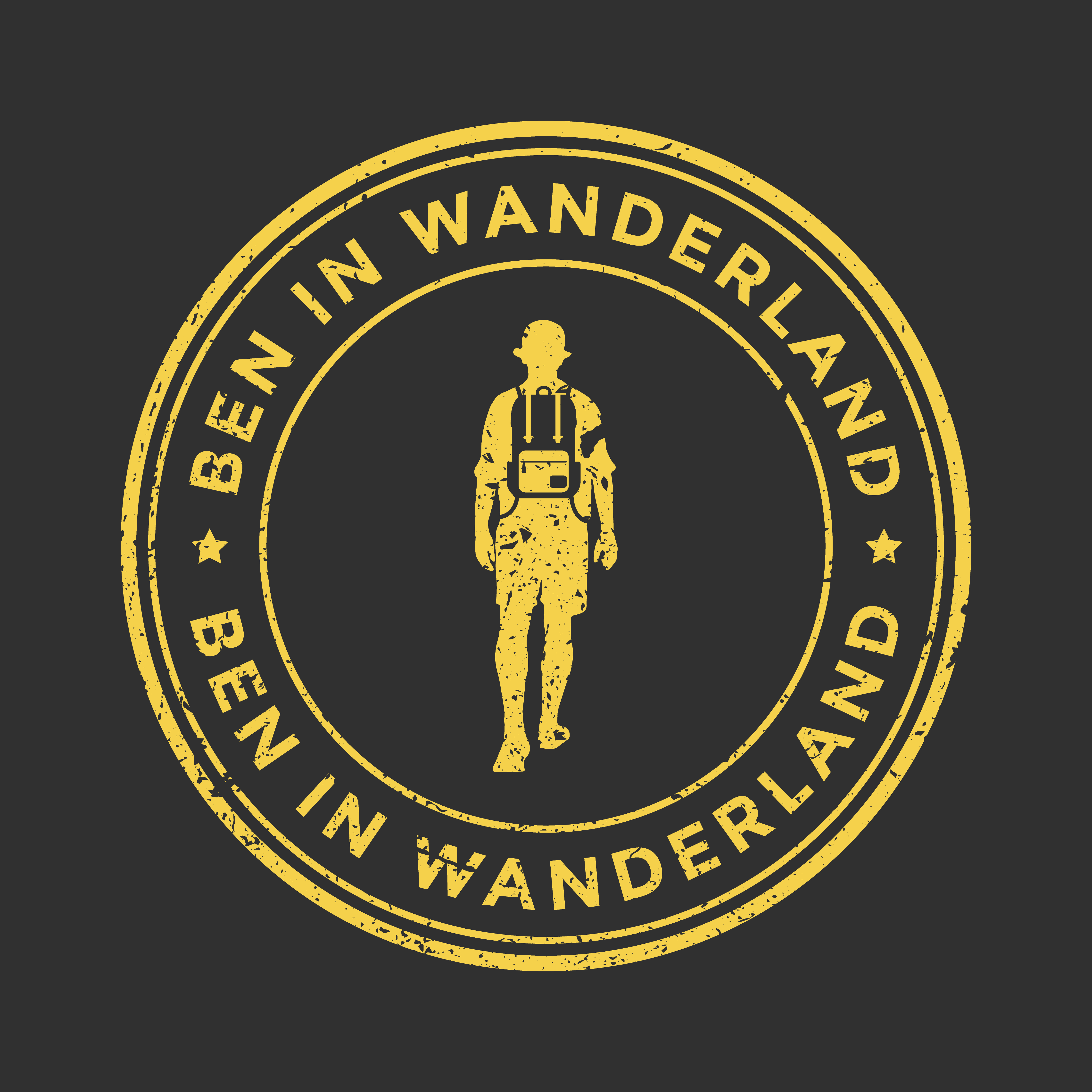
- Destinations
- Photography
Two Weeks in South Korea: A Solo-Traveller Itinerary
minute read
With a population exceeding 50 million, it may be hard to conceive a small peninsula-country – one that juts into the East China and Yellow Seas - boasting some of East Asia's most breathtaking scenery. Yet it does.
More interestingly, despite a penchant for catapulting the Republic's populous headfirst into the 21st century - seen in a tidal wave of quirky-cum-cutting edge fashion, savvy technological advances and the iconic K-pop, Koreans consistently uphold traditional values, maintaining and promoting them unwaveringly, nationwide. From centuries-old Buddhist temples to charming coastal fishing villages, fertile emerald rolling hills, a mega metropolis and sub-tropical islands, the Republic of South Korea has a little of everything.
I was hard pressed to see it all in two and a half weeks, as the further I lifted the lid on the K-trove, the more treasure I uncovered. Here's hoping this itinerary for visiting South Korea will help you gain some clarity and direction.
Solo Travel Note on South Korea:
Unlike the ongoing controversy regarding its northern neighbour, there is a sense of calm and tranquility in South Korea that’s comforting. You can often feel harassed in overcrowded metropolises and countries, particularly when you stand out as aesthetically diverse. This was not the case for me here. Walking, eating and going about my solo-travel-business in South Korea were uneventful.
The only major challenge I faced was going to a restaurant alone, one that featured Korean Barbecue. No-one at the hostel was able to go and I didn't want to forego the opportunity to have the experience (one customarily shared with others). I received a few odd looks and felt a slight twinge of discomfort as I entered. However, staff were courteous and made me feel at ease once I was settled in and had ordered.
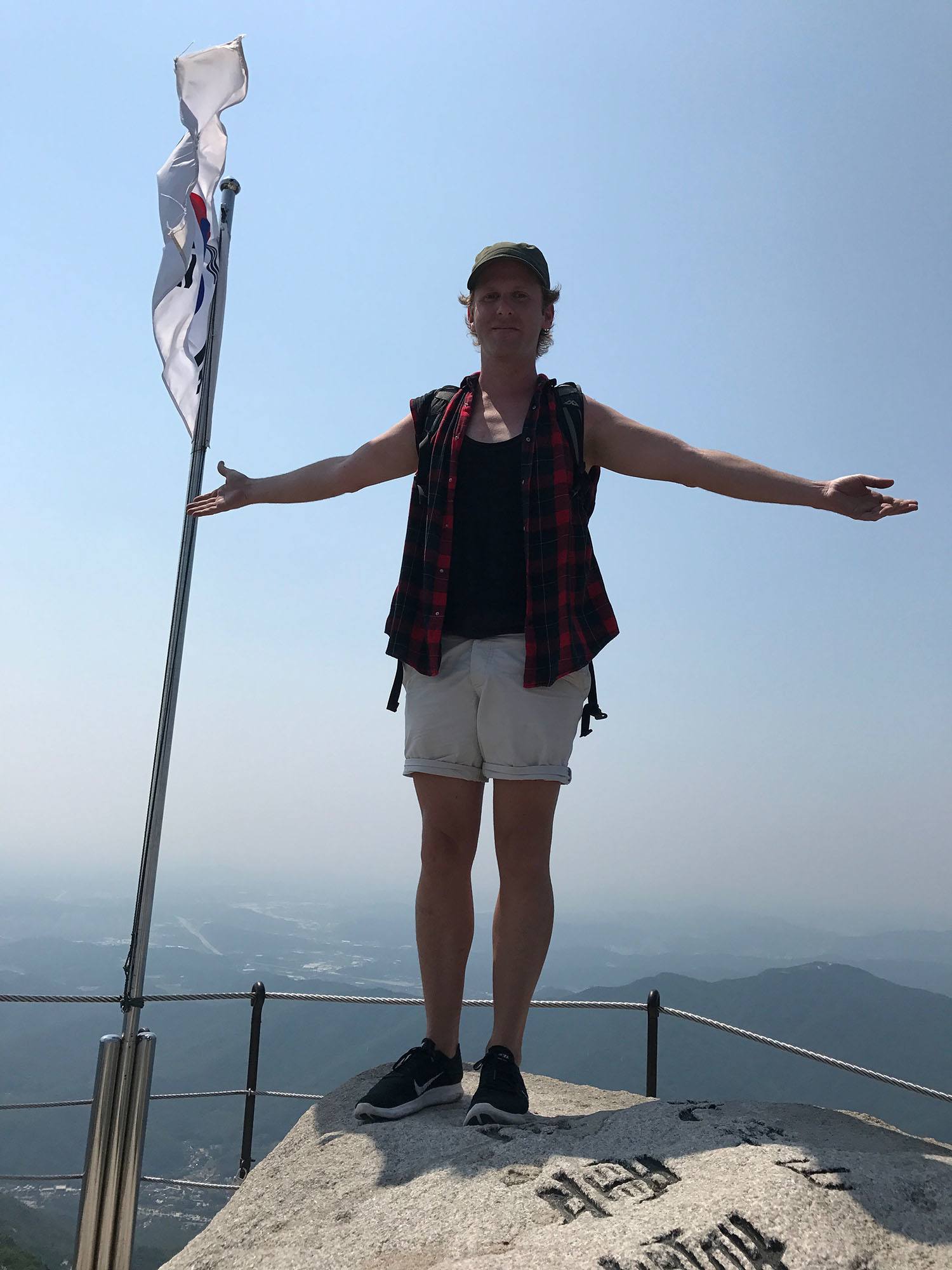
I feel it's a great destination for solo travellers. Read through and see why.
Whether a foodie, a history buff, a technophile or simply a curious traveller, Seoul is South Korea's mega-metropolis capable of catering to every variant of human inclination. It's not hard to see why it's reported to be experiencing an identity crisis: the city is drenched in diversity and is a melting pot of east-meets-west and old-meets-new.
However, unlike the chaos of other similarly mixed Asian cities, Seoul soulfully blends the mix with subtle sophistication. The choices are endless: indulge on gastronomic cuisine at a seemingly unending stream of cafes and restaurants; explore ecclesiastical foundations by visiting architecturally-resplendent temples; or engage less tenable senses by visiting a spa or a meerkat cafe.
There is, essentially, no limit to Seoul's multifaceted soul.
To avoid decision fatigue, here are a few noteworthy sights to fill up your 'must-see' three to four day Seoul itinerary.

Gyeongbokgung Palace
Built many centuries ago, the palace – one of many in Seoul - attests to the architectural prowess of the country’s predecessors. It’s an heirloom of yesteryear, a relic to admire and a beatific sight not to be missed.
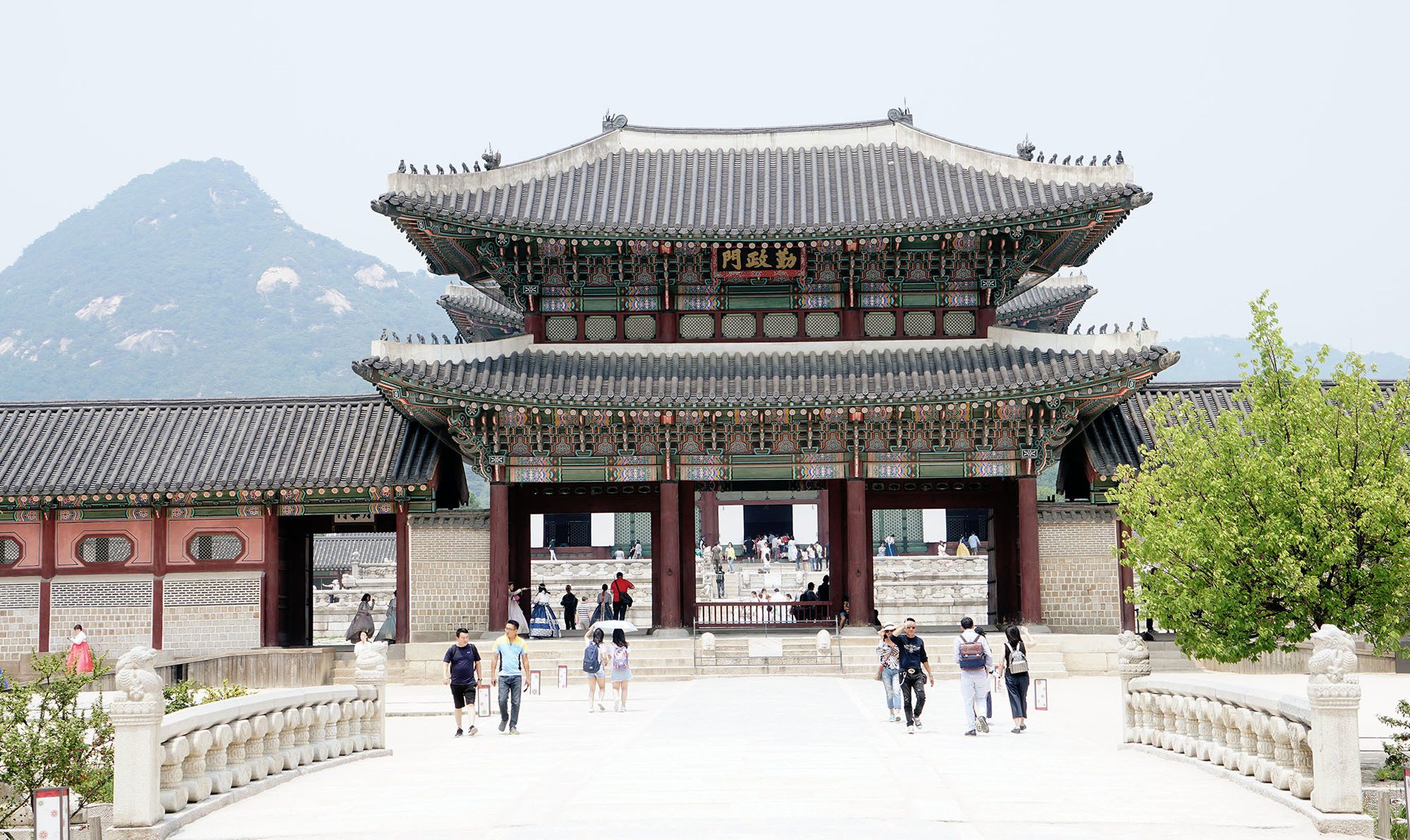
Although it’s the only one of the five palaces I visited in Seoul, I heard whispers that it is the most impressive. I spent hours traipsing the perfectly manicured grounds, surrounded by Korean antiquity – bedecked in oriental trimmings - at its finest.
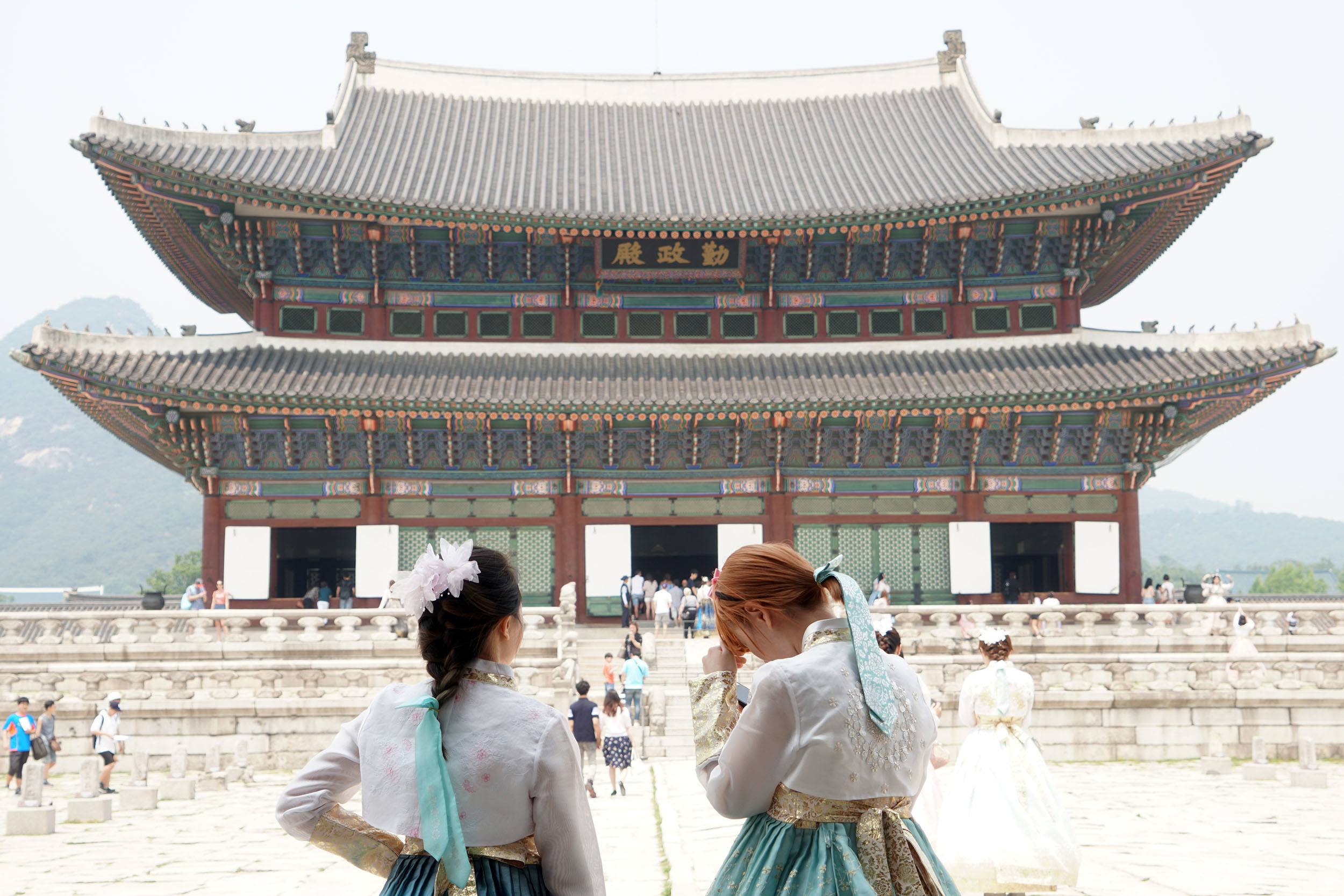
Don’t forget to hire and don traditional attire upon arrival - sashaying through the grounds will be more entertaining dressed akin to native visitors.

Set aside half a day to see the palace in its entirety. Some guide books recommend two hours butin order to embrace the essence of the Korean institution, taking your time is paramount.
Take water and wear a hat as the heat can be intense. The palace is closed on Tuesdays.
Bukchon Hanok Village
For an opportunity to step back in time without leaving the confines of the city’s periphery, head to Bukchon , a short walk from Gyeongbokgung Palace. It’s here that you can discover a traditional village comprising Hanok, homes designed in an architectural style synonymous with Korea of yesteryear.

Purpose built to be in harmony with the surrounding environment and the ever-changing seasons, they utilise ondol and daecheong, one for keeping warm in winter and the other for staying cool in summer. A stroll through the village felt like stepping back in time several centuries.
Aside from the Hanok, the view of Seoul from the top of the mildly precipitous hill is stunning.
Namdaemun Market
Anyone who enjoys shopping should not miss letting loose in Namdaemun Market. Shopaholics beware: there are over 30 multi-storey buildings comprising thousands of stores ranging from clothing to fabrics, jewellery, toys, food and more.
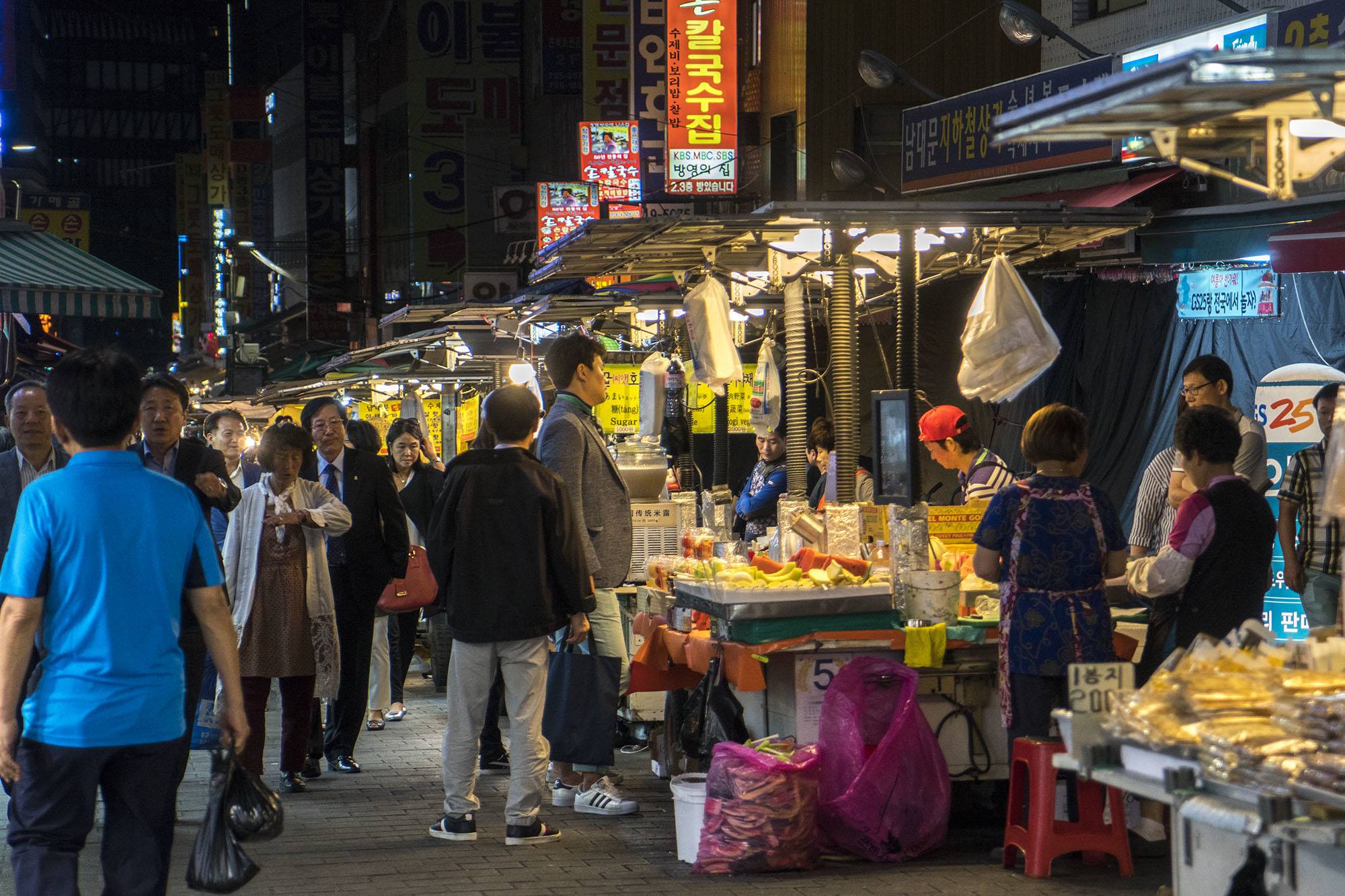
In fact, there are so many goods upon which to feast your eyes, escaping unscathed without burning a hole in your wallet or purse is the only danger. Even those without a penchant for the illustrious pastime will enjoy wandering aimlessly through the market, as it’s a visual spectacular of Korean life under a public magnifying lens.
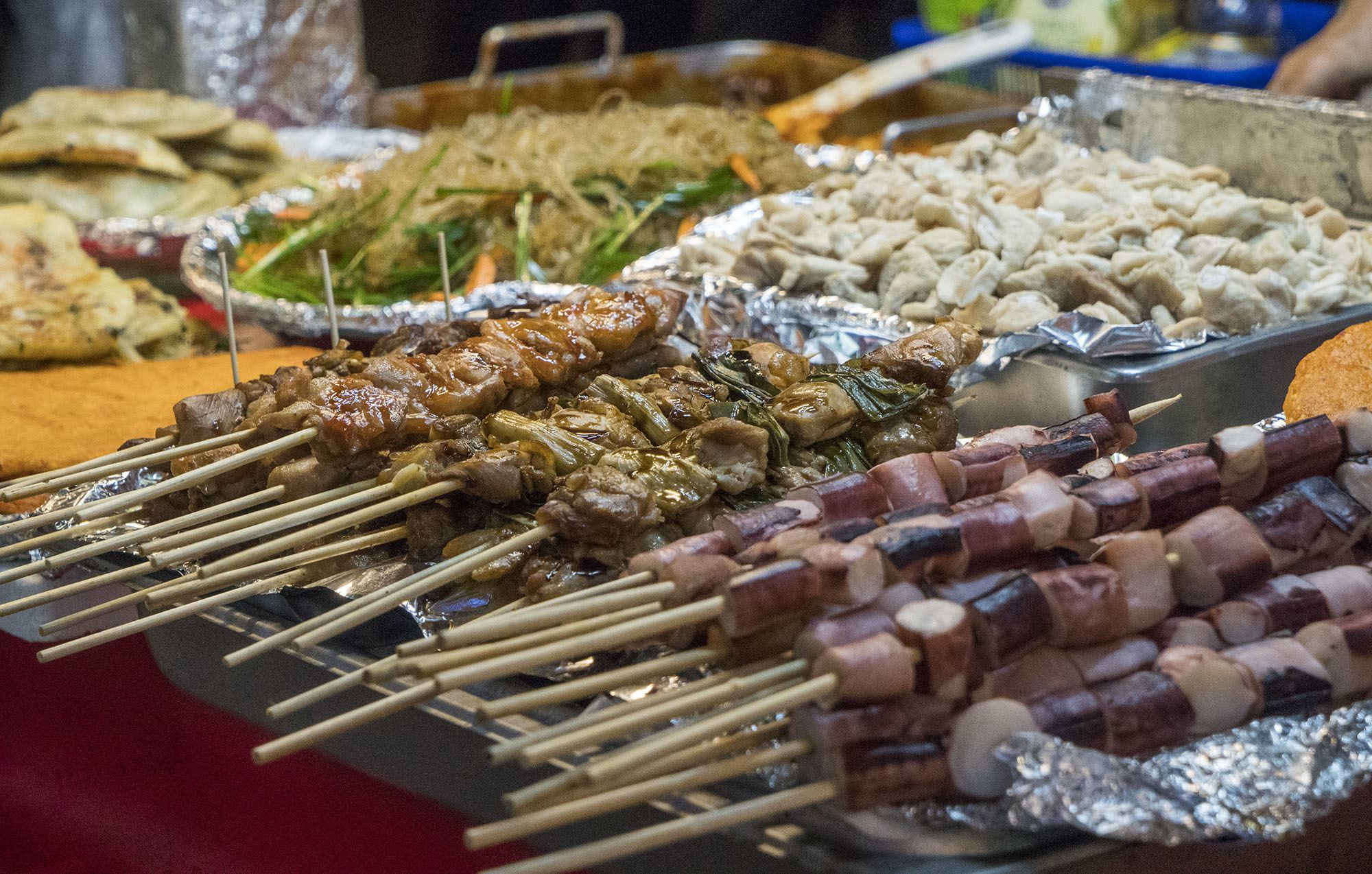
Namdaemun Camera Shops
For photography aficionados, there is no missing the side-by-side Sony, Canon and Nikon shops at Namdaemun. Most goods are second-hand, but generally in very good condition. It’s a nirvana for anyone interested in purchasing competitively priced, quality goods in the pursuit of refining their craft.
I purchased a second-hand Canon SLR along with two lenses, all of which are still helping me capture moments of life around the world .
If new to the photography biz, ensure your knowledge is adequate before entering the vulture’s nest. If concerned (as English language skills among staff can be scarce), recruit a bilingual Korean to take along for the ride and negotiation.
Although the staff are seemingly friendly, if they detect a novice, the price will automatically increase disproportionately. It’s a haggling game, to the end.
Although Seoul is comprised of multiple districts, many of which are worth visiting, Hondgae – according to personal opinion – is the energised core of the city’s soul, its lifeblood being beat rhythmically by the eclectic, upbeat and unruffled youth inhabiting its streets.
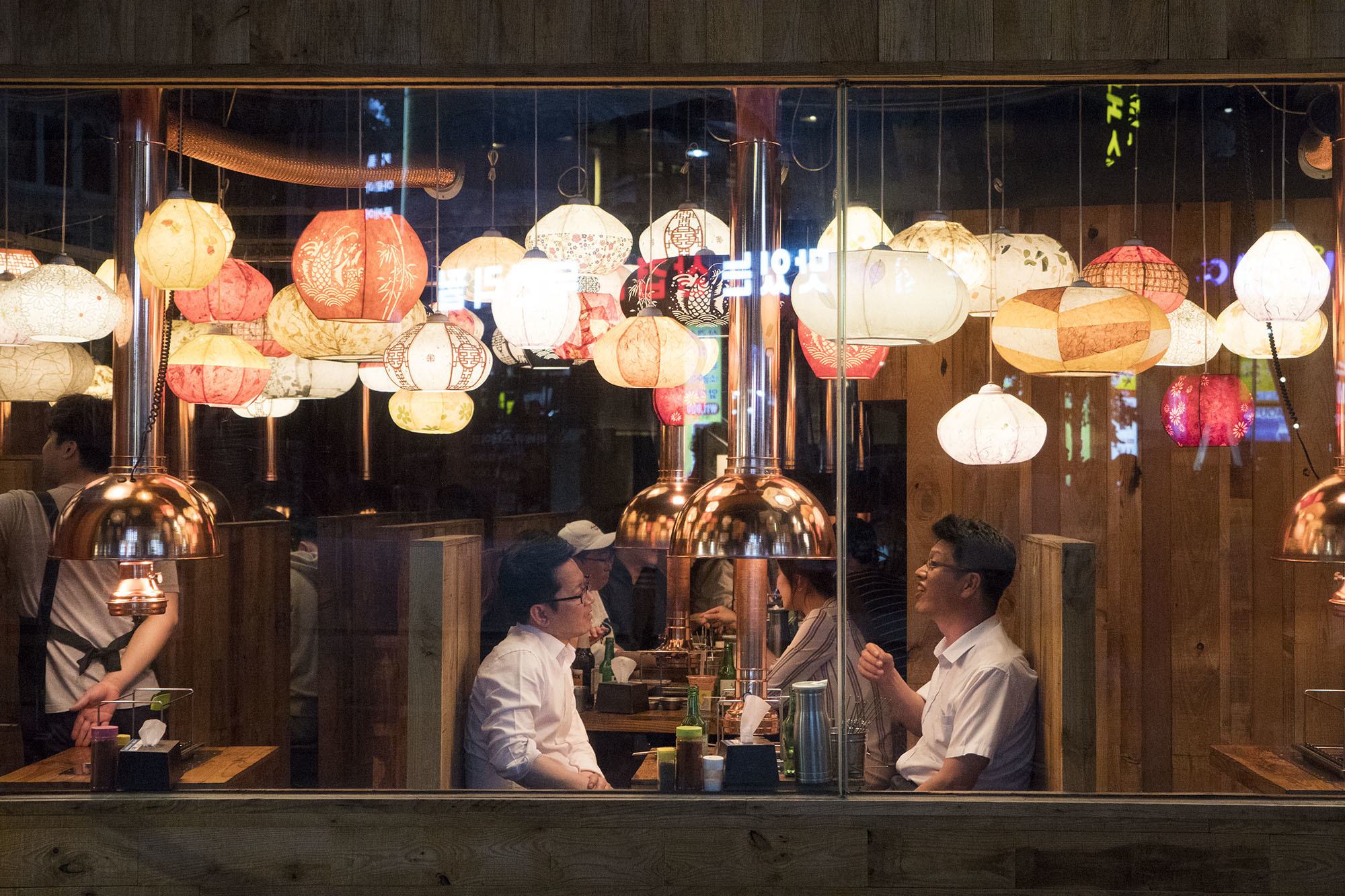
Take a stroll along Hongik University Street (grabbing a delicious bite to nourish yourself en route) and admire the crucible of Korean life unfold on the street: students, from all walks of life, sit together on the grassy strip laughing, gorging fragrant food, embracing their loved ones and enjoying the vitality of youth.

On the other side of the main road, there are copious shopping streets to be found, replete with everything your heart may (or may not) desire. It’s also where one can find Meerkat Friends Café .

Bukhansan Mountain Summit Hike
Visible from most standpoints throughout Seoul, the three-horned mountain lives peacefully on the city’s northern periphery. A hike to its highest peak - Baegundae - is a must.

Aside from the exhilaration you will derive from arriving at the top, ceaseless amusement will be provided by the droves of Koreans taking a leisurely stroll to the top – it’s quasi-free entertainment. After all, hiking is to Koreans as beer is to Germans. It’s a favourite pastime, particularly popular at the weekend.
The hike isn’t as gruelling as you may think, so don’t be put off: I made it without having trained, two months after contracting pneumonia.
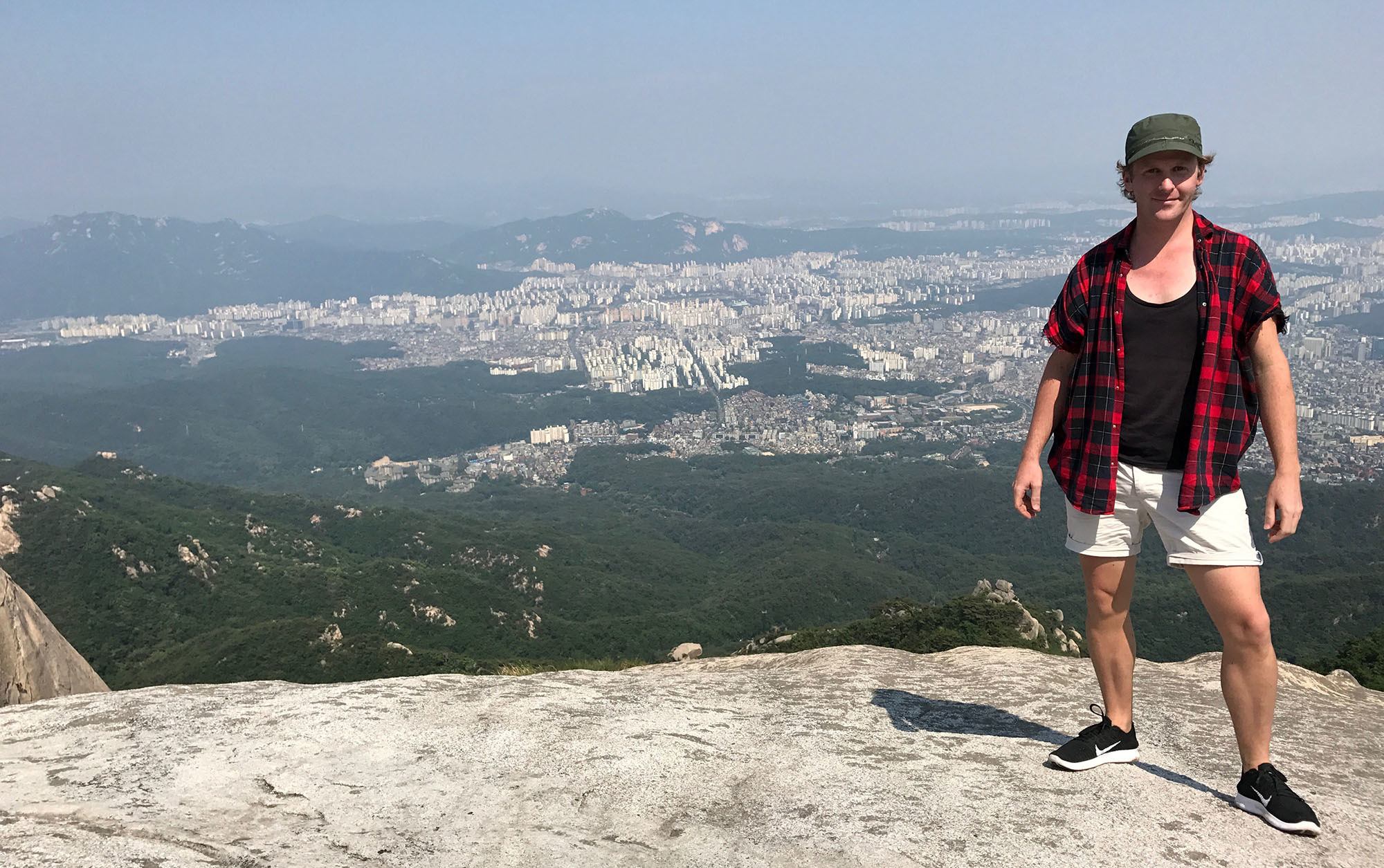
Take it slowly, stop intermittently to eat the carbohydrate-laden snacks you have brought with, and enjoy the journey.
It took approximately five hours to complete the circuit, with additional time required to get to and from city-centre accommodation.

Arriving at the starting point is simple. Take Seoul’s metropolitan line three to Gupabal station. Leave the station via exit one. Take bus 704 towards the fortress, and get off at the park entrance.
Don’t be concerned about where to get off: you will see a bus full of people bedecked in full hiking paraphernalia pile off, so just follow suit.
Dragon Hill Spa
Getting completely naked surrounded by others is never personally enticing, but it is a trademark of Korean culture, and a necessary K-experience while visiting Seoul.
Recently made internationally renowned by William Shatner and his entourage in ‘Better Late Than Never’, the jjimjilbang – or Korean bathhouse – requires little local promotion: visited daily by hundreds – if not thousands – of Seoul residents, finding a possie in the bubbling 35-degree Celsius spa at certain times of day may prove challenging.

The seven-storey complex – that’s also gender segregated in the ‘nudie’ areas – is an institution, a place in which to escape the city’s chaos and drift into a world of serenity. From hot and cold baths, saunas and salons in the respective ‘no clothes’ areas to salt rooms, quiet areas, a cinema and a restaurant in the unisex zone, there’s no possibility of getting bored.
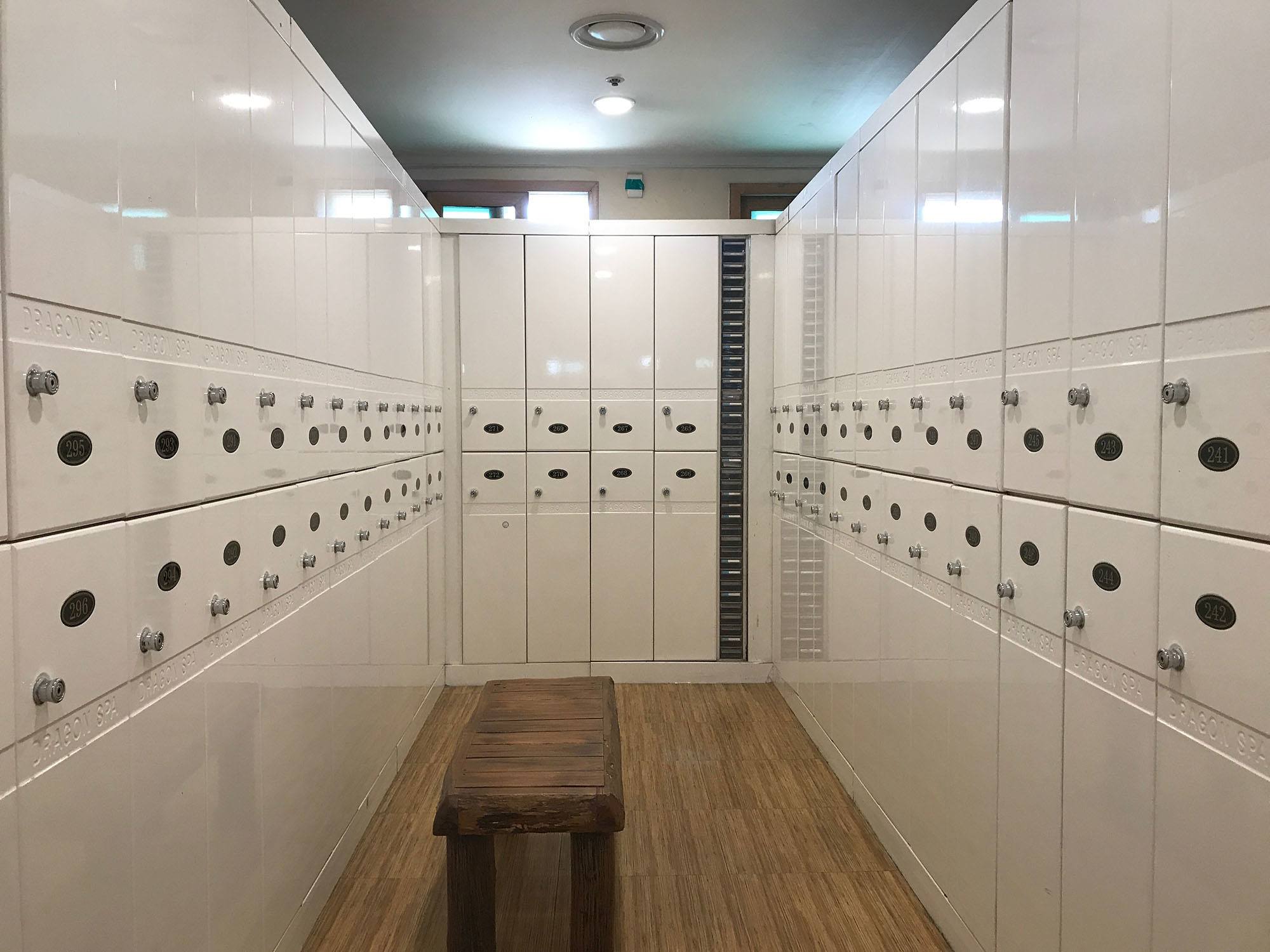
In fact, some people I met found it so addictive, they spent the night – sleeping on the floor in true Korean style, of course.
Gwangjang Market
Based in Jongno-gu, the traditional undercover market is home to 5000 shops; a shopper’s paradise, yes?
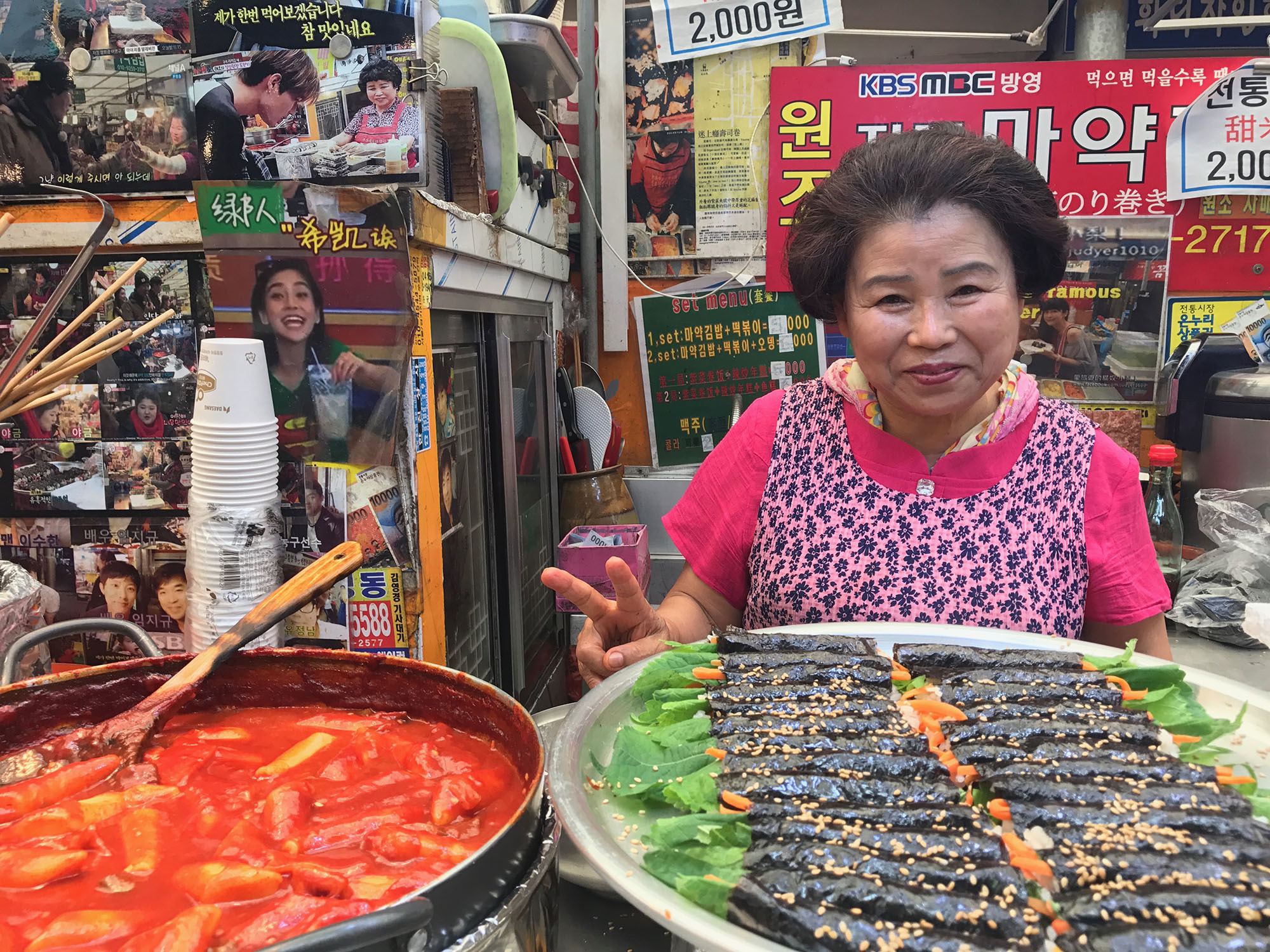
As one of the largest markets in Korea, it plays host to nearly 70,000 visitors each day. Don’t fret: as it covers an enormous surface area, the crowds are manageable, and escaping – although difficult – can be done by dropping into one of the many diverse shops selling a host of items from food (particularly fresh seafood) to textiles, traditional medicine, souvenirs and clothing.
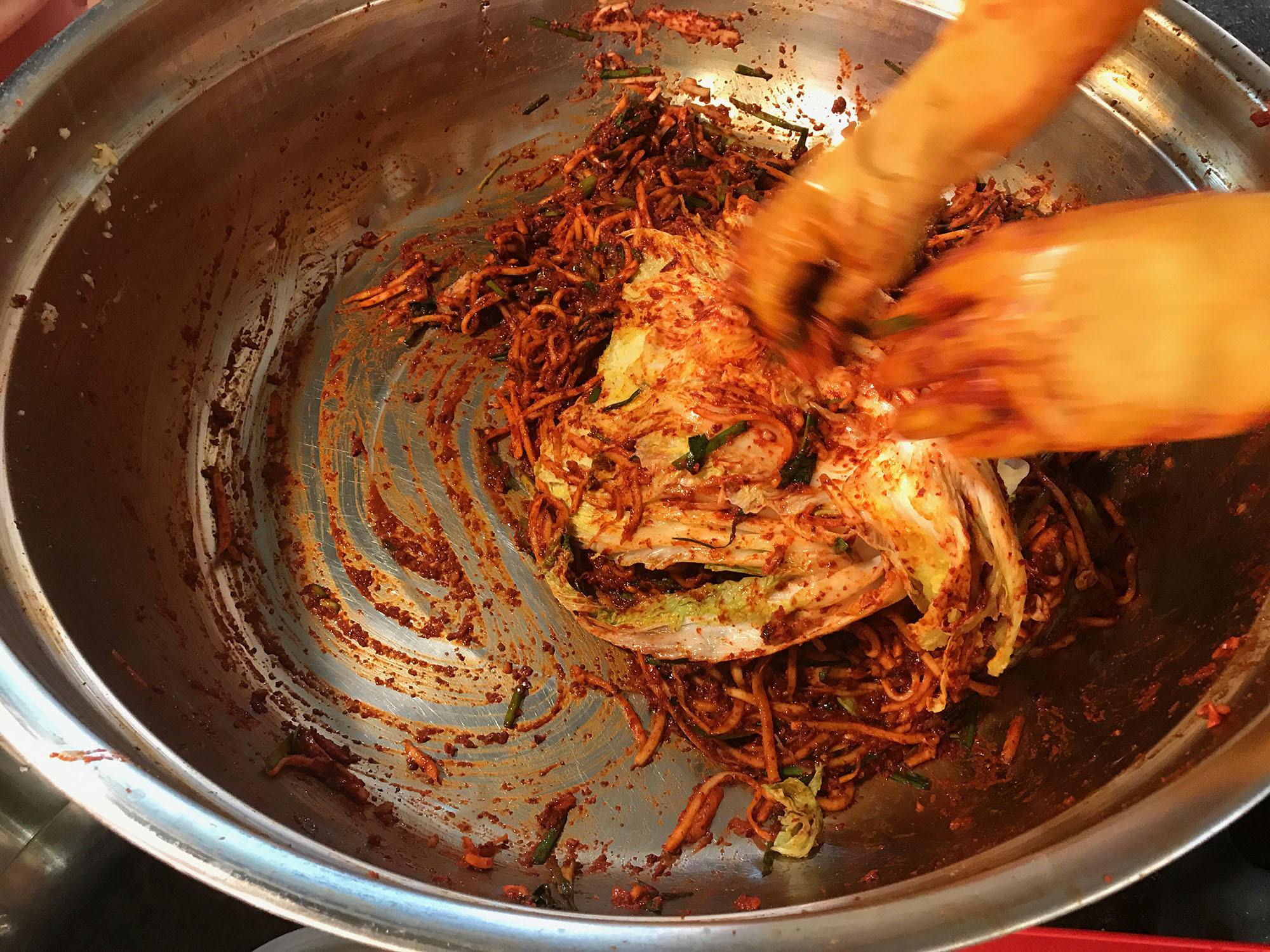
It was here that I tried chicken feet, a common addition to dinner plates across the nation.

Cheonggyecheon Stream
If it’s more serenity you are after, especially following the clamour of Gwangjang Market, then a walk along this 5.8-kilometre stream is akin to visiting Dragon Hill Spa.

Despite its position beside one of Seoul’s busiest roads, it’s surprisingly quiet thanks to a trench-like location a few metres below street-level. A meander along the ‘banks’ of the stream cleanses the soul, frees the mind and – after passing under several bridges – prepares you adequately for a visit to the intergalactic-like Dongdaemun Design Plaza.
Dongdaemun Design Plaza
An eyesore to some, being imbued by a sense of neo-futurism is guaranteed as you approach –from any angle - the Hadid-Samoo masterpiece. Built to serve as a launch pad for Korea’s creative industry, it embodies design at its greatest.

From futuristic retail stores to eclectic exhibition spaces and a park on the roof, there is no single space – externally or internally – that leaves visitors without mouths agape in awe.
I spent hours going from one artistic space to the next, getting lost in a plexus of creative hideouts.
Leeum Samsung Museum of Art
Not as futuristic as Dongdaemun Design Plaza on the outside, the Leeum Samsung Museum of Art comprises two galleries, one of which slings art admirers well ahead of the 21st century. However, step across the foyer to the other half of the modern construction, and it becomes possible to rewind clocks to a distant time in Korean history.
There is no shortfall in eclecticism.
Don’t be surprised – for true aficionados – if you get trapped in an art-warp and lose yourself entirely for a day (or more).
Meetkat Café
There’s no surprise – given the country’s propensity for gearing entertainment to an eccentric population – that, along with other animal cafes, there exists one almost wholly devoted to the African meerkat.
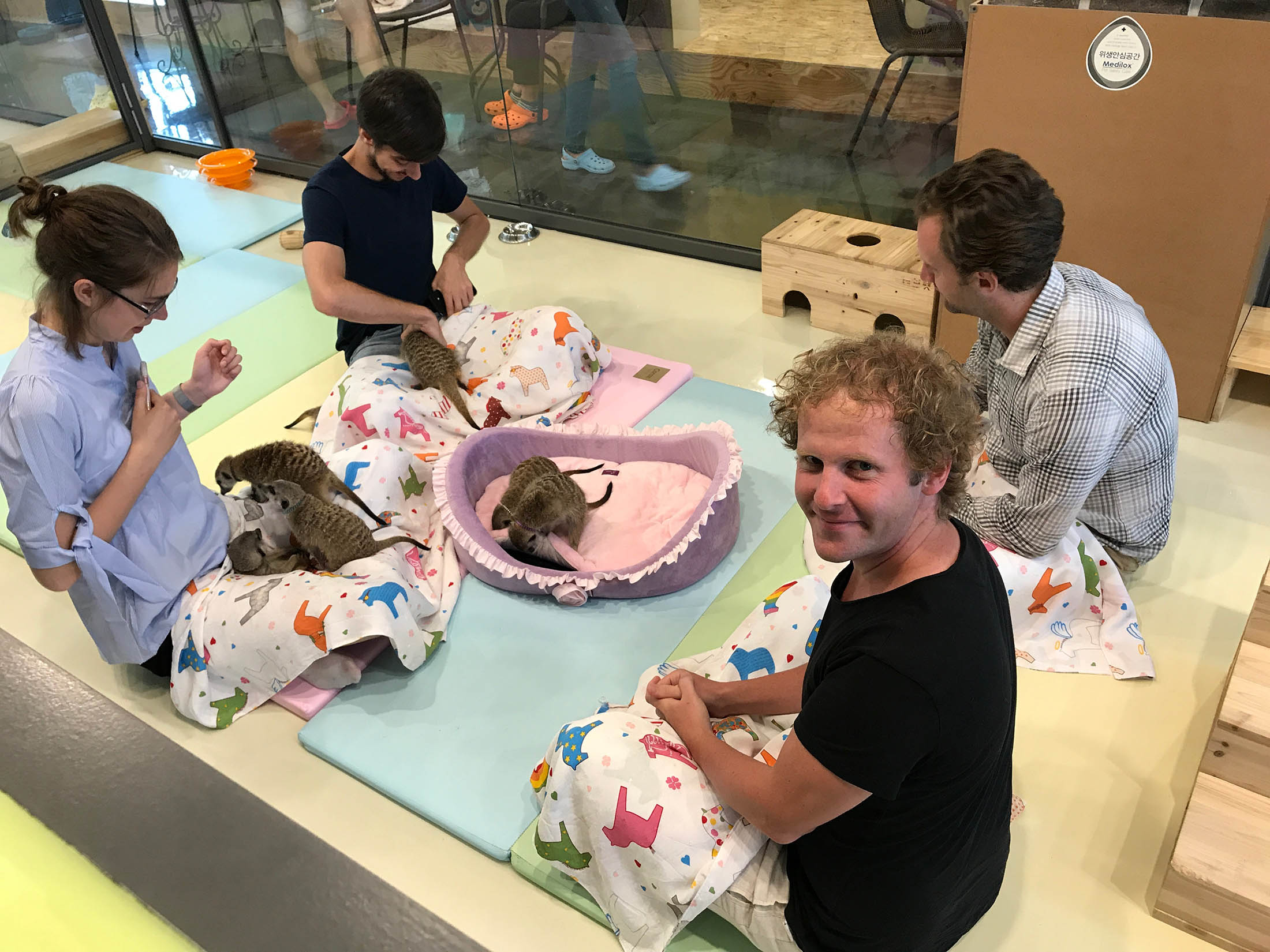
Despite the obvious controversial – and ethical – considerations, stopping by the Hongdae establishment is actually worthwhile. Aside from the opportunity to get up close and personal – for 10 restricted minutes – with the pint-sized animals, all proceeds from the entrance ticket go towards keeping the foraging insectivores happy and healthy, a task assumed by the fanatical staff who run the cafe.
See this article for full details regarding a visit to the famous café.
Namsan Seoul Tower
Located on Namsan Mountain, the observation tower is the second highest point in Seoul.
Half the fun in visiting the tower is the cable car ride up the side of Mount Namsan. Granted, you can walk, but obtaining breathtaking broad-sweeping views of Seoul while being hauled up the mountain in an almost-flying metal box - squashed inside like a sardine - is far superior.
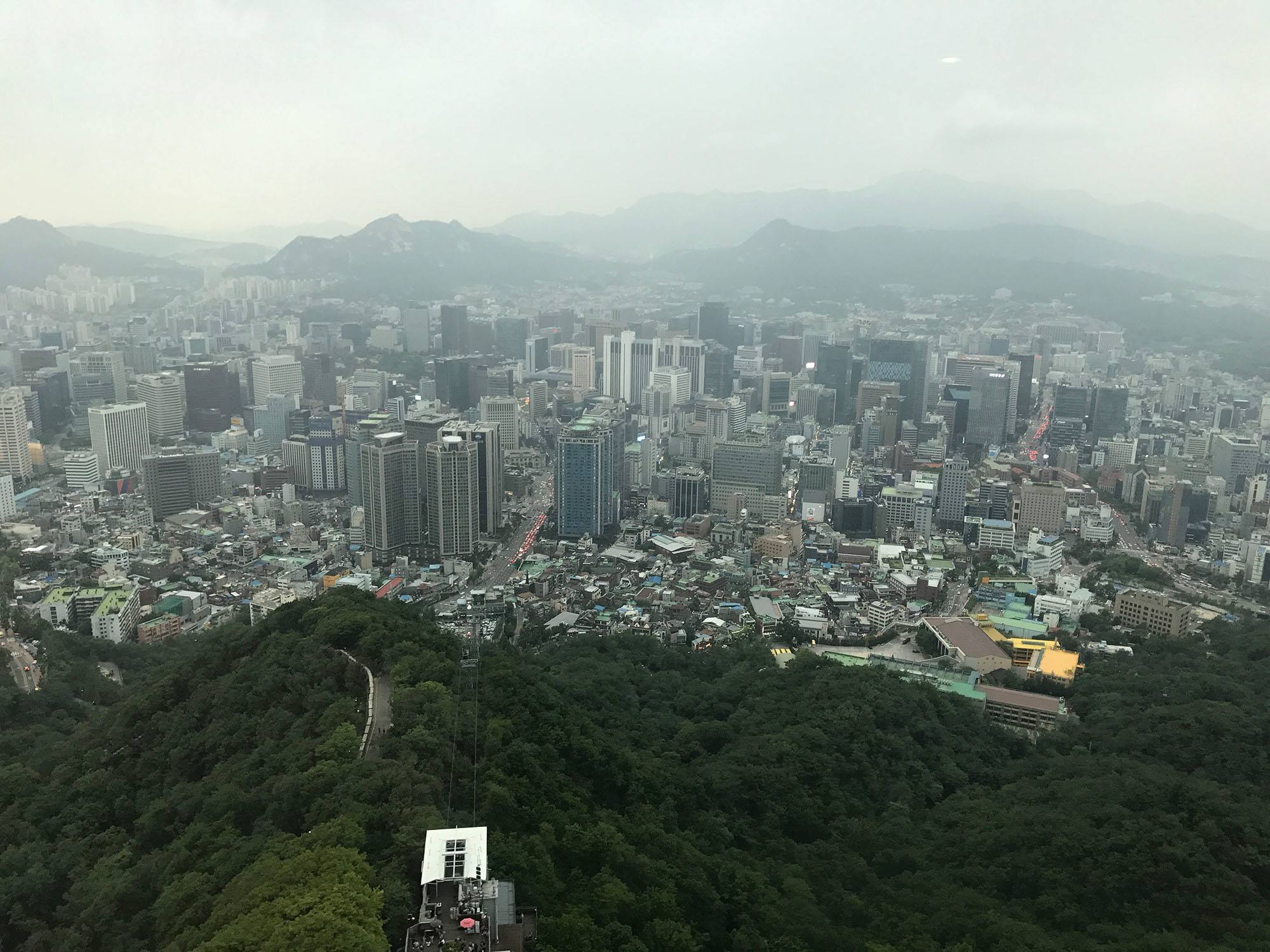
The fun does not stop there. Once at the top, aside from the exquisite views – best seen at dusk – from the observatory on level three, there are numerous other ways to be entertained: dining on delicious fare at one of the many restaurants; throwing coins into the wishing well on level two; spending up in the shops scattered throughout (including the sweet store on the observatory level); and hanging a named padlock on the Tower fence to symbolise your undying love for your precious other are but a few.
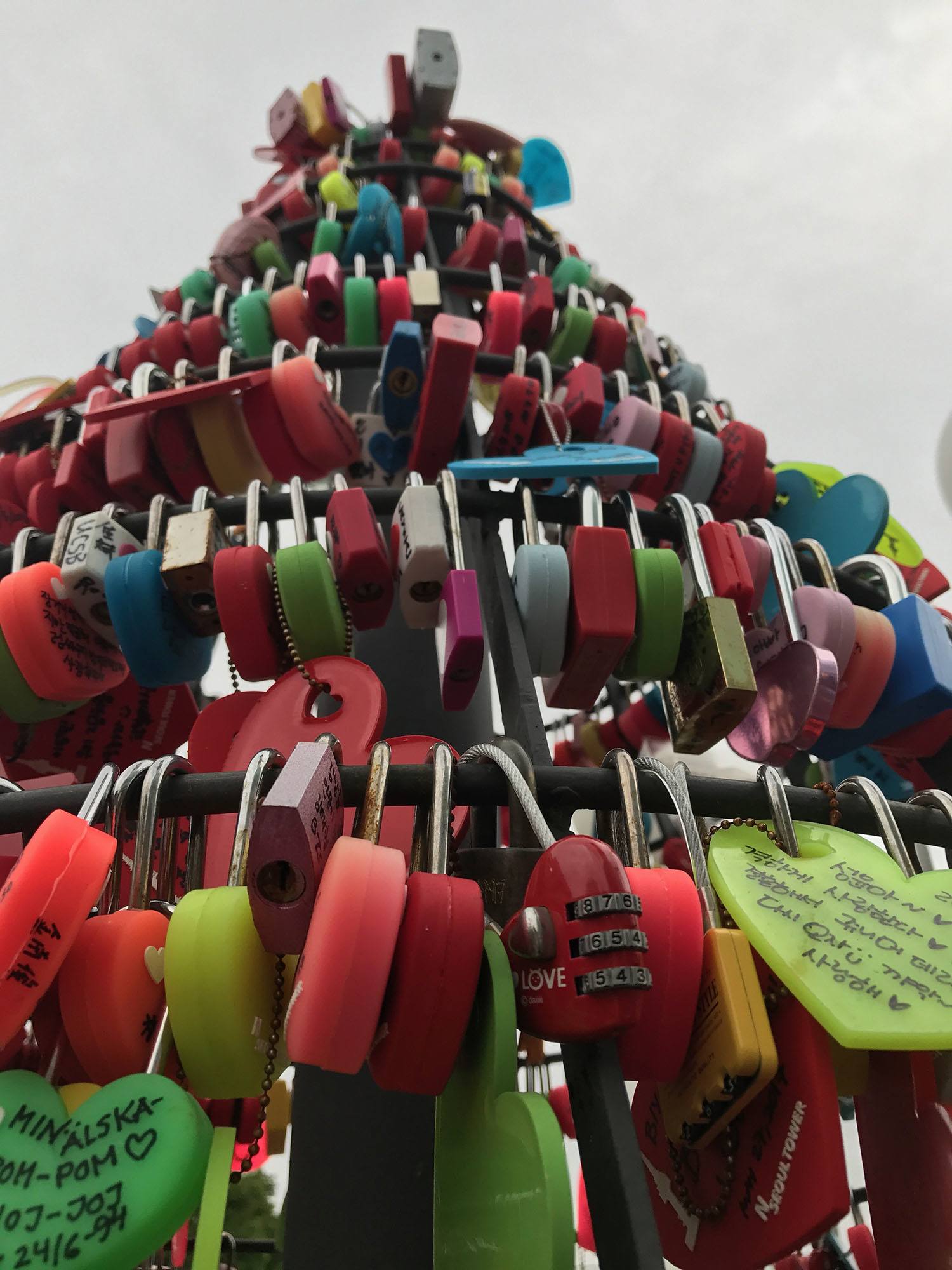
The demilitarized zone (DMZ) and the Joint Security Area (JSA)
For an opportunity to get up close and personal with the Republic of Korea’s infamous northern counterpart, book a tour (which is obligatory) to the Demilitarized Zone and the Joint Security Area. Several operators run half and full day tours, most of which can be booked through your accommodation or directly with a city-based travel agency. Hurry, as things are deteriorating in North Korea and, based on the current media output, a visit may soon be impossible.
I was personally unable to go, thanks to a bout of food poisoning the night before. However, travellers I met in Seoul who’d visited both zones all highly recommended the excursion.
Staying in Seoul - RECOMMENDED LENGTH OF STAY
Four to five days.
Spend the first day acclimatising and finding your K-legs, followed by three to four solid days of exploration. There are countless options in terms of sights, activities and experiences, so much so you'll be hard pressed to achieve it all in this timeframe.
Staying in Seoul - ACCOMMODATION
As a well-visited mega metropolis, there’s an unending list of accommodation options spread throughout the city. Choosing the place that best suits your needs, subsequently, can sometimes result in decision fatigue. To gain a little clarity and get a few budget-to-midrange recommendations, see the comprehensive article by bobo and chichi .
I chose to stay at Seoul I Guesthouse in Hongdae and was pleased with the location, quality and price.
Consult the following websites for up to date information regarding prices and availability of accommodation:
- Hostel World
- Hostel Bookers
- Last Minute
Eating in Seoul - RESTAURANTS
Just like accommodation, there are so many food options throughout the city it's hard to know where to start. In fact, it's more common in Seoul to eat out than to cook at home, so it makes sense there are streets and avenues lined with restaurants.
If I was at or near the hostel, then I ate close-by, in and around Hongdae. If I was out and about exploring the city, I found a local spot and experimented with new options.
From my personal experience (aside from one episode of food poisoning), you'll be hard pressed to find poor quality food, so I recommend tapping into your sense of adventure, following your nose and choosing a spot that speaks to you. Otherwise, take a look at the recommendations in the following article:
- Where to eat Korean food in great restaurants
Here's a visual sample of some of the food I tried while in Seoul, to get you going.

Getting Around Seoul - TRANSPORTATION
Although there are multiple ways of navigating the city, I've included the most popular here.
It's incredibly extensive and just as busy as it is large. Personally, it was the easiest and most efficient means of exploring the city.
- There are 18 lines, all colour coded (however some colours are very similar and distinguishing between the different lines can present obvious challenges)
- It covers most of the city, so getting to almost any desired destination is possible by using it
- Transferring between lines requires lengthy walks which can consume a fair chunk of time
- Some exits do not have escalators so be prepared to sling your luggage - whatever it may be - over your shoulder and hike it up many stairs
- Phone coverage is great, even underground
- Names are written in Korean and English
- The names of the previous and next station are indicated on the platform in the direction of travel
- Fares are paid using the T-Money card , and are based on the distance travelled
- It is not operational 24 hours a day, so consider this when planning your day's activities
There is a very well-organised and efficient bus system throughout the city. They are divided in colour categories: yellow, green, blue and red-and-green.
- Yellow: they service the tourist-heavy areas
- Green: these buses service local areas, such as city neighbourhoods
- Blue: they traverse the city
- Red-and-green: these ones travel to other cities, aka intercity buses.
- A fare will cost an adult traveller with a T-Money card ₩1,200 (alternatively ₩1,300 with cash).
Bicycle and On Foot
As one of the most densely populated cities in the world, with a labyrinth of windy roads that don't seem to follow a particular system of organisation, getting around on foot or with a bicycle can be challenging. Mountains and skyscrapers interrupt pathways, and locals won't always know how to direct you to your destination.
My best advice is to familiarise yourself with the city's major landmarks and subway stations. Use Google Maps if it works. Otherwise, follow the river. Most smaller waterways will eventually flow back into the Han, which courses its way through the city. Identify the major landmarks close to the river, and you can't go wrong.
Getting to Seoul - TRANSPORTATION
As the starting point for most travellers to South Korea, flights will be the most likely mode of arrival. There are a host of airlines that service South Korea, so please see the links at the end of this article under ‘Getting to South Korea - TRANSPORTATION’ for recommended flight search engines that yield the best fares.
In terms of getting to and from Seoul in relation to other parts of the country, please see each respective city below for details.
SOKCHO (속초)
In contrast to the hustle and bustle of Seoul, a 2.5-hour bus journey to South Korea’s east coast transports nature enthusiasts to Sokcho, a coastal city that’s also a stepping stone to Korean paradise: Seoraksan National Park.
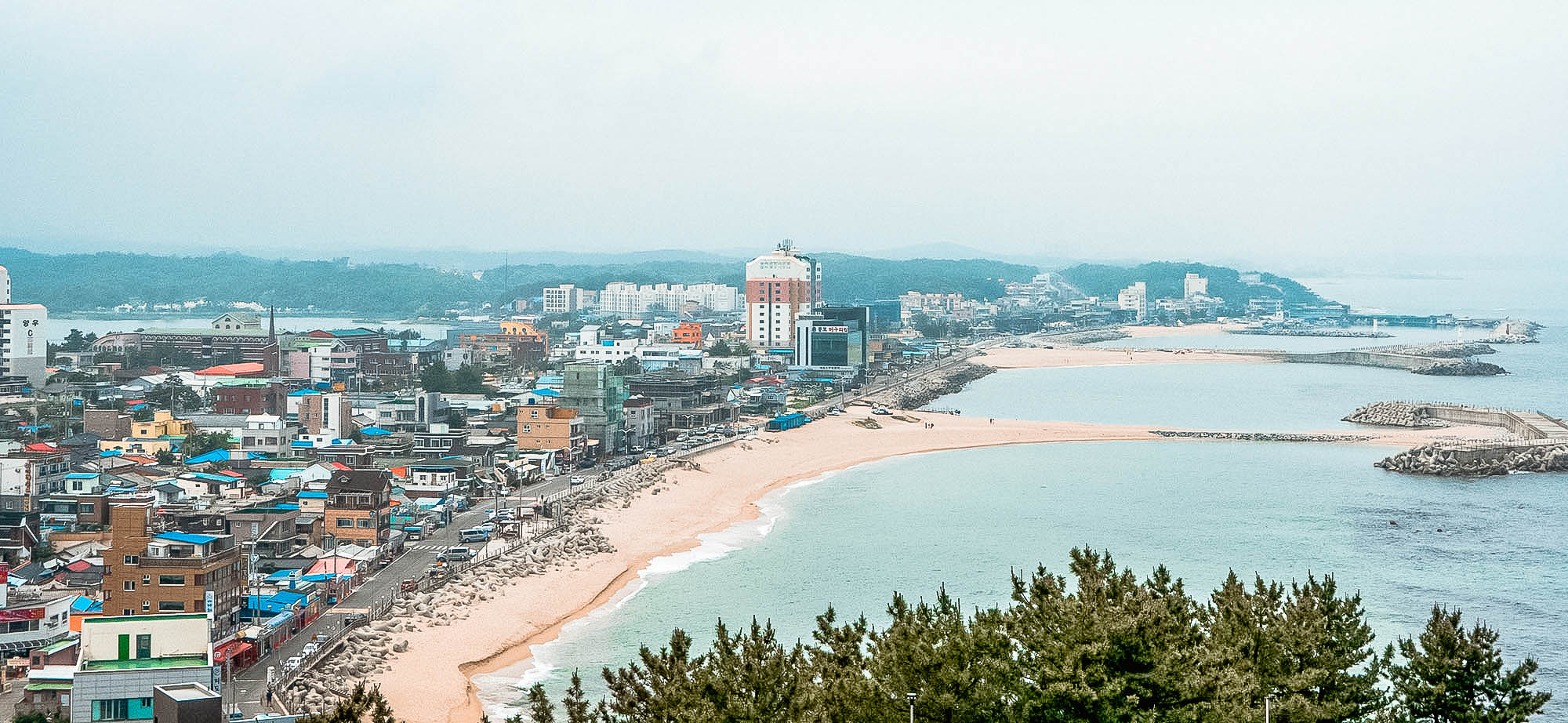
A feature on the peninsula, it is filled with all essential national park requisites: peculiarly shaped mountains; native fauna; and ancient temples dating to the Shilla era.
There’s no wonder it was recently dubbed a Biosphere Protection site by UNESCO - it’s a Korean nirvana, of sorts.
Seoraksan National Park
For most east coast-bound travellers, Sokcho is simply a stepping stone to Seoraksan National Park. The biosphere reserve boasts some of the country’s most jaw-dropping sights, and abounds in nature appreciation experiences.
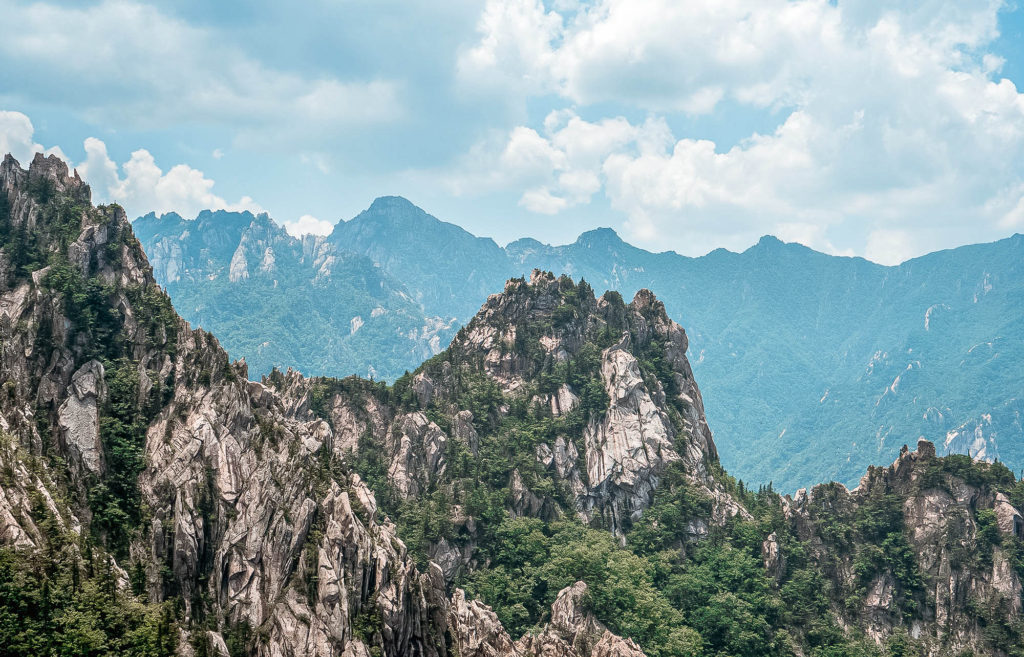
Mountaineers at heart can rise early and leg it to the top of Korea’s third highest peak, Daecheongbong, on top of Mount Seoroksan. Less energetic visitors are not left without choice: from waterfalls to swinging cable cars and ancient temples, activities – and photographic opportunities - abound.
See this article for further details regarding things to do and see in Sokcho as well as transport options.
Staying in Sokcho - RECOMMENDED LENGTH OF STAY
Two to three days
Part of the first day will be spent finding your feet in Sokcho, following arrival from your previous location.
See the local sights then, on day two, head to Seoroksan National Park for immersion in nature.
On the third day, either return to the park to experience the walks you missed on day two, see some other Sokcho attractions or visit the demilitarized zone and the Goseong Unification Observatory if you can arrange transport.
Staying in Sokcho - ACCOMMODATION
With a population of only 84,000, Sokcho is classified as a 'sleepy city'. There are accommodation options, but they are fewer than the likes of Seoul.
I stayed at The House Hostel and was very impressed by the quality, friendliness of staff, tasteful design and idyllic location. I would highly recommend staying here if you're visiting Sokcho.
There are, of course, other budget (midrange and top end) options from which to choose. Budget and solo traveller-friendly options include With U Hotel & Guesthouse and Haru Hotel & Guesthouse.
Alternatively, consult the following websites for up to date information regarding prices and availability of other accommodation options:
Eating in Sokcho - RESTAURANTS
The food journey - and adventurism - continues in Sokcho. Fish and seafood are the buzzwords, thanks largely to the city's location: right on the sea. From fresh fish markets to seaside stalls and restaurants, there are plentiful options and flavours to titillate all variants of tastebud.
I was recommended a host of places at which to eat by the exuberant owner-cum-manager of The House Hostel. He kindly identified their respective locations on a paper map and recommended the 'dish of the house' for each place.
Here are a few places to try:
- Central Market aka Sokcho Tourist and Fishery Market (open 9am - 9pm)
- Large Market by the Northern Harbour (ask at your accommodation for directions)
- 88 Saengseon Gui
- Abai Village
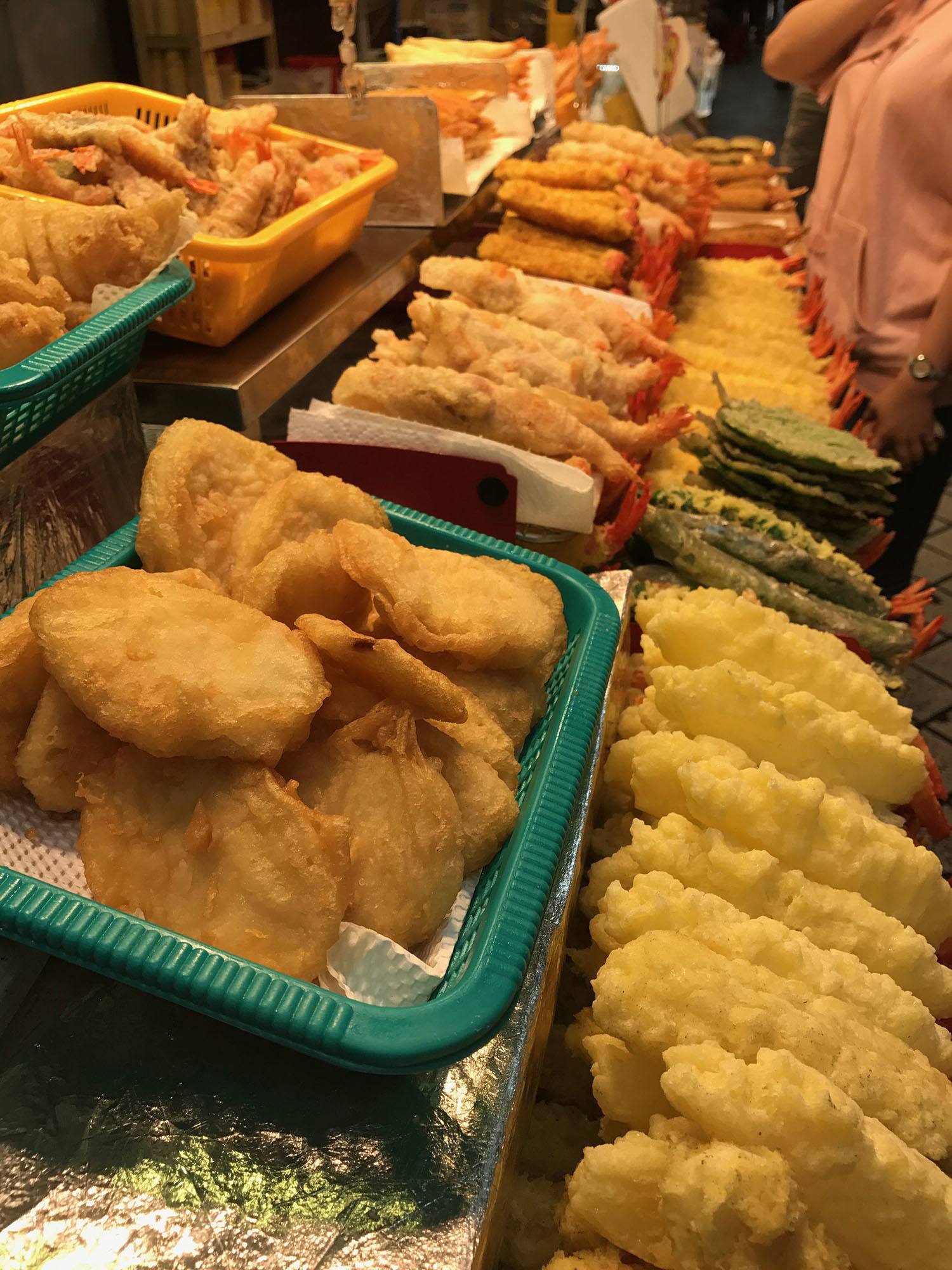
One must-try Sokcho speciality is:
- Dakgangjeong (닭강정)
Getting Around Sokcho - TRANSPORTATION
Like most Korean metropolises, Sokcho is spread out. If you plan to explore every finite corner of the city, then you'll need to navigate the bus network. Otherwise, if your plans primarily include only a Seoroksan National Park visit, then walking between your accommodation and a restaurant at the end of the day is all you'll need.
Ask at your accommodation for information about navigating the city using the local bus network.
Getting to Sokcho - TRANSPORTATION
Getting to Sokcho from Seoul is quick and easy:
- Take the metro to Gangbyeon Station (the green line, or line two) in Seoul
- Leave the station via exit four
- Dong Seoul bus station is directly across the road from the exit
- Buy a ticket (for any Sokcho-bound bus) and enjoy the ride
The bus was modern, comfortable and honestly, a little luxurious. It was money well-spent.
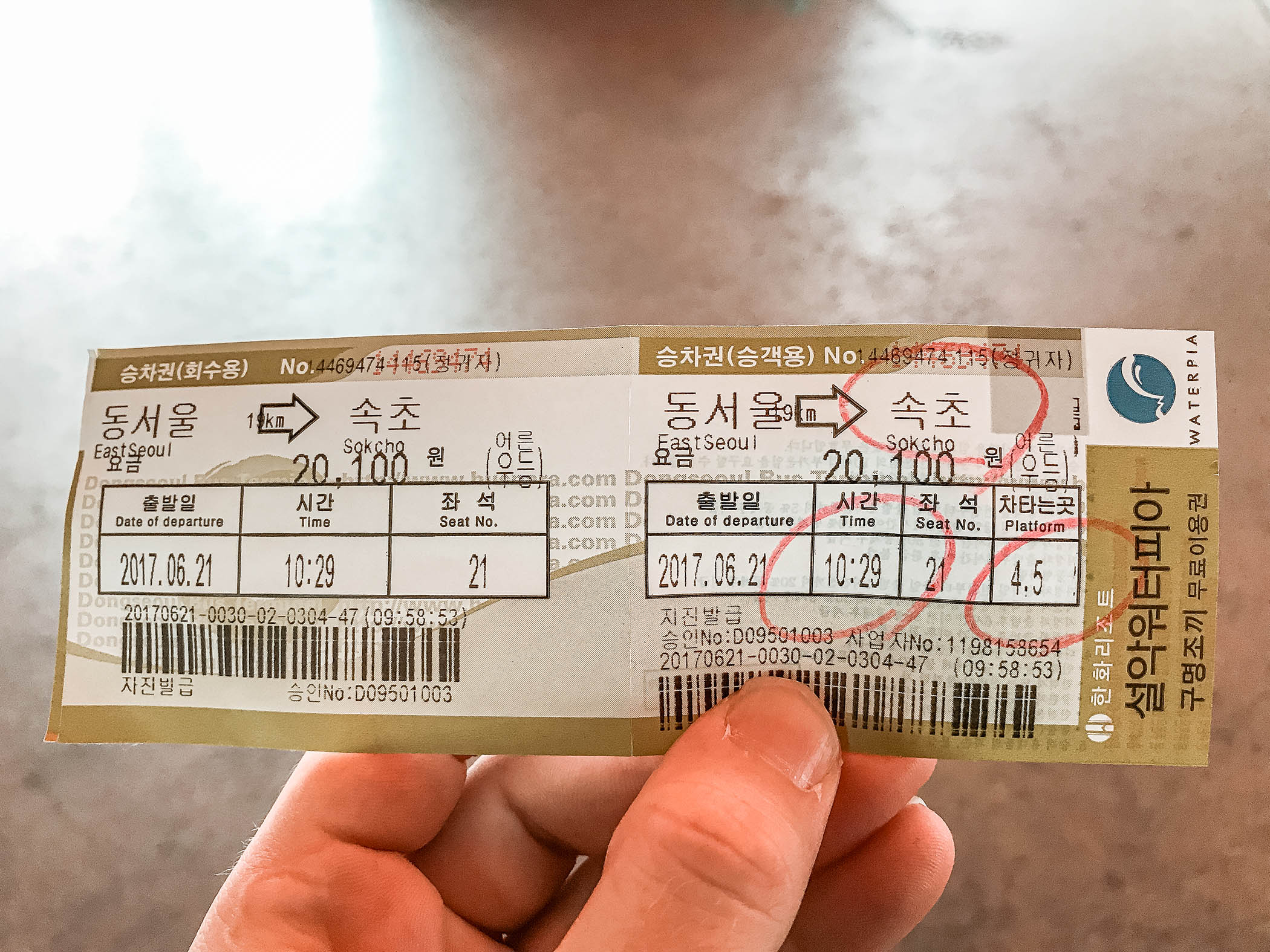
There are also regular bus services from Andong to Sokcho.
There is a train that travels to from Cheongnyangni Station in Seoul to Gangneung, an hour from Sokcho by bus.
ANDONG (안동,安東) AND HAHOE (하회마을)
A hop, skip and a small Korean jump south of Sokcho lies the city of Andong. Akin to its northern counterpart Sokcho, Andong’s prizeworthy features reside outside of the city’s expansive periphery. The key drawcard to the region is, in fact, Hahoe Folk Village: it’s a historic masterpiece curated so brilliantly stepping inside makes you believe Korea stopped in time – several thousand years ago.
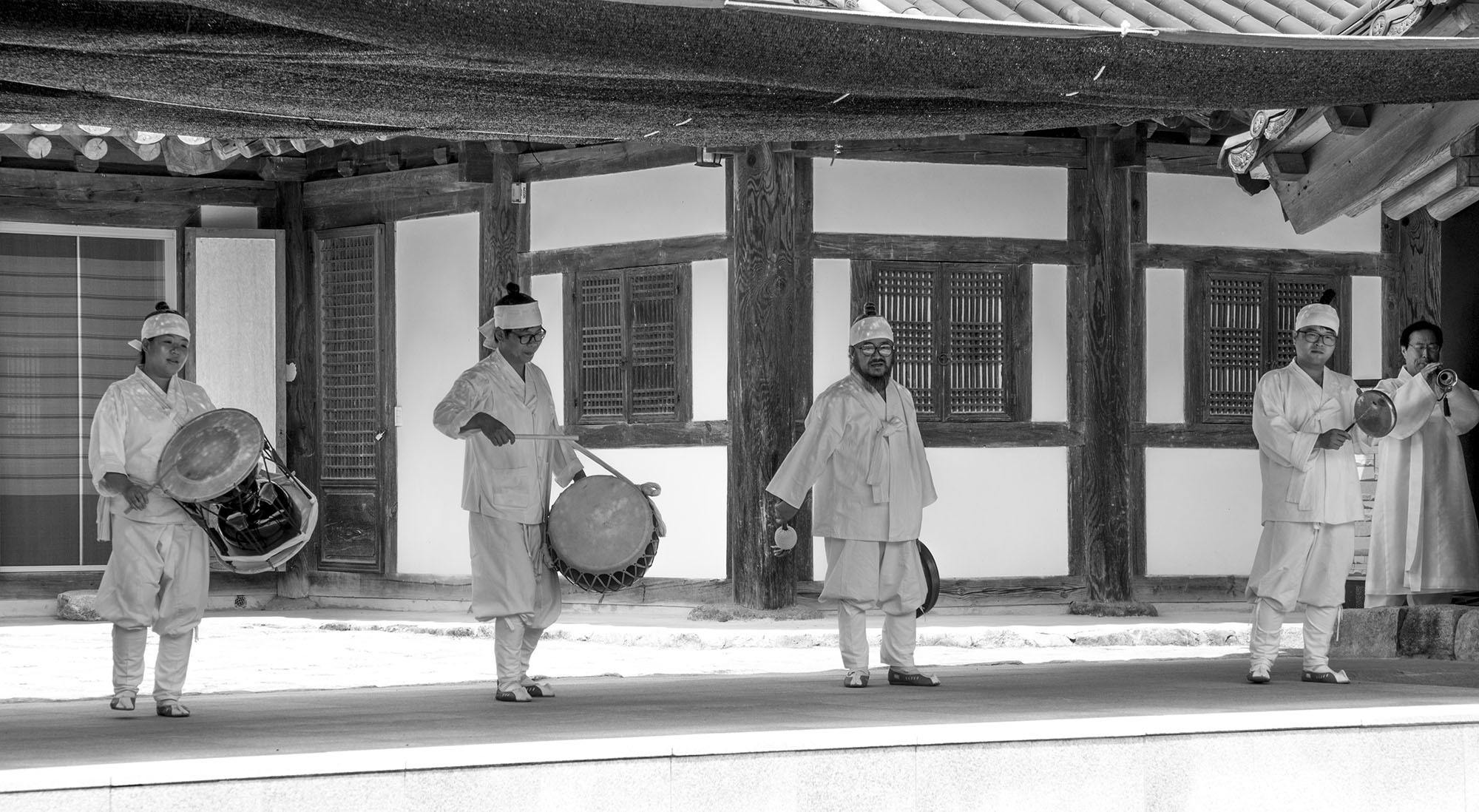
Hahoe Folk Village
The authenticity prize should be awarded to this centuries-old well-preserved village, alive and buzzing with 230 current Korean residents. Assisted by the Government, the town’s inhabitants have been able to preserve tradition, culturally, naturally and in the finer details of the built environment.

Now classified – justifiably - by UNESCO as a world heritage site, a journey down the dirt path, through fields replete with vegetable vines and around perfectly designed homes will transport you elsewhere.
Stay overnight in a traditional home , and the magic – particularly when silence ensues following dusk – continues.
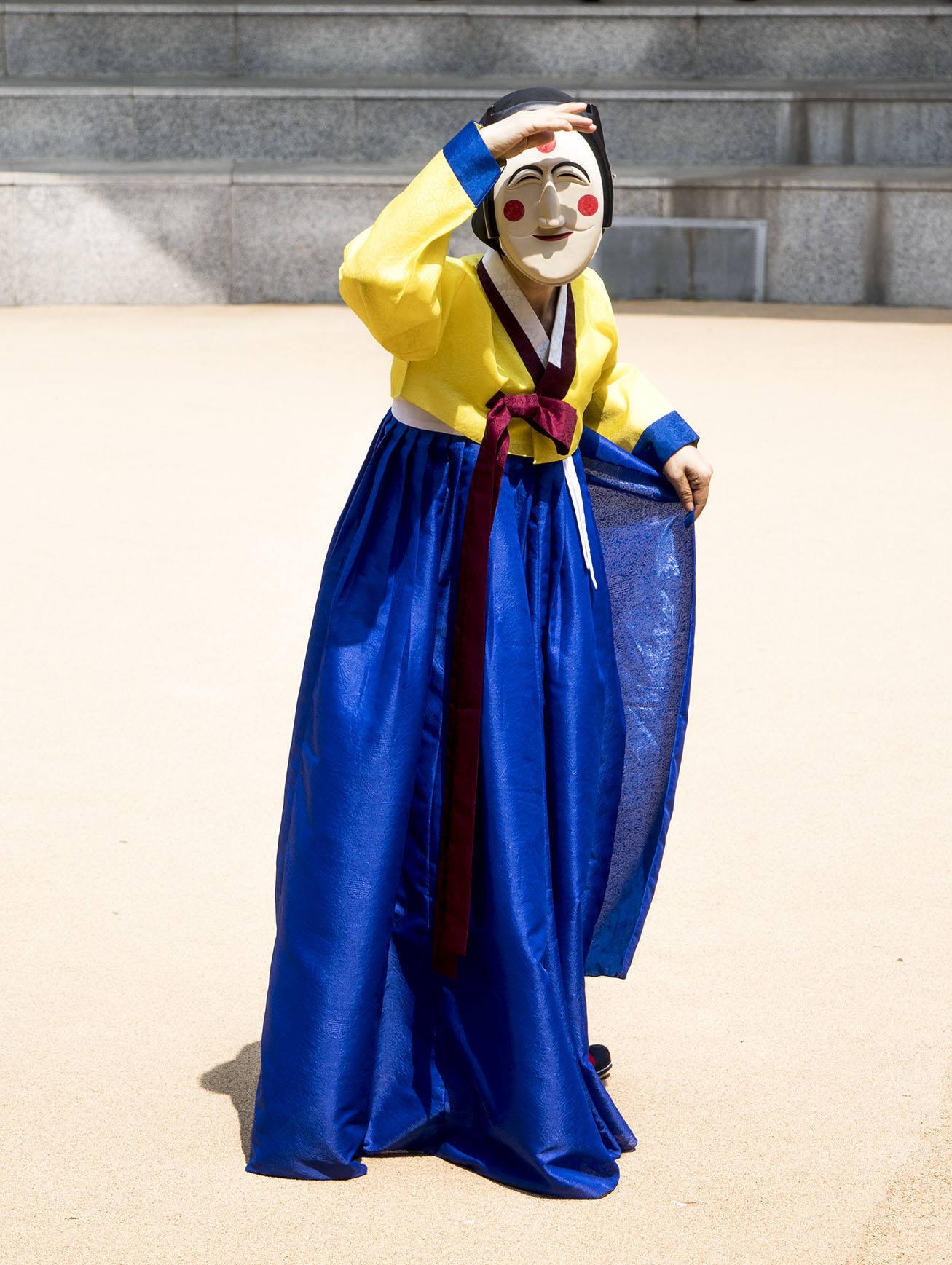
Simply put, visiting Hahoe Folk Village is akin to flipping Korea’s history book back several chapters to the 14th century. It’s hypnotic and, frankly, unmissable.
For further recommendations of activities to undertake in Hahoe, see this article .
Staying in Andong and Hahoe - RECOMMENDED LENGTH OF STAY
Two to three days
Spend the first day finding your feet, exploring Andong and navigating your way by public transport.
On day two (and possibly three), visit Hahoe Folk Village. Undertake the activities recommended in this article. Spend a little, treat yourself and stay overnight in a traditional home.
Staying in Andong and Hahoe - ACCOMMODATION
Rakkojae was my choice of lodging, located in Hahoe Folk Village. It was perfectly traditional and provided the peace and serenity for which I'd been searching. It certainly wasn't cheap, but to experience a slice of Korean life from centuries ago, it was worth the luxurious spend for one night.

Alternatively, you can stay in Andong, which is a short bus ride away. Consult the following websites for up to date information regarding prices and availability of accommodation in Andong:
Eating in Andong and Hahoe - RESTAURANTS
As with most Korean towns and cities, Andong is not short on food options. I didn't stay - or eat - in Andong, so I cannot make personal recommendations. However, according to other travellers, there are some great places to try. Here are a few recommendations:
- Andong Jjimdak Jongson (the Old Market) - famous for varieties of jjimdak
- Andong Godunga - great for salted mackerel which is a speciality in this region
- The diner - great for coffee and brunch options
There are only a handful of small shops in Hahoe from which you can purchase food. If you're on a day-visit, then buying a snack for lunch won't be an issue. However, if you've booked to stay the night in a traditional home, ensure that you request dinner from the owner. Otherwise, you may end up feeling a little h-angry come morning.
Getting Around Andong and Hahoe - TRANSPORTATION
The centre of Andong is apparently very small and can easily be traipsed on foot. Alternatively, there are buses and taxis that can be used.
Hahoe Folk Village is tiny. I highly recommend walking as it's an atmospheric way to explore the town. Alternatively, bicycles can be hired.
Bus (in Andong)
Most buses arrive at and depart from the central train station, servicing the key tourist attractions. Sadly, information at the bus stops is written in Korean (which can be a challenge if your language skills are limited). However, there is an information office inside, the staff at which speak English. Here are a few things to note:
- Seoul T-money cards can be used on the buses in Andong
- Fares can be paid in cash (however avoid paying using large notes as drivers won't be impressed)
- Fares are charged based on the length of the route
- Start at the train station (which is also the main bus terminal for intercity services) to get a sense of orientation to Andong
Taxis (in Andong)
Again, the best place from which to hail a taxi is the train station. They can, otherwise, be hard to find. Get a phone number from your accommodation so you can order one when out and about.
Getting to Andong and Hahoe - TRANSPORTATION
By land train (to andong only).
Regular services run to Andong from the following cities in South Korea:
- Busan (direct)
- Daegu (direct)
- Gwangju (direct)
- Seoul (high-speed to Daegu with a local transfer to Andong or semi-fast direct from Seoul to Andong)
Bus (to Andong)
There are services to Andong from the following locations in South Korea:
- East Terminal (outside Kangbyeon subway station)
- Buses run every 10 to 15 minutes
- The journey takes 2.5 hours
- Gangham Express Terminal
- Buses run every 40 to 60 minutes
- The journey takes nearly three hours
- Dong-gu Express Bus Terminal
- Buses run every hour
- The journey takes slightly more than two hours
Bus (to Hahoe)
Bus 46 (₩1800, 50 minutes, eight daily) runs to Hahoe from Andong
GYEONGJU (경주시)
While southward-bound, circumventing the mystique of Gyeongju would be foolish. In fact, even with its multiple palaces, not even Seoul can compete with Gyeongju’s historical legacy and grandeur.
Affectionately known as the ‘museum without walls’, it’s not shy on ruins, statuary, temples and tombs.
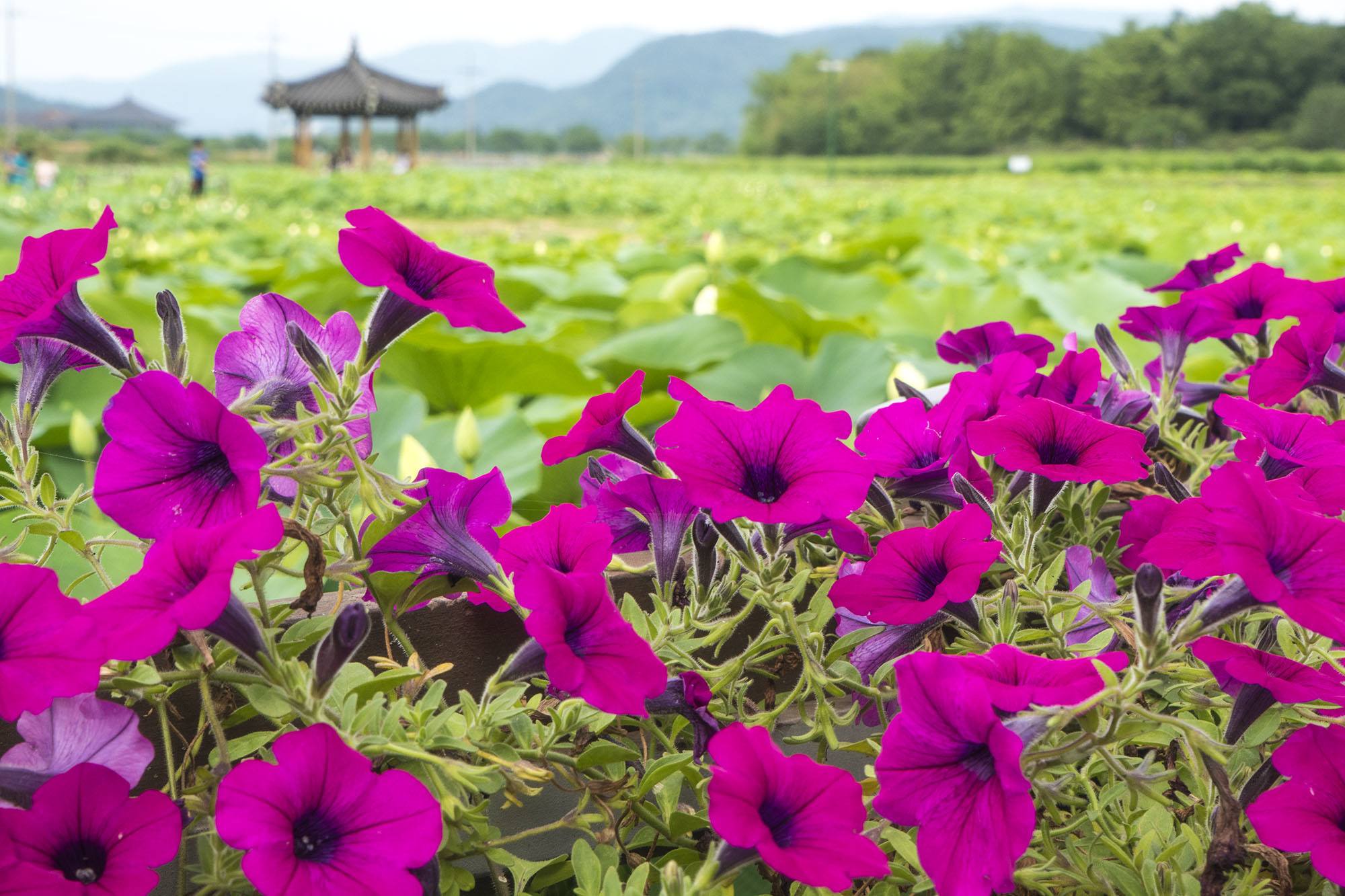
You will be hard pressed to see every finite artefact, especially if time is of the essence. The following are notable sights worthy of a spot on a two-to-three-day Gyeongju itinerary.
Donggung Palace and Anapji (Wolji) Pond
A great example of Silla architecture, the ancient – and recently reconstructed – secondary palace to the royal entourage is best visited at dusk.
It played host to royals during the time in which Gyeongju was the capital of the country.
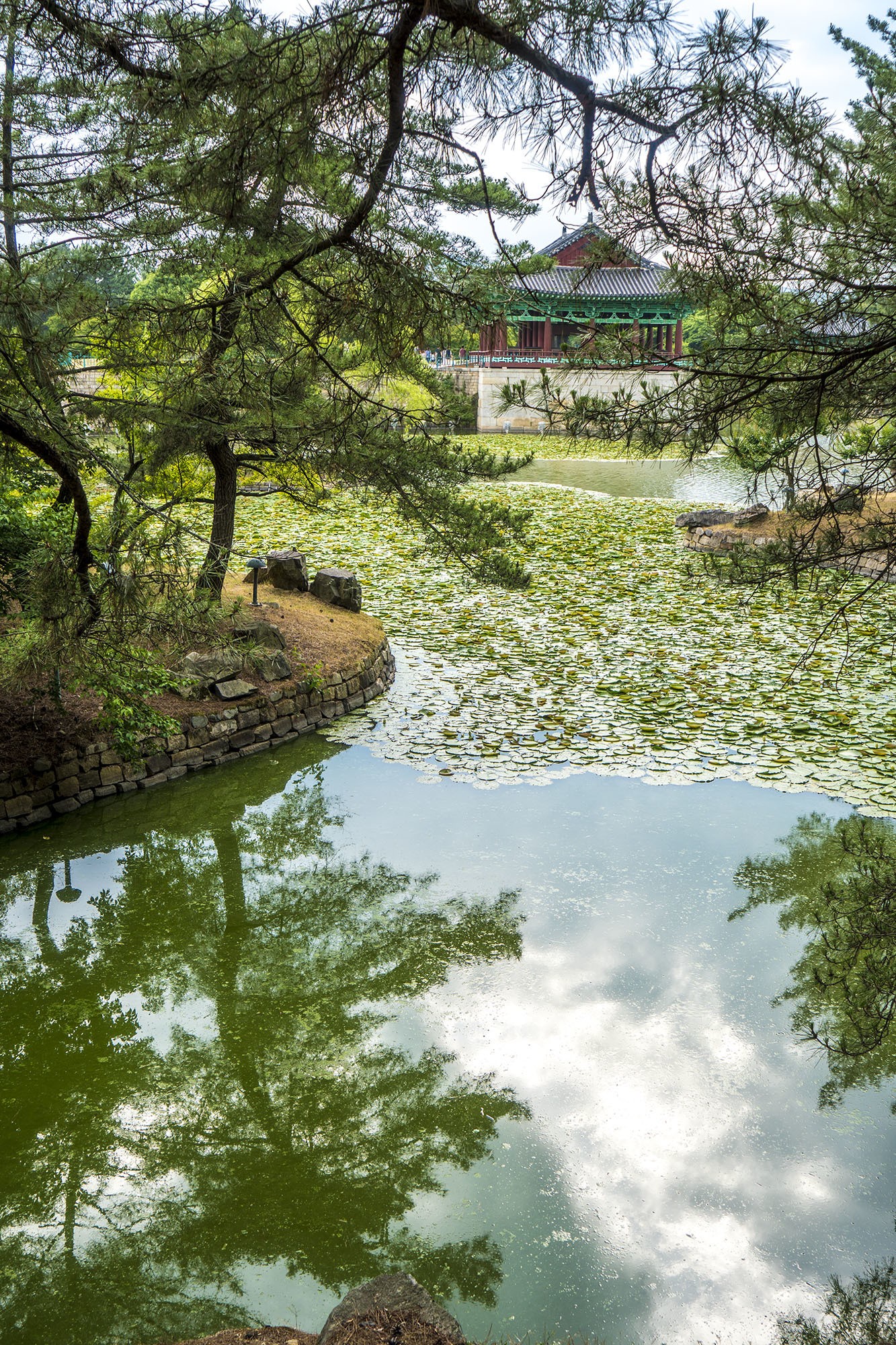
Stroll languidly around the pond and occasionally pull out a tripod to capture the changing light of the sky – reflected brilliantly in the still waters - as dusk morphs to night.
The palace, with its pond, exemplifies the grace and elegance of those who ruled the nation from the first to the 10th century.
National Museum
A short walk from the beautiful pond, the National Museum will dazzle even the least historically-imbued at heart.
Home to a gold crown, displays of ornate jewellery, relics of the Shilla dynasty and the most resonant bell in Asia, it’s possibly the most impressive museum in all of pint-sized South Korea.
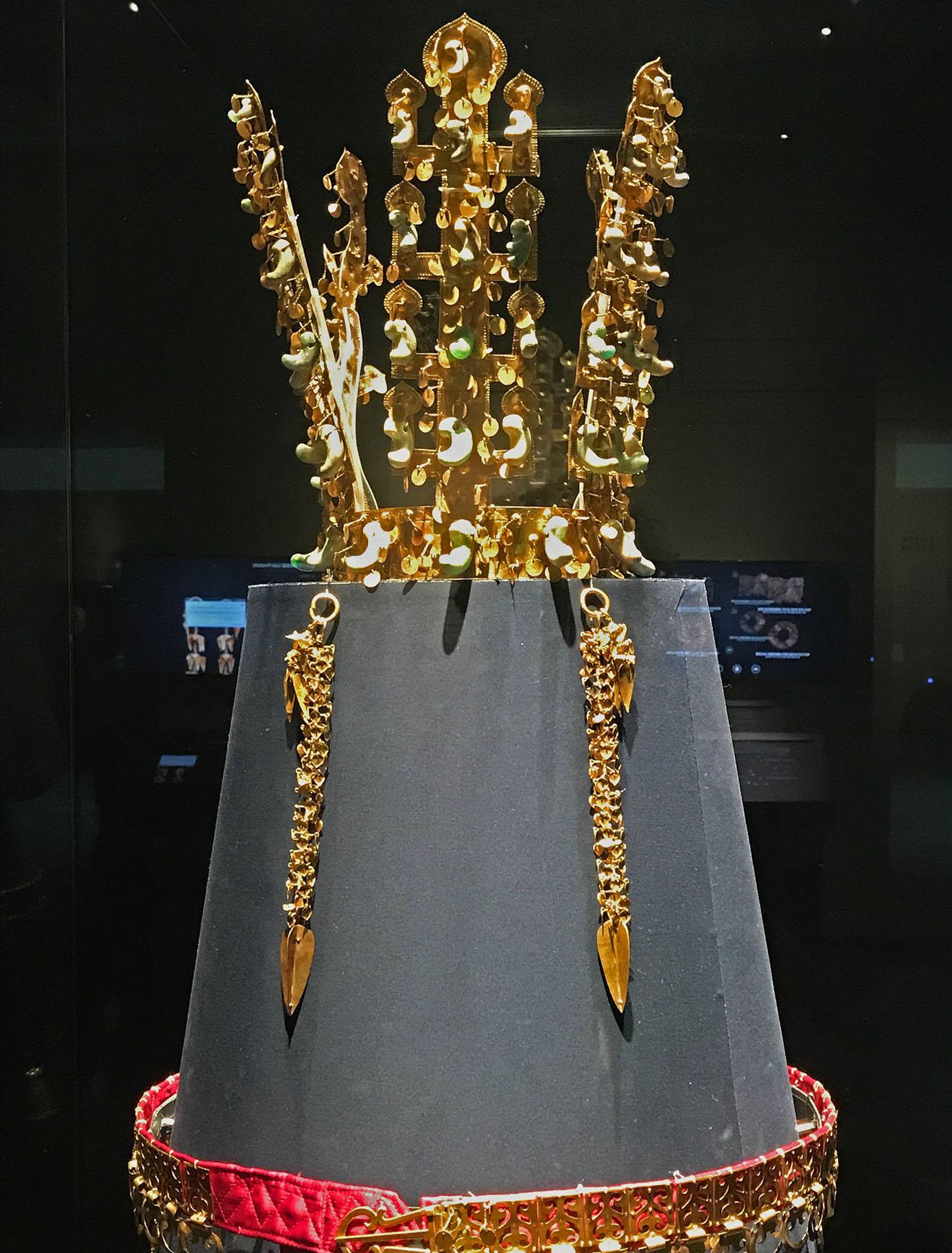
Built originally in the sixth century, the temple has been renovated and reconstructed several times in various dynasties following its original creation under the Silla. Despite its facelift, the religious architectural site is exemplary, outshining its Korean counterparts in terms of grandeur and beauty in other corners of the country.
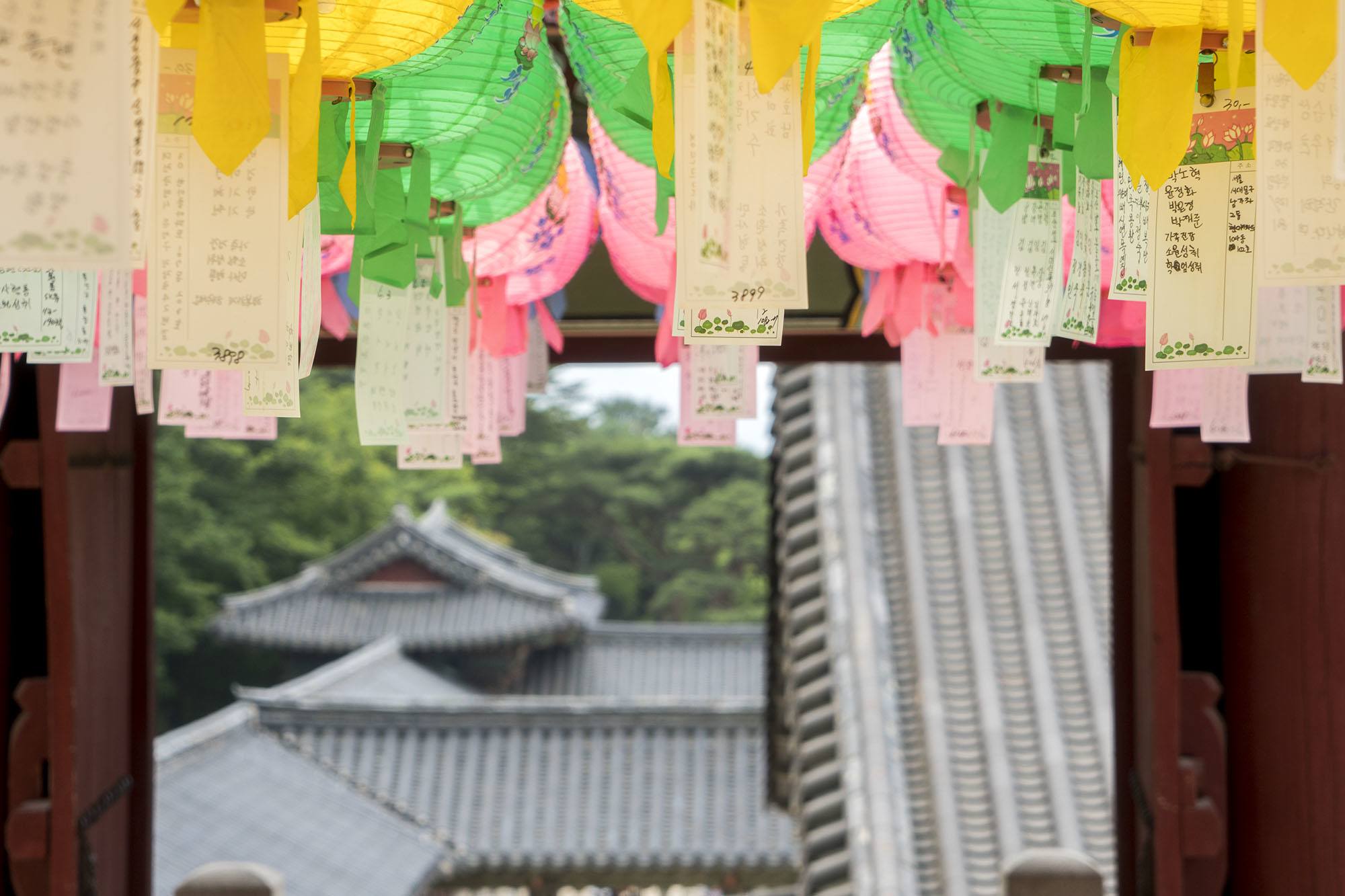
Even with the hordes of Korean tourists creating a flurry of dense activity on any given day, the maze-like temple provides many opportunities to hide, and seek out new treasure.
Take bus number 10 from Gyeongju, and arrive within an hour.
Testament to the ingenuity of its builders, the grotto – inside of which stands a giant non-photographable Buddha – is set high on the slopes of Mount Toham. Looking out to sea, the Buddha – who is surrounded by granite – sits with a concentrated mundra, and is said, by some, to be protector of the region.
Even without underlying Buddhist aspirations, visiting the grotto is worthwhile simply for the view. Contemplating its creation high in the hill is also inspiring.

Getting to the grotto is easy: you can hike the steep trail between Bulguksa and Seokguram, or take bus number 12. I lazily chose the latter (which departs hourly), and enjoyed the ride, particularly as the bus wove its way around the precipitous and bendy mountain road.
Gyeongju Hyanggyo Confucian School and Neighbourhood
Located in Gyodong, a short walk from the Cheomseongdae Observatory , the provincial hyanggyo (or school) was commenced during the Joseon period, and now commemorates the Confucian scholar who resided there.
The school aside, the entire neighbourhood oozes historic charm, replete with stone paved roads and architecturally notable homes.
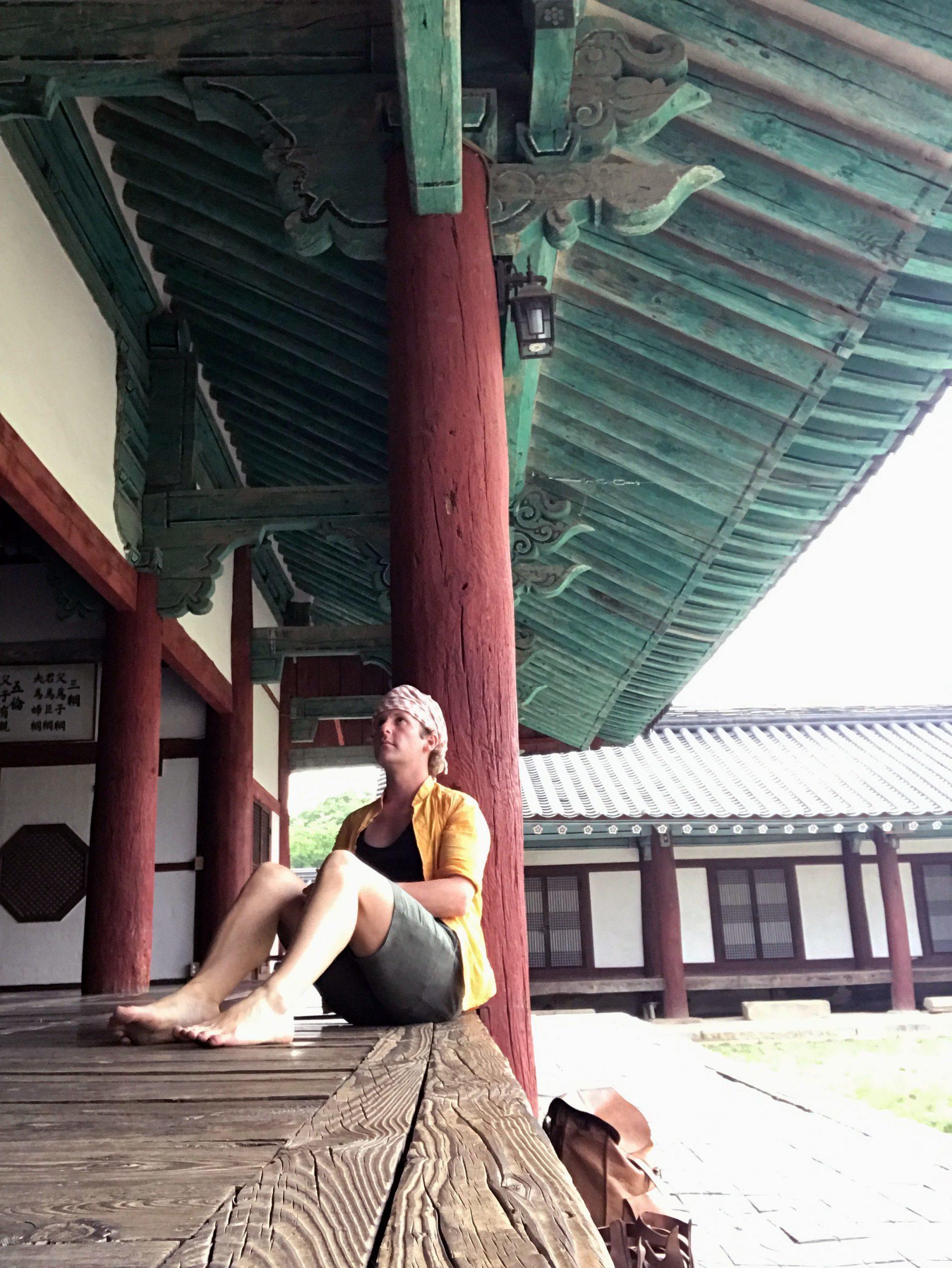
Restaurants - albeit overpriced - abound, as do stores exhibiting all kinds of Korean paraphernalia.
Staying in Gyeongju - RECOMMENDED LENGTH OF STAY
Spend the first two days seeing the historical sights within city limits with day three dedicated to visiting Bulguksa and Seokguram.
Staying in Gyeongju - ACCOMMODATION
I stayed at the well-established and beautifully bedecked Blueboat Hostel Gyeongju .
As a moderate size city with approximately 250,000 inhabitants, there are plenty of accommodation options. Consult the following websites for up to date information regarding prices and availability of accommodation in Gyeongju:
Eating in Gyeongju - RESTAURANTS
There are some great places at which to experience Korean food in Gyeongju, although there is nothing particularly famous from this region aside from seafood. I ate at a different restaurant and market each day and night of my three day stay. Here are a handful I would suggest trying:
- Do-sol Ma-eul - for a traditional meal in a historical structure
- Jungang Night Market - multi-ethnic cuisine
- Daebak Jip - great barbecue pork and beef
- The area near the bus stop for Bulguksa (near the hostel in which I stayed) is home to a host of restaurants and market stalls serving fresh food

Getting Around in Gyeongju - TRANSPORTATION
Collect a map from the main train station before you embark on expeditions around Gyeongju. There are some fantastic sights to see however many of them are scattered about, so a map will prove useful. Your accommodation should have a copy you can take.
I highly recommend getting about on foot , or by bicycle . It's a flat city, which means there is little exertion required. Alternatively, there are bus services that can be utilised.
There are two key buses you'll need, if going between key sights within the city:
- #10 (important 'tourist' stops announced in Korean and English)
- #11 (important 'tourist' stops announced in Korean and English)
For Bulguksa (which is 1.15 hours from Gyeongju) , take any of the following buses:
For Seorguram, take the following bus from the parking lot at Bulguksa:
- 12 (at hourly intervals starting 08:40 and ending 17:20)

Getting to Gyeongju - TRANSPORTATION
There is no airport in Gyeongju, however there are three airports in nearby cities which can be utilised for quick access to the city from various points within and outside of South Korea:
- Daegu International Airport - one hour by express bus
- Ulsan Airport - one hour by express bus
- Gimhae International Airport (based in Busan) - 1.5 hours by bus (or 50 minutes by train)
By Land Train
There are daily train services to Gyeonju from various other cities within South Korea. They include:
- Various services (low and high speed) between three and seven hours
- 50 minute train journey
- 30 minute journey
- Between 30 minutes and an hour
There are regular services between Seoul and Gyeongju as well as a few of Gyeongju's closest neighbours. For services from other locations, transfers are required with connections in Daegu or Busan.
- Forty minutes
JEJU-DO (제주도)
A prized possession of the Republic, Jeju-do – Korea’s largest island - is notably the jewel in the nation’s sparkling crown.
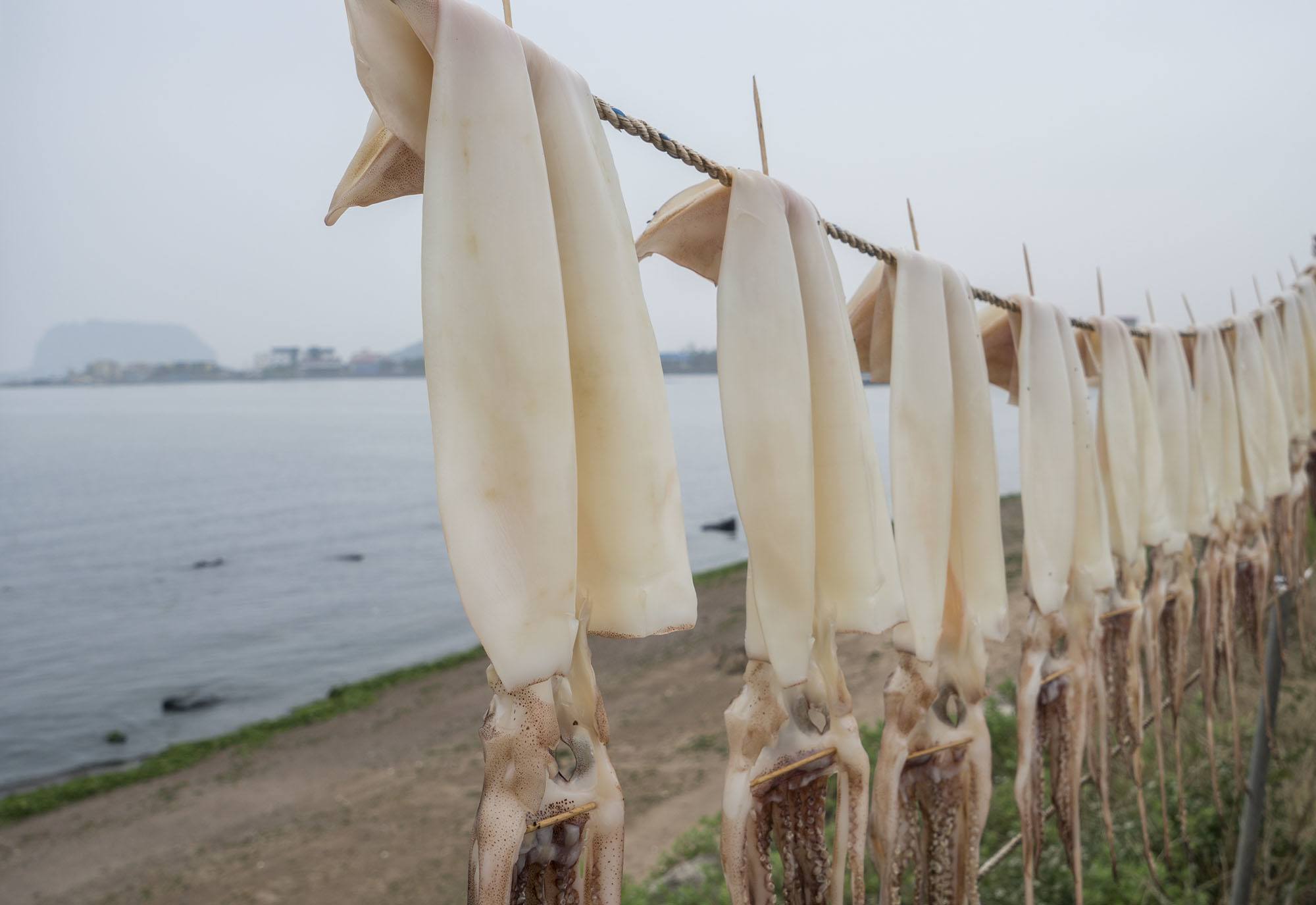
A short flight from the mainland (or longer ferry ride), it caters to a broad spectrum of tastes, and boasts the country’s best beaches, lushest landscapes and most rewarding bucolic activities for true nature enthusiasts.

As the country’s most popular domestic travel destination, you are guaranteed to get up close and personal with Koreans: overcrowding, in summer, is likely. However, thanks to kilometres of accessible beaches and walking trails, escape is no mere dream.
Comprised of 21 connected (and numbered) routes that weave their way mostly around the coastline, the Olle Trail is one of the local government’s most impressive achievements. It’s a form of nature-porn in terms of untouched beauty and sprawling landscape.
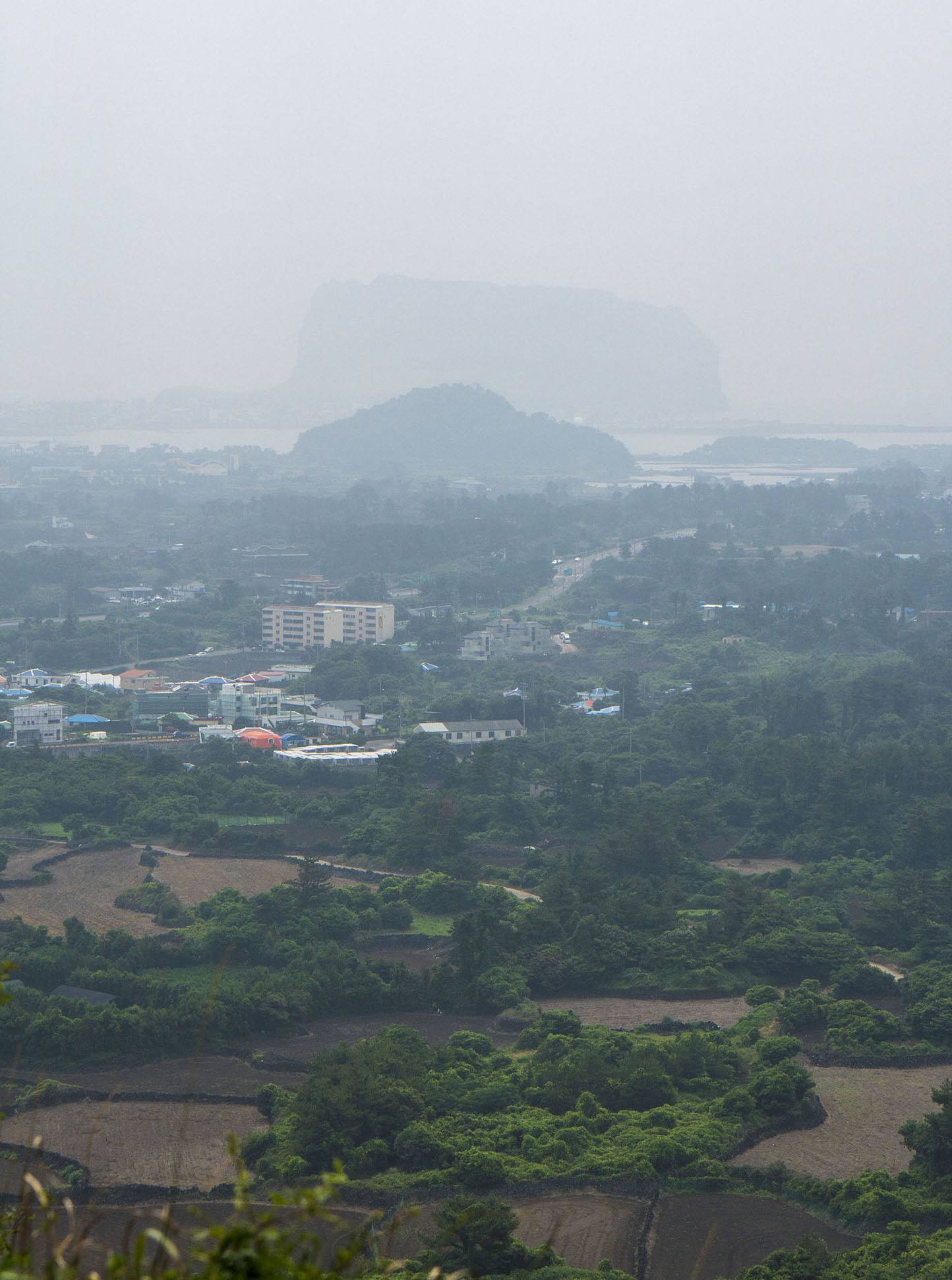
The hilly core often gives way to forests, farms, beaches and oreums (such as Seongsan Ilchulbong).

The views all along Olle Trail One were otherworldly, particularly as I inched closer to the tuff ring of Ilchulbong rising out of the sea. It’s understandably one of the island’s major drawcards.

Don’t forget to collect a stamp at the outset of each trail, a scrapbook-able keepsake. There is an information point at the outset of route one, though most hostels and hotels can provide adequate details for interested parties.
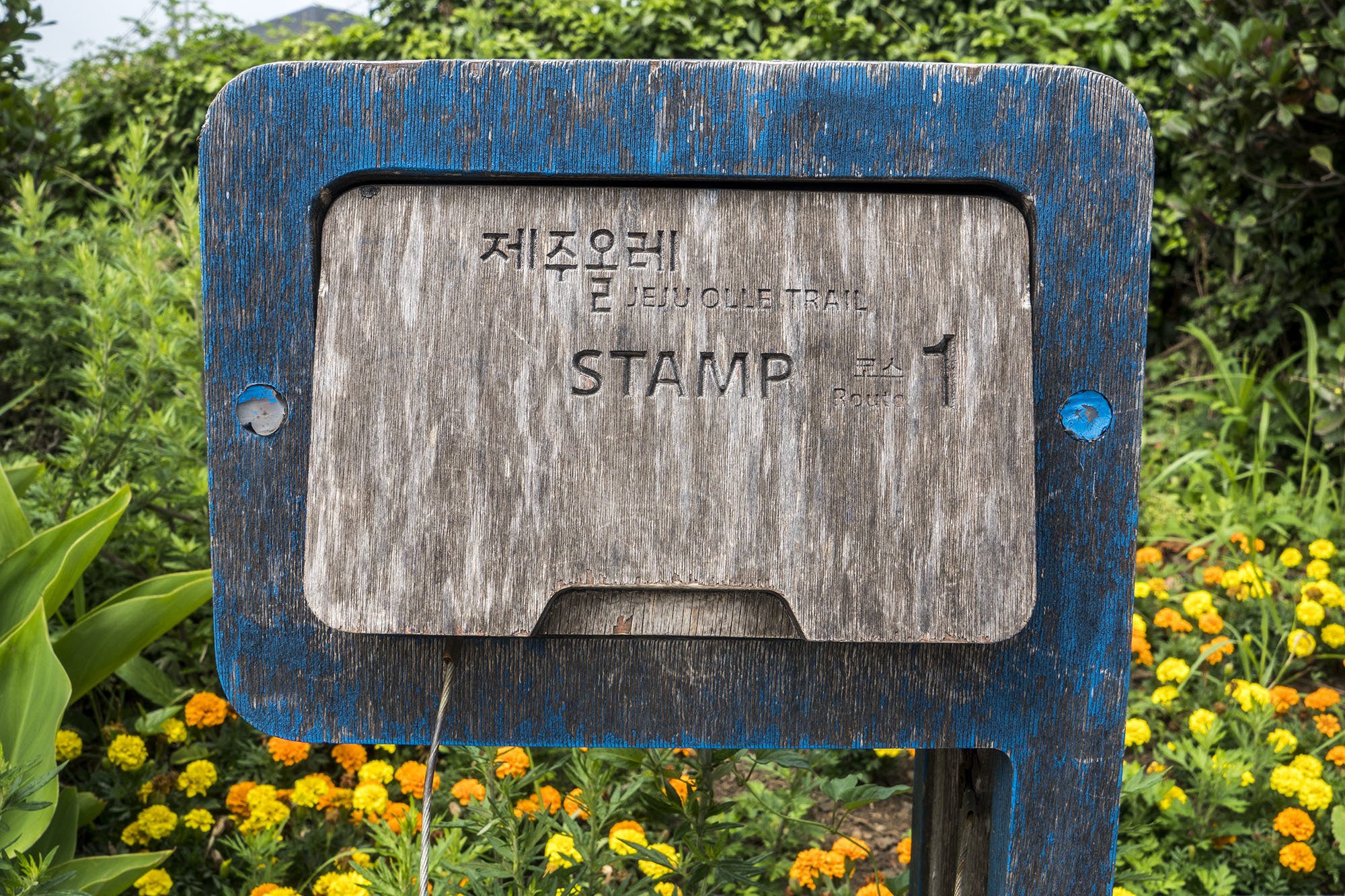
The bus to the starting point of each trail depends on the route you choose to complete. Ask at respective lodgings for full details regarding public transport options.
For broad-sweeping views of Jeju-do, haul it 1950 metres to the summit of Mount Hallasan, Korea’s highest mountain.
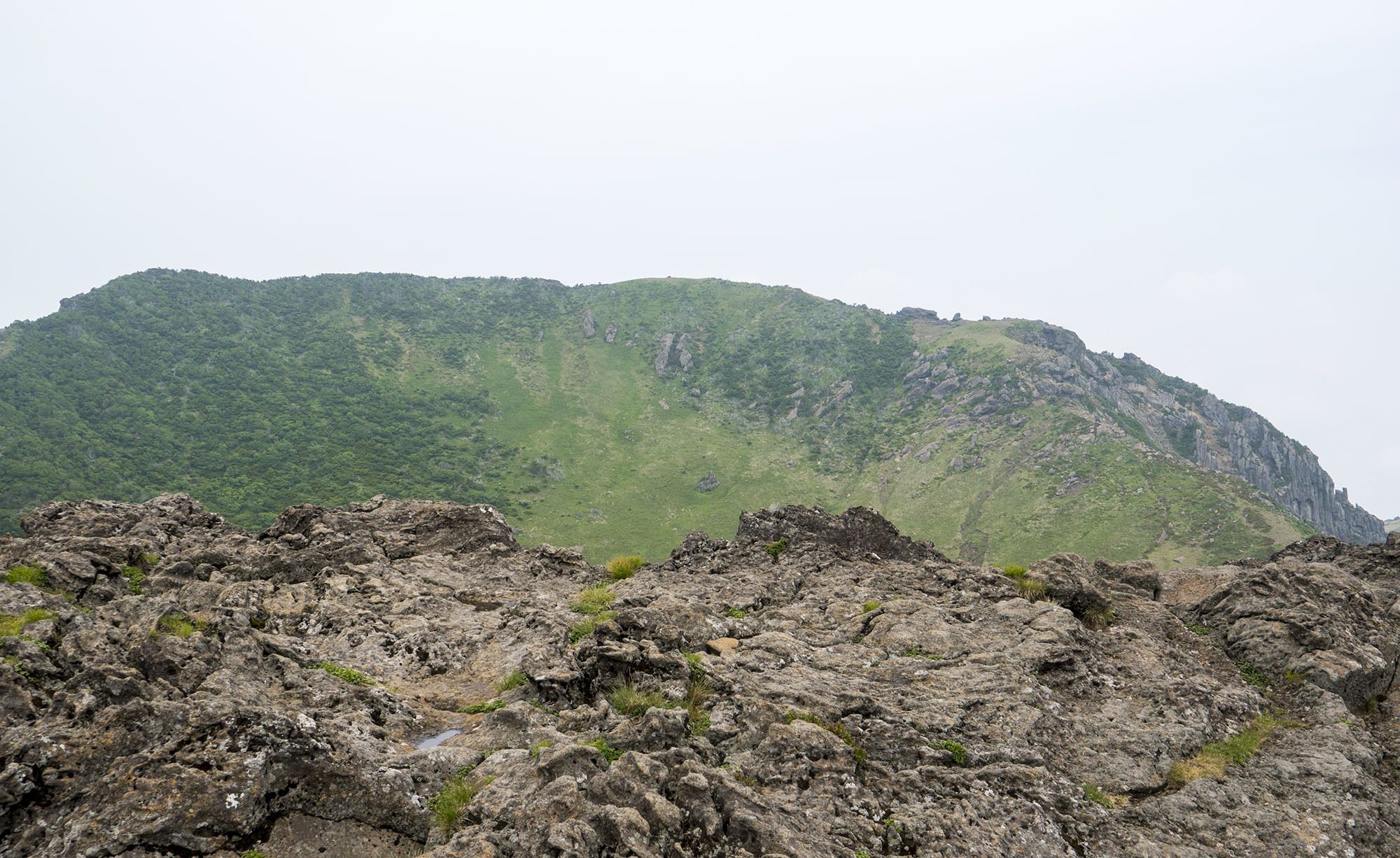
Designated a national park by the government in the late 20th century, hiking – at least part way to the summit - is a priority itinerary item. Replete with vibrant flora, it’s a picturesque ‘walk in the park’ despite the gruelling large stone steps leading to the top.
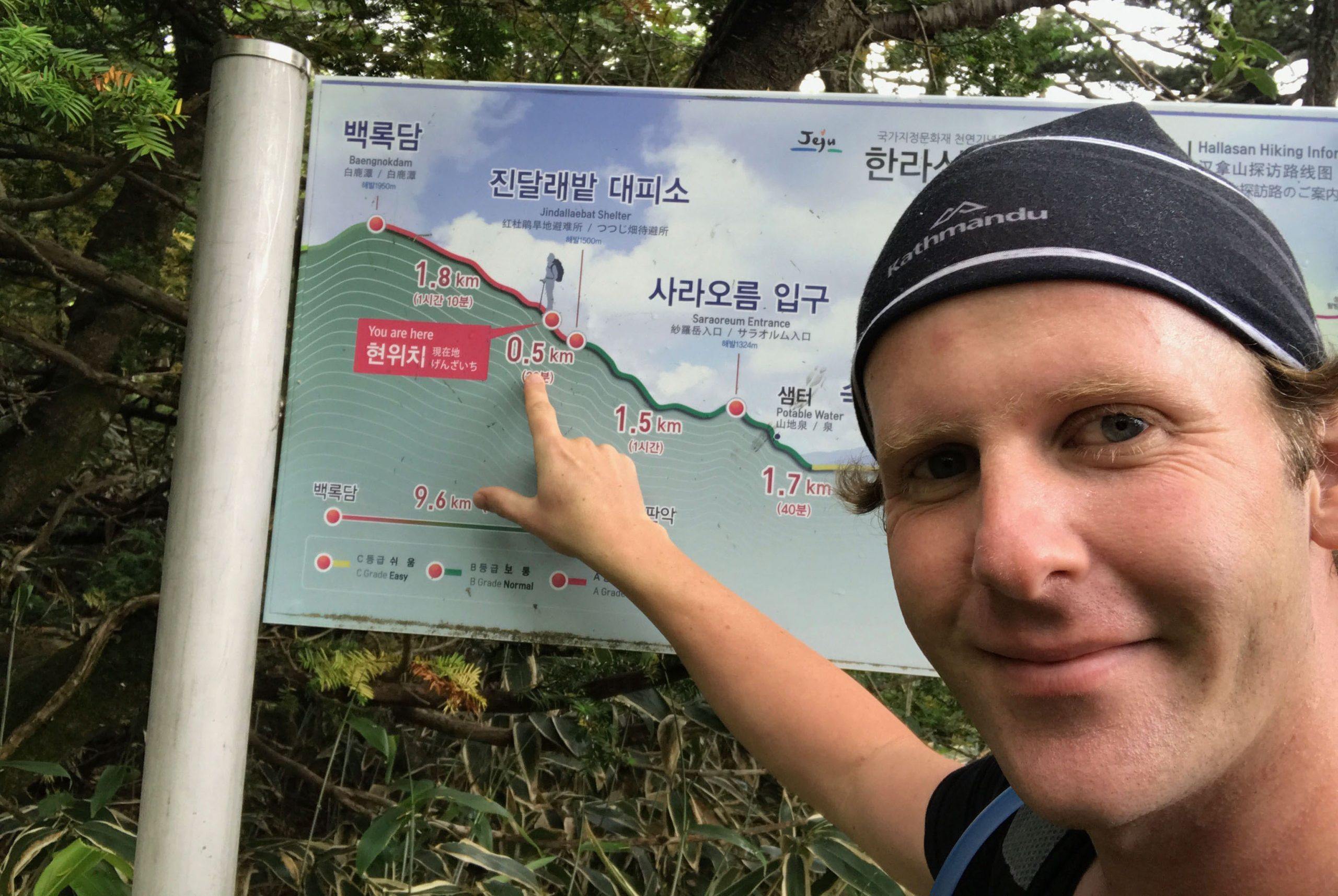
Do check the weather forecast carefully, as arrival at the summit on a hazy day - despite the sense of satisfaction derived from your accomplishment - can be spirit-crushing.
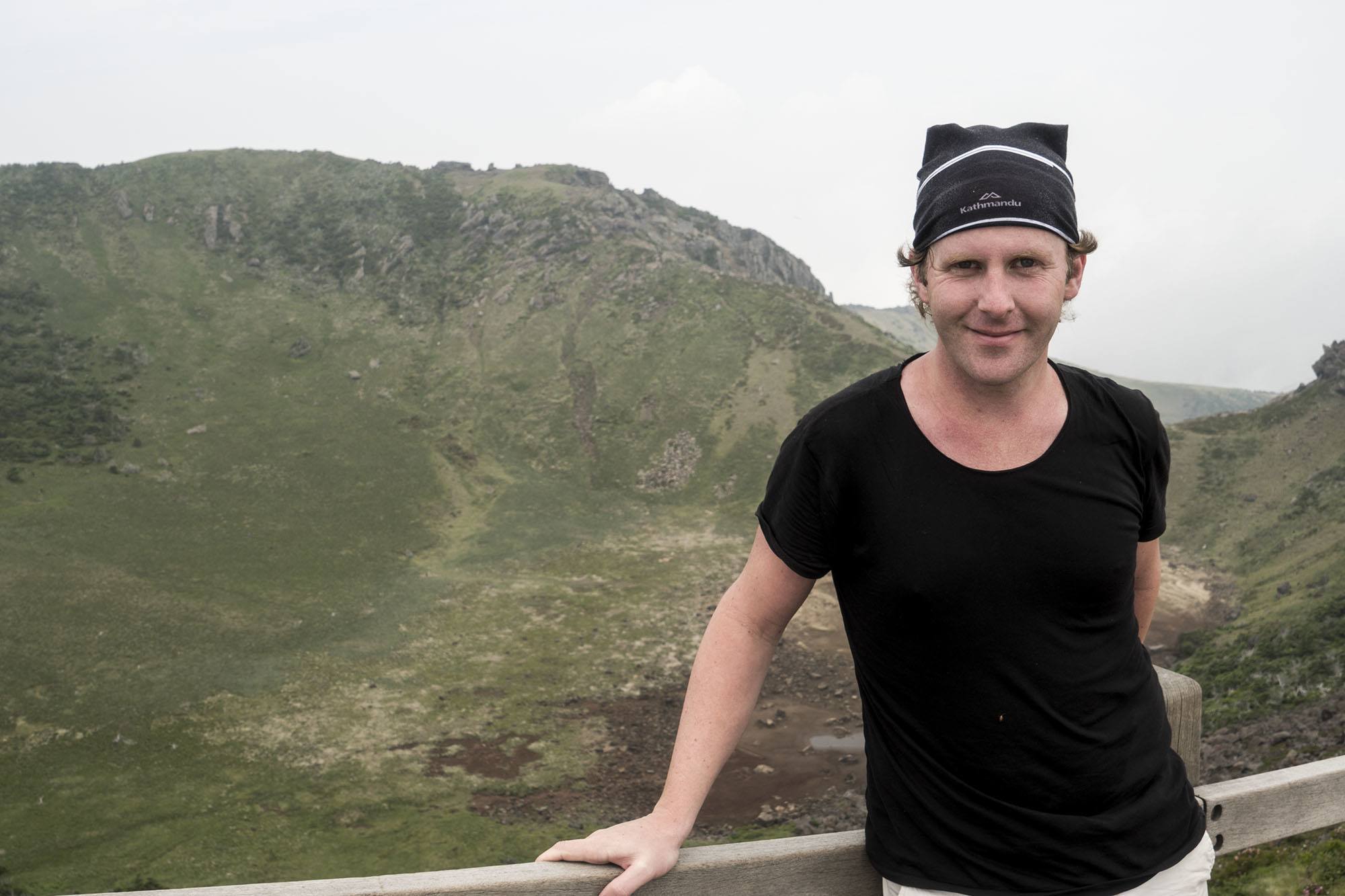
Unlike Rome , not all trails lead to the summit. Seongpanak (the ‘softer hike’) and Gwaneumsa go all the way, whereas the other four – despite indulging various senses – only go part way.
Seongpanak trail, despite the large stone steps over which I had to climb at times, was generously covered by broadleaf trees, and surrounded by kaleidoscopes of colour.
Bus 781 transports hikers to the starting point of Seongpanak trail, a ride of approximately 40 minutes from the city’s Intercity Bus Terminal (and various other stops along the route).
For information regarding access to the other routes, ask at respective lodgings.
Staying in Jeju-do - RECOMMENDED LENGTH OF STAY
Four to five days
Spend the first day checking out the few sights of the city (if that's where you're staying) or getting to know the area around your accommodation. Spend another day trekking to the summit of Hallasan, with at least one more day walking one of the Olle trails. If the weather permits, hit the beach (on another day), or head to some of the waterfalls.
Staying in Jeju-do - ACCOMMODATION
I stayed at U & I Guesthouse which was okay in terms of cleanliness and value for money. Its location was ideal, however, as was its vicinity to bus connections for other parts of the island.
For alternative options, consult the following websites:
Eating in Jeju-do - RESTAURANTS
There are dining options of all sorts scattered across the entire island. Most lie around the coast and in urban areas. I ate a a variety of restaurants and eateries in different locations. For a list of recommendations, read the following article:
- Top 6 Jeju Island Restaurants
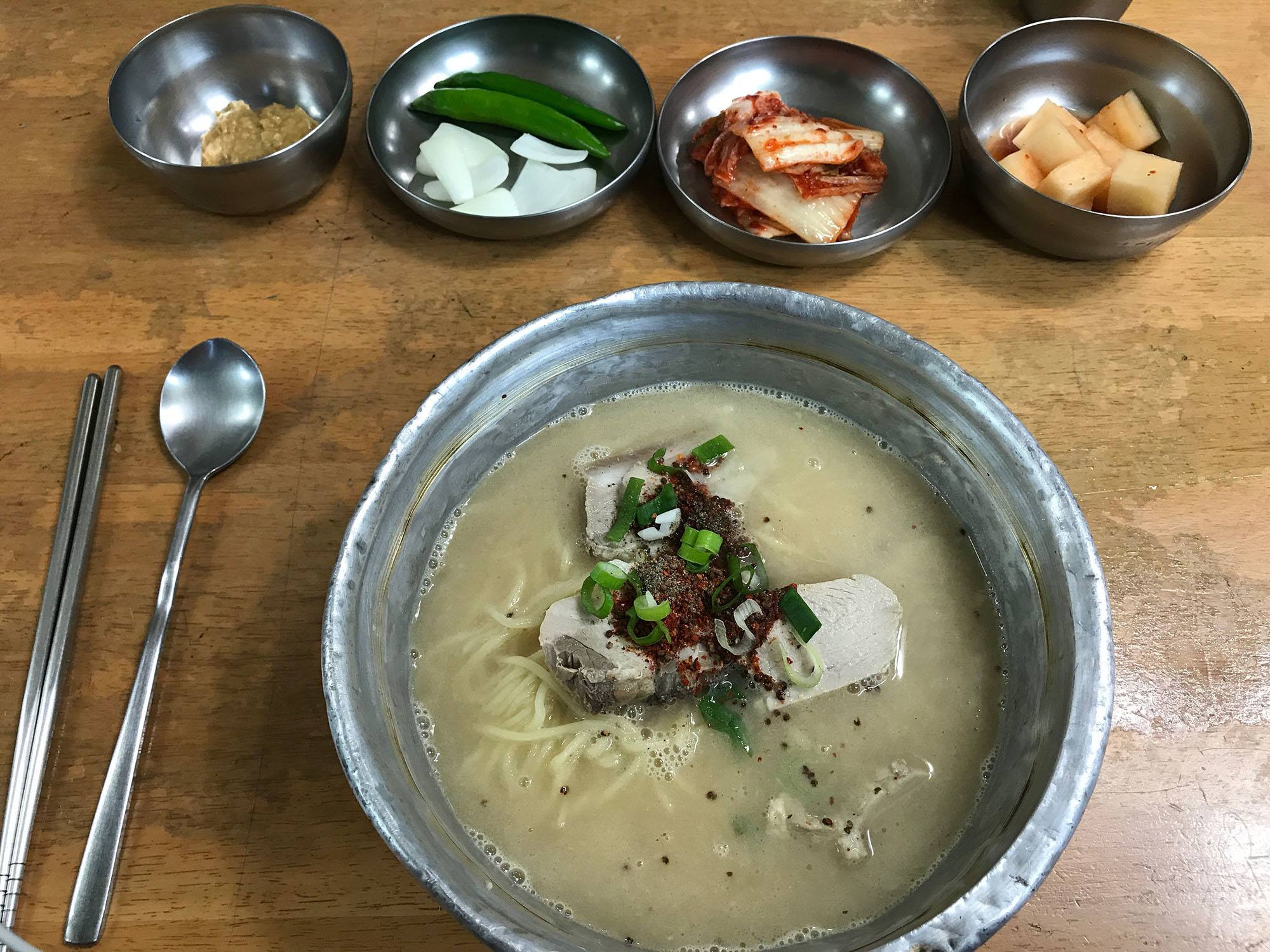
Getting Around Jeju-do - TRANSPORTATION
Jeju Island is relatively large, so getting around the entire island on foot is not recommended (unless you have a few weeks and wish to complete the entire Olle Trail). Bus, car/motorcycle and bicycle/friendly rides are your best options.
There are many buses that run inner-city and inter-city routes throughout and across the island. Rather than list them all here, I recommend you speak to the staff at your accommodation who will be able to tell you exactly which bus to take to get to your desired destination.
- The buses accept cash and T-money cards from Seoul
- Have the destination name written in Korean to show the driver in case he or she needs to charge you a specific fare for the route
- Bus number 600 is the airport limousine
Hiring a car on Jeju-do is perhaps the most sensible option, if it is within your budget and means. It provides you with the greatest amount of flexibility, however it does mandate you have in your possession an international driving permit.
Ask at your accommodation for the best deals around.
Friendly Rides
I'd spent the day out of Jeju City, catching the bus in the morning with plans to take it back to the city in the evening. After sharing my table at a cafe with a group of lively young Koreans and chatting, getting to know one another, they insisted I return with them. I thus had a loud and very entertaining ride back to the city and they kindly dropped me at my desired destination.
One of the benefits of solo travel is the ability to squeeze in when there is only one space left. Being alone is less intimidating to locals than being in a duo or group. People are often more inclined to speak with you if you are a solo traveller because you don't pose a large, embarrassing threat to their English language skills (as my Korean skills were basically non-existent).
You never know who you're going to meet and where new encounters may take you. Be open to opportunities and new friendships.

I met several travellers while on Jeju Island who were not only riding around the island, but also making their way around the continent - and some the world - on the back of two wheels.
The roads on the island are wider than those of the mainland, there is less traffic and in some areas, there are bike paths. I heard circling the island on bicycle takes close to a day. It would be a great way to see the sights and it's less costly and more environmentally friendly than a car.
Ask at your accommodation for bike hire recommendations.
Getting to Jeju-do - TRANSPORTATION
The airport on the island is called Jeju International Airport. It services more than 20 airlines, all of whom have direct flights to Jeju.
- Most flights to Jeju are from Gimpo and Busan (on South Korea's mainland)
- There are some direct flights from Japan, China and Hong Kong to Jeju
- Flights to Jeju outside of the three countries above are usually not direct, so transfers will need to be made in another major airport inside or outside of South Korea
For flights to Jeju International Airport, compare the following websites to locate the most reasonable fares:
- Sky Scanner
By Sea Boat/Ferry
There are several direct ferry routes to Jeju. Most travellers arrive by plane, thanks to competitive prices. However, ferries, particularly overnight services, will save you in accommodation. The following cities have direct routes to Jeju:
- 11-hour journey
- 7pm departure
- Monday to Saturday services
- three to four hour journey
- 13-hour journey
- 1.5 to five-hour journey
Make reservations via phone or consult the staff at your accommodation for help.
ITINERARY FOR VISITING SOUTH KOREA - CONCLUSION
There you have the (mostly) overground journey I undertook as a solo backpacker in South Korea.
As a soloist, it can - at times - be challenging to find a travel destination in which you can truly unwind and feel carefree, safe and adventurous on your own. South Korea was one of those destinations for me. It's easy to navigate, friendly to the core and unpretentious. I wouldn't hesitate to recommend it to other travellers - solo or not - for a taste of the exoticism inherent to East Asia.
It’s quirky. It’s pure. It’s fascinating. It provides everything you'd expect of a developed nation and a little more.
Are you tempted? Go on, try it for yourself. You won't regret it. I promise.
ITINERARY FOR VISITING SOUTH KOREA - NOTE
There are inclusions and exclusions that can be completed to personalise the itinerary, depending on personal preferences. It can be done within the timeframes suggested, slowed down or ever accelerated a little.
Busan could easily be added to this itinerary, between Gyeongju and Jeju-do. I opted to spend more time in Seoul, returning at the end of the trip for a few days to prepare for my stay in Mongolia. However, staying in Busan for two to three days would definitely be possible.
Please feel free to contact me in regard to anything you’ve read in this article.
Further Information
Getting to south korea - transportation.
For flights to South Korea, compare the following websites to locate the most reasonable fares:
NOTE: There are seven international airports across the country, two of which are in Seoul. Incheon is one hour west of Seoul, and is the largest of all seven, with flights arriving from all over the world. Gimpo is more centrally located in Seoul than Incheon, however most of the flights in and out of it are domestic.
If it's your first time to South Korea, then chances are you'll be arriving at Incheon (unless you specifically opt to fly into Busan or Jeju-do).
There are sea connections mostly between South Korea and Japan with a few others to China.
- Busan Port International Ferry Terminal operates daily services between Busan and various ports in Japan. Contact them for up to date schedules and prices
- Incheon International Ferry Terminal One operates services between Seoul and various ports on mainland China. View the English version of their website through this site for up to date information (if it's working)
By Land and By Train
I think the answer here is obvious. If not, then perhaps a review of geography and political relations between South Korea and its closest neighbours is warranted.
Due to its location on a peninsula, getting to South Korea overland would require getting through North Korea. It is, ergo, virtually impossible, in part because it is the most heavily guarded border in the world.
Your options are limited to arriving by boat or plane.
Getting into South Korea - VISAS
Visa rules and regulations, for most countries, change and are updated often. As such, it is highly recommended you consult South Korea's immigration guide for up to date information.
As it currently stands, citizens of 109 countries will be granted a visa on arrival for a period between 30 and 90 days.
If you are visiting only Jeju-do , then the rules are even softer: citizens from every country except Afghanistan, Cuba, Ghana, Iran, Iraq, Kosovo, Macedonia, Nigeria, Palestine, Sudan and Syria will receive a visa on arrival.
Staying in South Korea - ACCOMMODATION
Consult the following websites for up to date information regarding prices and availability of accommodation throughout the Republic of Korea (South Korea):
If you are after specific recommendations for a particular city, then consult the advice provided at the end of each section throughout this article.
Spending in South Korea - CURRENCY
The currency utilised in the Republic of Korea (aka South Korea) is the South Korean Won . Please refer to the following website for current and up to date exchange rates:
Soloing in South Korea - TIPS
Aside from ill health, I didn't really experience major issues while travelling alone through South Korea. I met some spirited Koreans and other travellers who were filled with so much joie de vivre it had a positive impact on the way I was feeling. I therefore never had an opportunity to feel lonely, although it rarely happens when I'm on my own (hence why I opt to travel alone).
If you are travelling solo in South Korea more out of necessity than by choice, you'll have no problems meetings others. Being open and willing to engage are key. If you achieve this, you'll be richly rewarded as Koreans, despite a lack of outward displays of affection, are culturally and emotionally generous.
South Korea, despite the threat that lurks above in North Korea, is safe and easy to navigate. In this sense, it really is a solo traveller's paradise. Engage if you wish or move to the beat of your own drum - both are possible and totally acceptable here.
There are accommodation options for solo travellers unlike in other destinations around the world. Eating alone was also rarely problematic, the sense of unease I sometimes feel when walking alone into a restaurant staying away most of the time. No-one even lifted a head when I sat by myself at a table.
If you're okay with your own company, you'll likely be fine moving around the country on your own.
Here are a few very general tips that might help you while travelling alone in South Korea, things I repeat across the website in regard to multiple destinations:
- be open to engagement with the local population wherever you go - it'll help reduce feelings of loneliness that may arise;
- transport reading material or some form of entertainment with you for longer journeys and times when you are really on your own (such as arriving at a summit following a day of independent hiking);
- maintain an open-minded disposition particularly to new experiences wherever they present which will also serve to heighten intrigue and reduce the possibility of lonely thoughts creeping into your mind and heart;
- take a mobile phone (that's unlocked) with you and buy a local SIM card (when in a metropolitan area) so that you can access the rest of the world if - and more realistically when - the need arises (such as times during which you are feeling isolated, frightened or lonely); and
- remember that no experience lasts forever. If you do start feeling isolated, lonely or anxious, remind yourself that you won't be there forever. Focus on the good you've experienced, remind yourself of your aptitude for overcoming barriers by thinking of past experiences of success and stoicism and treat yourself to something nice and familiar (whether it be a Netflix movie, down time with a glass of red wine and a book or an ice cream savoured while sitting before beautiful scenery).
I truly hope you get as much joy out of visiting South Korea as a solo traveller as did I.
Asia, country guide, East Asia, guide, itinerary, Republic of Korea, South Korea, travel guide
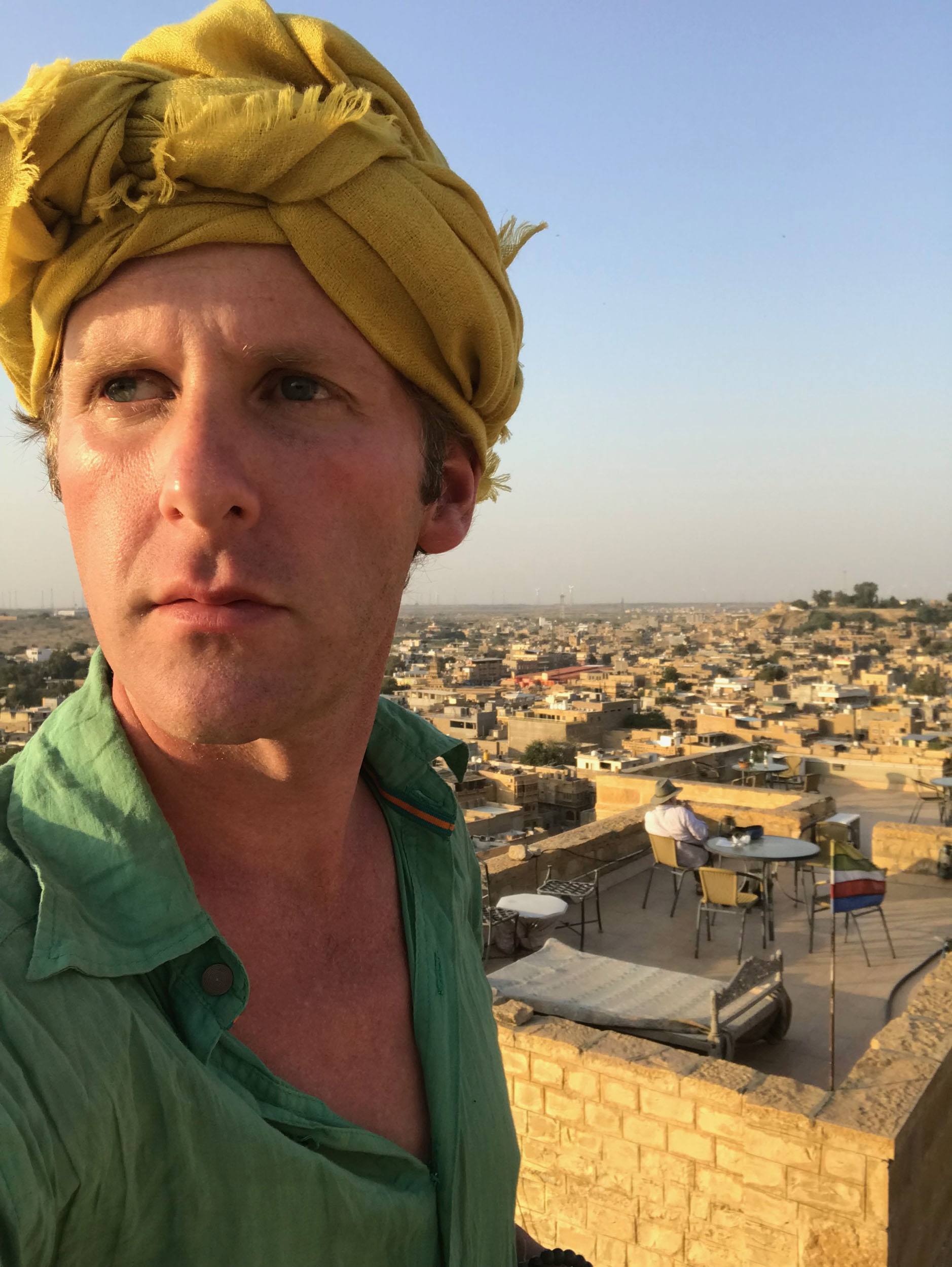
TRAVELLER, WRITER, PHOTOGRAPHER, Nurse
Ben, a seasoned solo traveller, writer, photographer, nurse, and health advocate, embarked on his global journey in 2003 at 18, transforming travel into his life's work and passion. His website reflects his extensive experience and insights, offering guidance on exploring the world uniquely and maintaining health while on the road.
You may also like
Unforgettable things to do in tashkent: a thrilling guide, uzbek food guide: discover 26 wonderful things you must try, an epic 2-week uzbekistan itinerary: traversing the silk road, is uzbekistan worth visiting discover the secrets of its timelessness, travel with me on instagram.

Session expired
Please log in again. The login page will open in a new tab. After logging in you can close it and return to this page.


Gina Bear's Blog
Solo Female Travel | Latina Traveler
Ultimate 5-Day Seoul Itinerary (South Korea Travel Guide)
If you’re planning a 5-day Seoul itinerary, look no further because Gina Bear has got you covered. Why should you listen to me above all the other travel bloggers out there? Simple. I lived in South Korea for five and a half years. I speak the language, I lived in Korean society, and I extensively explored Seoul during the pandemic. This is your go to Seoul trip blog. In this ultimate Seoul travel itinerary, you’re going to know the best places to eat, best experiences to try, and where to stay in Seoul.
This post is designed to be a done for you Seoul travel guide. Even though this is a five days in Korea itinerary, I am factoring in two travel days for when you arrive and depart. Alternatively, if you live in South Korea and are planning a holiday, then this itinerary is perfect for you too!
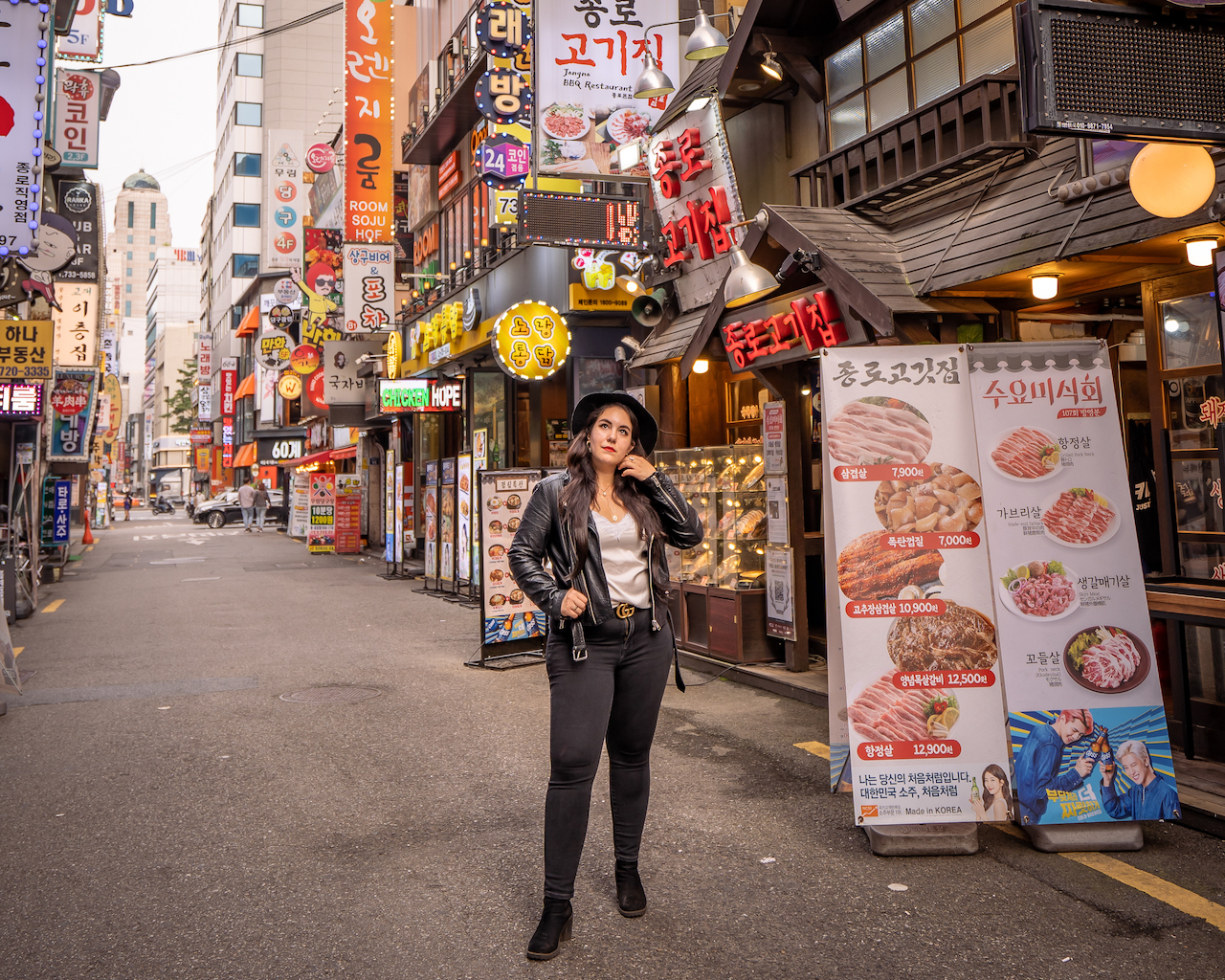
Table of Contents
Blog Posts You Might Like
- Incredible Things To Do in Seoul
- A Complete Guide On Where To Stay in Seoul
- The Ultimate Guide To Solo Female Travel in Korea
When Is The Best Time To Visit South Korea?
There’s always something happening in Seoul no matter what season you visit. However, if you want my personal recommendation, come during spring for all the amazing cherry blossom festivals and autumn for the incredible fall foliage.
Spring in Korea
Korea in spring brings all the beautiful flowers. Since cherry blossom season in Korea is so short you have a very short window to catch them all. In addition, you can visit many different Korean spring flower festivals. Also, shop for the coveted Starbucks Cherry Blossom collection because it sells out super fast. The temperature during this time is comfortable, but prices are more expensive since many Asian holidays happen around this time of year.
- Spring in Seoul | What To Pack for Spring in Korea
- The Best Korean Spring Festivals
- The Ultimate Guide To Spring in Korea
- Where To See Cherry Blossoms in Seoul
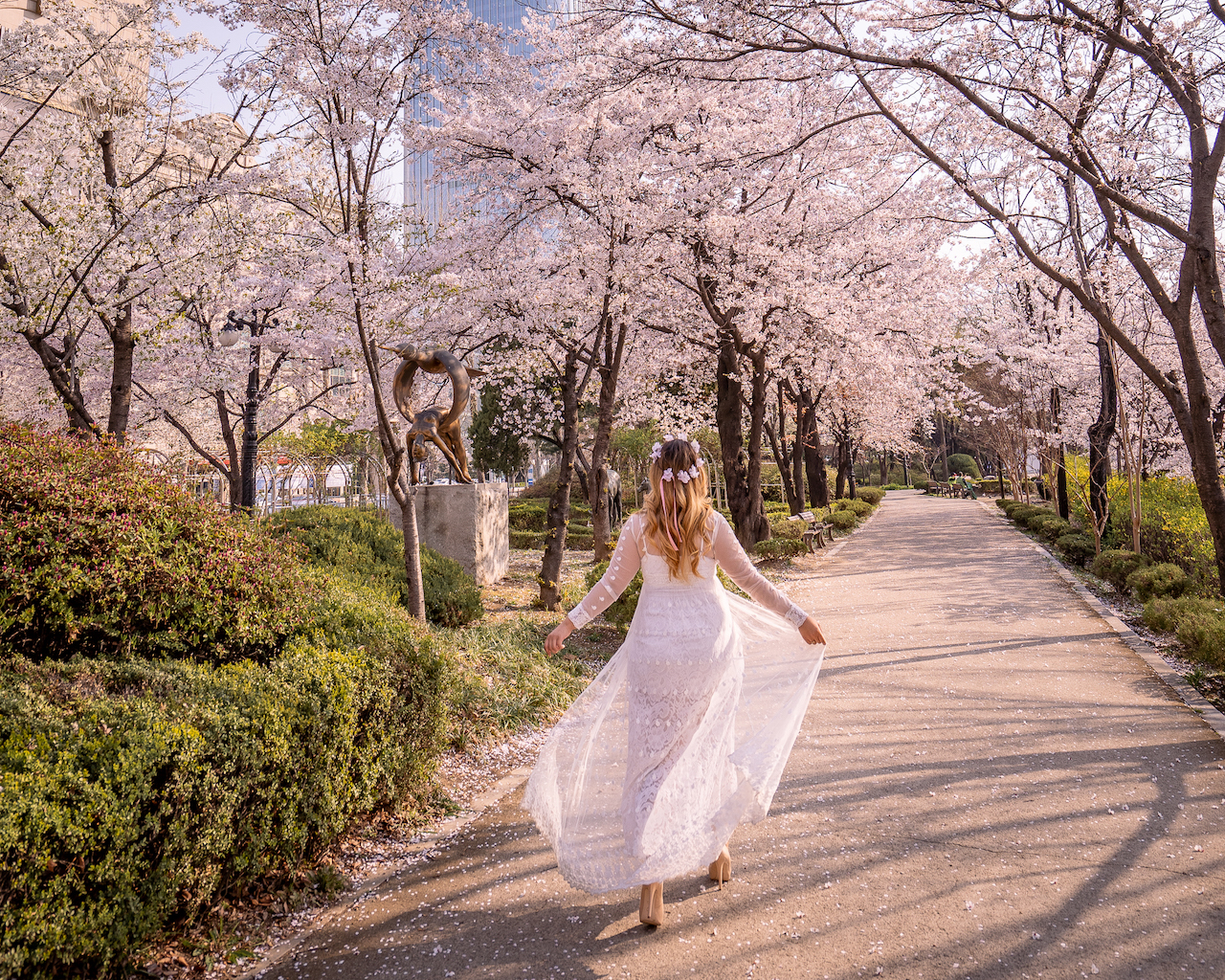
Summer in Korea
Like everywhere around the world, Korea in summer is peak tourist season. The best time for Korea summer travel is June and September. July and August bring rainy season so expect to be very moist. recommend visiting Jeju Island as it is perfect to hit the beach and have a cheap staycation.
- Summer in Seoul | What To Pack For Summer in Korea
- The Ultimate Guide To Summer in Korea
- What To Do During Rainy Season in Korea
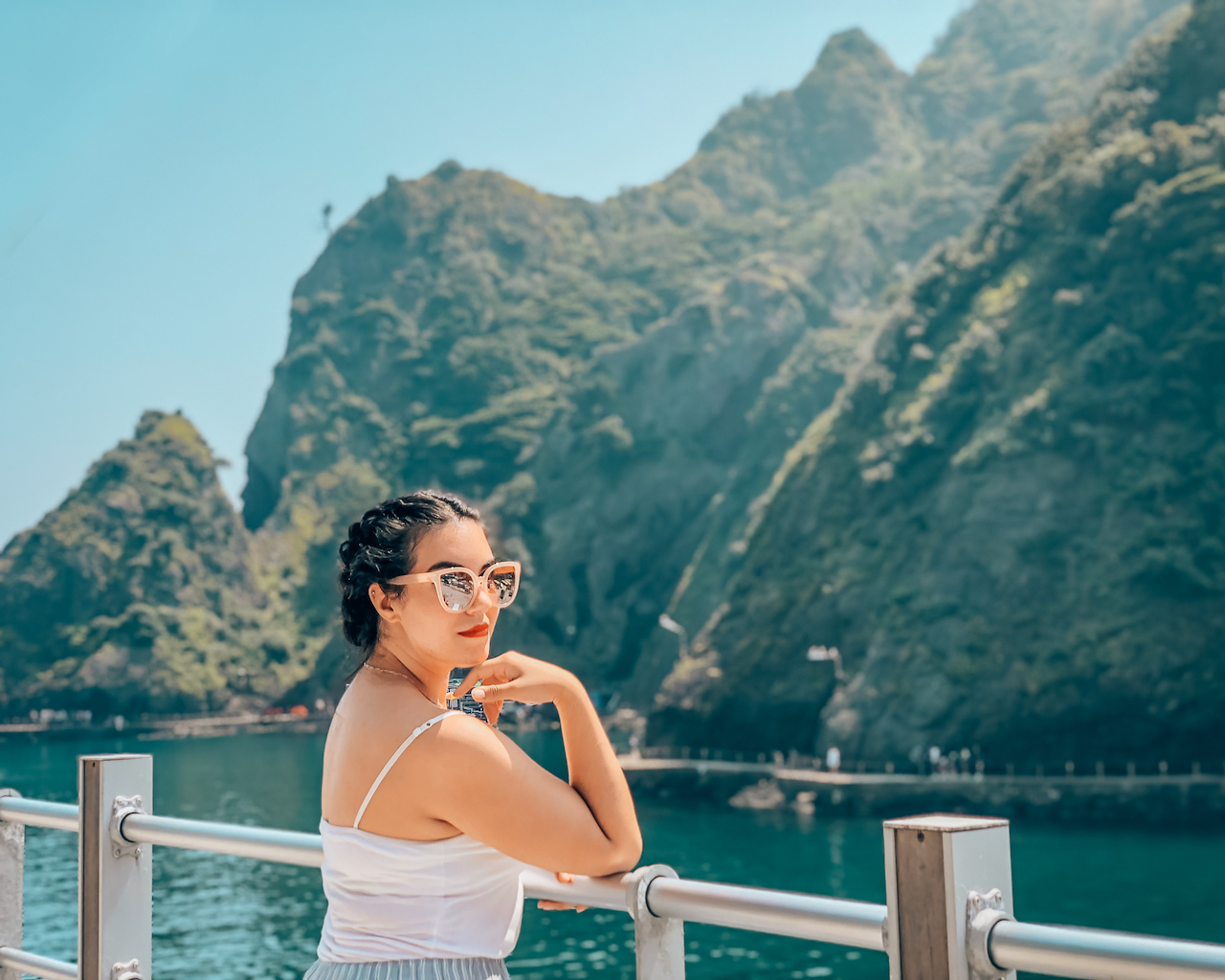
Autumn in Korea
Korea in autumn turns trees bright colors of red, yellow, and orange. September in Seoul still sees many tourists but starts to trickle out in October and November. Fall is shoulder season in Korea as it doesn’t see many tourists. Chuseok (Korea’s Thanksgiving) is around this time. Everything shuts down as Koreans travel back to their hometowns to celebrate with their families. I recommend doing a lot of hiking in Korea’s mountains and traveling to traditional cities like Gyeongju for the best fall in Korea experience.
- The Best Autumn in South Korea Festivals
- The Ultimate Guide To Autumn in Seoul
- Seoul in Fall | What To Pack To Korea in Autumn
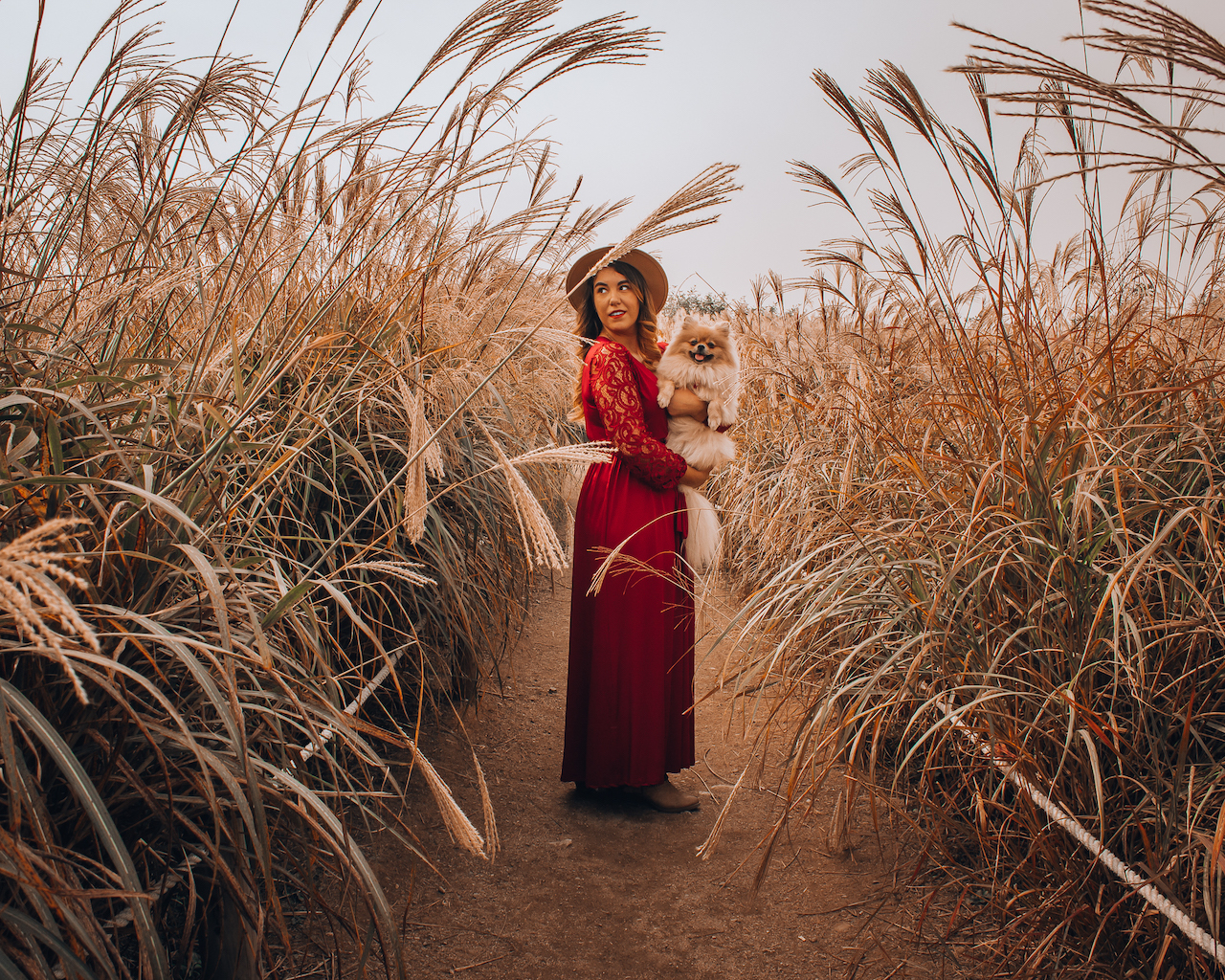
Winter in Korea
Believe it or not, winter in Korea is a great time to visit. Flight prices drop except for around Christmas. Visit early December when the Christmas displays and illuminations decorate Seoul. The Lotte World Theme Park and Everland offer foreigner discount tickets. There are also incredible Korean winter festivals to check out.
- Cool Winter Festivals in South Korea
- The Ultimate Guide To Christmas in Korea
- The Ultimate Guide To Winter in Korea
- Winter in Seoul | What To Pack For Korea in Winter
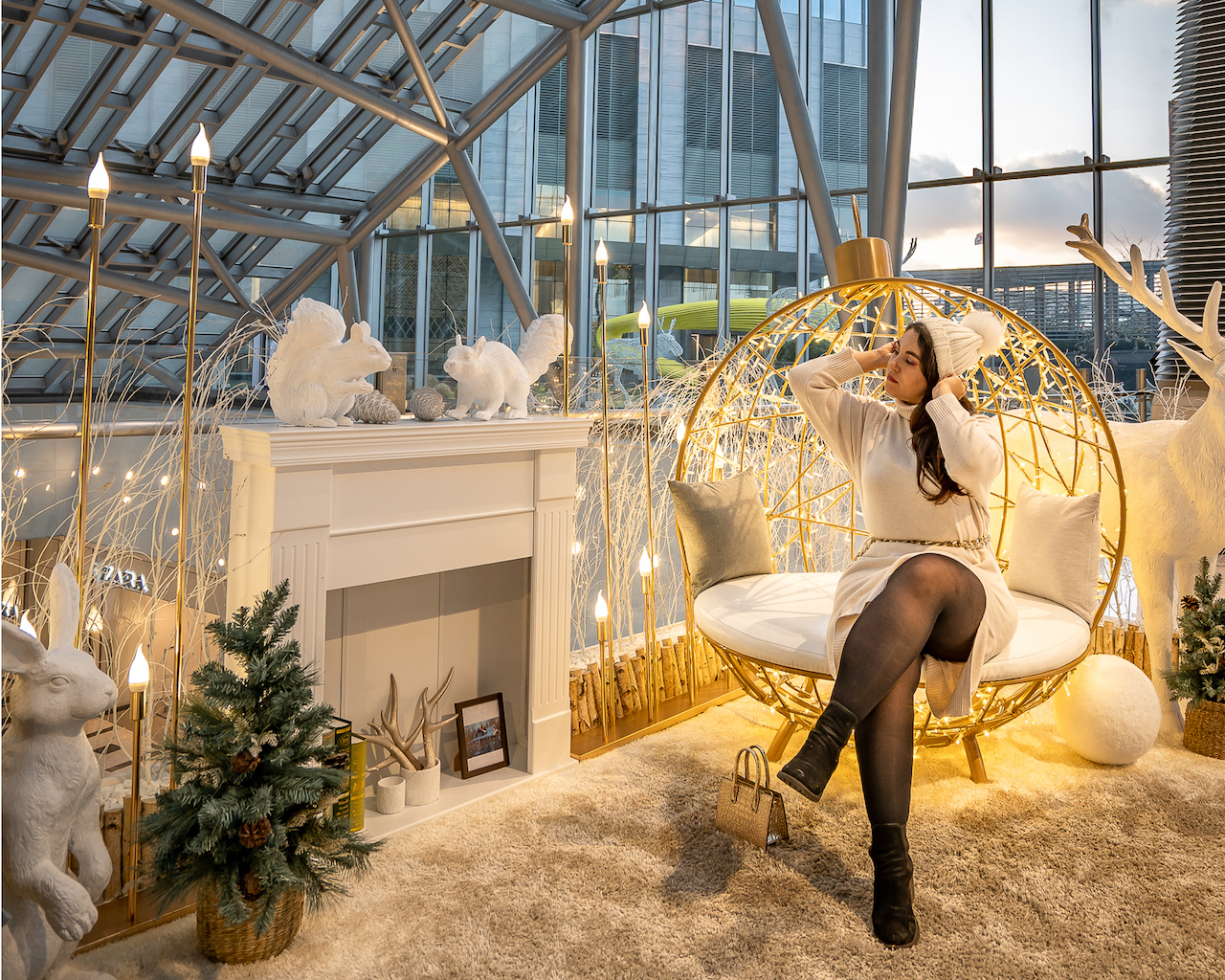
Is five days in Seoul enough time?
If you’re wondering how long to spend in Seoul, I would stay for a month. Honestly, five days in Seoul is so short because it is one of the most interesting cities in Asia. If you spend 1 week in Seoul, I guarantee you’ll be left wanting more.
Before You Visit Korea
A trip to the other side of the world takes careful planning and consideration. In this section, I’m going to break down what to pack, what to be aware of, apps you need for Korea, how to get a sim card, and how to save money on your trip. You’ll have everything you need for Seoul in five days.
How To Book a Flight To Seoul
Korea high season travel is from June to July. Plane tickets are most expensive during these months. The cheapest month to fly to South Korea is in March. A flight to South Korea from Los Angeles is typically about 13 hours and 30 minutes. (It’s a pretty long distance, but totally worth it.)
What To Pack For Korea
I highly recommend packing as light as possible so that way when you buy all of your favorite Korean products, there will be room in your suitcase. My favorite travel suitcase brand is Béis . I’m obsessed with their weekender bag, carryon, and checked luggage. Use my code for $15 off your first order and 150 points toward your new account .
I also have an ultimate guide for what to pack to Korea in every season .
Travel Essentials For 5 Days Itinerary In Korea
- Korea travel adapter – Korea uses 220V plugs. You will need a travel adapter . Daiso has them for 5,000 won.
- Unlocked phone – Book a simcard before you visit Korea and pick it up at Incheon Airport.
- USB power strip – This is great for charging multiple electronics at once. It also helps you save space in your bag.
- Air Filter Mask – The air pollution in Korea is bad, and on its worst days can be on par with China. You can buy them at any pharmacy.
- World Nomads Travel Insurance – Give yourself the peace of mind. Many travel insurance companies have flexible COVID-19 cancelation plans.
- Toothpaste – Korean toothpaste sucks. I don’t like it and it doesn’t leave my mouth feeling clean. Bring your own from home.
- Important documents – Bring copies of any important medical documents and a copy of your passport. Leave one copy on your fridge just in case.
- Your passport – This should be a given, but please don’t forget it.
- Credit Cards/Debit Cards – There are ATMs all over Korea and most places accept credit cards.
- Medication – TSA allows you to bring essential medication in your carryon.
Apps You Need To Download For South Korea
Your 5 days in South Korea itinerary will be so much more complete with apps to make your life easier. These were the apps I personally have used to make my day to day life easier.
- Naver Maps – This is your one and only warning. GOOGLE MAPS DOESN’T WORK IN SOUTH KOREA. You need to use Naver Maps which is available in English. Naver Maps for iPhone | Naver Maps for Android
- Kakaotalk – If you want to connect with some cool people you’ve met in your travels, Kakaotalk is the best way to do so. Kakaotalk for iPhone | Kakaotalk for Android
- Kakaotaxi – This app makes it easy to call taxi drivers. The starting fee for taxis is about 3,000 won. Kakaotaxi for iPhone | Kakaotaxi for Android
- KakaoMaps – This is very similar to Naver Maps so just choose one. I recommend downloading both because sometimes you’ll get address links for this app too. KakaoMaps for iPhone | Kakaomaps for Android
- Kakaometro – Have you noticed there’s a trend here with Kakao? They’ve made some pretty amazing apps and this is also great for navigating the subway. Similar to Subway Korea, you’ll get train times, arrival information, and train transfer data. Kakaometro for iPhone | Kakaometro for Android
- Subway Korea – This is one of my favorite apps for navigating the subways. It will give you the times the train will come, what time you’ll arrive at your destination, and which car to sit in for easy transfers. Subway Korea for iPhone | Subway Korea for Android
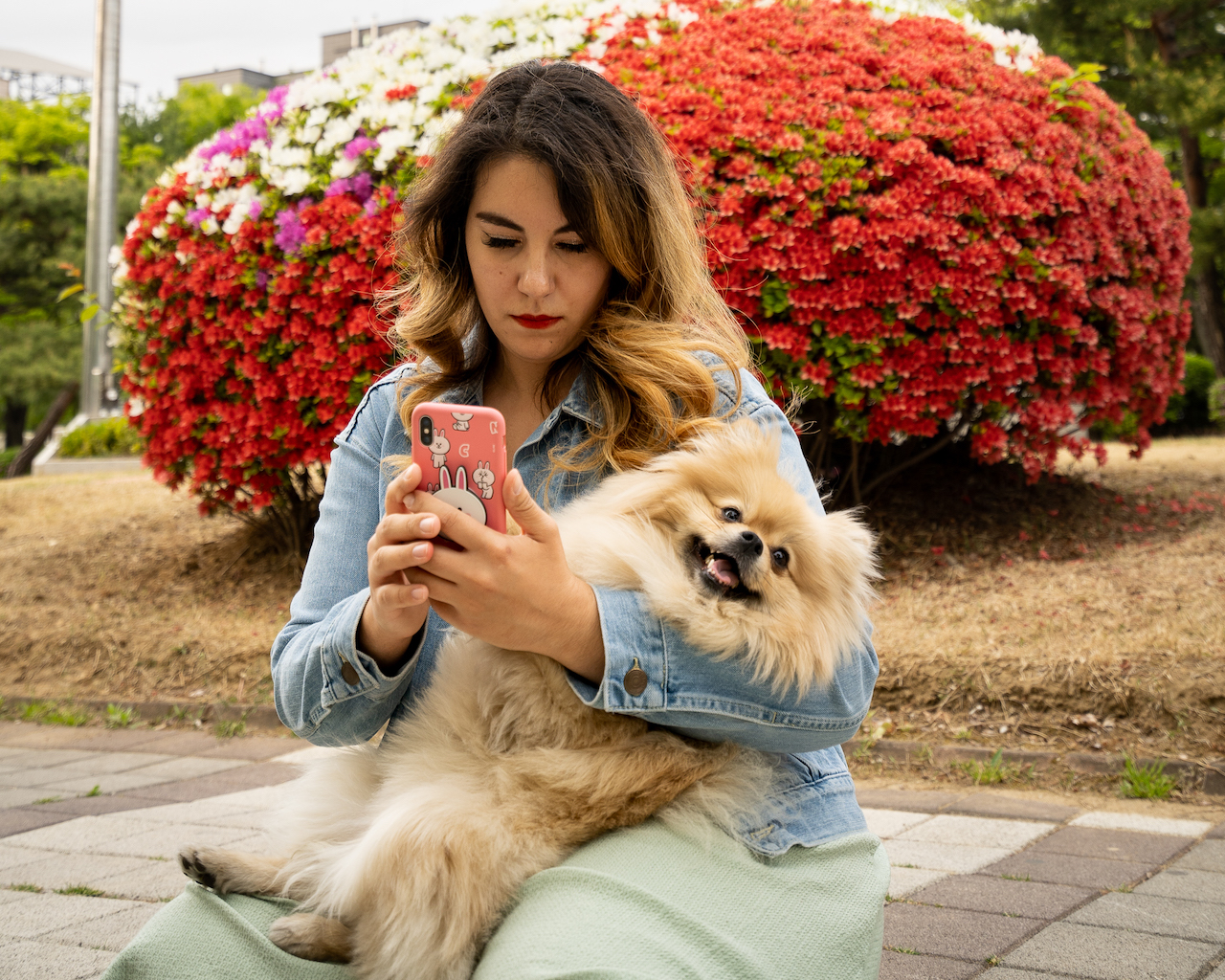
South Korea in 5 Days Sim Card
South Korea has insanely fast internet fast and free Wifi everywhere. I do recommend you get a sim card so you can connect to Wifi in the subway. There are 3 major carriers in South Korea—KT, SK Telecom, and LG U+. You can easily book a physical South Korea sim card here. Your options range from 1 day to 30 days. You will get unlimited data with this purchase and you can add on a phone number and minutes to call.
Get An E-Sim Card for South Korea
One of the coolest things I discovered in my travels is the beauty of an E-Sim card. Why is it so great? It gets downloaded directly to your phone and is activated immediately. This works best if your phone is unlocked. You can purchase an E-sim card for Korea here.
Get Pocket Wifi
If your phone is locked and you’re unable to switch sim cards out, the next best option is to rent pocket wifi. This is also great if you’re traveling with a friend or have multiple devices to connect. Book your pocket wifi here.
Book The Discover Seoul Pass
One of the cheapest ways to travel Seoul is by investing in the Discover Seoul Pass . You can choose the digital card or physical one. The pass doubles as a TMoney card which can be used on public transport like subways, buses and taxis. It can be topped off in any convenience store and train station kiosk. Plus, it comes in increments of 24, 48, and 72 hours. The Discover Seoul pass grants you free entrance into Korea’s top attractions such as:
- Gyeongbokgung
- Changdeokgung
- Jongmyo Shrine
- National Museum of Korea
- Free hanbok rental at Hanboknam
- N Seoul Tower Hanbok culture experience center
- Seoul Bike Rental
- 63 Observatory & Aquarium (you can see a mermaid show here)
- CoEx Aquarium
- Namsangol Hanok Village
- Lotte World Adventure
- E-Land Cruise
- Seoul City Tour Bus
- SK Telecom 1 Day sim card
- FREE Ride on the AREX (airport train from Incheon)
- Plus exclusive discounts!
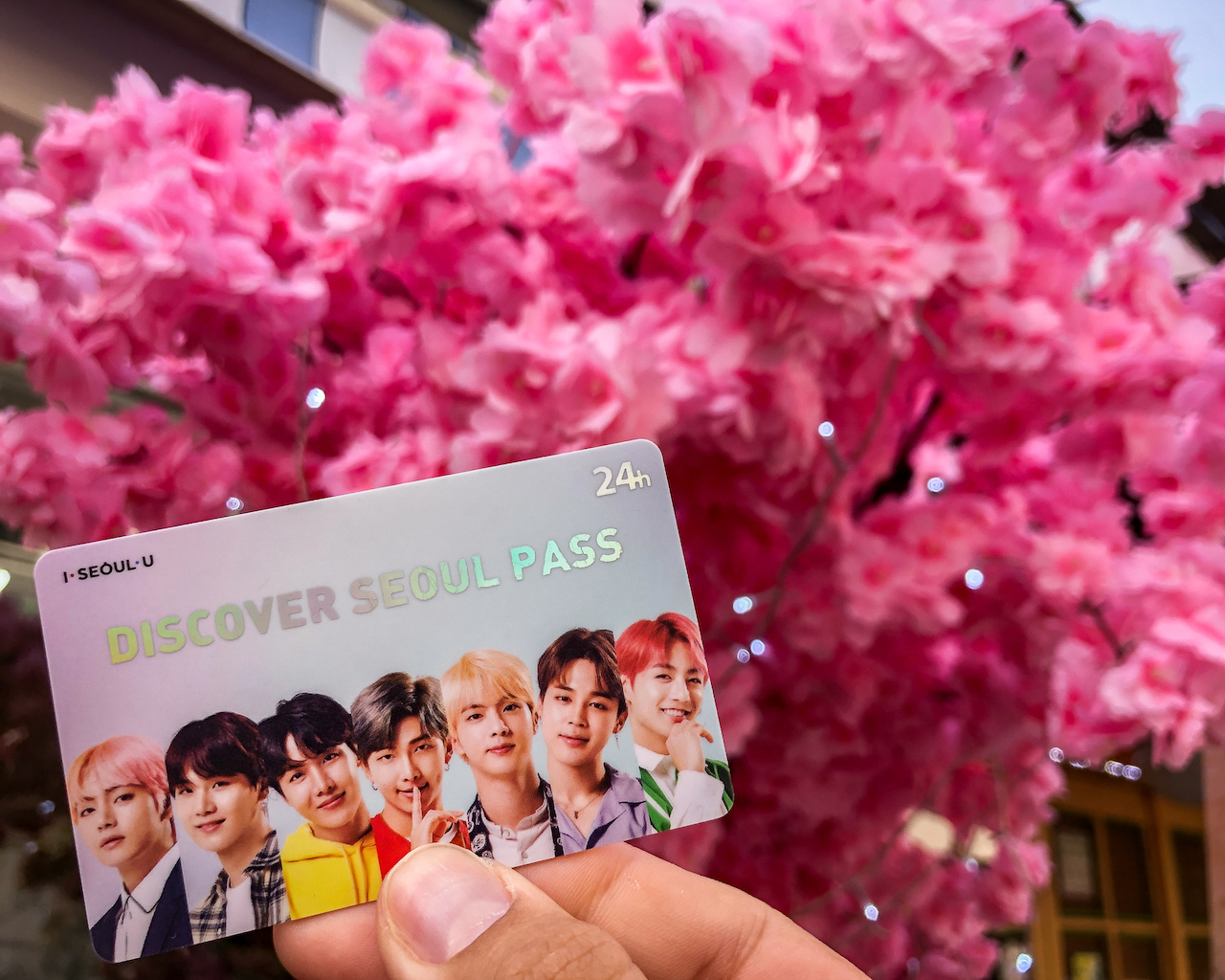
Worried About The Korean Language Barrier?
A language barrier may seem scary during 5 days in South Korea. These apps, products, and courses are all things I’ve used and tested myself.
- Google Traslate – This is a free app where you can put in your mother tongue and target language. You can also take photos and Google will translate. Google Translate for iPhone | Google Translate for Android
- Naver Dictionary – Naver Dictionary is more precise than Google Translate because it was made as a language learning tool for English. Naver Dictionary for iPhone | Naver Dictionary for Android
- Papago – A free app developed for Koreans. I often used it to help translate difficult sentences and phrases. Papago for iPhone | Papago for Android
- 90 Day Korean – If you’re planning a trip months in advance, check out 90 Day Korean. Their course is set up for you to have 3 minute conversation with a native speaker of Korean after 90 days of studying with them.
- How To Learn Korean Easily – This blog post covers all the resources I used to learn and study Korean. You’ll get a list of my favorite tools, websites, books, and apps.
The Pocketalk is a super cool device as it translates 82 different languages in real time. It even has a text to translate camera. This is great for helping you navigate around Seoul. What I like most is its small enough to fit in your pocket or in your purse. You can buy your Pockettalk here.
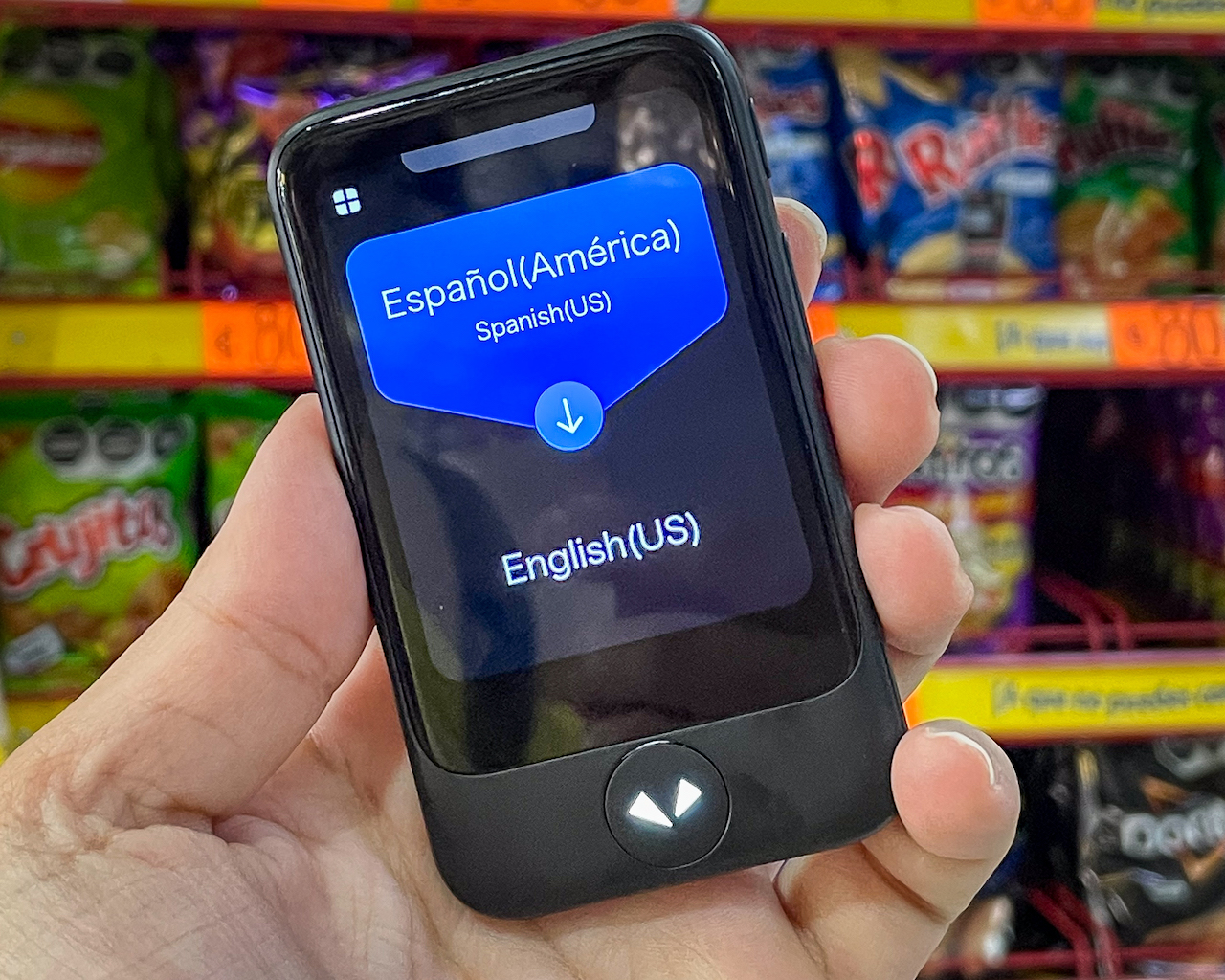
Time Kettle
The Timekettle is amazing if you’re going for a longer term trip and want to make friends. Each person gets an earbud and through the app the conversation is translated in real time. It’s super nifty and also a great Korean language learning tool. You can buy your Timekettle device here.
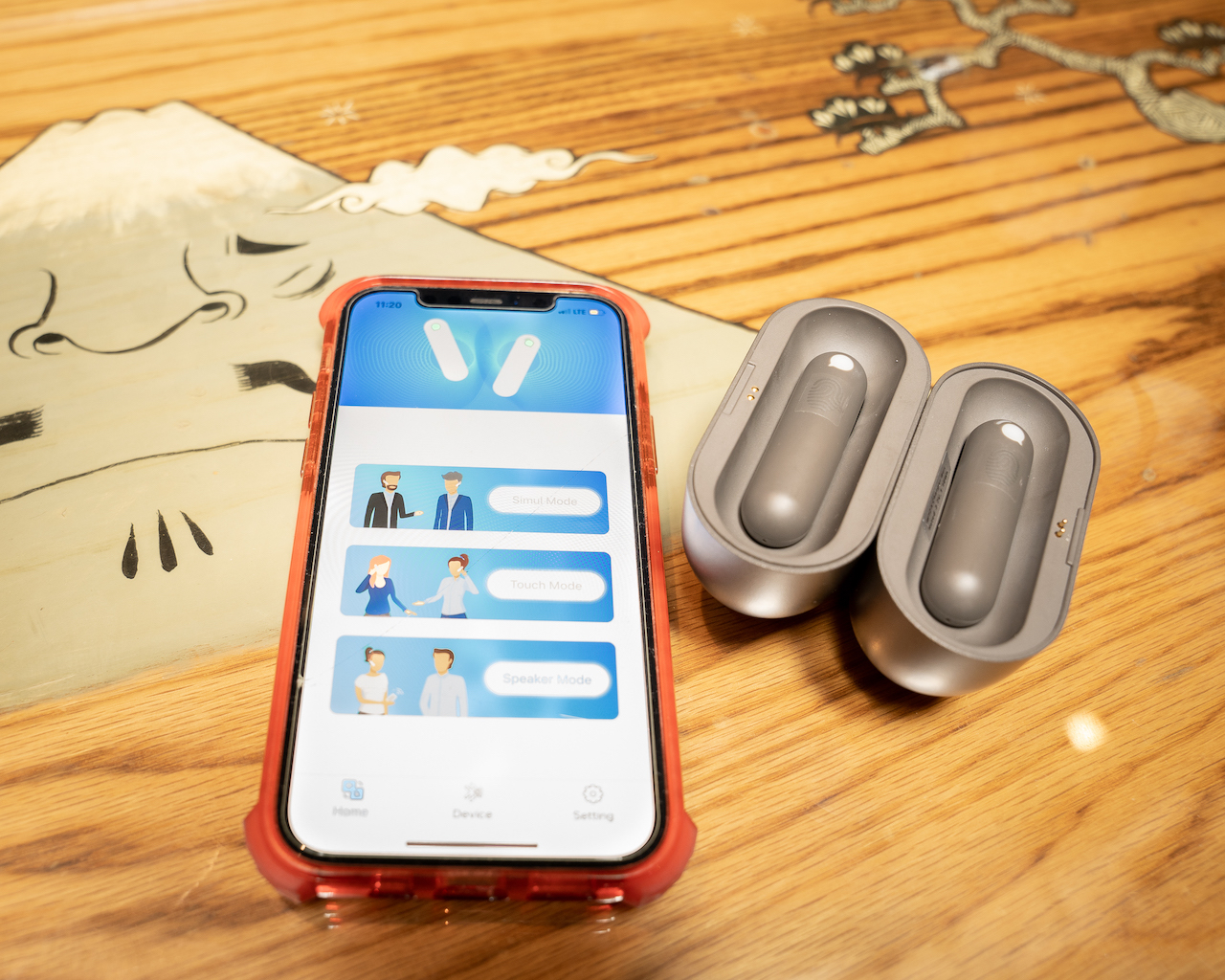
Helpful Korean Travel Phrases
- 안녕하세요 (ahn-nyung-ha-se-yo) — Hello
- 제 이름은 _____ (jeh ee-reum-un _____) — My name is _____
- 진짜요? (jin-jja-yo?) — Really?
- 재미있어요 (jeh-mi-eess-uh-yo) — It’s fun
- 화이팅! or 파이팅! (hwa-ee-ting! or pa-ee-ting!) — Fighting!
- 안녕히 계세요 (ahn-nyung-hee geh-seh-yo) Goodbye (you’re leaving)
- 안녕히 가세요 (ahn-nyung-hee gah-seh-yo) — Goodbye (you’re staying)
- 감사합니다 (gam-sa-ham-ni-da) — Thank you
- 잠시만요 (jam-shi-mahn-yo ; “wait a moment”) — Excuse me
- 죄송합니다 (jweh-sung-hap-nee-da) / 미안합니다 (mi-ahn-hap-nee-da) — I’m sorry
- 괜찮아요 (gwaen-chanh-ah-yo) — It’s okay
- 화장실이 어디예요? (hwa-jang-shil-ee uh-di-eh-yo?) — Where is the bathroom?
- 여기요 (yuh-gi-yo) — Over here
- 주세요 (ju-seh-yo) — Please give
- 메뉴 주세요 (meh-nyu ju-seh-yo) — Menu, please
- 얼마에요? (uhl-mah-eh-yo?) — How much is it?
- 한국말 잘 못해요 (hahn-guhk-mal jal moht-heh-yo) — I don’t speak Korean well
- 영어 할 수 있어요? (yung-uh hal su-eet-suh-yo?) — Do you speak English?
- 천천히 말씀해 주세요 (chun-chun-hee mal-sseum-heh ju-seh-yo) — Please speak slowly
- 맥주 한 잔 주세요 (make-ju han-jan ju-seh-yo)—One beer please

World Nomads Travel Insurance
Sadly, COVID-19 is here to stay and now a daily part of life. I recommend booking World Nomads Travel Insurance . With the World Nomads Travel Insurance, you can expect:
- Trip Cancelation – This benefit helps you recover non-refundable, pre-paid trip costs when you have to cancel your trip for a covered reason, including for an unexpected sickness that keeps you from traveling.
- Emergency Medical – The only thing worse than catching COVID-19 is getting infected away from home. If you get sick with COVID-19 or another illness, you can get diagnostic tests to confirm your case and other emergency medical benefits.
- Medical Evacuation – If you’re in an inadequate medical facility, our plans have benefits that can arrange a transfer to a hospital capable of treating your medical needs.
- Trip Interuption – During your travels, you might have to return home early. With trip interruption, you could get reimbursed for a one-way, economy-class ticket home and any pre-paid, unused portions of your trip if you need to change your plans for a covered reason.
- Trip Delay – Even when there isn’t a pandemic, traveling can have its bumps and hiccups. If your travels are delayed at least six hours by a covered event, you can be covered.
South Korea Currency
South Korea uses Korean Won as their currency. The exchange rate goes as follows: 1,000KRW is equal to about 0.75USD. It’s a great time to visit Seoul since the US Dollar is so strong.
How to exchange your money into Korean Won?
Two of the best ways to exchange money would be a bank in a bigger city where they carry South Korean won. Do not exchange your money at Incheon Airport because you won’t get a good rate. The best currency exchanges in Seoul are located in Itaewon and Myeongdong.
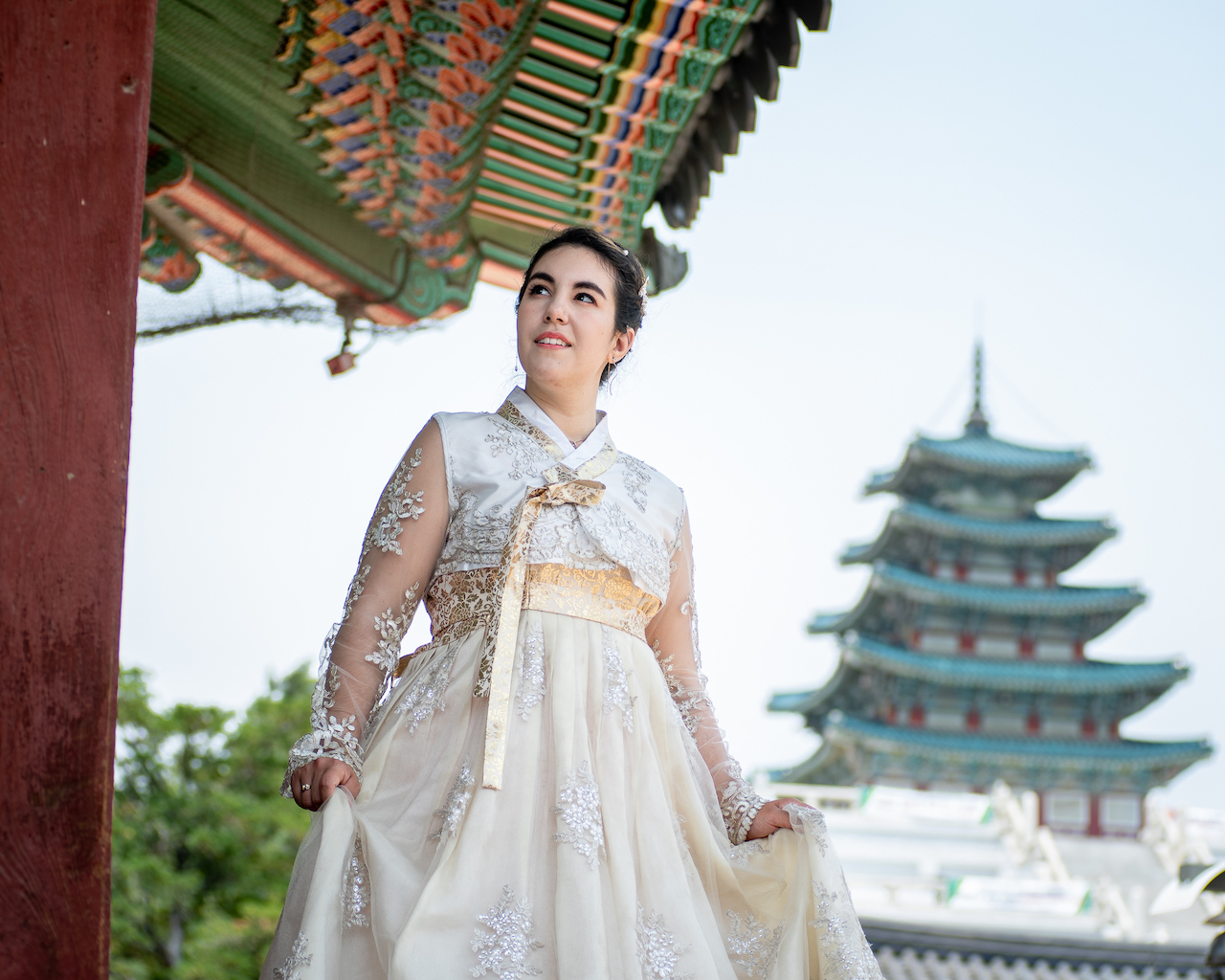
Arriving in South Korea
You’ll arrive at Incheon International Airport. It is located in Incheon (as the name suggests) but it is very easy to get to central Seoul from the airport.
If you didn’t book the Discover Seoul Pass , then you should get a T-money or Cashbee card at the convenience store. Or you can book a digital T-money card online here so you don’t have to deal with it when you arrive. These are basically reloadable public transport cards. They cost 5,000 won and you can reload the card at any train station kiosk or at the convenience store.
How To Get From Incheon Airport to Seoul
Getting to seoul by train.
If you take the train, there are two ways to get to Seoul. One is by the all-stop train (which takes forever) and the Express Train. You can check the airport train schedule here.
- Express Train – The Express Train travels non-stop from Incheon Airport Terminal 1 Station and Terminal 2 Station to Seoul Station. To take this train, passengers must purchase an Express Train Pass (or have the Discover Seoul Pass ). A discount is available to passengers who present flight tickets from Jeju Air, Korean Air, Asiana Airlines, or T’way Air. Cost: 9,500 won adults | Runs: every 43 minutes
- All-Stop Train – The all-stop train makes stops at all subway stations from Incheon Airport Terminal 1 and Terminal 2 Stations to Seoul Station. Six of the subway stations allow transfers to other metropolitan area subway lines. To take this train, passengers must use a transportation card. International visitors may also use the foreigner-exclusive prepaid transportation card MPASS. Cost: 4,150 won | Runs: every 59 minutes
Getting To Seoul By Airport Bus
Airport buses run from Incheon International Airport to many areas of Seoul. Tickets can be purchased at ticket booths just outside the 1F Arrivals Hall of each terminal. Detailed inquiries on bus routes and bus stops can be made here.
- Check bus routes and purchase tickets at the ticket booths located at the Arrivals Hall (1F) of Terminal 1 near Gates 4 & 9 or outside by Gates 4, 6, 7, 8, 11 or 13.
- Tickets at Terminal 2 can be purchased from the bus terminal at the Transportation Center (B1F)
- Check the bus boarding number indicated on the ticket.
- Go to the bus boarding location and double check the bus route and departure time.
- Once aboard the bus, listen carefully to the English announcement for your stop.
There’s help kiosks located all around the airport if you get lost or have a question. You can also check the Incheon Int’l Airport Bus Guide (Korean, English, Japanese, Chinese).
Getting To Seoul By Private Transfers
There are different kinds of taxis that can take you into Seoul.
- Regular Taxi – Base fare begins at 3,800 won (Seoul standard) with a 20% increased charge from the base fare at nighttime (24:00-04:00).
- Deluxe & Jumbo Taxi – Base fare for deluxe and jumbo taxis begins at 6,500 won. There is no additional nighttime charge.
- International Taxis – International taxi fares are fixed according to region with regular taxi fares ranging 65,000 – 90,000 won, and deluxe and jumbo taxis run from 95,000 – 130,000 won.
Pro Tip: If a taxi driver tries to take advantage by demanding an inflated fare, report the incident to Seoul Global Center (+82-2-2075-4180), which offers services in English, Japanese, Chinese, Russian, Vietnamese, Mongolian, Filipino, Uzbek, and Thai. You can also report your complaint to the Dasan Call Center (+82-2-120), which offers services in English, Japanese, Chinese, Vietnamese and Mongolian.
How To Get Around Seoul
- Subway : The subway is owned by the government so the fares for each line are standardized (unlike Japan). Fares start at 1,250 won and cost about 100won – 300won to transfer to another line. The trains run all day, but are closed from midnight to 5:30am.
- Bus – If you’re a first time tourist to Seoul, I would avoid taking the bus; however, if you’re up for the challenge, use Naver Maps. It will tell you where the bus stop is and the bus stops also have information about when the next bus will come. It also costs 1,250 won to get on the bus and 100won – 300won for transfers. If you find yourself stranded without a subway, then you can ride the M Buses at night.
- Taxi – The base fare starts at 3,000 won and goes up from there. They’re a little more expensive to ride at night, but they are available 24/7.
- Seoul Bike – These are public bicycles that can be found all over Seoul. It costs 5,000 won to rent for the day. For more information and a comprehensive guide on how to rent, click here .
- Electric Scooters – There’s a lot of walking in Seoul, but luckily there are a lot of bike paths as well. There are three companies you can rent an electric scooter from in Seoul— Lime , Beam , and Kickgoing (Korean only). Korean law requires you to scan your driver’s license before renting.
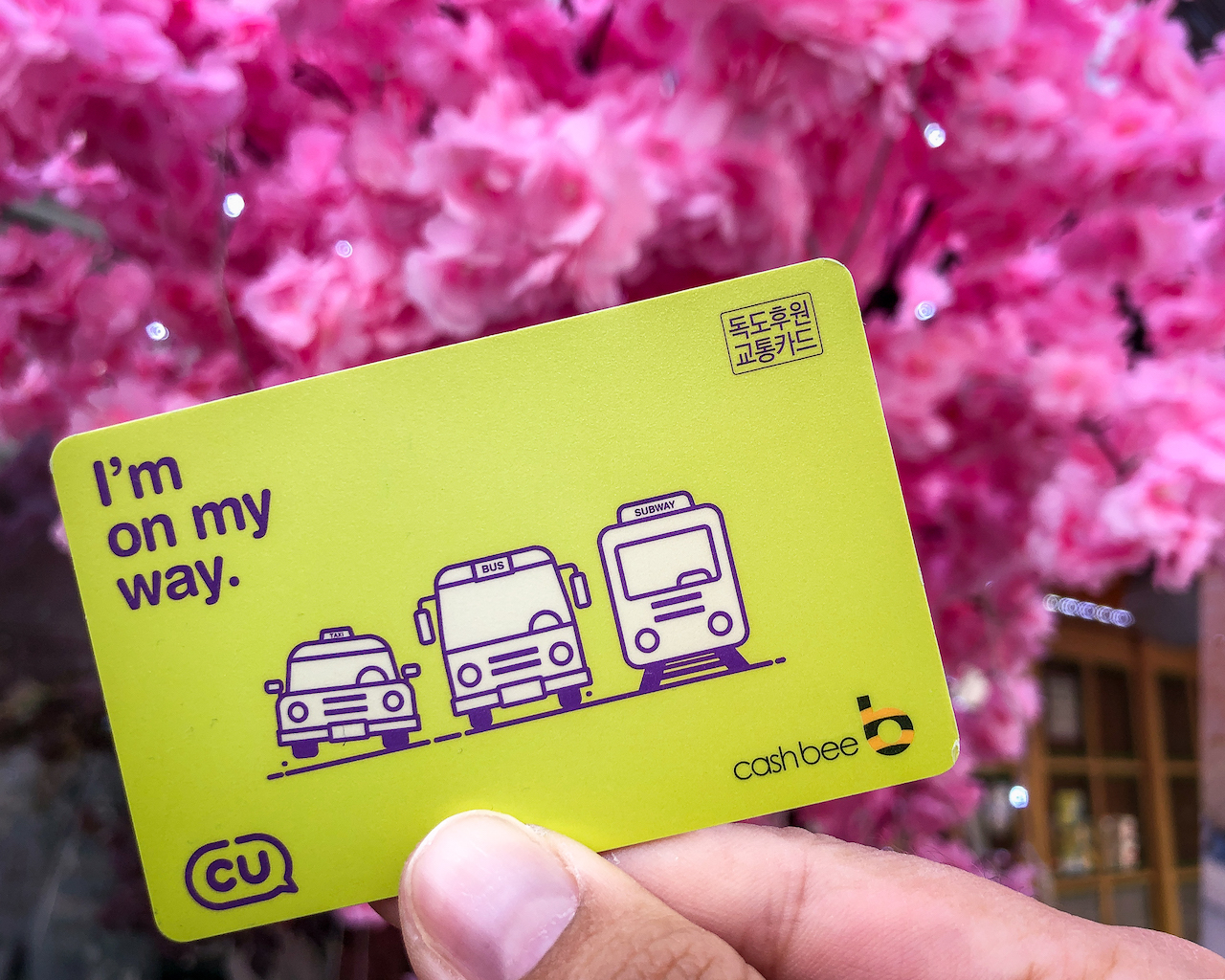
Safety in South Korea (5 Days Itinerary Seoul)
South Korea is a very safe country for solo female travelers. Just be aware crime still happens despite the safety ratings. According to Global Finance, Korea has a safety index score of 8.93. This means you will find CCTV everywhere and Koreans in keeps themselves in check. One of the things I enjoy most is being able to leave my valuables on a table and no one will try and steal it.
5 Day Itinerary Seoul Budget
Traveling in South Korea is cheaper than Japan. I wrote a comprehensive post on How to Budget Travel in Seoul to give you money saving tips and ideas on how to lower the costs of traveling there. You should expect to spend at least $50 a day. Again, if you use the Discover Seoul Pass , this will also help lower the costs of your activity and popular places to go. I also recommend checking out the book How To Travel the World on $50 a Day for more money saving tips and hacks. Below you’ll find a breakdown of what some of your bulkier costs will be.
- Hotels : $20 – $100 a day
- Food: $10 – $50 a day
- Fun: $20 – $50 a day
- Transport: $5 – $10 a day
Where To Stay in Seoul 5 Day Itinerary
Check out my post on Where To Stay in Seoul for a detailed guide on booking accommodation in South Korea. You’ll get recommendations for every budget and what each area offers. However, if you’re in a hurry, here’s a mini Seoul city guide.
- Gangnam – Best area to stay in Seoul for luxury travelers.
- Hongdae – For budget travelers, night life lovers, and foodies.
- Insadong – Traveler who love culture and unique Korean experiences will thrive here.
- Itaewon – For those who don’t want to stray far from home comforts.
- Jamsil – Perfect for families and low key travelers.
- Myeongdong – This is the best neighborhood for Korean food, skincare, and clothes.
Luxury Accommodation in Seoul
- Banyan Tree Seoul (Itaewon)– Banyan Tree Seoul is my favorite luxury hotel in Seoul. The hotel is situated on the Namsan Mountain and their rooms offer incredible views of Namsan Tower and Seoul. You can read my review about Banyan Tree Seoul here.
- Signiel Seoul (Jamsil)– Located between floors 76 and 101 of Lotte World Tower, Signiel Seoul features panoramic views of Seoul in all 235 rooms. This five-star hotel features a champagne bar, Michelin-starred restaurant, indoor swimming pool, fitness center and banquet facilities.
- JW Marriott Seoul Dongdaemun Gate (Myeongdong) – Located in the center of Dongdaemun, Seoul’s renowned retail district, JW Marriott Dongdaemun Square Seoul Hotel is just steps from Exit 8 and 9 of Dongdaemun Subway Station (Line 1 and 4).
Mid-Range Accommodation in Seoul
- L7 Hongdae (Hongdae)– Located in Mapo-Gu district of Seoul, L7 Hongdae by Lotte features various facilities including a restaurant, a fitness center and a bar. They also have access to a rooftop pool at an additional cost.
- Mondrian Seoul Itaewon (Itaewon)– Mondrian Seoul Itaewon features air-conditioned accommodations and a bar. Offering a restaurant, the property also has a seasonal outdoor swimming pool, as well as an indoor pool and a fitness center.
Budget Accommodation in Seoul
- Cocoa Guesthouse Hongdae – Offering free WiFi access, Cocoa Guest house is located just a 10-minute walk from Hongik University Station. This area is known for its indie arts culture, shopping, dining, and entertainment.
- Hotel The Designers Hongdae – Just a 3-minute walk from Hapjeong Subway Station (Line 2), Hotel The Designers Hongdae offers stylish accommodations with free WiFi and an Italian restaurant. The air conditioned rooms feature modern designs, a flat-screen TV and a refrigerator. Each comes with an electric kettle and an private bathroom with a bathrobe, free toiletries and a hairdryer.
- Kimchee Seoul Guesthouse (Hongdae)– Kimchee Hongdae Guesthouse is in Seoul’s entertainment and arts district, a convenient 15-minute walk from Hongik Univ subway station. It provides a 24-hour common kitchen and free Wi-Fi throughout the entire hotel. Just an FYI, Kimchee Guesthouse is the cheapest of all these options and it has great reviews.
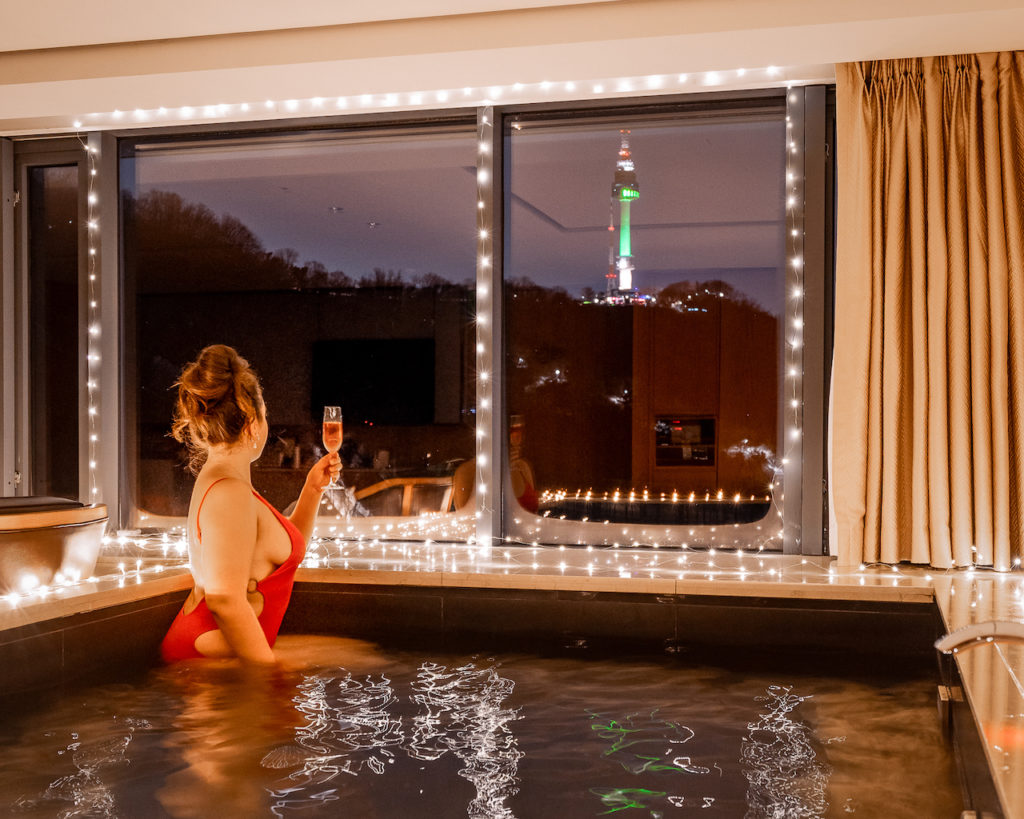
5 Days Seoul Itinerary Recommended Tour Companies
Language barriers and not knowing how to get to places in Korea can be frustrating. Sometimes the best option is a tour to have a done for you trip.
My favorite company is Trazy because they have really well put together itineraries for Korean Festivals . Every season in Korea brings something new and exciting. The tours are also constantly changing so there is a variety of choice.
I also recommend booking with Klook since they always stay up to date on the trends.
Five Days Itinerary Seoul Map
On the map below, you will get each day planned out wit route maps. This is a completely done for you 5 days in Seoul itinerary.
Day One in Seoul
For your first day, bring your best pair of sneakers because there’s a lot of walking for this 5 day Seoul itinerary. The pavement is often uneven your gym shoes will protect you from accidents. If you want cute photos just switch out your shoes.
Rent a Hanbok at Hanboknam
I recommend experiencing Korean culture. One of the best ways to do this is by renting hanbok. A hanbok is a traditional Korean dress. For everything you need to know about renting hanbok in Seoul click here . Did you know you can get free admission into all the royal palaces by wearing hanbok?
Hanboknam provides hanbok up to a US size 16. The larger sizes leave much to be desired in terms of how pretty they are. In addition, they do have shoes available to rent if you can fit. The largest they go up to is a US size 8. You can book your Hanboknam hanbok rental here.

Gyeongbokgung Palace
This is the most beautiful of the palaces and was the main palace during the Joseon Dynasty. A Seoul travel hack is to get the Discover Seoul Pass. If you’re one of those travelers that has to do everything, then I promise you’re going to get the most bang for your buck.
This pass includes a free hanbok rental at Hanboknam. You can also use it to enter Gyeongbokgung without having to wait in the long ticket lines. While at Gyeongbokgung, definitely check out the National Palace Museum of Korea to learn about Korean culture and rich history.
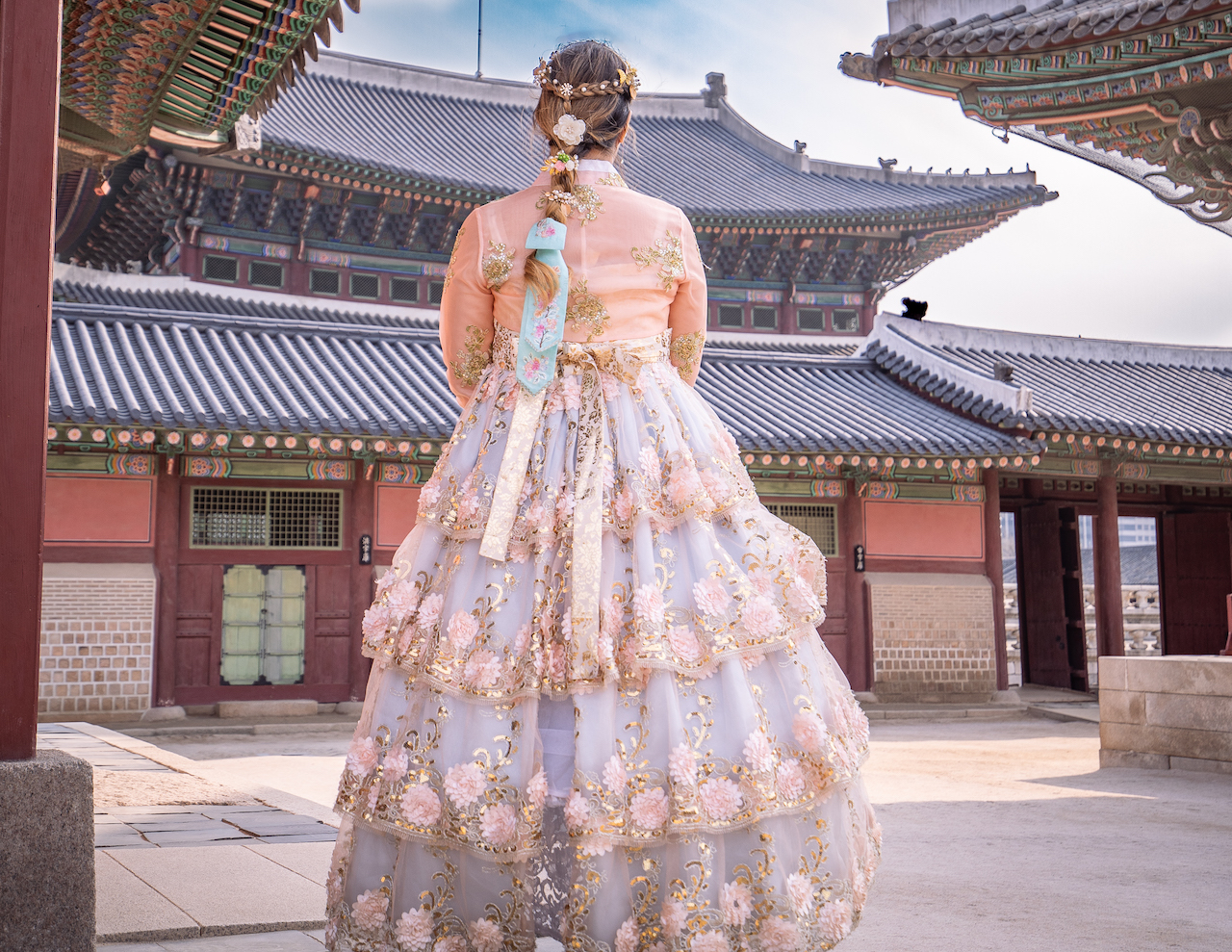
Insadong is best for buying souvenirs and local artwork. It’s the only street featuring exclusively Korean signs and no English. You’ll also find very tasty traditional Korean food for cheap. My favorite restaurant for tasty Korean food is called Insadong Geujip . During peak tourist season, you can also find a lot of Korean traditional acts performing on the street from sword fighting to dancing.
What To Do in Insadong?
- Color Pool Museum
- Make a Traditional Korean Name Stamp
- Korean Rice Wine (Makgeolli) Tasting Tour
- Insadong Half Day Food Walking Tour
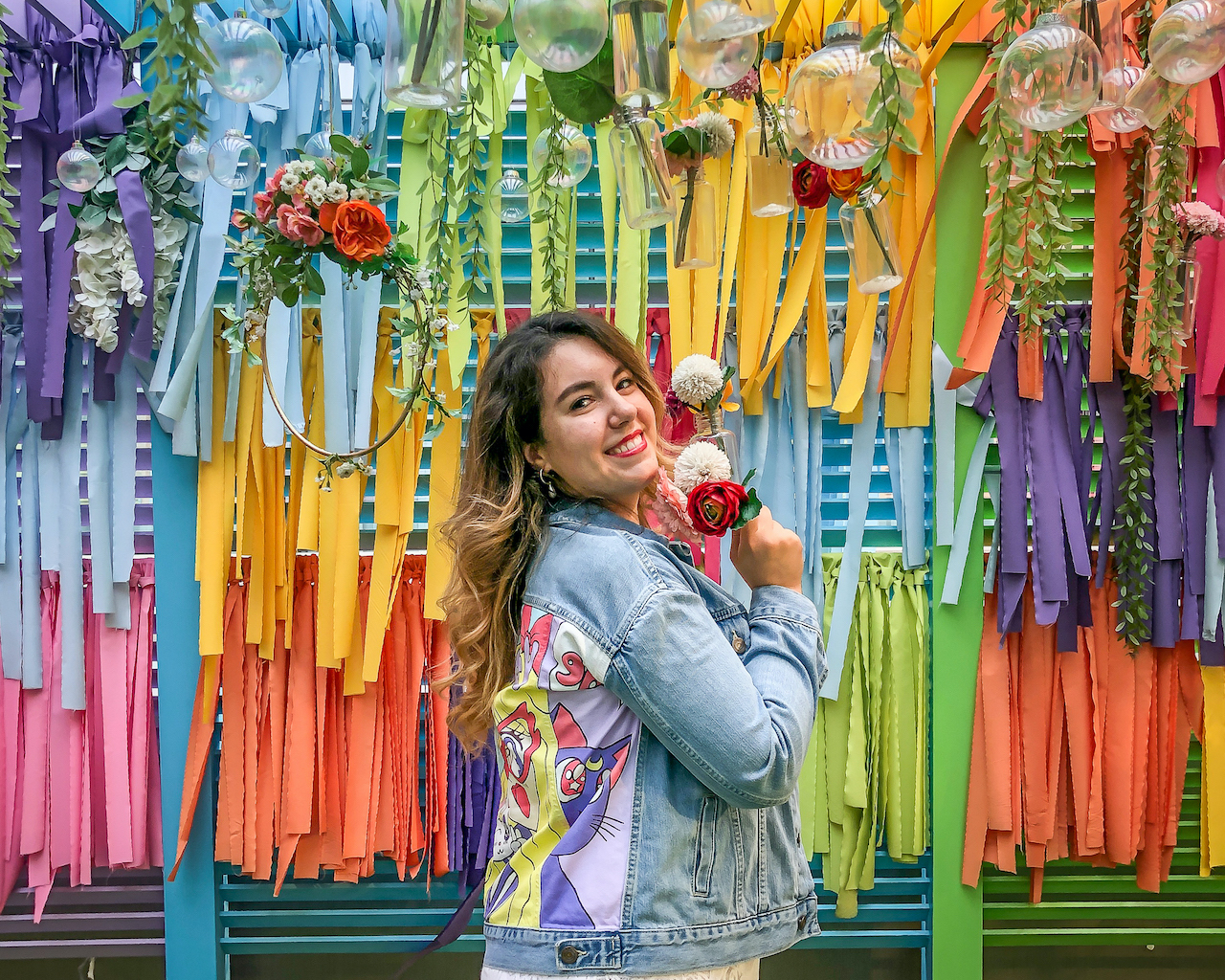
Ikseon-dong Hanok Village
Ikseon dong should be on your to-do list. This is a really trendy hanok village with amazing cafes, restaurants, boutiques and entertainment. It really gives you that old Seoul feel while walking around the narrow alleys. At night, it’s also a great place to go drinking and to eat Korean bbq at a local restaurant. For a full guide on everything you need to do in Ikseondong click here .
What to do in Ikseondong?
It’s really easy to spend a good chunk of your afternoon walking around the Ikseondong Hanok Village. Take your time to explore all the great cafes and views the area offers.
- Insadong & Ikseondong Makgeolli Tasting Tour
- Ikseondong Walking Food Tour

Have A Drink At Moxy Hotel’s Rooftop Bar
Your Seoul itinerary should include at least one rooftop. I went here for my birthday and you get the most amazing view of the Ikseondong Hanok Village. It’s also amazing to have a drink on their rooftop. This is also a really fun place to stay with all of its fun and modern decorations. Book your stay at the Moxy Ikesondong here.
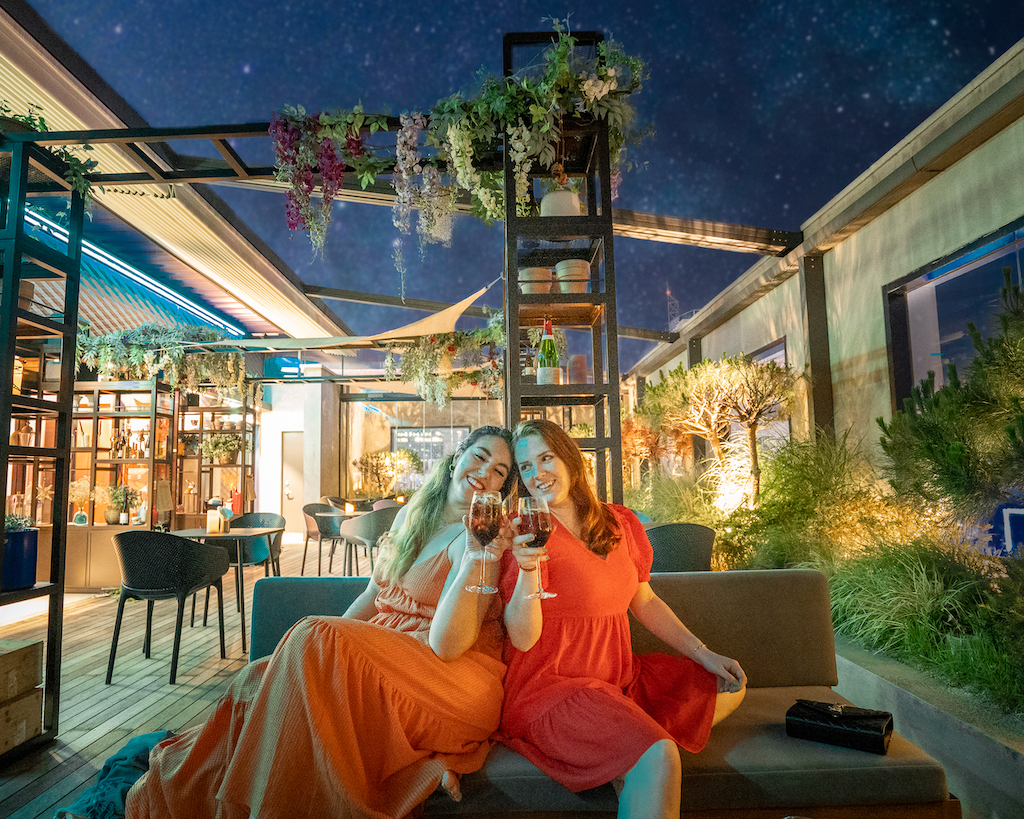
Day Two in Seoul
Next on our itinerary in Seoul, Today is a day where you’re going to do more traditional things. Even though a lot of the traditional Korean places are located in one area, it’s still a lot of walking. Also, you’re going to want to take your time and learn about Korea’s history, culture, and take amazing photos.
Changdeokgung Palace
This is one of the largest palaces in Seoul not because of the buildings, but because of the gorgeous Secret Garden. It’s also a UNESCO World Heritage Site. It costs 3,00 won to enter the palace. Or if you’d like to delve deep into the history and culture of Changdeokgung and the surrounding Bukchon Hanok village, you can do a guided tour .
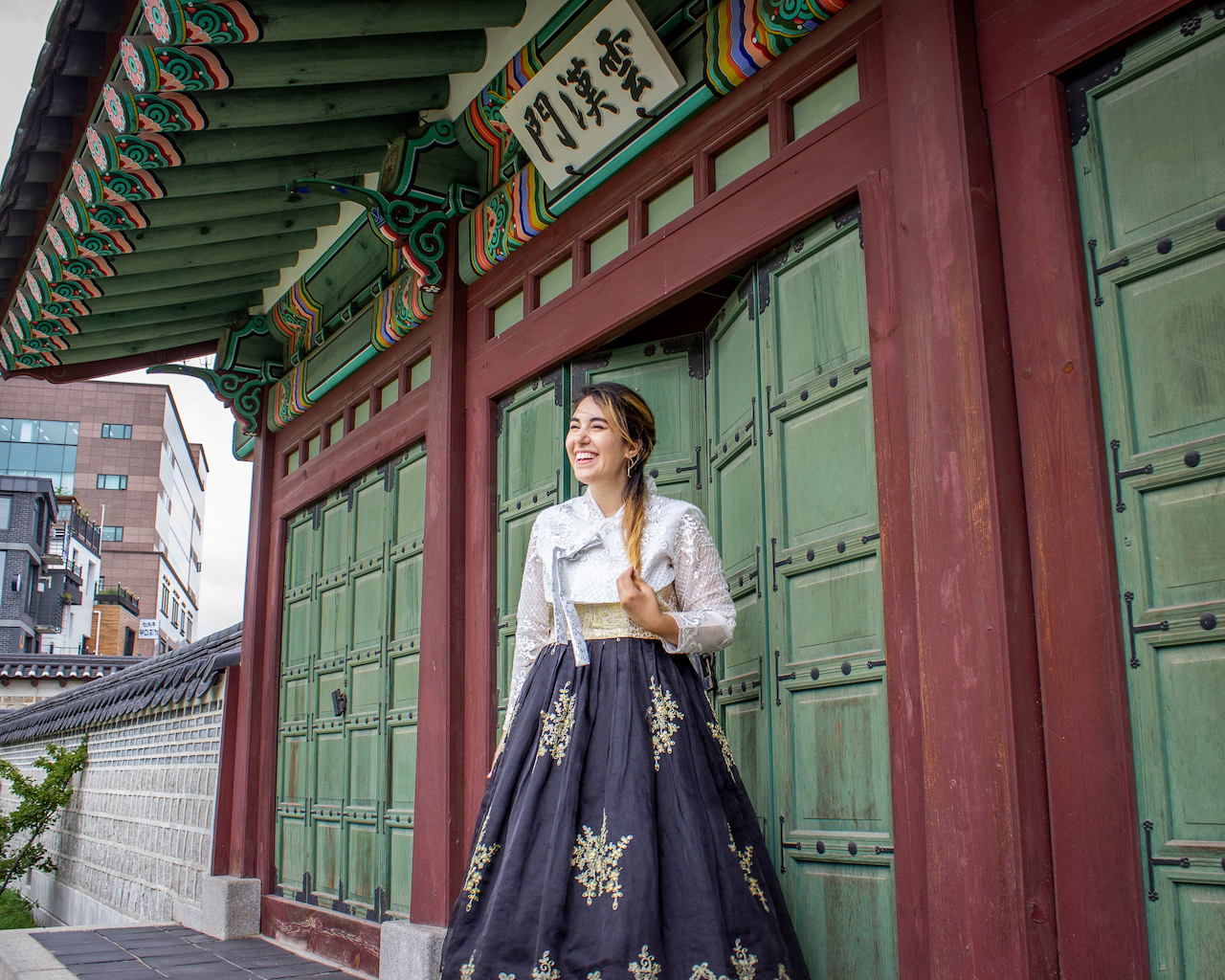
Secret Garden Tour
This is the highlight of visiting Changdeokgung. The royal family used the garden as a place of rest since the reign of King Taejong (1400 to 1418). They would come here to contemplate life, write poems, and hold banquets.
Pro Tip: Two of the most popular times during the year to visit Changdeokgung are during cherry blossom season and autumn when the foliage makes the garden come alive with gorgeous colors. Book tickets to the garden in advance or during the week at 9am.
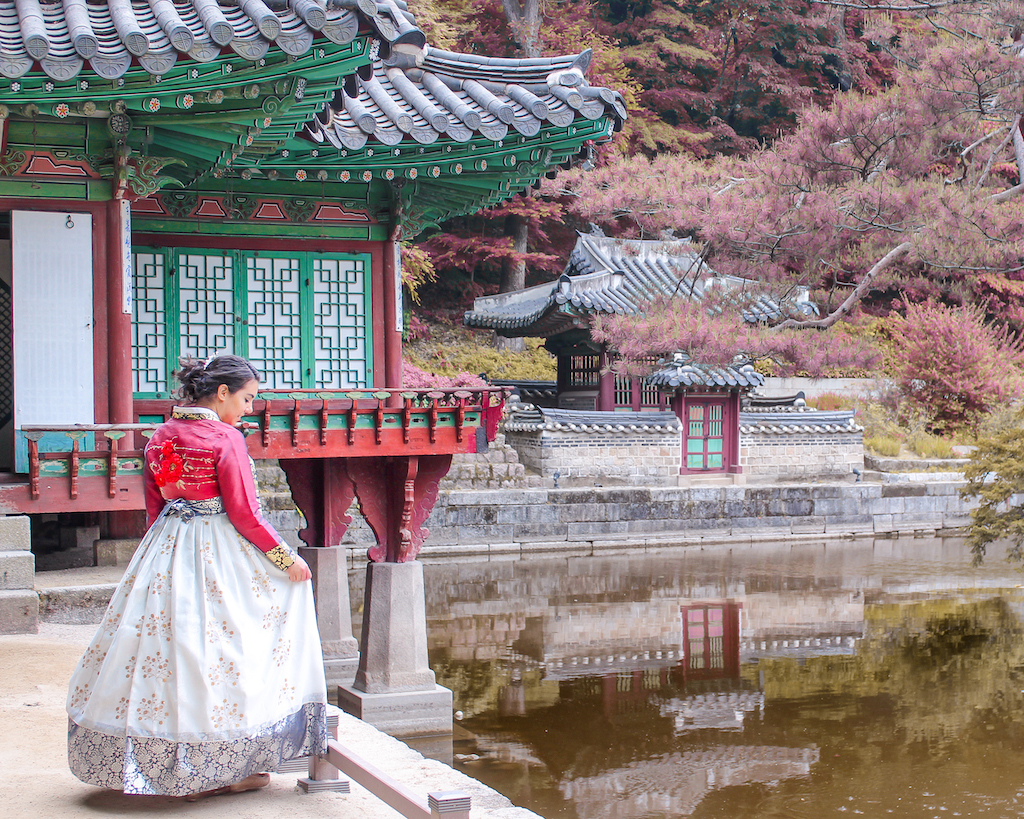
Jogyesa Temple
Jogyesa Temple is one of the oldest Buddhist Temples in Korea and a symbol for Buddhism in Korea. It’s located in the heart of the city and is still an active temple today. While you stroll the grounds, you’ll most definitely catch Buddhist services. Just a note, the temple becomes decorated with beautiful and brightly colored lanterns around Buddha’s Birthday.
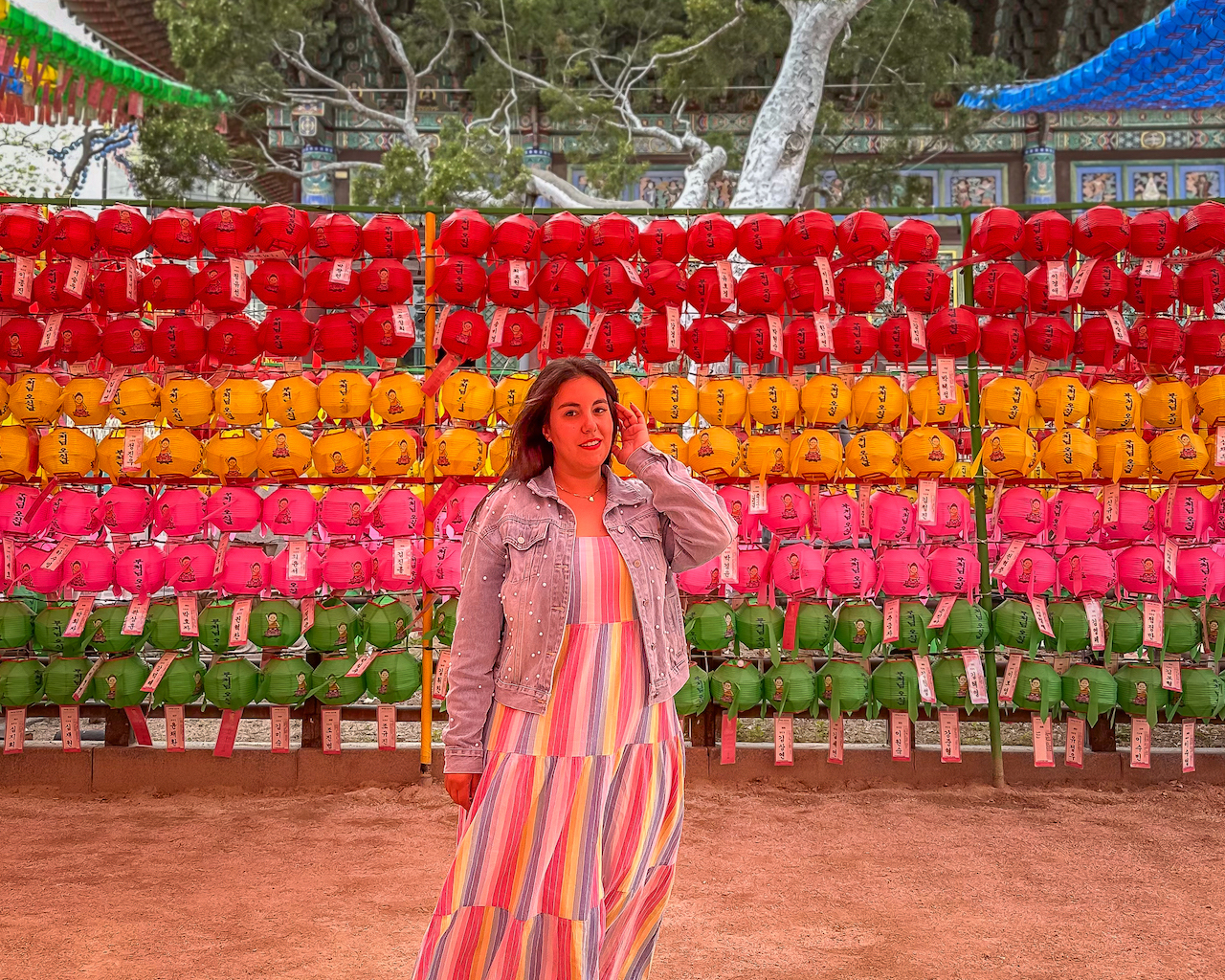
Bukchon Hanok Village
Bukchon is full of beautiful traditional hanok homes. A hanok is a traditional Korean house. People actually live there, so please be respectful of your surroundings. This is a residential area and people do live here so please be quiet and do not disturb others.
If you want to get a shot like mine with no people, go super early in the morning because it gets crowded fast. One Day Hanbok is also located at the heart of this district so it’s easy to rent a hanbok from them and then take photos here.
- Bukchon Hanok Village Walking Tour
- Kimchi Making Class in Bukchon Hanok Village
- Mother of Pearl DIY Class in Bukchon Hanok Village
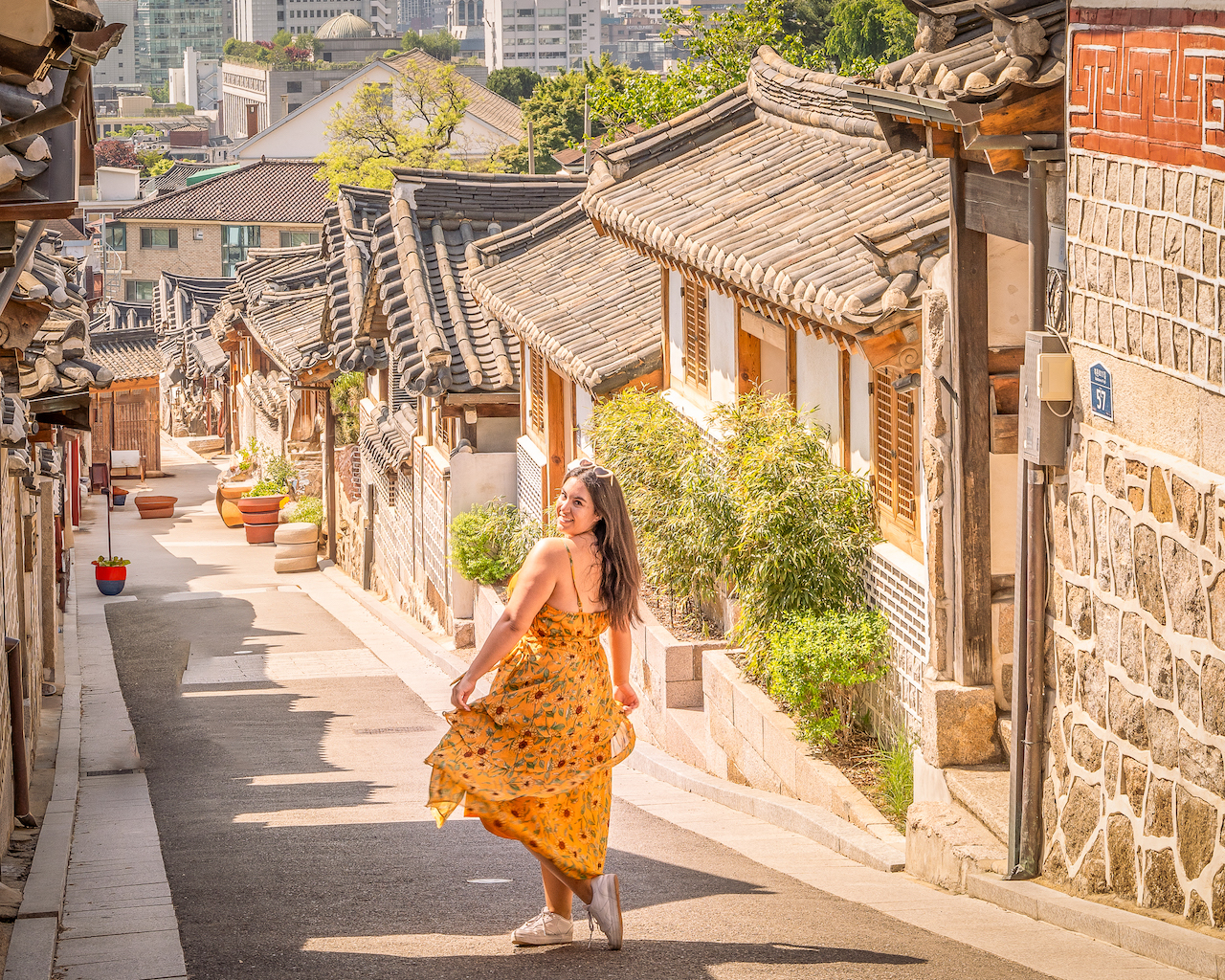
Green Mile Coffee
This is by far one of my favorite coffee shops in the Bukchon area. Their speciality lies in coffee and green tea creations… Which sounds like it wouldn’t go together, but it totally does! It’s a great pick me up and I recommend going around sunset. You can also see the National Folk Museum of Korea from the rooftop.
Optional: Gwangjang Market
This is the largest traditional market in Seoul. It’s the perfect place to try traditional Korean food. It’s a popular spot for an authentic street food experience in Seoul.
Day Three in Seoul
Optional: ihwa mural village & naksan park.
This is the most popular mural village in Seoul and a great cultural experience. The Seoul government brought in about 70 local artists to make this a beautiful neighborhood. You can also rent an old time Korean school uniform to take pictures. Just make sure you’re quiet and respectful as this is a residential area. You can walk along the Seoul City Wall into Naksan Park here which offers great views of the city.
Optional: Dongdaemun Design Plaza
The DDP is a major urban development landmark in Seoul, South Korea, designed by Zaha Hadid and Samoo, with a distinctively futuristic look. Seoul Fashion week is held here. Various traveling art exhibits are also put on display at the DDP.
Namsan Tower
If you’ve ever watched a romantic Korean drama, then you’ll have seen a scene filmed here. It’s the ultimate couples destination in Seoul. The N Seoul Tower is also known as a complex culture space where the clouds meet Namsan Mountain.
What to do at Namsan Tower?
A few things I recommend are definitely going up the cable car and Namsan Park. You can take a leisurely walk along the city wall from the park and it is amazing for photos. It’s great in all seasons but especially in spring and autumn. There are also two restaurants in the observatory to choose from which makes the experience even cooler.
- Namsan Tower Round Trip Cable Car Ticket
- Namsan Tower Observatory Ticket
- The Place Restaurat at Namsan Tower
- HanCOOK Restaurant at Namsan Tower
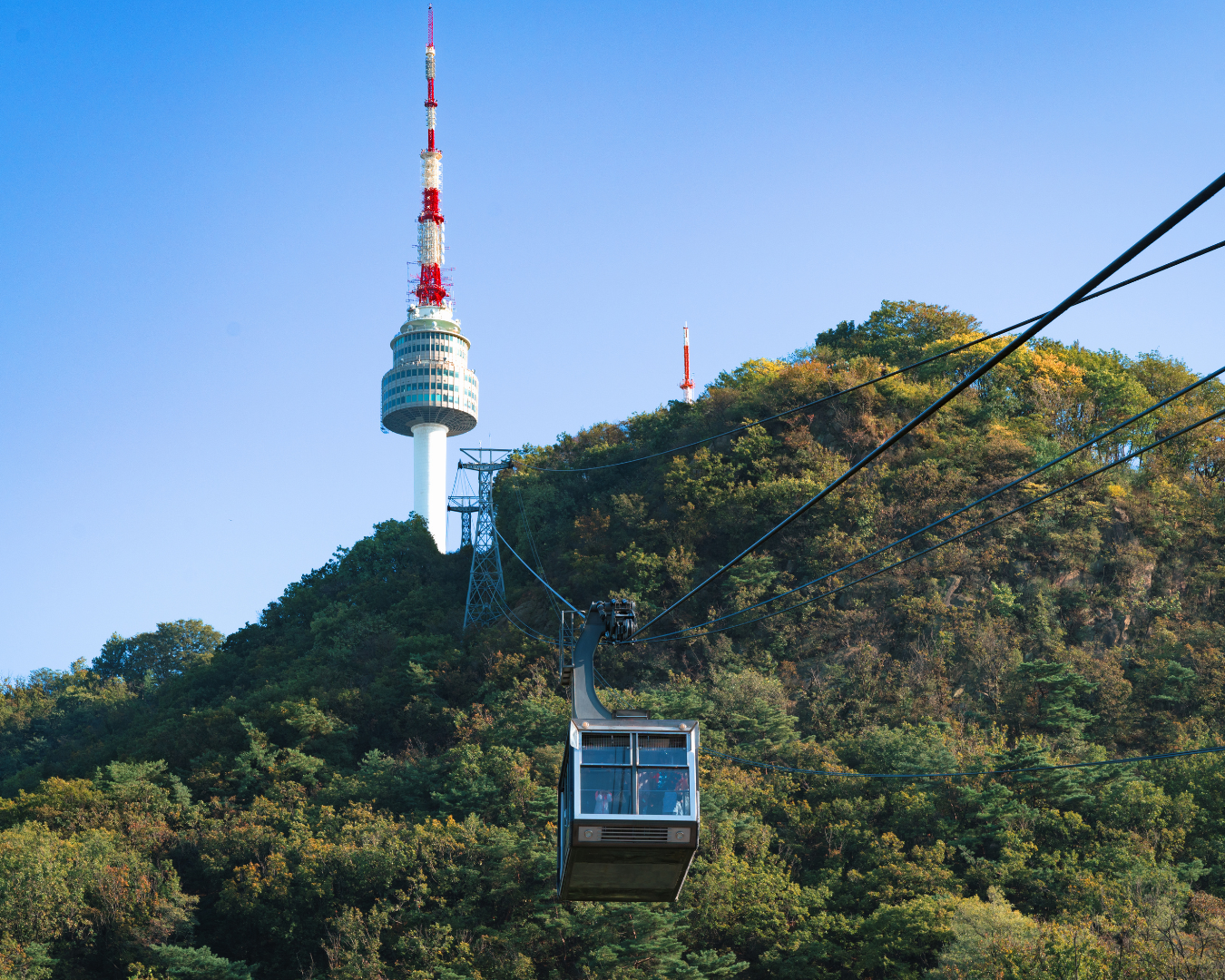
The Myeongdong shopping district is a tourist favorite for the shopping, street food, cute cafes, and Kpop inspired merchandise. You’ll find lots of unofficial Kpop souvenirs in Myeongdong Station. A popular activity is to eat street food. Make sure you try tteokbokki which are spicy rice cakes. Bring cash because the street food vendors don’t do credit or debit cards.
What to do in Myeongdong?
The Myeongdong area is mostly famous for its shopping district but there are so many other cook things to do in Seoul. You can really get a feel for Seoul’s most expensive district by going around to eat street food and taking part in cultural activities.
- Watch a Nanta Cooking Show
- Get Pampered At the Whoo Spa

Cheonggyecheon Stream
The Cheonggyecheon Stream is super popular during Christmas in Korea for the Seoul Lantern Festival and the beautiful Christmas decorations. It’s a nice place for a leisurely stroll through Seoul.
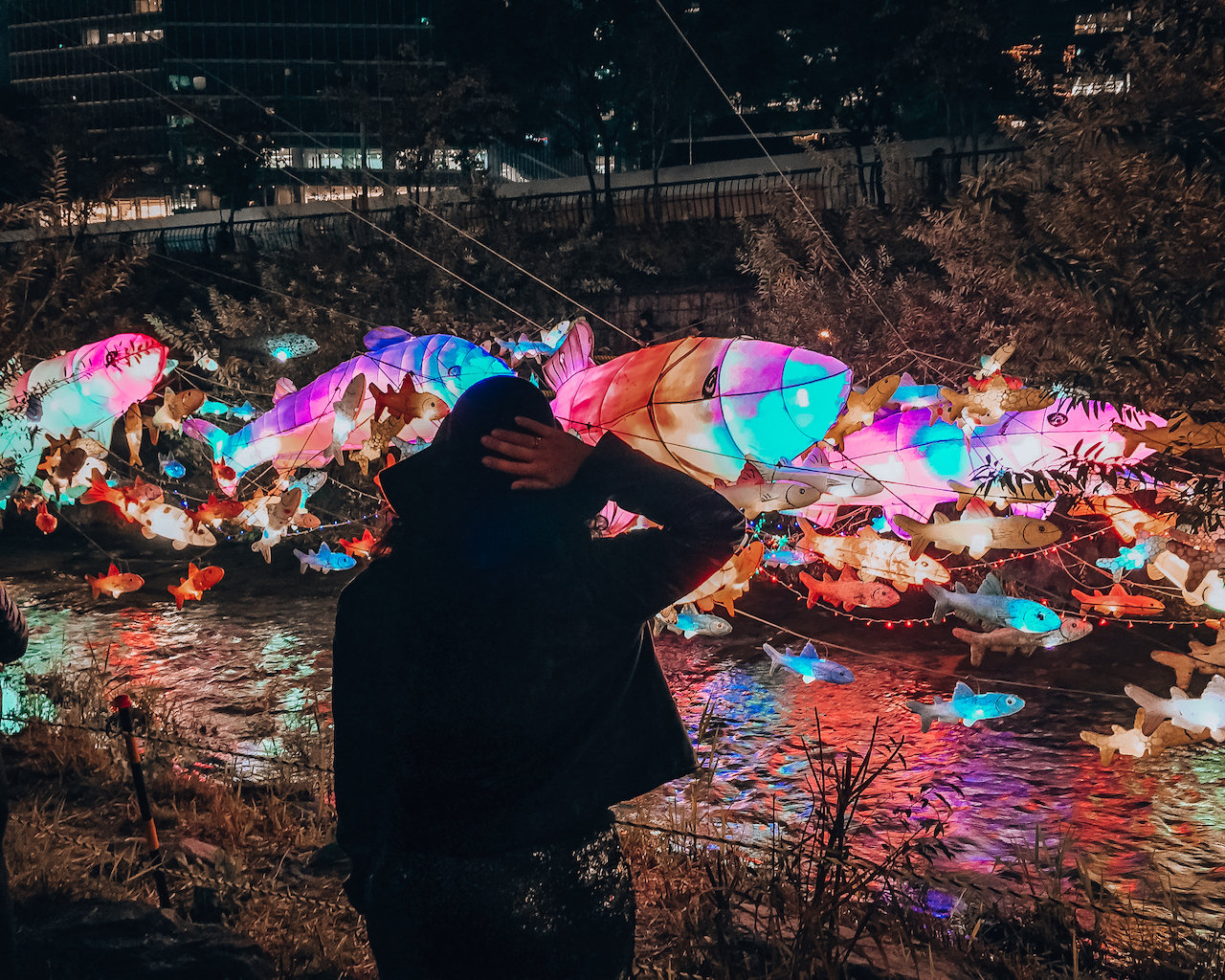
Han River Picnic
Were you even in Seoul if you didn’t picnic or visit the Han River? One of the top things to do in Seoul is to order delivery to Yeouido Park. The top two contenders are pizza and fried chicken. There are tons of convenience stores around where you can just get a lunchbox and beer and eat anywhere you want. Also, it’s really popular to ride a bike and have a picnic at the Han River .
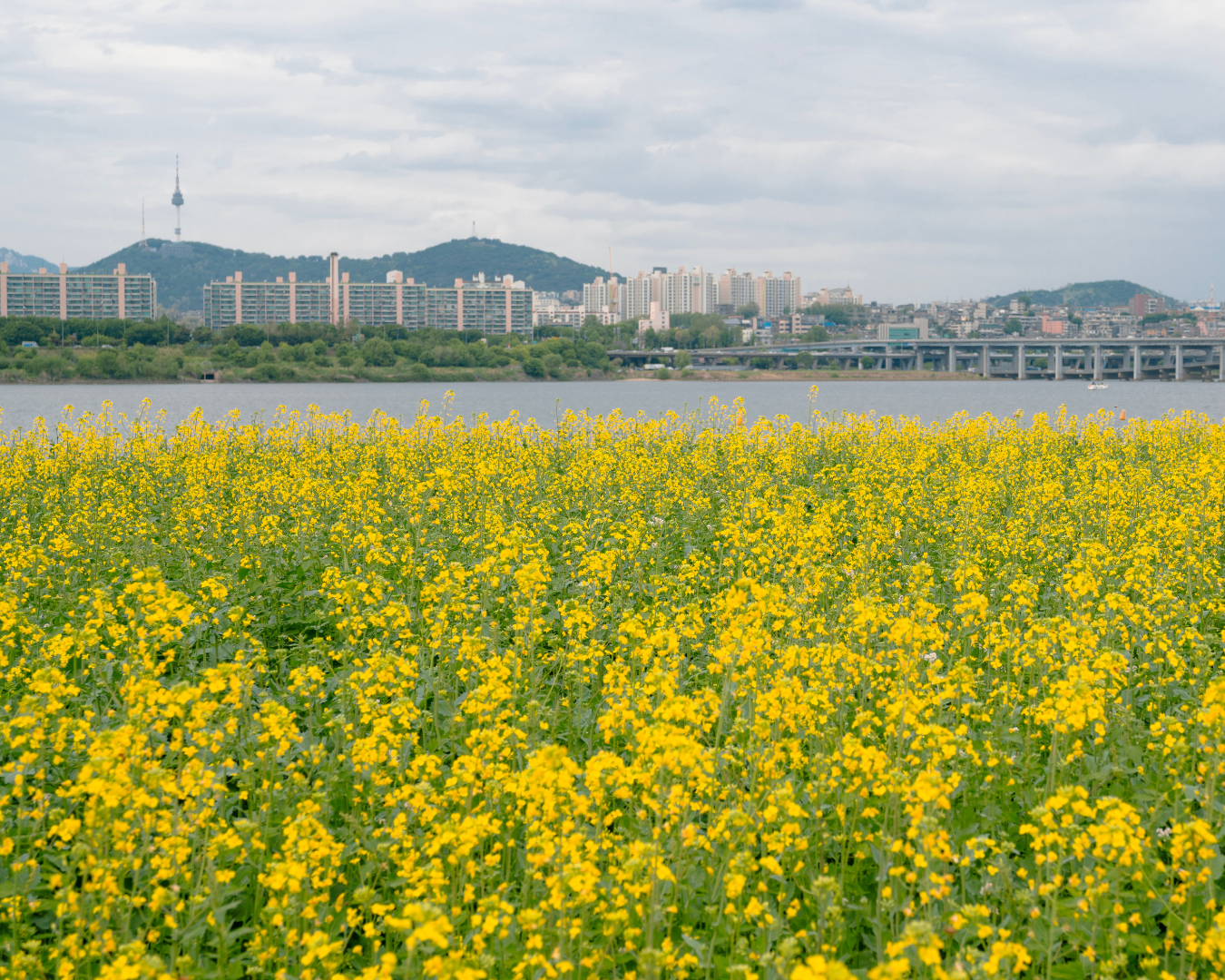
Han River Cruise
Another popular attraction for tourists in Seoul, the Han River Cruise is one of my favorite things to do. If you go on the sunset tour, you can get a drink. You can also watch the city light up. This is a really amazing activity for friends, lovers, or families. You can book your Han River Cruise for a discount here.

Day Four in Seoul
Visit the DMZ (Demilitarized Zone) and JSA (Joint Security Area). Whether you’re into history or not, this has definitely been one of the coolest experiences I’ve ever done. You’ll get a chance to tour part of the tunnels the North Korean government made to try and infiltrate Seoul.
The best part is the JSA. This is where President Moon Jae-In and Dictator Kim Jong Eun met for a peace talk. Depending on the day and how high tensions are the JSA may be closed. These cool blue houses are also where you can stand in North Korea during the DMZ Tour. You can book your DMZ and JSA tour here.
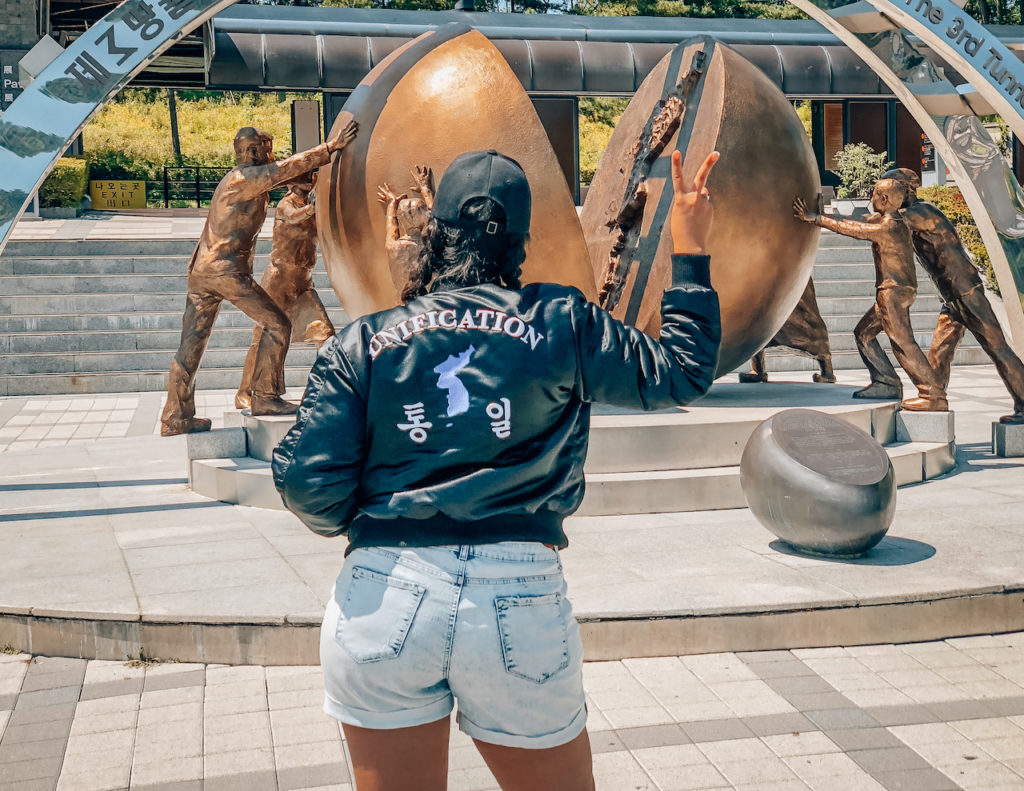
Go On A Seoul Night Tour
Since the DMZ and JSA Tour doesn’t take all day, you will definitely have room to do another exciting activity. These are some night tours I recommend going on if you want to know about more history, and the food and culture scene.
- Haunted Dark Side of Seoul Ghost Tour
- Seoul Night Life Tour | Seoul Pub Crawl
- Seoul Night Market Food Tour
- Seoul Euljiro Night Food Tour
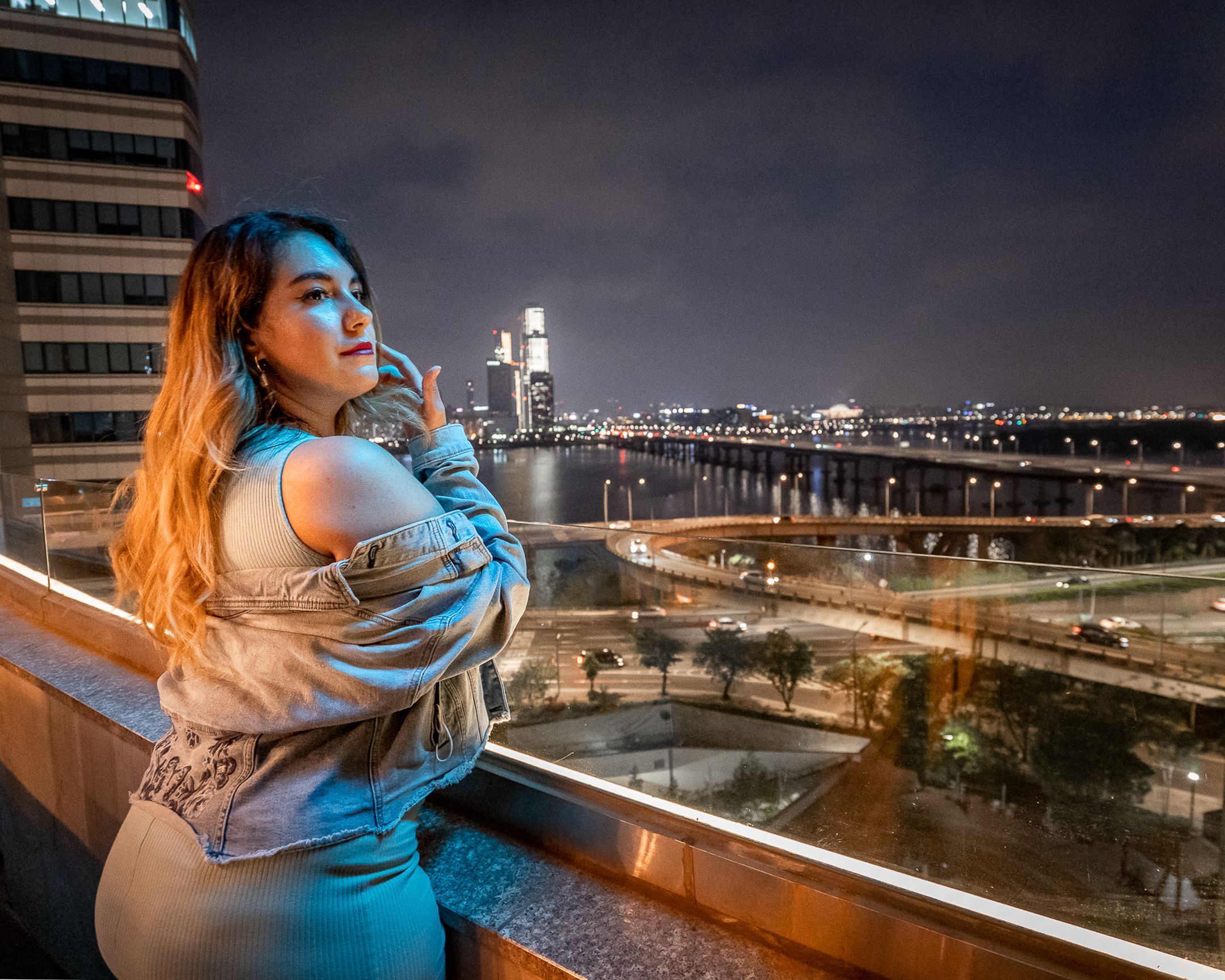
Take a Traditional Korean Class
One of the best ways to get into your Korea trip is by taking a traditional Korean class. You can learn so much about the culture by participating in everything that makes it so beautiful. It’s one of the best things to do in Korea if you want to make lasting memories and have great souvenirs.
- Traditional Korean Dessert Making Class
- Traditional Korean Folk Painting Class
- Traditional Hanji Paper Making Class
- Traditional Korean Pottery Class
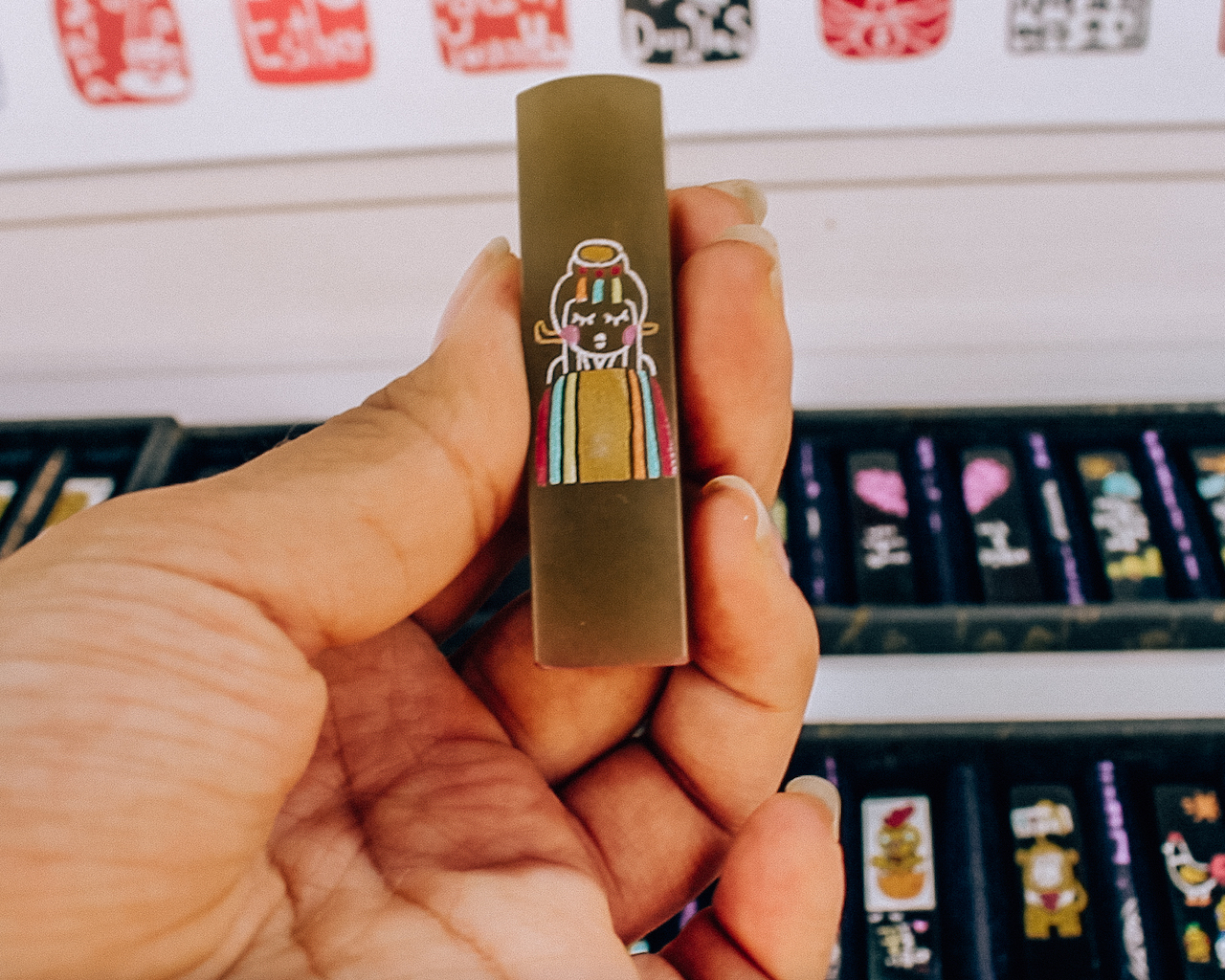
Have a Korean Beauty Experience
Korean beauty is the best in the world. I no longer use western products because of how gentle, efficient, and effective a lot of Kbeauty products and treatments are. Koreans have the science of skincare down to the letter and I can confidently recommend all of these experiences to you. I loved them all. They worked magic on my skin and body. And if you’re traveling to Korea, it would be a waste not to try them too.
- AHC Spa in Gangnam Korean Beauty Experience
- Spa 1899 Daechi Experience
- Sulwhasoo Korean Beauty Spa Experience
- Traditional Korean Medicine Spa Experience
- Whoo Spa Korean Beauty Experience
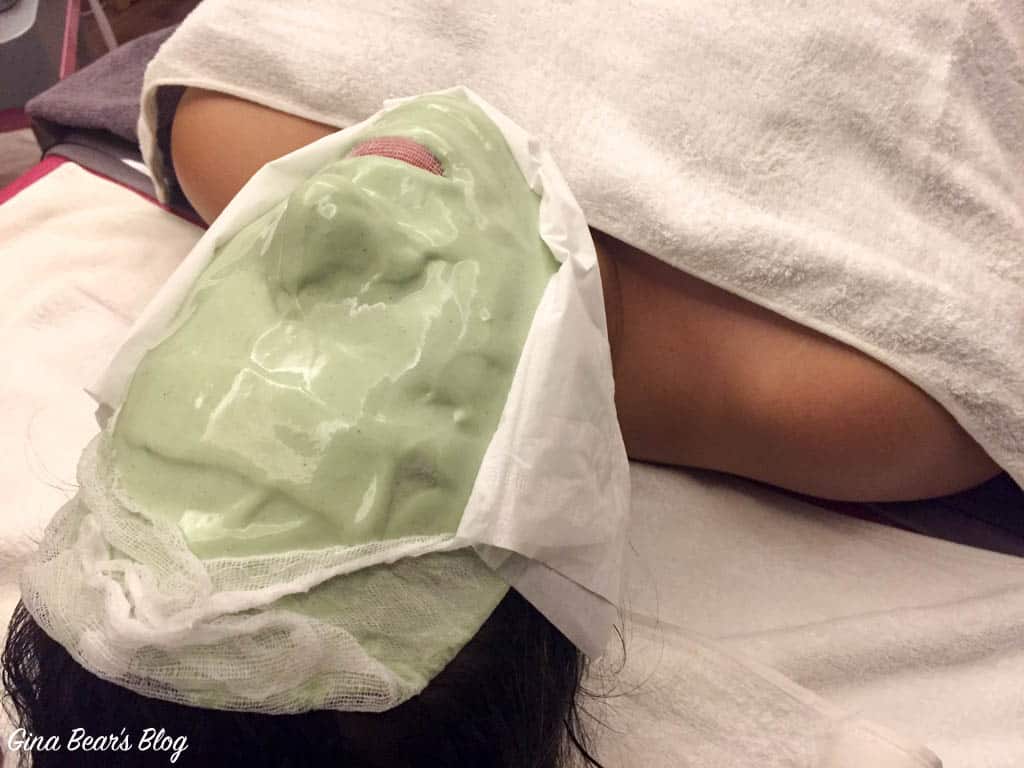
Day Five in Seoul | Go On A Day Trip From Seoul
Whatever your flavor is, this is a great time to do a day trip outside of Seoul and get a feel for the real Korea. The top two I recommend are a day trip to Gyeongju (very traditional old capital of Korea) or a day trip to Jeonju (it has a gorgeous hanok village and also very traditional). I also recommend going to Bukhansan National Park if you like hiking.
- Everland Amusement Park
- Jeonju Hanok Village Tour
- Namhansanseong Fortress Tour
- Suwon Hwaseong Fortress Tour & Korea Folk Village Tour
- Garden of Morning Calm, Nami Island, Petite France Tour
Day Five in Seoul | Explore A Unique Seoul Neighborhood
Where did the time go? Your 5 days in Seoul is almost done. On the last day, I recommend you customize your trip according to your interests. I know people visit Seoul for many different reasons including Kpop, Kdramas, medical tourism, or they just really enjoy Korean culture. I’ve highlighted some of my favorite neighborhoods and the path you should take to save yourself the most time.
Gangnam Day Itinerary
Gangnam is one of the top destinations if you love everything bougie and ritzy. Here you’ll find a lot of high end hotels, classy rooftop bars, and a bunch of fun clubs.
Starfield CoEx Library
The Starfield Coex Mall in the Gangnam district is arguably one of the most Instagram worthy libraries in Asia. This is an absolute must see in Seoul for your 5 days itinerary in Seoul. The Coex Starfield Library is an open public space and features books in many different languages including Chinese, English, French, German, Korean, Japanese, and much more. It’s free and a lot of people spend the afternoon there just reading free books and magazines at the library.
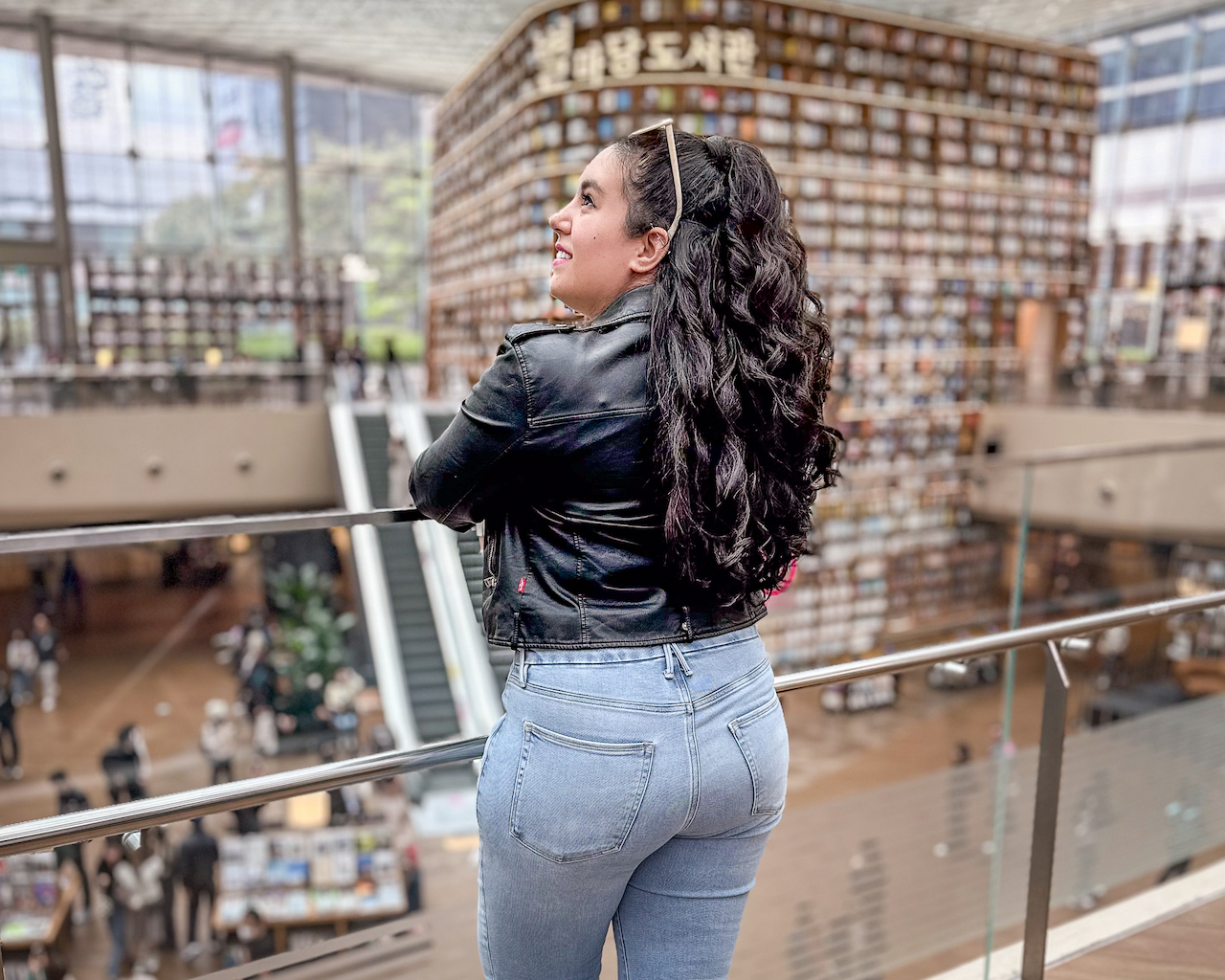
Gangnam Style Hands
Remember when PSY literally broke the internet with Gangnam Style? At the time, no video had ever reached a billion views and YouTube just didn’t know what to do with him. The song also helped put Korean pop on the world map with its fun lyrics and eclectic dance moves. These hands are located right across the street from Bongeunsa Temple.

Bongeunsa Temple
This is another beautiful Buddhist temple nestled in the urban jungle of Seoul. It’s small and quiet and quiet. Sometimes you’ll catch a monk ringing the bell. The main draw is the enormous Buddha on the grounds.
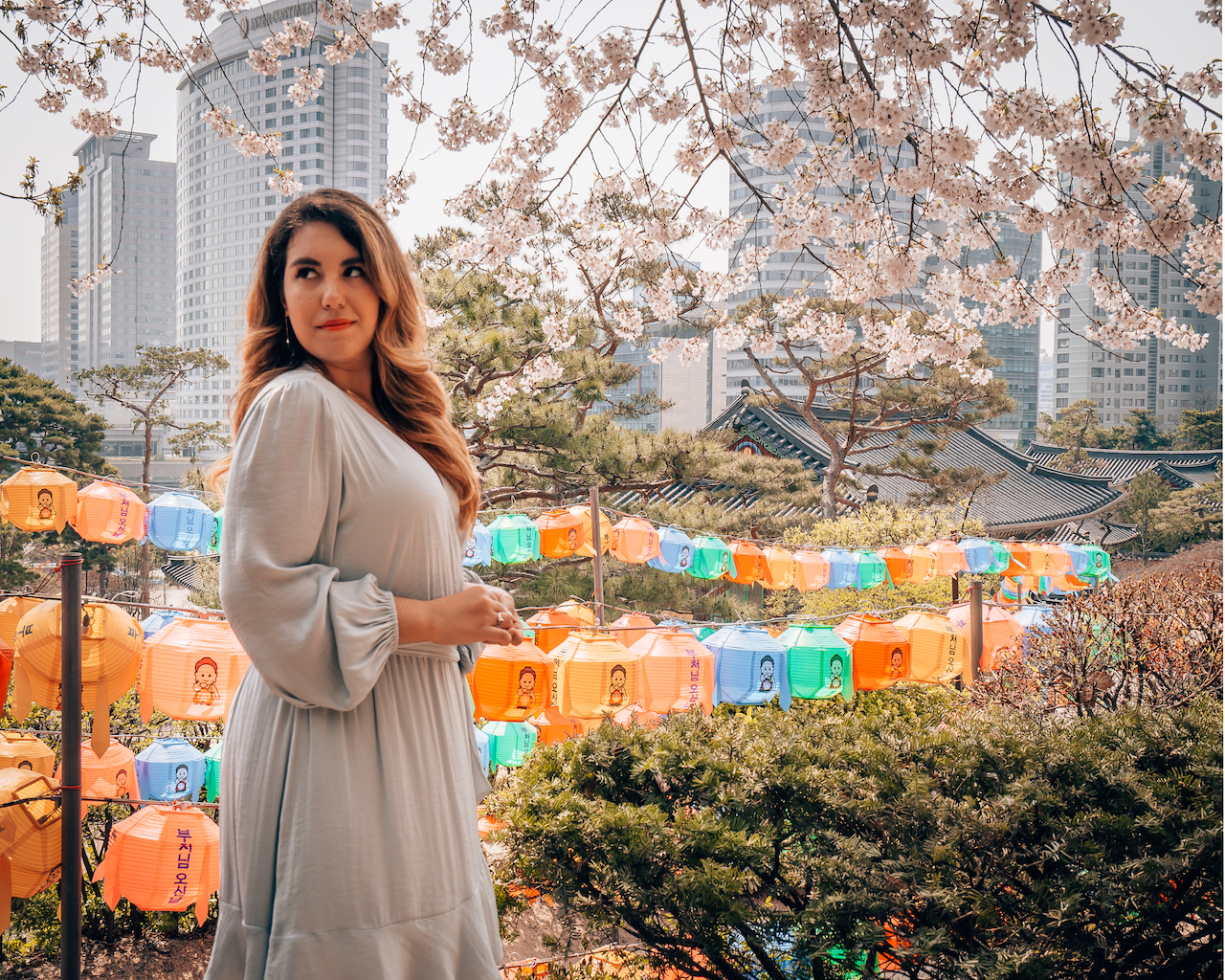
K-Star Road
On this road, you’ll find teddy bears decorated with your favorite K-pop Idol’s colors and logo. These super cute teddy bears are tributes to groups who have contributed a great deal to the Korean music stage. Among the bears, you’ll find BTS, Red Velvet, NCT, Super Junior, and much more.
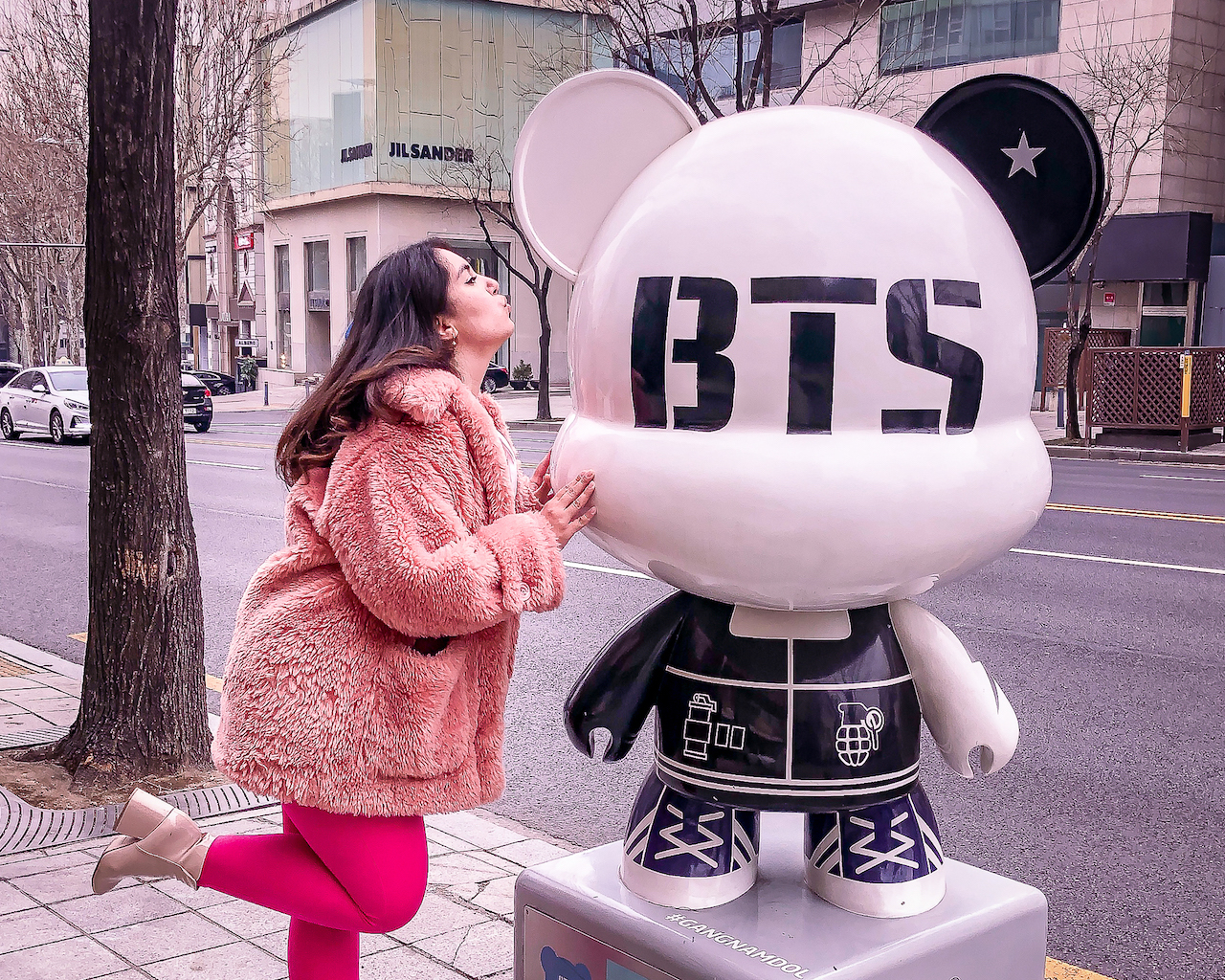
Mammamia Doosan Dessert Cafe
Every 5 day Seoul itinerary needs a few Korean cafes on it. Mammamia Doosan is always a good idea and one of my favorite cafes in Seoul. It’s just a short walk away from K Star Avenue. The cafe is pink with aesthetic decorations, and delicious desserts. It has the best cake pops and croffles in all of Seoul.
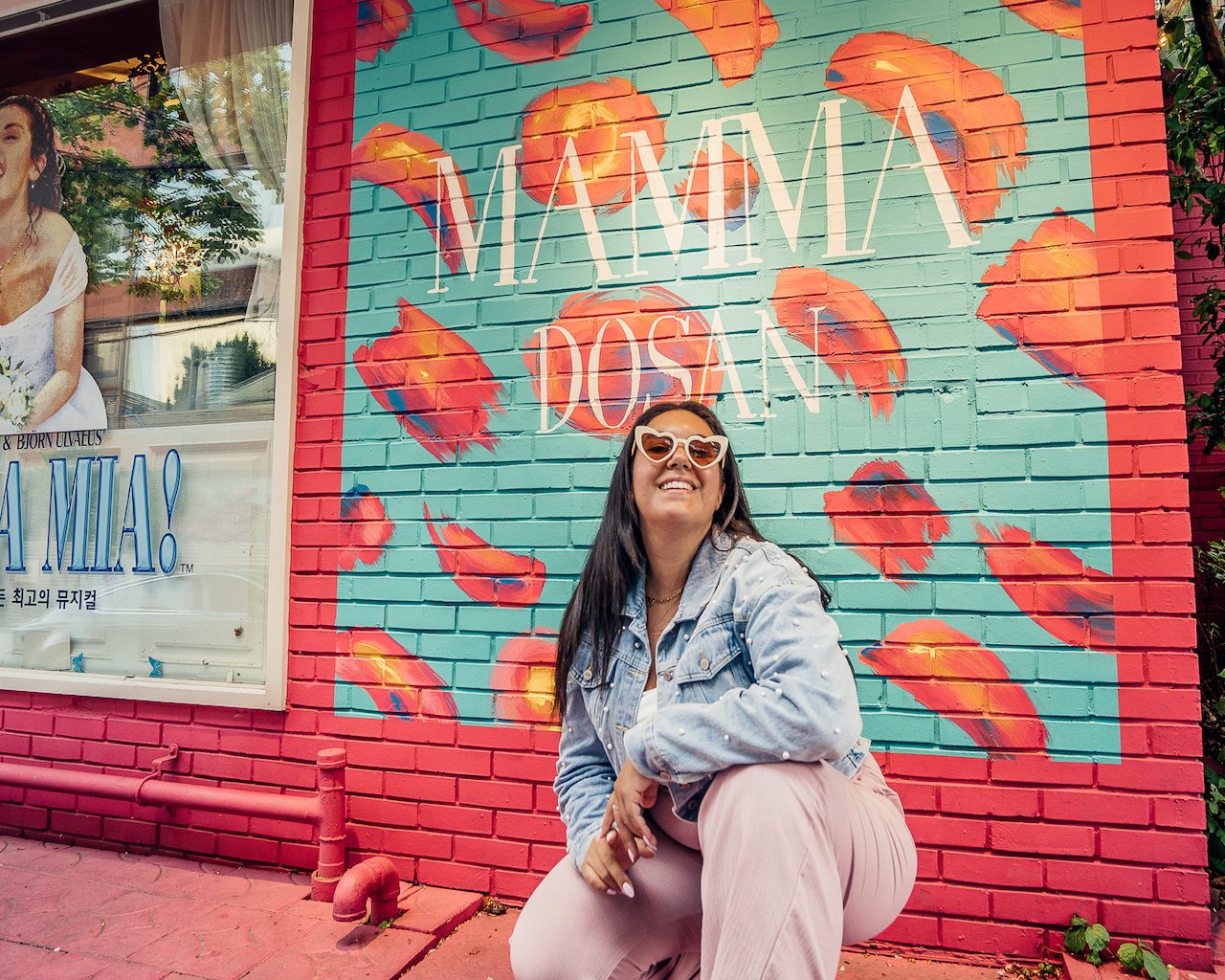
Don’t leave Korea without having an amazing Korean Spa experience. I highly recommend the AHC Spa because these were the only products that helped with my mask acne. The service there is incredible, super relaxing, and honestly top notch. Treat yourself on your last day and look as amazing as the Kpop stars with beautiful and glowy Korean glass skin. You can easily book your AHC Spa experience here.
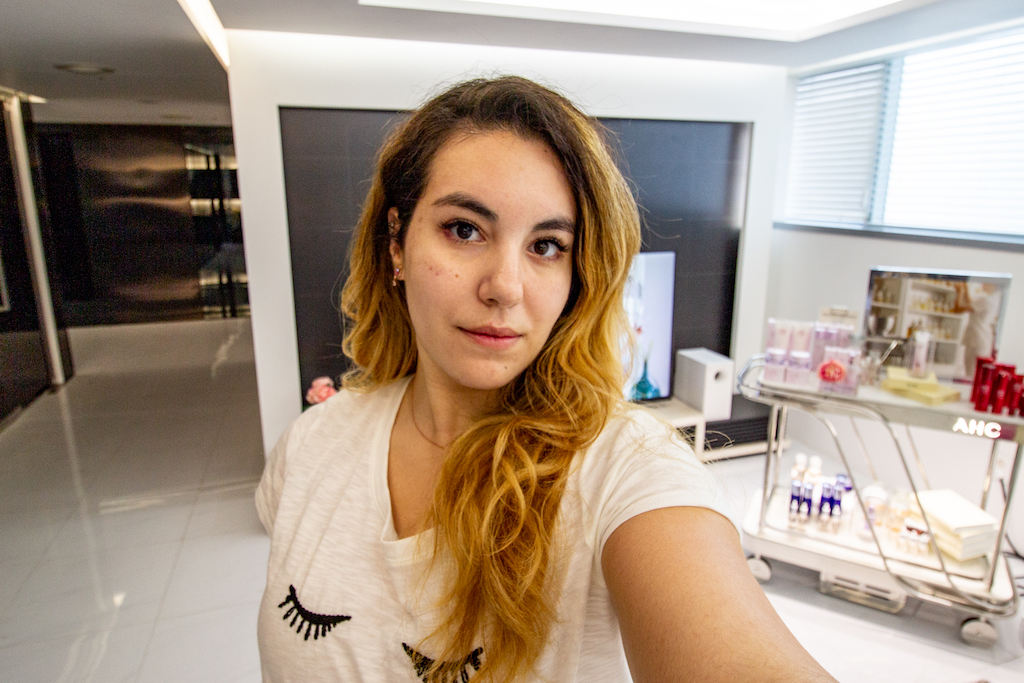
Watch SBS MTV’s The Show
This is great for watching new up and coming groups in addition to popular groups. The schedule is kept super secret so you never know who you’re going to catch performing live. All I know is that it’s a treat for all Kpop fans. You can easily book your tickets to SBS MTV’s The Show here.
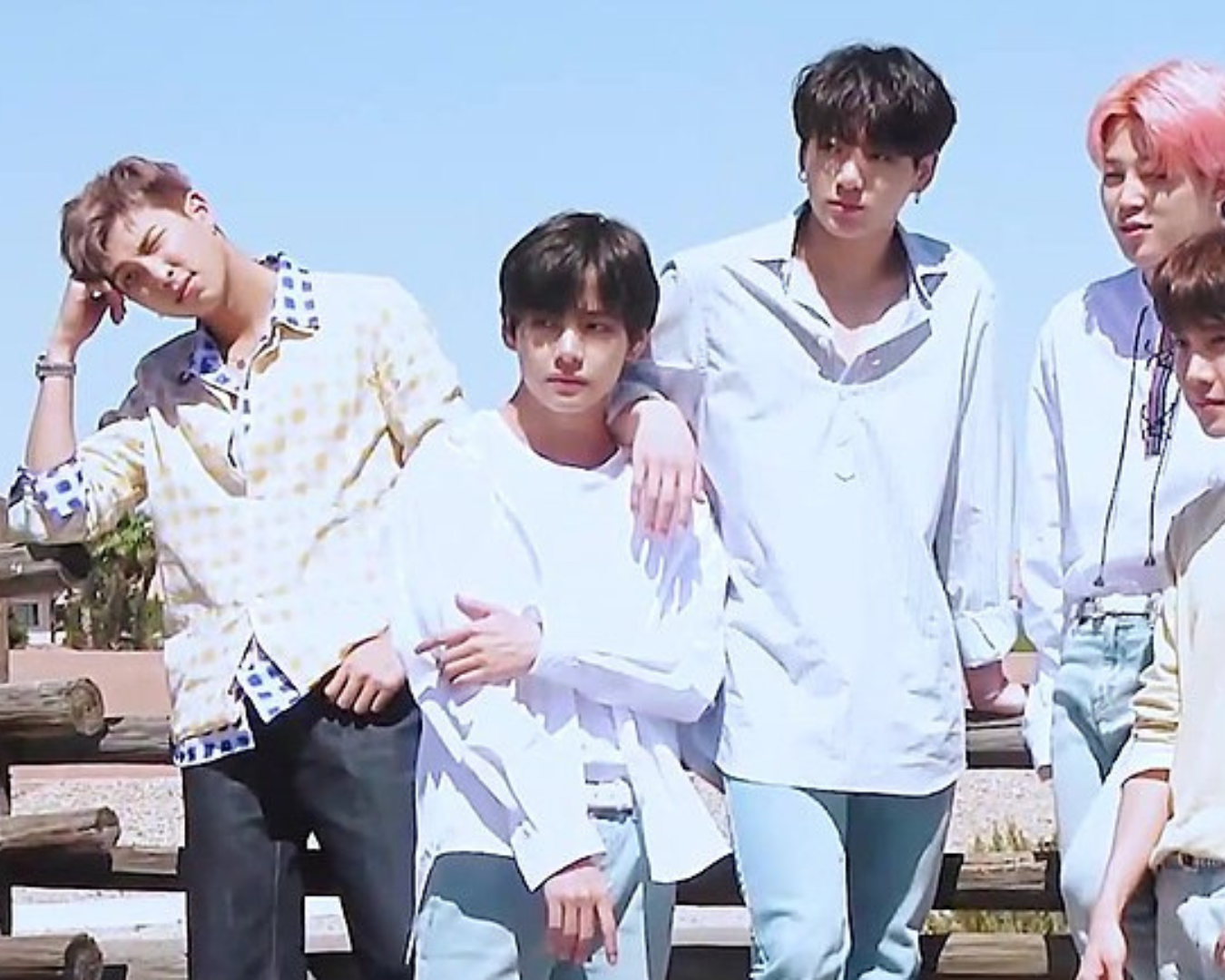
Jamsil Itinerary
If you’d like, you can mix and match the Jamsil and Gangnam Itinerary. These two districts of Seoul are connected via green line 2 and take only 15 minutes to get to the main attractions. I used to live quite close to the Jamsil area and I know it like the back of my hand. I even have a complete post on everything you can do in Jamsil Seoul .
Olympic Park
If you’re a sports buff, then definitely don’t miss Olympic Park. This was the site of the 1988 Olympics and has the Olympic Flame still burning under the giant arch that symbolizes the park. That structure is a famous landmark in Seoul so you can just stop by really quick and snap a photo. This park is mostly popular for hanging out with family, the Rose Garden and Cosmos Field in the back, One Tree Hill, and doing anything outdoorsy.
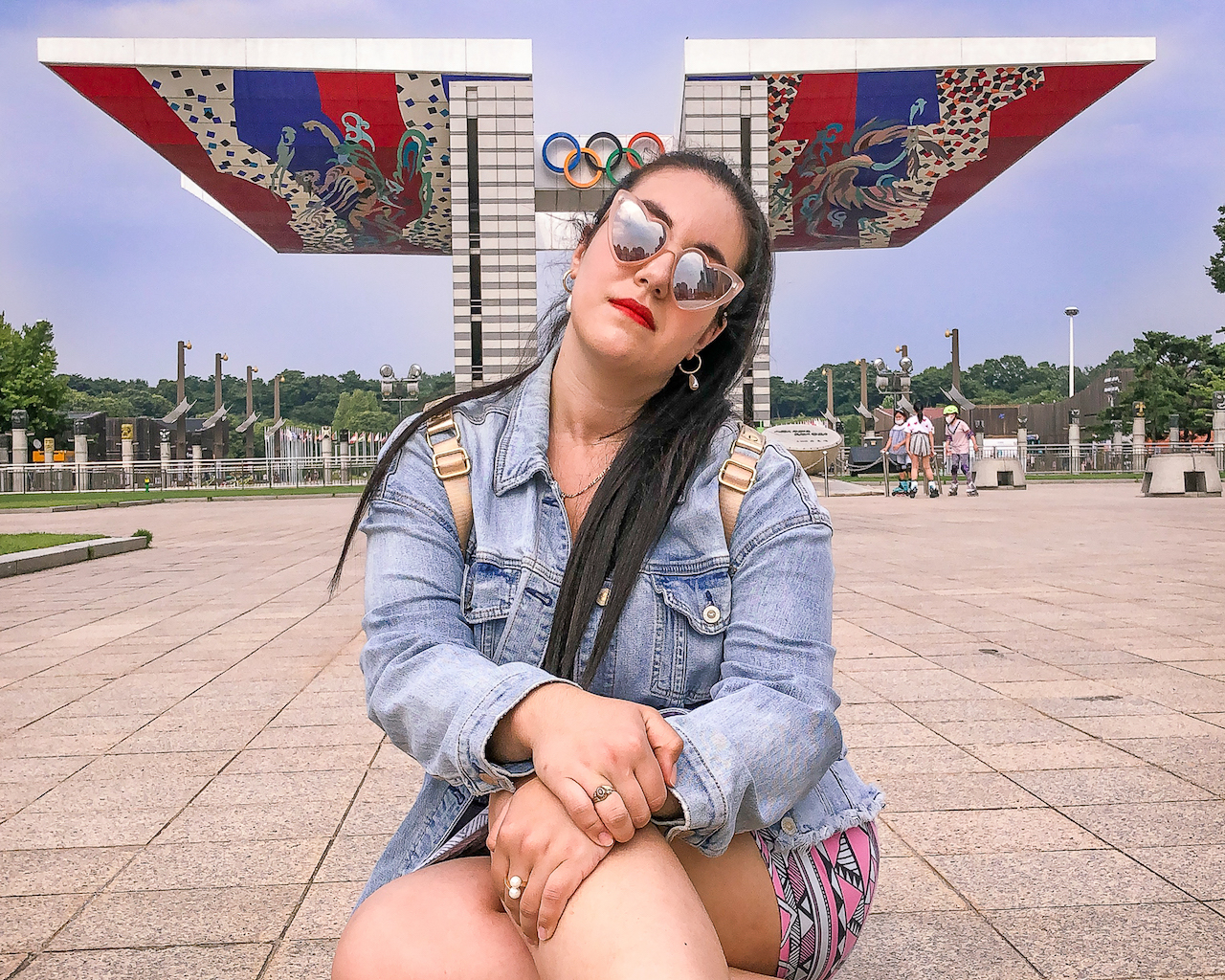
Lotte World Tower | Seoul Sky
I recommend going up to Seoul Sky as it has a really cool observation deck with a glass floor so you can see Seoul below. They also have a cool new experience to try where you can walk across the two highest peaks of the tower. Just be aware this experience is separate from your Seoul Sky ticket. The Lotte World Tower is the fifth tallest building in the world. You can easily book your tickets to Seoul Sky here.
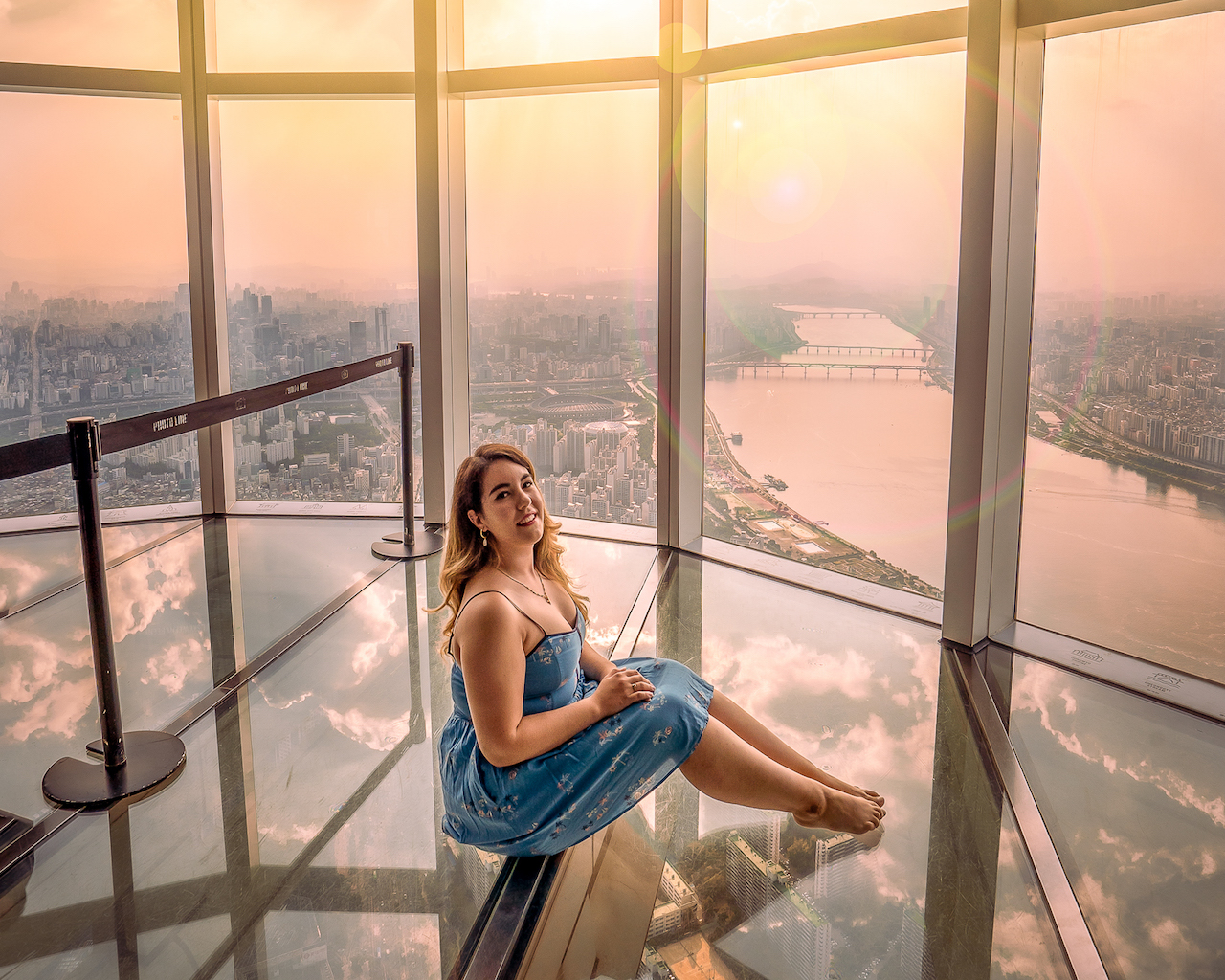
Shopping at Lotte World Mall
Koreans love their shopping malls. I especially recommend shopping at Lotte World Mall around the holidays because of all the amazing Christmas lights and displays inside and outside of the mall.
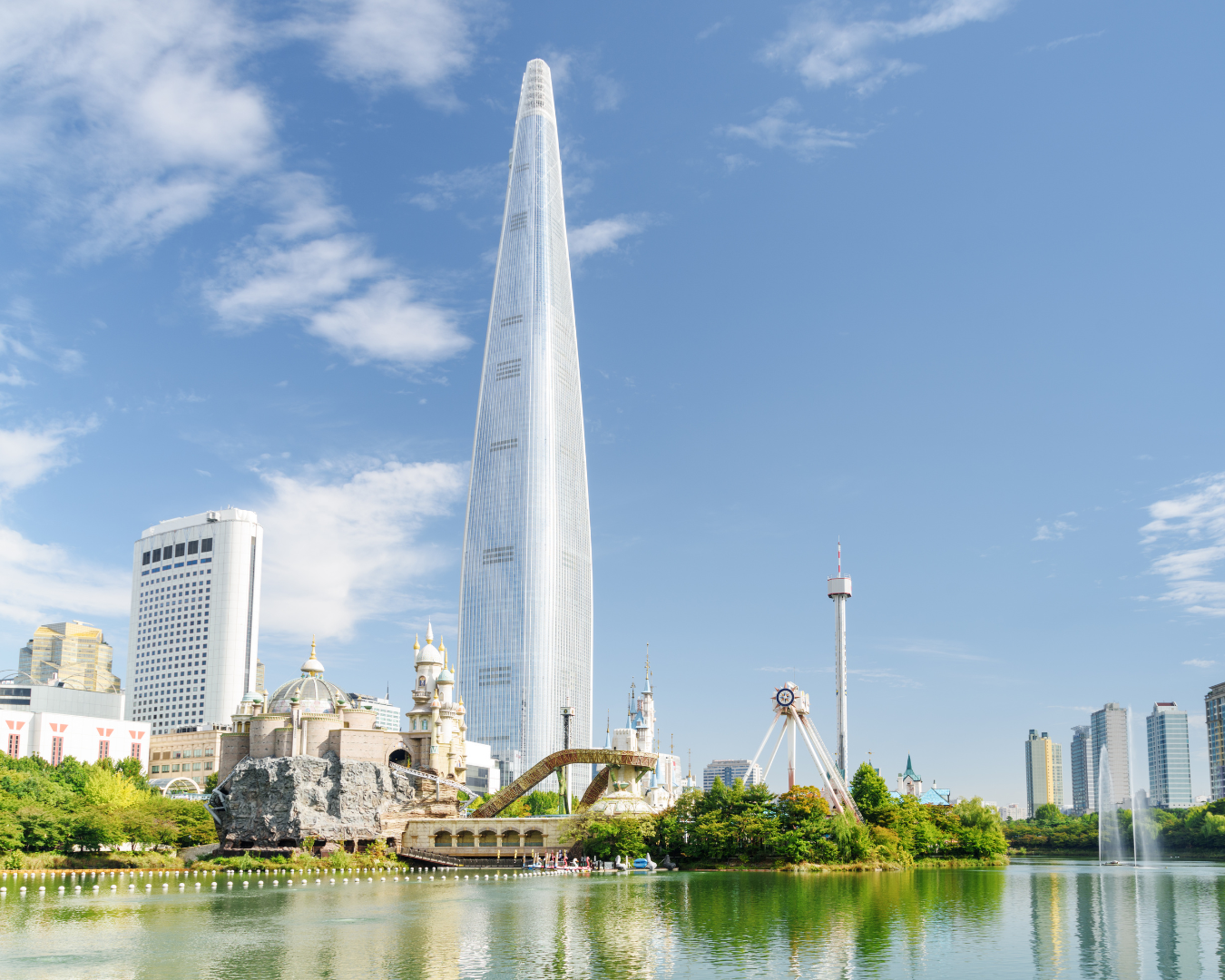
Visited Knotted World Cafe
This is a really cute Korean dessert cafe. They’re known for their interesting assortment of cupcakes and delicious coffee. They also do really big collaborations with name brands. It is located on the sixth floor of the Lotte World Mall.

Arc-N-Book Jamsil
Although the original Arc-N-Book in Myeongdong closed down, you can still visit the one in Jamsil. It has a beautiful light up book arch with hundreds of titles displayed. Legit, this is a bibliophile’s dream!
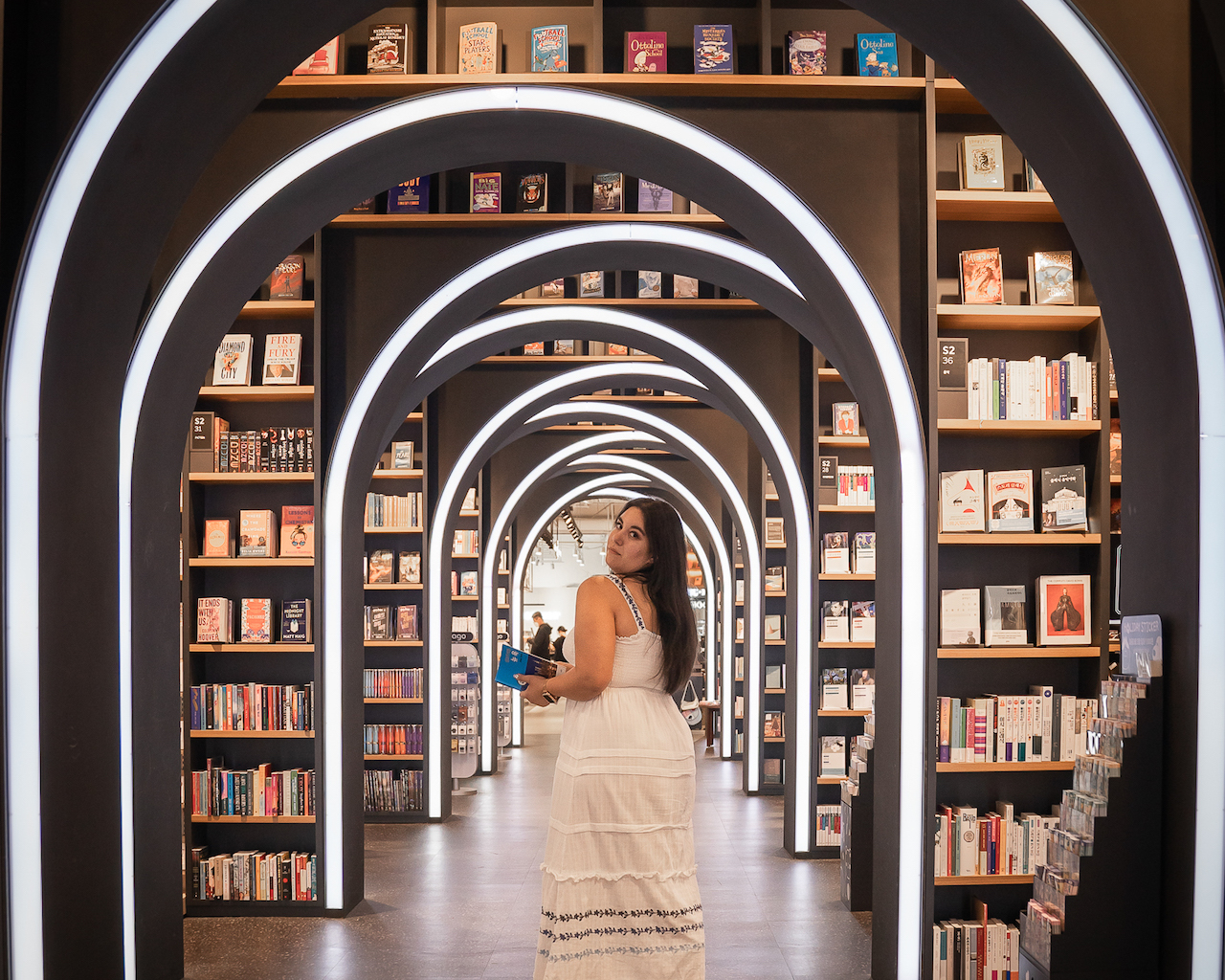
Seokchon Lake
Seokchon Lake is gorgeous all year long! In spring you’ll view cherry blossoms, in summer you’ll witness cool blow up balloons on the lake, in autumn you’ll see the gorgeous foliage, and in winter you’ll get snow. Plus, watching Lotte World light up at night is a fantastic highlight.

Optional: Lotte World
Did you know that Lotte World is the largest indoor amusement park in the world? While this is a very family friendly place and you’ll find tons of school kids here, it is a neat experience. Just be aware since it is super popular, the lines to get on rides are super long. If you’re a Kpop or Kdrama fan, this is a must do since many music videos and romantic scenes were filmed at Lotte World and in front of the iconic merry-go-round. You can easily book your tickets to Lotte World here.
D Throne Cafe
This is another eclectic cafe in the Jamsil area I really recommend you visit. My question has always been, “Why do kids get to have more fun?” Now you can channel your inner child here. They have really cute electric powered cars that you as an adult can ride in. It’s seriously the most fun I’ve ever had zipping around the Seoul streets.
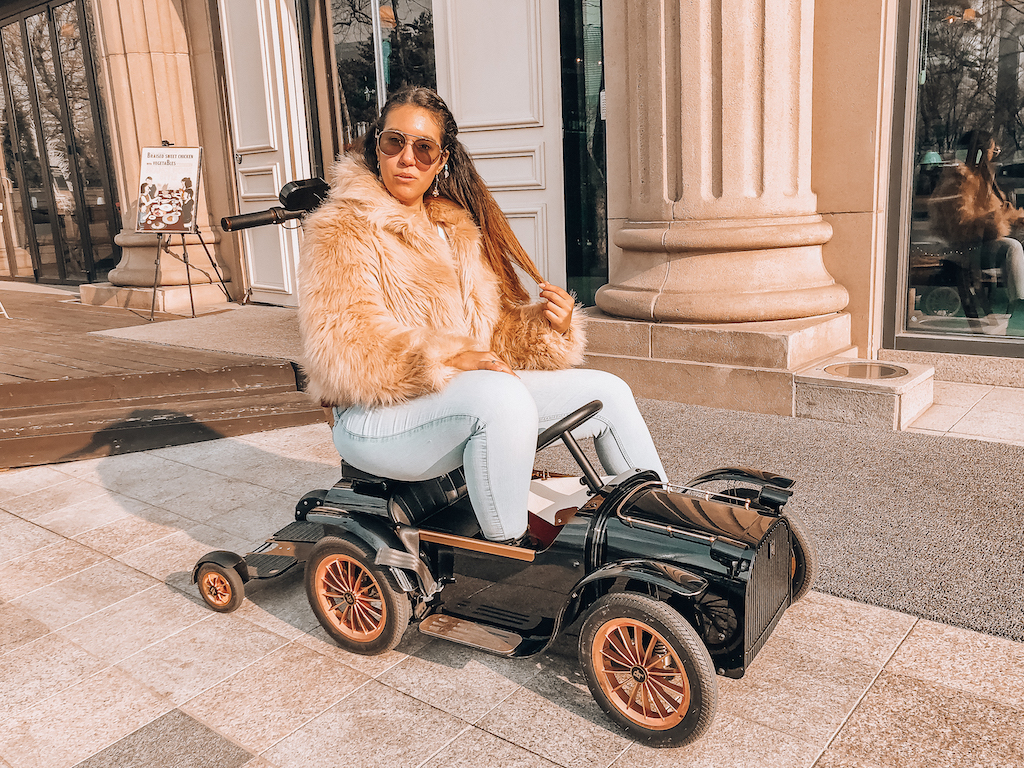
Seoulism Cafe
This is one of my all time absolutely favorite cafes in Seoul. I love it for its incredible view of the Lotte Tower. The drinks and food in the cafe are quite expensive, but you’re honestly going there for the views and atmosphere. Going at sunset is the best time for photos at the Seoulism cafe.
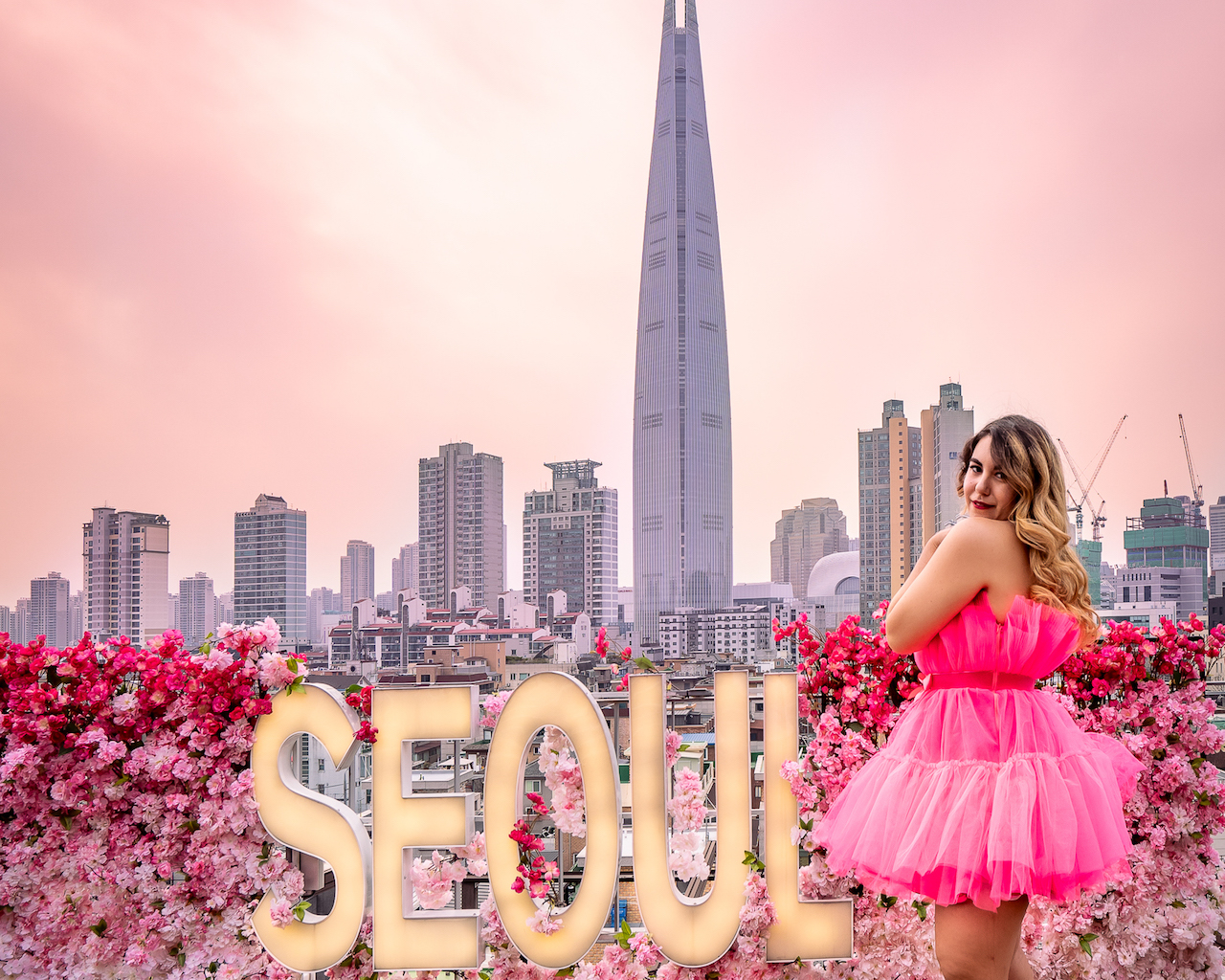
Hongdae Itinerary
Hongdae is also another fun place to shop and hang out. Since Hongik University is located there, you’ll find a much younger crowd, cheaper places to eat and drink, and also you can find all the trendiest accessories and clothes here. I recommend this itinerary for those who love cafes and eclectic things.
Watch Uni Students Sing & Dance Outside of Hongik Station Exit 9
University students will often sing live music and dance outside of this exit on the main street. You’ll especially see them on the weekends outside of Subway Line 2 aka the Green Line. The shows are free, but tips are always appreciated. These kids are super talented so I promise you’ll have a free amazing show if you’re into the Kpop culture.
Go Shopping on the Main Strip
If you want to shop for the trendiest clothes, cutest accessories, and all the Korean skincare and makeup, don’t miss the main strip. You’ll see all sorts of shops there.
Visit An Eclectic Korean Cafe in Hongdae
- 943 King’s Cross Harry Potter Cafe in Seoul
- Meerkat and Friends Cafe in Seoul
- Most Instagrammable Cafes in Seoul
- Thanks Nature Sheep Cafe in Seoul

Eat Dessert at Dinga Cake House
If you’re a Kpop fan, then you’ll recognize that Dinga Cake House has been featured in quite a few music videos. This cafe is designed to look like a 1950s retro home. The cakes and drinks are absolutely superb and I give this cafe another 10/10 for how tasty everything is.

In Conclusion
Honestly, I think five days in Seoul is way too short and even if you spent a month there, you wouldn’t even get to half of my favorite experiences. If you’re an avid fan of Korean experiences, then this 5 day South Korea itinerary will be perfect for you. I hope you have a great first visit to Seoul!

This post contains affiliate links which means at no additional cost to you, I make a small commission to help keep Gina Bear’s Blog running. Thanks for your support!
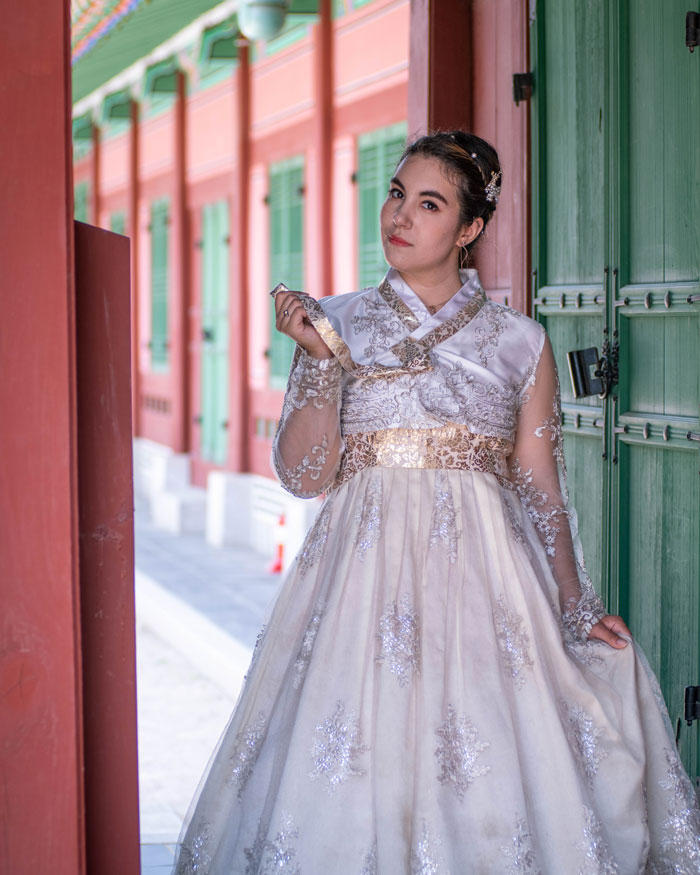
Free Seoul E-Book
Do you love south korea.
Enter your name and email address and click the button below to receive your Easy Seoul Travel Guide so you can travel like a local!
Related Posts

Leave a Reply Cancel reply
Your email address will not be published. Required fields are marked *
This site uses Akismet to reduce spam. Learn how your comment data is processed .
Seoul Solo Travel Guide

Planning a solo trip to Seoul , Korea? Here’s everything you need to know for your visit:
QUICK FACTS
- Officially known as Seoul Special City, with a population of around 10 million people.
- Part of UNESCO’s Creative Cities Network due to cutting edge design.
- Located on the banks of the Han River , with a history going back 2,000 years.
- A global financial and technological powerhouse , with the world’s fourth largest metro economy by total GDP (after Tokyo, NYC, and LA).
- Has a very high quality of life , and the world’s fastest internet connections (up to 1 Gbps).
- Nickname: Soul of Asia.
PRACTICAL INFORMATION
- Currency: Won (KRW).
- Spoken languages: Korean , although most locals have a basic grasp of English .
- Best time to visit: from October to March . Pack a sweater and an umbrella, as the weather can be unpredictable.
- Arriving via airport: Incheon Airport (ICN) connects with most areas of the city via Limousine buses and Express Train with fares calculated based on distance.
- Taxi stands are located at the arrival level and cost ₩40,000 to ₩65,000 (depending on distance).
WHERE TO STAY
- Best Seoul hostel for solo travelers: Jin’s Paradise . Just a 10 minute walk from the subway station, this is a clean, cozy, and social establishment with a friendly and helpful owner (Jin). Perfect as a base for exploring the city, or for meeting others – it’s so small that you’ll end up meeting everyone by default.
- Jongno and Sinchon offer guesthouses, hostels, backpacker bars, and cafés close to the main sights, while Itaewon boasts a great variety of shopping options.
- Garosugil and Sinsa are fashionable and quiet, while Apgujeong takes the honours for trendy cool.
GETTING AROUND
- T-Money is a transaction and transportation card that can be used to pay for subway and bus fares, giving you a ₩100 discount on tickets plus free transfers across the network.
- The Seoul Subway is the world’s largest (by length), and known for its efficiency and cleanliness. Lines are distinguished by color codes. Fares start at ₩1,150 and are distance dependent.
- Bus routes are also color-coded, and cover defined routes within the city with tickets based on a starting fare plus an additional ₩100 for each km thereafter.
- Group taxis are either Call Vans or Jumbo Taxis , the first being used for passengers transporting freight and cargo goods, and the latter for regular passengers. Call Vans have negotiable fares and license plates that start with the number 8; Jumbo Taxis use the meter with fares starting at ₩4,500 for the first 3 kilometers and ₩200 for each additional 164 meters. Standard (regular) taxis charge ₩2,400 for the first 2 kilometers and ₩100 for each successive 144 meters, and can be booked on 02-1330.
- Instead of a taxi , consider calling a ride via Kakao T (the most popular ride sharing service in Korea).
SEOUL NIGHTLIFE
- Drinking age is 19 , and last call is at 5 AM .
- Hongdae has a multitude of bars, cafés and street performances that go deep into the Korean sub culture.
- Sinchon and Gangnam Station are the watering hole of Korean university students looking for cheap drinks and casual bars that stay open late.
- Samcheong-dong is where the fashionable and trendy congregate.
- Great foreigner-friendly clubs : Cakeshop Seoul and Faust (both in Itaewon).
- Great bars for solo travelers: Zen and La Bamba (both in Hongdae).
- Bars and clubs always check IDs , so make sure you have one with you (government issued, with your date of birth).
UNIQUE LANDMARKS TO VISIT
- Gyeongbok-gung is Korea’s most famous palace, once belonging to the Joseon Dynasty.
- Seoul Tower is a communication and observation tower – the highest point in the city.
- Heunginjimun is one of the Eight Gates of Seoul in the Fortress Wall of Seoul, also designated as a National Treasure.
- The National Museum of Korea is dedicated to Korean art and history, and boasts the largest collection of relics and antiquities in the country.
- Cheongwadae is the presidential residence, also referred to as the Blue House. Visits need to be booked a week in advance.
- Sangam Stadium was built for the FIFA World Cup 2012 and is a distinct structure, shaped like a traditional Korean kite.
- Lotte World is the world’s largest indoor theme park, complete with luxury hotel, top rides, excellent shopping options and the Korean Folk Museum .
INTERESTING WALKS
- Namsan Park is perched atop its namesake mountain in the centre of Seoul, accessible by cable car.
- Insadong is a one-stop shop for everything Korean including tea houses, galleries and quaint shops selling antiques.
- Namdaemun Market is perfect for souvenir shopping over some healthy haggling.
- Bukchon Hanok Village is a beautiful area of the city bearing traditional Korean housing.
LOCAL WISDOM
- Koreans place family values above individual needs. Protocols and etiquettes are strictly enforced and respected.
- Pungmullori is a traditional Korean art form combining music, dance and acrobatics. Performances can be caught at the Korean Folk Village or at Chongdong Theater.
- Great restaurants to try: Myeongdong Kyoja (multiple locations), Buchon Yukhoe (beef tartare), Xesc Menzl (German cold cuts and sandwiches), Villa Guerrero (tacos), Star Samarkand (Uzbek food), Niuroumianguan (Taiwanese), Petra (Jordanian), Savage Garden (vegetarian), Balwoogongyang ($$$ – with vegan options).
- Looking for great Gamjatang ? Head to Taejo Gamjaguk Sungshin Women’s Univ.. Craving fried chicken? Hyodo Chicken.
- Where to find good cheap eats : Sindang and Ojang for quick and cheap meals eaten standing up, Majang meat market for barbecue and Dobong for the city’s best tofu.
- Dangerous areas : Seoul is generally very safe. Exercise caution at night, especially when walking alone (just as in any major city).
Recommended trip duration: 3-4 days
- Taipei, Taiwan
- Singapore, Singapore
- Hong Kong, China
- Busan, South Korea
Leave a Reply Cancel reply
Your email address will not be published. Required fields are marked *
Save my name, email, and website in this browser for the next time I comment.

- 2 Weeks for Couple
- 2 Weeks for Family
- Thailand Lantern Festival
- Indonesia(Bali)
- South Korea
- China (HK, Taiwan)
- Itinerary Ideas
- Asia Highlights Travel Reviews
- Thailand Travel Reviews
- Vietnam Travel Reviews
- Cambodia Travel Reviews
- Japan Travel Reviews
- Myanmar Travel Reviews
- China Travel Reviews

- 10 Days in South Korea: Best 4 Itineraries for a First Visit 2024/2025
When visiting South Korea, 10 days is the most popular length of time for both families and couples. You could explore major highlights of Seoul and Busan without feeling rushed. You would also have the flexibility to visit Jeju Island, traditional Gyeongju and Andong, or other places that interest you.
In this article, we've handpicked four 10-day South Korea itineraries to help you plan a once-in-a-lifetime vacation and stress-free journey. We would customize any itinerary based on your preferences.
Itinerary 1: Classic South Korea
- Itinerary 2: For Family with Teenagers
Itinerary 3: Modern and Historical South Korea
Itinerary 4: south korea off-the-beaten-path.
- How Much Does a 10-Day Trip in South Korea Cost
This 10-day itinerary is excellent for a first visit to South Korea. It covers the must-see attractions in Seoul, Busan, Gyeongju, and Jeju Island, as well as a variety of authentic activities to enrich your trip.
- 3 nights in Seoul
- 1 night in Gyeongju
- 2 nights in Busan
- 2 nights on Jeju Island
- 1 night in Seoul
Begin your adventure in Seoul. Explore iconic landmarks, such as Gyeongbokgung Palace, Bukchon Hanok Village, Myeongdong, and N Seoul Tower with your private guide. Your guide would help you to understand the culture and history of Seoul in a more interesting way.
To fully immerse yourself in Korean cuisine, taste authentic Korean food at Gwangjang Market. You would also have the chance to try your hands at a cooking class in a local home.
Next, head to Gyeongju, the ancient capital with many historic sites. Don't miss experiencing a night's stay at a traditional Hanok hotel. A Hanok hotel usually has 5–15 rooms and they're easily booked up, so you're advised to make a reservation at least 3 months in advance.
Continue your adventure to the seaside city of Busan. You could quickly get a feel for the city's cultural-rich atmosphere at Haedong Yonggung Temple and Gamcheon Culture Village.
Take a short flight to end your journey on Jeju Island. Be amazed by the natural wonders of Manjanggul lava tube, Hallasan Mountain, and Seongsan Ilchulbong ('Sunrise Peak'). Watch Haenyeo divers catch seafood in a traditional way and enjoy some free time on the beaches. After that, back to Seoul to depart from the country.
Our South Korea travel expert would tailor-made a private tour for you based on your preferences and requirements.
Itinerary 2: for Families with Teenagers
This 10-day South Korea itinerary is suitable for families with teenagers and allows for a relaxing travel pace. It would satisfy your kids' love for K-pop and provides abundant family-friendly experiences. What's more, you don't need to change hotels a lot.
- 4 nights in Seoul
- 3 nights on Jeju Island
Start your trip in Seoul. For a special family experience, we could arrange many authentic activities to help you delve into Korean history, culture, and food. For example, experience a private K-pop dancing class and shoot a video, explore the DMZ tunnels with a guided tour, indulge in a cooking class, and spend a night at a traditional Hanok hotel.
Then, take a comfortable KTX (Korea Train Express) to Busan. Enjoy the natural beauty of Taejongdae by traveling effortlessly on the Danubi Train and then sample various street food at BIFF Square.
If you want to see the full view of Busan's coastal line, Songdo Skywalk is a must-visit. We suggest picking the high-end crystal cable car with a glass bottom instead of the regular one. That way, you could enjoy the beautiful sea view of Busan from every angle, feeling like you're walking on air.
Finally, you would fly to Jeju Island and be immersed in its attractive highlights: Seongeup Folk Village, the performance of Haenyeo divers catching seafood, and a sightseeing cruise to watch whales.
Our travel expert would carefully design each private tour to cater to your unique interests and requirements .
With this 10-day South Korea itinerary, you would explore the top two modern cities of Seoul and Busan, and also delve into the profound history of the ancient cities of Andong and Gyeongju.
- 1 night in Andong
- 2 nights in Seoul
Your journey through South Korea would begin in Seoul, a capital with a vibrant culture. You would take a leisurely walk in Insadong and Myeongdong, cruise on the Han River, and sample local Korean food at Gwangjang Market.
During your stay in Seoul, you could also consider taking 1–2 days for a day trip to explore nearby cities like Suwon, known for its rich traditions, and Chuncheon, a paradise for outdoor sports.
On day 4, you would head to the birthplace of Korean philosophical culture, Andong. Highlights include seeing a unique mask dance performance at the famous Hahoe Folk Village and creating your mask at Hahoe Mask Museum. With the company and guidance of a local guide, you would gain a deeper understanding of historical stories.
On day 5, travel to Gyeongju to visit the "museum without walls". There are many historical sites with thousands of years of history waiting for you to explore: Bulguksa Temple, Seokguram Grotto, and Donggung Palace and Wolji Pond. Don't forget to spend a night at a Korean-style Hanok hotel.
Then, spend 3 days in Busan, where you could wander around Haedong Yonggungsa Temple, experience the fun Songdo Skywalk, and sample the freshest seafood. After that, head back to Seoul to depart from South Korea.
You can just tell us your preferences and requirements, and we will customize a tour for you.
With this 10-day itinerary, you would visit the bustling city of Seoul and explore three off-the-beaten-path cities: Sokcho, Andong, and Suncheon. Immerse yourself in traditional villages and enjoy serene natural views.
To make the most of your time while visiting the attractions, you're recommended to travel in a private car when visiting the three hidden gems of Sokcho, Andong, and Suncheon.
- 1 night in Sokcho
- 2 nights in Suncheon
You would start in Seoul. Explore the highlights with a guided tour of Changdeok Palace, Bukchon Hanok Village, Jogyesa Temple, the DMZ, and any other attractions that you're interested in.
One of the highlights of this itinerary is the Seoraksan National Park in Sokcho. This is the highest peak near Seoul, featuring strange rocks and rare wildlife. It's a great place for travelers who love adventure and outdoor sports.
The traditional city of Andong is your next stop. Enjoy a unique mask dance performance at Hahoe Folk Village and visit the local Confucius temple and school to gain insights into the culture that has deeply affected Korean history.
Another highlight of this itinerary is Suncheon Bay Wetland Reserve in Suncheon. It's one of the world's top five coastal wetlands. You could take a sightseeing cruise to visit the rare birds with a guide and wander across the wide reeds. Finally, take a private car and return to Seoul to depart South Korea.
If you have other requirements, contact us and we can make it happen.
How Much Does 10 Days in South Korea Cost?
US$400–500 per person per day is the typical cost for a private tour with 4-star hotels, based on a family of 3–5 people. This includes a private guide, private car, full-day itinerary, tickets for attractions, all intercity transport within South Korea, and handpicked 4-star hotels.
Therefore, the total cost for 10 days in South Korea would be about US$4,000–5,000 per person (international flights not included).
Why Asia Highlights (10,000+ reviews & 98.8% 5-star rating)
- Save Your Time:
- Less research, more enjoyment!
- Real-time 1V1 expert planning
- Maximize Your Flexibility:
- Personal local guide and ride
- Explore at your own pace
- Celebrate Your Journeys:
- Specially-crafted family adventures
- Celebrate milestones with style!
- 16-Day South Korea and Japan Cultural Adventure Tour
- 8-Day South Korea Tour to Visit Highlights of Seoul, Busan and Jeju
- 10-Day South Korea Tour to Visit Seoul, Sokcho, Andong and Suncheon
- 17-Day Classic South Korea and Taiwan Tour
- How to Plan Your Trip to South Korea 2024/2025 (6 Easy Steps)
- How to Plan a 12-Day Trip in Japan and South Korea
- How to Plan a 2-Week Itinerary in Japan and South Korea
- Japan Weather in January: Travel Tips for First-Timers
- Japan Weather in February 2024: Travel Tips for First-Timers
- Japan Weather in March 2024: Travel Tips for First-Timers
- Japan Weather in April 2024, Travel Tips (for First-Timers)
- Japan Weather in May 2024: Travel Tips for a First Visit
- Japan Weather in June 2024: Coolest Summer Month, Travel Tips for First Visit
- Japan Weather in July 2024: Full of Festivals, Travel Tips for First Visit
- Japan Weather in August 2024: Travel Tips for First Visit
- Japan Weather in September, Travel Tips (for First-Timers)
- Japan Weather in October 2024: Travel Tips for First-Timers
- Japan Weather in November 2024: Best Autumn Month, Travel Tips
- Japan Weather in December 2024: Travel Tips for First-Timers
Get Inspired with Some Popular Itineraries
At Asia Highlights, we create your kind of journey — your dates, your destinations, at your pace. You can have any trip tailor made for your travel.
More Travel Ideas and Inspiration
Sign up to our newsletter.
Be the first to receive exciting updates, exclusive promotions, and valuable travel tips from our team of experts.
Why Asia Highlights
Where can we take you today.
- Middle East
- African Safari
- Travel Agents
- Loyalty Program
- Our Differences
- Privacy Policy
Address: Building 6, Chuangyi Business Park, 70 Qilidian Road, Guilin, Guangxi, 541004, China
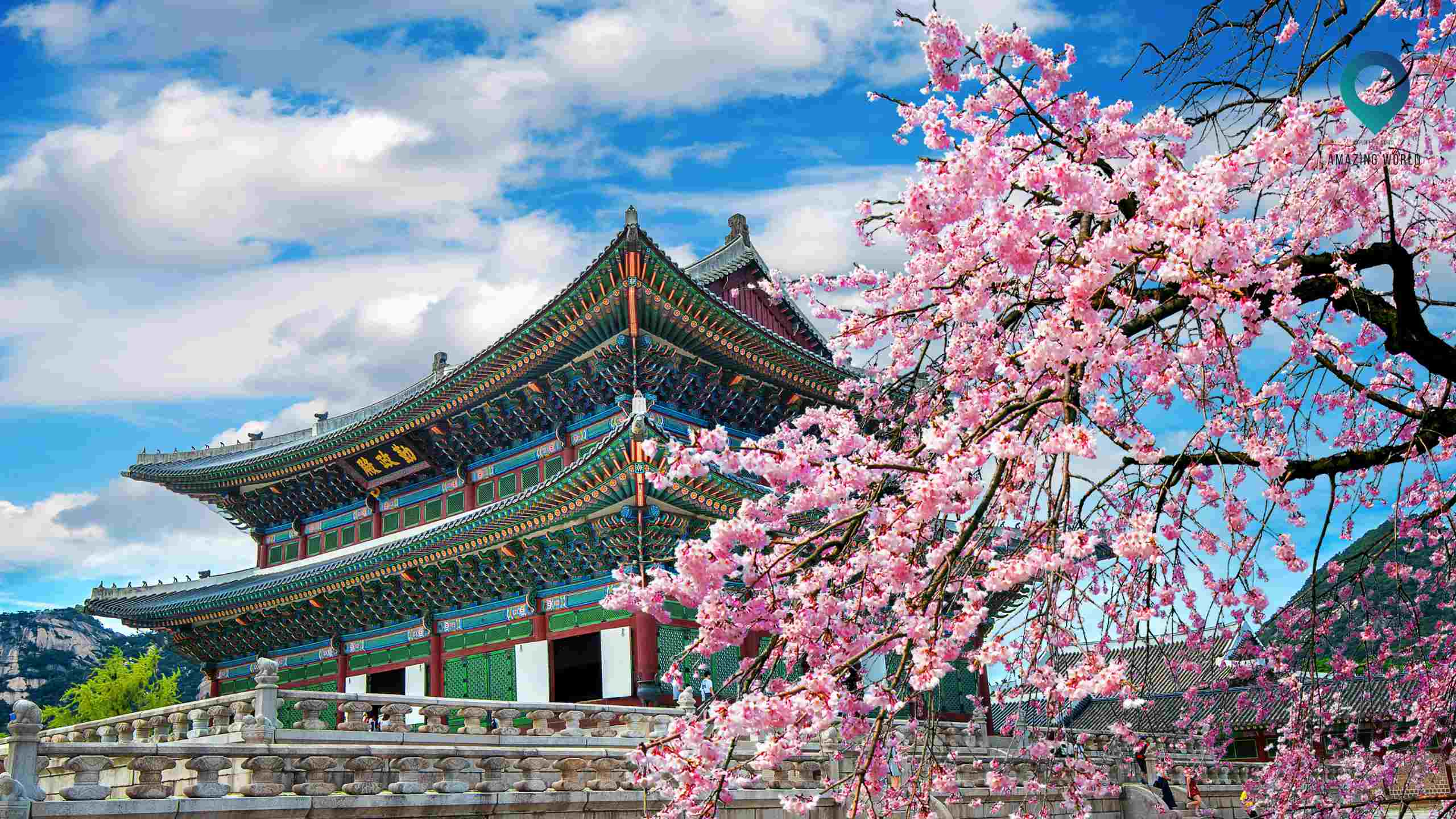
EPIC 7 Days Korea Travel itinerary for first-timers (2024)
- 9 minute read
- September 11, 2023
1-Week South Korea Travel Itinerary | Place to Explore, Safety Tips, Currency or Payment Types
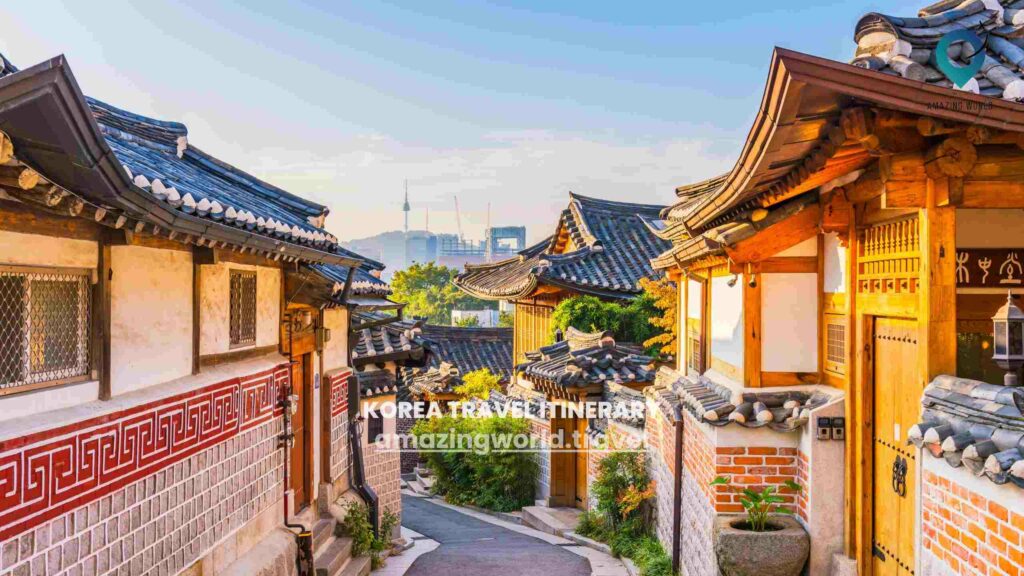
Are you planning a fantastic 1-week journey to South Korea? You’re in the right place! In this travel guide, we’ll help you map out an unforgettable trip to South Korea in just 7 days. We’ll provide you with a detailed itinerary, so you can explore the best of South Korea while staying within your budget and schedule. From exploring vibrant markets to enjoying delicious Korean cuisine, we’ve got your travel plans covered. So, let’s get started on your exciting adventure from India to South Korea!

Visa and Entry Requirements:
Check Visa Requirements: Determine whether you need a visa to enter South Korea. Visa requirements vary depending on your nationality and the purpose of your visit. Visit the official website of the South Korean embassy or consulate in your country to find out the specific requirements.
Prepare Required Documents: Gather the necessary documents for your visa application. Typical documents may include a valid passport, visa application form, passport-sized photos, proof of financial means, and a letter of invitation if applicable.
Submit Your Application: Submit your visa application to the nearest South Korean embassy or consulate in your country. Be sure to follow the specific instructions and pay the required visa fee.
Wait for Processing: Visa processing times can vary, so it’s essential to apply well in advance of your intended travel date. Check the processing times with the embassy or consulate.
Receive Your Visa: Once your visa is approved, you will receive it in your passport. Make sure to check the visa’s validity and any specific conditions.
Booking International Flights:
Research and Compare: Use online travel websites or consult with travel agencies to research and compare international flight options to Seoul. Consider factors like cost, airline preferences, travel dates, and layovers.
Book Your Flight: Once you’ve chosen your flight, book your tickets online through the airline’s website or a trusted online travel agency. Be sure to provide accurate passenger information and pay for your tickets using a secure payment method.
Check Passport Validity: Ensure that your passport is valid for at least six months beyond your planned departure date to avoid any issues with immigration.
Also, if you are looking best Fights at Discounted Rates we recommend booking your Fights with Singapore Airlines
Other Airports Serving Seoul:
Aside from Incheon International Airport (ICN) and Gimpo International Airport (GMP), there are also:
Gimhae International Airport (PUS): Located in Busan, South Korea’s second-largest city, this airport serves as an alternative international gateway to Seoul. You can reach Seoul from Gimhae Airport by taking a domestic flight to Gimpo Airport or using the KTX train service. Reaching Seoul by Flight:
Upon arriving at Incheon International Airport or Gimpo International Airport, you can reach Seoul’s city center by:
Airport Railroad Express (AREX): The AREX train connects both airports to Seoul Station, where you can transfer to the Seoul Metro or other transportation options to reach your hotel.
Airport Limousine Buses: These buses provide convenient transportation to various parts of Seoul, including major hotels and neighborhoods. They operate from both airports.
Transportation Services from the Airport to Hotels:
Taxi: Taxis are readily available at both Incheon and Gimpo airports. Ensure the taxi has a functioning meter, and you can communicate your hotel’s name and address to the driver in Korean or have it written in Korean script.
Airport Limousine Buses: Airport limousine buses operate routes to many hotels and neighborhoods in Seoul. You can purchase tickets at the airport and board the designated bus for your destination.
Private Airport Transfer: Some travelers prefer the convenience of pre-arranged private airport transfers. You can book these services in advance, and a driver will meet you at the airport and take you directly to your hotel.
Public Transportation: If you’re comfortable navigating public transportation, you can take the Seoul Metro or buses from the airport to your hotel or destination in the city.
Remember to check your specific airport and transportation options to your hotel before your trip, as details and services may change over time.
Also, if you are looking best hotels and Homestay deals then we recommend booking your hotels and homestay with priceline.com
Day 1: Arrival in Seoul, South Korea

Welcome to Seoul, the capital city of South Korea! Start your trip by checking into your hotel and taking some time to rest after your journey. In the morning, visit Gyeongbokgung Palace, the largest and most beautiful palace in Seoul, to immerse yourself in Korean history and culture. In the afternoon, explore the vibrant streets of Myeongdong, known for its shopping and street food. As the evening sets in, head to N Seoul Tower for breathtaking panoramic views of the city.
- Gyeongbokgung Palace : Check prices
- Myeongdong : Check prices
- N Seoul Tower : Check prices
Day-2: Seoul
Start your day by visiting Bukchon Hanok Village, a traditional Korean village with preserved hanok houses. In the afternoon, explore the lively district of Insadong, known for its art galleries, traditional tea houses, and souvenir shops. In the evening, enjoy a Han River cruise and admire the beautiful cityscape.
- Bukchon Hanok Village : Check prices
- Insadong : Check prices
- Han River Cruise : Check prices
Day 3: Busan
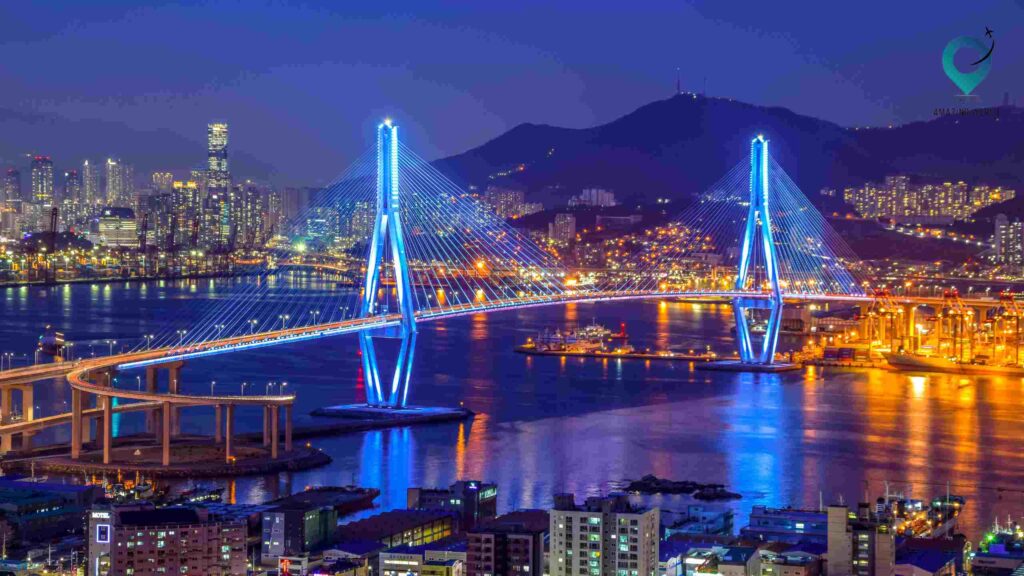
Take a day trip to Busan, South Korea’s second-largest city. Start your morning by visiting the iconic Gamcheon Culture Village, known for its colorful houses and art installations. In the afternoon, relax at Haeundae Beach and enjoy the vibrant beach atmosphere. In the evening, explore the bustling street of Gwangalli and enjoy dinner with a beautiful view of Gwangandaegyo Bridge.
- Gamcheon Culture Village : Check prices
- Haeundae Beach : Free
- Gwangall i: Free
Day-4: Seoul
Explore the modern side of Seoul by visiting COEX Mall, one of the largest underground shopping malls in Asia. In the afternoon, visit Lotte World, an indoor theme park with thrilling rides and entertainment for the whole family. In the evening, wander around the trendy district of Gangnam and enjoy some delicious Korean BBQ.
- COEX Mall: Free
- Lotte World: Check prices
- Gangnam: Free
Day-5: Jeju Island

Take a flight to Jeju Island, a beautiful volcanic island known for its stunning landscapes and natural wonders. Start your day by exploring Seongsan Ilchulbong, a UNESCO World Heritage site with a breathtaking crater. In the afternoon, visit Cheonjiyeon Waterfall and take a leisurely walk along the Olle Trails. In the evening, relax at one of Jeju’s beautiful beaches and enjoy the sunset.
- Seongsan Ilchulbong: Check prices
- Cheonjiyeon Waterfall: Free
- Jeju Beaches: Free
Day 6: Jeju Island
Continue exploring the wonders of Jeju Island by visiting the iconic Jeju Loveland, an outdoor sculpture park showcasing erotic art. In the afternoon, hike up Hallasan, South Korea’s highest mountain, for panoramic views of the island. In the evening, relax and unwind at one of Jeju’s famous hot springs.
- Jeju Loveland: Check prices
- Hallasan: Free
- Jeju Hot Springs: Check prices
Day 7: Departure from Seoul
Say goodbye to South Korea as you depart from Seoul. If time allows, explore the vibrant neighborhood of Hongdae, known for its street performances and nightlife, before heading to the airport.
- Hongdae : Free
Additional Mut Know Information

What To Pack + Weather
When traveling to South Korea in September, it is recommended to pack lightweight and breathable clothing as the average temperatures range from 17°C (63°F) to 25°C (77°F). However, it is important to note that South Korea experiences some rainfall during this season, so it is advisable to bring a lightweight raincoat or umbrella. It is also advisable to pack comfortable walking shoes as there will be a lot of exploring on foot.
Don’t forget to bring a power adapter for your electronic devices, as South Korea uses a 220V electricity system. Lastly, make sure to carry some Korean won for your daily expenses, as not all places accept credit cards. Enjoy your trip to South Korea!
Nearby Shopping
Transportation tips.
When traveling in South Korea, there are several transportation options to consider. In Seoul, the most convenient and efficient way to get around is by using the local public transportation system, which includes an extensive subway network and bus services.
Taxis and ride-sharing services such as Uber are also readily available and can be hailed from the streets or through mobile apps.
For day trips or exploring outside of the city, renting a car is a popular option, but make sure to have an international driving permit. It is recommended to plan your itinerary in advance and check the transportation routes and schedules to make the most of your time.
Safety Tips
- South Korea is generally a safe destination with a low crime rate.
- Take basic precautions and be aware of your surroundings.
- Keep an eye on your belongings, especially in crowded areas, to prevent pickpocketing.
- Respect local customs and etiquette, such as removing your shoes when entering homes or traditional Korean restaurants.
- Avoid discussions or activities that may be seen as disrespectful or offensive to local culture.
- Stick to well-lit and populated areas, especially at night.
- Avoid areas with a reputation for higher crime rates.
- Use licensed taxis and reputable transportation services.
- In areas like Itaewon and Hongdae known for nightlife, stay alert and cautious.
Overall, South Korea is safe, but being prepared and using common sense enhances your trip’s safety and enjoyment.
Travel Requirements
For traveling from India to South Korea, it is important to have a valid passport with at least six months of validity. Indian nationals are generally required to obtain a visa before entering South Korea. Visa applications can be submitted to the Embassy or Consulate of South Korea in India.
Additionally, it is advisable to check the travel advisories and entry restrictions for foreign visitors by contacting the Embassy or Consulate. Regarding vaccinations, it is recommended to consult a healthcare professional or a travel clinic for any specific requirements or recommendations for South Korea.
Cultural Norms + Etiquette
When visiting South Korea, it is important to be aware of and respectful of local customs and etiquette. South Koreans place a strong emphasis on politeness and respect, so it is customary to bow when greeting someone, especially when meeting someone older or of higher social status.
It is also important to remove your shoes when entering someone’s home or certain establishments, such as temples or traditional tea houses.
When dining, wait for the eldest person to start eating before beginning your meal, and use chopsticks instead of your hands. Tipping is not common in South Korea, as service charges are often included in the bill.
However, it is appreciated to leave a small token of appreciation, such as a small gift or a sincere thank-you. Overall, being respectful, polite, and mindful of local customs will make your visit to South Korea more enjoyable and memorable.
Some Local Daily Common Use Words
Health + medical facilities.
South Korea has a well-developed healthcare system with a wide range of medical facilities available. Hospitals in major cities like Seoul and Busan are generally of high quality and provide advanced medical treatments. Some recommended hospitals in Seoul include Asan Medical Center, Seoul National University Hospital, and Samsung Medical Center.
Pharmacies are easily found throughout the country, and they usually offer a variety of over-the-counter medications. It’s important to note that most pharmacies in South Korea close early, so it’s advisable to purchase any necessary medications during the day.
For travelers visiting South Korea, it is recommended to have travel insurance that covers medical expenses. This ensures that you are financially protected in case of any unforeseen medical emergencies or accidents during your trip.
Accepted Currency + Payment Types
Conclusion ..
crafting a memorable 1-week South Korea travel itinerary involves a blend of exciting places to explore, essential safety tips, and insights into currency and payment types. By following this guide, you’re not only well-prepared to navigate the wonders of South Korea but also ensure a safe and convenient journey. So, pack your bags, embrace the adventure, and let the beauty of South Korea unfold on your 7-day expedition.
How much did you like Our detailed EPIC 7 Days Korea Travel itinerary for first-timers (2023) ? Review Also, please share these Blogs with your friends on social media.
Related Article –
- Road Trips Ideas | 12 Tips to Prepare Your Car for a Long Road Trip?
- 150 Best Places to Visit in the United States In 2023
- Road Trip With Kids
- How to Stay Awake While Driving Long Distances
- Audiobooks to Listen to On Your Road Trip
- How to Create an Epic Itinerary Road Trip
- Best Rental Cars For Travel Adventures

Meet David Hoper, a passionate travel Blog writer with 7+ years of experience in travel content. Through his exemplary storytelling and engaging narratives, he shares his experiences and brings destinations to life. With a keen eye for detail and a love for exploration, he has cultivated a diverse portfolio of travel blogs that inspire and inform readers worldwide.
In this article:

Post written by: David Hoper
Leave a reply.
Your email address will not be published. Required fields are marked *
Save my name, email, and website in this browser for the next time I comment.
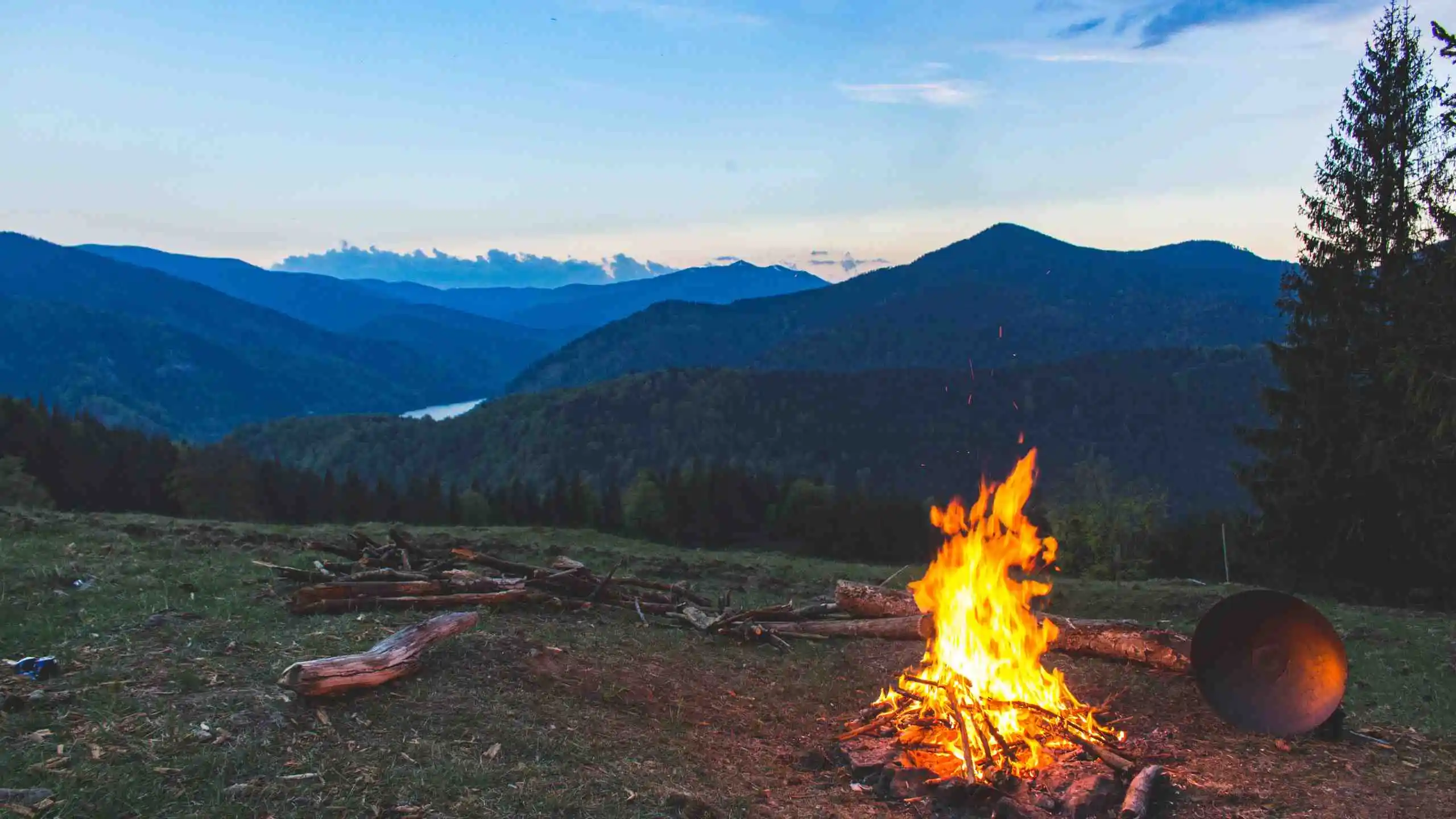
Camping Camping vs Glamping: Which is Best for You?

- September 12, 2023
Camping Luxury Glamping 101: Your Ultimate Guide to Luxurious Outdoor Adventures
You may also like.
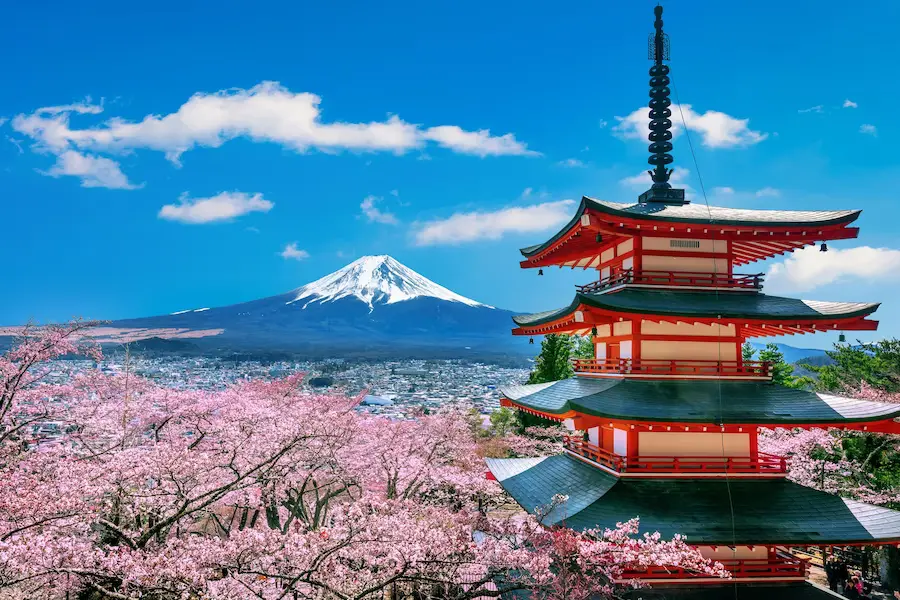
The best 5-day Japan itinerary suggestions for first-timers

Pattaya Itinerary: Best Places to Visit in Pattaya
- 2 minute read

Uncover the Southwest Road Trip Itinerary: A 7-Day Epic Road Trip itinerary
- 12 minute read

7 Day Phuket Itinerary (2024) | The Best Things to Do in 7 days in Phuket
- 6 minute read

Explore Morocco: A 7-Day Family Travel Itinerary (Updated 2024)
- 5 minute read

7-Day Road Trip from Delhi to Manali | Full Itinerary
- 7 minute read
Our Latest Instagram Posts
@amazingworld.travel8.

IMAGES
VIDEO
COMMENTS
Customizable South Korea itinerary for winter & beyond. Includes 5 mini-city guides, route ideas, and insider's tips from 3 years living in Korea! ... This depends on your style of travel, but a mid-range budget for a solo traveler spending 10 days in South Korea would be about $65USD per day. If you're willing to stay in cheap hostels, stick ...
Here's a guide to solo travelling in South Korea, so you can fully enjoy your stay in the country with less to worry about. 1. Book accommodations in bustling areas. Image credit: @kim0925_ via Instagram. Although South Korea is a relatively safe country with low crime rates, safety should never be taken for granted.
Solo female travel in Korea is less common than backpacking around southeast Asia or interrailing through Europe, for example. Still, South Korea is a beautiful and culturally rich travel destination. Its capital, Seoul, is a bustling megalopolis home to 9.7 million people. It is made up of dozens of different neighborhoods, each of which has ...
Where to stay in Gyeongju: as a smaller city, there isn't a wide range of hostels available for solo travellers in Korea. Han Jin (with beds from $17 a night) is your best bet. Getting to Gyeongju: it's just a 30-minute KTX train ride from Busan to Singyeongju Station which is a 30-minute bus ride into the town.
Day 1 Seoul. Ultra modern Korea! Flying into South Korea is likely you may arrive to Seoul. Due to the price of food and accommodation, backpacking in Seoul is not the most budget-friendly destination. But it has many things to show and you should experience it at least for a couple of days.
Busan is easily accessible throughout Korea via a short flight from Seoul. Or you can hop on the speedy KTX fast train, which is the quicker option! If you're following this South Korea 2 week itinerary, then it's best to book a flight from Jeju to Busan. This won't cost you more than $40 for the 45-minute flight.
Let's begin our journey! South Korea Itinerary: Seoul - 4 Days. Below are the most important tourist attractions in Seoul, the ones I recommend visiting. From breathtaking panoramic views, shopping opportunities, history and culture, this itinerary covers it all. Take A Trip To The North Korean Border.
2. Korea Is Cheap in General. Solo travel to Seoul is the best because of he low cost of living compared to the United States. I can get a fancy drink in a cafe for 7,000 won ($6) and an entire Korean meal with sides for 9,000 won ($8). Korea is pretty tech savvy so most places take credit card.
The Solo Traveller's Guide to South Korea. From Squid Game to BTS, South Korea has major pop-culture creds. But visit this compact Asian nation and, in fact, you'll find its diversity staggering. Beyond the cool capital Seoul, you'll also get epic palaces, ancient temples and thriving traditional markets. Throw in some stellar mountain ...
Getting from Seoul airports to the city. Budget for 2 weeks in South Korea. 2 week South Korea itinerary overview. Days 1-5: Seoul. How to get around Seoul. Day 1 - Bukchon Hanok Village OR Bukhansan National Park. Day 2 - Ihwa Mural Village, Gwangjang Market, Insa-dong & Myeongdong. Day 3 - DMZ day trip. Day 4 - museum & culture day.
Crafting the Perfect 7-day Itinerary for Solo Travelers in South Korea. Plan an unforgettable South Korea trip with a well-crafted 7-day itinerary. Explore Seoul's cultural landmarks, from Gyeongbokgung Palace to Namsan Tower. Discover the natural beauty of Jeju Island, including Seongsan Ilchulbong and Cheonjiyeon Falls.
As easy as solo travel in Korea is, it's always a good idea to prepare with the important need to know travel tips! Here are a few tips specifically for solo travel in South Korea. 1. Some traditional Korean dishes are served in larger portions for sharing, which can be challenging for solo travelers. 2.
Linda Dunsmore 25 December 2022. The capital city of South Korea is a pulsating metropolis that combines traditional Korean ideals with modern architecture and young neighbourhoods. While it's often overshadowed by bigger neighbours Beijing and Tokyo, Seoul has recently become one of the hottest cities in East Asia.
The perfect Korea itinerary for solo female travelers over 50. 2 week South Korea itinerary. Seoul: Days 1-6. Day 1: Myeongdong and Namsan Tower. Day 2: The House of Sharing and DMZ Tour. Day 3: Noryangjin Fish Market and Itaewon. Day 4: Korea Food Tours and Bukchon Hanok Village.
However, South Korea, with its vibrant capital, Seoul, offered a fascinating blend of tradition and modernity, deeply rooted in its rich cultural history. This combination intrigued me. So, in September 2023 I set out to see if South Korea truly deserved its reputation as an unconventional choice for solo travel.
Two Weeks in South Korea: A Solo-Traveller Itinerary. 40 minute read. With a population exceeding 50 million, it may be hard to conceive a small peninsula-country - one that juts into the East China and Yellow Seas - boasting some of East Asia's most breathtaking scenery. Yet it does. More interestingly, despite a penchant for catapulting the ...
Safety in South Korea (10-Day Itinerary South Korea) South Korea is a very safe country for solo female travelers. Just be aware crime still happens despite the safety ratings. According to Global Finance, Korea has a safety index score of 8.93. This means you will find CCTV everywhere and Koreans in keeps themselves in check.
Safety in South Korea (5 Days Itinerary Seoul) South Korea is a very safe country for solo female travelers. Just be aware crime still happens despite the safety ratings. According to Global Finance, Korea has a safety index score of 8.93. This means you will find CCTV everywhere and Koreans in keeps themselves in check.
Sinchon and Gangnam Station are the watering hole of Korean university students looking for cheap drinks and casual bars that stay open late. Samcheong-dong is where the fashionable and trendy congregate. Great foreigner-friendly clubs: Cakeshop Seoul and Faust (both in Itaewon). Great bars for solo travelers: Zen and La Bamba (both in Hongdae).
We would customize any itinerary based on your preferences. CONTENT PREVIEW. Itinerary 1: Classic South Korea. Itinerary 2: For Family with Teenagers. Itinerary 3: Modern and Historical South Korea. Itinerary 4: South Korea Off-the-Beaten-Path. How Much Does a 10-Day Trip in South Korea Cost.
In this travel guide, we'll help you map out an unforgettable trip to South Korea in just 7 days. We'll provide you with a detailed itinerary, so you can explore the best of South Korea while staying within your budget and schedule. From exploring vibrant markets to enjoying delicious Korean cuisine, we've got your travel plans covered.
Hop onto one of these tours including Namdaemun Market: Seoul Street Food Walking Tour: Enjoy Korean street food delicacies from BBQ ribs to green onion pancakes with your own expert guide. UNESCO and Traditional Markets Tour: Combine a visit to Changdeokgung and Namdaemun Market with this 4-hour afternoon tour.
With the above in mind my itinerary is as follows: 1 Fly from Sydney to Seoul in the mid morning, arrive in the evening, check into hotel. 2 Wait on mandatory PCR/ rest in the hotel, if results come back early and negative; explore area around hotel. 3 Subway to Hongdae, spend day in the area. 4 Do the hike up to N Seoul Tower in the middle of ...